Everest Base Camp Trek for Nepali

- Duration 11 Days
- Difficulty Level Challenging
- Places to Visit Everest Base Camp
- Max Altitude 5545m/18,192ft.
- Group Size 4-15
- Starts Lukla
- Activity Teahouse Lodge Guided Trekking
- Best Season Spring/Autumn

Everest Base Camp Trek for Nepali Highlights:
- Set out on a thrilling adventure as you fly into Lukla, home to the world's most daring mountain airport, situated at an astonishing elevation of 2840m.
- Find yourself in the stunning beauty of the legendary trekking trail, winding through Sherpa villages and offering a glimpse into their exceptional culture.
- Brace yourself for a daring and adventurous journey as you cross multiple suspension bridges on your way to Namche Bazaar, the vibrant capital of the Khumbu region.
- Indulge in a beautiful walk to Tengboche Monastery, where you will be rewarded with incredible views of Everest and its majestic neighboring mountains.
- Experience a moment of spiritual enlightenment as you visit the Tengboche monastery, its serene ambiance blending harmoniously with the dramatic natural beauty that surrounds it.
- Be captivated by the magnetic attraction of the magnificent mountains, expansive green hills, and the rich Tibetan-Buddhist culture, while witnessing the grazing territory of the yaks from Khumjung and beyond.
- Embark on an enchanting journey to Dingbuche, where extravagant mountain views at every turn will leave you in awe. Spend two nights at the base of the soaring Amadablam, often referred to as the Matterhorn of Nepal.
- Witness the view of the world's highest peak, Everest, and its neighboring mountains, as well as the spectacular landscapes that gradually unfold before your eyes each day, deepening your appreciation for trekking as the ultimate holiday experience.
- Achieve a great accomplishment as you find yourself at the base of Everest, the world's highest peak, and reach the summit of Kalapathar at an impressive altitude of 5545m (18192 ft). This feat will forever be etched in your memory.
Everest Base Camp Trek for Nepali Overview:
Everest Base Camp Trek for Nepali is designed to promote local tourism in Nepal. To all the Nepali people - we are offering lucrative trekking and tour packages delivering you the best of OUR country. We are offering you a chance, a life opportunity to explore our OWN country that has so much to offer.
Nepal is certainly a paradise found nowhere. Everest Base Camp Trek for Nepali is basically designed to give you the opportunity to present yourself with a challenge to be at the base of the world's highest mountain. It gives you a profound comprehension of why every year thousands of trekkers and climbers from around the world visit EBC.
Everest Base Camp Trek for Nepali is basically a trip targeting the local tourists that conjures up images of great challenge and achievement. This trip for Nepali people is touched by the romance and thrill of being so close to Everest, the world's highest mountain. It offers an incredible mountain profile and wonderful insight into the way of hard Sherpa life.
Justifiably this Everest base camp and Kala Patthar trekking are some of the most popular treks in Nepal. EBC trek is famous, not only for its proximity to Mount Everest but also for its diversity, incredible views, Sherpa culture, Tibetan Buddhism, and colorful monasteries.
Give yourself a chance to be in the Sagarmatha World Heritage Site, in the region of Khumbu, and dissolve yourself into the serene wilderness. Walk the legendary trail once taken by Eric Shipton, John Hunt, Edmund Hillary, and Tenzing Norgay Sherpa.
Everest Base Camp Trek for Nepali:
We stay in lodges under the shadow of mighty snowy peaks on our journey to Everest base camp and Kala Patthar. This Everest Base Camp Trip has been selected multiple times among the world's top 20 classic Journeys of a Lifetime. We enjoy glorious and traditional Sherpa hospitality. We take a 35-minute thrilling mountain flight to Lukla, the gateway to the Nepal Everest region.
On the way to Everest base camp, we follow the Dudh Koshi valley to Namche, the Sherpa "capital" nestled in a horseshoe bowl, with its colorful and bustling market with traders from local villages and as far away as Tibet. The alpine scenery becomes more rugged as we trek above the tree line to reach Dingboche for further acclimatization and exploration.
Following the Khumbu glacier moraines, we head to Gorak Shep via Lobuche. We trek the Everest Base Camp (5360m) and then summit Kala Patthar (5445m), the best vantage point on earth for the stunning views of 360-degree Himalayas. Our professional design itinerary allows enough time for proper acclimatization while we ascend up to the Everest base camp at a relaxed pace through the beautiful forest and Himalayan Sherpa settlements.
Cost Includes:
- Domestic Airport pickup and drop facility.
- DOMESTIC FLIGHT KATHMANDU/LUKLA AND LUKLA/KATHMANDU.
- Fundamental trekking gear like a sleeping bag, down jacket fleece liner, etc.
- Teahouse accommodation.
- Meals (Lunch, dinner, breakfast with hot beverages) during the trek.
- Properly Boiled water for drinking every morning and evening
- An accomplished trekking Group Leader.
- All Ground Staff – Their Allowances and Insurance.
- Oxygen cylinders and an all-inclusive medical kit on all trips.
- Take away the Nepal Pyramids duffle bag, T-shirt and trekking Map, and Buff (multi-functional head-wear)
COST for Everest Base Camp Trek for Nepali:
- 4 - 8 Pax - NPR 75,000 PER PERSON
- 9 - 13 Pax - NPR 70, 000 PER PERSON
- 14 - 15 Pax - NPR 65,000 PER PERSON
Outline Itinerary
- Day 01: Fly to Lukla (2840 m/9317 feet) (Either from Kathmandu or Manthali Airport) and trek to Monjo (2835 m/ 9302 feet)
- Day 02: Trek to Namche Bazaar (3450 m/11,318 feet)
- Day 03: Trek to Tengboche Monastery (3860 m/12,664 feet)
- Day 04: Trek to Dingboche (4350 m/14271 feet)
- Day 05: Acclimatization day at Dingboche, morning excursion.
- Day 06: Trek to Lobuche (4910 m/16,108 feet)
- Day 07: Trek to Gorak Shep (5,164 m /16,942 feet) trek to Everest base camp.
- Day 08: Morning excursion to Kala Patthar (5545 m/18,192 feet) and trek to Pheriche or Pangboche (3930 m/12,893 feet)
- Day 09: Trek Back to Namche - Back to lower altitude
- Day 10: Trek Back to Lukla - the most enchanting town
- Day 11: Mountain flight to Kathmandu
Everest Base Camp Trek for Nepali Detailed Itinerary
The itinerary provided is simply a guideline that can be altered under any circumstances. You have every right to further customize your itinerary prior to your booking. If you have any queries in regards to the package or itinerary provided feel free to mail at [email protected]
OR you can call 9851052003 (Sunil Gurung) OR 9851227147 (Arjun Magar)
The cost of the package is basically calculated over the facility, provision, and resources that we are delivering for the best of your experience. You may ask for the quote in reference to your preferences if you have any.
- Domestic Airport pickup and drop facility.
- DOMESTIC FLIGHT KATHMANDU/LUKLA and LUKLA/KATHMANDU.
- A medical examination or emergency rescue.
- Extra meals or snacks in between the meals provided by the company
- Staff Tipping.
- Other personal expenses – laundry, battery charges, shower, bar bills, bakery, etc.
Nepal Pyramids is here to craft your Nepal dreams into reality. We assure you a trip extraordinarily out of the world with quality service and value for money. We propose comprehensive flexible packages with unbeatable price - without any hidden cost.
Our team of local experts is the driving force behind our success. With their passion, experience, and commitment, our team of local experts ensures that we all are not just participants but integral contributors to the growth and well-being of the community we serve.
Safety is our foremost concern at our Travel company. We prioritize the well-being of our adventurers above all else. We provide top-notch equipment and conduct rigorous safety checks to ensure every trek is as secure as it is adventurous.
Sustainability is at the heart of our mission. We ensure that the beauty and integrity of the destinations we explore are preserved. We believe in responsible tourism that contributes positively to the environment and the livelihoods of the local people.
Nepal Pyramids takes pride in making your journey hassle-free from start to finish. With our efficient services, expert Group Leading, and attention to detail, you can leave the hassles behind and focus on creating lasting memories during your travels.

Annapurna Base Camp Trek for Nepali

Gosaikunda Lake Trek for Nepali

Langtang Valley Trek for Nepali
Ask a question.
We use cookies to ensure that we give you the best experience on our website.
How To Do The Everest Base Camp Trek In Nepal
The Mount Everest Base Camp Trek in Nepal is one of the world’s best bucket list hikes. In less than 2 weeks, you can trek to the foot of Mt Everest and other snowy peaks in the Himalayan mountains.
The good news is that it’s not a super difficult hike, and you don’t need a big budget to do it. The EBC trek is worth it for the fun and accomplishment alone, but you also get views of the Himalayas that are out of this world.
This travel guide will explain how you can do the Mt Everest Base Camp hike independently (with or without a tour guide), along with a recommended packing list and everything else you need to know before you go!
Best Everest Base Camp Tours
First of all, if you’d rather skip the hassle of planning your own EBC Trek, Klook has Everest Base Camp Tours starting as low as $900 USD for a full 12-day trek.
You may be able to find something cheaper than this once you land in Kathmandu, but booking online with a vetted tour company has some big advantages, and the reviews on their website are very positive.
We’ve used Klook for lots of tours and activities around the world, and they’re great! Highly recommended.
Book Now: Everest Base Camp Tours

When To Do The EBC Trek
The Mt Everest region has 4 different trekking seasons:
- March – May: High season. Best weather, with stable temperatures and bright sunny days, but the trails can get crowded. During these months you may share the EBC trail with pro climbers on the way to go summit Everest.
- June – August: Monsoon season. There’s a lot more rain during these months, and the trails are mostly empty.
- September – October: Clear days and busy trails. This is one of the most popular trekking seasons.
- November – February: Coldest season, but the weather is stable and dry. The trails are mostly clear.
I trekked in early February, and even though it was nice having the trail mostly to myself, the cold in the evenings and mornings was straight up misery.
My home state of Missouri can get very cold in the winter, but the cold has just never been my thing. If I could go back and change it, I would definitely do my Everest Base Camp hike later in the season.

Everest Base Camp Weather
Temperatures on the Mt Everest Base Camp Trek can range from 5 °C (40 °F) to 20 °C (70 °F) depending on month, and as low as -30 °C (-22 °F) at night during the winter months.
If you trek during the warmer months (Mar-May and Sep-Oct), the cold is not a big problem and shouldn’t be hard to cope with. Winter is a different story. Your snot will freeze in your nose at Gorak Shep.
Sunshine is key for winter trekking in Nepal, and thankfully you should have lots of sun in most months outside of the monsoon season. On my February hike, I often found myself shedding all my layers while trekking because I was heating up in the sun.
If you do your Everest Base Camp hike during the winter, the biggest issue is staying warm in the evenings and at night. For this, you’ll definitely want a top quality down jacket and sleeping bag.

All About Everest Base Camp Trekking
My everest base camp itinerary.
- Day 1: Kathmandu to Lukla to Benkar .
- Day 2: Benkar to Namche Bazaar .
- Day 3: Namche Acclimatization Day .
- Day 4: Namche to Deboche .
- Day 5: Deboche to Pangboche .
- Day 6: Pangboche to Dingboche .
- Day 7: Dingboche Acclimatization Day .
- Day 8: Dingboche to Thukla .
- Day 9: Thukla to Gorak Shep .
- Day 10: Everest Base Camp .
- Day 11: Kala Patthar to Gorak Shep to Pheriche .
- Day 12: Pheriche to Namche .
- Day 13: Namche to Lukla .

If you ever need motivation to keep going on the Everest Base Camp hike, just look at how much the porters are carrying!

Mount Pumori as seen from the Kala Patthar viewpoint, just a short distance from Mt Everest Base Camp.

Ama Dablam, one of my favorite mountains on the Mt Everest Base Camp Trek.
EBC Trek Packing List / Gear
This isn’t a complete list of everything to bring on a Mt Everest Base Camp Trek, and you may have to change things up a little depending on what month you go, but these are just some of the basics.
You can find most of this gear in Kathmandu, but in my opinion you’ll get higher quality and a wider selection if you order online.
- Beanie: I only wore this at night, but it definitely helped keep my ears warm.
- Down Jacket: Bring the biggest, warmest DJ possible. This is your most important piece of gear. You can use it as an extra cover at night.
- Fleece Sweater: This is the only jacket you’ll need to wear while trekking most days, especially if it’s sunny.
- Shirts: Something comfy with quick dry material.
- Trekking Pants: Something lightweight and breathable.
- Thermal Underwear: May not be needed if you trek in the warmer months.
- Gloves: I only wore these at night, but they definitely helped keep my hands warm.
- Socks: Merino wool is best for staying warm and stopping moisture.
- Headlight: Smart to have at least a small one, just in case.
- Tumbler: 1 liter water bottle to refill daily on the trek.
- Sunblock: It’s easy to sunburn at high altitudes. A small bottle is plenty.
- Sunglasses: Good for snow. May not be necessary unless you plan to hike a mountain pass like Cho La.
- Hat: I wore old faithful throughout the hike.
- Watch: An altimeter watch would be fun to play with here.
- Camera: Duh. You can’t do the Mt Everest Base Camp Trek without taking lots of pictures.
- Power Bank: Bring a big power bank and you might only need to recharge it once on the whole trek.

Everest Base Camp Trek Cost
For a 13 day trek, I paid about $21 USD per day for food, drinks, and room. Porter/guide was an extra $25 per day, although it’s not a requirement. Flights to Lukla were $330 return, but again not a requirement if you hike in.
You can read the sections below for more info on the daily trekking costs and what you get for your money. It’s not a very expensive trek, all things considered!
Keep in mind, these numbers are from 2020. They’ll go up a little over time. Exchange rates may also vary, so check the latest rates .

The flight to Lukla from Kathmandu is $165 USD each way. You can shop for flights to Lukla at Skyscanner.
If your budget is tight or you have extra time, you can skip this flight by hiking from Jiri to Lukla rather than flying. It only adds a couple days to the itinerary.

Guide / Porter / Solo
You can do the EBC trek with a guide, porter, OR independently (solo).
A guide will show you the way to Mt Everest Base Camp and help with lodging, navigation, advice, taking pictures for you, etc. A porter-guide will do these same things and also carry a 20 kg (45 lb) pack for you.
A porter or guide is NOT a requirement to do this hike, especially if you go in the warmer months when you may not need as much gear. In 2023, they were supposedly introducing a guide requirement for EBC, but so far that has not been enforced at all, thankfully.
With that said, there are some good advantages to hiring a guide, and it’s pretty cheap by Western standards. A porter is only $15 or $20 USD per day, and a porter-guide is $25 per day. A popular arrangement is to hire one porter for two hikers, splitting the cost and still making things easier for both of you.
In the end, this all depends on your budget and hiking preferences.

Hiking Fees
If you’re hiking EBC independently, you’ll need to be aware of two fees you have to pay near the start of the trek.
There’s a local government tax that they’ve now started collecting in Lukla. This one is currently 2,000 Rupees ($17 USD).
There’s also an Everest park fee/ticket you have to pay at the Sagarmatha National Park entrance just beyond the small village of Monjo, Nepal. This one is currently 3,500 Rupees ($30 USD).
No TIMS card is needed anymore for independent hikers. That fee has been retired for the Mount Everest Base Camp Trek.

Accommodation & Amenities
Throughout the Everest Base Camp hike, you’ll stay and sleep at small guesthouses along the way, called teahouses.
This is where you get your meals and drinks for the trek, along with the occasional amenities like showers, charging, or WiFi. The teahouses start out decent, but quickly get more shabby as you go further up the trail.
You have to pay for everything you use, of course, and the prices get quite high as you go, because everything has to be hauled up on the backs of the poor porters.

Guesthouses
The teahouses on the EBC trek are cold and dingy, with drop toilets and cracks in the walls. Don’t expect luxury.
Most rooms are free as long as you buy your meals there (the meals are how they make their money). If you stay at a lodge and don’t eat there, you’ll be expected to pay for the room.
In some cases, I was charged 500 Rupees for a room on top of my meal costs. I’m not sure why some teahouses do this and others don’t, but I never paid more than 500 Rupees for a room, and most were free with the meals.

Food & Drink
I’m happy to report that the food and drinks on the Everest Base Camp hike are top notch, especially after you’ve worked up an appetite trekking.
You have western food choices, or the standard local staples like veggie fried rice, steamed momos (dumplings), and mushroom soup. Everything was hot and fresh. Meal prices for these ranged from 250 to 750 Rupees depending on altitude. Not too bad.
For drinks I tried hot chocolate, lemon/apple/mint tea, and occasionally bottled water for my tumbler. These ranged from 100 to 400 Rupees. If you want to avoid plastic bottles, there’s usually boiled water available and this is safe to drink too.
Getting enough water on the trek is never a problem. Just fill up a 1 liter tumbler in the morning, and this will last you until evening, especially since you’re likely to pass more tea houses along the trail as you’re hiking throughout the day.

Showers are only available at a few lodges, depending on the season and how high up you are, and they cost 600 to 1200 Rupees. In the winter, water higher up will be frozen most of the time.
I never had a shower on my February EBC trek, and that seems to be the norm (although I got one or two opportunities in Namche). Yes, it’s gross. I could smell myself by trek’s end, and it wasn’t pretty.
But aside from the fact that I hate to fork out money for something as basic as a shower, I also never really got close to other people for very long on the trek, so I didn’t feel too guilty about it.
Most days were cold enough that the thought of stripping down for a shower was not really appealing, either. Your best bet is baby wipes and deodorant.

WiFi / Cell Service
WiFi costs anywhere from $5 to $10 USD per day if you buy it from the teahouses.
Alternatively, you can buy a 10 GB/30 Day Everest Link WiFi card in Namche Bazaar and use this for the entire EBC trek. During my Mount Everest Base Camp Trek the WiFi was down across the whole region, so unfortunately I wasn’t able to use either of these options.
I bought an Ncell local SIM card in the Kathmandu airport and had 3G service for half the days of the Everest Base Camp hike. Coverage is still improving in the area, so if you need to stay connected I’d definitely bring a local SIM.

Electricity
All of the teahouses on the way to Mt Everest Base Camp sell outlet charging for electronics, and the prices range from $2 to $10 USD for a full charge, depending on how far up the trail you are.
The key is to bring a big power bank and then use this to charge all of your other electronics (phone, camera, etc). I did this and only paid once to recharge my power bank on the whole trek.

How Much Cash To Bring
Everything you buy during the Everest Base Camp hike (meals, WiFi, charging, etc) will have to be paid for with cash. Credit cards won’t work. There are no ATMs outside of Lukla and Namche Bazaar (Days 1-4), and even the ATMs there are not reliable.
What this means is that you’ll have to withdraw enough cash (Nepalese Rupees) at an ATM in Kathmandu to cover your entire trek. The ATM fees will bite you, and I hate to carry large amounts of cash, but it’s not really avoidable here.
All up, I spent about $20 USD (2,400 Rupees) per day on the Mount Everest Base Camp Trek, and never spent more than $25 USD in a single day. With that said, I didn’t splurge on WiFi, showers, charging, or alcohol. The only things I bought were the bare necessities: room, food, and drinks.
If you hire a porter/guide, you don’t need to factor that into your daily cash carry. That’s paid before the trek starts. But do reserve a little cash for a decent tip.

Mount Everest Base Camp Trek Difficulty
I’m not going to lie, this is a difficult trek. And if you do it in the winter like I did, it’s even harder. With that said, if you are in decent shape, determined, and obey the guidelines for altitude sickness prevention (more on that below), then you’ll have no problem reaching base camp.
There is a lot of elevation gain and loss on this hike. At times near Lukla, the constant ups and downs will make you feel like you’re hiking a roller coaster, but the trail is never too steep or dangerous. After Namche, it’s mostly a slow uphill plod.
This trek has been completed by old seasoned hikers in their 70s, and young kids in their pre-teens. It’s also been flunked by healthy 20-30 somethings who try to push through it quickly without enough acclimatization to altitude.
Patience and discipline are key for trekking to Everest Base Camp. Slow and steady wins the race here.

Trekking Distance
The one way trekking distance from Lukla to Mt Everest Base Camp is about 65 kilometers (40 miles).
That means the total roundtrip distance of an EBC Trek is about 130 kilometers, even if you don’t do any of the detours.
Don’t let that scare you off. It’s a lot of hiking, but every step is worth it.

Altitude Sickness
By far your biggest danger on the Mount Everest Base Camp Trek is altitude sickness, also known as Acute Mountain Sickness (AMS).
No one is immune to this, and it doesn’t matter how fit you are. If you gain altitude too fast, you can get sick and in some cases even die. Plenty of people have died from AMS on the EBC Trek.
The problem is that overzealous hikers push the envelope on this hike all the time, and a lot of them end up needing a very expensive helicopter evacuation to lower ground.
The best way to avoid altitude sickness is to go slow . At altitudes above 3,000 meters (10,000 feet), don’t increase your sleeping elevation by more than 300-500 meters (1,000-1,500 feet) per night.
Every 1,000 meters (3,000 feet) you should also spend a second night at the same elevation. If you get a bad headache, dizziness, or nausea, descend to a lower altitude until you feel better. As long as you follow these general guidelines, you shouldn’t have any issues.
You can take Diamox (acetazolamide) on the trek for extra AMS prevention. This medication can be found in Kathmandu or Namche. I bought mine in Namche and it seemed to help my headache and slight foggy feeling. I didn’t have any side effects aside from the usual tingling toes/fingers.

Everest Base Camp Altitude
The Mount Everest Base Camp altitude is 5,364 meters (17,598 feet). At this elevation, there is 50% of the oxygen at sea level.
However, most treks also go to Kala Patthar, a viewpoint even higher than base camp where you can get the best views of Mount Everest.
The elevation at Kala Patthar is 5,644 meters (18,519 feet). From there, you’ll be rewarded with an incredible panorama of Mount Everest and other icy peaks like Pumori, Lhotse, and Nuptse.
Happy travels!

If you’d rather skip the hassle of planning your own EBC Trek, Klook has Everest Base Camp Tours starting as low as $900 USD for a full 12-day trek.
You may be able to find something cheaper than this once you land in Kathmandu, but booking online with a vetted tour company has some big advantages, and the reviews on their website are very positive for this Mt Everest Base Camp tour.
More Nepal Travel Tips
Hopefully you were helped by this guide for the Everest Base Camp Trek. Let me know in the comments below if I can help answer any questions.
Don’t forget to check out my complete Nepal Travel Guide with tips, info, photos & more!
You may also like
Fulidhoo island guide: shark & stingray beach in maldives, how to visit dhigurah island: budget paradise in maldives, 10 best hikes in aruba: family friendly trails, how to visit tanjung puting national park in indonesia, sanur bali travel guide: 23 best things to do, coron vs el nido: which is better all differences explained.
So much useful detailed information.
Thanks for the straight forward information. Beautiful photos

Leave a Comment Cancel Reply
Save my name, email, and website in this browser for the next time I comment.

- Everest Region Trek
- Annapurna Region Trek
- Manaslu Region Trek
- Mustang Region Trek
- Langtang Region Trek
- Makalu Region Trek
- Dolpo Region Trek
- Kanchenjunga Region Trek
- Best Selling Treks
- Nepal Trekking
- Luxury Treks in Nepal
- Challenging Treks in Nepal
- Family Treks in Nepal
- Peak Climbing
- Mountain Climbing in Nepal
- Nepal Tour Packages
- Luxury Tours in Nepal
- Helicopter Tours
- Nepal Family Tours
- Bhutan Tour
- Kailash Tour
- Pokhara Day Tour
- Kathmandu Day Tours
- Jungle Safari in Nepal
- Nepal Visa Information
- Packing List for Trekking
- Bhutan Visa
- Fitness Training
- 10 Comprehensive Nepal Trekking Tips
- Flight Cancellation
- Travel Insurance
- The Differences
- Terms & Conditions

Everest Base Camp Trek in Nepal: The Ultimate Guide to Reaching the Foot of the World’s Highest Peak
: 2023-12-26
Last Updated : 2024-01-08
The journey to Everest Base Camp Trek in Nepal tops the dream list for countless trekkers worldwide, and for good reason! It is a trail that showcases the greatness of the Khumbu Valley, offering breathtaking views of some of the world’s highest peaks.
The journey begins with an exciting flight to Lukla, at an elevation of about 2850 meters. Thereafter, you will cross through delightful Sherpa villages. Each of the stops along the way reveals a piece of Nepal’s rich cultural tapestry.
Standing at the foothills of the mighty Everest, the highest pinnacle on Earth, this trek proves to be an unforgettable adventure.
We will trek through amazing rhododendron forests and fascinating Sherpa settlements, eventually reaching the iconic base camp at an impressive altitude of 5364 meters. Explore the natural beauty of the Himalayas, stand in the shadow of the world’s highest peak, and make unforgettable memories in the amazing Everest region in Nepal.
Our well-known travel agency in Nepal , Himalayan Trekking and Tours with over 20 years of experience guiding trekkers through Nepal’s magnificent landscapes, invites you to join us on the best trekking experience in Nepal.
Table of Contents
Brief history and significance of mount everest.
Mount Everest is truly a symbol of human achievement and the incredible power of nature. It is named after Sir George Everest, but locals also call it Chomolungma and Sagarmatha, capturing its breathtaking presence. Standing at a staggering 8,848 meters (29,029 feet) above sea level, it is the highest peak on Earth.
The mountain has a rich history filled with both triumph and tragedy. The first successful climb to the summit was a huge moment on May 29, 1953, when Sir Edmund Hillary of New Zealand and Tenzing Norgay , a Sherpa from Nepal, reached the top.
This iconic peak has since captivated the imagination of explorers, mountaineers, and trekkers worldwide. Its magnetic attraction draws thousands of adventurers eager to witness its majestic glory and stand in or at the base of the world’s highest point.
Reaching Everest Base Camp is an amazing accomplishment that fills people with a sense of adventure and excitement. Even if they don’t make it to the top of the mountain, just standing in its shadow is an unforgettable experience.
Geographic location and elevation of Everest Base Camp
The geographic location and elevation of Everest Base Camp are important while understanding the challenges of this iconic trek. Everest Base Camp serves as the launching point for expeditions aiming to conquer the world’s tallest peak, Mount Everest .
Geographically, Everest Base Camp is situated within the Sagarmatha National Park , a UNESCO World Heritage Site of Nepal that spans an area of 1,148 square kilometers. The trek starts at Lukla. Lukla, which has a small airport for people arriving by plane. From there, the trail goes through all kinds of landscapes like forests, Sherpa villages, and areas with big piles of rocks left behind by glaciers.
Along the way, trekkers get to see famous places like Namche Bazaar , which is like the capital of the region, and Tengboche Monastery , where they can see amazing views of Mount Everest and other big mountains.
The last part of the trek to Everest Base Camp is a tough climb from a place called Gorak Shep. This is where trekkers get to see the raw, wild beauty of the Himalayas and walk along the Khumbu Glacier until they finally reach the camp.
The location of Everest Base Camp is not just about how high it is, but also about the incredible views it offers. It gives trekkers a chance to see the huge mountains up close and feel a real sense of accomplishment and wonder.
But it’s not all easy. The high altitude, extreme weather, and rough terrain make the journey really challenging. People need to be prepared, take their time to get used to the altitude, and be respectful of the environment.
The combination of the amazing location and the tough physical challenges makes trekking to Everest Base Camp an unforgettable adventure that draws people from all over the world to experience the beauty and greatness of the highest peak on Earth.
Trek Difficulty and Preparations for Everest Base Camp
It is important to understand the Everest Base Camp Trek in Nepal’s difficulty, and adequately preparing for the journey are very important for a successful and enjoyable experience.
- Altitude: The Ultimate Challenge
Everest Base Camp Trek in Nepal isn’t defined by technicality; rather, it’s an altitude game. Scaling above 5,000 meters in the Himalayas poses the greatest challenge. Despite prior trekking experience at high elevations in other regions, acclimatization remains crucial. The thin air can pose a greater obstacle than the trek’s physical demands.
- Fitness and Trainin g
Physical fitness significantly impacts your trek. While the route doesn’t demand technical climbing skills, it requires endurance. A well-rounded fitness regimen pre-trek aids in building stamina, strength, and cardiovascular endurance. Focusing on leg strength and aerobic fitness through activities like hiking, running, and cycling prepares your body for the demands of the trail.
- Gradual Ascent for Acclimatization
The trek’s design factors in gradual ascents to aid in acclimatization. The itinerary typically includes multiple rest days and moderate daily distances. These intentional breaks allow your body to adjust gradually to the diminishing oxygen levels, reducing the risk of altitude-related illnesses.
- Awareness of Altitude Sickness
Altitude sickness, particularly acute mountain sickness (AMS), is a significant concern. Symptoms such as headaches, nausea, and fatigue may occur due to the decreased oxygen at higher altitudes. Recognizing these signs and understanding when to rest or descend is crucial.
- Hydration and Nutrition
Staying hydrated and well-nourished is vital during the trek. Dehydration worsens altitude-related issues, while a balanced diet aids in energy levels and recovery. Carbohydrates are particularly helpful, assisting the body in efficiently utilizing oxygen at high elevations.
- Trekking Pace and Rest
Pacing oneself and heeding one’s body’s cues are fundamental. Striking a balance between consistent progress and rest is key. Restful sleep and ample breaks help combat fatigue and aid in acclimatization. Overexertion and rapid ascents significantly increase the risk of altitude sickness.
- Preparation Checklist
A thorough packing list is indispensable. Adequate gear, including sturdy hiking boots, breathable clothing, and essential equipment, ensures comfort and safety throughout the trek. Technical clothing suited for varying weather conditions and proper trekking boots for difficult terrain are non-negotiable items.
- Mental Preparation
Lastly, mental preparedness is as crucial as physical readiness. Mentally embracing the challenge, staying positive, and maintaining realistic expectations empower trekkers to conquer the trail.
In summary, while the Everest Base Camp Trek in Nepal isn’t a technical climb, its altitude demands respect and preparation. Fitness training, gradual ascent, awareness of altitude sickness, nutrition, pacing, and mental readiness collectively ensure a safe, enjoyable, and successful journey to the iconic base camp of the world’s highest peak.
Best Time for Everest Base Camp Trek in Nepal
Everest Base Camp Trek in Nepal is a thrilling adventure, but choosing the right time to head on this journey greatly influences the experience. The Everest Region experiences four distinct seasons, each offering its own unique atmosphere and challenges.
- Spring (March to May)
Highlights: Spring stands as the prime trekking season for Everest Base Camp Trek in Nepal. During these months, the temperatures are mild, the skies are clear, and the landscape bursts with vibrant colors as rhododendrons bloom along the trails.
The trail is buzzing with excitement as trekkers from around the world gather to witness the Himalayan peaks at their best. This season allows for fantastic views and pleasant trekking conditions.
Considerations: Despite the favorable weather, spring tends to draw large crowds, making popular spots a bit crowded. However, it is an excellent time to connect with fellow trekkers and join the camaraderie of the trekking community.
- Summer (June to August)
Highlights: The summer months in the Everest Region are warm, but they coincide with the monsoon season. Expect high temperatures and increased humidity. The trail is less crowded during this time, offering a more serene experience. The lush greenery and blooming flora create a scenic landscape.
Considerations: However, the monsoon brings frequent rainfall, leading to wet and slippery trails. Cloud cover often obscures mountain views, limiting visibility. Trekking during this time requires careful planning and preparedness for rain and potential landslides.
- Autumn (September to November)
Highlights: Autumn is another prime season for Everest Base Camp Trek in Nepal. The weather during this time is stable, with clear skies and excellent visibility of the majestic Himalayan peaks. The air is crisp and clear, allowing for breathtaking panoramic views.
Considerations: Similar to spring, autumn attracts a significant number of trekkers, especially during peak months like October. It’s advisable to make early arrangements for accommodations and permits due to the high demand.
- Winter (December to February)
Highlights: Winter in the Everest Region brings cold temperatures and snowy landscapes. While the trails are quieter with fewer trekkers, the stunning snowy vistas offer a unique and tranquil experience. The clear skies allow for crystal-clear views of the mountains.
Considerations: Winter trekking is challenging due to extremely cold temperatures, particularly at higher altitudes. Trekking during this season requires adequate preparation with proper gear to endure the cold.
Each season in the Everest Region presents its own set of advantages and challenges. Spring and autumn are the peak trekking seasons, offering the best weather conditions and spectacular views. Summer provides a quieter trekking experience amid lush landscapes, while winter offers a serene but challenging trek through snowy terrain.
Choosing the best time for your Everest Base Camp Trek in Nepal depends on your preferences for weather, crowd levels, and your willingness to tackle the different challenges each season presents.
The Sherpas: Guardians of the Himalayas
The Sherpas are a really important part Everest Base Camp Trek in Nepal. They are not just guides or porters; they are the guardians of the Himalayas and play a huge role in making the trek successful. They live in the Solu-Khumbu Valley in eastern Nepal and are a big part of the trekking experience.
- Sherpa’s Culture and Background
The Sherpas have a strong connection to their Tibetan heritage, which shows in their customs, language, and religion. Buddhism is a big part of their culture, and you can see it in the many monasteries and stupas along the route to Everest Base Camp Trek in Nepal. The mountains are a big part of their identity, and their respect for these peaks is really clear.
- Sherpa’s Expertise and Knowledge
Sherpas are known for being experts in navigating the Himalayas. They understand the terrain, weather, and high altitudes really well, which makes them incredibly important for climbers and trekkers. Their ability to handle extreme altitudes and carry heavy loads has been a huge help for people trying to conquer the mountains.
- Support in Mountaineering
In the early days of mountaineering, Sherpas played a big role in helping large-scale expeditions in the Himalayas. Their strength and agility allowed them to carry heavy loads, which was essential for these tough expeditions.
- Economic Contribution and Sustainable Tourism
Tourism is a big source of income for Sherpa families, with thousands of trekkers and climbers visiting the Everest region every year. They play a big part in the trekking industry, whether as guides, porters, or running teahouses. They are also committed to responsible and sustainable tourism to protect the region’s natural beauty and culture.
- Guiding and Nurturing Trekkers
Sherpas are not just guides; they are also really welcoming and kind. They open their homes and offer shelter to trekkers, sharing their culture and making the experience more than just a physical journey.
In summary, the Sherpas are more than just companions on the Everest Base Camp Trek in Nepal. They are the keepers of the mountains, cultural ambassadors, and essential partners in making this adventure a special and transformative cultural experience amidst the world’s highest peaks.
Everest Base Camp Trek Itinerary
Day 1: Fly from Kathmandu or Ramechhap Airport to Lukla, and same day Trek to Phakding
Duration: 3–4 hours Distance: 7.3 km Ascent: 160 m Descent: 370 m
The journey begins with an early flight from Kathmandu to Lukla, offering breathtaking views of the Himalayan range. Lukla, a bustling mountain town, serves as the starting point for trekkers. The trek to Phakding involves a gradual descent alongside the Dudhkoshi River, passing through Sherpa villages like Ghat and Chheplung.
Trekkers cross thrilling suspension bridges, enjoy tea in villages like Jorsale, and reach Phakding, surrounded by majestic mountains. This day provides a perfect blend of scenic flights, cultural encounters, and the excitement of embarking on the Everest Base Camp Trek in Nepal.
Day 2: Trek from Phakding to Namche Bazaar
Duration: 4.5 hours Distance: 10.5 km Ascent: 910 m Descent: 150 m
On Day 2 of the incredible journey of Everest Base Camp Trek in Nepal, trekkers set out from the charming village of Phakding, ready to embrace the wonders of the Khumbu region. The trail takes you through Sherpa communities like Benkar and Chumoa, revealing the warmth of local hospitality. Crossing the Dudhkoshi River on swaying suspension bridges adds an exciting touch to the adventure.
As the path ascends through fragrant pine forests, the first glimpse of Thamserku will make trekkers feel enthusiastic. The entrance to Sagarmatha National Park symbolizes the start of a truly fascinating Himalayan experience.
The day’s ultimate challenge lies in the ascent to Namche Bazaar, a vibrant Sherpa town. Namche, with its bustling markets and stunning mountain views, becomes not just a resting point but a place to connect with the unique spirit of the Himalayas, making every step forward a memorable journey.
Day 3: Acclimatize at Namche Bazaar
On Day 3, we take a breather in the lively town of Namche Bazaar, surrounded by majestic peaks that create a surreal backdrop. It is a day to rest a bit and soak in the essence of the mountains. As we explore, the town reveals its cultural treasures, including local monasteries and a glimpse into Sherpa life.
With the breathtaking views of Kwangde, Khumbu Peak, and Thamserku, Namche becomes not just a place for acclimatization but a haven where trekkers connect with the Sherpa community and embrace the unique mountain culture. This day serves as a crucial pause, allowing us to adapt to the altitude while immersing ourselves in the beauty and warmth of Namche.
Day 4: Trek from Namche bazaar to Tengboche
Duration: 5.5 hours Distance: 9.5 km Ascent: 780 m Descent: 350 m
Day 4 of the Everest Base Camp Trek in Nepal is like stepping into a dream. We leave the lively energy of Namche Bazaar and venture into nature’s masterpiece. The trail, adorned with vibrant rhododendron forests, reveals stunning snapshots of Everest and Ama Dablam.
The ascent to Tengboche feels like a journey to a spiritual haven, crowned by the iconic monastery against a Himalayan backdrop. It is a day of challenges met with breadth-taking vistas, where the Sherpa culture is closely seen and understood. Tengboche, at 3,860 meters, welcomes us with a sense of peace—a perfect spot to absorb the spiritual essence, witness a Himalayan sunset, and gear up for the Everest adventure that awaits.
Day 5: Trek to Dingboche
Duration: 5.5 hours
Distance: 10.8 km
Ascent: 630 m
Descent: 170 m
On the 5th day of our incredible Everest Base Camp Trek in Nepal adventure, we set out from the enchanting Tengboche, surrounded by dense forests and the melodious sounds of nature. Our journey took us on a descent through a vibrant forest, where we crossed the Imja Khola on a charming suspension bridge. As we trekked, the majestic Ama Dablam greeted us, adding to the breathtaking scenery.
The trail then heads towards, revealing a gradual ascent with panoramic views of the surrounding peaks. Finally, we reached the peaceful village of Dingboche, surrounded by protective stone walls guarding the crops from the harsh mountain weather. The day ends with a sense of accomplishment and eager anticipation for the Himalayan wonders yet to be discovered.
Day 6: Acclimatization in Dingboche
On Day 6 of the Everest Base Camp Trek in Nepal , trekkers experience a vital acclimatization day in the beautiful village of Dingboche. Situated at an elevation of 4,410 meters, Dingboche offers stunning views of the towering peaks, including Ama Dablam. The day is dedicated to adapting to higher altitudes, ensuring the well-being of trekkers as they ascend.
While acclimatizing, adventurers have the option to begin short, invigorating hikes in the surrounding hills, providing not only breathtaking panoramic views but also aiding the adjustment process. With its unique blend of cultural charm and mountainous attraction, Dingboche becomes a crucial rest stop on the journey, allowing trekkers to recharge before continuing the ascent towards Everest Base Camp.
Day 7: Trek to Lobuche
Duration: 4.5 hours
Distance: 7.8 km
Ascent: 620 m
Descent: 20 m
On the 7th day of the Everest Base Camp trek in Nepal, adventurers will have an amazing experience as they hike to Lobuche. The day starts with a beautiful climb, passing through stunning mountain landscapes. The trail goes through the heart of the Khumbu region, offering incredible views of tall peaks and huge glaciers. As hikers go higher, they will notice the air getting thinner, giving them a taste of the challenges of high altitudes.
After passing through the village of Thugla, with its memorial stupas for climbers, the route continues to Lobuche. Here, tired but excited trekkers can finally take a well-deserved break in the shadow of the Himalayan mountains.
This day’s journey not only shows off the natural beauty of the Everest Region , but also helps adventurers get used to the high altitude, getting them ready for the even more amazing experiences to come at even higher altitudes in the days ahead.
Day 8: Trek to Gorak Shep (5180m) – Everest Base Camp (5364m) – Gorak Shep
Duration: 6.5 hours
Distance: 12 km
Ascent: 390 m
Descent: 150 m
On Day 8 of the Everest Base Camp Trek in Nepal, adventurers take on a tough but thrilling journey. They climb to the high heights of Gorak Shep at 5180 meters and then push on to the famous Everest Base Camp at 5364 meters. The trail goes through a rough landscape next to the Khumbu Glacier, giving trekkers an amazing view of the majestic Himalayas.
When they reach Everest Base Camp, they get to see an incredible panorama of tall peaks, including the highest one, Mount Everest. After exploring the base camp and taking in the stunning beauty of the area, the trip back down to Gorak Shep gives a special view of just how big the journey is and how impressive the Himalayas are. This day shows not just how tough the trek is but also how amazing it feels to stand at the bottom of the world’s most famous peak.
Day 9: Gorak Shep – Kala Patthar (5643m) – Pheriche
Duration: 9 hours
Distance: 17 km
Ascent: 430 m
Descent: 1330 m
On Day 9, the Everest Base Camp Trek in Nepal reaches its pinnacle as trekkers begin a challenging journey from Gorak Shep to Kala Patthar (5643m) and then descend to Pheriche. The day begins with an early morning ascent to the summit of Kala Patthar, providing an amazing panorama of the Himalayan giants, with Mount Everest commanding the scene.
Trekkers are treated to breathtaking views of the surrounding peaks, glaciers, and the iconic Everest Base Camp far below. The descent from Kala Patthar to Pheriche is equally rewarding, offering a sense of accomplishment and the opportunity to reflect on the incredible journey.
The day’s challenges are met with unparalleled scenery, making it a memorable chapter in the trek, and trekkers gradually make their way to Pheriche for a well-deserved rest and overnight stay.
Day 10: Pheriche – Namche Bazaar
Duration: 10.3 hours
Distance: 20.5 km
Ascent: 580 m
Descent: 1410 m
On Day 10 of the Everest Base Camp Trek in Nepal, the journey from Pheriche to Namche Bazaar covers tough but rewarding terrain. The day starts with a walk through beautiful landscapes, passing Tengboche and Phunkithanga. Trekkers get to see amazing views of the Himalayan peaks as they make their way along the trail.
The route has both uphill and downhill sections, giving trekkers a varied experience. The downhill part goes through charming Sherpa villages and lush forests, which is a change from the higher-altitude landscapes they saw earlier in the trek.
Heading back to Namche Bazaar not only marks the end of the adventure but also lets trekkers look back on the incredible landscapes and experiences they’ve had while enjoying the friendly welcome of the region. This day is a chance to think about the amazing journey they’ve been on, mixing physical challenges with the stunning beauty of the Khumbu region.
Day 11: Trek to Lukla
Duration: 7 hours
Distance: 18 km
Ascent: 530 m
Descent: 1080 m
On Day 11 of the Everest Base Camp Trek in Nepal, trekkers start the final part of their journey, walking from Namche Bazaar to Lukla. The trail goes back along familiar paths, following the Dudhkoshi River through lush landscapes and lovely Sherpa villages. As the trek goes downhill, trekkers cross suspension bridges, see prayer flags waving in the mountain breeze, and remember the amazing views of the Himalayas.
Passing through Tengboche and Phunkithanga, the route shows off the varied terrain of the Khumbu region. When they reach Lukla, where the adventure began, trekkers can think back on their incredible journey and celebrate finishing one of the world’s most famous treks.
This day is a fitting end to an unforgettable expedition, and in the evening, trekkers can enjoy the feeling of accomplishment and togetherness in Lukla before saying goodbye to the majestic beauty of the Everest region.
Day 12: Fly back to Kathmandu
On this last day, the Everest Base Camp Trek in Nepal reaches its peak as you take an early morning flight from Lukla to Kathmandu. The short and exciting flight gives you one more chance to see the amazing views of the Himalayas, saying a final goodbye to the towering peaks that have been with you throughout your journey.
When you land in Kathmandu, you will feel a mix of achievement and nostalgia. The difference between the mountain scenery and the busy city marks the end of an adventure that has taken you to the top of the world.
Take this day to think about the challenges you have overcome, the stunning landscapes you have seen, and the friendships you have made along the trails of the Everest region. Whether it is a quiet moment of reflection or a joyful get-together, this day is a meaningful end to an unforgettable journey.
Everest Base Camp With Helicopter Return
For those seeking a more time-efficient and exhilarating journey, the Everest Base Camp trek with helicopter return offers a unique and convenient option. While the classic Everest Base Camp Trek in Nepal takes a minimum of 12 days, the helicopter return allows trekkers to cut short their return journey by flying back to Kathmandu from the highest tea house at Gorak Shep.
This option is ideal for individuals with limited time or those looking to save 3 days of trekking back to Lukla. The helicopter flight not only provides a spectacular aerial view of the majestic Himalayan landscape but also offers a more comfortable and swift return to the bustling city of Kathmandu, which is marvelous. It feels nice, and it makes the trip astonishing.
Choosing the Everest Base Camp trek with a helicopter return is not only a time-saving measure but also a way to reduce the strain on your knees during the descent. The helicopter ride back to Kathmandu from Gorak Shep is undoubtedly a highlight, soaring among the highest mountains in the world and providing a memorable conclusion to the trek.
Option for an Exhilarating Helicopter Return
For those who wish to trek in style, Himalayan Trekking and Tours also offers an Everest Base Camp with helicopter return , including stays in the best lodges along the trail. This deluxe option includes a helicopter drop-off in Lukla from Kathmandu and a return flight from Gorak Shep straight to Kathmandu.
Where can I Find A Map For The Everest Base Camp Trek?
For trekkers going to the Everest Base Camp Trek in Nepal, having a reliable map is important for navigation and orientation along the trail. While there are various sources where you can find maps for the Everest Base Camp Trek, it is essential to choose one that is accurate, up-to-date, and suitable for your trekking needs.
- Local Bookstores in Kathmandu and Lukla: Kathmandu, the capital city of Nepal, and Lukla, the gateway to the Everest region, have numerous bookstores that offer trekking maps. These maps are often detailed and specific to the Everest region. Look for reputable bookstores that specialize in travel and trekking materials.
- We at Himalayan Trekking and Tours: We provide maps (upon request) as part of our trekking packages. These maps are typically comprehensive, highlighting key points along the trek, such as villages, teahouses, and elevation details
- Online Resources: Various online platforms offer downloadable maps for the Everest Base Camp Trek . Few websites provide digital maps that you can print or use on your electronic devices. Ensure that the map is recent and sourced from reliable trekking information platforms.
- Guidebooks and Trekking Publications: Guidebooks specific to the Everest region, authored by experienced trekkers and mountaineers, often include detailed maps. Publications such as the Lonely Planet Trekking in the Nepal Himalaya or maps created by renowned trekking experts can be valuable resources. These guidebooks are available in both print and digital formats.
- GPS Navigation Apps: Smartphone apps with GPS capabilities can serve as interactive maps for the Everest Base Camp Trek. Apps like Maps.me or Gaia GPS allow you to download offline maps, track your progress, and locate points of interest along the trail.
What Permits Do I Need for The Everest Base Camp Trek in Nepal?
Trekkers are required to obtain certain permits to ensure their entry into Everest Base Camp. Here are the permits you need for the Everest Base Camp Trek in Nepal:
- Khumbu Rural Municipality Permit:
This is a local permit specific to the Khumbu region. It allows access to the areas under the jurisdiction of Khumbu Rural Municipality. It’s an additional permit to the Sagarmatha National Park Entry Permit and is obtained at Lukla or Monjo.
- Sagarmatha National Park Entry Permit:
The Sagarmatha National Park Entry Permit is required to enter the Sagarmatha National Park, which covers the Everest region. Trekkers can obtain this permit at the entrance gate of the national park.
These permits are essential for trekking in the Everest region and contribute to the conservation and management of the natural and cultural resources in the area. We at Himalayan Trekking assist trekkers in obtaining these permits as part of the trekking package.
The Tea Houses on The Everest Base Camp Trek
One of the distinctive features of the Everest Base Camp Trek in Nepal is the network of tea houses that line the route, providing trekkers with a unique and cozy accommodation experience. These tea houses, also known as lodges, play a vital role in supporting the thriving trekking industry in the Everest region. Offering a blend of local hospitality and essential amenities, tea houses are a welcoming refuge for trekkers seeking shelter and comfort along the challenging trail.
What to Expect at Tea Houses:
- Basic Accommodations:
Tea houses offer simple yet comfortable accommodations. Rooms usually consist of twin beds with blankets or sleeping bags. The emphasis is on warmth, as temperatures can drop significantly, especially at higher altitudes.
- Communal Dining Areas:
The heart of a tea house is its communal dining area. Trekkers gather here to share stories, enjoy warm meals, and relax. The dining areas often feature wood-burning stoves, providing a cozy atmosphere.
- Local Cuisine:
Tea houses serve a variety of meals, ranging from traditional Nepali dishes to international options. Dal Bhat, a staple Nepali meal, is a favorite among trekkers. This hearty combination of rice, lentil soup, vegetables, and meat provides the necessary energy for the trek.
- Hot Showers and Charging Facilities:
Many tea houses offer hot shower facilities, a luxury appreciated after a day of trekking in the cold mountain air. Additionally, charging facilities for electronic devices are available, typically at an extra cost.
- Stunning Views:
Positioned strategically along the trekking route, tea houses offer breathtaking views of the surrounding mountains. Waking up to the sight of towering peaks like Ama Dablam and Thamserku is an unforgettable experience.
Tips for Tea House Etiquette:
- Respect Local Customs:
Familiarize yourself with local customs and traditions. Simple gestures of respect, such as greeting locals with “Namaste,” go a long way.
- Order Meals Early:
In the high season, tea houses can get busy. To ensure timely meals, especially dinner, place your order early to allow the kitchen staff ample time to prepare.
- Pack Essentials:
While tea houses provide basic amenities, it is advisable to carry essentials like a sleeping bag, toiletries, and a headlamp for added comfort.
- Support Local Businesses:
Opt for tea houses run by local communities. Your stay directly contributes to the livelihoods of the residents in the Everest region.
Everest Base Camp and Altitude Sickness
Everest Base Camp Trek in Nepal is a dream for many adventure enthusiasts, but the journey to the high altitudes of the Himalayas comes with the risk of altitude sickness, also known as Acute Mountain Sickness (AMS). As you ascend to the breathtaking heights of Everest Base Camp, it is important to be aware of altitude sickness and take preventive measures to ensure a safe and enjoyable trek.
Understanding Altitude Sickness:
Altitude sickness occurs when the body is exposed to reduced levels of oxygen at higher elevations. Symptoms can range from mild to severe and may include
- headache,
- nausea,
- dizziness,
- fatigue, and
- difficulty breathing.
In extreme cases, altitude sickness can progress to life-threatening conditions like High Altitude Pulmonary Edema (HAPE) and High Altitude Cerebral Edema (HACE).
Preventive Measures:
- Gradual Ascent:
One of the most effective ways to prevent altitude sickness is to ascend gradually. Our itinerary for the Everest Base Camp trek is designed to allow for acclimatization with rest days at higher altitudes. This gradual approach gives the body time to adjust to the reduced oxygen levels.
- Stay Hydrated:
Dehydration can worsen the symptoms of altitude sickness. Drink plenty of fluids, preferably water, to stay hydrated. Avoid excessive consumption of alcohol and caffeine, as they can contribute to dehydration.
- Balanced Diet:
Consume a well-balanced diet with a focus on carbohydrates. Carbohydrates can help your body utilize oxygen more efficiently at high altitudes. Avoid heavy and fatty meals that can be harder to digest.
- Medication:
Some individuals may consider taking medication, such as acetazolamide (Diamox), to help prevent altitude sickness. Consult with a healthcare professional before using any medication, and be aware of potential side effects.
- Adequate Rest:
Ensure you get enough sleep and rest during your ascent. Fatigue can increase the risk of altitude sickness, so listen to your body and prioritize adequate rest.
- Avoid Overexertion:
Pace yourself and avoid overexertion, especially during the initial days of the trek. The trekking distances are carefully planned to allow for acclimatization, so follow the recommended pace and take breaks when needed.
- Descend if Symptoms Persist:
If you experience symptoms of altitude sickness, such as headaches, nausea, or difficulty breathing, it is important to descend to a lower altitude. Ignoring symptoms can lead to more severe conditions.
- Learn the Signs:
Educate yourself and your trekking companions about the signs and symptoms of altitude sickness. Be vigilant in monitoring each other’s condition, and seek help if symptoms persist.
- Plan for Acclimatization Days:
The trek itinerary includes acclimatization days at higher altitudes. Use these days to explore the surroundings and allow your body to adjust before ascending further.
- Maintain Altitude Awareness:
Pay attention to the elevation you’re at and the rate of ascent. Rapid ascents significantly increase the risk of AMS, so adhere to the recommended trekking itinerary.
Being well-informed and proactive is key to preventing altitude sickness during the Everest Base Camp trek. By taking these preventive measures and listening to your body, you can enhance your chances of a successful and safe journey to one of the world’s most iconic destinations.
Packing List for the Everest Base Camp Trek in Nepal
The Everest Base Camp Trek in Nepal requires careful planning and preparation, and having the right gear is essential for a successful and enjoyable journey through the high-altitude terrain.
Here is a comprehensive packing list to ensure you are well-equipped for the challenges and varying conditions along the trek:
1. Clothing:
- Base Layers: Moisture-wicking thermal tops and bottoms to manage sweat and keep you warm.
- Insulation: Fleece jacket or down jacket for additional warmth in colder temperatures.
- Outer Layers: Waterproof and windproof jacket and pants to protect against rain, snow, and strong winds.
- Trekking Shirts: Lightweight, breathable, and moisture-wicking shirts for comfort during trekking.
- Trekking Pants: Quick-drying, comfortable pants suitable for trekking.
- Headwear: Warm beanie, sun hat, and a buff or scarf to protect against the sun and cold.
- Gloves: Insulated, waterproof gloves for warmth and protection against cold temperatures.
- Socks: Moisture-wicking and warm socks, preferably with a liner to prevent blisters.
2. Footwear:
- Hiking Boots: Sturdy, waterproof, and well-broken-in hiking boots with good ankle support.
- Gaiters: To keep snow, rocks, and debris out of your boots.
- Camp Shoes: Comfortable shoes or sandals for use in tea houses and camps.
3. Backpack and Accessories:
- Backpack: A comfortable, durable backpack with a capacity of around 40-50 liters for your essentials.
- Daypack: A smaller daypack for short excursions and carrying essentials during the day.
- Sleeping Bag: Warm, lightweight sleeping bag suitable for sub-zero temperatures.
- Trekking Poles: Adjustable trekking poles for stability and support during descents and uneven terrain.
- Dry Bags: Waterproof dry bags to protect electronics and clothing from rain.
4. Personal Items:
- Toiletries: Toothbrush, toothpaste, biodegradable soap, hand sanitizer, and wet wipes.
- Personal Hygiene: Menstrual products (if applicable), small towel, and any personal hygiene items.
- Sunscreen: High SPF sunscreen to protect against strong UV rays at high altitudes.
- Lip Balm: With SPF to prevent chapped lips in the dry mountain air.
5. Health and Safety:
- First Aid Kit: Including basic medications, blister care, and any personal medications.
- Water Purification: Water purification tablets or a water filter to ensure safe drinking water.
- Altitude Sickness Medications: Consult with a healthcare professional and carry necessary medications.
- Emergency Contacts: List of emergency contacts and relevant information.
6. Electronics:
- Headlamp/Flashlight: With extra batteries for evening and early morning use.
- Camera: Capture the breathtaking landscapes with a reliable camera.
- Chargers: Chargers for your electronics with adapter plugs suitable for Nepal.
7. Miscellaneous:
- Snacks:High-energy snacks like trail mix, energy bars, and chocolate.
- Duct Tape:Handy for quick repairs on gear.
- Notebook and Pen:Journal your experiences and jot down important information.
Remember: Pack efficiently and prioritize lightweight, moisture-wicking, and versatile clothing. Be mindful of the weather conditions, which can vary significantly, and be prepared for cold temperatures at higher altitudes. Ensure your gear is well-tested and broken-in before the trek to avoid discomfort and blisters. Adjust your packing list based on the specific season and conditions of your Everest Base Camp trek.
Where Can I Book the Everest Base Camp Trek in Nepal?
When it comes to booking a trekking adventure in the Himalayas, the choice of a reliable and experienced trekking company is very important.
Himalayan Trekking and Tours stands out as a preferred choice for several compelling reasons:
- Over 20 Years of Expertise: With a legacy spanning more than two decades, Himalayan Trekking and Tours brings a wealth of experience to the table. This extensive tenure reflects a deep understanding of the region, its challenges, and the needs of trekkers.
- Proven Track Record: Our company’s long-standing presence in the industry is a testament to its commitment to delivering high-quality trekking experiences. A proven track record of successfully organized treks speaks volumes about the reliability and professionalism of Himalayan Trekking and Tours.
- Local Knowledge and Connections: Operating in the heart of the Himalayas, the company has cultivated strong ties with local communities, guides, and support staff. This local knowledge contributes to a more authentic trekking experience for adventurers.
- Diverse Range of Treks: Himalayan Trekking and Tours offers a diverse array of trekking options, catering to varying preferences, fitness levels, and durations. Whether it is the iconic Everest Base Camp trek, the serene Annapurna Circuit, or other less-traveled routes, we provide a trek for every adventurer.
- Safety First Approach: Safety is a paramount concern, and Himalayan Trekking and Tours prioritizes the well-being of trekkers. We ensure that treks are meticulously planned, adhering to safety protocols and guidelines, and led by experienced guides familiar with the challenges of high-altitude trekking.
- Customized Itineraries: Recognizing that each trekker is unique, the company offers the flexibility of customizing itineraries. This personalization allows trekkers to tailor their journeys based on preferences, time constraints, and specific interests.
- Community Engagement and Sustainability: Himalayan Trekking and Tours is committed to responsible tourism. We actively engage with local communities, support eco-friendly practices, and promote sustainable tourism initiatives to ensure that the Himalayan beauty is preserved for generations to come.
- Positive Reviews and Testimonials: The positive reviews and testimonials from past trekkers highlight the satisfaction and memorable experiences delivered by Himalayan Trekking and Tours. Real-life accounts from fellow adventurers serve as endorsements of the company’s reliability.
- Comprehensive Services: Beyond trekking, we often provide comprehensive services, including assistance with permits, transportation, accommodations, and additional travel arrangements, streamlining the entire trekking experience.
In conclusion, we at Himalayan Trekking and Tours are a seasoned and reputable trekking company in Nepal. We offer not just a journey through the majestic Himalayas but a well-supported adventure backed by years of experience and a commitment to excellence.
People Also Search
The Everest Base Camp trek in Nepal is challenging due to high altitude, extreme weather, and rough terrain. Adequate preparation involves physical fitness training, acclimatization to altitude, wearing technical clothing, and mental readiness. Gradual ascent, hydration, and a balanced diet are crucial for a safe and enjoyable journey.
The best time to trek to Everest Base Camp is during the spring (March to May) and autumn (September to November) seasons. Spring offers mild temperatures, clear skies, and vibrant landscapes, while autumn provides favorable weather conditions. Summer and winter have their challenges, including monsoon rains and extreme cold temperatures.
Sherpas play a vital role in mountaineering, providing support for large-scale expeditions in the Himalayas. Their strength and agility are essential for carrying heavy loads. Additionally, Sherpas contribute to the trekking industry as guides, porters, and teahouse operators, promoting sustainable tourism and preserving the region’s natural beauty and culture
Tea houses are accommodations along the Everest Base Camp Trek in Nepal route, offering a unique and cozy experience. Trekkers can expect basic yet comfortable accommodations, local cuisine, hot showers, and charging facilities. It’s important to respect local customs, order meals early during peak seasons, and choose tea houses that support local communities.
Preventing altitude sickness involves a gradual ascent, staying hydrated, consuming a balanced diet rich in carbohydrates, avoiding overexertion, and being aware of symptoms. If symptoms persist, descending to a lower altitude is crucial. Trekkers should educate themselves about altitude sickness and monitor each other’s conditions.
You can book the Everest Base Camp Trek in Nepal by contacting us directly. Our contact details:
+977 9851032316 (WhatsApp/ Viber available) or you can also send us an email at [email protected]
With over 20 years of expertise, a proven track record, and strong local connections, we offer a well-supported adventure through the Himalayas.
Winter trekking is challenging due to the cold temperatures. Adequate preparation with proper gear is essential for a safe and enjoyable trek.
Yes, beginners can trek to Everest Base Camp. The Everest Base Camp trek is challenging, but it doesn’t require technical mountaineering skills. Several trekking companies and experts emphasize that, with proper planning, acclimatization, and physical fitness, beginners can successfully complete the journey. Training and preparation, both physically and mentally, are essential to ensure a safe and enjoyable experience. Many trekking agencies, including Himalayan Trekking and Tours, offer tailored itineraries to make the trek accessible for beginners, providing a well-supported adventure through the Himalayas.
The hike to Everest Base Camp is considered moderately challenging. While the trek itself is not especially tough in terms of physical effort, with only a couple of steep climbs lasting about an hour each, the primary challenge is the high altitude. The elevation of Everest Base Campis 5,364 meters (17,598 feet), and altitude-related factors can make the trek demanding.
The difficulty level is moderate. The trek typically takes about two weeks, covering a distance of 130 kilometers (round trip). Trekkers are advised to focus on factors such as fitness training, gradual ascent, awareness of altitude sickness, proper nutrition, pacing, and mental readiness to ensure a safe, enjoyable, and successful journey to the iconic base camp of the world’s highest peak.
While it is not a technical climb, the altitude demands respect and preparation. The terrain involves walking along mountain paths, and the trek provides stunning views of the Himalayan landscapes. Additionally, there are options for different itineraries, including a helicopter return for those seeking a more time-efficient journey.
Yes, beginners can trek to Everest Base Camp. The Everest Base Camp trek is challenging, but it doesn’t require technical mountaineering skills. Several trekking companies and experts emphasize that with proper planning, acclimatization, and physical fitness, beginners can successfully complete the journey. Training and preparation, both physically and mentally, are essential to ensure a safe and enjoyable experience. Many trekking agencies, including Himalayan Trekking and Tours, offer tailored itineraries to make the trek accessible for beginners, providing a well-supported adventure through the Himalayas.
Send an Enquiry
© 2024 - Himalayan Trekking and Tours (P) Ltd. All Rights Reserved.
Check Our Risk-Free Booking Policy View Details
No recent searches!
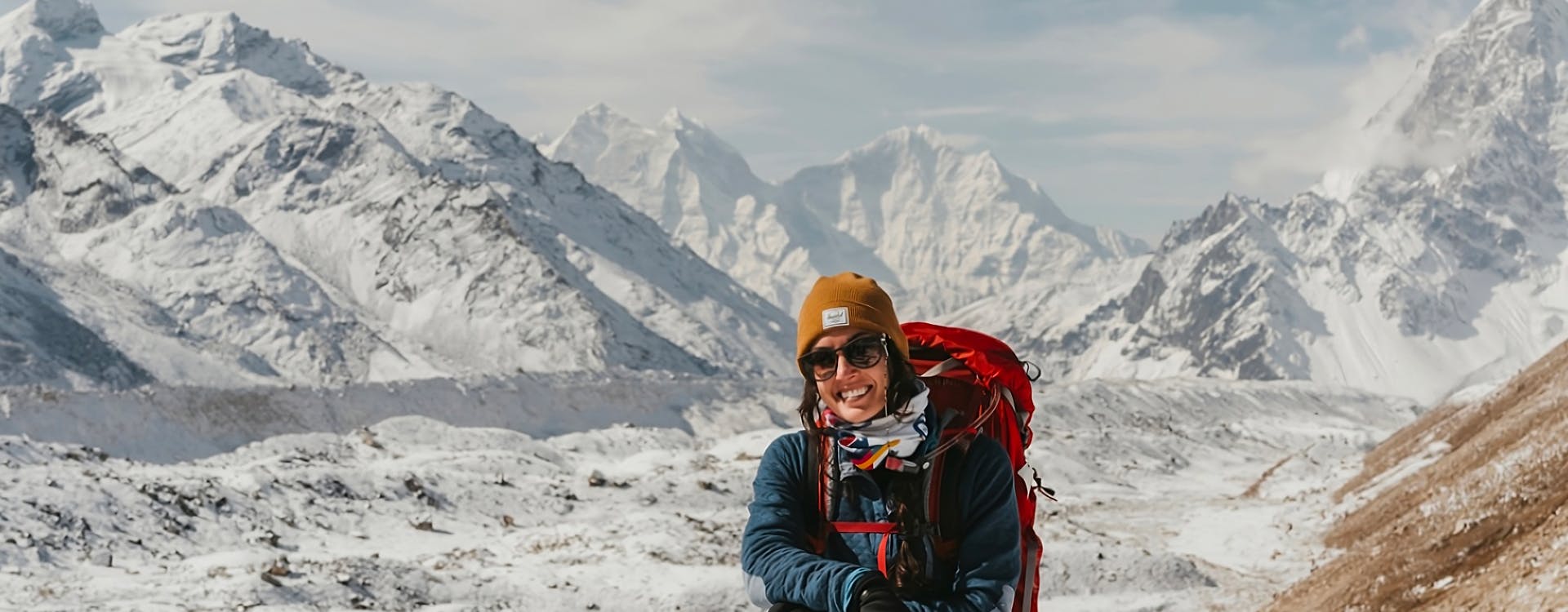
Everest Base Camp Trek
- Customize Trip
- Includes/Excludes
Everest Base Camp Trek is an once-in-a-lifetime adventure for all trekkers. This journey will guarantee the thrill, excitement, and challenge of reaching the foot the world’s highest peak.
At a Glance
Destination, trip difficulty, accommodation, hotel/lodges, max.altitude, march - may & sept - dec, message regarding flight to/from lukla.
During the peak seasons for the Everest Base Camp Trek (March to May and September to November), all the Lukla flights will be operated from the Manthali Airport due to congestion at Tribhuvan Airport.
Trip Overview
The Everest Base Camp Trek is Nepal's most exciting and sought-after routes in the Himalayan region. This is a 16-day adventure to the foot of the Everest, the highest peak in the world. The Everest region got its reputation after Sir Edmund Hillary and Tenzing Norgay Sherpa Climbed to the top of Mount Everest. That expedition led to thousands of climbers and trekker to visit and explore the Everest region.
Commencing the trek, you enter the Sagarmatha National Park, country's first UNESCO natural heritage site. Within its pristine natural beauty, a forest of Rhododendron and Juniper plants in its all-natural habitat. Despite the vegetation, you might see some wildlife such as Impeyan pheasant, bearded vulture, snowcock, and alpine chough.
You will also become familiar with the local Sherpas, one of the Tibetan Ethnic Groups. They offer modern infrastructures with traditional values for all global trekkers. You’ll see the ethnic culture of the Sherpas and their routine in high altitudes. Immerse yourself in their heritage and learn about the Himalayan lifestyle.
You'll also get an enchanting views of the Mighty Everest as well as other peaks such as Nuptse, Lhotse, and Ama Dablam. These peaks dominates the eastern sky for anyone trekking to the Everest Base Camp.
Features of the Everest Base Camp Trek
- Experience an awe-inspiring trek to the foot of Mount Everest (8849m).
- See stunning views of 8000, 7000, and 6000-meter peaks (Mt. Everest, Ama Dablam, Lhotse, Nuptse, Thamserku, and others).
- Experience Sagarmath National Park’s pristine environment.
- Engage with the Sherpa people and experience their rich culture and warm hospitality.
- Visit the renowned Tengboche Monastery and experience its spiritual ambiance.
- Sunrise hike to the Kala Patthar (5,644m), the most beautiful Everest viewpoint in Khumbu Region
- View the grand Khumbu Glacier, the world’s highest glacier, and the formidable Khumbu icefall.
- Fly to one of the world’s most smallest and most naturally challenged airports: Lukla Airport (2845m)
Your Journey to the Everest Base Camp
Your Everest Base Camp Trek starts after arriving at the Tribhuwan International Airport (TIA), where you’ll be received by the Nepal Hiking Team (NHT). Then, you’ll be guided to a hotel in Kathmandu, located near the tourist hub. It’s perfect for exploring the surroundings on foot, doing some shopping, and discovering eateries & restaurants.
After two nights in Kathmandu, you’ll take a flight to Lukla. It takes place at either Kathmandu Domestic Airport or Manthali Airport, Ramechhap, depending on the season. Your 'Everest Base Camp Trek' begins at Lukla Airport.
The trek follows the Dudh Koshi River through Sagarmatha National Park. After spending a night in Phakding, the journey continues towards Namche Bazaar, where you stay for two nights to acclimatize. Stroll to the Hotel Everest View, the highest-placed hotel, and admire ancient stupas, Sherpa museums, and Memorial Stones.
Then, continue your walk-through of the trails to Tengboche monastery at Tengboche Village. You can take your time to adore the mesmerizing view of Everest, Nuptse, Lhotse, and Thamserku. After arriving at Dingboche, you’ll be awed by the outstanding Ama Dablam and walk towards Nangkartshang Peak.
Following the EBC route, you'll reach Gorak Shep after twists and turns through the Khumbu Glacier. After Gorakshep, you finally reach the Base of Mount Everest. You can witness the Khumbu glaciers mesmerizing you as you unwind the timeless beauty of this region. After a few moments of admiration, you will descend to Gorak Shep for an overnight stay.
The next day, you hike to Kala Pathhar to watch the sunrise rising from Everest. You’ll descend to Pheriche, retracing through Tengboche, Phunki Tenga, Kyangjuma, Namche, and Phakding. After Phakding you will conclude your trek by reaching Lukla again.
For any customized EBC trek as per your preference and qualified Everest guide, Contact the Nepal Hiking Team.
Day 01: Arrival at Tribhuvan International Airport, Kathmandu, followed by a transfer to your Hotel
Upon arriving at Tribhuvan International Airport, one of our representatives or guides will greet you with “Nepal Hiking Team” signboard. He will be waiting for you outside and opposite the terminal hall. He will then take you to the hotel.
Day 02: Rest and prepare for your trek
Today is your rest day for the jet-lag recovery. We will brief you regarding your trip, review your itinerary, collect your travel documents (a copy of your passport and insurance), and pay for your trekking package. We will introduce you to your trek guide and provide complementary gear, such as a down jacket, sleeping bag, trek map, duffle bag, etc.
Day 03: Flight to Lukla, followed by a trek to Phakding (2,652m/8,699ft) Distance: 8 km, Duration: 3 hours
The day begins with an exhilarating flight to Lukla, either from Kathmandu or Ramechhap Airport, depending on your travel season.
Upon reaching Lukla, we hike towards Phakding, crossing over Chauri Kharka, Choplung and Ghat. These are some of the Sherpa villages that can be found on the trail to the Everest Base Camp. We spend the night at a guest house in Phakding.
Day 04: Trek to Namche Bazaar (3,440m/11,283ft) Distance: 10 to 12 km, Duration: 7 hours
This day’s hike will be more challenging than the day before. You will begin hiking after breakfast. You will come across Sherpa villages like Benkar and Chumo on your way to Monjo - the checkpoint to enter Sagarmatha National Park.
Before reaching Monjo, the trail will become steeper as you ascend uphill toward Jorsalle village. The hike will lead you to stunning view of the mountains, Kusum Kanguru, Thamserku, Everest, and Nuptse.
You reach Namche Bazaar by hiking up the steep hill with spectacular mountain views in the background. You will spend the night at a guest house.
Day 05: Acclimatization – Hike to Everest View Hotel and back, Distance - 3 to 4 km, Duration: 3 to 4 hour
Today is your first acclimatization day. You spend the day hiking to Hotel Everest View, the highest hotel in the region. Hotel Everest View is a popular hotel in the Everest Region. From here, you will get a unique 360-degree view of mountains such as Ama Dablam, Everest, Nuptse, etc.
After the hike, you will return to Namche and spend the night at the guest house.
Day 06: Trek to Tengboche (3,860m/12,660ft) Distance: 10 to 11 km, Duration: 5 hours
Hike to Tengboche is one of the most scenic parts of the Everest base camp trek. It offers a marvelous mountain view to trekkers walking along this route. Walking above Dudh Koshi River, you will reach Phungi Thanga village.
Crossing over the Imja Khola, the trail will become more strenuous as it will be an uphill walk to Tengbuche. Tengboche is a small Sherpa settlement located under a crescent-shaped ridge. It is famous for Khumbu’s largest Buddhist monastery - Tengboche Monastery.
Day 07: Trek to Dingboche (4,410m/14,464ft) Distance: 11 to 12 km, Duration: 5 hours
Today’s hike start the hike from Tengboche early in the morning. You will come across a few more villages of the Khumbu region, like Pangboche, Somare, and Orsho. The trek will end after arriving at Dingboche village.
Dingboche is the highest settlement area of the Sherpas. At such a height, it is essential to stay hydrated and a good rest. From here you will be ascending to higher elevations.
Day 08: Acclimatization: Hike to Nangkartshang Peak, Distance - 5 to 6 km, Duration: 4 to 5 hours
This is our second acclimatization day. Due to increasing altitude, you will have another day to rest and acclimate. A short hike to Nangkartshang Peak5,083m) will help you adjust to the elevation and keep you active.
The trail leading to Nangkartshang Peak steep and tiring but the view after reaching there is worth the hike. See stunning gigantic mountains like Mt. Makalu, Ama Dablam, Lobuche, Lhotse, Nuptse, Cholatse, and Kangtega. After spending some time on the hill, you will return to Dingboche.
Day 09: Trek to Lobuche (4,910m/16,105ft) Distance: 11 to 12 km, Duration: 5 hours
Today, you will begin trekking towards Thukla. The area becomes desolate and barren from here onwards. You will find only a few alpine shrubs on the trail leading uphill toward Khumbu Glacier.
The trek is more strenuous as it is a steep uphill ascent on the ridge. Once summiting the ridge, you will then reach Thukla Pass. The Pass is adorned with many stone shrines built in memory of those climbers who perished.
After the Pass, you will walk through grassy valleys and rocky terrain to Lobuche village, which generally consists of teahouses catering to trekkers. There are no permanent settlements in this area. You can get a good view of Taboche and Nuptse looming over the tea houses from here.
You can spend your evening hiking to the narrow gap between the moraine and the mountain wall to see the Khumbu Glacier.
Day 10: Lobuche - Gorak Shep - Everest Base Camp - Gorak Shep, Distance: 14-15 km: 8 Hours
The day begins with a morning hike toward Gorak Shep (5,164m/16,940ft), where you ascend to the foothills of Mount Everest. Apart from the thrill of reaching the base camp, you witness the majestic Mt. Everest, Mt. Nuptse, and Mt. Lhotse. At Everest Base Camp (5,364m/17,594ft), you might see ambitious climbers preparing for further ascension to the summit during the spring time.
After reaching the Everest Base Camp, you experience the ultimate joy of overcoming all the hardships along the rocky trails of the Everest region.
The base camp of Everest holds chances for you to receive unique rewards: the attractive sight of the Khumbu Glacier. Capture the beautiful memories before returning to Gorak Shep for an overnight stay.
Day 11: Hike to Kala Patthar - Gorak Shep - Pheriche (4,210m/13,810ft) Distance: 13-14 km: Duration: 7 Hrs
Begin the day before sunrise and hike up to Kala Patthar (5,545 m). This will be an opportunity to witness the sunrise from the peak of Kala Patthar. Although the trail is short, it is a steep and rocky climb and, hence, strenuous.
Kala Pathhar is the highest viewpoint on the Everest Base Camp Trek. The summit view from here is spectacular. You can capture the first rays of the sun lightening the peaks of the Himalayas. Enjoy a panorama of the highest mountains of the world, like Mt. Everest, Lhotse, Ama Dablam, etc.
You will then return to Gorakshep and have breakfast before descending to Pheriche. Before reaching Pheriche, you walk across a rugged trail towards Lobuche and Thukla Pass. Once descending the steep ridge of Thukla Pass, reaching a short bridge over a glacial stream, which after crossing will reach Pheriche. It is a small village with several lodges/tea houses.
Day 12: Trek to Namche, Walking Distance - 14 to 15 km, Duration- 7 hours
Continuing the descent, you head down to Namche Bazaar early in the morning. You revisit some places you bypassed at the Everest Base Camp, like Tengboche, Phunki Tenga and Kyangjum0a. On reaching Namche, you will rest for the day.
Day 13: Trek to Lukla, Walking Distance - 18 to 19 km, Duration - 7 hours
Today is the last day of the trek. You will leave Namche in the morning and retrace your steps back to Lukla along the same route of Jorsalle, Monjo, Phakding and Choplung. By this time, you will end your Everest Base Camp Trek. It is almost time to bid goodbye to the majestic site.
Reaching Lukla, you will be taken to your guest house to recuperate.
Day 14: Return Back to Kathmandu
You will board a flight from Lukla Airport to Kathmandu or Ramechhap Airport early in the morning. Then you will be driven to your hotel.
REGARDING THE LUKLA FLIGHT As per the decision of the Civil Aviation Authority, Lukla flights will commence via Ramechhap during the peak season, i.e., March to May and Oct-November, due to the air traffic congestion at the Tribhuwan International Airport (TIA), to/from Lukla flights will be held via Ramechap Manthali Airport. Ramechhap/Manthali Airport is 132 km from Kathmandu, around a 3–4-hour drive. We will have to leave from Kathmandu approx. 2:00 am to get the flight to Lukla from Ramechap/Manthali airport. Flight from Manthali – Lukla flight: Wake up around 2:00 am, drive to Manthali by shared tourist vehicle for about 3-4 hours, and fly to Lukla (20 minutes). Applicable for the peak trekking month of March, April, May, October, and November. Flight from Kathmandu – Lukla flight: Wake up around 5 to 6 am and drive to the domestic airport in Kathmandu for about 30 minutes and fly to Lukla (35 minutes). Applicable for the remaining months, except peak trekking months. We will arrange a transfer between Kathmandu to the other airport without extra cost. We use the sharing vehicle.
Day 15: Reserve day in Kathmandu
We have kept this day as a buffer day to deal with unexpected delays and cancellations of flights due to weather changes. This will avoid the hassles of changing international flights.
Alternatively, if there are no delays and the plan works out as scheduled, you can use this day to relax. You can go on a city tour, get a massage, or do any other fun activities in the city.
Day 16: Tour Ends/Departure
This is the final day in Kathmandu. One of our staff will escort you to Tribhuvan International Airport 3 hours before your departure time.
If the above Everest Base Camp Trek itinerary does not meet your needs, we can design individualized travel plans based on your preferences and specifications.
Cost includes.
- All ground transport in a private vehicle, including airport transfers.
- Four nights' accommodation with breakfast at a 3-star category hotel in Kathmandu.
- Three daily meals with tea/coffee (breakfast, lunch, and dinner) during the trek.
- Best available twin-sharing lodge for accommodation during the trek. Private bathrooms with hot showers are provided at Phakding, Namche, and Lukla.
- Snacks of seasonal fruits during the trek.
- One highly experienced, helpful, and friendly guide. Porters (1 porter for two people) including their food, accommodation, salary, and equipment. Accident insurance for all staff.
- Round-trip to/from Lukla, including transfers. (Flights operate via Ramechhap Airport during peak season).
- Use of down jacket and sleeping bag while trekking.
- Duffle bag for trekking.
- Trekking map and trip achievement certificate.
- First aid medicine kit including oximeter to monitor oxygen level and heartbeat.
- Sagarmatha National Park Permit fee.
- TIMS Fee- Trekkers' Information Management System (Please bring two passport-size photos for the permit).
- Government taxes & office service charge.
Cost Excludes
- Lunches and dinners while in Kathmandu.
- Personal travel insurance.
- International airfare.
- Nepal entry visa. Upon arrival at Tribhuvan International Airport in Kathmandu, a visa can be obtained quickly. A multiple-entry tourist visa for 30 days is available for US $50 or equivalent in foreign currency. Similarly, a multiple-entry tourist visa for 90 days can be obtained for US $100. Please bring two passport-size photos.
- Soft drinks, including water.
- Snacks and other personal expenses.
- Hot showers during the trek, except in Phakding, Namche, and Lukla.
- Personal trekking equipment.
- Wi-Fi internet and phone calls unless they are free.
- Tips and gratuities for trekking staff and drivers.
Cost and Date
Start Dates refer to your arrival date in Nepal. End Dates correspond to your return date from Nepal.
The Everest Base Camp Trek set departure dates are tailored for the group joining option. If the - days Everest Base Camp Trek departure dates don't fit your schedule, we can include alternative dates that better suit your needs.
Trip Route Map
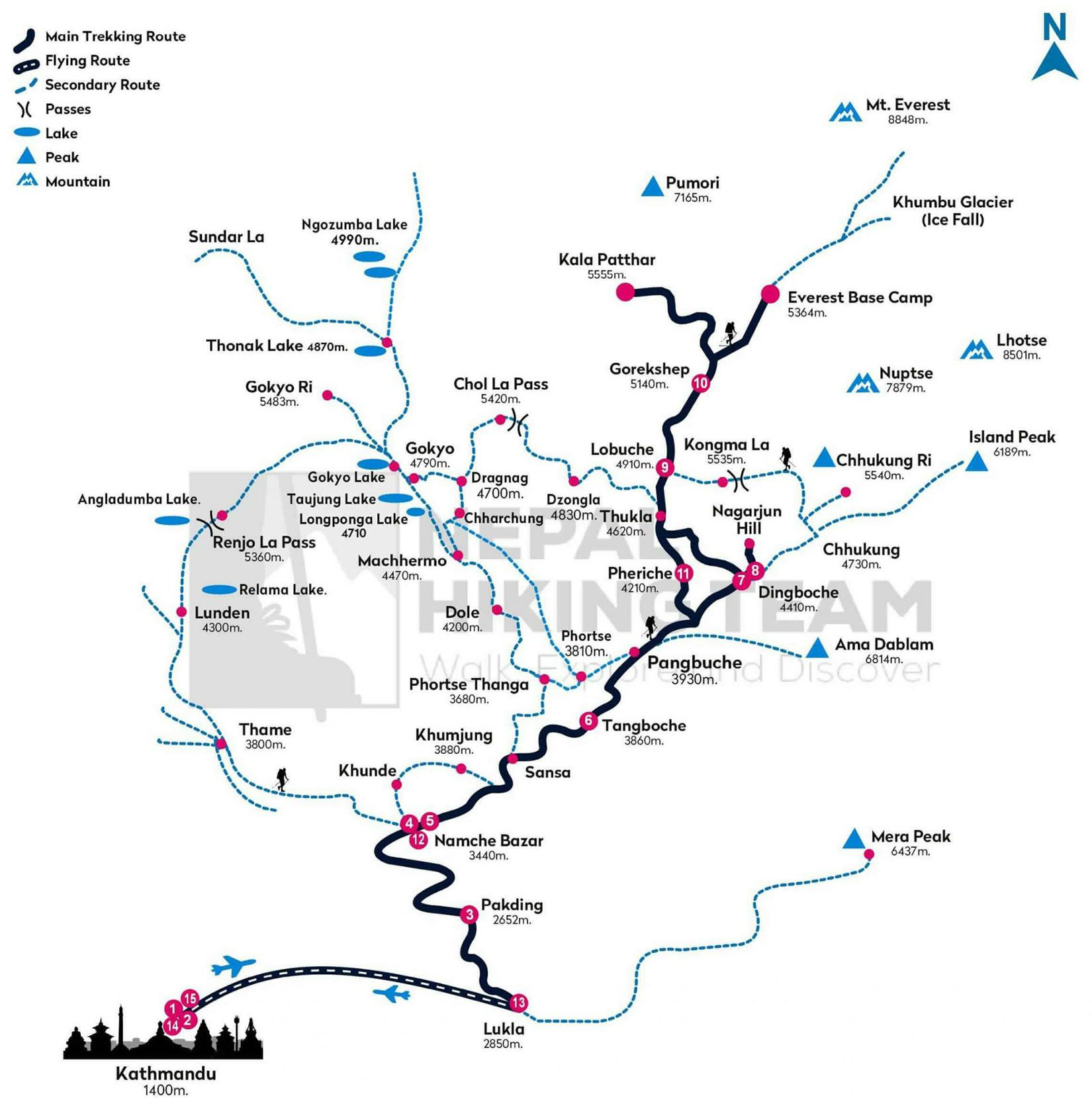
Media Gallery
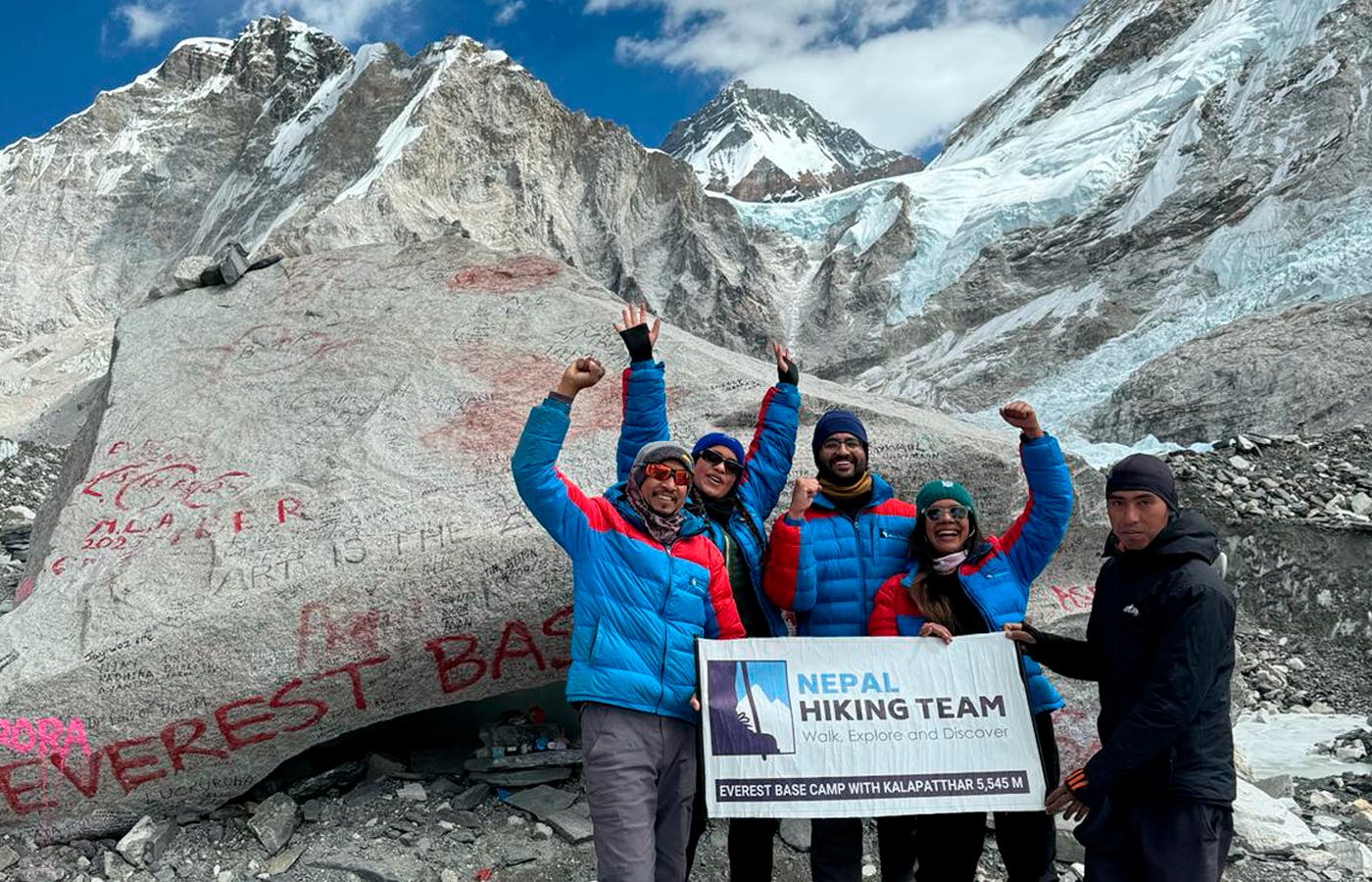
Good to Know
Tips for everest base camp trek.
- For the best experience, aim to hike between March to May or September to December, when the weather conditions are most favorable.
- Prepare yourself physically and mentally, as consulted by our trekking leaders, 2-3 months before venturing for the trek.
- Carry protein bars and dried fruits for snacking up in the mountains. Hot lemon, green tea, lemon tea, or garlic soups are great options for hydration at higher elevations.
- Be responsible for your travel. Avoid bottled water and other plastics for ecological safety and to maintain the beauty of the place.
- Not necessarily to mention, but remember to take pictures via camera with a beautiful background of the Everest region.
- Never let your body face dehydration and digestive discomfort; avoid junk foods, alcohol, and dairy products at all costs.
- Follow the expert guidance and take enough time for acclimatization. If you face symptoms of Acute Mountain Sickness or AMS, contact your guide ASAP.
- Take personal responsibility for your valuables; store them in your backpack or rucksack.
- Explore the Nepali culture and traditions through our guides and local people.
- For internet access, buy the Everest Link Card for USD 2 - 4, cheaper than Airlink. Make sure to buy a sim card too from Nepal Telecom or Ncell.
- For charging your device, you have options of two and three-pin plug points at USD 1-4 per hour. The electrical standards of Nepal are 230Vvoltage and 50 Hz frequency.
- Device charging facilities are in high demand during peak seasons. So, do carry power banks as an alternative, and to save money in charging.
- Carry cash of NPR 18000-20000 (Roughly USD 180-200) per person for extra expenses like shower, device charging, and Wi-Fi during the EBC trip. Visit one of the money exchange centers or use ATM stations available 24/7 in KTM.
- Feel free to appreciate your guides with tips, for their support – a common practice in Nepal.
- Feel free to extend your travel plan with one of our tour packages leading to Kathmandu, Bhaktapur, Patan, or Chitwan.
- You can choose a private or group trip to Everest Base Camp. You can benefit from our competent guides, sales, and logistics personnel who will cater to your needs.
Everest Base Camp Trek Video
Key Information
Is the nepal hiking team different from others.
- NHT is a trusted company with a 99% success rate. Most clients are repetitive due to our core values of transparency and honesty.
- The company is run by co-founders Ganga Thapa and Balaram Thapa, with over three decades of professional and hands-on experience in the field.
- The company has won the Travelers’ Choice Trip Advisor Certificate.
- NHT has been serving clients like family members since 2009.
- The NHT professional guides are trained from TAAN and NATHM and have 10+ years of experience.
When is the best time for trekking?
March to early May and September to November are the most suitable times for trekking in Nepal. You can consider treks from December to February to evade too many people on the trails, but the temperatures are colder. We would recommend you not to choose the time from June to August, as it is the rainy season, and mountain views are obscured by clouds. Also, there is a high chance that fights to Lukla can be delayed. Trekking routes, too, can be wet and slippery, creating risks while walking. However, if you have a time constraint and can only trek in winter or monsoon, please write to us, and we will respond accordingly.
I have trekking experience. So, do I need a guide?
We strongly recommend a qualified guide during the trek. In remote areas like Everest Base Camp, the guides help to resolve urgent problems that may arise unpredictably. Besides keeping you on the right track on the Everest Base Camp route, they create alternative plans to ensure the success of your trek. We recommend a well-trained guide. Attend an orientation given by them.
Do the guides speak English?
Yes. Some are fluent, but everyone can converse well in English. They also aid in communication with local people.
Do I need previous trekking experience?
No. However, the experts recommend cardiovascular exercises, gym workouts, and hiking practice before ascending the Everest zone. You should eat food with enough protein, carbohydrates, and essential vitamins and minerals to support your physical training. The trek preparation is crucial for avoiding altitude sickness and remaining in good condition.
Is it safe for female travelers to trek solo?
Yes. The Nepal Hiking Team supports solo female travelers wanting to hike the Everest Base Camp with individual consultation, guides, and porters. For more security, travelers can opt for NHT’s trustworthy partners in lodging and food.
Food and Accommodation
What meals can i get during the ebc trek.
The local teahouses serve various fresh and nutritious meals along the trails. You can also get vegetarian, vegan, and gluten-free meals. Menus consist of both international and local cuisine. Please review https://www.nepalhikingteam.com/food-during-the-everest-base-camp-trek for more information.
The local teahouses serve various fresh and nutritious meals along the trails. You can get a mix of local and international cuisine. Nepali Dal-bhat is a good choice because it is a good source of carbohydrates and protein. If you’re vegetarian or require gluten-free meals, we can accommodate your diet choice during the EBC Trek.
Please review https://www.nepalhikingteam.com/food-during-the-everest-base-camp-trek for more information.
What kind of toilet facilities are available during the EBC Trek?
Teahouses at lower elevations usually have western-style toilets and good water supply. Bathrooms are generally shared and only luxury lodges have attached bathrooms at lower elevations. Teahouses higher up have the Asian style toilets.
What type of accommodation is available on the EBC Trek?
You will find teahouses, lodges, and guesthouses along the EBC trails and they offer comfortable rooms. Note: usually, two trekkers occupy a room.
How do I access drinking water?
You can buy mineral water or boiled water in the teahouses. On the trails, you can get water from public taps or springs, but you must treat it with water-purifying tablets. Bottled water pollutes the environment, so we possibly suggest you use treated water, as it will help to keep the Everest region clean.
Besides, as you go higher, the cost of bottled or boiled water increases.
Note: You can use water purification tablets that our guide will carry on the trek.
What kind of toilet facilities are available during the EBC Trek?
Teahouses at lower elevations usually have sitting toilets and a good water supply. Our itinerary includes private bathrooms, available only in Lukla, Phakding, and Namche. Teahouses at higher elevations have squat toilets, and they are shared.
Booking and Payment
Do you require a deposit to confirm my ebc trek.
Yes, you have to make a 20% deposit of the total cost to confirm your EBC Trek with us.
How do I book my EBC Trek with you?
In order to book your trip with us, please follow these guidelines step-by-step.
First, you must check the itinerary on our website, as recommended in our email correspondence. We can also customize the itinerary as per your preferences and requirements.
If the itinerary meets your needs and requirements, please contact us to learn about its availability. Also, check our departure dates.
Upon confirming with us, you now need to complete your reservation form either via the departure date (book now bottom) or by sending us a direct booking link.
After that, you can deposit 20% of the total cost and pay the remaining amount once you arrive in Kathmandu (either by card or cash in US dollars). You will receive a payment link via email.
What is your cancellation policy?
We have a simple and straightforward cancellation policy. If you are required to cancel your trip, please send us a trip cancellation request, and we will process it. Keep in mind, the 20% deposit is non-refundable. However, we do offer the option to reschedule, allowing you to apply your deposit as a credit for a future trip that better fits your schedule.
How do I pay my remaining balance on my arrival in KTM?
You can pay your remaining balance either in cash or with a credit card. However, with credit cards, we charge a 3.5% fee, so we recommend you pay in cash if possible.
Practical Information
I would like to learn about the flight to lukla.
Nowadays, most of the flights to Lukla have been redirected from Ramecchap. Especially during the peak season, it has become necessary, as flights from Tribhuvan International Airport (TIA) to Lukla often face air traffic holds, delays, and an increased risk of cancellations.
Ramechap/Manthali Airport is 132 km from Kathmandu, approximately a 4-hour drive away.
If the flight to Lukla gets canceled or delayed, what are the options?
If the flight gets canceled or delayed, the options are to take another flight the next day or reschedule a flight from Ramechap and stay the night there. FYI, we only fly to Lukla when the weather is clear and in favor of travel. Thus, we advise you to keep a couple of extra days in the itinerary for this situation so that you can return home on time if unpredictable weather or emergencies occur. If available, we can also arrange a helicopter to Lukla, which will cost extra.
Should I tip my guide and porter?
Tipping your guide and porter is a great way of expressing your thanks and appreciation. They have worked hard to provide you with a wonderful and fulfilling trek and were your key companions in times of joy and difficulties. Though not compulsory, we recommend tips to trekking staff, a common and practiced norm in Nepali culture.
Can I extend my trek with extra days?
Yes, you can if you have booked a private trek with us. The private trek is highly flexible, unlike group treks, and we can customize your itinerary to your preferences and requirements.
Will there be other extra costs in Nepal?
Yes, there will be extra costs like for showers, extra snacks, charging of electrical devices, Wi-fi, etc. Also, in case your Lukla flights get canceled or you decide to hire a helicopter, you must have funds in cash or on a credit card. Tips for guides and porters are also extra costs.
How much cash do I need to carry on the trek?
You should carry extra cash for other expenses (showers, Wi-Fi, snacks, mineral water, etc) on your trek. NRS. 18000-20000 (Roughly US$ 180-200) per person is a good amount and teahouse/lodge owners accept only Nepalese currency.
Can I withdraw money from ATMs in Nepal
Yes, most of the places in Nepal facilitate the convenient use of credit cards. Locations such as Kathmandu, Lukla, Phakding, and Namche Bazaar are well-equipped with ATMs, simplifying cash withdrawals for trekkers. Utilizing a credit card is not only practical and secure, but it also means carrying less cash.
Who is Eligible?
Is there any age limit to trek in nepal.
There’s no age restriction for anyone considering trekking in the Himalayas. If you are moderately physically fit, you can do any of our treks. We have different packages for all age groups, and we can personally design a package to suit your needs and requirements. You don’t need to feel worried about your plans not working because of the age limit.
You do not require prior trekking experience. As long as you prepare well, you can complete trek to Everest Base Camp. You will walk six to seven hours daily, so we advise you to take up physical training such as cardiovascular exercises, gym workouts, and hiking to nearby hills. You should also eat nutritious diets, which have a good protein and carbohydrate base supplemented with vitamins and minerals.
Is it safe for female travelers to trek solo?
We ensure that females can trek solo accompanied by our guide. The local people in the Himalayas are also welcoming and hospitable. Besides, our guides are alert and aware of our guests during the trek, so feel confident that solo female trekkers are safe in the mountains.
Is it okay to join a group as a solo traveler?
Yes, you can join a group as a solo traveler. We organize several small group-joining treks, so you don’t need to worry about your planned trek being disrupted. The departure dates are guaranteed, and you can be assured that they all occur on the specified dates.
Trekking Fitness
Is trekking in ebc difficult how many kilometers (or miles) is the everest base camp trek.
The EBC trek is challenging in terms of distance and acclimatization. With good preparation, be ready to walk 6-7 hours a day.
The EBC trek is 80.8 miles (Roughly 130 km) long. We trek via Luka – Namche – Dingboche – EBC – back to Lukla. It sounds quite daunting, but it is achievable, as you will cover approx. 15km (9.32) a day, and we complete our trek with an eleven-day walk. The shortest walk of the hike is about 3 - 4 km a day, and the longest would be 20 km of the journey.
How do I get fit for trek?
If you are planning a trek, it is advised to prepare physically at least a couple of months ahead. Cardio exercises such as running, jogging, distance walking or swimming are highly recommended. Also, hiking near your place is a good way of building up your stamina, strength, and endurance.
How can I be confident in knowing I am fit to do the EBC trek?
You should do a physical health examination if unsure about your physical condition. If you suffer from serious health problems that impact your breathing, coordination, balance or other things, you must consult your physician and get feedback.
Trekker’s Well-Being and Safety
Is it necessary for me to carry a first-aid kit.
First-Aid Kits are essential on any trek, and our guides always carry them. The kits have all the required medication, including an oximeter. So, you should carry your own medicines.
What is the Khumbu cough? How can I prevent having it?
During your ascent on the EBC Trek, you may get the Khumbu or hacking cough. Many trekkers get it when they are continuously hiking at high altitudes.
So, it’s important that you
- Keep your neck, mouth, nose, and chest protected,
- Cover your mouth and nose with a buff,
- Ensure your chest and neck are kept warm,
- Use a scarf or balaclava to protect your neck when you sleep at night
- If needed, suck throat lozenges
- Make sure you’re drinking warm water, and
- Adopt a slow pace while taking regular breaks.
Will I get sufficient acclimatization time with the trekking itinerary?
Yes, you will get enough time to acclimate on the EBC Trek, as the itinerary has been carefully planned to prevent Acute Mountain Sickness (AMS). It commonly happens at upper altitudes, and, as a trekker, you need to walk at a steady pace so that your body can gradually adapt to the higher altitude.
If I experience symptoms of altitude sickness, what do I do?
If you experience any symptoms such as headache, nausea, dizziness, vomiting, or shortness of breath, you must immediately inform your guide. They will quickly assess the situation and decide the best steps for you. Sometimes, you will be taken to a lower altitude to lessen the symptoms.
Our guides will also be checking your oxygen level regularly with an oximeter. Upon advice, you can take Diamox for altitude sickness.
What are your safety measures/practices? Are your guides qualified to handle medical emergencies?
Our highest priority during a trek is your health and safety. Our guides will be monitoring you closely, observing any signs of altitude sickness, etc., and measuring your oxygen level regularly. They will have first-aid kits and rescue equipment and, with their phones, can contact the office team in Kathmandu in emergencies.
During the trek, if you get sick, we will arrange for you to take a day’s rest. But if you can’t continue the trek, our guides will arrange for you to be taken to Namche, Pheriche or Lukla, where the nearest healthcare center or clinic exists. If the situation is serious, however, a helicopter will transport you to a hospital in Kathmandu.
Our guides have undergone comprehensive first-aid training and are experienced in high-altitude rescue. Be assured that you are in safe hands to confidently and comfortably enjoy your trek.
What immunizations are necessary?
Vaccination are not require but you can refer to CDC Standard vaccinations are normally recommended. Please look up the CDC link (https://wwwnc.cdc.gov/travel/destinations/traveler/none/nepal. You need to inform us if you have any previous medical conditions when you make the deposit.
Arrival in Nepal and Visa
Who will pick me up at the airport on my arrival.
You'll see one of our staff at the Tribhuvan International airport. He'll be easily spotted as, he'll be holding a “Nepal Hiking Team” display board. In case you have difficulty finding him, please do call us at our emergency contact numbers: 0977-98510 58678 (Ganga) or 0977-9851058667 (Balaram).
Note: Please be attentive and cautious on the arrival outside the arrival building. People here may offer to help you with your luggage or transportation and ask for money. Wait for our staff to pick you. They will never ask for money.
Upon arrival at the airport, can I get a visa for Nepal?
Getting your visa for Nepal on arrival at the airport is possible. Depending on the rush, it takes about 20 minutes to an hour. Please note you need to fill up the application form online before you arrive at the entry point.
Important Notes
- The immigration office at the Kathmandu airport is open 24/7.
- To apply for a visa in Nepal, you need to have a passport with a validity of at least six months and your passport needs a blank page for the visa stamp.
- You can pay visa fees either by cash or credit card.
- Please remember that travelers (citizens), namely from Nigeria, Eswatini, Ghana, Afghanistan, Zimbabwe, Somalia, Cameroon, Iraq, Syria, Ethiopia, Liberia, and Palestine, must obtain a Nepal Visa before arriving in Nepal. They are NOT eligible for an ON-Arrival visa.
- Indian citizens do not need to apply for visa for their trip to Nepal.
Please visit Visa Information on our website, which provides detailed information (visa application, visa fee structure, etc.)
Which hotel will I stay at in Kathmandu?
We will arrange for you to stay at a comfortable and centrally located 3-star hotel. Located on the outskirts of Thamel, usually, we use Woodapple Hotel and Spa or similar and has easy access to closeby markets and restaurants. However, if you have any particular hotel (4 – 5 stat category) in mind, please let us know, and we’ll do our best to meet your needs.
Can I book extra hotel nights in Kathmandu?
Yes, you can book extra hotel nights in Kathmandu. Generally, three-star hotels charge US $55 for double/twin rooms and US $50 for a single room. We recommend the Woodapple Hotel and Spa, which is located on the outskirts of Thamel and convenient for shopping and eating out.
Electricity, Gadgets, and Internet Availability
Can i charge my mobile phone and other devices during the trek .
Yes, you can charge your devices in teahouses, as they have electricity. The two-pin and triangular three-pin varieties are common plug points. Charging services are usually US $1 to $4 per hour. We recommend power banks especially during the peak season, so that you can charge at your convenience.
Will I be able to access Wi-Fi during the trek? Can I use mobile data?
Yes, you can use the internet, as many teahouses provide Wi-Fi. If you want to purchase the Everest Link Card along the way, it costs $2 to $4. Airlink is also available, whch charges NRs. 700 (US $6-7) for 24 hours and NRs. 1200 (US $9-10) for 48 hours. You can use mobile data too, but you need to first purchase a SIM card and data packs from Ncell and Nepal Telecom.
Travellers‘ reviews
Review (s) summary, video reviews: everest base camp trek.
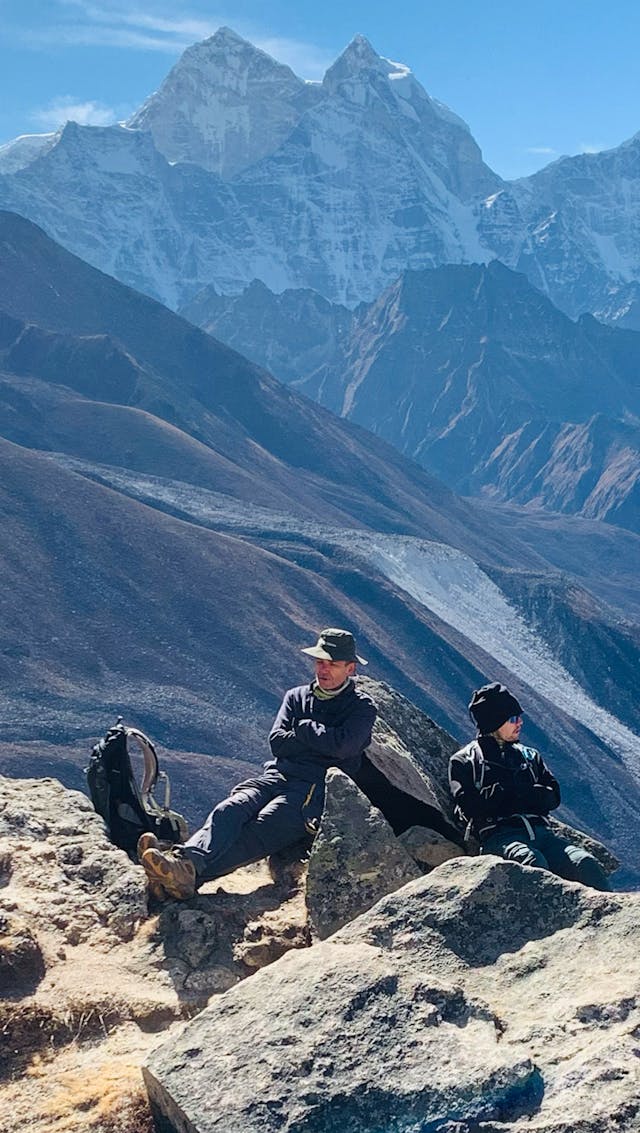
Incredible view of the Khumbu Glacier. #Mike
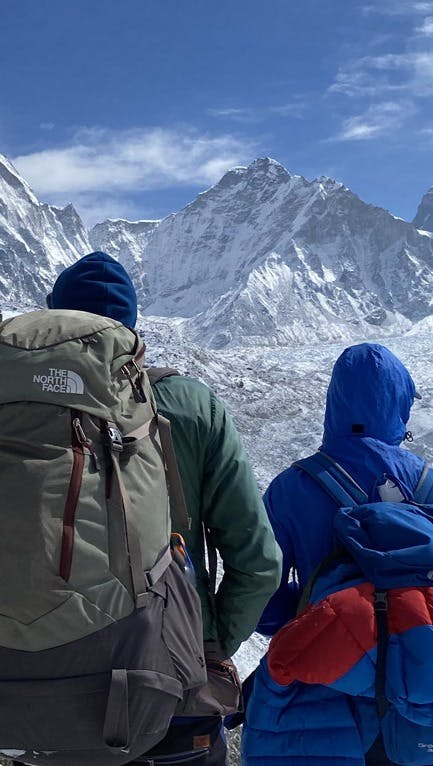
Everest Base camp Hiking
NHT - Everest Base Camp
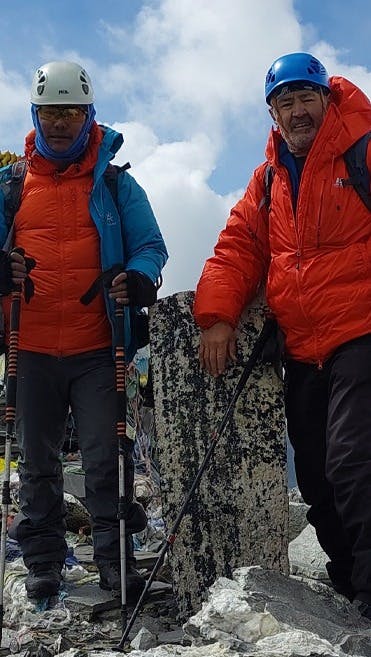
EBC Trek #nepalhikingteam
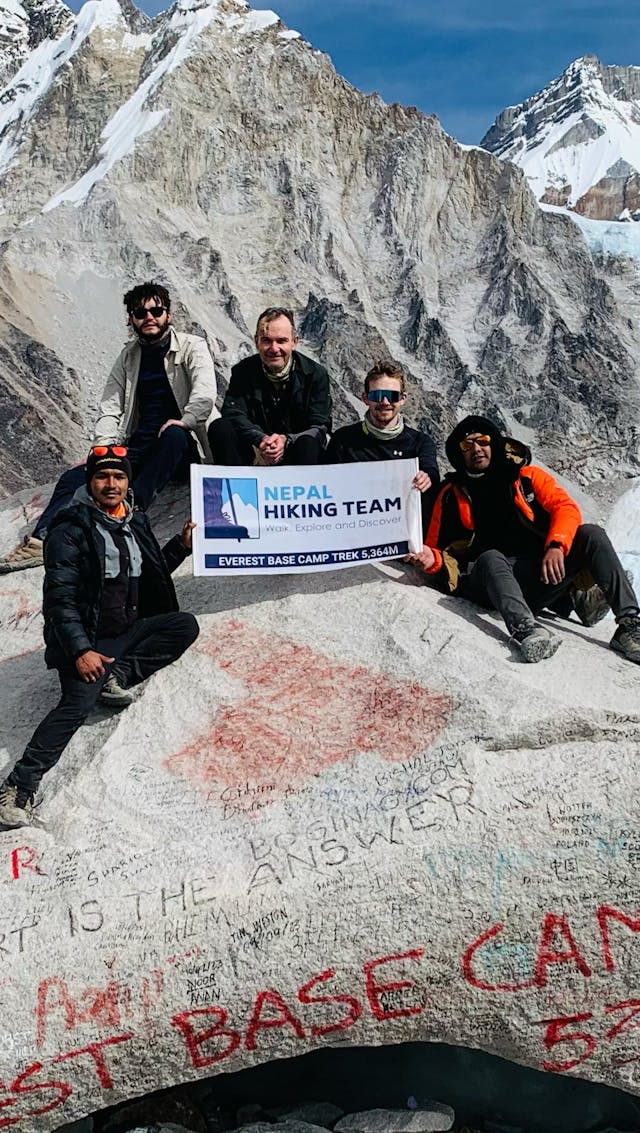
EBC trek in December
Thomas Bryanhealey, Australia
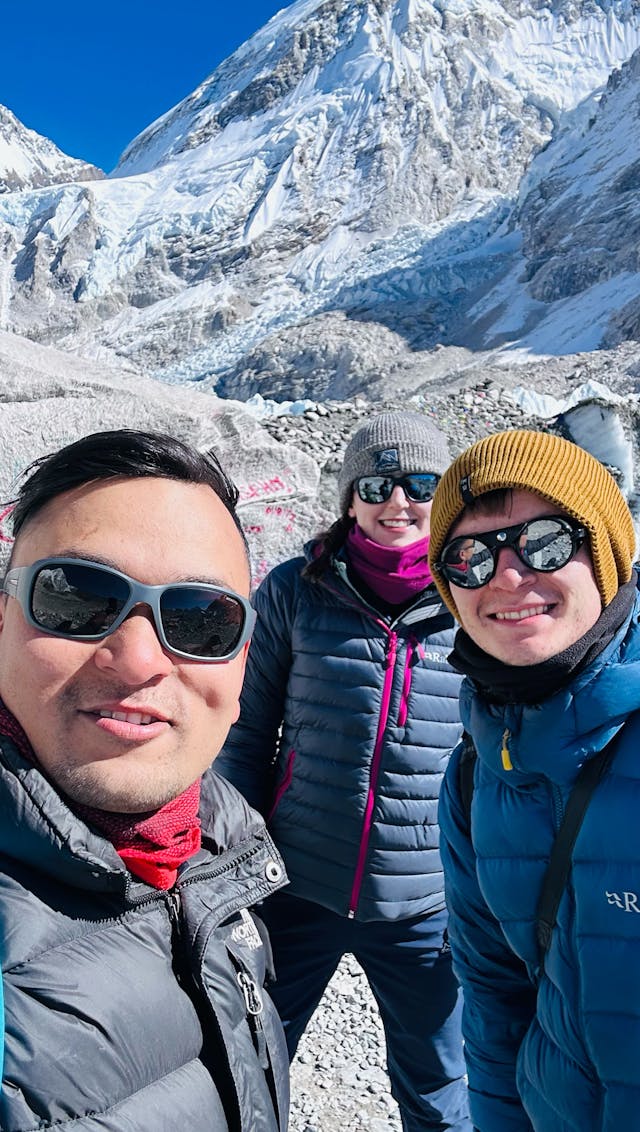
Everest Base Camp
Daniel Joseph Horner | England
Amazing experience
My experience with the Nepal Hiking Team on the EBC trek was nothing short of incredible.
Pawan and his team extended unparalleled patience and support. They enveloped every one of us in care, attentively ensuring all our needs were gracefully met.
Pawan, alongside the extraordinary assistant guides Nima and Shabeen, showed remarkable dedication throughout our journey. With Pawan’s guidance, we were encouraged to pace ourselves gently to stave off altitude sickness—a decision I’m convinced played a pivotal role in our entire group finishing the trek seamlessly and in good health. The accommodations were comfortable, and to my surprise, the food consistently delighted me, surpassing my expectations.
Once back in Kathmandu, boss Ganga proved to be an invaluable asset, always available and incredibly swift in responding to any queries I had regarding the trek.
With a heart full of gratitude, I wholeheartedly recommend the Nepal Hiking Team for the EBC or any trekking adventures in Nepal. Their empathy, expertise, and unwavering support have etched this journey in my memory, making it profoundly special.
Wonderful trek with Nepal Hiking Team Manoj
I recently returned from an unforgettable 12-day expedition to EBC , facilitated by the Nepal Hiking Team. From the moment I initiated contact for booking and inquiries, the Nepal Hiking Team was impressively swift in providing responses.
Our group of three was completely satisfied with every aspect of their service – from the essential information provided before our arrival, the smooth transportation arrangements to and from the airport, to ensuring our accommodations were comfortable throughout our stay, and much more.
Our guide, Manoj, was not only experienced but also exceptionally warm and knowledgeable, making us feel safe and well-cared-for on our journey with him. The thoughtfulness behind the itinerary was evident, featuring a manageable daily hiking schedule and sufficient time for acclimatization to the altitude, which was crucial for our health and comfort.
My happiness with choosing the Nepal Hiking Team for our trek knows no bounds, and I wouldn't think twice about booking with them again for my subsequent adventures in Nepal. Their attention to detail and the personalized care they provided made our experience truly remarkable, and I look forward to planning another trek with them, confident in the exceptional experience that awaits.
Epic EBC trek with seamless organization and an incredible guide! Loved it!
My husband, sister and I had an amazing trek to EBC, which was fully coordinated by the Nepal Hiking Team. They also helped us organize a helicopter for my parents to meet us at Gorekshep. Ganga, Balaram, and the full NHT team did an awesome job managing the many moving pieces (weather, hiking pace, helicopter schedules etc.) to make the whole experience come together so perfectly and seamlessly. We cannot thank them enough!
We also had the BEST guide in Arjun! He is a wonderful, humble, and incredibly knowledgeable guide who went above and beyond to make us as comfortable as possible throughout the trip. His stories about the mountains, the local culture, and his personal experiences added so much more context and understanding, bringing the whole experience to life.
With him, we truly felt like "we came as guests and left as friends". Arjun ji - thank you for bringing such a calming & fun energy to our trek! Good luck on all your upcoming adventures, hopefully we'll be able to join you on another one of them soon!!
Mrs. Romina Nair
Ebc trek in december 2023.
In December 2023 my friends and I embarked on a journey, to the Everest Base Camp alongside the Nepal Hiking Team. It was truly an experience although we did encounter some challenges in Kathmandu before we began our trek.
Ganga, one of the team members went above. Beyond helping us overcome these issues ensuring that our trip was enjoyable and successful. We are truly grateful for his efforts. Ultimately three of us managed to reach the Everest Base Camp on foot while one of our group members opted for a helicopter ride. The important thing is that we all accomplished our goal.
Throughout the trek, Arun served as our guide providing support along with Susan and Ram who carried our belongings as porters. Their dedication ensured that everything went smoothly. We were incredibly fortunate to experience weather in mid-December. It was chilly. With clear skies and plenty of sunshine.
The added bonus was the lack of crowds. Again I want to extend my thanks to Ganga and his team, for their incredible help, throughout this unforgettable journey. I wholeheartedly recommend them! Thumbs up all the way! 👍👍👍
Unforgettable Everest Base Camp Trek
Earlier this year, I went on a memorable trek to the Everest Base Camp with the help of the Nepal Hiking Team. My guide, Ramesh Adhikari, was really helpful and made the whole journey enjoyable. The places we stayed at were cozy and welcoming, and the team's planning made the trip hassle-free. I would like to give a special shoutout to our porter, Bange, for his amazing strength and positive attitude.
The Nepal Hiking Team showed great professionalism and dedication towards ensuring that we had a fantastic trekking experience. Despite the cold weather, the journey was worth it, and it gave us a chance to appreciate the beauty and power of high altitudes if you're planning to trek in Nepal.
I highly recommend the Nepal Hiking Team. They have the expertise and genuinely care about making your journey in the Himalayas an unforgettable experience!
Ms. Elli Hoskin
Make an inquiry, you may also like, subscribe our e-newsletter.
Sign up for Deals and Discount. Get News, Notifications and Updates about the recent Events and Offers.

- Best Hikes In The World
- Appalachian Trail
- European Hikes
- Nepal Hikes
- Patagonia Hikes
- See All Hikes
- Mount Kenya
- Mount Kilimanjaro
- Mount Toubkal
- See All Mountains
- South Africa
- New Zealand
- Switzerland
- United Kingdom
- Packing Lists
Everest Base Camp Trek – Nepal’s Most Famous Trek
Asia , Nepal
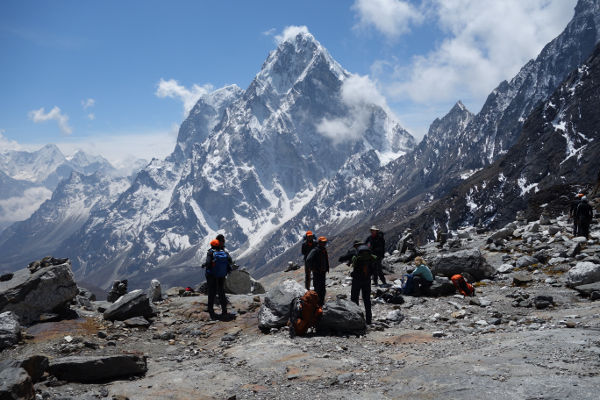
The Everest Base Camp Trek is one of the most popular and best treks in Nepal .
Home to four of the six highest mountains in the world – Mt. Everest (8,848 meters), Mt. Lhotse (8,516 meters), Mt. Makalu (8,470 meters) and Cho Oyu (8,201 meters) – the Everest (or Khumbu) region affords trekkers the opportunity to hike in one of the grandest and most awe-inspiring trekking areas in the world.
Trekkers get to retrace the footsteps taken by Sir Edmund Hillary and Tenzing Norgay on their historic Everest expedition in 1953.
On this page, you will find a comprehensive and impartial guide to the Everest Base Camp Trek.
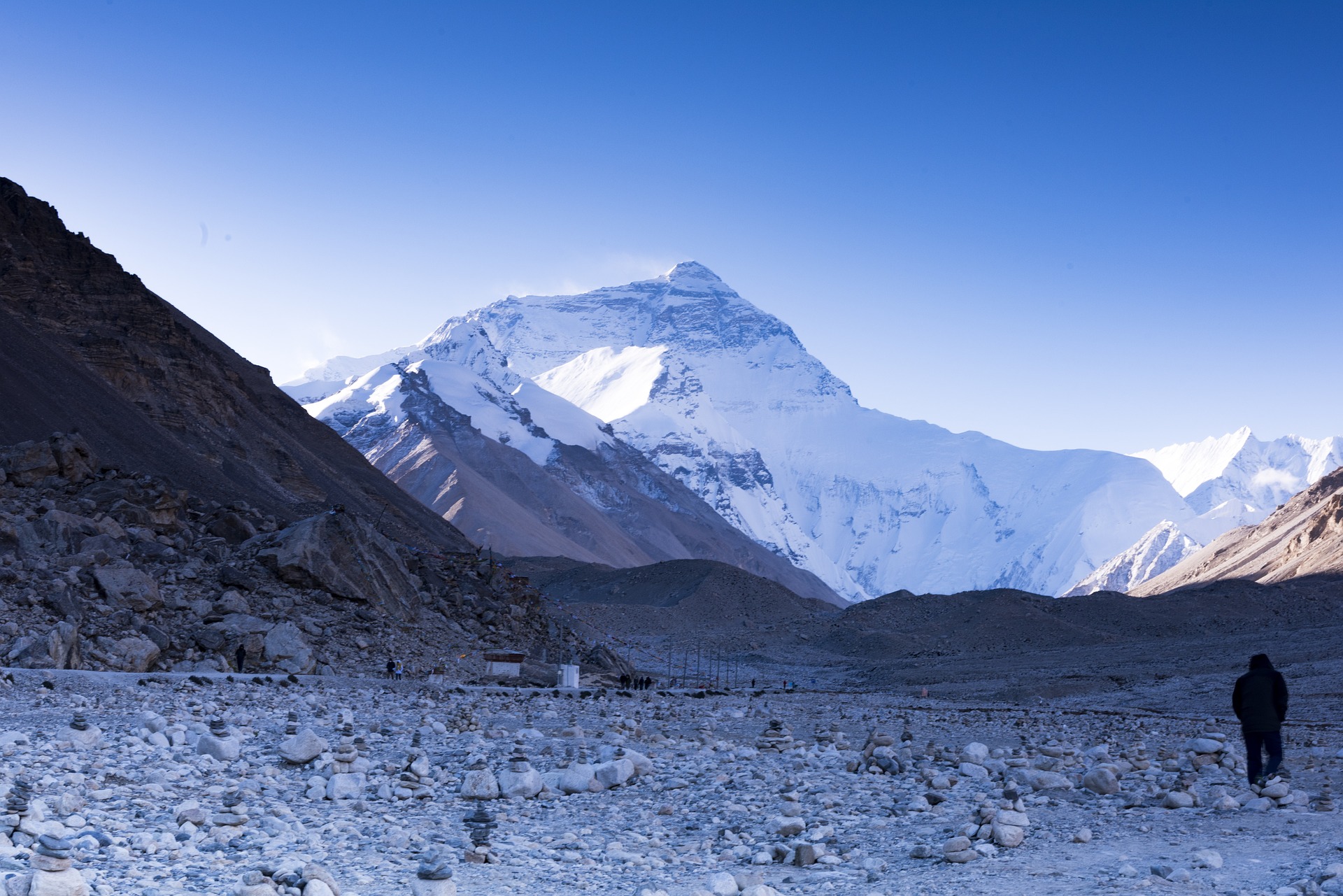
Everest Base Camp Trek
Ebc hike overview.
In this detailed Everest Base Camp trek article, you will find information on the typical route and its variations; a day-by-day itinerary breakdown of the trek; practical information on accommodation, meals, permits, equipment and insurance; as well as guidance on the best time to trek Everest Base Camp.
Key Highlights
Highlights on the trek include: unforgettable mountain views from Kala Patther , including Mt. Everest; the chance to see the famous Everest region Sherpas and Sherpa town – Namche Bazaar; sightseeing in the Sagarmatha National Park – a World Heritage Site; glimpses of the highest Buddhist monasteries in the world; and a sneak preview into the inner workings of the base camp to the world’s highest mountain.
Everest Regional Map
The Everest Base Camp trek is situated in the Everest, or Khumbu region of Nepal (see map below). It is the most popular trek in the region, if not the country.
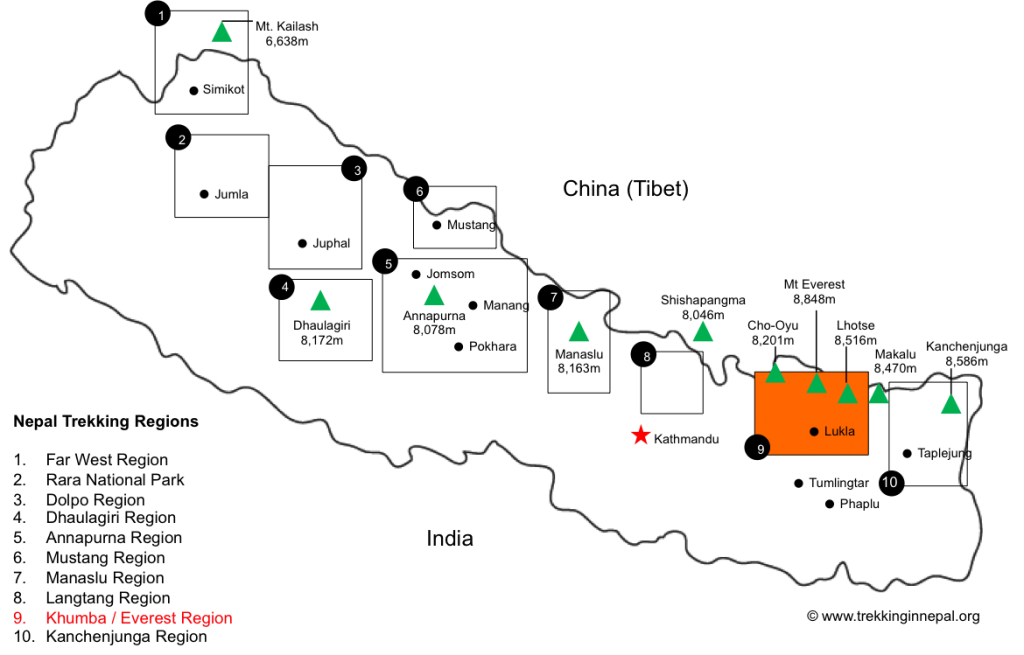
EBC Recommended Map
This map is one of the better representational schematics of the Everest Base Camp trail (we believe it is from GlobeTrekker but can’t be certain as there are many maps scattered across Google Images).
The map above shows the classic Everest Base Camp trek running up from Lukla to Namche Bazaar and then veering North-east up to Periche / Dingboche. From Dingboche / Periche the trail turns North-west to Lobuche before heading north gain to Gorak Shep. From here Everest Base Camp can be seen to the East and Kala Patthar in the North-west.
The map also shows the route to Island Peak in the East, via Dingboche and Chhukung, and the Gokyo Lakes in the West.
Please Note: The above recommended map is not to scale and should not be used as an accurate representation of the Everest Base Camp trek route. We provide links below to excellent maps of the Everest region.
EBC Trek Itinerary
Most trekkers fly from Kathmandu to Lukla Airport to begin their Everest Base Camp trek. The ‘classic’ or typical route follows straight up the Khumba Valley and through the Sagarmatha National Park to Everest Base Camp.
Variations via Gokyo Lakes or Chhukhung Valley are also popular (see the variations section below).
The typical Everest Base Camp trek duration is between 14-16 days (including transfers between Kathmandu and Lukla). The trek itself (excluding sightseeing in Kathmandu and transfers) usually lasts about 12 days with acclimatisation days at Namche Bazaar and Pheriche.
Here is a brief overview of a typical itinerary on an EBC trek, with approximate trekking times and altitudes.
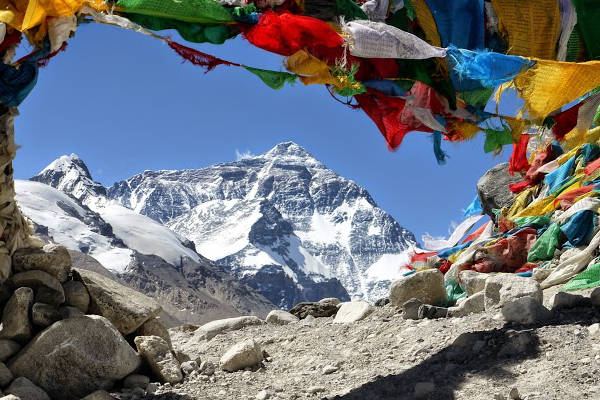
Day 1: Arrive Kathmandu
Arrive in Kathmandu. Rest and tour Kathmandu (often your tour operator will have pre-organised tours around Kathmandu).
See more in our guide on things to do in Kathmandu .
Day 2: Fly Kathmandu to Lukla. Trek to Phakding
Fly from Kathmandu to Lukla (expect a slightly scary landing at Lukla but rest assured the pilots are very experienced!). Weather can sometimes be a problem, so delays are common.
The flights afford great views of the Everest region, so have your camera ready. Try to sit on the right side of the plane to see Mt Everest. Upon arrival you will be transported to the trailhead and take a relatively easy trek from Lukla (2,800 meters) to Phakding (2,652 meters).

Namche Bazaar, Khumbu District
Day 3: Trek from Phakding to Namche Bazaar
Phakding (2,652 meters) to Namche Bazaar (3,440 meters) via Monjo (2,840 meters) and the beginning of Sagarmatha National Park. Weather permitting you might get your first glimpses of Mt Everest from the steep trail to Namche.
Day 4: Acclimatisation in Namche
This is usually a rest acclimatisation day in Namche (3,440 meters). If you are lucky enough to be in Namche on a Saturday, then make sure to visit the weekly market. Most operators will encourage you to take an acclimatisation trek to the Everest View Hotel (3,880 meters) where you can have lunch and capture views of Mt. Everest.
Day 5: Trek from Namche to Tengboche
Trek from Namche (3,440 meters) to Tengboche – also written Thyangboche (3,860 meters), home to the largest gompo (a Buddhist ecclesiastical fortification of learning). The trek is an undulating one which provides great views of beautiful mountains including Everest, Nuptse, Lhotse and Ama Dablam. Some treks go via Thame to visit the Thame Monastery, before continuing to Tengboche.
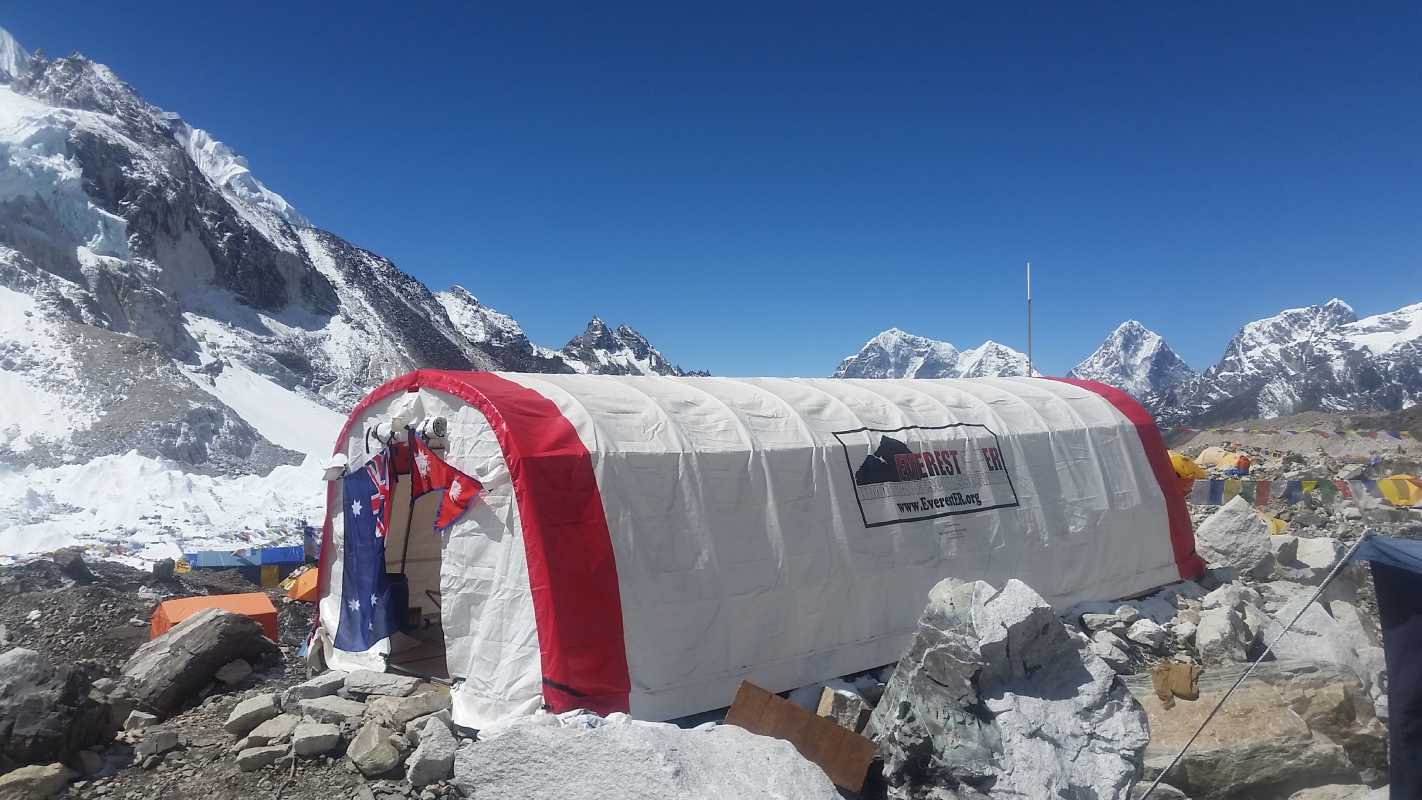
Day 6: Trek from Tengboche to Periche
Trek from Tengboche (3,860 meters) to Periche (4,280 meters) via the town of Pangboche. The Himalaya Rescue Association are based here, and it is well worth visiting them if your operator hasn’t already organised a tour.
Day 7: Acclimatisation day in Periche
Periche (4,280 meters) is usually used as the location for your second rest and acclimatisation day. Depending on your operator you will likely visit the Tshola Tsho Lake and then take a short trek towards Dingboche (4,360 meters) where you will get great views of the south face of Mt. Lhotse and Island Peak.
Day 8: Trek from Periche to Lobuche
A fairly long and steep trek from Periche (4,280 meters) to Lobuche (4,940 meters) via the Khumbu Glacier. You will see Sherpa Memorials built of stone cairns in remembrance to the many Sherpas and climbers that have died climbing Everest.
Day 9: Trek from Lobuche to Gorak Shep
Trek from Lobuche (4,940 meters) to Gorak Shep (5,170 meters) where you will have lunch and then onto Everest Base Camp (5,364 meters).
Most treks are not allowed to stay at Everest Base Camp without specific permission. The rules and regulations have changed around this issue over recent years, so it is worthwhile checking with your tour operator.
Visits to the icefall require mountaineering permits and are usually not part of a standard Everest Base Camp trek. After visiting Everest Base Camp you will return to Gorak Shep for the night.
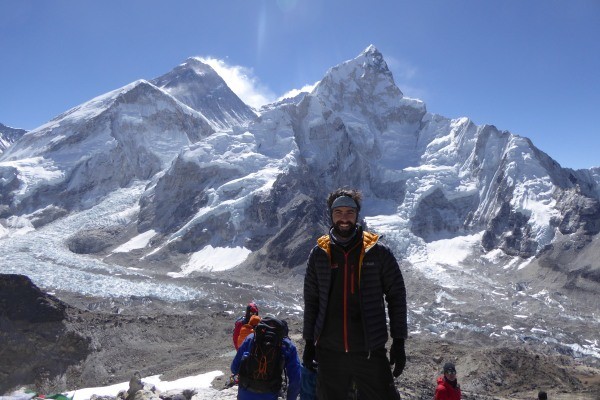
Kala Patthar
Day 10: Trek from Gorak Shep to Kala Patthar and EBC (Return to Dingboche)
A trek from Gorak Shep (5,170 meters) up the steep slopes to Kala Patthar (5,554 meters), a peak west of the Everest Base Camp which affords the best views of Mt. Everest, Nuptse Nup II and Changtse; as well as the northern flank and summit of Lhotse. You will leave Gorak Shep early to reach Kala Patther before the clouds roll in.
On a typical Everest Base Camp trek, Kala Patthar will be the highest altitude you will reach. It is also home to the worlds highest webcam – Mount Everest Webcam. From Kala Patthar, you then descend all the way back to Dingboche (4,360 meters).
Day 11: Trek from Dingboche to Namche
Trek from Dingboche (4,360 meters) to Namche (3,440 meters) via the rhododendron forests around Tengboche.
Day 12: Trek from Namche to Lukla
Trek from Namche (3,440 meters) all the way back to Lukla (2,800 meters) – a long and tiring walk to finish what is an incredible Himalaya trek.
Day 13: Fly from Lukla to Kathmandu
Fly from Lukla to Kathmandu.
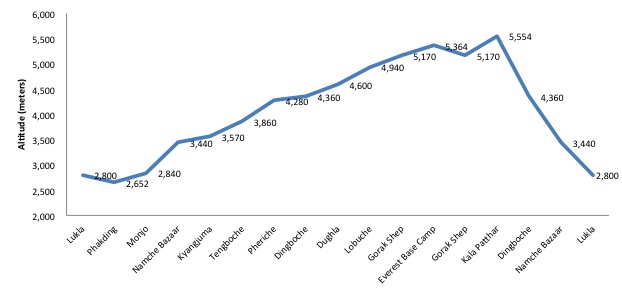
EBC Route Altitude Profile
Above is an altitude profile chart for a typical Everest Base Camp hike. The highest peak is Kala Patthar, at a staggering altitude of 5,554m.
Everest Route Variations
Below are typical route variations for the Everest BC hike.
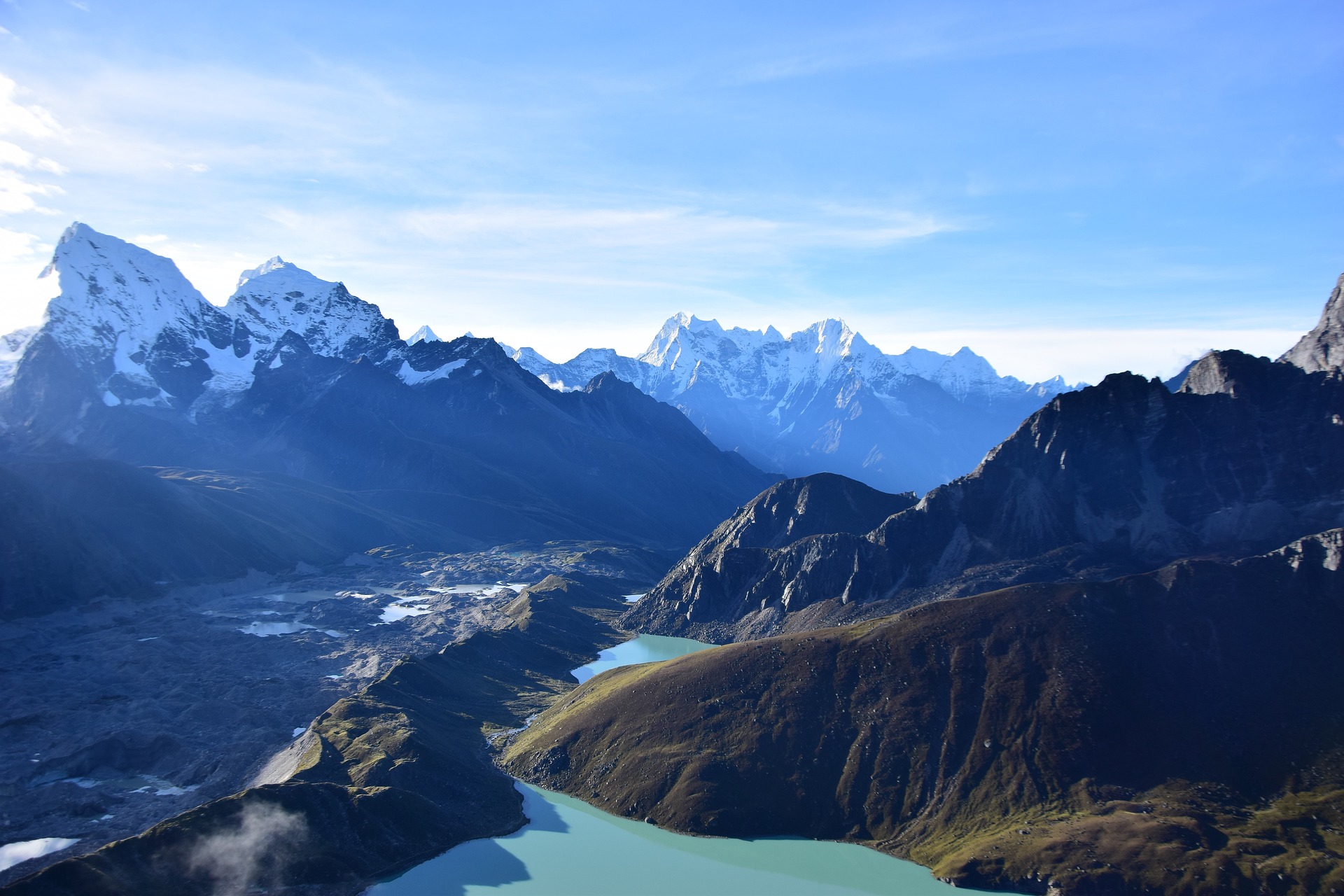
Gokyo-Ri glacier
Gokyo Lakes
The Gokyo Lakes or Gokyo Ri Trek is a fantastic variation on the Everest Base Trek. The route begins in Lukla and follows the traditional EBC trek itinerary for the first three days up to Namche Bazaar. Here it veers off to the North-west via the towns of Dole and Machemo, up to the stunningly beautiful Gokyo Lakes . The trail then ascends Gokyo Ri (5,483 meters) and traverses Cho La Pass (5,420 meters) before joining back up with the classic base camp trek at Lobuche.
The variation adds 2-3 days to an average Everest Base Camp trek but provides an excellent opportunity to avoid the crowds on the busy everest trail, as well as gives one the opportunity to trek up and down on different routes.
Chhukhung Valley
The Chhukhung Valley sits east of Dingboche and provides an alternative and longer passage to Lobuche than the traditional Everest Base Camp trail. Trekkers stay a night in Chhukhung (4,730 meters) before returning to Lobuche via Kongma La Pass (5,535 meters), an epic Himalayan pass .
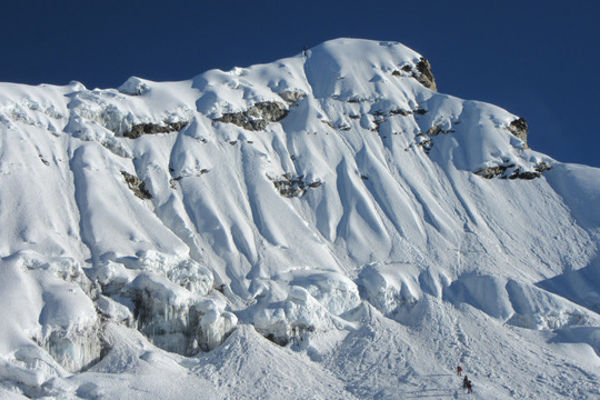
Island Peak headwall
Island Peak
Island Peak is one of Nepal’s 33 trekking peaks. Standing at 6,189 meters, Island Peak is a real challenge in terms of altitude, but only requires beginner level climbing skills (you will need to be comfortable with ice axes and crampons though). Most climbers use the traditional Everest Base Camp trek to acclimatise for Island Peak.
Returning from Everest Base Camp, you can either trek to Cchukhung via Dingboche from Lobuche or veer South-east from Lobuche traversing the Kongma La Pass to Cchukhung (4,730 meters). From here you can trek to Island Peak Base Camp (5,120 meters) in preparation for their trek / climb up to Island Peaks summit. The summit typically takes 2 days and the total trip, including Everest Base Camo, between 18-20 days.
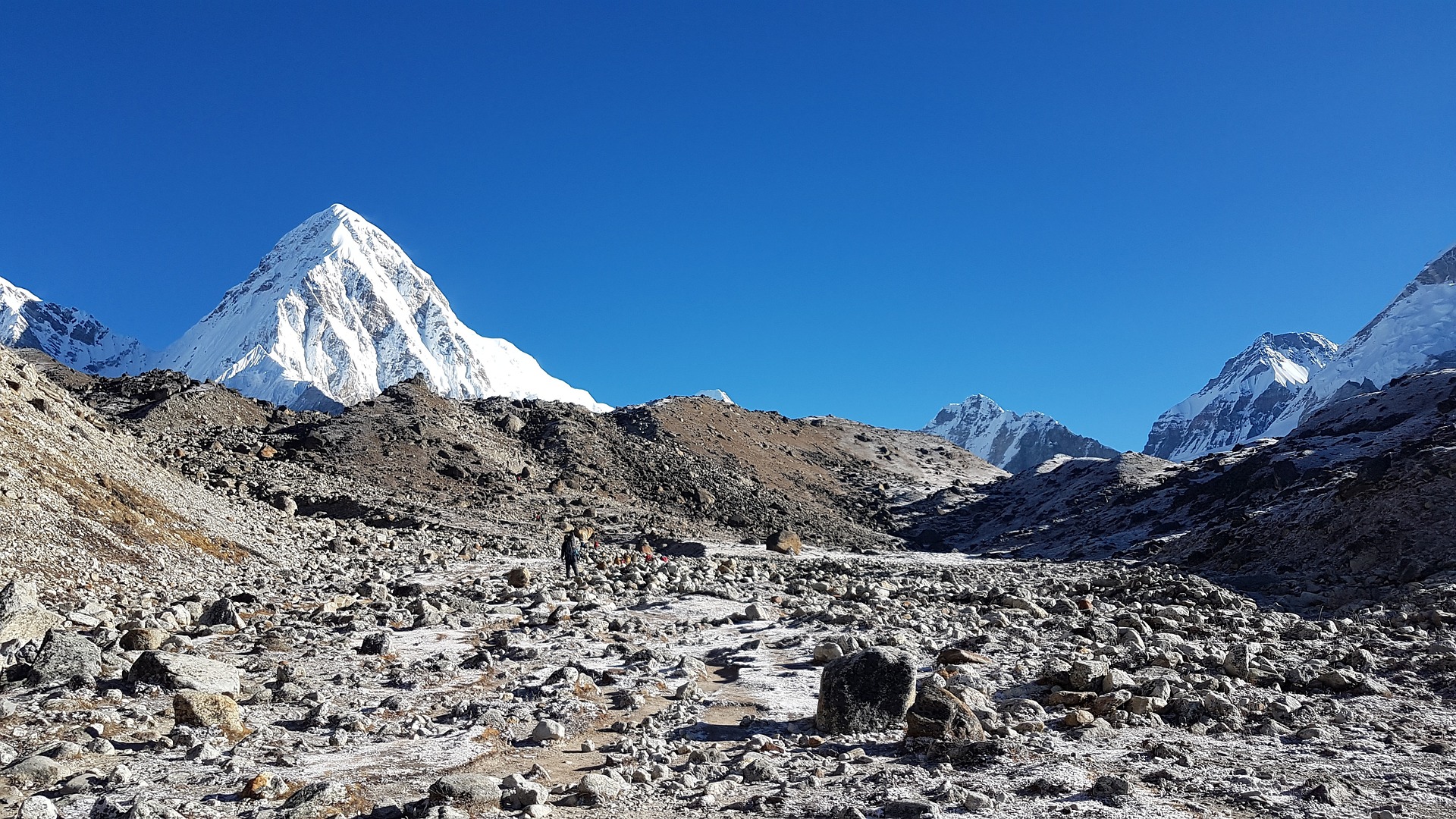
Everest Base Camp Trek FAQ
How much does the ebc trek cost.
Like many treks in Nepal, there are three ways you can plan your Everest Base Camp trek. See more in our guide on a detailed breakdown on the cost of an Everest Base Trek .
Below are four options for Everest Base Camp treks and their estimated costs.
Independent Trekking
Here you organise your trek. You will need to get yourself from Kathmandu to Lukla (a flight is the fastest and easiest; there are buses but these are rather unpleasant). You can employ the services of a porter or guide in Lukla or indeed in Namche, but it is important to note that as an independent trekker, it is illegal to use a guide or porter that is not licensed as a trekking agent through TAAN, or affiliated with a licensed trekking agent. You will need a Green TIMS card (costing NPR 2,000), money to buy food and water, a reliable and accurate map, and negotiations skills to book teahouse accommodation.
The estimated cost for an independent trek excluding flights is between $500-$800.
Local Tour Operator
There are many local tour operators in Kathmandu who organise guided Everest Base Camp treks. Generally local Nepal trekking companies are quite good. You will join a group of trekkers (up to 15 people) and have a team of porters, assistant guides and lead guides (who can speak English) of a similar size to the trekking group.
It is important to check that your local operator is a licensed trekking agent. We recommend shopping around and asking for recommendations from other trekkers. The cheap local operators tend to be the least reliable, often only providing tent accommodation or access to old and poorly run teahouses. Their ethical standards towards staff and the local environment may not be to the highest standard as well.
The estimated cost for an Everest Base Camp trek organised by a local tour operator is between $800-$2,000.
Western Run / Operated Tours
There are many Western run companies that offer Everest Base Camp treks. Most of these Western companies have their own ground teams or strong relationships with the best local tour operators who they outsource their on-the-ground operation to, whilst managing the overall tour experience.
The best Western companies own their on-the-ground operations. Expect a well-run tour with either a Western guide or a very well-trained local guide who understands the subtle service nuances expected of a Western trekker.
The estimated cost for an Everest Base Camp trek organised by a Western run tour operator is between $1,200-3,000.
Everest Climbing Expedition
A fourth option of joining an Everest climbing expedition is also possible. Major climbing operators like Adventure Consultants, Jagged Globe or Alpine Ascents usually offer Everest Base Camp trekking spaces on their Everest climbing expeditions. Securing a trekking space can be a little pricey but offers one an incredible insight into an Everest expedition as well as the chance to spend a night or two at Everest Base Camp.
If you think a base camp trek is expensive, wait till you hear how much it costs to Climb Mount Everest !

Are permits required for the EBC trek?
Yes, there are two permits you require for standard treks from Lukla to EBC. They are:
1. Trekkers Information Management System (TIMS Card)
TIMS cards are issued by the Tourism Agency Association of Nepal (TAAN). There are three different types:
- Organised TIMS Card (Blue in colour, USD 10). If you are trekking with an organised tour these will be arranged for you. You will need to provide your passport number and one passport photograph
- Individual TIMS Card (Green in colour, USD 20). If you are trekking independently (without support) you will need to get one of these TIMS cards from the Nepal Tourism Board in Kathmandu
- SAARC Country TIMS Card (Red in colour, USD 3). These cards are for nationals from the South Asian Association for Regional Cooperation, i.e. India, Bhutan, Pakistan, Sri Lanka, Maldives, Bangladesh and Afghanistan.
2. Sagarmatha National Park Entry Permit (USD 30 + 13% Govt. Tax)
The Sagarmatha National Park or Solukhumbu is the region through which the EBC trek runs. A National Park entry permit is required to enter Sagarmatha. Permits can be acquired at the first checkpoint along the route, north of Lukla called Monjo. The cost is US$30 + 13% tax for trekkers using a trek operator or agency, as well as for independent trekkers. Permits can also be acquired in Kathmandu, but we recommend getting it in Monjo as it is more straightforward.
For treks from Jiri to Everest Base Camp, there is another permit required called the Gaurishankar Conservation Area Project permit. It costs US$20 (no discount for independent trekkers or SAAEC nationals). The checkpoint is at at Shivalaya (just after Jiri). We recommend getting the permit in Kathmandu before departing as the cost is double if they have to issue the permit in Shivalaya.
As a rule of thumb, we recommend bringing at least 4 passport size photographs for all your permit requirements.
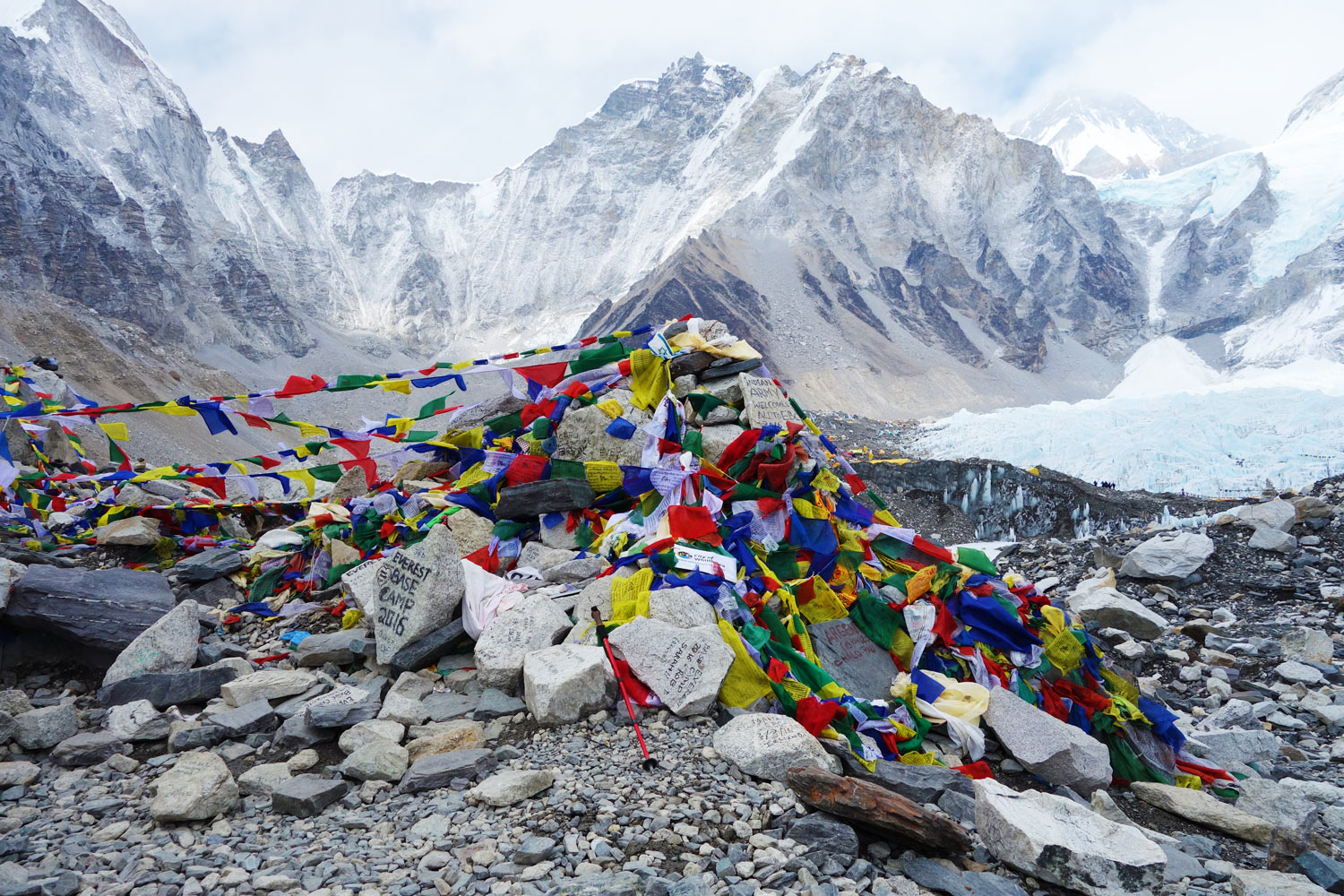
When is the best time to trek to Everest Base Camp?
The best time to trek Everest Base Camp is during the dry and warm months of September through November of March through late May / Early June.
The monsoon rains arrive in mid-late June and get into full swing for the months of July and August (as seen in the average rainfall map below). The route is really too wet for trekking and you would be better placed to explore treks in rain shadow areas like the Upper Manang, Mustang, Annapurna or Dolpo region.
December, January and early February are very cold. Treks run during these periods but be prepared for freezing temperatures and possible snow flurries. The upside is that the route is a lot quieter than in the peak seasons.
The chart shows average temperatures and rainfall in Nepal (data from 1960-1990 compliments of the Climate Change Knowledge Portal at the World Bank ).

Is altitude sickness a risk on the Everest Base Camp hike?
Yes, altitude sickness is a risk on the Everest Base Camp route. The trek takes one from a moderately high altitude, 2,800 meters in Lukla, to high altitude, over 5,300 meters at Everest Base Camp and over 5,500 meters at Kala Patthar. At these higher altitudes, the body needs to have acclimatised to the lower saturation of oxygen in the air in order to avoid the symptoms of altitude sickness (or what is sometimes referred to as Acute Mountain Sickness – AMS).
The good news is that a typical Everest Base Camp hike has a slow ascent profile which maximises the amount of time available to acclimatise. Nonetheless, every year 100s of people suffer altitude sickness symptoms and some need to cut their trek short due to more severe complications.
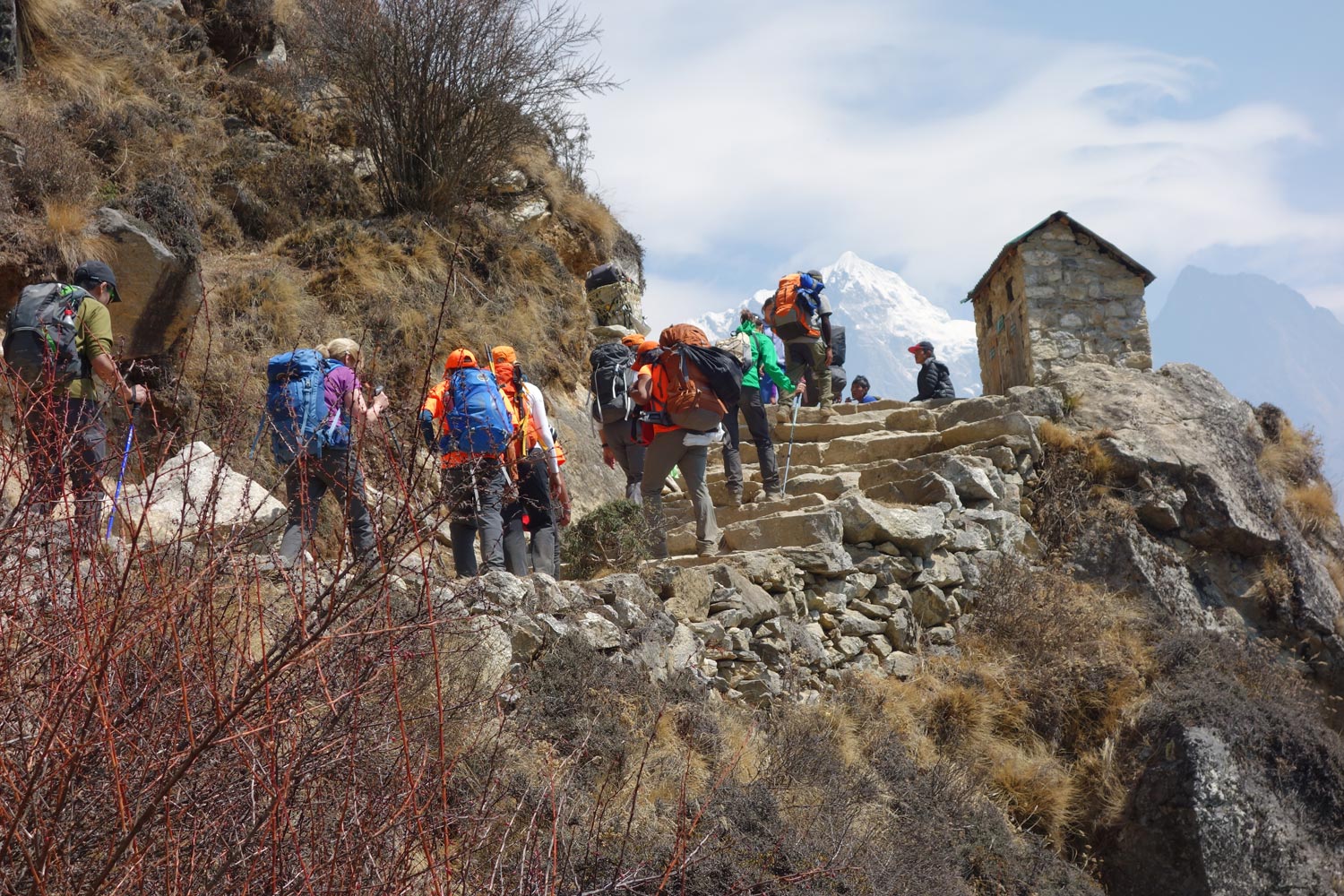
How difficult is the Everest Base Camp Trek?
The difficulty of the Everest Base Camp Trek is relatively low. It should be noted that the Everest Base Camp trek requires no climbing expertise and there are certainly no technical climbing sections. With determination and a basic fitness level, you should be able to trek the route. We have seen old and young, overweight and underweight complete the trek – all with a smile on their face!
With that being said, there are certainly some factors that should be considered prior to your trek, such as altitude, length and training that will enable you to better understand what you are getting yourself into before deciding.
What gear do I need for the EBC Trek?
One of the most frequent questions that we get asked is what gear should be packed for an Everest Base Camp trek.
To make your life a lot easier we have written a very detailed Everest Base Camp packing list article. The list is fairly exhaustive but includes all the absolutely necessary items of clothing and outdoor gear that you should bring with you.
You will have the opportunity to either buy or rent gear in Kathmandu, Lukla or even in Namche Bazaar, but in general we recommend you bring with you the main items (i.e. hiking daypack , hiking boots, warm down jacket, sleeping bag and sleeping mat , trekking poles , appropriate trekking clothes, headgear and headlamp and gloves etc.)
What travel insurance do I need for the EBC hike?
Trekking Everest Base Camp comes with obvious risks. We recommend you get travel and trekking insurance for all treks in Nepal .
On the Everest Base Camp route, you will reach a maximum altitude of 5,416 meters, so it is important you choose an insurance package that covers you up to that altitude.

Are there any recommended guidebooks for the Everest Base Camp Trek?
Absolutely. There are some great guidebooks and trekking maps to choose from when doing the Everest Base Camp Trek.
The classic EBC trail itself is well-worn, but there are many smaller yak trails that can confuse people.
We recommend taking a detailed trekking map. The region is sparse, and it is possible to get lost in the many valleys that lie on either side of the main trail. The most recent Lonely Planet Trekking in the Nepal Himalaya provides the most up to date information and maps of the region.
Sian Pritchard-Jones and Bob Gibbons’s book: A Trekking Guide to Everest is also rather good.
For a more general guide to Nepal, you may want to check out the Nepal Lonely Planet Travel Guide .
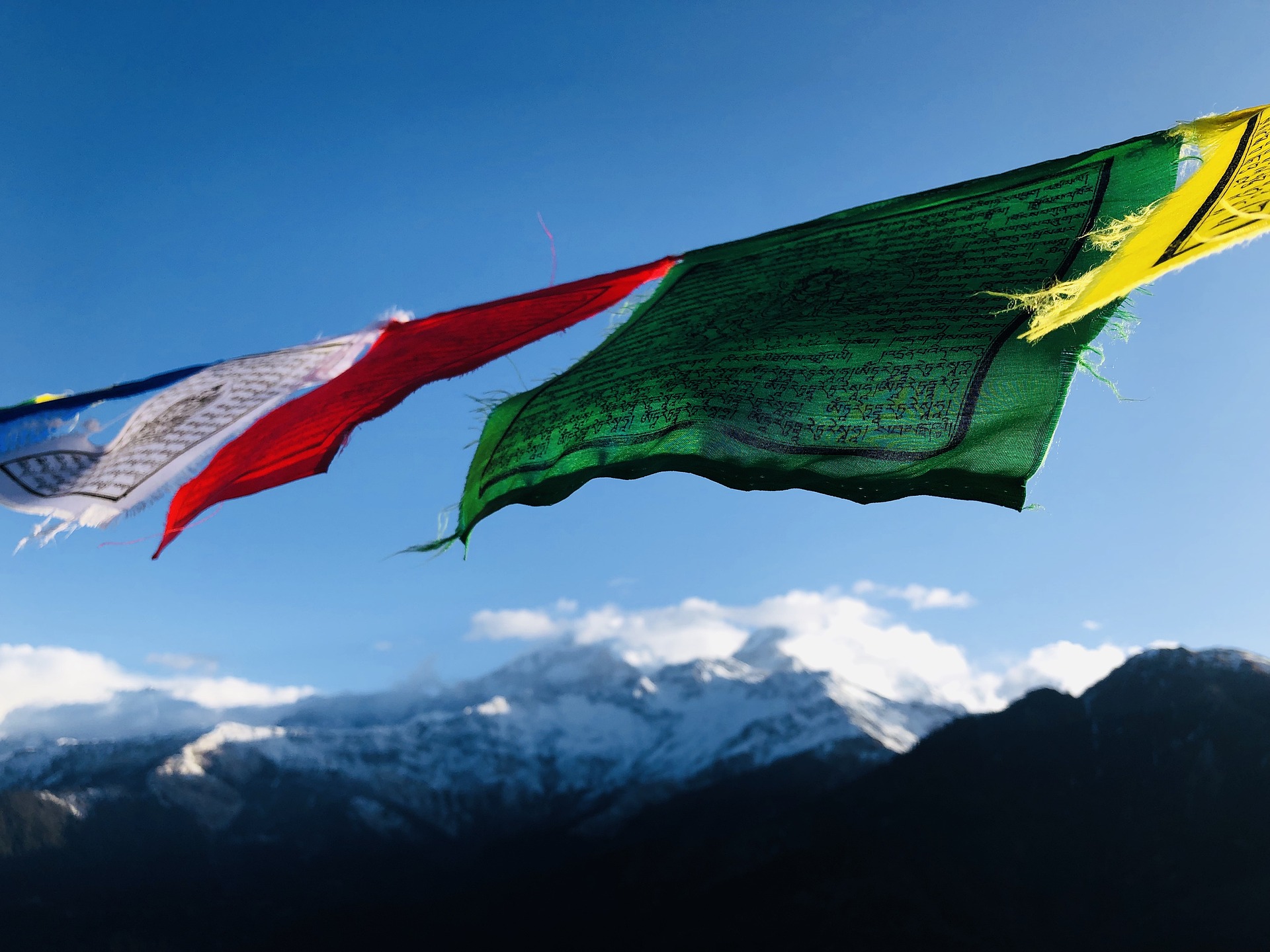
Are there any other hikes in Nepal you would recommend?
Yes, there are many other hikes in Nepal that I love.
Some of the most popular alternative Nepal trekking routes are the Annapurna Circuit Trek , the Langtang Valley Trek and the Manaslu Circuit Trek . If you're looking for some easy Nepal hikes , then check out the Poon hill hike or the Royal hike . For short Nepal hiking routes see the Helambu hike , which is near Kathmandu.
Continue browsing
See more information on Nepal . Or check out these other Everest/Nepal articles:
- Best Climbing Mount Everest Tips
- Food on the Everest hike
- Internet Access on EBC hike
- Everest Base Camp Trek Deaths and Statistics
- Best Places to Visit in Nepal
- What to Expect in Nepal Tea Houses
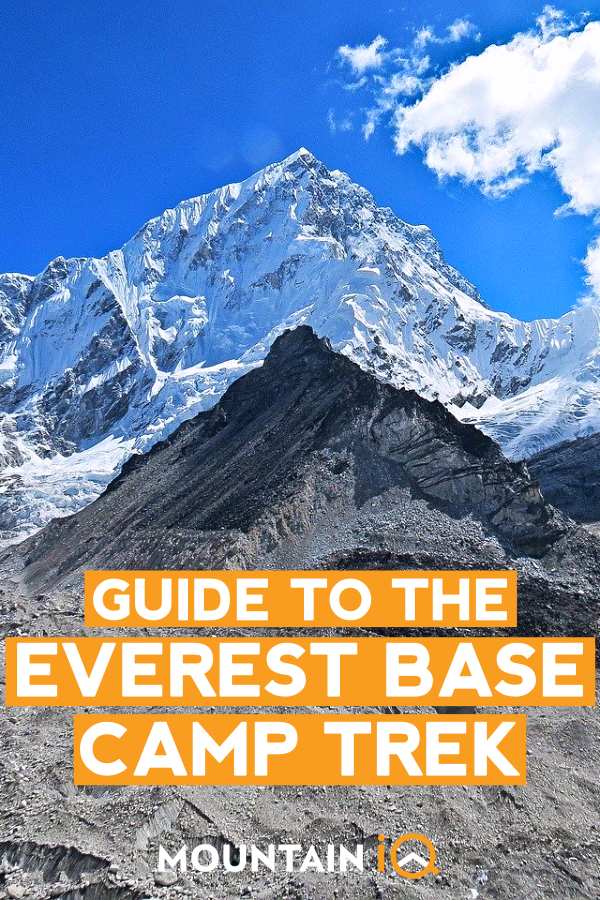
About the author
Mark Whitman
Mark has trekked extensively in Asia, Europe, South America and Africa. He founded Mountain IQ in 2014 with the sole aim to be the best online information portal to some of the most popular mountain destinations around the world. When not writing for Mountain IQ, Mark is out exploring the outdoors with his wife!
Leave a Reply
Your email address will not be published. Required fields are marked
Nice article. Full of true information and very supportive for new trekkers.
We work with local guides to offer great value adventures at unbeatable prices
- +9779851276377
- 977 01 5348594
- [email protected]
- Follow us on:
Everest Base Camp Trek
Everest base camp, kala patthar and view of pumori, namche bazaar, you can also, things to know before trip, trip introduction.
Everest Base Camp trek is the most popular trekking adventure experience in the Everest region of Nepal. During our Everest Base Camp (EBC) trek, we will certainly get amazing views of the world’s highest peak Everest. Along with the eye-dazzling vistas of Lhotse, Makalu, and Cho Oyu enhancing our journey up to Everest Base Camp.
EBC trek is also an opportunity to explore the culture and traditions of local Sherpas – The unsung heroes of Everest. From visiting local Buddhist monasteries and Chortens to spotting Himalayan flora and fauna; we get the chance to follow the steps of the great Edmund Hillary and Tenzing Norgay Sherpa in 1953. You can Watch video documentation of our Everest Base Camp Trek captured with a drone for Visit Nepal 2020 promotion.
Overview of Everest Base Camp Trek
After your arrival at Kathmandu Airport followed by sightseeing around the world heritage sites ( optional ) and necessary trek preparation, we fly to Lukla on a scenic mountain flight. Then we start trekking towards Phakding. Initially, we follow the Dudh Koshi River crossing over various suspension bridges, through dense forests, and arrive at the Sherpa village of Namche Bazaar.
We design our Everest base camp trek itinerary professionally to minimize the risk of Acute Mountain Sickness . Hence, we acclimatize at Namche Bazaar which is a major hotspot for trekkers and adventure lovers.
Continuing our EBC trekking journey, we trek towards Tengboche, Dingboche, and Lobuche. At Tengboche, we visit an ancient monastery where we get to see their traditions and rituals. From Lobuche, we cross Gorakshep.
And finally, we step into the base camp of the highest mountain in the world i.e. Everest Base Camp. While returning we will also have great panoramic views of Everest, Ama Dablam, Lhotse, Nuptse, and other neighboring peaks from the popular viewpoint of Kalapatthar. People claim that the Kalapatthar is the best viewpoint of Everest. We will follow the same route down to Lukla and fly back to Kathmandu concluding our EBC Trek.
Who can join this EBC Trek and how?
Everest base camp trek can be joined by anyone who loves to trek around the foothills of the Himalayas while possessing a good level of physical fitness and a passion for walking and exploring new places. The best seasons for the EBC trek would be autumn from Sept to Nov and spring from March to May.
Join Everest Trek 2023 with Nepal Mountain Trekkers for amazing Everest memories that you will cherish for years to come. Simply fill out the Quick Enquiry Form and let us know about your interest. Or you can contact us directly by sending us an email/WhatsApp message in order to get more information about this trek.
Trekking Terrain Everest Base Camp Trek has varieties of terrain during the trek. The initial section of the trek passes past the lush hills and green valleys. However, at the higher altitudes, there are high passes and rocky terrains as you proceed to the Everest Base Camp and to the challenging spots such as the Kala Patthar or the Gokyo region. While the itinerary is designed with proper acclimatization for the trekkers, you still need to understand the challenge that trekking in such high altitudes poses, even if the trail doesn’t seem much challenging. Slight headaches and shortness of breath may still be there as you move. You may not have accurate distances for the places but the guides accompanying you are well aware of this and shall provide you with proper guidance. We shall interact with you if you need further information.
Weather (…and bad weather periods) The rainy season or the monsoon season starts in mid-June and continues till September. However, there may still be rain in early October. Spring and Autumn seasons have clear weather and are dry as well. The temperature in the higher attitudes is influenced by the local conditions such as the altitude itself. The weather may change on short notice in higher altitudes. October to November/December is the most popular season for Everest Base Camp Trek.
The flight to and from the hill town of Lukla is relatively uncertain due to its typical geographical location. Flights are often delayed due to bad weather conditions due to which most of the flights start early in the day. Trekkers are therefore advised to spare some days for such delays during the trek owing to the bad weather periods.
Everest Base Camp Trek Expenses The details of the expenses included and excluded are mentioned in the respective sections. However, it is to be noted that trekkers should bear the expenses of their own food, accommodation, and other activities in case they arrive prior to the starting of the trekking expedition or extend their stay after the tour. Furthermore, in case the flight gets delayed and trekkers are stuck in either trekking areas such as Lukla or in a city such as Kathmandu due to such delay, they should bear the expenses of food, accommodation, etc. on their own as these delays take the stay outside the decided itinerary.
Customization of Everest Base Camp Trek Itinerary We shall stick to the decided itinerary during the Everest Base Camp trek. However, the trekkers shall have the flexibility to customize the itinerary as per their requirements. If they are physically fit and have the ability to complete the trekking faster, we shall arrange the itinerary accordingly. The only major consideration is that the customization of the itinerary shouldn’t pose any difficulty or threat to the health of the trekkers. All in all, we provide flexibility and customization of the itinerary for the trekkers.
Supporting Staff during the EBC trek During the trek, the supporting staff shall include both the experienced staff and leaders from our trekking company as well as the local support crews. Our leaders and trekking guides selected are well experienced in handling various issues, related to the harshness of the environment, traveling in remote and difficult terrains, and possess the soft skills of communication, friendliness, a good sense of humor, and are trained with first aid and acclimatization related issues with the capability to handle difficult situations. The local crews (guides, porters) may not have fluency in speaking the English language but they are friendly, hardworking, and approachable. We ensure proper coordination between the supporting staff for your smooth trek. The expenses of supporting staff, their insurance, and other necessities are taken care of.
Gears and Equipment for EBC Trek Trekkers should pack their clothes, trekking gear, and equipment for the trekking to Everest base camp and the surrounding Khumbu region. The details of clothing, gear, and other equipment shall be finalized after discussion with the trekkers. The weight limit for your luggage is 15 kg or 33 pounds and because your luggage shall be carried by porters, you may carry the valuables and anything important in a day pack to be carried on your own.
Scarfs, warm hats, sunglasses with UV protection, and headlamps give protection to your head while you will need thermal tops, pullovers, down vests, and Gore-Tex jackets among others for your upper body. Gloves and mittens protect your hands, and non-cotton underwear briefs, hiking shorts and trousers, fleece or woolen trousers, and shell pants are essential for your lower body. Pack socks, hiking boots, running shoes, gaiters, and other gear for feet along with the rucksack and travel bags, and sleeping bags during the trek. Required medicines, toiletries, and other practical items are required as well.
Best Season for trekking Everest Base Camp October-November/December is the best season for trekking in the Everest region. This season has fine weather, a clear sky, and thus the best view of the mountains and marvelous scenery along the route. February to April is the dry season in Nepal and the second-best time for trekking. June to September is the monsoon season in Nepal with frequent downpours which makes this the least popular season for trekking for general trekkers, while the botanist and other enthusiasts look out for lush vegetation and rare vegetation En route Everest base camp. The skies are clear but the weather can get very cold from December to January/ February while the months of May and June are hot and it can get very warm during the trek.
Health and Related issues Altitude Sickness is the biggest health-related concern during the trek to Everest Base Camp. Enough rest (acclimatization) and hydration are the keys to avoiding this medical issue besides the medicines such as Diamox, antibiotics for stomach-related problems, and other medicines help trekkers cope with the issue of altitude sickness. Without proper care, prevention, and following of the guidelines related to altitude sickness, the issue of altitude sickness can get worse and put a threat to the life of trekkers. Convey any difficulty that you experience to the trek leader so that immediate action may be taken. Carry a personal first aid box which shall come in handy to you during the trek. Though the trekking guides and leaders shall carry the required first aid items, carrying on your own provides additional support for the guides.
Get concerned about the use of tap water as these are not suitable for drinking directly without treatment. Carry water purifier tablets and you may buy bottled water during the trek. Foods are available in teahouses that are healthy and safe for consumption. However, you may carry some snacks if you wish to. Consult with us regarding the expense bearing regarding the meals during the whole trekking.
For more frequently asked questions about Everest Base Camp Trek: FAQs Everest Base Camp Trekking.
- Day 1 Arrive in Kathmandu (1,300m /4,264 ft):
- Day 2 Kathmandu: Sightseeing and Trek Preparation:
- Day 3 Kathmandu – Lukla – Phakding (2,652m/8,700ft): 40 minutes flight, 3- 4 hours trek (Trekking times only):
- Day 4 Phakding – Namche Bazaar (3,440m/11,280 ft): 5 – 6 hrs:
- Day 5 Namche Bazaar: Acclimatization day:
- Day 6 Namche Bazzar to Tengboche (3,870m/12,694ft): 5 – 6 hrs:
- Day 7 Tengboche to Dingboche (4,360 m/14,300ft):5 – 6 hrs :
- Day 8 Dingboche (4,360 m/14,300ft): Acclimatization Day:
- Day 9 Dingboche -Lobuche (4,940 m/16,207 ft): 6 – 7 hrs :
- Day 10 Lobuche – Gorak Shep (5,170 m/16,961ft) – Everest Base Camp (5,364m/17,594ft) – Gorak Shep: 8 – 9 hrs:
- Day 11 Gorak Shep – Kala Patthar (5,545m/18,192ft)- Pheriche (4,280 m/14,070 ft): 8 – 9 hrs:
- Day 12 Pheriche to Khumjung (3,780m / 12,401 ft ) 6 – 7 hrs:
- Day 13 Khumjung to Phakding (2,652m/8,700ft): 4 – 5 hrs:
- Day 14 Phakding to Lukla (2,860 m/9,383 ft): 3 – 4 hrs:
- Day 15 Lukla – Kathmandu:
- Day 16 Departure Day:
Detail Itinerary
Day 1 : Arrive in Kathmandu (1,300m /4,264 ft)::
A warm welcome to the naturally blessed and culturally rich Himalayan country, Nepal. Upon your arrival at Kathmandu for joining Everest Base Camp Trek, you will be met by a representative from Nepal Mountain Trekkers at Tribhuvan International Airport arrival terminals and he will transfer you to your respective hotel ( Hotel Green Horizon or a similar standard). After check-in at the hotel, you can enjoy your free time relaxing in the cozy room or stroll around the tourist hub Thamel area until the end of the day.
Day 2 : Kathmandu: Sightseeing and Trek Preparation::
You will be beginning your first morning in Nepal with an early meal at your hotel and a visit to the Nepal Mountain Trekkers office at Thamel. After being introduced to our team including the tour guide, trekking leader, and director of operations, we head for necessary trekking preparations, getting needed equipment with the initiation of Kathmandu sightseeing around world heritage sites. Kathmandu Durbar Square, Swayambhunath Stupa, Pashupatinath temple, and Boudhanath Stupa are UNESCO world heritage sites that we explore till sunset. Overnight stay at a hotel in Kathmandu.
Day 3 : Kathmandu – Lukla – Phakding (2,652m/8,700ft): 40 minutes flight, 3- 4 hours trek (Trekking times only)::
After having your early meal, you will be transferred to the airport to catch a short domestic flight from Kathmandu to Lukla, the gateway to Everest . In just 45 minutes of flight, we get a wonderful chance to view snow-capped mountains and will be landing between the hills at Tenzing-Hillary airstrip in no time. After arriving at Lukla, we get introduced to our trekking crew and start our trekking activity towards Phakding. It will be quite an exciting first day of trekking in the Everest region. Overnight stay at Phakding.
Day 4 : Phakding – Namche Bazaar (3,440m/11,280 ft): 5 – 6 hrs::
We have our early meal and start our journey with a few ascends and descends crossing the Dudhkoshi River through a suspension bridge. Gradually moving ahead entering Sagarmatha National Park located at Monjoo, proceed towards Jorasale, and continue the day’s walk until we arrive at the popular Sherpa village of Namche Bazar. Today, we have our quick stop at Chautara and the fabulous views of snow-capped peaks already start to appear. We stay overnight at Namche Bazar.
Day 5 : Namche Bazaar: Acclimatization day::
Today we have our first acclimatization days. It is very important to have proper acclimatization to avoid possible risks of acute mountain sickness or altitude sickness. And during the acclimatization days, it is recommended to get involved in physical activities instead of just taking a rest. We will, therefore, go for a short hike around nearby Thame or simply take a look around Namche bazaar. Here, we also get an exclusive chance to meet like-minded travelers, and Everest summiteers and have a close look at the lifestyle of local Sherpa inhabitants. We will stay overnight in Namche Bazar.
Day 6 : Namche Bazzar to Tengboche (3,870m/12,694ft): 5 – 6 hrs::
We start our day after having our breakfast and continue our journey to Tengboche with awesome views of the Everest Himalayan ranges. We gradually make our way through beautiful Everest trekking trails, spot alpine flora, and fauna, have our lunch at Phuki Thega, and finally arrive at Tengboche at the end of the day. The major attractions here would be a visit to the ancient Tengboche Buddhist monastery with rich cultural/traditional insights and capture close views of Everest, Amadablam, and other neighboring peaks. Overnight stay in Tengboche.
Day 7 : Tengboche to Dingboche (4,360 m/14,300ft):5 – 6 hrs ::
It will be another exciting day of our Everest Base Camp Trek while heading towards Dingboche crossing through beautiful forests, and numerous suspension bridges via Imja River, and visiting Chortens while exploring rare Himalayan flora and fauna. As we climb higher and gain altitudes, the views become more and more clear. We stay overnight at Dingboche.
Day 8 : Dingboche (4,360 m/14,300ft): Acclimatization Day::
We will be setting up acclimatization day today as it is very important in EBC to let your body adapt according to changing altitude surroundings. Before trekking towards glacier moraines and tougher trails at high altitudes, we get ready for the challenges by going for hikes to nearby hills and monasteries that provide great insights into local cultures and traditions. So, even if it’s called a rest day, it will be a rather active day instead of hiking around nearby hills. And at the end of the day, we return to Dingboche for an overnight stay.
Day 9 : Dingboche -Lobuche (4,940 m/16,207 ft): 6 – 7 hrs ::
Today we start our day early in the morning after having our breakfast pushing ourselves forward through the small isolated small village of Dughla. After having our lunch at the trails, we slowly climb up towards Lobuche through barren lands surrounded by small shrubs without much vegetation. In this way, we finally arrive at Lobuche where we will be staying for an overnight stay.
Day 10 : Lobuche – Gorak Shep (5,170 m/16,961ft) – Everest Base Camp (5,364m/17,594ft) – Gorak Shep: 8 – 9 hrs::
Leaving behind Lobuche, we move ahead towards our last overnight station during our Everest base camp trek at Gorakshep. Situated at 5100 meters altitude above sea level, there might be a chance of high altitude sickness. However, with our proper acclimatization stops and professionally designed itinerary with experienced guides, the risks of getting affected by altitude sickness will be significantly lower. It will also be the most important day of our trip as we will be stepping at the base camp of Everest, the highest Himalayas on the planet. After capturing the best moments at base camp, we return to Gorakshep for an overnight stay.
Day 11 : Gorak Shep – Kala Patthar (5,545m/18,192ft)- Pheriche (4,280 m/14,070 ft): 8 – 9 hrs::
Today before having our breakfast before sunrise, very early in the morning, we head in for the Kalapathher hike to witness the amazing sunrise views over the highest Himalayas, Everest, Amadablam, Lhotse, Nuptse, and other surrounding peaks. After immersing in the natural beauty of panoramic Himalayan views, we return to Gorakshep and descend towards Pheriche for an overnight stay.
Day 12 : Pheriche to Khumjung (3,780m / 12,401 ft ) 6 – 7 hrs::
It will be a long day of trekking downhill through quite a few ascents and descents. Crossing through the wooden bridges, yaks, and jokpos carrying loads. Along the trail, we also witness the locals drying the potatoes in the sun, which is a local staple diet. In this way, we arrive at a large Khumjung village, where we get to explore the amazing cultures, traditions, and lifestyles of local Sherpa inhabitants. And at the end of the day, we stay overnight at the local tea house in Khumjung.
Day 13 : Khumjung to Phakding (2,652m/8,700ft): 4 – 5 hrs::
Today, it will be around four to five hours of trekking from Khumjung village to Phakding. Initially, we descend down towards Namche Bazar first and keep trekking down along the riverbank of Dudh Koshi River. Continually passing through the beautiful rhododendron forests, crossing the permits checking point at the entrance of Sagarmatha National Park, and finally arriving at Phakding. Overnight stay at the local guesthouse in Phakding.
Day 14 : Phakding to Lukla (2,860 m/9,383 ft): 3 – 4 hrs::
In the final few days, while trekking from Phakding to Lukla, we will be walking for around 3 to 4 hours. Upon arrival at Lukla, we celebrate our final night around the foothills of the Himalayas. And get ready for tomorrow’s domestic flight to Kathmandu.
Day 15 : Lukla – Kathmandu::
After getting up in the morning, we have our early meal and get ready for the scenic flight from Lukla to the capital city of Kathmandu. Upon arrival at Kathmandu, stroll down across the streets of culturally affluent Kathmandu Valley for shopping souvenirs, and share the moment while having a complimentary farewell dinner at a cultural restaurant at the end of the day.
Day 16 : Departure Day::
Today will be the final day of our Everest Base Camp Trek, and we have all the delightful adventures around Everest Himalayas, recalling the memories, we will drop you at Tribhuwan International Airport for International departures. Farewell, friend.
Price Includes
- Airport Pick-up and drop service
- 3 nights Hotel in Kathmandu ( Hotel Green Horizon or similar standard)
- Sanitation: The accommodation we provide will be neat and clean with warm hospitality and quality services.
- Single/Twin-sharing Accommodation (as per budget): Your group won’t have to share your accommodation with anyone else so your privacy is protected.
- We provide hygienic and safe meals to re-energize you.
- We request you not to waste your meals for it is difficult to transport food in the rural area.
- You are not allowed to share your meals with anyone else from another group.
- Transportation costs: Domestic flight in (Kathmandu – Lukla- Kathmandu)and all required land transportation.
- Local Staff: Our guides are locals of the region which ensures that you will surely get to explore a bit more during the trek than with any other guides.
- Experienced: With an experience of more than a decade of working in this field, our trekking guides possess excellent knowledge of briefing during the trek as well as they are experts in handling all kinds of critical situations which might occur during the trek.
- Insurance: Nepal Mountain Trekkers have an insurance policy for all our trekking staff.
- Local Staff: The porters we hire belong to the same region where we trek in order to provide employment opportunities to the locals as well as to make you explore every prospect of the region.
- Trekking permits: TIMS card, Khumbu Pasang Lhamu Rural Municipality Tax , and Sagarmatha National Park fees
- First aid medical box
- Trekking gear like Sleeping bags and down jackets are made available on rent
- 13% VAT and 10% service charge
- Farewell Dinner
Price Excludes
- Visa fee to enter Nepal ( Visa information )
- International flight tickets and extra baggage charges
- Food in Kathmandu
- Extra night accommodation and meal costs in Kathmandu due to any change in the scheduled itinerary
- Travel insurance / Rescue operation costs
- All personal expenses
- Tip for guides and porters
Trip Gallery
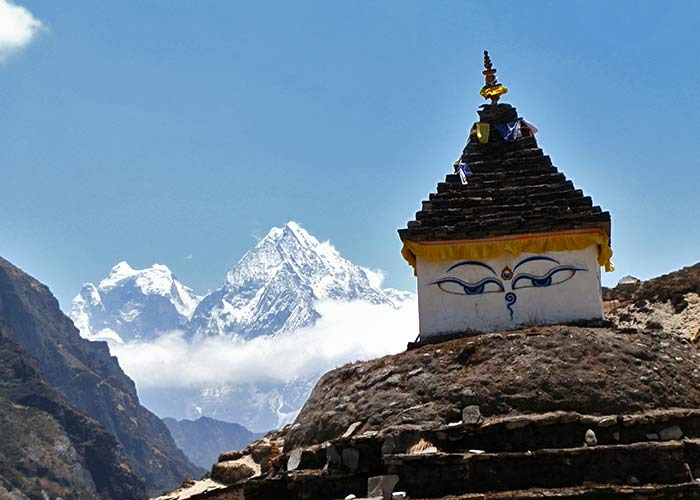
- Sun hat or scarf
- Light balaclava or warm fleece hat
- Cotton t-shirts or thermals
- Fleece jacket
- Waterproof jacket
- Down jacket
- Lightweight cotton pants (long)
- Waterproof pants
- Thin inner socks
- Thick, warm wool hiking socks
- Comfortable hiking boots
Accessories
- Sleeping bag rated to -10°C +
- Trekking bag (Rucksack)
- Large plastic bags (for keeping items dry inside trek bag)
- Trekking poles (optional, recommended)
- Water bottle or camel bag
Fixed Departures
- 21/10/2024 2-10 Yes $2500 $2125 Book
- 31/10/2024 2-10 Yes $2500 $2125 Book
- 03/11/2024 2-10 Yes $2500 $2125 Book
- 09/11/2024 2-10 Yes $2500 $2125 Book
- 27/05/2024 2-10 Yes Book
- 18/06/2024 2-10 Yes Book
Related Trips
You will also like …
- View Details
- Enquire Now
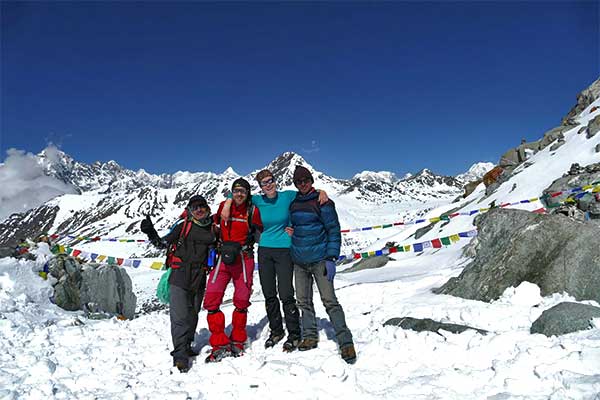
Everest Base Camp and Chola Pass Trek
- Strenuous Plus
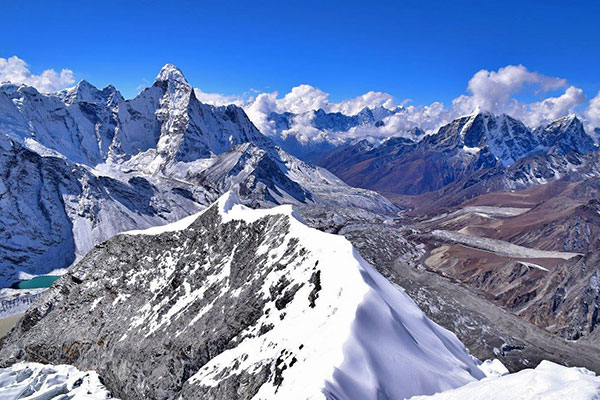
Everest Base Camp Trek with Island Peak Climbing
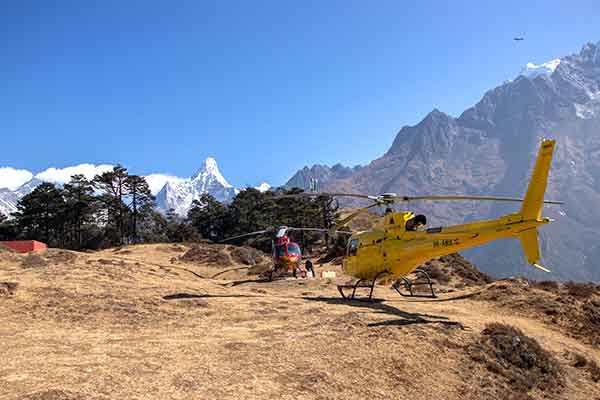
Everest Helicopter Tour
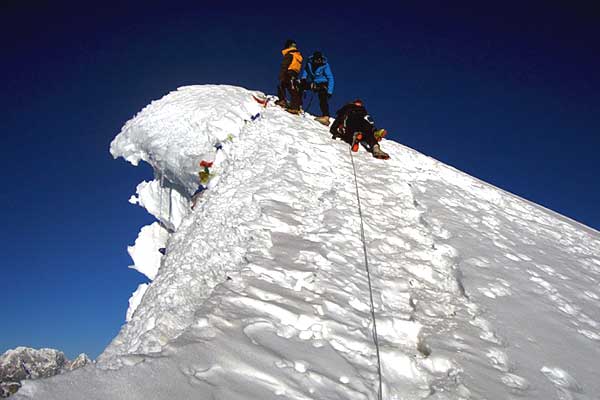
Everest Base Camp and Lobuche East Peak Climbing
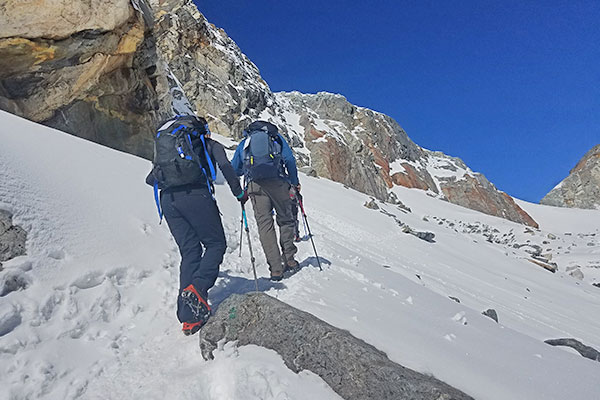
Everest Three Passes Trek
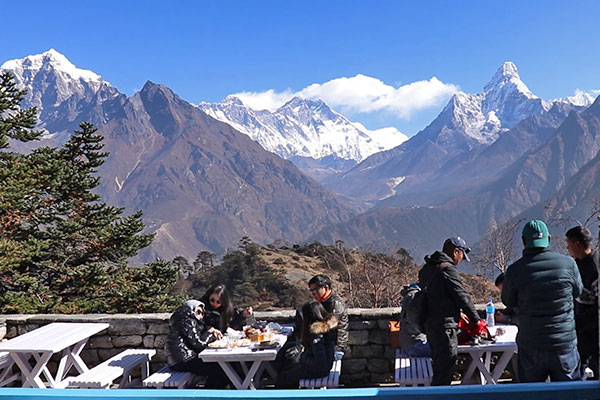
Everest View Trek
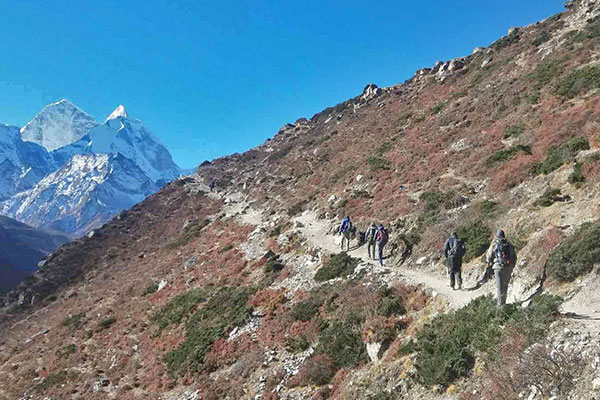
Jiri to Everest Base Camp Trek
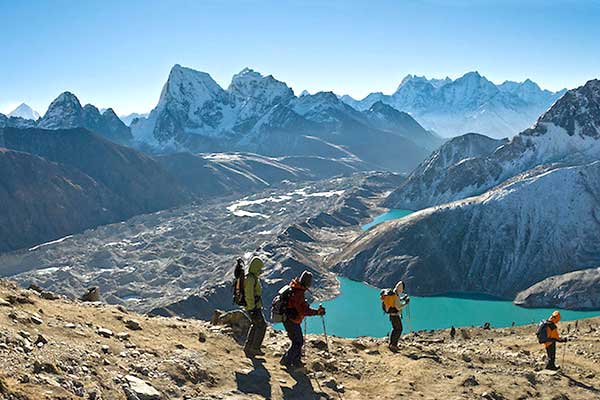
Gokyo Lakes and Gokyo Ri Trek
Clients review.
What our customers say about us
Exceptional experience
I booked the Thee Passes Trek and Everest Basecamp trek. 16 days, with guide and porter. It was an astonishing experience, it was challenging and at the same time beautiful. The landscapes are exceptional beautiful 😍. The trip was very good organised and it was a once in a lifetime trip I did not do the third pass because of health issues, but that did not made the trip less beautiful.
wilkeboerema
Trekking ebc with krishna.
Great and friendly team with extraordinary knowledge regarding trekking in Nepal. We had a fantastic experience on the EBC in beginning of September. Our guide, Krishna Gurung, gave great insights into Nepali culture and nature. His caring and pleasent manner made this journey even more enjoyable. Thank you, Danke and धन्यवाद! 🙂
10/10 would recommend!
I spent a month in Nepal and everything I did during that time was organised by Ramesh from NMT. Honestly, I have no idea what I would have done without him! Not only did he organise my trek to Everest Base Camp flawlessly, he also organised a home stay for me in the village he grew up in and a volunteer project at the local school. Both the trek and the volunteer project were amazing, life-changing experiences and were accommodated by my guide Manish Simkhada. He made sure everything was running smoothly, always looked out for me (especially when I had too much local wine) 😂 and was just an overall kind soul. It’s not easy to put up with me every day for an entire month but somehow he did it without complaint!
Thank you Ramesh and Manish for an amazing month and I will see you next time!
Oh and btw, I highly recommend doing some volunteer teaching at the school. The kids are super lovely and it is a very rewarding and eye-opening experience. Village life was simple and incredibly calming – away from the hustle and bustle of Kathmandu.
StephanieClaire
Ebc trek/cho la and renjo la.
Ramesh was super helpful with organising my trip to the everest region. I trekked ebc and cho la and renjo la. Beautiful trip and not as busy as it is in normal seasons. Just perfect. Thanks!
Christine R
Professional mountaineering team.
Ramesh and his team are experienced guides with perfect network. I felt all the time save during the tour. We had excellent communication beforehand and the members where a perfectly grouped together. In NMT they know how to make trekking dreams become true.
Life changing experience
Stayed in Nepal for 6 weeks trecking the EBC and the Langtang Valley. Everything was organised perfectly with great daily planning, I was never worried about anything. I highly recommend this company to anyone looking to trek in Nepal.
Kacper Domaracki
Great services a company you can trust.
I had a very good experience with Nepal mountain trekkers, the entire booking was done via email and Ramesh managed to design a trip that exactly fit my needs. always with a prompt reply to my emails The first couple of days went as plan until I started facing problems with one of the domestic flights that I had to catch during my trip, after spending hours at the airport the airline canceled my flight and since I had a very tight schedule, the cancellation of the flight caused a major disruption in my trip. My guide contacted Ramesh and he immediately started to work trying to fix the mess caused by the airline, he went above and beyond addressing all my new requests. So my experience with Nepal mountain trekkers couldn’t be better, it is for sure a company you can trust, when everything goes as plan is great, but when things get wrong is when you see who you can count with, and Ramesh was there supporting me all the time.
I spent a month in Nepal and everything I did during that time was organised by Ramesh from NMT. Honestly, I have no idea what I would have done without him! Not only did he organise my trek to Everest Base Camp flawlessly, he also organised a home stay for me in the village he grew up in and a volunteer project at the local school. Both the trek and the volunteer project were amazing, life-changing experiences and were accommodated by my guide Manish Simkhada. He made sure everything was running smoothly, always looked out for me (especially when I had too much local wine) and was just an overall kind soul. It’s not easy to put up with me every day for an entire month but somehow he did it without complaint!
Stephanie Claire
Everest base camp solo trek.
EBC was an absolutely wonderful adventure. The views of the highest mountains are simply wonderful. Ramesh (owner of Nepal Mountain Trekkers) arranged a guide for me who was very careful, helpful and nice person. During the trek, Ramesh also called me several times and asked about the trek and any difficulties if I faced or not. I must say that Ramesh is a very careful, responsible and trustworthy person. This was my first visit in Nepal and I met Ramesh hardly for 2 days. He is now a very good friend of mine. I look forward to the next Nepal trek with the Nepal Mountain Trekkers!
Your Nepalese adventure – Your way!
Our first hike in Nepal and it was incredible!
Ramesh organised our itinerary for my husband and I based on the amount of time that we had. This included a personal airport pickup, our return flights to and from Lukla, a guide and porter for us, and also our accomodation in Kathmandu before and after our trek.
We set out planning to get to Tengboche, as our time was limited, but we were able to take it day by day depending on how we were fairing. As we hiked, we thought, this isn’t as hard as we thought it would be – let’s go further! Our amazing guide named Tika was obliging and set a new route for us mid-hike and we made it all the way to Ama Dablam base camp. Tika was always only a few steps ahead and was happy to tell us the names of all the mountains we could see along the way, the names of trees and plants, and the names of the villages across distant valleys. When we reached our destination each night he was always busy organising our meals, cups of tea, making sure our drink bottles were filled and that we were happy and healthy. He’s a very polite, caring and experienced guide (with great english skills) who we’d definitely request for our next Himalayan experience and would certainly recommend to anyone else too.
We cannot express how satisfied and impressed we were with this company; a well run, honest business that really care for the customer’s experience and safety. Nepal Mountain Trekkers allowed us to choose our own start and end date and plan the trek each day with no fixed or locked in agenda. This type of flexibility is something that you do not get in large group tours. It was our own private tour without the private tour price.
I had the joy of getting sick the day before we left Nepal and Ramesh organised for my care at a local hospital – complete with sorting our insurance and transfers to and from the hospital. He went above and beyond his duty as hotel manager and trekking company operator – he made a difficult time easier. Both Ramesh and our guide Tika came to the hospital to visit and make sure my health was on the mend.
There are many companies in Kathmandu that can take you on a breathtaking hike; but this one truely has the heart and passion for this exceptional place on Earth.
We are already planning our next trip to Gokyo Ri with Nepal Mountain Trekkers – We couldn’t recommend higher! Nepal Mountain Trekkers 100%
Amazing 21 days in Nepal
Namaste, My wife and I went recently to Nepal for 22 days. We completed the EBC, visited the Chitwan Park, Pokhara and of course the capital Kathmandu. When one is planning a long, grueling, high altitude trekking trip such as EBC, they have many questions like: all gears, lodges, guide, porter or both, permits, altitude sickness and more… But when we just arrived to Horizon Hotel and we have had the pleasure to meet Mr Ramesh owner of the Nepal Mountain Trekkers agency, all the questions and doubts get its response. Indeed, Mr. Ramesh shows extreme flexibility and speed arrangement for your EBC trekking from getting permits for hiking and porter/guide at the same arrival day to Kathmandu. Moreover, on the same night of my return to Kathmandu from the EBC, Mr. Ramesh arrange for us the next tour trip to Chitwan Park and Pokhara with paragliding and also the bungee jump near the Tibetan border. All this in just within an hour of his making calls, he managed to arrange A-Z tour with all the arrangements needed. I would like really to thank Mr. Ramesh Dhakal from Nepal Mountain Trekkers organized the tour for us. I would highly recommend Mr. Ramesh for his very efficient and professional service. Owner Ramesh is a warmhearted person that listens to your wishes and provides alternatives you probably would not have come up with. In addition, the porter/guide for EBC Mr. Lapa was really professional, respectful and friendly providing even cultural overview of Himalayan Habitant. I was able to capture the spirit of Nepal, creating the most memorable experience that I will never forget. Dhanyabad
Trek to Everest Base Camp and around the Annapurna mountains
Our spectacular 7 weeks of trekking was planned, managed and led by Shiva Lal Bhatta who is an exceptional leader and guide. Shiva has boundless energy and a wealth of local knowledge that will ensure that you miss nothing on a trek, stay safe and have a truly wonderful and enjoyable experience. Shiva arranged all food and accommodation for our trek and we wanted for nothing. He made us very aware of altitude sickness and made sure we avoided that. We walked over glaciers, across avalanche areas, across rivers, through historic sites and numerous beautiful villages and temples. It was truly the trip of a lifetime and I can highly recommend Shiva as your guide in Nepal and I cannot believe that he could be bettered. The people we met through Shiva and the spectacular scenery experiences he afforded us will never be forgotten. I must also thank Ramesh for his part in helping us enjoy such an exceptional experience.
A spectacular and unforgettable adventure to Everest Base Camp”
On returning home from my trip to Everest base camp, people ask me “how was it?”. I always pause and think: “where do I start? The beautiful forests, the wonderful sounds of yak bells, and the things I learnt from my guide Min Nepali. There was so much awesomeness; it’s very difficult to convey what happened in the two and bit weeks I had with Nepal Mountain Trekkers. A good start is Nepal Mountain Trekkers organization and friendliness. From the very first contact I made with Ramesh Dhakal there was a good tailoring of the trek to our needs. All matters were well explained and no stone left unturned in Nepal Mountain Trekkers organisation. The adjustment of the holiday to our needs was constant throughout, with our guide Min Nepali was able to change our programmer throughout the trek to adapt to all our wishes. Min acted in a caring and friendly manner throughout the trip. The accommodation was excellent the whole way up the mountain, the food and drinks options were good (and very filling – I now have a new found love for Dal Baht and yak meat!) and there was plenty of opportunity to meet others travelers and have interesting convivial conversation. Our guide, Min became both a friend as well as our guide 🙂 He was extremely knowledgeable about the environment, enlightening us on our trek on mountain eights, Tibetan culture, and plants. Truly a Renaissance man of the Manaslu Himalayas areas I heartily recommend anyone considering a trip the Himalayas find these Nepal Mountain Trekkers team to get the most memorable experiences out of your time!
The best two trips of my life, thanks to Nepal Mountain Trekkers
My first trip to Nepal was in 2010, I contacted with Mr Ramesh Dhakal in Thamel and had a great impression; I asked about the activities I wanted to do (Everest Base Camp trek, Annapurna trek, cultural visits to the cities in Kathmandu Valley, sports…). Ramesh explained to me very kindly about all these activities, very deeply, with all the recomendations about the gear, the food, the guide, and made feel very safe, so I felt convinced about doing the activities with the company and no soloing. He told me a very important thing to me: “Here in Nepal we are happy if you are happy, because if you are happy you´ll come back. We are not interested in cheating people in any means”. We discussed the prices and never felt cheated. After that I met my guide Min Nepali, who was with me almost the entire tiem I spent in Nepal, and we became best friends. Ramesh and Min are really wonderful people, taught me a lot and more about Nepal, the nature, the people, the cities, and moreover with their attitude I learned the beatiful people that are Nepali peoples. Also Mr Devaraj Dhakal, the manager of the hotel the company runs, and all the staff made my journey an experience to remember. From temples to jungle to mountain passes (Everest Base Camp, Annapurna Region, Chitwan, Helambu route, Kathmandu, Bakthapur, Patan, bungee jumping, elefant riding…).
And after that…
From that trip I fell in love with Nepal, so in March 2015 I came back to Nepal with my wife, and of course we contacted Ramesh again. We did the Everest Base Camp route with Min Nepali again, this time more than a guide, he was a brother to us. Never felt treated so well. This time my wife also fell in love with Nepal.
From my experience, if you go to Nepal don´t doubt to contact Nepal Mountain Trekkers. Ramesh Dhakal and his staff will make the very best to make your trip a wonderful experience.
Everest basecamp trekking
We met Mr. Ramesh Dhakal during our Everest basecamp Trek. He was very helpful and very kind. He gave us a lot of helpful advices. We stayed his hotel which name is hotel horizon. Although the hotel is in the centre of Thamel, it is very quiet and very nice and clean. We highly recommend Nepal Mountain Trekkers and hotel Horizon. Our guide Ngima Tamang was very helpful and very kind. We highly recommend him.
Mehmet Akif K
We are associated with.
SEND US A MESSAGE
- Annapurna Region
- Manaslu Region
- Langtang Region
- Everest Region
- Makalu Region
- Kanchenjunga Region
- Wilderness Trek
- Great Himalayan Trail
- Kathmandu With Bhaktapur Tour – 4 Days
- Golden Triangle Tour In Nepal – 8 Days
- Buddhist Pilgrimage Tours -10 Days
- Nepal Cultural Tour With Himalayan Vista – 12 Days
- Nepal Wildlife Photography Tour – 4 Days
- Classic Pokhara Photography Tour – 5 Days
- Day Mountain Bike Trip in Kathmandu – 1 Day
- Mountain Bike Trip In Bhaktapur – 1 Day
- Annapurna Circuit Mountain Bike Tour – 14 Days
- Kathmandu UNESCO World Heritage Sites Tour – 1 Day
- Cultural Dinner In Kathmandu – 3 Hours
- Scenic Flight To Mt Everest – 1 Hour
- Trishuli River Rafting – 1 Day
- Tandem Paragliding – 30 Min
- Yoga and Meditation in Nepal – 1 Day
- Food Tour In Kathmandu – 1 Day
- Canyoning In Sundarijal – 1 Day
- Kathmandu Golf Tour – 1 Day
- Gosainkunda Helicopter Tour – 1 Hour
- Everest Base Camp Helicopter Tour With Kala Patthar – 1 Day
- ABC Trek with Heli Fly back – 11 Days
- Trekking Everest Heli Tour – 6 Days
- Annapurna Heli Tour From Kathmandu – 4 Days
- Island Peak Climbing with Everest Base Camp Trek – 21 Days
- Mera Peak Climbing in Nepal – 17 Days
- Lobuche East Peak Climbing with EBC Trek- 16 Days
- Chulu East Peak Climbing – 23 Days
- Pisang Peak Climbing in Nepal – 21 Days
- Yala Peak Climbing – 15 Days
- Tent Peak Climbing – Tharpu Chuli – 21 Days
- Singu Chuli Peak Climbing- 23 Days
- Everest Expedition in Nepal – 64 Days
- Makalu Expedition – 60 Days
- Manaslu Expedition – 46 Days
- Ama Dablam Expedition in Nepal- 30 Days
- Adventure Activities in Nepal
- Accessible Tourism
- Nepal Fishing Tour
- Sirubari Village Homestay – 8 Days
- Chitlang Homestay – 6 Days
- Ghale Gaun HomeStay Tour – 9 Days
- Honey Hunting Tour In Nepal – 11 Days
- Luxury Wedding Package in Nepal – 7 Days
- Chitwan National Park Safari Package – 3 Days
- Shamanism Tour In Nepal -11 Days
- Tibet Everest Advance Base Camp Trek – 19 Days
- Lhasa Tour with Yamdrok-Tso Lake – 5 Days
- Lhasa City Tour – 5 Days
- Overland Lhasa Tour (Drive In/Fly Out) – 8 Days
- Mount Kailash Tour Via Simikot – 10 Days
- Kailash Mansarovar Yatra – 13 Days
- Kailash Tour Frequently Asked Question
- Samtengang Winter Trek -10 Days
- The Chomolhari Trek – 12 Days
- Escape To Bhutan – 5 Days
- Bhutan Cultural Holiday Tour -6 Days
- Lhasa To Kathmandu Via Everest Base Camp – 13 Days
- Simikot To Mt. Kailash Via Limi Valley – 25 Days
- Tailor Made
- Meet The Team
- Why Great Nepal Treks?
- Our Affiliations
- Legal Documents
- Payment Method
Everest Base Camp Trek: Complete Guide For EBC Trek

Everest Base Camp

Everest Base Camp Trek Itinerary

Everest Base Camp Trek Difficulty

Everest Base Camp Trek Packing List

Everest Base Camp Tour

Mountain Flight

Everest Base Camp Side Treks

Passes Near Everest Base Camp

Peak Climbing Near Everest Base Camp
Everest Base Camp Trek
This iconic trek in Nepal is popular all over the world for its natural beauty and adventure. The trek usually starts with a breathtaking flight from Kathmandu to Lukla Airport . The Lukla airport is listed among the most dangerous airports in the world. Your hike to the Everest Base Camp starts as soon as you land at Lukla airport. The classic Everest Base Camp trek from Lukla to EBC and back is 130km long—65 km each way. Throughout your hike to the Everest Base Camp, you’ll be following the footsteps of Edmund Hillary, Tenzing Norgay and other mountaineers who have summited Everest.

Nepal has been ranked several times as one of the top 5 destinations according to main travel sites such as Lonely Planet, Tripadvisor, or National Geographic and most certainly the reason for this is the destination most often referred to as ‘Base Camp’. On your hike to Everest Base Camp, you’ll pass through the beautiful Sagarmatha National Park. This beautiful park is dominated by numerous snow-capped mountains and takes you through beautiful glaciers, valleys and exciting trails. The area was designated a national park in 1976 and encompasses several other peaks, all above 6,000 m. The park was recognised as a UNESCO World Heritage Site in 1979. The Park boasts of a wide variety of wildlife, including more than 118 species of birds. While the forest is dominated by silver fir, birch, rhododendron and juniper trees, animals such as musk deer, the Himalayan tahr, the Ghoral, the Serow, the Wolf, and the Himalayan Black Bear may be spotted by trekkers in this region.
The Everest Base Camp trek can be started from either the South Base Camp or the North Base Camp. The south base camp is very popular among trekkers and mountaineers. Every year, more than 40,000 trekkers use this base camp to trek for Mount Everest. The trek for the South Base Camp starts from Lukla airport. The trek starting from Lukla airport leads you to Namche Bazaar (3440 meters). Namche Bazar is known to be the heart of this area. It takes about two days to reach Namche Bazar from Lukla airport. Since the trek will reach heights in this region, trekkers are allowed to rest for a day for acclimatization. Then the trek moves towards Dingboche, 4,260 meters, where the trekkers will rest for another day for further acclimatization. Trekking from Dingboche, you’ll reach the Everest Base Camp via Gorakshop after trekking for two days.

Since the North Base Camp lies in Tibet, China, you’ll need a permit from the governments of China and Tibet. The permits can be obtained from the travel agencies in Lhasa along with the vehicle, driver, and guide. The North Base Camp is accessed by vehicle through a 100-kilometer road branching to the south from the Friendship Highway near Shelkar. You can also trek up from the tourist camp, but only when properly acclimatized. The “tourist base camp” is located about halfway between Rongbuk Monastery and the actual climbers’ base camp, which is at the foot of the Rongbuk glacier.
Both the routes to Everest Base Camp are equally beautiful and adventurous. Along the beautiful trekking paths, you’ll come across breathtaking views of the Himalayas, ancient Buddhist monasteries, Sherpa lifestyle and culture, and flora & fauna. The taste of olf and several hundred d breezes at Everest Base Camp will make you nostalgic your entire life.
Some of the major highlights of the Everest Base Camp trek include the visit to the renowned Himalayan town of Namche Bazaar, also known as the Gateway to Everest. From this point, you can get beautiful views of Nepali Himalayas like the Thamserku, the Kongdi RI, the Ama Dablam, the Lhotse Himal, the Nuptse Peak, the Kusum Kanguru, and, of course, Mount Everest. Namche Bazaar is popular with trekkers in the Khumbu region, especially for altitude acclimatization, and is the gateway to the high Himalaya. The town has a number of lodgings and stores catering to the needs of visitors, as well as a number of internet cafés. There are German bakeries, little cafes, and many restaurants.

The Tengboche Village, especially the famous Tengboche Monastery, is another attraction of the Everest Base Camp trek. This is one of the largest and oldest Buddhist monasteries in the region. Kalapatthar, another highlight of the trek, presents panoramic views of the entire Mount Everest massif in a spectacular fashion.
On your hike to Everest Base Camp, you’ll move through the popular village town of Namche, quiet monasteries & meet up with the well-known Sherpa folks who inhabit this region. The most important part of the hike is that you get to experience the lifestyle and culture of the Sherpas. The legendary trail for hikes to Everest Base Camp is not just adventurous but also gives a psychological thrill to the trekkers looking for a hike.
You can also check our blog, Most Awaited And Thrilling Adventure | Hike To Everest Base Camp for more information.
You cannot hike to Everest base camp any time of the year. The best time to hike Everest Base Camp is during autumn and spring. If you are planning to hike to Everest Base Camp, please make sure that you don’t plan for June, July and August as the trail remains slippery and muddy due to the monsoon. There are two trekking seasons to hike to Everest Base Camp. So, the best time to hike Everest Base Camp during the pre-monsoon season are during February, March, April and May. And, if you are planning to hike to Everest Base Camp in the post-monsoon season, the best time to hike Everest Base Camp would be September, October, November, and December. You can choose to trek to Everest Base Camp in January and February but it can be very cold higher up (-20°C/-4°F to -30°C/-22°F) It can dump snow on the trail at any time of year. If you are planning on trekking to Everest Base Camp in these months, you will need more time for weather delays. Weather conditions can be more challenging in these winter months.
For more information, you can check out: BEST TIME FOR EVEREST BASE CAMP TREK
Trekking in Nepal is seen as much cheaper in comparison to trekking in other nations. Trekking to Mount Everest is also very affordable, given the experience you get to enjoy. However, the total cost to climb Everest Base Camp depends on various factors.
1. The length of your trek.
2. The season/month you are planning for the trek. Your total cost to climb Everest Base Camp is usually higher during peak seasons.
3. The type of trek you are planning, such as an all-inclusive trek, a guided trek, or an independent trek.
4. Lastly, consider the route you are planning to use. The Lukla route is expensive compared to the Jiri route.
Other costs include the costs of buying permits to trek in the Everest region. You need to collect two different permits, i.e. the TIMS Card and the Sagarmatha National Park Permit. The Sagarmatha National Park permit costs $33 (Nrs 3,390). With this permission, you can also get access to the Khumbu region.
a. Everest Base Camp Trek Itinerary
If you are wondering how long the Everest Base Camp trek is, let us inform you that the Everest Base Camp itinerary is usually composed of 14 days. Depending on your time availability, you can also plan your Everest Base Camp Trek Itinerary for 10 days. The 10-day itinerary is recommended for those who lack time and prefer not to camp. No matter how many days you plan for the trek, you’ll obviously get to experience the beauty of the Everest region. The Everest base camp trek itinerary includes the exploration of Namche Bazaar. This popular hub of the Everest region is the Sherpa heartland of the Khumbu region of Nepal.

How to get to Everest Base Camp must be one of the first things that comes to mind when you plan for an Everest Base Camp trek. The trip usually starts with a flight to Lukla from Kathmandu. The Everest Base Camp Trek Itinerary also includes a visit to the very beautiful Sagarmatha National Park. Here you can witness some rare wildlife like red pandas and snow leopards, alongside typical ones like musk deer and Himalayan monal. The Tengboche Monastery is another major inclusion in your Everest Base Camp Trek Itinerary. This is the largest monastery in the Everest region. Your itinerary also includes a hike to Kala Pathar, which is one of the best points to view the majestic Himalayan ranges. On your trek to Everest Base Camp, you’ll get a chance to get close to the Sherpa culture and tradition. Sherpas are and have always been famous worldwide for their bravery and high-altitude mountain knowledge, along with their hospitality.
While it is an amazing experience, there are also many challenges along the way, and the trekkers should be aware of this. Altitude sickness is one of the most common risks, but this can be mitigated by following a proper base camp itinerary. EBC trek is actually listed as one with the highest rates of high-altitude sickness. Regardless of your fitness level or how experienced you are in high-altitude mountaineering, following the recommended itinerary could prevent this.
b. Everest Base Camp Trek Difficulty
Every year, more than 40,000 people start their trek to Everest Base Camp. But only a few succeed in completing the trek. The Everest Base Camp trek difficulty is rated as moderately difficult. Over the years, people of all ages, shapes and sizes have completed the trek with minimum preparation. If you have the right determination, you can easily conquer the trek.
While planning for the Everest Base Camp trek, the most important and frequently asked question is “How hard is the Everest Base Camp trek?”. Trekking for the Everest Base Camp does not require mountaineering skills or technical expertise. The only thing to be kept in mind is the need for proper acclimatization. However, it is always a good idea to seek professional medical advice before trekking at these altitudes and research altitude sickness to make yourself fully aware of the symptoms and treatments available.
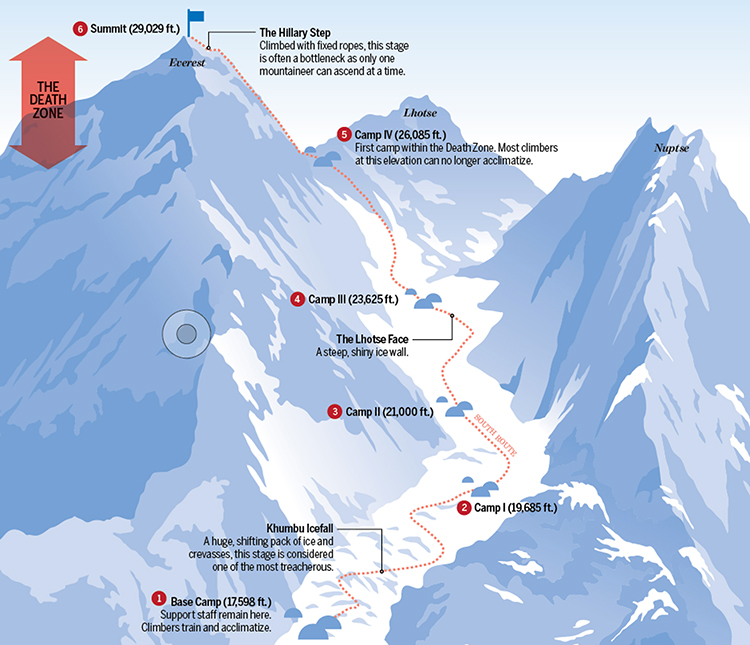
Now that you have the answer for how hard the Everest Base Camp trek is, we’ll now provide information on the Everest Base Camp Weather. Since the snow-capped regions are never hot, the Everest Base Camp weather is cold and freezing throughout the year. The Everest Base Camp weather differs in every season. During the day, the temperature reaches up to 25 degrees Celsius, the maximum, and at night, it may drop to -20 degrees Celsius or lower on the same day.
Check out our blog on Everest Base Camp Trek Differential: Everest Base Camp Trek Difficulty | Untold Myth Of Everest
Usually, the weather drastically changes at higher altitudes. It can be sunny once and suddenly you need to look for shelters due to rain or snowfall. Since the Everest Base Camp is a dry region, the area faces very little rainfall, with about 18 inches of rainfall received every season.
How high is Everest Base Camp? is another frequently asked question by trekkers. The most challenging part of the Everest Base Camp trek is the Everest Base Camp elevation. The start point of the trek at Lukla is at an altitude of 2600 m. Because of this elevation, trekkers need to allocate a lot of time for acclimatization. Typical elevation gains will be in the range of 400–800 m each day. Days when the gain is large and the altitude is significantly high will usually be followed by an acclimatization day that doubles up as a time for some sightseeing and exploration of the surrounding areas.
c. Everest Base Camp Trek Packing List
When you are going to remote areas like Everest Base Camp, you should have an ideal packing list. There is only one rule for packing for trekking: pack light. On the flights into Lukla, the weight limit for checked bags is only 10 kg. So if don’t want to spend extra dollars for your extra luggage, you need to pack light. Having light luggage will also make your trek easier. Firstly, you need to get a backpack that is comfortable for your body. For trekking, a 60-liter backpack is highly recommended.
Secondly, you need to get well-fitting hiking boots . We highly recommend you get an ankle boot for your trek to Everest Base Camp. Since new boots can give you blisters, you can use them a few weeks ahead of time. Another important thing is the down jacket . Both mornings and evenings in the Everest region are going to be cold. It is recommended to bring a real goose feather down jacket from your home country. Or, you can buy them at stores like North Face, Sherpa, KAEMP 8848, Mountain Hard Wear, and Black Yak in Kathmandu.
Rain (Windproof) Jacket is another essential part of your Everest Base Camp Trek packing list. This handy jacket will provide you with protection against wind and rain and can also be used when it is sunny and too hot for a down jacket. Jackets with detachable layers are particularly handy. Waterproof trousers are also recommended during the monsoon season.
Finally, another important thing to consider while you prepare the Everest base camp trek packing list is the clothes . The type of clothes you need to pack for the Everest Base Camp Trek depends on the month you’ll be traveling.
The large variation in altitude and temperature makes it important to use layers of clothes. Being able to add or remove layers of clothing while you trek will allow you to readily adapt to the temperature and ensure that you remain comfortable and safe.
Following are some of the major items that need to be included in your Everest base camp trek packing list:
You can add other items depending on your need while you plan for trekking in Nepal or consult with the Nepalese trekking agencies.
For more details, you may also read this article: Packing List For Everest Base Camp Trek – Did You Miss Anything
#Everest Base Camp Tour
If you are not a trek lover or you have a very limited stay in Nepal and want to visit Mount Everest, you can opt for the Everest Base Camp tour via Mountain Flight Tour or Heli Tour . With these , you get to fly parallel to the Himalayas, enjoying the scenic beauty of the Everest region. And the down side is that you miss the opportunity to view the wildlife and lifestyle of the locals in the Everest region. You can experience the Everest Base Camp tour by mountain flight or heli tour.
You can also read: Everest Base Camp Tour | Scenic Flight Tour Through Himalayas
Both of these tours will take you very close to the Everest region, where you can get a very close view of the beautiful mountains like Mount Nuptse, Mount Lhotse, Machhapuchhre, Ama Dablam, Gaurishankar, and many others along with Mount Everest. Also, you can get a view of Gokyo Valley, Gokyo Lakes, and the Khumbu Glacier.
a. Mountain Flight Tour
The Everest Base Camp Tour is basically an hour-long flight by airplane or helicopter. Both these flights offer the best aerial view of Everest. The flight for the Everest Base Camp tour takes off from the domestic terminal at Tribhuwan International Airport in Kathmandu. People often wonder about the difference between the Everest Base Camp Heli Tour and the Mountain Flight Tour. Both involve exploring the Everest region in a short period of time. Both trips provide the same views and facilities. There is also the option of Mount Everest flight to explore the Everest region.
The main highlight of this tour is the best view of the Himalayas: Everest 8,848m, Shisa Pangma 8,013m, Dorje Lakpa 6,966 m, Choba Bhamre 5,933m, Gauri Shankar 7,134m, Menlungtse 7,023m, Numbuedr 6956 m, Karyolung 6511m, Cho Oyu 8201m, Gyachungkang 7952m, Pumori 7,161 m, and Nuptse 7855m.
While on board, the flight attendant will provide you with the ‘Himalayan Peaks’ map. This map contains information about the different peaks you get to enjoy during the mountain flight. The flight attendants also brief on visible mountains. You will see stunningly beautiful mountains that are above 8000 meters, such as Cho-Oyu, Shisha Pangma, Mt. Everest, and Lhotse, from a guaranteed window seat on the aircraft. To mark your once-in-a-lifetime experience at the top of the world, Buddha Airlines, a domestic airline in Nepal, gives out a personalized Everest Experience certificate to each passenger after the completion of the flight.
b. Heli Tour
The only differences between the mountain flight tour and the heli tour are the total time duration, landing at EBC and Kala Patthar, having breakfast at an extreme height, i.e., at Everest View Hotel, and some relaxation time. You can enjoy this if you take a helicopter tour to the Everest Base Camp.
This helicopter tour takes you above Kathmandu Valley towards the Khumbu region. From Lukla, it flies over Namche Bazaar, Everest View Hotel, Tengboche, and Khumbu Valley, covered in rhododendron forests, villages, and rugged terrain. The landscapes near the mountains above which the helicopter flies are covered by moraine, rocks, and glaciers. Apart from Everest, one can also get beautiful views of mountains like Lhotse, Pumori, Nuptse, Makalu, and Cho-Oyu during this helicopter ride.
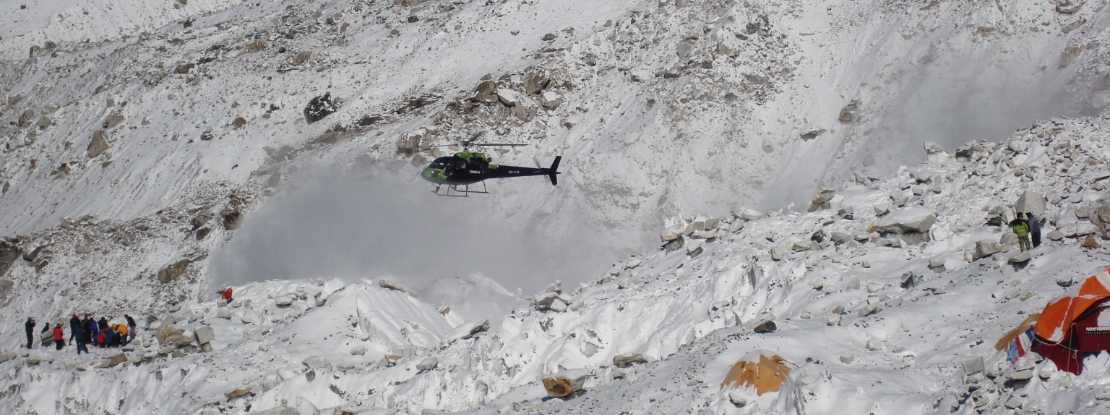
The helicopter lands in 4 places: Lukla airport, Pheriche, Kalapatthar, and the Everest View Hotel. Pheriche is a village in the Khumbu region situated at an altitude of 4,371 meters. The group of 5 people initially getting into the helicopter splits into two groups and rides separately to get to Kalapatthar. You can also go on the Everest Heli Tour .
Everest flights can be done throughout the year. However, the best times for Everest tour flights are from the from the end of February to mid-May and from the end of August to mid-December. During this time of the year, the weather is clear, and you can see a clear view of the mountain range.
Everest Base Camp Side Trips
The increasing popularity of the Everest base camp trek makes it a top choice among trekkers. This is why, while planning for the Everest Base Camp trek, they plan their itinerary focused only on the Everest Base Camp. Very few trekkers are aware of the fact that there are many beautiful places in the Everest region that can be included in the Everest Base Camp Trek package. There are many options for possible side treks that will take you to the unexplored areas of the region. Since you’ll be trekking to very high altitudes during your Everest Base Camp trek, you’ll need to allocate 2-3 days for acclimatization.
There are two acclimatization breaks during a trek to Everest Base Camp: one at Namche and another at Pheriche/Dingboche. During these breaks, the best way to increase your acclimatization is by going high during the day and coming back to sleep at a lower altitude. During this acclimatization period, you can plan for Everest Base Camp side trips.
a. Trip To Thame
Thame village is located about three hours hike from Namche Bazaar. This place is mostly used by trekkers as a stop for acclimatization. On your trip to Thame from Namche Bazar, you’ll hike through the beautiful rhododendron forests. Thame Monastery is the major attraction in this region. This is the oldest monastery in the Thame region.
The route for your trip to Thame takes you through the old trade route connecting Khumbu to Tibet. The best thing about this trail is that you’ll get to experience some stunning views, plenty of wildlife, and very few people. You will be walking through pine forests and watching out for tahrs and monals along this section. Also, it might be interesting to know that Thame is home to Tenzing Norgay, who, with Sir Ed Hillary, conquered Mount Everest for the first time. Thame village is also the home of Apa Sherpa, Nepal’s most famous living climbing Sherpa and holder of the Guinness Book of Records for the summits of Everest the most times. During this trek, you will get a chance to explore the Sherpa culture, customs and traditions. trip to Thame is about 7-8 hours round trip from Namche Bazar.
b. Trip To Kala Patthar
Kala Patthar is considered to be the best point in the Everest Base Camp trek. A trip to Kala Patthar is preferred by almost every trekker because you can get the best view of Everest from this point. You can also plan your trip to Kala Patthar so that you get to view the sunrise. The trip to Kala Patthar is about 3-5 hours round trip from Gorakshep.
Kala Patthar, which means a black rock in English, stands at an altitude of 5,644m above sea level. This makes it the highest altitude reached on most EBC treks, at over 300m above Everest Base Camp. The name Kala Patthar comes from the coloration of the rock that makes up its peak—a dark black that stands in stark contrast to the snow-capped peaks it surveys. trip to Kala Patthar has become very popular these days, as you can get a beautiful view of the peak of Mount Everest from the top. You cannot get this view even from Everest Base Camp.
You can also get a beautiful view of Mount Amadablam, Makalu, Cholatse, Nupse, Pumori, and many other great peaks in Kala Patthar. The best time to climb Kala Patthar is during the fall between September and December. Spring is also a popular time to trek, but the sky will be hazier, so most people prefer to wait until after the summer monsoon season to enjoy crystal-clear Himalayan views.
c. Trip To Gumela/Rimishung Monastery
On the way to your trip to Gumela/Rimishung Monastery, there is a large yellow signboard advertising the trail to Rimishung. The sign leading to the wide trail takes you to the monastery and nearby settlement. The quiet walk through pine forests should take you to the monastery in about half an hour from Phakding. The monastery is one of the oldest in Khumbu, and while a modest affair, it has art forms that are steeped in history. The Rimishung monastery is a popular monastery that you can find on the other side of the Dudh Koshi River. On your trip to Gumela/Rimishung Monastery, you’ll get to view the mountains like Karyolung (6367 m), Gongla (5813 m), and Nupla (5885 m). You can find many suspension bridges during this trek.
d. Trip To Chukung
The trip to Chukung is organized as part of acclimatization. The side trip to Chukung does not only facilitate acclimatization but will also introduce you to alpine flora. This trek takes you through the Rhododendron forests and juniper shrubs. Salient, Alpine Shrubby Horsetail or Somlata, a highly medicinal plant, is also available in this region. During late spring, you’ll also find rhododendrons in bloom, along with honeysuckle and cinquefoils. If you wish to enjoy the flora of this area, you will have to come during the monsoon in July or August. trip to Chukung is about 4-5 hour round trip from Dingboche.
A trip to Chukung is a unique blend comprising an elegant Chukung valley featuring the ‘climbing peak of Chukung Ri’ and a sublime Khumbu region comprising picturesque landscapes, exquisite flora and fauna, heartwarming locals, and inimitable hospitality. Along the trail, trekkers tend to notice and admire Buddhist monuments such as monasteries, stupas, chortens, prayer wheels, and mani walls, reflecting Buddhist fine arts, Buddhist mantras, and vivid prayer flags. The best season for Chukung Ri peak climbing is from March to May and September to December. With an elevation of 5,550m, Chukung Ri Peak is accessible for climbing and is categorized as a group “A” climbing peak by the Nepal Mountaineering Association.
e. Trip To Khumjung
The trip to Khumjung starts from the top of Namche. This is one of the most beautiful Sherpa villages in Nepal. During the acclimatization break, you can plan a trip to Khumjung village. At the top of Namche Bazar, you’ll come to an intersection of four trails. The first trail is the one you came from; the one to the left will take you to Thame, while the one to the right will take you to Kyangjuma. It is the middle one that climbs steeply up the slopes that will take you to Khumjung.
About half an hour of this steep climb will bring you to Syangboche, which is a small airstrip town. Just as you reach the airstrip, make sure to keep to the right. You should reach a small hotel in about 10 minutes. From here, it is relatively easy to follow the trail past the famous Everest View Hotel and beautiful mixed forest to land in Khumjung about an hour later. If you wish to stay, you will also find plentiful lodges in Khumjung. This trip will reward you with a chance to meet the charming local people, experience the warmth of Sherpa culture, taste their cuisine and see the mountains from different angles.
f. Trip To Khunde
The Khunde and Khumjung villages are known as the twin villages. Kunde is a village in the Khumbu region of Nepal, within the Sagarmatha National Park. These villages lie in what’s known as the Green Valley, in reference to the standard green roofs featured by every house except the roof of the local gompa. The Green Valley on a trip to Khunde offers excellent views of both Ama Dablam and Thamserku. Another local attraction on your trip to Khunde is the cave above Khunde, where the guru Rimpoche is said to have meditated. This hike is best done as a loop from Namche.
Kunde is located in the western part of the valley and is slightly higher than Khumjung. It is the site of Kunde Hospital, founded by Sir Edmund Hillary in 1966. Kunde is located less than 25km away from Mount Everest and is situated in the Himalayas near the Nepal/China border.
You can also hike to the Khunde viewpoint, which is about a 2-hour uphill walk from Khunde village, which is a 15-minute walk from Khumjung village. It offers 360-degree views over Khunde and Khumjung villages, Mt. Khumbila, Amadablam, Thamserku, Kangtega, Pachermo Peak, and Kongde Ri, among others. The view is the best from here and is completely worth hiking uphill.
Everest Base Camp Side Treks
Just like Everest Base Camp side trips, you can also arrange for various Everest Base Camp side treks. On the way to your trek to the Everest Base Camp, there are various long and short trekking destinations. These destinations can be added to your itinerary if you plan to stay in Nepal for a longer period of time. Some of the most popular destinations for Everest Base Camp side treks are Everest Gokyo Lake Trek, Everest Three High Pass Trek, Everest Gokyo Ri Trek, Everest View Trek, Sherpa Village Trek, and many more. These are the side treks that are mostly preferred by trekkers travelling to Everest Base Camp.
a. Everest Gokyo Lake Trek
The beautiful Everest Gokyo Lake trek is a popular choice among trekkers travelling to the Everest region. The major attractions of the Gokyo Lake Trek are the majestic views of the mountains like Everest, Lhotse, Nuptse and Makalu. The largest glacier of Nepal, the Ngozumpa glacier, also lies in the Gokyo Lake region.
The Everest Gokyo lake trek is an ideal option for mountain lovers and people who like to face challenges that come with high altitudes. Just like the Everest Base Camp trek, the Everest Gokyo Lake trek also starts from Lukla. The trekkers will have to stop for a day or two at Namche Bazar for acclimatization. Then the trip will head towards Ngozumpa Glacier. Again, after walking for two days, the trekkers will have to stop at Machhermo village. Then, finally, the trek will head towards the Gokyo Valley.
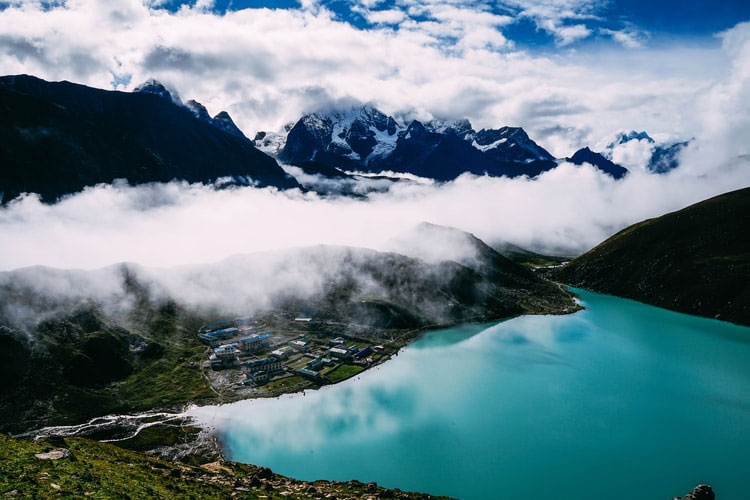
The Gokyo Valley welcomes you with beautiful cobalt blue lakes that continue for 3 hours on your hike to the Gokyo Village. The Gokyo Village sits at the foot of Gokyo Ri (18,300 ft), a huge black mound of rock and dirt. From here, you can get a 360-degree view of the Himalayas. The Everest Gokyo Lake trek also provides you an insight into the culture and lifestyle of the Sherpa people, the major inhabitants of this region who are famous for mountaineering in the world. Also, you pass through the lush forest of rhododendron and pine, Dudh Koshi valley, Sagarmatha National Park, high passes, waterfalls, and beautiful Sherpa villages like Phakding, Namche Bazaar, Tengboche, etc. Hiking along the trail, you also come across many old Buddhist monasteries and museums, traditional Sherpa culture, and their kind hospitality.
You can read our blog, Exploring The Captivating Turquoise Lakes | Everest Gokyo Lake Trek for more information on Gokyo Lake Trek.
The best season for Everest Gokyo Lake trek is considered to be during autumn and spring. June, July and August are not recommended for visit in this region as the trail remains slippery and muddy due to the monsoon.
b. Everest Three-High Pass Trek
This Everest side trek is named the Everest Three High Pass Trek, as the trek will take you across three high altitude passes, i.e., Renjo La Pass (5,465m), Cho La Pass (5,420 m), and Khongma La Pass (5,535m). This beautiful side trek should be a definite addition to your Everest Base Camp trek. This side trek also covers well-known trails that include EBC, the towering Kalapathar, and the tranquil Gokyo Valley with its emerald lakes. Just like many other treks, the Everest Three High Pass Trek also starts from Namche Bazar. The trail to the Everest Three High Pass Trek will also allow you to witness the world’s eighth highest peaks: Makalu (8,463m), Lhotse (8,516), Cho Oyu (8,201m), Everest (8,848 m), and many other mountains.
The Renjo-La Pass Trek takes you to the remote but naturally rich areas of the Khumbu region. The region also provides an amazing view of the mountains and the highest freshwater lake system, called Gokyo Lakes. Renjo-La Pass Trek also includes a hike up to the to the highest altitude hotel in Nepal, i.e., Hotel Everest View. Renjo-La Pass Trek starts in Lukla, featuring the mighty Himalayas. The trek leads you through rocky trails along with lush Himalayan forests of juniper, rhododendron, fir, and pine. Renjo-La Pass Trek highlights the Sherpa villages of Namche, Thame, and Gokyo as it reaches the high pass of Renjo-La, which hosts an amazing view of the mountains and the highest freshwater lake system called Gokyo Lakes. The trekkers will get to relish the alluring panorama of Everest (8848m), Cho Oyu (8201m), Lhotse (8516m), Ama Dablam, Makalu (8481m), and many other snow-capped mountains of the Khumbu region throughout the trek. The Renjo-La Pass Trek also includes a hike up to the hotel operating at the highest altitude, Hotel Everest View. The trekkers will also get to learn about the Buddhist traditions from the Sherpa villages en route. The trek route comparatively has fewer crowds. Hence, it is the perfect trek for travelers who love to spend their time in solitary places.
Autumn and spring are considered to be the best seasons for trekking in the Everest 3 High Pass region. June, July, and August are not recommended as the trail remains slippery and muddy due to the monsoon.
The Cho La Pass trek is an ideal option for trekkers looking for a challenging trek. The most challenging part of the trek is to cross the Cho La Pass border itself at 5,420 m. This 18- to 21-day trip goes through both the Gokyo Lake area and the Everest Base Camp. The Chola Pass trekking has some brief and interesting “climbs” of Gokyo Ri, Chukkung Ri, and Kalapathar. During the trek, you pass through several villages & tranquil monasteries, along with stunning waterfalls and lovely landscapes with views of mountains that thrill your emotions. Hiking by the delightful Dudh Koshi River into the capital of the Khumbu—Namche—on our way up to Gokyo Valley, viewing the grand Ngozumpa glacier—the biggest glacier in Nepal—as we make a beeline for Cho La pass and the majestic scenery from Gokyo Ri and Kalapathar, makes our journey a blockbuster of an outing to remember for years.

Generally, the autumn and spring are the perfect and highest trekking seasons for the Cho La Pass Trek. June, July, and August are the low months to visit the Everest region, as the trail remains slippery and muddy due to the monsoon.
Similarly, Kongma La Pass Trekking is yet another off beat and challenging trekking trail in the Everest region. This is why trekking in this region requires previous experience of trekking or crossing high pass. When you cross above 3500m, there is little bit of a risk of high altitude sickness. This pass is situated just above the Dingboche and south-west of Mt. Everest, the highest mountain of the world. Kongma La pass trek offers a fantastic view of Mt. Everest, Nuptse, Lhotse and many more.
The journey to Kongma La pass begins with a scenic flight from Kathmandu to Lukla. Kongma La pass trekking trail is an adventurous trail that requires previous experience of trekking or crossing high pass. Among the three high passes of the Everest region, Kongma LA pass is one of the most picturesque and spectacular areas. From Lukla you follow the classic Everest trekking trail, crossing famous places Namche bazaar, the gateway of Everest region, Tengboche, Dingboche and Kongma La pass.
c. Everest Gokyo Ri Trek
The Everest Gokyo Ri Trek is a beautiful and moderate trek in the high Himalayas of the Everest region. This is a better option to travel the trails on less-crowded trails. Since it is a moderate type of trek, the Everest Gokyo Ri Trek is suitable for both experienced trekkers and novice travelers. From the summit of Gokyo Ri, you get panoramic mountain views, including four 8,000-meter peaks: Mt. Everest, Lhotse, Cho Oyu, and Makalu. It is also said that the view from Gokyo Ri is better than the view from Kala Patthar.
The Everest Gokyo Ri Trek is also known as Trekking peak as it allows trekkers to reach the summit without climbing gears or peak permits. In the Gokyo region, there are a total of 19 lakes, and all of them are formed by a freshwater system, collectively known as gokyo lakes. The trek starts from Lukla and heads towards Phagding, Namche Bazaar, Dole Machhermo, and Gokyo Lake, which follow naturally stone-stepped trails, the same trails as those used by locals Sherpa and “Yak” caravans to supply the stuff to Machhermo and Gokyo. The Everest Gokyo Ri trek also leads through Gokyo Lake, Gokyo Ro, and Machermo Base Camp. This trek route also provides the opportunity for memorable observation of landscapes through the Khumbu region, Gokyo Valley, and Dudh Koshi River. Everest Gokyo Ri Trek leads to the biggest glacier in the Himalayas, where several glacial lakes formed by the melting of glaciers are found. These glaciers are filled with crystal-clear water. On your trek, you can also pay a visit to the Sherpa Museum, where you can experience Sherpa culture and tradition.
In addition, during the Everest Gokyo Lake Trek, you get to enjoy the diversified flora and fauna, along with colorful Rhododendron and Bamboo forests, amazing landscapes and warm hospitality of the local Sherpas with their culture and traditions.
d. Everest View Trek
The Everest View Trek is one of the best short treks in the Everest region. This beautiful trek takes you to the majestic mountains, walking through the most diverse landscapes in the Khumbu region and Sherpa villages. The Everest View trek is suitable for trekkers who have a very limited stay in Nepal and want to experience trekking in the Everest region. Starting from a flight from Kathmandu to Lukla, the trail goes through the Sherpa villages of Namche Bazaar, Khumjung, and Khunde and treks back to Manjo and back to Lukla. During the trek, you’ll be treated to mesmerizing views of Everest, Ama Dablam, Lhotse, Kongde Ri, and Kusum Kanguru. The Tengboche Monastery in this region is also reputed by photographers as one of the best places to capture the remarkable beauty of Mt. Everest and its neighboring peaks.
Moving ahead from Namche Bazar, you’ll go through the Sagarmatha National Park. This park is famous all over the world for its diverse flora and fauna. The trail to the Namche Bazar will take you through the most beautiful sights of dense pine forest, rhododendron flowers, and wildlife. Namche Bazar is the acclimatization point for all the treks in this region. After spending a day or two at Namche Bazar, you’ll trek through Tengboche Monastery (3,860 m), the home of the highest Buddhist monastery in the Khumbu region. Walking along, you’ll get to Khumjung Village, where you can see the alluring village of the Sherpa people.
The best time for the Everest View Trek is March to May during spring and September to November during autumn. Since this is a short and easy trek, even children and older people can easily do it. This trek is the best way to get magical views of the Everest without the fear of altitude sickness problems. Trekking during the festive seasons will be a bonus treat to the fantastic trek.
e. Sherpa Village Trek
The Everest Sherpa Village Trek is a moderate trek that takes you to the heartland of the Sherpa, numerous monasteries, and beautiful mountains. Sherpa Village, also known as the land of heroes, has written history with numerous records from mountain climbing expeditions. Here, you get to interact with local Sherpas and learn about their culture and lifestyle. Sherpas are also very famous for their amazing hospitality.
A trip to Sherpa Village starts in Lukla. From Lukla, the trek will move towards Chumoa, leading to Namche Bazaar. This is the first point where you’ll get to witness the local Sherpa culture and tradition. Also, if you are looking for an extra adventure, you can always choose to set up a tented camp around the foothills of the Himalayas. After acclimatizing at Namche Bazar for a day or two, we ascend for a couple of days by setting camp at Thame, Khumjung, and Phortse, and finally arrive at Tengboche. Tengboche is one of the most popular sites on the Everest trekking trail. A visit to the Tengboche Monastery is a must-do on this trek. The Everest Sherpa Village trek will treat you to the best views of mountains, including Lhotse, Nuptse, Amadablam, and Mt. Everest. Then the trek will descend the same route towards Namche, Luka and board a flight back to capital city of Kathmandu.
This trek allows you to explore the local culture of the Sherpas and interact with the Sherpa people, visiting their villages and homes, eating their food, and experiencing their religion and way of life. You would definitely not want to miss this rare chance to gain insight into a mostly unchanged cultural system, a chance that will live with you throughout your days.
Sherpa Village Trek can be planned at any time of the year; however, the autumn and spring seasons are regarded as the best ones.
#Passes Near Everest Base Camp
There are three major passes near Everest Base Camp, namely, Renjola Pass, Chola Pass, and Kongma La Pass. These pass treks offer a wonderful trekking experience in the Everest region. The trek to passes near Everest Base Camp is suitable for experienced trekkers who wish to cross the high altitude passes with the hike to the smaller peaks to explore the Himalayan wonders. This challenging route crosses three high-altitude passes with views of 4 out of 10 of the world’s tallest mountains.
The three high passes link the four distinct valleys of Bhotekoshi, Gokyo, Khumbu, and Imja Tse. Crossing the rugged high passes of Renjo La (5388 m), Cho La (5380 m), and Kongma La (5535 m) with the climbing of the three peaks of Gokyo Ri (5483 m), Kalapathar (5545 m), and Chukung (5550 m), along with the hike to Everest base camp, makes this 3-pass trek the most incomparable and unforgettable trekking experience in Nepal. From the top of Renjo La and Gokyo Ri, you can get great views of Makalu (8,463m), Lhotse (8,516 m), and Everest (8,850m). After crossing the first pass, rest at Gokyo and take in the iconic views of Mount Pharilapche (6017 m / 19741 ft) as it rises above the milky blue lake of Dudh Pokhari.
You might also like: Trekking Around The Everest Base Camp | Everest Three Pass Trek
Renjo-La Pass
One of the most underrated trekking routes in Nepal, the Renjo-Lo Pass Trek takes you to the most remote but naturally rich areas of the Khumbu region. The Renjo-La Pass (5360m) is one of the three high passes in the Everest region. Located at 17,560 ft (5,360 m), this is the lowest altitude of the three passes (the other two being Kongma La and Cho La), and it’s the only pass that doesn’t require a glacier crossing. The Renjo-La Pass trek takes you to the Sherpa villages of Namche, Thame, and Gokyo. As you reach the high pass of Renjo-La, you’ll get to enjoy the amazing views of the mountains along with Gokyo Lake. This difficult trek treats you to panoramic views of Everest (8848m), Cho Oyu (8201m), Lhotse (8516m), Ama Dablam, Makalu (8481m), and many other snow-capped mountains in the Khumbu region.
The Gokyo Lake and the Gokyo Peak are the major attractions of the Renjo-La Pass trek. The Renjo-La Pass Trek also includes a hike up to the highest altitude hotel, the Hotel Everest View. Since the trek route has comparatively fewer crowds, it is the perfect trek for travelers who love to spend their time in solitary places. The Renjo-La Pass trek combines strenuous daily hiking with gratifying cultural experiences. Along with this off-the-beaten-track trail, you have the opportunity and cross-cultural privilege to stay with Sherpa families.
The best time for the Renjo-La Pass trek is in March, April, November, and October. Since this is a difficult trek, a proper level of physical fitness and acclimatization are a must. En route to the Renjo-La pass, you’ll come across many monasteries and stupas at Thame, Namche Bazaar, and Khumjung. The Renjo-La Pass trek offers an alternative to the typical Phaplu Everest base camp trek.
b. Cho La Pass
The Cho La Pass trek is ideal for trekkers who are looking for thrilling and wild adventure. The most difficult part of the Cho La Pass trek is crossing the Cho La Pass border (5,420 m) itself. This beautiful trek goes through the Gokyo Lake area and the Everest Base camp. The trail to the Cho La Pass goes through regions like Lukla, Namche Bazar, Tengboche, and much of the Khumbu district.
The trek to the Gokyo Cho La Pass also begins in Lukla. The trek moves towards Gokyo Lake after one day of acclimatization in Namche Bazaar. Upon reaching Gokyo Lake, you climb Gokyo Ri (5480 m) from where you can enjoy stunning mountain scenery, including Everest, Makalu, and Cho Oyo. The trek crosses Chola Pass (5330 m) to reach Dzongla. After Dzongla, you move towards Gorakshep and ascent to Kalapathar (5545 m), from where you enjoy an impressive up-close view of Mt. Everest.
You can choose to visit Everest Base Camp on the next day of the trek. Your return route passes through Tyangboch Village, where you can visit the very popular Tengboche Monastery. We take a rest there and savor the incredible scenery and unchanging views of Mt. Everest, Mt. Amadablam, Mt. Thamserku, Mt. Kangega, Mt. Kwangde, Mt. Nuptse, etc., before going back to Lukla airport. During the trek, you might get a glimpse of uncommon Himalayan species along with Wild Musk, Panda, Snow Leopard, Mountain Goat “Jharal,” and the and the colorful “Pheasants” national bird of Nepal. The best time for a trek to the Cho La Pass is during the autumn and spring. June, July, and August are the low months to visit the Everest region, as the trail remains slippery and muddy due to the monsoon.
c. Kongma La Pass
Kongma La Pass (5540m) is situated just above the Dingboche and southwest of Mt. Everest, the highest mountain in the world. The trek to the Kongma La Pass starts with a flight to Lukla. The wild and adventurous trail to Kongma La Pass requires previous experience of trekking or crossing high passes. Kongma La Pass is one of the most picturesque and spectacular areas among the three passes near Everest Base Camp. The journey to Kongma La Pass from Lukla follows the classic Everest trekking trail, crossing famous places like Namche bazaar, the gateway of the Everest region, Tengboche, and Dingboche to Kongma La Pass. Also, crossing the rugged high passes of Kongma La (5,545m) and Cho La (5,420m) with the climbing of Chukung Ri (5,546m), Kalapathar (5,550 m), and Gokyo Ri (5,357 m), along with Everest Base Camp and Gokyo Valley, makes this trek incomparable and unforgettable for trekkers.
The Kongma La pass is enclosed by the high Himalaya range, which offers better views of the Himalaya, including Mt. Makalu, Nupche, Lhotse, Ama Dablam, Iceland Peak, Tabuche, Thamserku Peak, and many more. Throughout the trek, you’ll pass through beautiful rhododendron forests, river valleys, and villages, enjoying the natural scenery, mountain view, and culture of the people. You can get views of mountains like Ama Dablam, Makalu, and the Lhotse and Nuptse faces from the pass. Khumbu’s landscape, glaciers, and ice fall views from Everest base camp. Sherpa’s settlements, culture, and religion—Tengboche monastery—are the major highlights of the trek.
The main difficulty of the Khomla Pass trek is high altitude sickness. When you cross above 3500m, there is little bit of a risk of high altitude sickness. When height increases, there is also an increased risk of high-altitude sickness.
Spring and autumn are considered to be the best seasons for the Kongma La Pass trek. The temperature is normal during the day, but during the night there will be freezing cold, and sometimes the weather is changeable and heavy snowy at that time.
d. Tashi Lapcha Pass
Rolwaling Tashi Lapcha Pass Trek is an amazing journey that combines the beauty of both Rolwaling valley and Khumbu region of Nepal. Rolwaling Tashi Lapcha Pass Trek is a very difficult trek that involves steep climbing and rock climbing. This thrilling and adventurous journey in the Himalayas requires lots of patience and physical commitment. Rolwaling Valley is one of the hidden gorges that lie in the grandiose mountains.
Rolwaling Tashi Lapcha Pass Trek is an amazing opportunity to observe the different facets of the Himalayan lifestyle as it goes from a remote to a rather urban route of the Himalayas. The trek to the Rolwaling Tashi Lapcha Pass Trek begins with a drive to Gonggar via Dolakha. Along the way, we pass through villages like Simigaon, Bedding, and Na Gaon. This drive will treat you to an amazing view of Mount Gaurishankar (7134m). During this trek, we get to explore the Yalung Glacier and climb the training peak of Ramdung Go (5930 m), which lies in Na Gaon. Moving ahead, we also climb uphill to Tsho Rolpa Lake (4540m), the largest glacial lake in Nepal.
Then the trail reaches Tashi Lapcha Pass (5755m), which separates the Rolwaling region from the Khumbu region and the Gaurishankar Conservation Area from the Sagarmatha National Park. From here, enjoying the view of Everest (8848m), Cho Oyu (8201m), and other mountain peaks of the Khumbu region, the trail heads down to the bustling Sherpa town of Namche Bazaar via Thame and leads to Lukla, from where a flight back to Kathmandu is taken.
The breath-taking beauty that lies in the waterfalls, glaciers and ancient monasteries adds to the splendor of this region. Many studies have been made about a mysterious creature called Yeti, and the research has gone in vain. However, it is believed that a wild creature that looks like a human, i.e., Yeti, lives in this region.
Peak Climbing Near Everest Base Camp
The Everest region also provides opportunities for peak climbing near Everest Base Camp. Some of the most popular destinations for peak climbing near Everest Base Camp are Ama Dabblam Expedition, Cholatse Peak Climbing, Island Peak Climbing, Lobuche Peak Climbing, Machermo Peak Climbing, Mera Peak Climbing, etc.
a. Everest Expedition
Over the past decade, the Everest Expedition has emerged as one of the most sought-after treks in Nepal. The Everest expedition presents the trekkers with a beautiful landscape that varies through the trek, flora and fauna, rivers and gorges, cultural heritage sites, and, of course, the picture-perfect majestic Himalayas. Every year, thousands of climbers sign up for the Everest Expedition. While many succeed in conquering the Everest, few return from the midway point, and a few die on the way.
Conquering Mount Everest is the ultimate dream of every mountaineer/climber. The view from the top of Everest is something that you’ll never forget. Everest expedition is undoubtedly the ultimate mountaineering adventure and every adventure seeker wants to be a part of the rich history of Everest Climbing but the journey to the summit of Everest is not without challenges.

The Mount Everest Expedition was led by British expeditionary John Hunt. In 1921, Lt. Colonel Charles Howard-Bury led the first expedition on Everest. Since 1953, more than a thousand people have climbed Everest, and among them, Apa Sherpa has summited twenty times. The most commonly used route up the mountain is the south-east ridge. It is also possible to summit Mount Everest from the Tibetan side. Mount Everest can be climbed from both the southern side of Nepal and the northern side of Tibet as well. The Nepal tourism board provides the expedition permit, expedition royalty, and other rules and regulations for easy access to climbers’ destinations.
The trail to the Everest expedition is full of challenges. Certain areas of the region are very dangerous. For instance, the Khumbu Icefall, located at the head of the Khumbu Glacier and the foot of the Western Cwm at an altitude of 5,486 metres (17,999 ft) on the Nepali slopes of Mount Everest, is considered to be one of the most dangerous stages of the South Col route to Everest’s summit. Khumbu Icefall is an ever-changing and fast-moving river of ice that challenges and inspires mountaineers from all over the world. The icefall is situated at the lower end of the Western Cwm, at the start of the Khumbu Glacier, one of the highest and largest glaciers in Nepal, running approximately 15 km and beginning high on the Lhotse Face at around 7500 meters (24606ft).
George Mallory, on his way to the summit of Everest, is said to have sighted the Icefall in the early 1920s. He described the sight as “terribly steep and broken,” concluding that “all in all, the approach to the mountain from Tibet is easier.“ According to the largest mountain research institute in the world, the combination of the effects of global warming and greater human activities due to continuing popularity of Everest, the Khumbu Glacier, is melting and becoming more challenging for fixed-line climbing. Estimations are that the glacier has thinned by 40–50’/12–15m over most of its length.
You might like: How It Feels Like To Get The Views From The Top Of Mount Everest
There is a particular section of the Everest Expedition Trail that is named the Everest rainbow Valley . This Everest Rainbow Valley is a segment on the cliff of Mount Everest that is full of dead bodies of climbers who were not able to make it back or make it to the top. This region is named the Everest Rainbow Valley as it is full of dead bodies with different colored jackets. Thousands of dead bodies lie untouched in the Everest Rainbow Valley, as it is very difficult to bring back the dead bodies. The Everest Rainbow Valley is also called Everest Graveyard Valley because it serves as a graveyard for all those lost bodies in the Mount Everest deaths.
Since the temperature is very low in this region, the dead bodies do not decompose easily. As a result, the dead bodies don’t get decomposed easily, and the dead bodies remain as they are. Green Boots Everest is a landmark on the way to the Everest summit named after the green-colored boots worn by a climber named Tsewang Paljor who died during the expedition. Hundreds of dead bodies on Everest with different colored jackets make this area look like a rainbow. The meaning of the name “Everest Rainbow Valley” surely does make you think twice about your Everest expedition trip.

One of the first questions that comes in mind while planning for the Everest expedition is how long does it take to climb Mount Everest ”? In general, it takes nearly two months (60-65 days) to climb Mount Everest. Climbing the Mount Everest requires this much time because the weather, temperature and climbing conditions at Everest are demanding. Also you need to acclimatize a lot before you could reach the summit successfully and get back down. Upon reaching the top, the view from top of Everest will make the entire trek worth the effort.
b. Ama Dablam Expedition
Also known as “Matterhorn of the Himalaya”, the Ama Dablam is one of the most beautiful mountains in the world. This beautiful mountain is located in the Khumbu region of Nepal, south of Mt. Everest. This uniquely pyramid shaped mountain is very popular for the aesthetics it holds. There is a hanging glacier on the southwest face of Ama Dablam that bears a resemblance to the sacred ornament box used by Sherpa Women, which is known as Dablam. This is why the mountain is named as “Ama Dablam” This peak is 6,812 meters in elevation from the sea level.

Ama Dabblam Expedition starts from the South Western Ridge. The route offers diverse trails with a reasonable level of difficulty. There are three strategic points in Ama Dabblam Expedition where three high camps are set up. The route gets bit difficult from camp 2 where you’ll come across steep ice and snow slopes. From Camp 3, the climb skirts around the hanging glacier or the Dablam, cross snow arête (a sharp ridge) and bergschrund (a gap or crevasse at the edge) between ice cliffs, and scale the summit.
Ama Dabblam Expedition treats you with beautiful panoramic views of mountains like Mt. Everest, Lhotse, Cho Oyu, Makalu and many more. Anyone with previous climbing experience can participate in climbing this most technical peak climb in the world. The climbers should be ready to face the challenging trail full of ice, rock, scrambling, breathtaking views, and great approaches. This calls for the need to have really good skills of rock and ice climbing and be technically competent to join this Ama Dablam expedition. Also, the climbers should have a good knowledge and practice of the skills of climbing on steep rock and hard compact ice. The South West ridge route used for Ama Dablam expedition is considered the safest route, free from most dangers such as avalanches.
Spring and autumn are considered to be the best time for Mt. Ama Dablam Expedition. If you choose autumn season, you can start the expedition since end of August and complete at around end of September and, or any dates during August till October not exceeding middle of November for end of it. If you choose spring season, you can start at the beginning of April and end at the beginning of June.
c. Cholatse Peak Climbing
Cholatse Peak, also known as Jobo Lhaptshan, is another beautiful mountain in the Khumbu region of Nepal. This remarkable peak is full of narrow snow, ice ridge and steep faces. Mt. Cholatse peak is connected to the north of long Taboche ridge and South of 5,420m. This pass is also used by Sherpa and trekkers to travel between the Gokyo and Khumbu valleys. Also, there is a lake which is just below this pass to the east part, according to the Tibetan language ‘Cho” is Lake, “La”is Pass and “Tse means Peak so Cholatse means literally known as “Lake Pass Peak”.
Mt. Cholatse Peak climbing is considered to be one of the hardest peak climbing experience in Nepal. Cholatse was first climbed via the southwest ridge on April 22, 1982 by Vern Clevenger, Galen Rowell, John Roskelley and Bill O’Connor. The north face was successfully scaled in 1984. The first solo ascent was accomplished on April 15, 2005 by Ueli Steck through the north face. Just like Mt. Ama Dabblam, Cholatse Peak climbing requires climbers to have previous mountaineering experiences or Knowledge along with physical and mental fitness.
Mt. Cholatse Peak climbing also starts from Lukla. From Lukla, the trek will move towards Gokyo and climbing Gokyo Ri. The trekkers will have to stop at Gokyo for acclimatization. From Gokyo, the trek will further take you to Cholatse Base camp. Cholatse Peak climbing does not only offer the spectacular topographic beauty of the Khumbu region but also introduces the trekkers to the ethnic diversity of Nepal. It is one of the best destinations to explore and observe the Sherpa culture, their life style, tradition and old Monastery of Tengboche village.
The trekkers need to be physically and mentally strong and fit to conquer Mt. Cholatse. The trail to Cholatse leads us not only through the panoramic landscape and dramatic views of Khumbu region but also offers magnificent views of Mt. Everest, Mt. Nuptse, Mt. Lhotse and other peaks.
d. Island Peak Climbing
The Island Peak (6,189m/20,305ft), one of the main climbing peaks in the Everest Region of Nepal, is designed for energetic and physically fit trekkers with little or no experience in mountain expedition. The Island Peak Climbing combined with Everest Base Camp provides a fantastic mountain climbing experience in Nepal.
Island Peak climbing in the Everest Region of Nepal treats you with an impressive and highly glaciated West Face that rises from the Lhotse Glacier. Every year hundreds of climbers visit Nepal to get a permit for Island Peak climbing. Island peak climbing takes you into the heartland of the Khumbu Valley and Sherpa culture. Before scaling the peak, the climbers can also visit the most popular trekking destinations in the world like Everest Base Camp (5,357m/17,575ft) and Kala Patthar – for the up-close views of Mt. Everest and other high mountains.
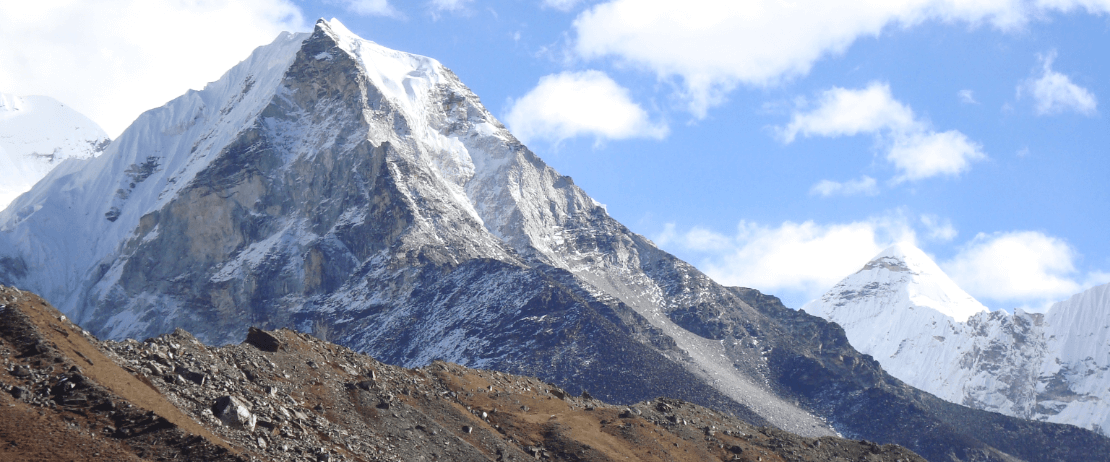
Island peak at an elevation of 6189m is actually an extension of Lhotse Shar located between the Lhotse and Imja glaciers, so the Island peak is also called as Imja-tse in local language. From the top of the peak you can get the view of south face of Lhotse and the wonderful view of Amadablam Peak.
Island peak climbing starts with a flight to Lukla from Kathmandu. From Lukla, we accompany the Dudh Koshi river valley and reach the Sherpa town of Namche Bazzar. Namche Bazar is also a point for acclimatization. Then the trek will move towards Tyangobche Village, Tyangobche offers one of the finest scenery of Everest as well as many other peaks like Cho Oyu and many different mountains and ancient Tyangobche monastery.
Upon reaching Dingboche, we begin the arrangement for our Island peak climbing expedition. Even though the peak can be ascended in one day, it is recommended to spend one nights at the base camp for adjustment and finally attempt the Island summit from the Base Camp. You need to acquire peak climbing permit from Nepal mountaineering association (NMA) and an experienced Sherpa climbing guide who has license from the government. Full insurance for the climbing Sherpa guide is compulsory to issue the permit as well as his license number.
e. Lobuche Peak Climbing
The Lobuche Peak (6,145m) located close to the Khumbu Glacier has two main peaks, i.e. Lobuche Far East and Lobuche East. The difference between these two peaks is that the Lobuche East is 26 meters higher than Lobuche Far East. The Lobuche peak climbing is bit challenging than the Island Peak Climbing. Located conveniently next to the path to Everest Base Camp, Lobuche east is attempted by trekking groups who come to see the spectacular view of Mt. Everest and the Khumbu valley from its summit.
The Lobuche east peak was first conquered by Laurence Nielson and Ang Gyaljen Sherpa on 25th April 1984. There are different tracks for climbing Lobuche Peak. The ordinary track for climbing is through south edge. Lobuche east peak comprises of some small summits and the main summit requires climbing steep snow and ice slopes to the top from the summit ridge. From the Lobuche Base Camp, you can view the astonishing scenery of mountains like Amadablam, Cholaste, Thamserku, Kantega peak and Tawache peak.
The peak of Lobuche East is reached by descending a marked notch and climbing steep snowy slopes to the top. On most occasions, the mountain is climbed on the summit ridge only as far as a subsidiary snow summit, south-east of the true peak and before the notch. This peak is identified as the false peak. On the approach Lobuche peak climbing, we will take the traditional Everest Trail, leaving from Lukla and heading up the impressive Khumbu Valley. Along the trail we will spend 3 nights acclimatizing in Namche Baazar, the Sherpa capital of the Region. We will also visit impressive monasteries and view remarkable scenery as we pass numerous seven and eight thousand meter peaks on the trail.
Lobuche Peak is an excellent introduction to Himalayan high altitude mountaineering, but you need to come prepared for this climbing challenge. Lobuche peak requires mountaineering skills. You need to be comfortable in crampons, using ropes and abseiling using a figure of 8 and moving between fixed lines. This is really important for your and team safety on the mountain.
f. Machermo Peak Climbing
Machermo Peak lies at an altitude of 6273 meters above the sea level and in the Khumbu region. The Machermo Peak Climbing is one of the interesting trekking peaks in the Mahalangur region with very unique trail, even being a non-technical one. Anyone with the past experience of climbing can easily conquer this peak.
The trail to the Machermo base camp is the same until we reach Namche Bazaar. After acclimatizing at Namche bazar, the trek will move towards south to reach Thame. And onwards to Machermo base camp whereas the trail to the Everest base camp heads east from Namche. On the trail, you’ll walk along Yak pastures, Gokyo Lake, Lungden and cross the Renjo La Pass to reach the base of Machermo. After some acclimatization and preparation, we head toward the high camp. We continue our trek from the High Camp and the next day, towards the summit. The base camp is set up above the rocky meadows and moraine around 5140 meters. The further climb ascends on the rock and snow slopes to reach the top. The summit offers an excellent view of Amadablam, Lhotse Shar, Nuptse, Lhotse, and Everest.

The Machermo Peak Climbing offers you with magnificent views of Himalayas like Everest, Lhotse, Nuptse, Makalu, Ama Dablam, Thamserku, Cho Oyu, Kangtega, Kusum Kangaru, Tawache, Cholatse & Island. Trekking to the region is an amazing chance to experience the remoteness of this region and the romantic mountain views, diverse flora and fauna and rich local cultures. Trekkers can explore the majestic mountain views and beautiful waterfalls, Tso Rolpa Lake, monasteries and landscapes, as the trekking route leads through the remote and beautiful picturesque Sherpa, Tamang and Chhetri village and through the dense, gloomy primeval forest and over broad bridge with wonderful views. Along with this, you also get to observe the lifestyle of the Sherpa people, who have been residing here for a long time. The Sherpas have their own unique language, culture, tradition, dress, food, and even the tea they drink.
g. Mera Peak Climbing
Situated on the edge of famous Khumbu Region, Mera Peak (6,461m/ 21,190 ft) is the highest trekking peak in Nepal which is an exciting trekking peak and scenically beautiful peak of the Khumbu valley. It is an adventure peak with technical difficulties which has stunning views of the world’s 8000 meter Mountains- Everest, Kanchenjunga, Makalu, Lhotse, Cho-Oyu.
The usual route to Mera Peak is directly via the Zatra La Pass, but we follow the route that heads south from Lukla and up the beautiful Hinku Valley and later return via Zatra La pass. Following this route has a few advantages. We not only pass through the beautiful Nepalese wilderness but also through quaint villages which will give us a glimpse into the rich culture of the locals. Additionally, since the route is longer, it’s better for acclimatization.

Mera Peak climbing is an excellent option for anyone with low to moderate mountaineering experience. It is a challenging trekking peak due to its elevation, but the technical mountaineering skills requirement is very basic. Sherpa guides at Great Nepal Treks will provide us with a basic mountaineering training before the actual summit. The journey up to Mera Peak Climbing is such a rewarding trek, frozen lakes, hanging glaciers, very few people ever see and views you will never forget. We have three or four nights sleeping above 4,900m/ 16,076ft before moving to base camp 5,350m/ 17,552 feet onto Mera Peak high camp at 5,800m/ 19,028ft and hopefully to the summit at 6,476m/ 21,246ft. Goal of Great Nepal Treks is to get you safely to the summit and back down to khare in one day. With our acclimatization schedule you have the best chance at making the summit of Mera peak as we have additional days built in for summit attempts.

Mera Peak Climbing will provide you with many rare glances of watershed area, the wild and heavily wooded valleys Hinku and Hongu Drangkas from this heavenly space. In this route to the Mera (Peak), you can experience the rarest of the rare chances of venturing through little visited and as yet un-spoilt region of Nepal where the hillsides still remain densely forested for everyone’s pleasure.
h. Pachermo Peak Climbing
The Pachermo peak lies in the Khumbu/Everest region, south to high pass Tesi Lapcha of Khumbu. It is one of the beautiful mountains in Nepal and can be approached either from the busy trekking trail of the Khumbu region or the beaten off the path of the Rolwaling region. From the top of the summit we will get a splendid view on the surrounding mountains. The peak climbing of Pachermo starts with a flight to Lukla followed by trekking toward the Thame village via Namche Bazaar. During Pachermo Peak Climbing we walk past the glaciers throughout the day and explore the beauty of the surrounding. Pachermo Peak has become an adventure climb for trekkers crossing the high Tasi Lapcha (5,755m) to Namche Bazaar in the Everest region. Pachharmo peak lies south of the Tesi Lapcha.
From the high camp near the Tashilapcha cross wide, crevassed snow slopes to gain the ridge of Pachermo, rising from the broken glacier of the pass. The views from the summit are the stunning and extremely satisfying climax to the trip. From Pachermo Peak Climbing you will have impressive views of the lofty-mountains located in the Everest region, including Mt. Everest, the highest peak in the world and dozens of other peaks found in the area such as Mt. Lhotse, Mt. Nuptse, Mt. Amadablam, Mt. Pumori, Mt. Thamserku, Mt.Kantega are some among others. Lying close to the Tibetan border, Pacharmo is not a technical climbing, but on account of the altitude and the peak’s remoteness it’s certainly challenging. Standing tall at height of 6,187m is also one of the most climbed peak in Everest region as well as Nepal.
Pachermo peak is the very famous doing Rolwaling Tashilapcha La high pass 5755 meters Trekking with magnifications Mountains View of Gauri Shankar (7134m), Everest (8848 m), Makalu (8463m), Nuptse (7896m), Amadablam (6812m), Thamserku (6800m), Kusum Kanguru( 6369m), Island Peak (6189m) the other Himalayas stunning and extremely satisfying views from the summit peak, (Pachermo peak is in group B peak in NMA list). Climbing guides at Great Nepal Treks are familiar with Pachermo peak. Our cook and staff are good teams who lead every year’s Pachermo peak with different climbers.
i. Pikey Peak Climbing
Pikey Peak Trek is a newly discovered trekking route to the Everest region that takes you to beautiful areas in Everest inhabited by Sherpa settlements. This is one of the best hilltop destinations that give you panoramic views of the Mount Everest and other neighboring peaks of the region. Pikey Peak climbing is suitable for everyone who wants to explore the highest peak in the world, Mount Everest and the rugged landscapes of the Everest region. Pikey Peak climbing also offers you with some of the magnificent views of the Himalayan ranges such as Mount Dhaulagiri , Kanchanjunga, Lhotse , Makalu and many more.
Pikey Peak Trek is the best option for if you are looking for a short trek near the Everest region. This trek offers you with wonderful mountain views and scenic beauty but also the cultural exploration of the Sherpas living in the Everest region. Trekking to the Pikey Peak may not be very difficult for experienced trekkers it lies only at the height of 4067 meters.
Great Nepal Trek’s eight days itinerary for Pikey Peak Trek is designed for both experienced as well as beginner trekkers. Pikey Peak Trek is basically a moderate level short trekking destination in the Everest region. So, if you want to explore the Everest region in a limited period of time, you can join us at Great Nepal Trek. Trekking to the Pikey Peak is favorable for every season but, the different season will offer you with different landscapes, environment, and experience. Considering this, you can choose the best time for your trek.
Great Nepal Treks is the leading tourism company when it comes to organizing activities like Trekking in Nepal, Mountain Expedition in Nepal, Heli Tour in Nepal, Mountain Flight in Nepal, Food Tour in Nepal, Cultural Dinner in Nepal, Yoga Retreat in Nepal, and so on. The company offers the best holiday packages featuring the above mentioned activities, customized as per the need of the tourist. We have an experience team that can plan and manage your Everest expeditions, Everest peak climbing packages, Everest Base Camp pass packages etc.

Trekking to Everest Base Camp is a dream for many climbers around the world. So, you need to plan it very carefully. Having right instructions and experienced guide is very necessary for success of your Everest expedition. Forget the stress of planning such a big expedition by contacting Great Nepal Treks. All you need to do is focus on your physical fitness while we take care of your transport, accommodation, meal breaks, and other logistics. The safety of the trekkers is always in our priority list. There are dedicated the team leaders who are given every authority to make changes in the itinerary provided, in case of unexpected weather change, unsuitable health condition of a group member or an unforeseen natural disaster. If needed, team leader might also change any part of the itinerary as per the situation.
At Great Nepal Treks and Expeditions we have put together customized itineraries from simple day tours to complex mountain treks. We pride ourselves in being experts at taking the hassle out of travelling in the remote outback of Nepal. Our offerings can be enjoyed as planned or we can customize any option to fit your time schedule, budget, and particular interest. Please visit our reviews page to see what travelers have had to say about their experience with us. While you may be a first-time visitor to Nepal, our well-balanced cultural immersion process will turn you into a member of our family forever. Most agree that visiting Nepal only once is not enough. You’ll find yourself planning your next adventure with us before leaving.
Here are all of our different packages for the Everest Region:
Mt. Everest Flight – 1 Hour Everest Base Camp, Chola Pass And Gokyo Lake Trek – 18 Days Classic Everet Base Camp Trek – 18 Days Nepal Luxury Wedding Package – 7 Days Lobuche East Peak Climbing – 16 Days Mera Peak Climbing – 17 Days Everest Base Camp Trek – 13 Days Everest Panorama Trek – 11 Days Everest Three Pass Trek-20 Days Everest Heli Tour – 6 Days Mani Rimdu Festival – 13 Days Heli Tour To Everest Base Camp | Kala Patthar – 1 Day Everest Expedition – 64 Days Ama Dablam Expedition – 30 Days Luxury Everest Base Camp Trek – 14 Days Island Peak Climbing – 21 Days
Great Nepal Treks
Leave a reply cancel reply.
Save my name, email, and website in this browser for the next time I comment.
Privacy Overview
Best Time to Visit
Weather & Climate
Kathmandu Airport Guide
Top Destinations in Nepal
One Week in Nepal
Tipping Guide
Getting Around
Top Things to Do in Nepal
Complete Guide to Kathmandu
Top Things to Do in Kathmandu
Top Things to Do in Pokhara
Sacred Sites
Amazing Festivals
Top National Parks
Must-Try Food
Annapurna Circuit
Manaslu Circuit
Himalaya Trail
Facts About Mt. Everest
Trek to Everest Base Camp
Everything You Need to Know About Trekking to Everest Base Camp
:max_bytes(150000):strip_icc():format(webp)/greg-rodgers-adventure-ed92646b25f247049e53af6d36f6c15f.jpg)
Jason Maehl / Getty Images
Everest Camp II
Trekking to Everest Base Camp in Nepal's Sagarmatha National Park is the adventure of a lifetime. Although actually climbing Mount Everest is out of reach for many of us, anyone with enough grit and good enough fitness can reach EBC and the Khumbu Icefall, the starting point for climbing Mount Everest. (You’ll need an $11,000 permit and some serious equipment to go any higher from there!)
The Himalayan scenery here is unrivaled on earth. Snowy sentinels will witness your struggle toward the top of the world , while stupas, prayer flags, and Sanskrit tablets will remind you of the spiritual significance of the area. Sadly, the numerous memorials to hikers who perished along the trail underscore the seriousness of your undertaking.
You’ll battle freezing cold, thin air, weather changes, and your own body as you ascend. Once at Everest Base Camp, you won’t even get to see the famous mountain itself unless you take a day to climb Kala Patthar (18,519 feet), an adjacent prominence that affords views of the “Holy Mother” when weather permits.
Read on for our complete guide to the Everest Base Camp trek, with information on what to pack, when to go, EBC tours, and more. Note that we’ll only cover getting to South Base Camp in Nepal, not North Base Camp in Tibet .
What to Expect
Trekking to Everest Base Camp involves hiking between lodges (or “teahouses”) found in villages along the trail. Some days may only consist of four hours or so of uphill trekking, depending on how much elevation is gained that day. Sometimes, you’ll have the option of pushing on to another village higher up—but no matter what, you will never gain more than 1,312 feet (500 meters) in a day.
Once above the tree line, the common rooms in your lodges will invariably be heated by yak dung-burning stoves. Weary hikers will hang around these stoves, warming themselves and socializing before retiring early to their unheated rooms. The shared toilets are sometimes located in snowy outhouses.
The village of Namche Bazaar (11,290 feet) is considered the last fully “civilized” stop on the trek to Everest Base Camp. Here, trekkers can enjoy treats from a German bakery while watching screened documentaries. You’ll find last-minute gear and souvenirs for sale along with the last ATM on the trail. You can even indulge at the “highest Irish pub in the world” on your way down after a successful trek!
When's the Best Time to Trek to Everest Base Camp?
The best time for trekking to Everest Base Camp is in either spring (March to May) or fall (September to November). If you want to see the camp in full form with climbers, support teams, and film crews, you’ll need to time your trip with spring climbing season, usually late April or early May. This is also the busiest time to be in Nepal .
For less traffic on the trails, consider making your trek to Everest Base Camp in September or October. Unfortunately, this means hiking in cooler weather with even less daylight than usual.
Avoid making the trek during monsoon season in summer. Humidity reduces beautiful views at lower elevations, and snowfall closes trails at higher elevation.
Adisorn Fineday Chutikunakorn / Getty Images
Should I Book a Tour or Go Independently?
There are three options for completing a trek to Everest Base Camp:
- Book a group tour and have all arrangements made for you.
- Make the trek to Everest Base Camp independently .
- Arrive in Nepal, then hire a guide and/or porter yourself.
No matter which option you choose, try to spend an additional day at Namche Bazaar. The extra time at 11,290 feet reduces some of the effects of elevation later; you’ll enjoy a better overall trekking experience and suffer less. The extra day isn’t “wasted”—many day hikes around Namche Bazaar provide beautiful views while giving your body time to adjust. Your chances of successfully reaching Base Camp vastly improve if you spend more time at Namche Bazaar.
Everest Base Camp Tours
Although the most expensive option by far, having everything organized before you arrive provides peace of mind. You’ll be taken care of all along the way, with access to better safety measures such as supplemental oxygen. Bigger companies use yaks to take your gear ahead; you’ll find it waiting for you in your teahouse room at the end of each hiking day.
You can book an Everest Base Camp tour online from home, or if time permits, do so after arriving in Kathmandu . Booking on the ground through a Nepalese agency saves money and better helps the local economy. You’ll find trekking agencies on every corner in Thamel, but unfortunately, not all are reliable. Choose a reputable agency that’s a member of the Trekking Agencies’ Association of Nepal . You can see in the member directory how long an agency has been in operation, and hopefully, make a better informed decision.
Independent Trekking
First, independently trekking to Everest Base Camp doesn’t necessarily mean solo trekking. Trekking alone in the Himalayas is dangerous no matter your experience level. A simple slip or unexpected weather change could keep you from reaching the next teahouse before temperatures plummet at night.
Independent trekkers can save a lot of money by foregoing organized tours and simply teaming up with other trekkers they meet along the way. (Everyone you meet in the lodges is going in one of two directions: up or down!) The well-marked trail to Everest Base Camp is busy during peak trekking seasons, giving you the best chance of meeting new friends who match your speed and fitness level.
Going independently does carry some risk, of course. You’ll be responsible for your own well-being and making important decisions. On the other hand, you’ll be able to set your own pace and make adjustments based on how well your body acclimatizes. A majority of hiker deaths on the trail each year occur when people in group excursions are suffering from Acute Mountain Sickness (AMS) but don’t speak up. They fear slowing everyone down, or don’t want to forfeit reaching Everest Base Camp.
If guiding yourself, pick up a good trail map in Kathmandu. Don’t rely solely on electronic devices for making survival decisions! You’ll also need to store your luggage at a trustworthy guesthouse or hotel in Kathmandu. Locking duffel bags and padlocks can be purchased in local shops; some owners will buy them back once you return from your trek.
Hiking Guides and Porters
Rest assured: Your pack is going to feel heavier at 15,000 feet than it does at home! Even as an independent trekker, hiring a local guide and/or porter are options. Hiring directly ensures money goes to the Sherpas instead of a Western tour agency that managed to rank well online. Expect to pay between $15 to $20 a day for a porter or $25 to $30 a day for a guide.
You’ll need to negotiate terms and contingencies before hitting the trail. Paying up to half of the porter’s fee up front is common, and you will also be expected to tip guides and porters after the trip. Finalize details and other expenses to avoid a potential disagreement. The agreed daily rate should include their meals, drinks, and accommodation so you aren’t asked for money later.
Guides will approach you on the street in Thamel, however, you should hire only a credible and licensed guide through either a trekking company or your accommodation. You may still be able to hire a porter later on the trail by speaking to the staff at your lodge.
How Much Does It Cost to Trek to Everest Base Camp?
The cost of trekking to Everest Base Camp depends entirely upon your needed level of comfort. One indelible rule holds on the trail: Prices rise as elevation rises. That 50-cent candy bar from Kathmandu is worth $7 at 17,000 feet!
Extremely basic accommodation in teahouses can be found for as low as $5 per night. You’ll be expected to have your meals where you stay. A hearty Nepalese meal of dal bhat can be enjoyed for $6 or less, but expect to pay much more for Western food. A can of Coke can cost up to $5; remember, it’s heavy and had to be carried up by a porter.
Other luxuries add to the cost of life on the trail. A (somewhat) warm shower can cost $5. Charging electronic devices and accessing the internet, if available, cost several dollars an hour, and the solar charging systems are often slow and provide only a weak charge. Depending on your food and drink indulgences, plan to spend $20 to $30 a day living on the trail. This excludes any fees you pay to porters and guides.
If not already covered, your greatest expense will be the short flight to and from Lukla. The 30-minute flight can cost around $180 each way.
Do You Need a Permit for Everest Base Camp?
You’ll need at least two permits for trekking to Everest Base Camp. Your tour organizer will probably provide these, but you’ll need to arrange them yourself if trekking independently.
- Sagarmatha National Park Permit: Get this at the Nepal Tourism Board office in Kathmandu (approximately $25).
- Khumbu Pasang Lhamu Rural Municipality Permit: You will get this permit from a checkpoint in Lukla; it isn’t available in Kathmandu (approximately $17).
- Gaurishankar Conservation Area Permit: You only need this permit from the Tourism Board if doing the longer trek to Everest Base Camp from Jiri instead of flying to Lukla (approximately $17).
The permit system changed in 2018. Disregard any information you read elsewhere about needing a TIMS card for the trek to Everest Base Camp.
Greg Rodgers
What to Pack
Kathmandu, particularly in Thamel, has more than enough outfitting shops for gearing up. Unfortunately, those same shops are stacked with counterfeit gear that probably won’t survive the hardships of the trek. Sifting through the piles of used gear in dark shops requires patience. Prices are inflated, so put your game face on and start haggling !
If you booked a guided tour, find out what your tour company plans to provide (e.g., hiking poles, down jackets, etc) before shopping. Consider bringing mission-critical items from home so that equipment failure doesn’t affect your experience. For instance, you’ll need quality sunglasses to prevent eye injury. Sunglasses for sale locally may have “UV Protection” stickers on them but don’t offer much actual protection.
- Good hiking boots. You should invest in high-quality, waterproof hiking boots and break them in properly before you leave home; painful blisters can ruin an otherwise-excellent trek.
- Lightweight sleeping bag. Rooms along the trek are unheated. Lodges provide weighty blankets for the freezing nights, but you'll appreciate having a layer between you and the unwashed bedding. Even a lightweight silk “sleep sheet” will do the trick.
- Alternate footwear. After removing your muddy hiking boots, a pair of lightweight shoes or sandals comes in handy for wearing around lodges and shared bathrooms.
- Water purification: As elevation increases, so does the cost of bottled water and need to reduce plastic waste. You’ll be drinking more than ever to counter dehydration in the dry air. Although there are many options, the two-bottle, chlorine dioxide system from Aquamira is a reliable solution.
- Trail snacks: Candy bars and nuts provide a much-needed boost to energy and morale while on the trail or in the lodge.
- USB power bank: Keeping batteries charged in the extreme cold is a challenge. If you plan to use a phone for photos or communication, you’ll want to bring along a rugged power bank.
- Diamox tablets: Diamox (acetazolamide) is medication for countering the dangerous effects of AMS. Guides should have some on hand, but independent trekkers will want to buy Diamox to carry. Beware of fake tablets for sale in Kathmandu. Purchase only from legitimate pharmacies—not from shops—and discuss how to use them.
If you won’t be taking your poles and other gear home after the trek, consider giving it directly to the Sherpas you meet in Lukla.
John Elk III / Getty Images
How to Get There
Fly into Kathmandu's Tribhuvan International Airport (KTM) and plan to spend a few days resting and preparing for the trek. Unless you’ll be starting the trek in Jiri—which requires a seven-hour bus ride and an additional five to seven days of trekking—you’ll need to book a flight to Lukla.
Taking the small prop plane from Kathmandu to Lukla (LUA) is one of the scariest and most scenic aviation experiences many travelers will have. Although not the highest airport in the world , weather and visibility changes have caused enough crashes at Tenzig-Hillary Airport in Lukla to earn it the title of “most dangerous airport in the world.”
The trek to Everest Base Camp begins in Lukla and finishes at the infamous Khumbu Icefall!
How Dangerous Is Everest Base Camp?
Although frostbite and rock slides are hazards along the trail, the biggest danger—by far—comes from the high elevation. Once symptoms of AMS begin (severe headache and nausea), you need to descend as soon as possible. Ideally, you’ll ascend slowly enough to minimize altitude sickness in the first place.
The CDC recommends never gaining more than 500 meters in one day and taking a rest day for every 1,000 meters gained. Whenever possible, you should descend to sleep at a lower elevation than the highest point reached during the day. Track and do the elevation math as though your life depends on it.
The high elevation and thinner air introduces additional risks. For one, your body will increase its production of red blood cells, causing excessive urination; be sure to drink plenty of water to avoid dehydration. Many trekkers will also experience the dry, hacking "Khumbu cough" from panting heavily in the thin air and breathing in the dust of the region. You can cover your face with a bandanna or balaclava for some protection. The cough usually goes away after time. Ultraviolet rays, too, are more damaging in the thinner air, so protect your skin, lips, and eyes by applying high SPF sunscreen and lip balm, wearing long sleeves, and donning sunglasses.
Finally, yak trains always get the right of way! Never share a bridge crossing with one, and always pass them on the “inside” of the trail. Startled yaks are unpredictable and sometimes knock trekkers off the trail.
Additional Tips
- Take your stocking up on snacks seriously. Pack candy bars, even if you wouldn’t ordinarily indulge at home. You’ll experience strong cravings at higher elevation. Hikers are willing to spend $7 or more for Snickers bars near Everest Base Camp!
- The weather in the Himalayas changes quickly and unpredictably. Flights to and from Lukla frequently become delayed by a day or two, maybe longer if a winter storm system sets in. Add some buffer days to your Kathmandu itinerary just in case this happens.
- Before retiring to bed, ask your teahouse staff to pour boiling water into your bottles and use them as bed warmers. Fair warning: They’ll probably be frozen next to you in the morning!
- Sleep with your phone and any batteries in the bed with you. Your body heat will protect battery life a little.
- Weight limitations imposed by airlines that fly to Lukla are strictly enforced. If an airline says 33 pounds (15 kilograms), that includes all baggage , stowed or carried. Don’t risk having to forfeit gear in Kathmandu Airport because you’re a pound or two over the allowance. You can stuff some items into your pockets, within reason.
How to Go Teahouse Trekking in Nepal
The Best 12 Hikes in Nepal
Solo Trekking in Nepal's Everest National Park
How to Choose and Prepare for a Hiking Trip
Independent Trekking in Nepal
The World's Highest Places and Attractions That You Can Visit
Five Amazing Hiking Routes Among the High Mountains of the Himalayas
The Most Beautiful National Parks in Nepal
A Guide to Tipping in Nepal
The Complete Guide to Climbing Morocco's Mount Toubkal
Nepal's Great Himalaya Trail: The Complete Guide
How to Trek Nepal's Manaslu Circuit
The Different Types of Adventure Travel
The Top 15 Destinations in Nepal
Where Is Mount Everest?
How to trek to Everest Base Camp

Jun 20, 2023 • 10 min read
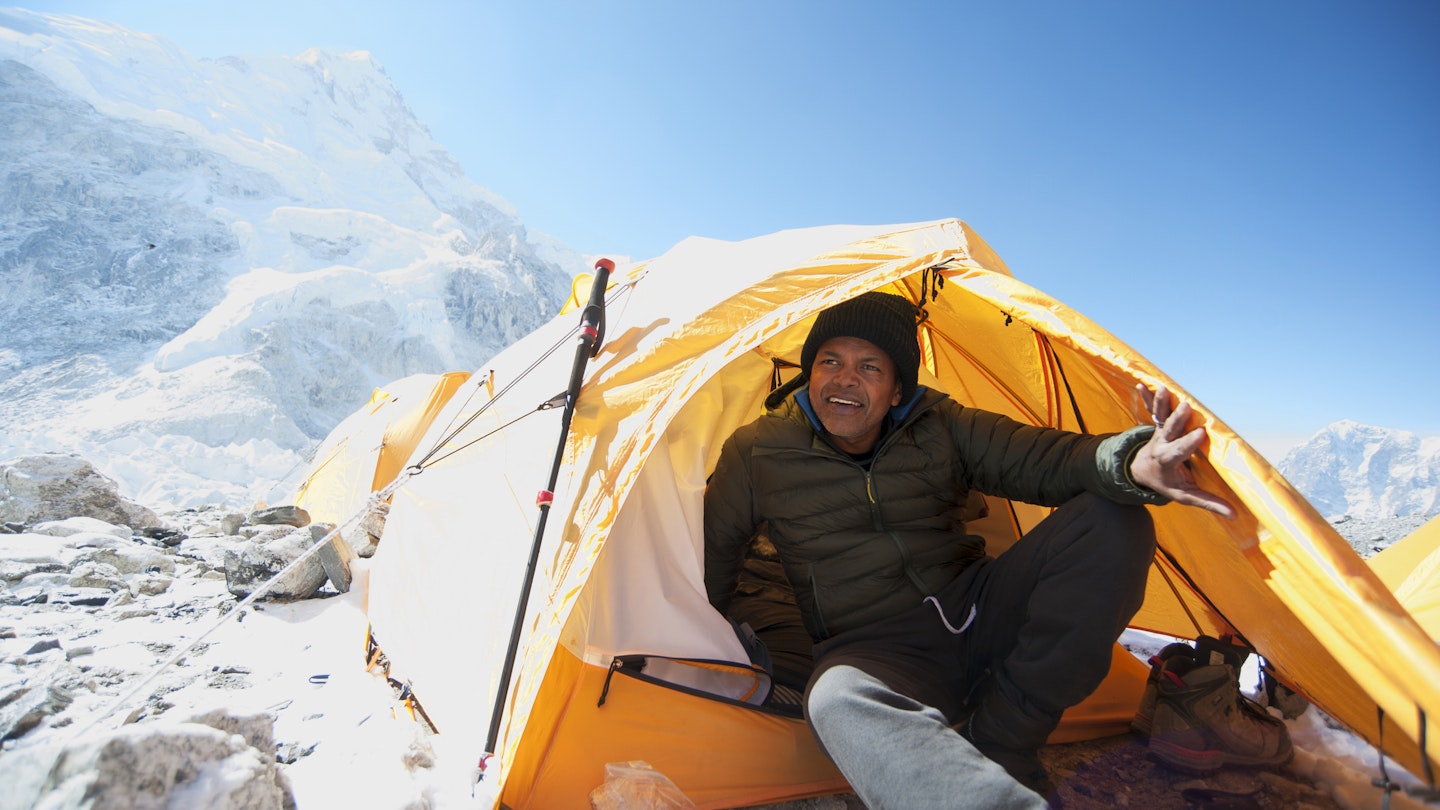
From permits to teahouses, here's everything you need to know about trekking to Everest Base Camp © Mint Images / Getty Images
Top of many people's travel bucket lists, the trek to Everest Base Camp is often the first thing people think about when they start dreaming of a trip to Nepal .
The walk takes trekkers past Sherpa villages and Tibetan-style monasteries, right up into the heart of the high Himalaya, into a breathtaking world (literally) of iconic glaciers, lakes and the tallest peaks on earth. It's probably the world's most famous trek.
But what is it actually like to trek to Base Camp? Is it something within your capabilities or budget? What should you bring? And, most importantly, can you get a proper coffee en route?
I just returned from trekking to Everest Base Camp for Lonely Planet's Nepal guide . Here’s what I think you need to know.
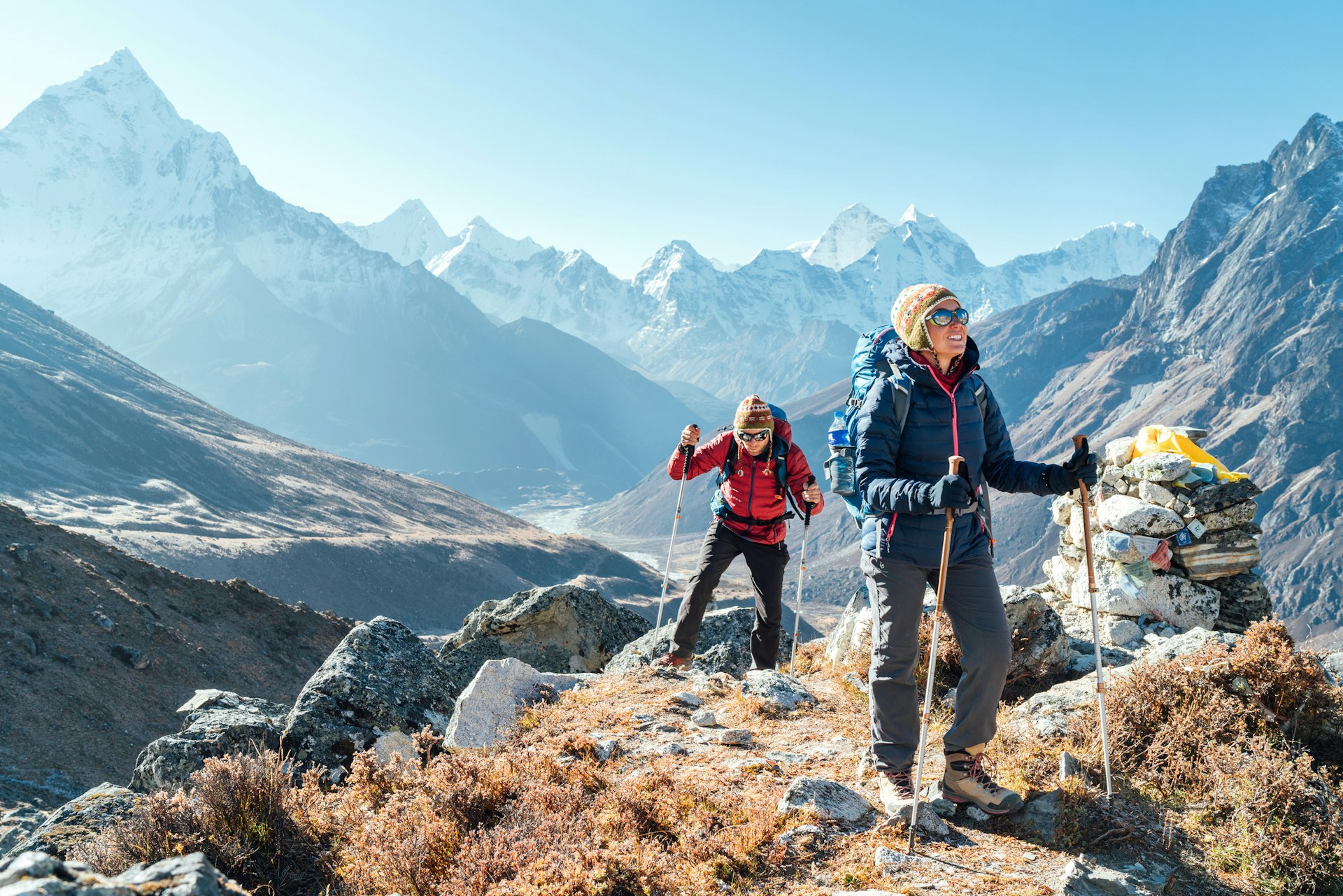
What's so great about the Everest Base Camp (EBC) trek anyway?
Firstly, the mountain scenery surrounding the world's highest peak is truly spectacular. The sublime views of Ama Dablam, Pumori, Nuptse and Thamserku peaks are unbeatable and constantly change as you progress along the walk. The Sherpa villages and monasteries are fascinating places to visit and the lodges (called teahouses) are the best in the world.
The knowledge that you are walking in the expedition footsteps of Hillary, Tenzing, Messner and others is a thrill. Anyone who has read Into Thin Air will be moved by the memorial stupas of Rob Hall, Scott Fischer and others who have lost their lives on the mountain. And then there's the fact that you will have reached the base of the world's highest peak; whether you call it Chomolongma (Tibetan), Sagarmatha (Nepali) or Everest, it’s a rush all the same.
And what’s not so great about the Everest Base Camp trek?
Well, if you force us to play devil's advocate… EBC is one of the busiest trails in Nepal. In the high season months of October and November you'll be walking with thousands of other trekkers, competing with them to get a bed, a lunch order or an airplane seat. There will be lines at checkpoints and even at moments on the trail itself. In bad weather you might be stranded at Lukla airport with hundreds of other trekkers, all trying to get on the first flight out. It's not quite the Zen-like wilderness experience you may have been imagining.
Bear in mind also that even after a solid week of walking, your view of Everest will be partial at best (for infinitely more dramatic Everest views visit the northern Everest Base Camp in Tibet ). If you trek outside of May's expedition weather window you won’t actually find much to see at Base Camp beyond a boulder hastily spray-painted with "Everest Base Camp".
If this has put you off, don’t worry; there are dozens of other fantastic treks in Nepal .
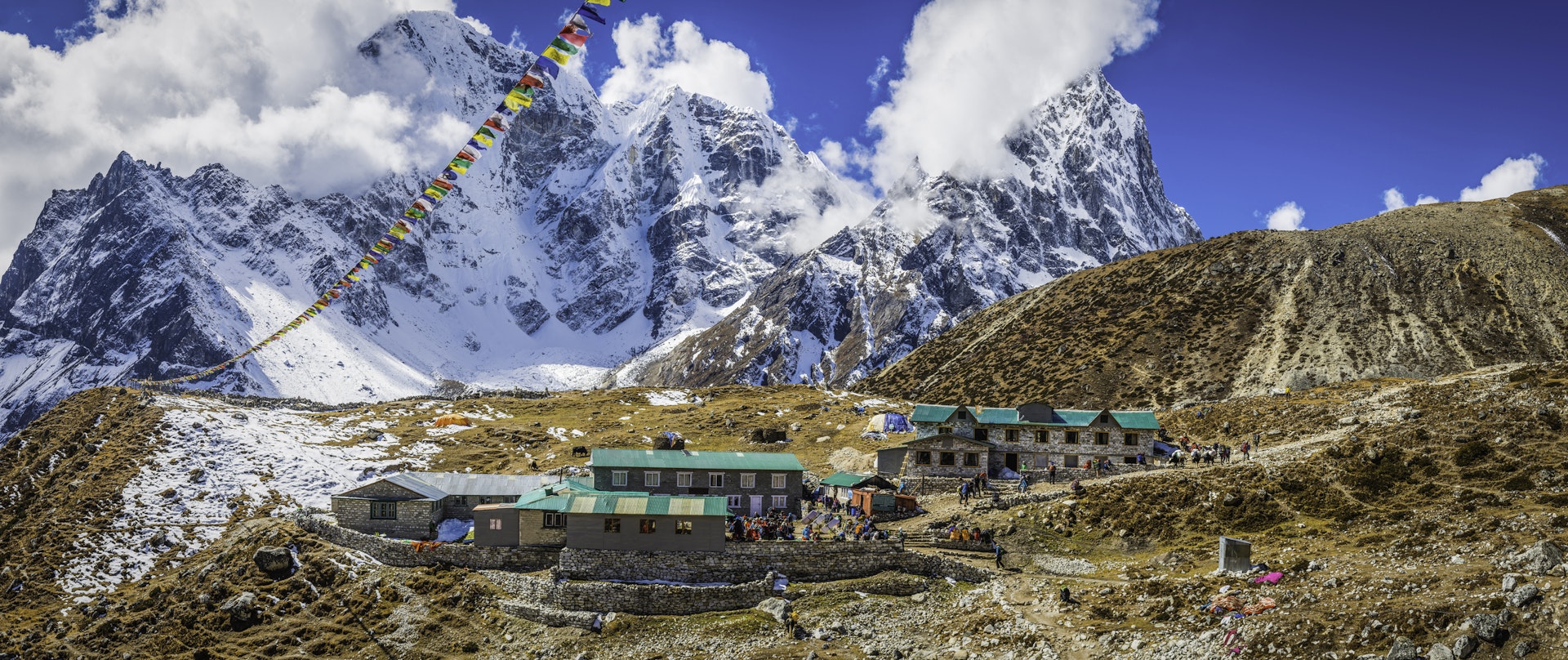
How long does it take to trek to Everest Base Camp?
The walk from the airport at Lukla to Everest Base Camp and back takes a minimum of 15 days. Several of the days are surprisingly short, but this is because you have to figure in time to acclimatize to the high altitudes.
If you can, it's definitely worth adding on a couple of extra days to this basic itinerary. Some of the most dramatic (and least visited) views are from detours off the main trail. I always add two days to visit Thame, two days to visit Chhukung and, if possible, three or four days to visit the lakes of the Gokyo Valley – probably the most beautiful scenery in the Everest region.
Be sure to also budget an extra day or two as a transport buffer. Weather-related flight delays in and out of Lukla are not uncommon (I had to wait six days for a flight to Lukla on my recent trip) so you need some buffer time if heading back for an international flight home.
How challenging is the trek to EBC?
In terms of physical effort, the EBC trek itself is not especially tough. There are only a couple of steep climbs, lasting about an hour each, and most days involve less than four hours of walking.
The thing that makes the EBC trek tough is the altitude. Base Camp is at 5600m (18,373ft) and you will need to spend one or two nights above 5000m (16,404ft). Above 4000m (13,123ft) you are going to feel increasingly lethargic and out of breath as the amount of oxygen in the air decreases. Combine this with the cold, the discomfort of being at altitude and the compounded tiredness from walking for two weeks straight, and you can see why the whole trek experience is definitely a physical challenge.
While you don't need to be an athlete to walk to EBC it is still a good idea to start a fitness regime in the weeks leading up to your trek. You'll enjoy the walk so much more if you are in decent shape.
When is the best time to trek to Everest Base Camp?
October and November bring the best weather and the clearest skies but these are also the most popular months. The second most popular season is April to early May, when spring blooms and expedition traffic bring extra interest to the trail. To avoid the crowds but still enjoy clear views, pack an extra thermal layer and come in December or March.
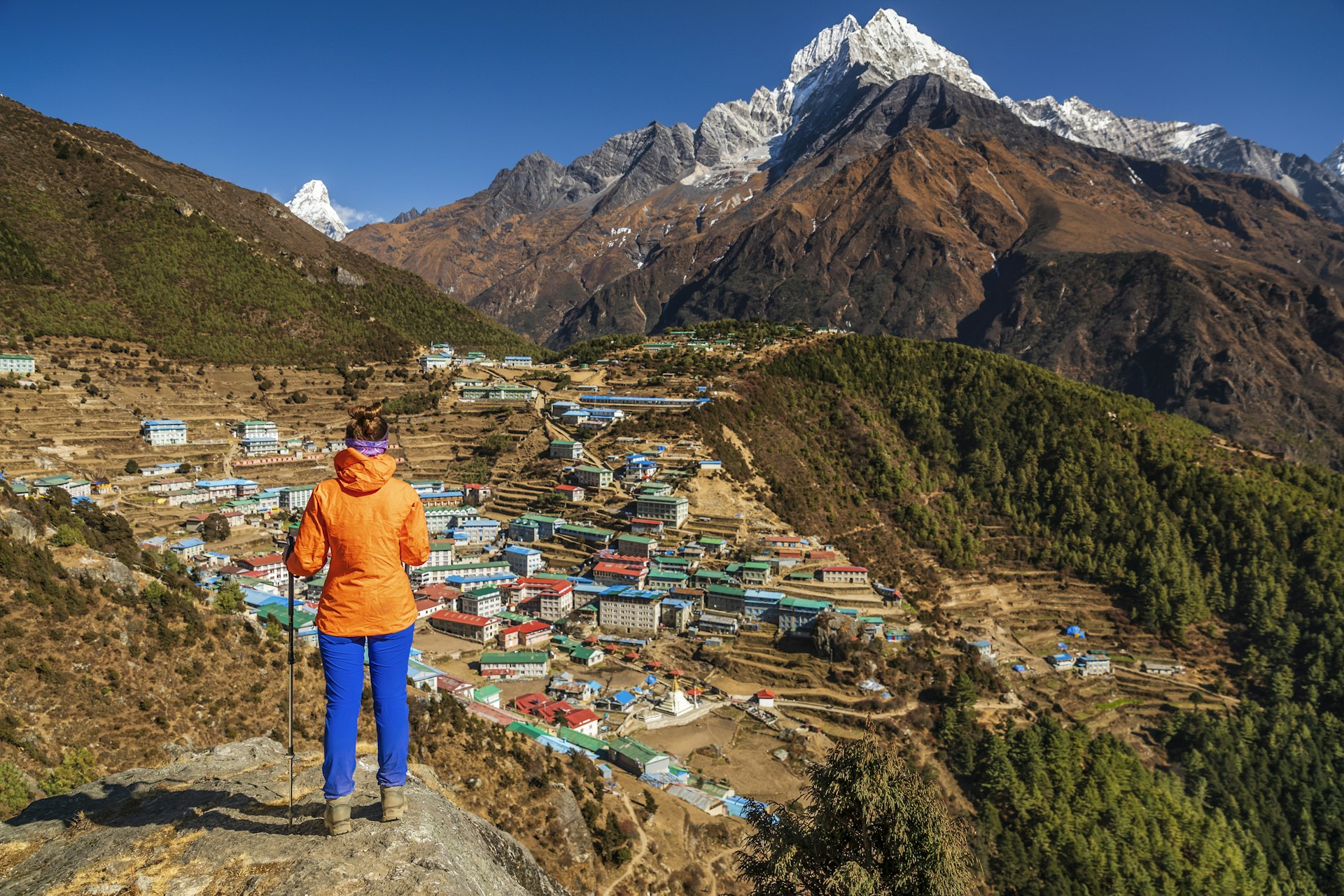
What can I do to avoid altitude sickness?
The majority of people who fail to reach Base Camp do so because they failed to acclimatize properly to the altitude. It's essential not to gain altitude too quickly by following the recommended overnight stops and limiting your daily altitude gain to a maximum of 400m (1312ft) when above 3000m (9843ft).
Be sure to add in acclimatization days at both Namche Bazaar and Dingboche, during which it's a good idea to hike to higher altitudes during the day, returning to sleep lower at night.
What are the teahouses like?
At lower altitudes the Everest lodges are the most comfortable in Nepal. Private rooms are the norm, many of which have private bathrooms. Showers are available at most places, though the hot water supply can be patchy. All have cozy dining rooms with tables arranged around a central dung-fueled stove. There are even a few luxury lodges along the trail.
In budget lodges, or when you get above Dingboche, things get simpler, with rooms offering little more than a collection of plywood walls, a solar light and a foam mattress. Toilets are a mixture of seats and squatters; sometimes outdoors, always freezing. A blanket is normally supplied but be sure to bring a four-season sleeping bag rated to well below 0°C (32°F).
What's the food like?
Menus in teahouses range from pasta and pizza to spring rolls, fried potatoes and soups, though the most popular meal is a daal bhaat , a set Nepali meal of rice, lentil soup and fried vegetables, normally served with a papad and pickle, and with a refill included. It's the most filling and environmentally sustainable meal you can order.
In villages such as Namche Bazaar and Dingboche you will also find bakery-cafes serving espresso and slices of delicious apple pie, plus shops selling everything from Snickers bars to bottles of beer. This is one trek where you might actually gain weight!
Can I get wi-fi or phone coverage?
Most lodges offer wi-fi, either free of charge or for a few dollars per day (at higher elevations). Above Namche Bazaar you will likely have to buy a scratch card, giving you unlimited data for twelve hours (AirCell) or a specific amount of data over a month (Everestlink). Depending on your network provider you'll likely get data and a phone signal at lower elevations, and possibly even at Everest Base Camp, but not at other high altitudes. So yes, in theory, you can Skype all your friends from Base Camp!
What should I bring?
Warm clothes are a must, and you should pack thermal underwear, a down jacket and fleece hat. Comfortable hiking boots and good, padded socks are also essential. Sun block, a sun hat with a brim and good sunglasses are important against the strong high-altitude light.
Morale-boosting snacks like chocolate and salami are always helpful, as is a book and smartphone with mapping software like Maps.me. Bring water purification of some sort. If you forget something, don’t worry, you can buy almost anything you might want in Namche Bazaar these days (from ice axes to cans of Pringles), though at prices higher than in Kathmandu .
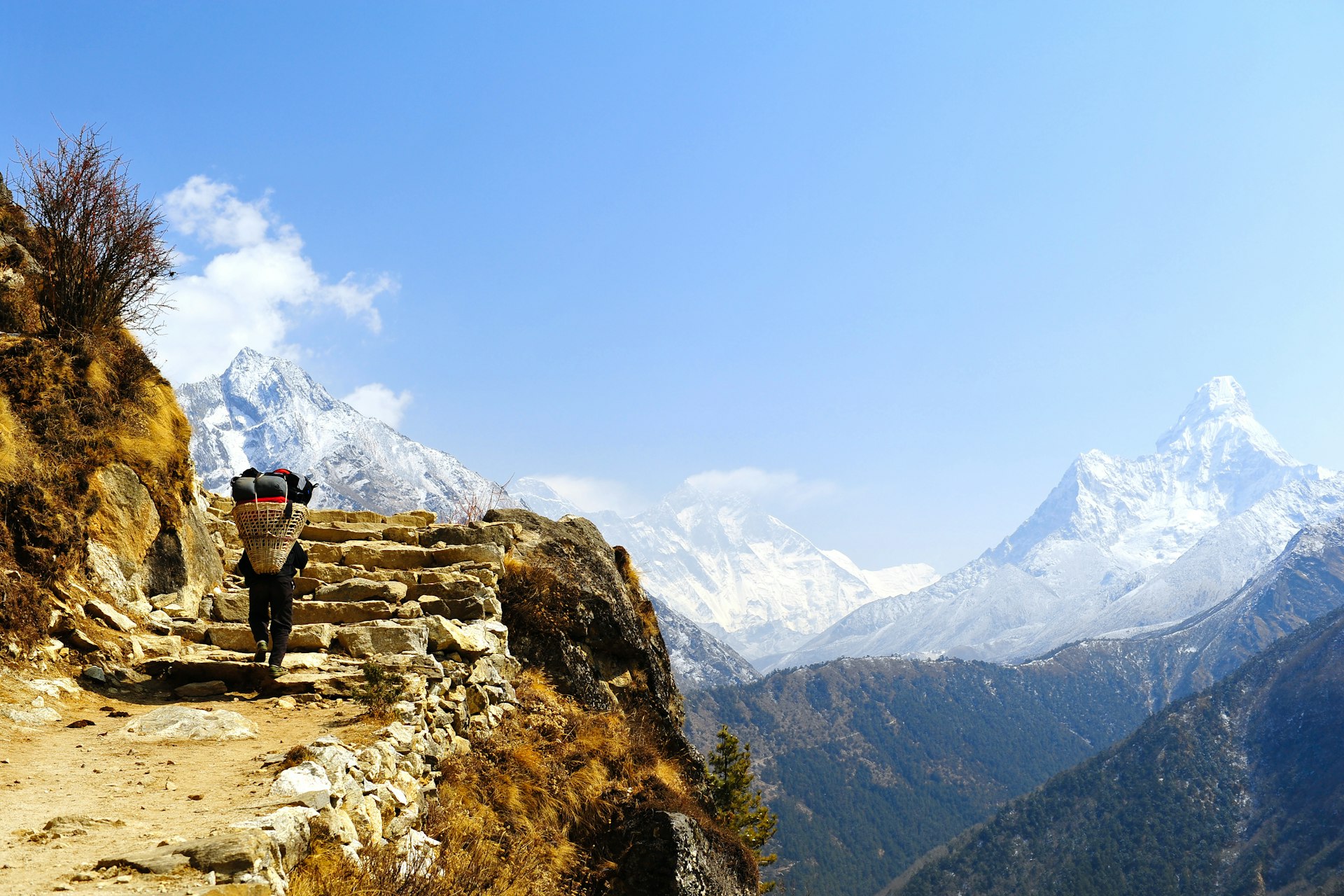
Do I need a porter and guide?
In terms of finding your way you don't need a guide if you are an experienced walker, as the route is clearly marked and well-trod. A guide can be useful for smoothing your way at teahouses, making sure you get your food on time and helping you pay your bill. It's important not to trek alone, so solo trekkers should find a companion or take a guide or porter.
A porter will carry a bag of around 15kg, freeing you up to pack a few extra chocolate bars and enjoy the walk with little more than a day pack. Not having the strain of carrying a full pack is worth its weight in gold for anyone over the age of 50. Trust me.
How much does the Everest Base Camp trek cost?
For a room in a lodge and three meals a day, figure on US$20–25 per person per day, a bit more if you want a room with a private bathroom and the occasional slice of apple pie. Add on another US$5 every time you want a shower. Figure on an additional US$20 per day for a porter, and US$25–30 for a guide, and budget 10–15% of that fee for an end-of-trip tip.
You'll pay a bit more to have a Kathmandu-based trekking company arrange your entire trek, and a lot more for the convenience and backup of an international trekking tour.
Do I need any permits?
You will need to buy an Everest region permit (US$20) at Lukla, as well as a Sagarmatha National Park entry ticket (US$30) at Monjo. Currently that's all you need.
How can I trek more sustainably?
With 60,000 trekkers and guides headed to the Everest region, it’s important to minimize your impact on the region. Firstly, don't buy bottled water on the trek, as the bottles are nonrecyclable and are a huge problem throughout the region. Bring a system of water purification, like a Lifestraw or Sawyer filter, a Steripen or chemical purification.
Secondly, carry all your trash out (especially batteries), and sign up for the Carry Me Back program, whereby you carry a 1kg bag of trash from Namche Bazaar to Lukla, for it to be recycled in Kathmandu.
Finally, be polite to the Sherpas and porters you meet en route, as well as your fellow trekkers. Walk clockwise around stupas and be respectful at monasteries and shrines.
How do I get to Lukla to start the trek?
Flights run multiple times daily between Kathmandu and Lukla, taking around 30 minutes. During high season however you may have to drive five hours from Kathmandu to Ramechhap airport to catch your Lukla flight there.
It's also possible to fly or drive to Phaplu and walk two days to Lukla from there, or walk from Shivalaya to Lukla in seven days as an excellent pre-trek warm-up.
This article was first published Jan 14, 2013 and updated Jun 20, 2023.
Explore related stories
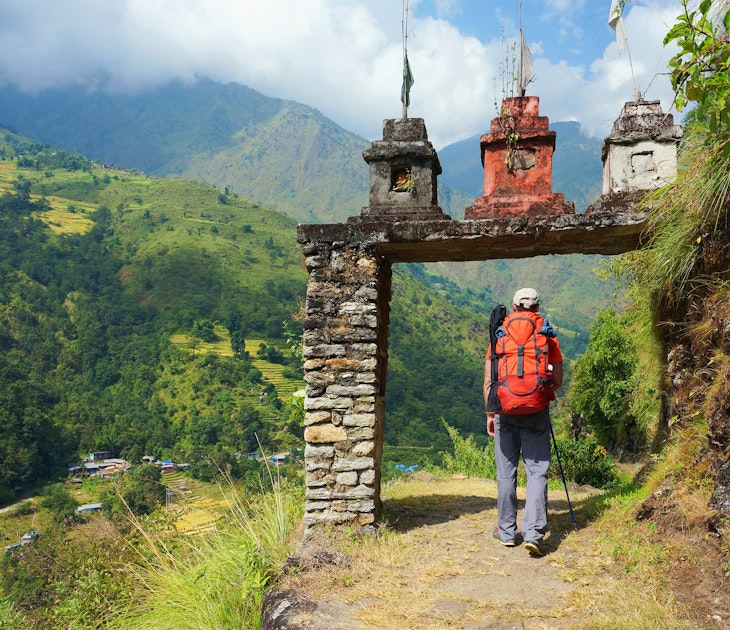
Mar 14, 2023 • 4 min read
To reduce accidents and promote jobs, Nepalese authorities recently announced a ban on solo trekking in national parks and conservation areas.

Jul 13, 2022 • 8 min read

Jan 31, 2022 • 6 min read
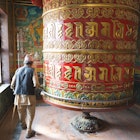
Jan 9, 2022 • 8 min read

Sep 14, 2021 • 11 min read

Jan 28, 2021 • 5 min read
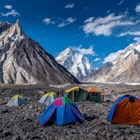
Jan 12, 2021 • 7 min read
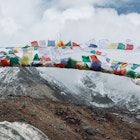
Dec 10, 2020 • 6 min read
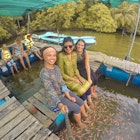
Jan 7, 2020 • 6 min read
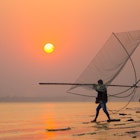
Oct 10, 2019 • 9 min read
- Manufacturing
- Service sector
- Expedition Program
- Peak Climbing Programs
- Seven Summits
- Trekking Programs
- Guaranteed Expedition
- Upcoming Expedition
7000 meter peaks
- Himlung Expedition
8000 meter peaks
- Nepal Expeditions
- Pakistan Expeditions
- Tibet Expeditions
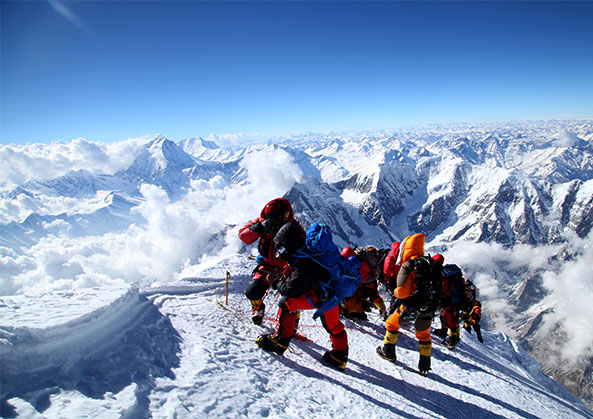
Everest Base Camp Trek
- Package Overview
- Route Map & Detail Itinerary
- Dates & Prices
- Key Information
- Reviews and Ratings
The Everest Base Camp Trek is an adventure and cultural experience. Hikers get to explore the Khumbu region of Nepal and interact with the local Sherpa people. Hike to Mount Everest Base Camp can be challenging, but it is a great introduction to high-altitude trekking and life in Nepal’s mountains. The trek takes you through breathtaking landscapes starting from Lukla, where trekkers journey through valleys, forests, and Sherpa villages before reaching the base camp. The trek usually takes 12 to 14 days, depending on the route and pace.
Mount Everest , known as the “Roof of the World,” is undeniably the biggest attraction to the area. The trek allows you to witness the magnificent, mighty peak, rising to 8,848 meters. The hike offers breathtaking views of Himalayan peaks, including Everest, and allows for cultural immersion, visiting monasteries, and interacting with local villagers.
Best Trek in Nepal for Beginners
The Everest Base Camp Trek is the best trekking experience in Nepal for beginners, creating memories that will last a lifetime. Proper preparation, respect for the environment, and responsible trekking practices are crucial to ensure the journey is safe and memorable. As the popularity of the Everest Base Camp Trek grows, sustainable tourism and responsible trekking practices are essential. Trekkers should respect the fragile ecosystem, minimize waste, and follow guidelines to preserve the area’s natural beauty.
Reach the Everest Base Camp in comfort and exclusivity.
We offer a luxury Everest Base Camp trek , where you can hop onto a helicopter from Kathmandu to Lukla for breathtaking views of the dramatic mountain ranges. Enjoy luxurious comfort lodges, cosy beds, hot showers and delectable meals. Spend two nights camping alongside the famous Everest and Lhotse expedition teams at the base camp. Return to Lukla in another exhilarating helicopter ride. Fulfil your dreams of reaching the world’s highest peak in comfort and exclusivity.
Brief Itinerary View in full
Day 1 Arrival in Kathmandu and transfer to hotel
Day 2 Fly to Lukla and trek to Phakding
Day 3 Trek to Namche Bazar
Day 4 Acclimatization day at Namche Bazar
Day 5 Trek to Phortse
Day 6 Trek to Dingboche
Day 7 Acclimatization day at Dingboche
Day 8 Trek to Lobuche
Day 9 Trek to Gorakshep and hike to Everest Basecamp/Kalapathar
Day 10 Trek to Pheriche after an Everest Basecamp/Kalapathar
Day 11 Trek to Namche Bazar via Tengboche Monastery
Day 12 Trek to Lukla
Day 13 Fly to Kathmandu
Day 14 Contingency day for unpredicted delays
Day 15 Final Departure
Itinerary Details
Elevation: 1400m/4600ft
Distance: N/A
Time Taken: N/A
Imagine Nepal's Land-only package services begin with the evening meal. The hospitality continues as you are whisked away to your accommodation in Kathmandu and meet your fellow travellers at our welcoming dinner. Airport transfers are provided.
Elevation: 2610m/8562ft
Distance: 8.5 km /5.3 miles
Time Taken: 4 hours
After an early breakfast, we take a bus to the domestic terminal of Kathmandu Airport for the 40-minute flight to Lukla (elevation: 9,382 feet). Landing on the narrow, sloping runway in the heart of the mountains is a very spectacular way to arrive. Next, we start our trek with a downhill leg from Lukla to Phakding beside the river. This first stop's altitude is lower than Lukla's at 2610 meters, taking 3 hours.
Elevation: 3450m/11318ft
Distance: 10.5 km /6.5 miles
Time Taken: 5 hours
After a short walk by the river and through the pine forest, we cross a short climb to escape a narrow gorge section. We pass Monjo's Sagarmatha National Park entrance and continue up the wooded valley on a good trail. Crossing the river again, we make our last crossing on a high suspension bridge (one of the steepest parts of the trek) and begin an hour-and-a-half-long ascent to Namche. Arriving in Namche, we check into one of the town's many lodges—elevation 3400 meters.
Elevation: 3880m/12730 ft
Distance: 2 km/1.24 miles
Time Taken: 3 hours
Acclimatization is an integral part of the climb, as it will allow your body to adjust to the ever-increasing altitude. We spend one day acclimatizing at Namche Bazaar to gain this advantage before heading towards Phortse (3840m). After breakfast, we hike towards Everest Hotel, a close Viewpoint of upper Khumbu Valley, and the rest of the day is free for last-minute shopping or hanging out in the cafes and bars.
Elevation: 3802m/12475ft
Distance: 8.5 km/5.3 miles
Time Taken: 6 hours
The trek from Namche Bazaar to Phortse offers a fantastic insight into the life and culture of the Sherpas. If you are looking for stunning views, this is your perfect opportunity: our hike takes us through lush green pastures and across high mountain passes, where we can spot the magnificent Amadablam towering above us.
Elevation: 4530m/14860ft
Distance: 12 km/7.4 miles
Time Taken: 5 hrs 30 minutes
Today we confront a marvel at a fantastic array of colourful mountains. The valley is filled with beautiful fields, surrounded by stone walls that protect crops of barley and potatoes from the cold winds. This hike will offer spectacular scenery and, if the weather cooperates, lovely sunsets illuminating the mountains – Ama Dablam, the south face of Lhotse to the north, and Island Peak in the centre of this valley.
Elevation: 5100m/16732ft
Distance: 1.6 km/1 miles
Today is our second acclimatization day. Before lunch, we hike to Nagarjuna Hill or Chukkung, the upper Imja Valley. Either way, we have gained valuable acclimatization and feasted on the impressive ice flutings and ridges surrounding us. The remaining day is free for sightseeing around Dingboche or relaxation.
Elevation: 4930m/16172ft
Distance: 7.5 km/ 4.7 miles
We leave today to climb to the tiny settlement at Dugla, where we may take a break for a leisurely lunch. Shortly after that, we reach the memorial for those Sherpas who have died on Mount Everest. Here, the trail starts to level out, following the lateral moraine on the west side of the Khumbu Glacier to Lobuche (4910m) opposite the towering pyramids of Nuptse and Lhotse.
Elevation: 5164m/16942ft
Distance: 3.7 km/2.3 mile
The big day has arrived, and you are ready to begin your trek. First, we trek on the left of the famous Khumbu glacier to Gorakshep, taking 3 hours from Lobuche. On arriving at Gorakshep, we take lunch and relax before a further 3 hours trek to Everest Basecamp or 2 hours hike to a grassy hill Kalapathar. After an hour or so at Everest Basecamp/Kalapathar, we will return to Gorakshep and enjoy a restful night before our next adventure. Depending upon the weather conditions in the evening and the next day morning, your guide will make a proper plan for you to trek to both Everest Basecamp and the Kalapathar.
Elevation: 4325m/14190ft
Distance: 9.2 km/5.7 miles
Time Taken: 4 hrs 30 minutes
Today may be the highlight of your trip - a 2-hour ascent to Kala Patar, a great vantage point from which to see Everest and the Khumbu Valley below. After returning to Gorak Shep for refreshments, we retrace our steps to Lobuche before descending the Khumbu Valley to Pheriche, where we overnight. There will be time to explore this small village and rest at altitude before continuing on tomorrow's trek through lush rhododendron forests, past picturesque hanging Chortens and Buddhist prayer flags at Tengboche Monastery.
Distance: 20 km/12.4 miles
Time Taken: 7 hours
We follow the upward trail from Pheriche and pass several yak herders and tea shops to Shomare. After that, we get down to the tree line in Tengboche, the religious focal point of the entire 'Sherpa land', where you can visit the largest monasteries in Khumbu founded in 1919 by Lama Gulu, a monk from Khumjung. After lunch at Tengboche, we descend to the Funge Tenga River and cross it on a suspension bridge before ascending steadily to Kyanjuma. From here, we continue to Namche Bazaar, our overnight stop.
Elevation: 2840m/9318ft
Distance: 19 km/11.8 miles
From Namche Bazar, the trail descends the valley and becomes more enclosed as we pass the villages of Phakding, Chopling, and Chaumrikharka. The last hour's steady ascent up to the airstrip at Lukla will surely be rewarded you with a sense of satisfaction at completing an exceptional trek. We will celebrate the end of fantastic trekking with the porter and guides tonight.
Time Taken: 40 minutes
The day starts with a scenic flight from Lukla to Kathmandu, then check in to our hotel. The rest of the day is free for sightseeing or shopping, followed by an evening celebration dinner at one of Kathmandu's most popular restaurants.
Today is a crucial contingency day in case of delays to the flights to and from Lukla and any other unforeseen delays. However, if we have experienced no delays, this is an opportunity to explore the fascinating city of Kathmandu.
At the end of your program, we will arrange for transportation to the airport, and your guide will go to see you off. Flight check-in times vary based on the airline but are typically three hours before flight time.
Dates and Prices
- Kathmandu Service includes arrival & departure transfers, domestic airport transfers, and three nights in a Kathmandu hotel with breakfast and a welcome dinner.
- The government fee includes all the trekking permit charges required for the trek.
- Trekking service includes all the necessary arrangements required during the trek: i.e. domestic flight/transfers, accommodation and three meals a day in local lodges, and a group leader.
- High Altitude Safety Equipment includes a group first aid kit, one oxygen set, a satellite phone (remote area) and a Portable Altitude Chamber (PAC) where necessary.
- Assistant guide in the ratio of one guide per 4 participants and porters in the proportion of one porter for 2 participants, including their daily wages, meals, accommodation, flight/transfers and insurance.
- The program price does not include your international airfare, trekking gear, visa fees, evacuation costs, insurance and other personal nature expenses. In addition, the clients are accountable for tipping guides and porters for their outstanding services.
Key information
There are no reviews yet. Be the first one to write one.

Start Date : September 14, 2024
End Date : September 28, 2024
At a Glance
- Group Size : 2 to 16 Participants
- 15 days trekking
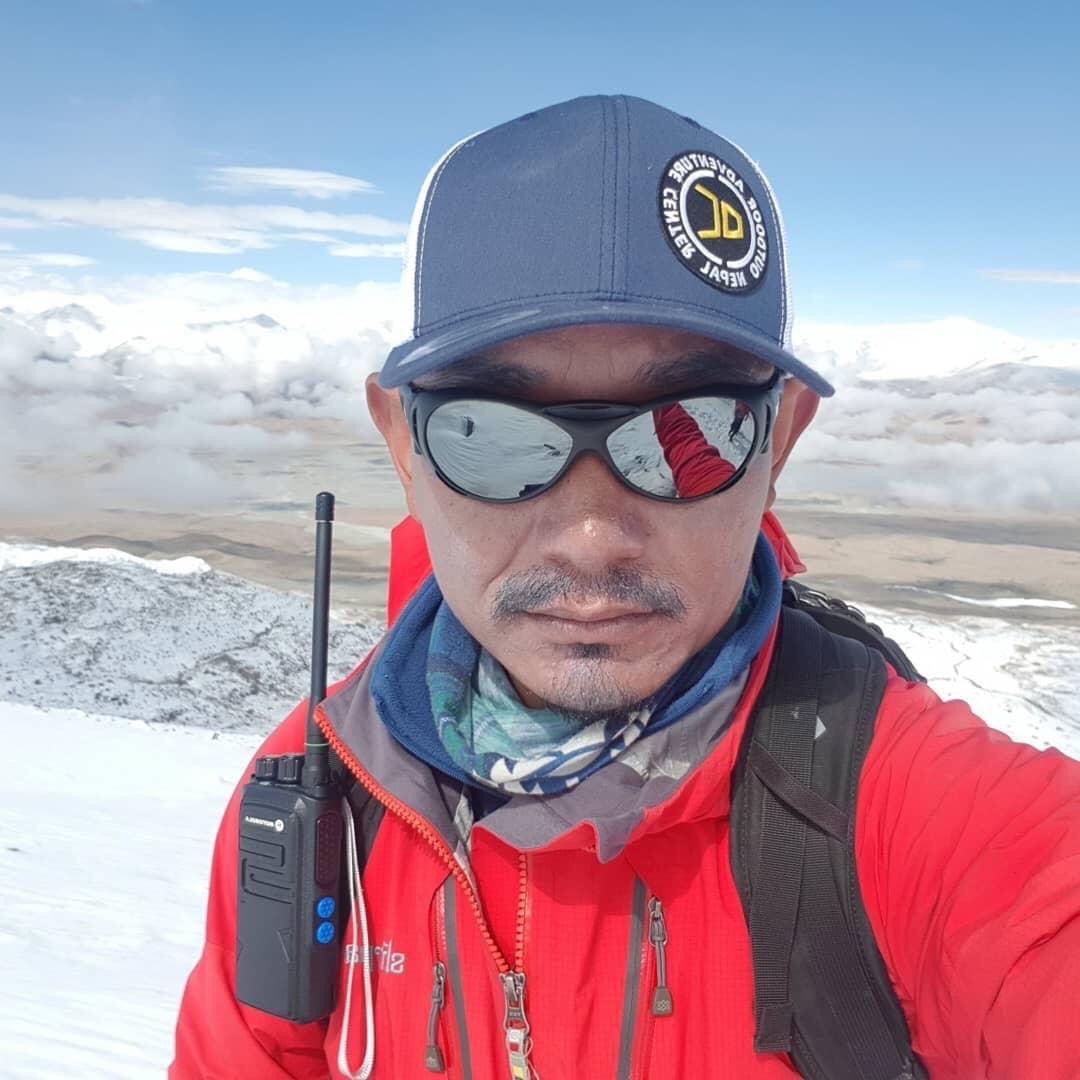
Imagine Nepal Trek and Expedition Pvt Ltd Sarswoti Nagar, Boudha – 6 Kathmandu, Nepal
Social share (Mingma G):
Social share (Imagine Climb):
Your message (optional)
Name of the Expedition/Peak
Personal Details
Preferred Name
Mailing Address
Email Address
Date of Birth
Gender Male Female Other
Passport Details
Nationality
Passport No
Date of Issue
Place of Issue
Date of Expiration
Next to Kin Information
Relationship to you
Family Information (For climbing in Pakistan Only)
Medical information.
1. Please state any physical or mental condition, allergy, illness and/or injury that could be relevant.
2. Do you have any dietary requirements? If yes, please list all dietary restrictions.
3. Have you ever had frostbite or any related cold weather injury/illness? If yes, please describe.
4. Have you ever experienced any form of altitude illness? If yes, please describe.
5. Are you on medication? If yes, please list all medications taken during the trip with reasons.
6. Do you wear corrective lenses? If yes, please mention how you manage with ski goggles?
7. Please mention if you have any pre-existing medical conditions not mentioned above.
Everest Base Camp Trek in 2018: The Ultimate Guide
Everest Base Camp is a trekker’s paradise. Located in the snow-capped Himalayas, thousand of trekking enthusiasts every year visit this place.
EBC is one of the most sought-out trekking destination in the world. It has mesmerizing view of the mountains, wonderful trekking facilities, and warm, hospitable people.
The biggest charm of the EBC trek is that you can be up close and get a magnificent view of the tallest mountain in the world i.e. the Everest. Also, other tall peaks such as Mt. Lhotse, Cho Oyu Makalu are located in this region.
As EBC is located at a high altitude, trekking there takes about two weeks. You have to take care of your health while trekking. In addition, you also have to prepare well to ensure that you can complete the trek.
There are many things to consider before you trek to Everest Base Camp. This article will serve as your ultimate guide for trekking to Everest Base Camp.
Table of Content
Highlights of the Everest Base Camp trek
- Trek to the Base Camp of Mt. Everest, the tallest mountain in the world.
- Explore the Sherpa culture of the Everest region by visiting various monasteries and villages of this region.
- Visit Sagarmatha National Park, a site listed in the UNESCO Natural Heritage Sites.
- Enjoy the mesmeric view of Khumbu glacier.
- Go through the wonderful rhododendron and pine forests of the Everest region.
1. Weather of Everest Base Camp
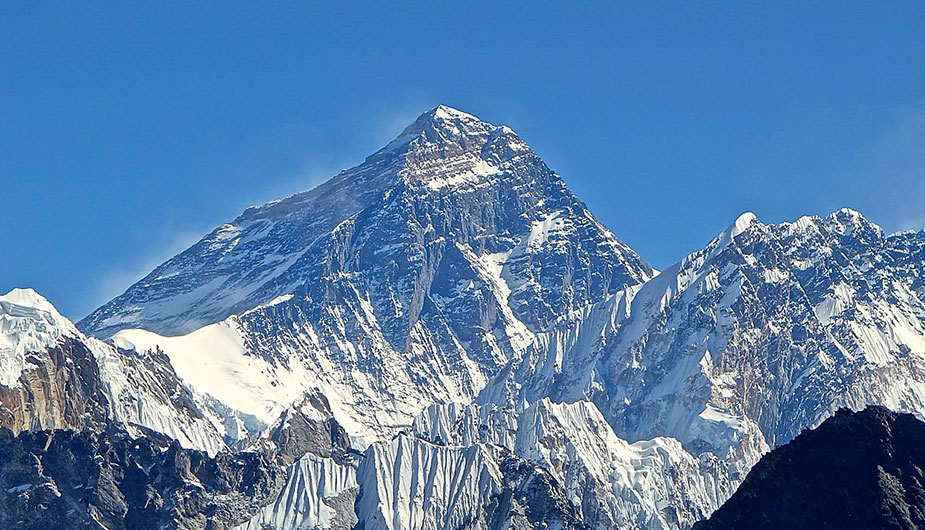
Everest Base Camp lies in the mountainous part of Nepal. The altitude you gain while you trek in the Everest Base Camp is quite significant.
To start your trek, you will take a flight from Kathmandu to Lukla and finally get to Everest Base Camp.The altitude of Kathmandu is 1400 meters while that of Everest Base Camp is 5380 meters.
Thus, in total you will gain an altitude of 4000 meters. Thus there will be variation in the weather of various places along the trek.
As you ascend higher, the weather turns unpredictable in this trek. So, it is better to start preparing.
Everest has four seasons- summer, spring, autumn and winter.
Summer in EBC falls in the month of June , July , and August . During this season, the minimum temperature along the highest points of the trek is around 0 degrees. This is a pleasant temperature considering the fact that you will be at the Base Camp of the tallest peak in the world.
However, due to the fact that monsoon season coincides with summer in Nepal, EBC trek in summer season is not as popular as trekking there in autumn or spring. But, if you plan your trip taking monsoon into account and have the appropriate gear, summer trek in EBC could be a pleasant experience.
December , January , and February are the months when there is winter in EBC. During the winter season, minimum amount of rainfall takes place in the Everest region. The most stunning pictures of the mountains are captured in this season. But due to heavy snowfall some trekking routes are closed in this season.
In addition, some places along the trek have temperature of -20 degrees in the winter. Therefore, winter treks in the Everest region is also less popular. But for people who like to trek in solitude, this is a great option.
In Everest Base Camp, autumn falls in the months of September , October and November . With moderate temperature and relatively low chances of rainfall, autumn trek to EBC is extremely popular. During this time, the temperature is mild. This means you have pleasant trekking temperatures during the daytime. In the nighttime, the temperatures are not extremely low.
Just after the completion of winter in EBC arrives the spring season. This season falls in the month of March , April and May . The vegetation in the Sagarmatha National Park becomes lush during this season and the views of rhododendron and pine forests in the Everest region is awesome.
The mountains, glaciers and quaint villages in this region bring out their best color during this season. Photography becomes awesome in EBC during the spring.
Tell us about your trip to Nepal and what you expect from it. We will answer your questions in 24 hours and help you design a trip with a comfortable itinerary to best meet your needs.
- Solo Traveler
- Number of Adults *
- Number of Children *
- Age of children at time of trip *
- I have my exact travel dates
- I have approximate dates
- I don't have my dates yet
- Travel Start Date * MM slash DD slash YYYY
- Travel End Date * MM slash DD slash YYYY
- Month of departure * Choose Month December 2020 January 2021 February 2021 March 2021 April 2021 May 2021 June 2021 July 2021 August 2021 September 2021 October 2021 November 2021 December 2021
- Approximate Duration * Less than a week 1 week 2 weeks 3 weeks More than 3 weeks
- Full Name *
- Give your trip a short title * A short descriptive headline that describes what you're looking for.
- Describe your trip *
2. Altitude of EBC trek
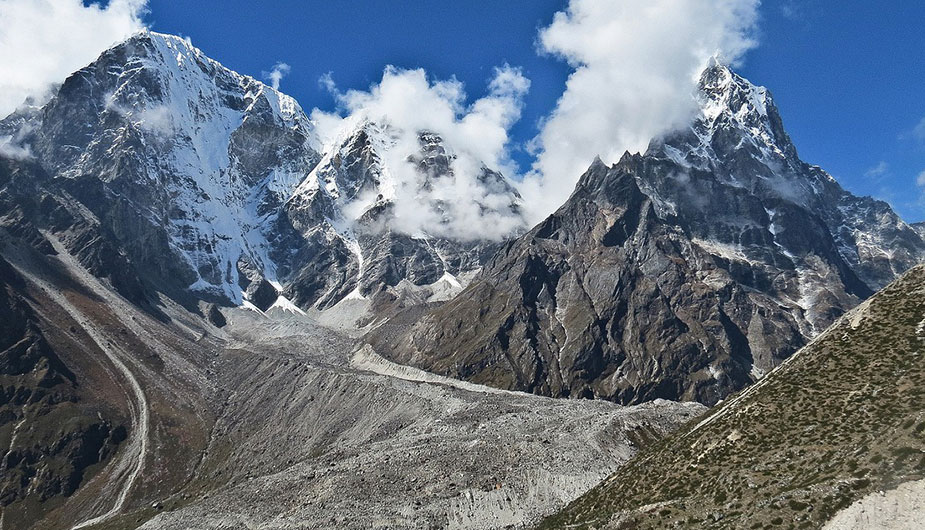
You will go to various places during your trek to EBC. The classic Everest Base Camp trek starts in Lukla. Lukla has an altitude of 2800 meters. From Lukla, you will have various stops where you will stay overnight and eventually complete the classic EBC trek in around 2 weeks’ time.
Mostly, the altitude of the places you go to in the EBC trek is more than 3000 meters, you have to spend your time acclimatizing as well. Also, there are various trekking options in the Everest region. So, trekking there might take take more or less than 2 weeks depending upon the trekking packages you want.
So, with different trekking packages comes different places along the trek and different altitudes as well.
Namche Bazaar is the town of Sherpa people and is a place that is renowned for trade. Khumjung Monastery and Tengboche Monastery are two places in the Everest region that reflect Tibetan Buddhism prevalent in this region.
Gokyo is a wonderful valley in the Everest region which people visit during Gokyo Valley trek.
There are some mountain passes that you can cross when you come for trekking in the Everest region.
3. Difficulty of EBC trek
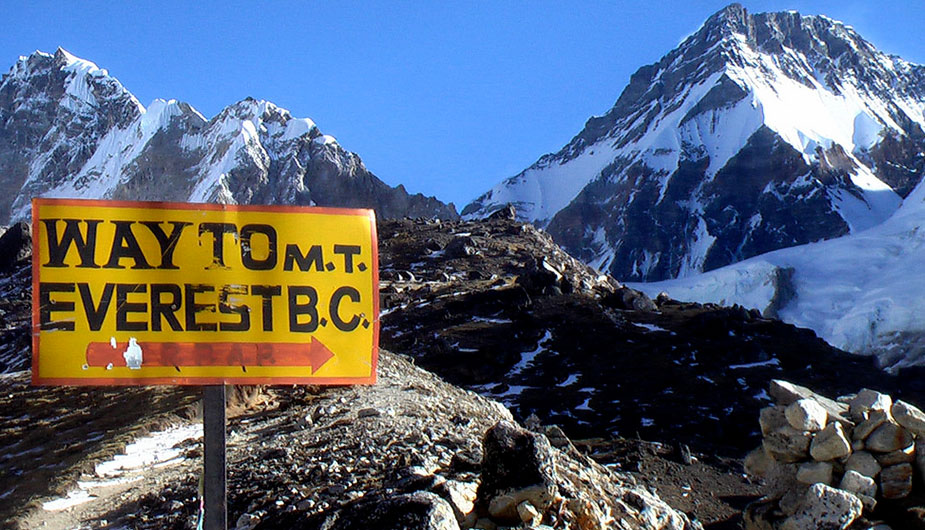
The other pressing question that every trekker asks about Everest Base Camp is whether the trek is doable. The difficulty of the EBC trek is determined by various factors such as altitude, the number of trekking hours as well as the season that you decide to do your trek.
Longer trekking routes in Nepal can take up to a month to complete while shorter trekking routes can be completed in a week. Trekking for a month in the mountains is quite strenuous. However, Everest Base Camp trek is two week long. This makes it moderately difficult in terms of the number of trekking days.
While doing the EBC trek, you have to trek for around 5-6 hours a day. You have your breakfast in a teahouse/ lodge in the morning and set out for trekking and trek for around 3 hours before having your lunch. After lunch and a bit of rest, you head out and trek for around 3 hours before reaching the place where you stay overnight.
Thus, the EBC trek is also moderate in terms of the number of trekking hours per day.
Altitude is another big factor that is detrimental to the difficulty of the trek. There are various ways in which you can prepare for altitude sickness. You need to go slowly in your treks and spend time for acclimatization as well.
Therefore, taking all these factors into consideration, EBC trek has a moderate level of difficulty.

4. Cost of trekking to EBC
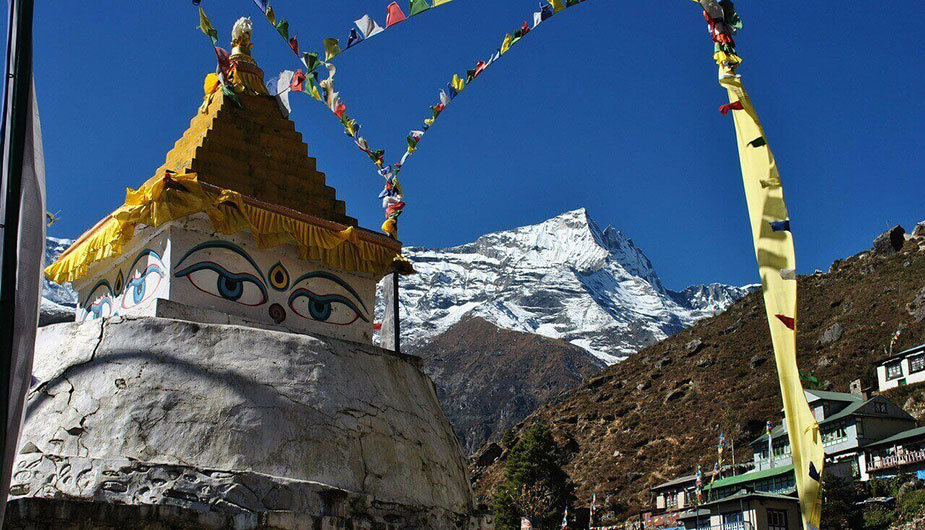
There are various kinds of expenses that you have to bear while trekking at Everest Base Camp. The cost of EBC trek includes the price of flights, accommodation, food, gear, travel permits, insurance, cost of hiring a guide and other miscellaneous costs.
The flight to Lukla from Kathmandu costs about 177$. If you choose the Jiri to Everest Base Camp, you won’t have to take a flight and this will reduce the cost of the flight. The price of flight from Lukla to Kathmandu is also identical.
You have a great range of places for accommodation. There are tea houses along the trekking trails which are quite cheap. Right next to tea houses, you can also find luxurious hotels. So, the price of accommodation in the EBC trek depends on the comfort and facilities you are looking for during your treks. For example, if you book the Everest Base Camp luxury trekking package, then your cost is going to be higher.
In addition, you should expect to pay higher charges for accommodation as you go to higher altitudes.
Also, you have to get several permits while trekking in the Everest region. EBC trek lies in the Sagarmatha National Park. The permit to Sagarmatha National Park costs 33$. Besides, you also have to acquire a TIMS card, the price of which varies according to your nationality. If you are planning to trek from Jiri, you will have to acquire a permit for Gaurishankar Conservation Area.
Guides and porters are also necessary for you in order to have a comfortable trip. Their prices vary from 20 – 40 US$. There may be miscellaneous expenses while charging you electronic gadgets, tipping porters/ guides/ waiters, and donating some amount to the locals.
5. Travel Insurance for EBC

Irrespective of where you are traveling, getting a travel insurance makes you feel secure about the things that can go wrong during your trip. As there are some problems you can face while trekking such as altitude sickness, accidents, illness etc., a travel insurance will come in handy.
In the worst case, you may be down with altitude sickness while trekking. Without a travel insurance, charting a helicopter for rescue can take upto 5000 US$. There might also be bruises and cuts during your treks which may require you to charter a flight.
In addition, some travelers lose their bags and other personal belongings due to forgetfulness or petty theft.
If you get a travel insurance for the EBC trek , you will be able to overcome such problems. There are many travel companies that provide a travel insurance for EBC. Make sure you check the list of items covered in the travel insurance you choose.
6. Altitude Sickness in EBC
While trekking in altitudes greater than 3000 meters, the oxygen level in the air goes down.. Due to lower levels of oxygen, the bodily functions may not function as it would normally do. This results in altitude sickness in some trekkers.
There are various types of altitude sickness viz. Acute Motion Sickness, High Altitude Pulmonary Edema (HAPE) and High Altitude Cerebral Edema (HACE). These many forms of altitude sicknesses have their own symptoms and preventive measures.
Acute motion sickness is quite mild in nature whereas HAPE and HACE are extreme forms of altitude sickness. HAPE and HACE are conditions where fluid is built up in your lungs and brain respectively. If left untreated, these conditions can be fatal.
In order to reduce the chances of altitude sickness during EBC trek, you need to prepare physically as well as mentally. While you are trekking, you need to go slow and make sure that your body is receiving enough nutrients in the form of food and water.
Taking medication, paying close attention to sanitation, and descending when you feel the symptoms of altitude sickness are some other preventive measures you can use to keep altitude sickness away.
7. Hiring a guide to EBC
If you have trekked to EBC many times before, you may be tempted to go to EBC without a guide. With enough trekking experience, you can do that. But, if you do not have prior trekking experience, hiring a guide is much helpful.
Guides help you in various ways during your trip. The biggest help they offer besides guiding you in trekking trails is by helping you understand the local community. Knowing the local community and learning the culture and lifestyle is an integral part of your trek.
In addition to guides, you can also hire a porter. A porter will carry your belongings giving your body relief during the trek. This will enhance your trekking performance and help you complete the trek on time..
In addition, you can also hire a porter cum guide who guides as well as carries your belongings during the trek..
Guides and porters help you in getting awesome views of the mountains of the Everest region as they have a lot of idea about the best places for mountain viewing. Plus, they can guide you through the best local cuisine of the region.
Hiring a guide to EBC also helps to boost the economy of the region. Guides and porters also help you have good conversations along the way and provide you physical as well as mental support that you need while trekking to EBC.
There are excellent travel agencies in Nepal which provide you the facilities of licensed guides and porters.
8. Finding a travel agency for EBC trek
Finding a travel agency is another important factor to consider while trekking to EBC. As there are many travel agencies in Nepal, it is extremely important to review the various factors that makes a travel agency good.
Travel agencies are necessary as they help you arrange accommodation and guides fork safe and easy trek. In peak trekking seasons, accommodation is difficult to find and you may end up sharing rooms or not finding rooms with good insulation.
Travel agencies also provide you licensed guides. Good trekking companies have a good track record of providing emergency services during your trek. In addition, they will also provide you good advice and customize your trips according to your convenience.
While you are looking for a travel agency for trekking in Nepal, the first thing you need to do is to check whether the agency is registered. Experience is another important factor to consider while choosing a trekking agency for EBC trek.
But, before you consult a trekking agency, you might want to know what you want. If you make a rough estimate of the number of days you are planning to trek, your budget as well as the places you want to visit, it makes it all the more easier to approach any trekking company with clarity.
If you read the reviews of Nepal’s trekking companies in online platforms such as TripAdvisor and Lonely Planet, you will have some idea about if the services provided by the trekking agencies have a good standard.
You can also interview the guides offered by the trekking agencies and know if you will be comfortable with the guides. lso, look at the track record of all the trekking agencies to see if they have a good history of emergency services they have provided.
9. Everest Base Camp training program
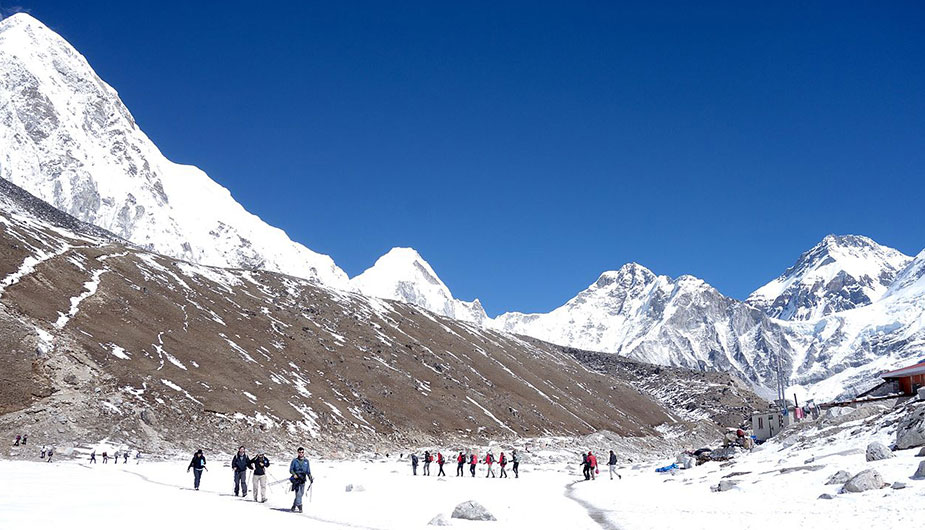
If you are looking for completing Everest Base Camp trek, you should consider proper training for this trek . As you have to trek for about two weeks and prepare for the altitude as well, you need to undergo a rigorous training regime.
If you are a beginner who has little or no trekking experience, you should do a few hikes or treks before you take on the EBC trek. You can come to Nepal a few days early and do a few short treks to get your body adjusted to walking for longer hours..
In addition to that, you also need to do a cardio training to build endurance. You can either opt for some running, cycling, or swimming. All of these exercises help you strengthen your limbs as well as forearms which will immensely help you in your treks.
Diet is of paramount importance in order to build endurance and strength in your body. You need to make sure that the food you eat is rich, not simply in terms of protein but other minerals and vitamins as well.
You can also use elevation masks to prepare for your treks as elevation masks are known to build endurance in the body. Although, preparing with elevation masks is no guarantee that altitude sickness will not catch you, it will help simulate the environment that you are likely to encounter during your treks.
During your trek to EBC, you should not rush. You should continue your treks slow and you need to acclimatize properly as the altitude increases.. If at any point during your trek you don’t feel well, you need to take rest and assess your bodily conditions.
At times, you may feel symptoms of altitude sickness. In that case, you need to descend to a lower altitude and take all the necessary precautions.
10. Everest Base Camp trek route
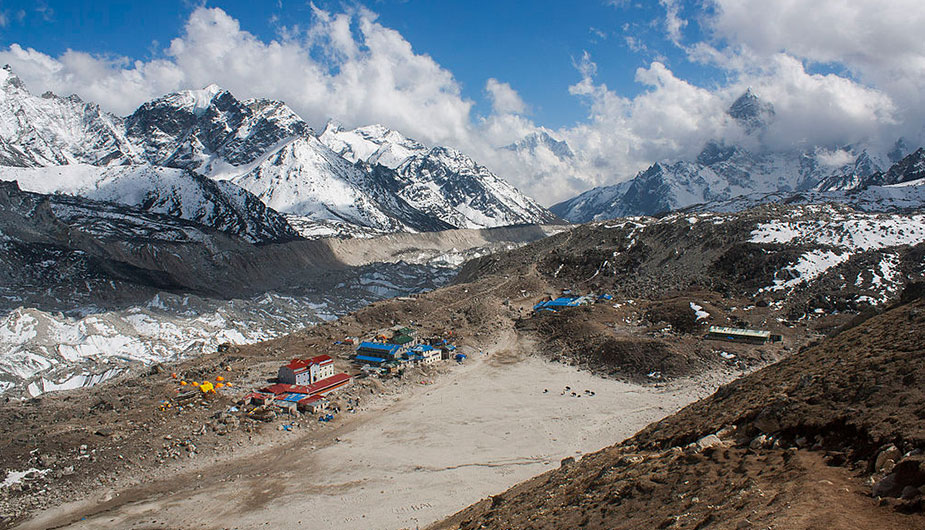
11. Other trekking options in the Everest region
Everest base camp panorama trek.
If you are a beginner looking for some trekking experience in the Everest region, Panorama trek in the Everest region will be perfect for you. It is a light trek in the lower altitudes of the Everest region.
In this trek, you will visit places such as Namche Bazaar, Tengboche and Phakding. All of these places have an altitude lower than 3500 meters.
Everest High Passes and Island Peak
This is a trek from where you not only go to Everest Base Camp and Kala Pathar but also cross mountain passes such as Cho La Pass and Kongma La Pass. You will also climb Island Peak which is 6187 meters tall. This will be a long trip which will last about 25 days.
Gokyo Valley Trek
Another wonderful trekking option in the Everest region is Gokyo Valley trek. Gokyo is one of the most awesome valleys in Nepal with breathtaking mountains, Buddhist monasteries, glaciers and lakes.
Even trekking in Gokyo region has several alternatives such as Gokyo valley and Renjo La Pass trek and Gokyo to Everest Base Camp trek. All of these treks can be completed in different number of days as the routes can be customized by consulting a travel agency.
Jiri To EBC trek
Jiri to Everest Base Camp trek is one of the longest treks in the Everest region. During this trek, you will trek from Jiri, a place with an altitude of 1900 meters. Trekking from this place will help you acclimatize while trekking to the higher regions of Everest.
12. Death in Everest Base Camp
With so many movies depicting Everest Base Camp and expeditions in Mt. Everest, you might be wondering if there have been many instances of death of trekkers during Everest Base Camp trek. Well, the answer is YES.
But the fact that there have been deaths in the Everest Base Camp should not deter you from trekking to the Everest Base Camp. You have to look more closely at what lead to the deaths of people wanting to trek to EBC.
Most deaths that are shown in the Everest region in the movies are the ones which take place in mountaineering expeditions. And mind you, mountaineering expeditions are tough. You need a rigorous amount of training and sophisticated mountaineering equipment to complete the Everest expedition.
However, trekking to Everest Base Camp is rarely dangerous. The trekking trails to Everest Base Camp are relatively safe and thousands of trekkers trek there with appropriate training and guides.
A recent casualty while trekking in the Everest region was a travel enthusiast from Melbourne, Australia. Before that, in October 2014 and early 2014, there were casualties in the Everest region.
All of these casualties were reported to have problems coping with altitude sickness. You should prepare extremely well for the altitude sickness while going to the higher altitudes of the Everest region. .
If you have friends during your trip, they might provide you with necessary physical and mental support during your trips. If you are traveling alone, it becomes important for you to hire a guide or a porter, who can provide you such support.
13. Alternatives to trekking to EBC
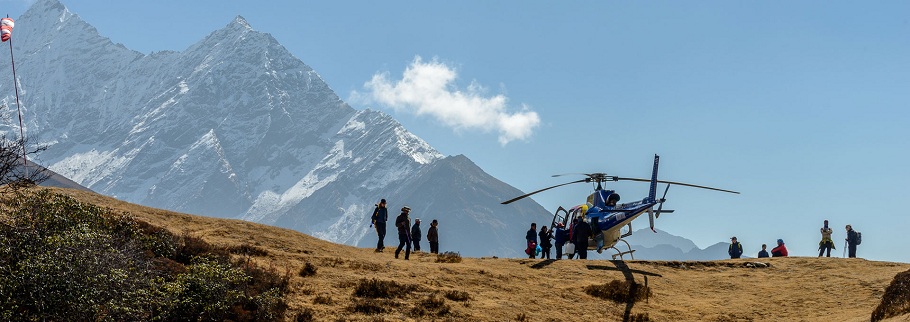
You might be desperate to visit the Everest region but not be up for trekking in the region. You might wonder if there is any way you can go to the Everest region without taking the trouble of trekking. Well, there is a way.
Everest Base Camp is easily accessible in a helicopter. Everest Base Camp Helicopter tour allows you to go to Everest Base Camp and Kala Pathar in a helicopter. You take a helicopter from Kathmandu and travel to the Base Camp.
First, you’ll go to Lukla from Kathmandu early morning and stay in Syangboche for a delightful breakfast in Hotel Everest View. Everest View is a sophisticated hotel in the Himalayas of the Everest region from where you can enjoy the peaks in Everest region such as Mt. Lhotse, Mt. Makalu and Everest.
After the breakfast, you will go to Everest Base Camp and Kala Pathar. From Kala Pathar, you can enjoy a very close view of Everest. After you spend about an hour and a half, you will get back to Kathmandu.
In a helicopter tour, you will get to the Everest region and come back the same day in the safety and comfort of a helicopter. Another wonderful feature of the helicopter tour is that it is accessible all year round.
You also have options of joining a group in a helicopter tour while going to Everest Base Camp or choose a private tour.
14. Everest Base Camp Packing List
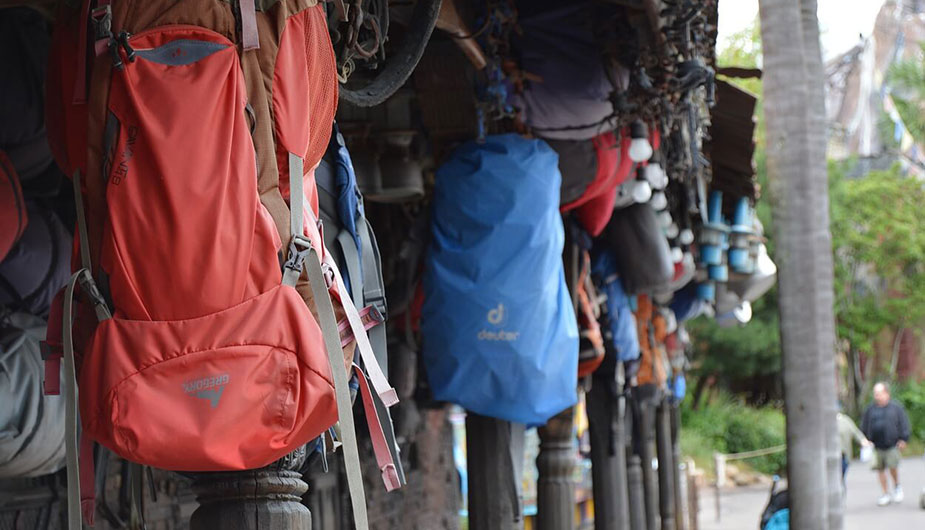
Your packing list for EBC trek is of utmost importance. You need to consider the season in which you are planning to do the trek and choose your gear as well as clothing accordingly.
When you are in the lower altitude, the temperature might be lower than that of the regions in higher altitude. Therefore, multi-layered clothing will be the way to go.You need to put on base layer, insulation layer and the outermost layer of clothing.
Since you cannot completely ignore the possibilities of rain, you should make sure that your down jacket and trousers are waterproof.
You will need a voluminous backpack which can accommodate a lot of belongings from clothes, digital accessories to sleeping bags. Make sure that you get a rain cover for your backpack as well.
You will also need sturdy trekking boots. Sunscreen will help you ward off the UV radiation that can harm your skin. You will also need sunglasses to protect your eyes from such radiation.
In addition, you will need woollen hats, gloves and socks to keep cold away. You may also want to consider buying a trekking pole to help you have a form grip on the ground that you tread while trekking. Basic toiletries and first aid will come in handy during emergencies.
Frequently Asked Questions
What type of accommodation is available in the everest region.
There are luxurious hotels like Hotel Everest View in the Everest region along with tea houses, which are basic. As you trek to higher altitudes, facilities such as WiFi, room heating become scarce. Make sure you check the trekking agency you are traveling with to know what kind of accommodation is arranged for you.
What kind of food is served while trekking to EBC?
The type of food served is also dependent on the hotels that you dine in. Luxurious hotels such as Everest View have a great range of food from Continental to American. But if you go to normal lodges, you will most often be served traditional Nepali food in the form of Dal Bhat for lunch and dinner.
Is there a great range of beverage available during the EBC trek?
Nepal is quite famous for the wonderful variety of tea and coffee it serves. So, you will find a range of tea while trekking to EBC. The same goes for coffee.
However, you should avoid consumption of alcohol while trekking. Consumption of alcohol leads to dehydration, which increases the chances of altitude sickness.
What kind of snacks do I need to carry for the EBC trek?
Chocolate is always the most handy snack that you can carry. Chocolates have high carbohydrate and energy. Constantly munching it while trekking will help you maintain your energy level.
Is drinking water at EBC pure?
One of the biggest problems that you may face during EBC trek is finding clean drinkable water. Drinking impure water may lead to diarrhoea, which will lead to dehydration. So, you can carry a water purifier or water purifying tablets to ensure that the water you drink is safe.
What kind of toilet facilities are there in the EBC region?
Most of the toilets that you find in the Everest region are squat toilets. In squat toilets, is no automatic flushing here and you have to use a bucket of water in order to flush. But lodges that are recently built have automatic flush toilets as well.
Is cell phone reception available in the EBC trek?
Cell phone reception and its quality varies from one location to another but is available in several parts in the EBC trail. There is mobile phone facility at Everest Base Camp as well. In addition, several villages and lodges have landline facility too.
Is there any limit on age for the EBC trek?
There are no restraints on the age while doing the EBC trek. But, highlighted before, you need to undergo basic training before setting off for the EBC trek. You might also want to consider consulting a doctor for a precautionary checkup about the state of your health. The doctor will also prescribe you some medicine for altitude sickness, if necessary.
What is the limit of the weight of my baggage to Everest Base Camp?
If you are taking a flight to Lukla, there is a certain limit to the weight of your baggage. The maximum weight of the check-in baggage is 10 kg whereas that of the hand carry is 5 kg.
Are ATMs available in Everest Base Camp?
No. ATMs are not available in Everest Base Camp. There are some ATMs in Namche Bazaar or Lukla but not in places higher than that. And in worst scenarios, ATMs might run out of cash or the machines may not work properly. So, carrying some hand cash is always a good option.
Is there a rule for tipping/ donations while trekking in EBC?
Tipping is not compulsory. If you want to tip someone or make some donations, you are free to do so but, there is no hard and fast rule about how much you should tip.
Everest Base Camp trek is a trek of a lifetime. Trekking there will give you memories that will last forever. But, there are many things to consider before you can start your trek there. You need to carefully assess all things mentioned above while planning for your trek. If you are well prepared, it will be the most amazing trekking experience of your life.

Username or E-Mail
Forget Password?
Do not have an account?
After creating an account, you'll be able to track your payment status, track the confirmation and you can also rate the tour after you finished the tour.
Already a member?
- Trekking and Hiking
- Climbing and Expedition
- Cultural and Historical Tours
- Nature and Wildlife
- Religious and Spiritual Tours
- Cycling and Mountain Biking
- Multiple Activities
- Adventure Sports
- Voluntourism
- ACTIVE ADVENTURES
- EXTREME ADVENTURES
- LUXURY TOUR
- Family Holiday
- MULTIPLE COUNTRY
- SCHOOL TRAVEL
- ECO FRIENDLY
- Why Himalayan Glacier?
- Awards and Recognitions
- Latest Trip Review
- Travel Blog

- TREKKING AND HIKING
- CLIMBING AND EXPEDITION
- CULTURAL AND HISTORICAL TOURS
- NATURE AND WILDLIFE
- RELIGIOUS AND SPIRITUAL TOURS
- CYCLING AND MOUNTAIN BIKING
- MULTIPLE ACTIVITIES
- ADVENTURE SPORTS
- VOLUNTOURISM
- Nepal Travel Guide
- Nepal Travel FAQs
- Tibet Travel Guide
- Tibet Travel FAQs
- Bhutan Travel Guide
- Bhutan Travel FAQs
- India Travel Guide
- India Travel FAQs
- Tanzania Travel Guide
- Tanzania Travel FAQs
- Multiple Country
+1-410-307-0007
- Plan Your Trip
Everest Base Camp Trek - 16 Days
Adding item to wishlist requires an account
Already a member.
Username or E-mail
Don't have an account? Create one.
Embark on an unforgettable adventure with the Everest Base Camp Trek, a 16-day Himalayan journey that offers breathtaking mountain views and insights into Sherpa culture. Our journey begins with a thrilling flight from Kathmandu to Lukla, a small town in the Khumbu region that serves as the gateway to the Everest region.
From Lukla, we’ll trek through stunning Sagarmatha National Park, a UNESCO World Heritage Site, and arrive at Namche Bazaar, a bustling Sherpa village located at an altitude of 3,440 meters. We’ll spend a night or two in Namche Bazaar , exploring the local markets and monasteries while acclimating ourselves to the high altitude.
After Namche Bazaar, we’ll continue our trek to Tengboche monastery , one of the most important Buddhist monasteries in the region, with breathtaking views of Everest and other peaks. Along the way, we’ll immerse ourselves in Sherpa culture and enjoy the breathtaking views of the Himalayas.
From Tengboche, we’ll trek to the base camp of Mount Everest, following in the footsteps of Sir Edmund Hillary and Tenzing Norgay on their historic journey in 1953. We’ll also trek to the summit of Kala Patthar for breathtaking panoramic views of Everest and other Himalayan peaks.
This high altitude trekking experience is not for the faint of heart, but with proper preparation and an expert Sherpa guide, you’ll be able to complete this incredible journey. The Everest Base Camp Trek is an adventure of a lifetime, perfect for those seeking outdoor activities and adventure travel. Join us on this epic journey and experience the wonder of the Himalayas, from the Sherpa culture to the awe-inspiring beauty of Mount Everest.

- Scenic Flight: A thrilling flight with scenic views from Kathmandu to Lukla.
- Panoramic Views: Savor the panoramic views of the Himalayas including Everest from Kala Patthar.
- Sherpa Culture: Immerse yourself in Sherpa culture, by visiting traditional villages like Namche Bazaar, Khumjung, and Tengboche.
- Teahouses and Cuisine: Stay in local teahouses, enjoying authentic Nepali and Sherpa cuisine.
- Kala Patthar: Hike to Kala Patthar, offering breathtaking panoramic views of Everest, especially during sunrise or sunset.
- Scenic Landscapes: Traverse a variety of landscapes, from lush forests to rhododendron groves, and suspension bridges.
- Everest Base Camp: Stand at the foot of the world’s highest mountain and feel the awe-inspiring energy.
Is the Everest Base Camp trek appropriate for me?
Our 16-day Everest Base Camp Trek itinerary is designed for beginner trekkers who are in good health and have average physical fitness. It covers ample distance between daily itineraries, includes a steady gain in altitude, and incorporates separate rest days to ensure proper acclimatization. By walking at a steady pace with proper acclimatization, you can help avoid altitude sickness and fully enjoy the breathtaking views on this trek.
But if you’re up for an even bigger challenge, Himalayan Glacier offers the Everest Base Camp Trek via Gokyo Lakes – 18 Days. And for experienced trekkers with limited time, our Everest Base Camp Short Trek – 14 Days is the perfect option. No matter which itinerary you choose, you’re sure to have an unforgettable adventure in the majestic Himalayas.

Lasts more than a week and with up to 12 days walking 6-8 hours each day up and down the hills. These take you up to an altitude of 4,500m / 14,800 feet and require at least 3 months’ fitness preparation prior to the trek.
Overnight sleeping at Everest Base Camp?
Outline itinerary, trip itinerary, arrival in kathmandu.
After landing at the Tribhuwan International Airport, we will be greeted by a representative of Himalayan Glacier who will drop us off at our hotel. We then check-in at the hotel, freshen up and take a rest. In the evening a welcome dinner will be hosted by Himalayan Glacier. Overnight in Kathmandu.

Maximum Altitude
Accommodation, kathmandu: sightseeing and trek preparation.
We tour Durbar Square, Pashupatinath temple, Swayambhunath stupa and Bouddhanath stupa which are all world heritage sites. The Durbar Square sheds light on the life of the royals in ancient times. Pashupatinath temple is one of the most important places of pilgrimage for all Hindus. Swayambhunath is also known as the Monkey Temple and Bouddhanath Stupa is one of the largest stupas in the world. At noon, we are introduced to our fellow participants and discuss our trip at Himalayan Glacier’s office. Overnight in Kathmandu.

Fly to Lukla, trek to Phakding
We take an early morning flight to Lukla which is where all Everest treks begin. We meet the rest of our team in Lukla and start trekking from there. We walk on a trail that gradually descends to Cheplung village from where we get a glimpse of Mt. Khumbila, a sacred mountain which has never been climbed. From here, we gradually descend until Phakding. Overnight in Phakding.
Travel Distance:

Phakding to Namche Bazaar
Our trail passes through a pine forest and we continue our walk on the trail that goes north up the Benkar valley. We cross Dudh Koshi River and pass Chumoa and Monjo villages before reaching the entrance of the Everest National Park. Then after crossing a suspension bridge, we pass Jorsale village and walk alongside of the Dudh Koshi and Bhote Koshi rivers. We ascend on a steep trail and reach Namche Bazaar which is probably the biggest town in the Everest region. Overnight in Namche Bazaar.

Acclimatization Day - Namche Bazaar
We can tour Namche Bazaar which is the primary town of the Everest or Khumbu region and has government offices, ATMs, internet cafes, shops, restaurants, and a colorful market. We can hike-up to Sagarmatha National Park and enjoy the sunrise over the Himalayas including Mt. Everest, Lhotse, Nuptse, Ama Dablam, Thamserku, Kongde and so on. If we are interested in a day hike, we can trek to Khumjung village. Today we also visit the Hillary School and a monastery which houses a yeti scalp! Overnight in Namche Bazaar.

Namche Bazaar to Tengboche
The trek until PhunkiThanga is an easy walk. From here we ascend towards Tengboche village which houses the very famous Tengboche monastery which is the biggest monastery of the Everest region. It is located within the Sagarmatha National Park which is a UNESCO World Heritage Site. The monastery is blessed with panoramic views of the Himalayas, including Mt. Everest, Nuptse, Lhotse, Ama Dablam and Thamserku. The Tengboche Monastery opens at 3:00pm, so if we reach there by 3 o’clock we can observe a Buddhist religious ceremony. Overnight in Tengboche.

Tengboche to Dingboche
Our trail descends and passes through lush forests of birch, confer and rhododendron trees. While trekking we can admire good views of Mt. Everest, Lhotse, and Ama Dablam. We walk downhill to Debuche and cross the Imja River to reach Pangboche. We continue our walk to the Imja Valley and Lobuche River before ascending to Dingboche. It is a picturesque village with beautiful barley, potato and buckwheat fields complete with grazing animals dotted along those fields.

Dingboche: Acclimatization
Spending a day in Dingboche will help us to acclimate to the high altitude. Instead of staying idle, we climb a ridge located behind the village and see six of the world’s tallest peaks including Lhotse, Makalu and Cho Oyu. Furthermore, we can also admire Cholatse and Taboche peaks. On our north-west we see more Himalayan peaks rising above the Khumbu Khola Valley. Among those peaks, Lobuche West, Lobuche East and Lhotse are the most dominant. From another location on the ridge we can also admire the picturesque Imja Khola Valley and the beautiful Dingboche village. Overnight at Dingboche.

Dingboche to Duglha
It is a relatively short journey from Dinboche to Duglha. We trek across a wide pass which is a much wanted change from walking in a straight line. Around the beginning of our trek today we enjoy the company of the mighty Himalayas on all sides. The valley begins to narrow as we come closer to Dusa. We pass the campsite of the first successful Everest Expedition in 1953. We begin to see Mt. Pumori as we continue on our trail. As our trail descends and curves, we bid goodbye to Mt. Pumori. We cross a stream and ascend to Duglha which is a tiny village with a huge strand of prayer flags hung across the valley. After reaching Duglha, we can walk for 45 minutes to an hour and visit the Memorial Shrine. Overnight in Duglha.

Duglha to Lobuche
The trail passes through boulder-strewn slopes as we ascend Chupki Lhara which is a ridge that provides spectacular mountain views. The top of the ridge is filled with prayer flags and stones which are memorial shrines for climbers who lost their lives on Mt. Everest. As the trail drops to the Khumbu Glacier moraine, we find ourselves facing several great peaks including Khumbutse, Lingtren, Pumori and Mahalangur Himal. As we are crossing Khumbu Glacier we can also see Mt. Nuptse. Overnight in Lobuche.

Lobuche to Gorak Shep, visit Everest Base Camp
This day we ascend and descend mostly on a glacier path. There is also a lot of meandering on rough terrains. As we reach the base camp, we enjoy the incredible melt patterns and admire the gently rounded ice towers on the upper part of the Khumbu glacier. The Everest Base Camp is stunningly beautiful. We can enjoy amazing views of Nuptse, Khumbuste, Lingtren and Pumori mountains from the base camp. After soaking in the beauty, we walk back towards Gorak Shep where we spend the night. Overnight in Gorak Shep.

Gorak Shep to Kala Patthar to Pheriche
We wake up early for the walk up to Kala Patthar. It is dark outside with cold temperature and most likely chilly winds. We walk on a fairly steep trail at a comfortable pace. As we are climbing up the hill we can see Lingtren, Khumbutse, and Changtse mountains. The view from the summit is outstanding. We can see the world’s tallest mountain Everest along other mighty Himalayan peaks. After spending some time at the summit of Kala Patthar, we walk back to Gorak Shep which is relatively easier than hiking up to Kala Pathhar.
After returning to Gorak Shep, we will have breakfast and then descend to Pheriche to spend the night. Overnight in Pheriche.

Pheriche to Namche Bazaar
We lose approximately 2,000 feet in elevation today and walk on a trail with a lot of ups and downs. We descend through a hillside filled with rhododendron and juniper trees and cross a bridge over the Dudh Koshi River. We descend rapidly through pine forest where we can easily spot mountains goats, pheasants and other wild animals and birds common to the area. The path eventually reaches Sansa from where we can enjoy views of Ama Dablam, Thamserku and Nuptse mountains. We walk on winding trails followed by another walk through a forest before reaching Namche Bazaar. Overnight in Namche Bazaar.

Namche Bazaar to Lukla
We begin our trek to Namche Bazaar today on a rocky terrain. It is mostly a downhill trek on a trail alongside the Dudh Koshi River. We cross several suspension bridges, pass by several monasteries and villages before reaching Lukla. After reaching Lukla we spend rest of the day taking rest as today will be our last day on the mountains. Overnight in Lukla.

Fly to Kathmandu
We catch an early morning flight to Kathmandu after our long mountain journey. After reaching Kathmandu, we can take a rest or do some souvenir shopping. If we want to explore any other areas of Kathmandu, we may do that today. Our guides can help you with both souvenir shopping or sightseeing. There will be a farewell dinner in the evening to celebrate the successful completion of our journey. Overnight in Kathmandu.

Final departure
Our journey in Nepal comes to an end today! A Himalayan Glacier representative will drop us off at the airport approximately 3 hours before our scheduled departure flight. If you wish to extend your stay in Nepal for some other adventure activities or visit the neighboring countries like Bhutan, India or Tibet, then Himalayan Glacier will assist you with all the formalities!
Not satisfied with this itinerary?
Are you interested in planning a Custom Trip now? It takes only 2 minutes!
Significant Information: The unpredictable weather conditions in the Everest region may lead to cancellation of Lukla flights. So, what do you do if your flight is cancelled at the last minute? We have several alternative options for Lukla flight cancellations for you, in case you have limited time in Nepal. Make sure that you are well-informed about this critical issue well ahead of time!
- Local Guide & Support Staffs
- Meals in the Mountain
- Guaranteed Departures
- No Booking Fee
Everest Base Camp Trek Tips
- 14 Tips for Successful Trek to The Everest Base Camp
- Best Time to Trek to Everest Base Camp
- Everest Base Camp Trek Packing List
- Everest Base Camp vs Mount Kilimanjaro
For Your Information, International flights aren’t included. Rooms are usually shared by two people unless you request a private room. Also, you can upgrade to better hotels in the mountain and even in the cities. For your customized services, please specify during the booking process or contact our Destination & Products Specialist.
Food on Everest Base Camp Trek
All meals will be provided during trekking while only breakfast will be available in Kathmandu. There will also be welcome and farewell dinners for guests. While on trek, we have breakfast and dinner in the lodges/teahouses we spend the night and lunch on our way to the next destination. Nepalese, Tibetan, the more common continental and Indian cuisines are common choices in the menu.
To get an idea about your meals on the go, breakfast comprises a hot beverage, toasts, pancakes, eggs, etc. while lunch will include rice items, noodles, potato varieties, pizza, pasta, burger, meat items, and so on. The starters in dinnertime are soup varieties while the main course includes more or less similar items as that of lunch menu, including a dessert item and a hot beverage. A detailed information about the food on the everest base camp trek gives you a clearer picture of your dietary provisions.
Note: Trekkers who strictly follow vegetarian or vegan diet must inform us during the time of booking their trip with us. We recommend you to avoid any alcoholic beverages during the trip. Also, we advise you to avoid meat items because meat has to be carried all the way from Lukla or Namche for several days before it is consumed. So, there is more possibility of staleness, just enough to upset your tummy!
Accommodation During Everest Base Camp Trek
We will be accommodated in Yatri Suites & Spa or Similar in Kathmandu; and lodges during the trek. All accommodations are on twin-shared basis. Single supplement will be served on request with an extra cost.
Himalayan Glacier will arrange rooms with attached washrooms; however, lodges in some places only have shared washing and toilet facilities. Also note that single rooms are readily available in Kathmandu and the trekking regions at lower elevation but it might be difficult to find them at higher elevations. The types and standards of accommodation during the everest base camp trek varies at different locations.
Experience Required
Everest Base Camp Trek- 16 days is a moderate trek. Travelers who can walk up to 6-7 hours a day on an uphill and downhill trail will find this trek fulfilling. It is best that we prepare ourselves for the Everest trek by jogging and exercising regularly at least a month prior to the start of the trek. Trekking to the Everest Base Camp should be relatively easier for those who have experience walking/trekking in a high altitude environment. Past hiking experience would be an asset but no technical skill is required for this trip. It is also important that we consult our doctor. Participants with pre-existing medical conditions such as heart, lung, and blood diseases should inform Himalayan Glacier before booking the trek.
Acclimatization
Everest Base Camp Trek itinerary is planned with a high degree of awareness of Acute Mountain Sickness (AMS). Experts agree that gaining elevation without proper consideration of AMS could be fatal. The higher the altitude, the less oxygen will be in the air. Therefore, our body needs time to adapt to an environment with less oxygen. During this trip, we take rest in Namche Bazaar and Dingboche which will help us acclimatize to the high altitude thus resulting in a successful trip.
Team Composition
For this trek there will be one leader, assistant leader ( 4 trekkers: 1 assistant guide ) and Sherpa porters for carrying luggage ( 2 trekkers: 1 porter ). This arrangement ensures that should anybody in the group get sick, the trip can still go ahead as planned. We can run the trek for groups of any size but we after years of experience we have found a maximum of twelve people to be the optimum size for a successful trip. However, if you'd like to book this trip for a larger group then that can be arranged too.
DATES & PRICES
All our published dates are guaranteed departures. If the dates don’t match with your travel plans, we are more than happy to create your desired date. Let us know what kind of trip you are looking for and our travel experts will help plan your tailor-made trips in your dream destination.
Availability
September 2024, october 2024, november 2024, october 2025, november 2025, proceed booking, or continue as guest.

What to pack on the Everest base camp trek?
Everest base camp trek is a lodge-to-lodge trek. It is also known as a teahouse trek. It means that you will not be required to sleep in camping tents and most of the facilities like laundry, food, etc. are easily available throughout the trek. However, you need to carry some of the most essential items that you will personally require during the trek. As Everest base camp trek is considered quite challenging, we recommend packing only the necessary gears and required equipment. Make sure that you don’t over-pack, and at the same time don’t under-pack.
In order to enjoy the trip rather than worry about the weight of your load, you need to pack light only with the essentials. Read the complete Everest base camp trek packing list and pack smart and light for a more comfortable and a fulfilling trip to the base camp.
Q1 : How hard is it to climb to Everest Base Camp?
Q2 : what is the best time to trek to everest base camp, q3 : who are my guides to everest base camp trek, q4 : is my trip departure guaranteed, q5 : what if i cancel the trip, do i get my refund, q6 : what kinds of clothes and gears are needed to trek everest base camp, q7 : is there an age limit for everest base camp trekking, route map of everest base camp trek.
WHAT OTHER TRAVELERS SAYS?
Related trips.

Hike to Machu Picchu and Rainbow Mountain

Salkantay Trek and Inca Trail Hike

Hiking the Inca Trail to Machu Picchu
Everest base camp trek - 16 days, why himalayan glacier, 98% success rate.
Precise planning with first-hand knowledge defining our high success rate
Local Leaders & Guides
Exclusively trained, trusted and tested local leaders and guides at your service
Tailor Made Trip
Tailor-make any trip hassle-free based on what you’re looking for
Recommended on

Planning a Trip?
We have a pool of travel experts working in this industry for more than a decade. Consult to get started.

Everest Base Camp Trek – Ultimate Guide For 2024
Written By: The Planet D
Adventure Travel , Nepal
Updated On: January 5, 2024
Trekking to Everest Base Camp is different than other treks around the world. Nowhere else on earth will you experience trekking as you do in Nepal and nowhere quite compares to the majesty of the Himalayas. Villages dot the landscape filled with restaurants, markets, bazaars, and tea houses (mini-hotels) where you can stop for lunch, buy supplies, and have a piece of apple pie while surrounded by the highest mountains in the world.
Every hundred meters or so there is a hotel, restaurant, or cluster of buildings making up a small village. The villages are stunning reminding us of something out of the Swiss Alps on steroids. Well-built lodges and brick homes line the trail with the magnificent setting of the Himalayas draped in the back.
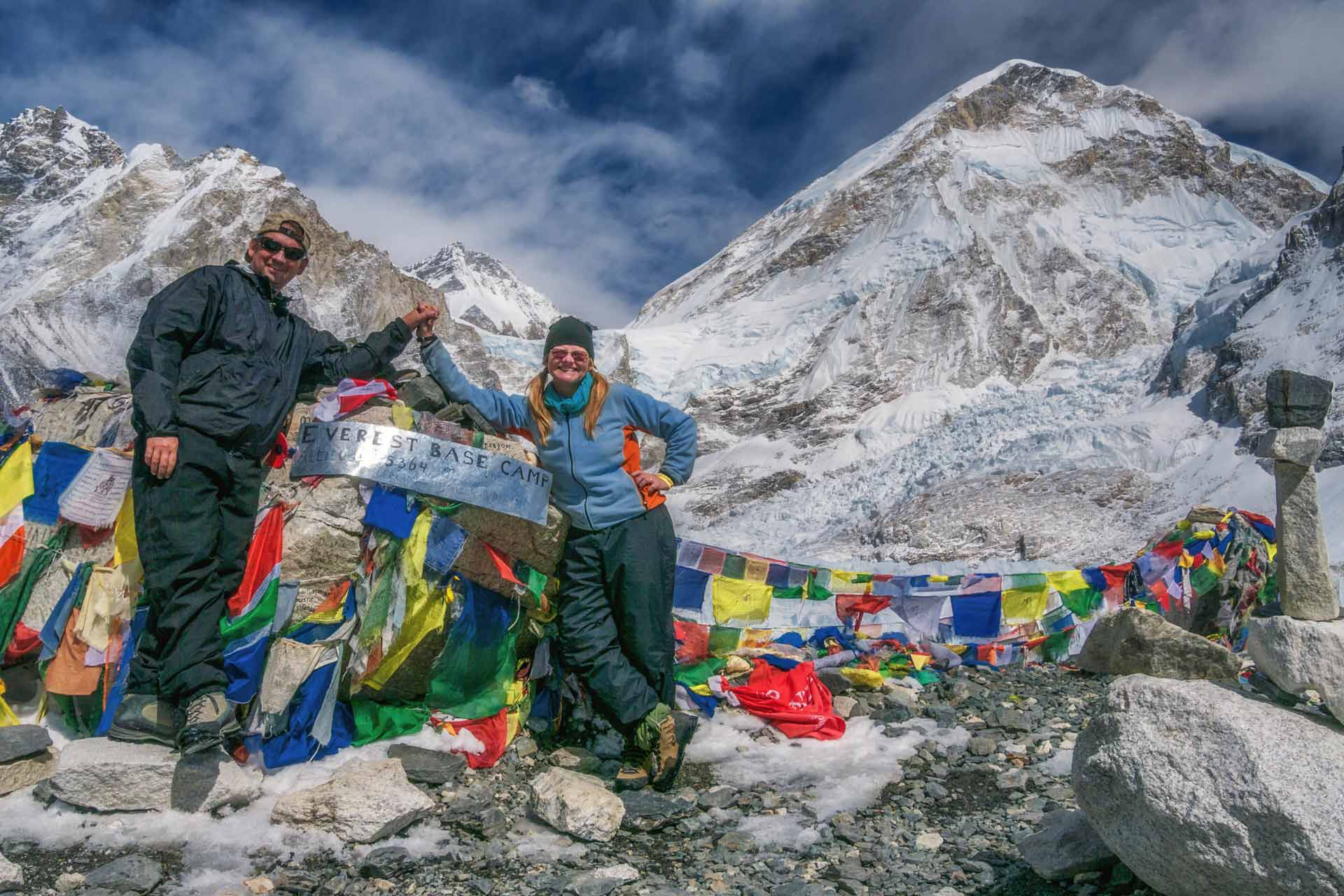
Table of Contents
Trekking to Everest Base Camp
What is it like trekking to Everest Base Camp in Nepal? The EBC Trek is life-changing, it’s exhilarating, and it is challenging. We share everything you need to know from planning your trek to Everest to packing for your trip. This guide to the Everest Base Camp Trek breaks down each day. So sit back and take a journey with us through Nepal’s legendary Sagarmatha National Park.
Everest Base Camp Trek Itinerary
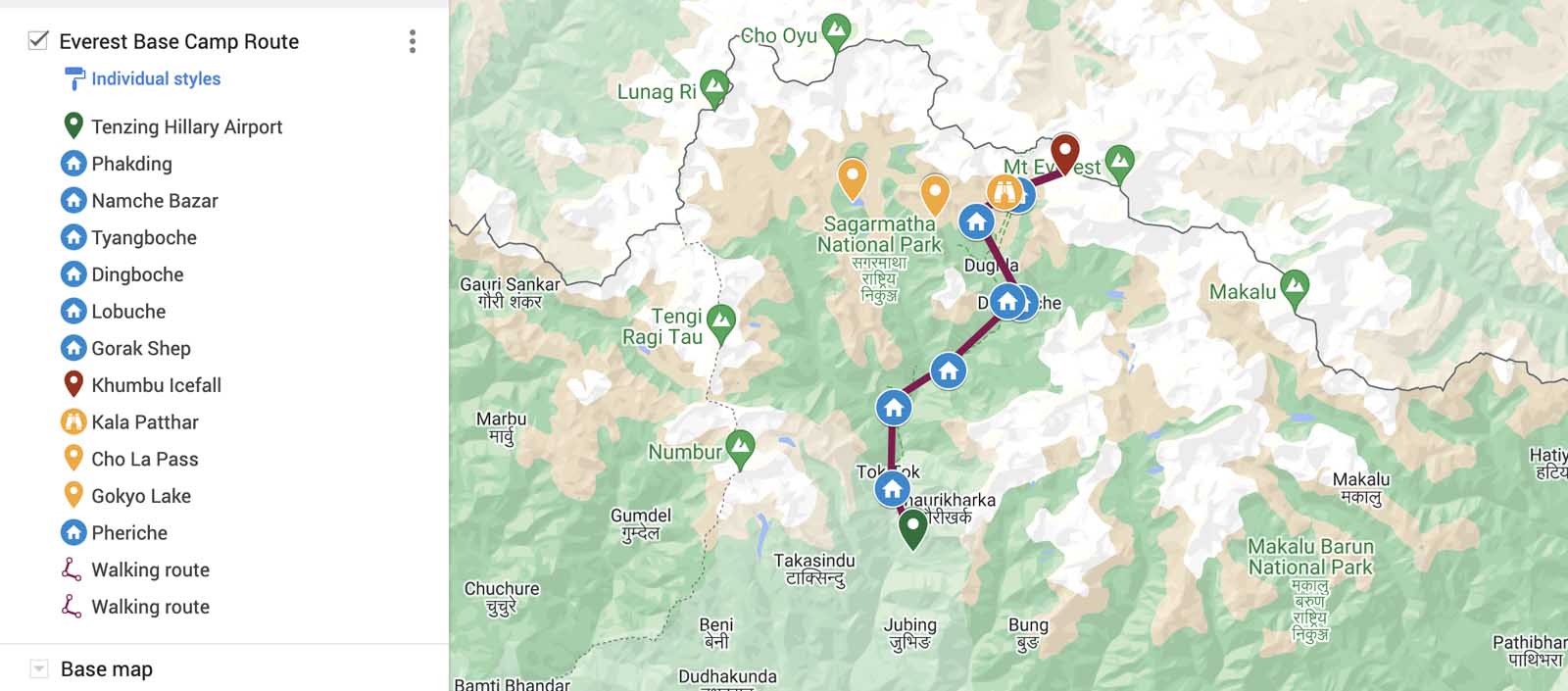
On the map, the Everest Base Camp trekking route distances look fairly easy to hike from village to village through the Khumbu Valley. Eight days may seem like it would be more than enough time to cover a mere 63 km (39 miles) one way, (128 km return) but with several sustained days in a row above 4000 meters (13,000 feet), the walk is slow and steady.
It is important not to push too fast to avoid altitude sickness which is a very real possibility. When trekking to Everest base camp, expect to hike anywhere from 7 – 17 km (4.5 – 10 miles) per day with the entire trek taking 12 – 14 days.
Hiring a Guide for the EBC Trek – Mandatory
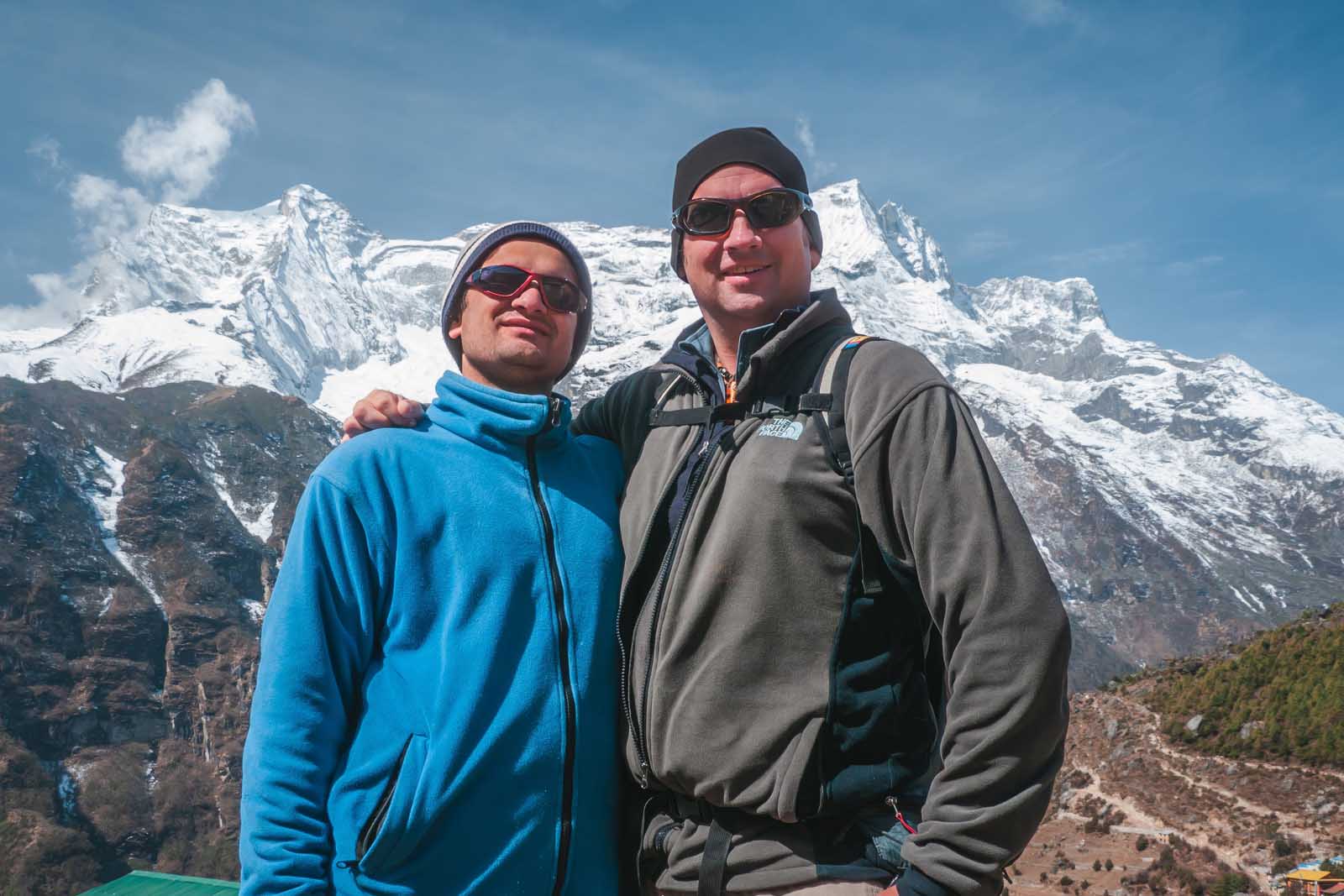
In April 1, 2023, Nepal has banned solo trekking. Foreigners must hire a guide for treks in high-altitude trekking regions of national parks. According to the Kathmandu Post in March “ solo or independent trekkers have to mandatorily hire a guide or a porter before setting off to Nepal’s mountains.” However, after an updated article in the Kathmandu Post, it seems that the Everest Region is an exception. Before booking, we would check with local companies and authorities as rules are constantly changing.
Book Locally
Many people book ahead of time with a tour company located outside of Nepal such as Intrepid Travel or GAdventures, but we hired locally and it saved a lot of money.
Plus, you know your money is going directly to the local economy and you have a more intimate experience by trekking with a local guide. We spent a couple of days in Kathmandu looking for a guide to Everest and found Simrik Real Nepa l owned by Kathmandu resident Dipendra Simkhada.
Dipendra planned the entire trip for us, and all we had to do was wait for him to pick us up at our guesthouse in Kathmandu to take us to the airport to board our Tara Air flight to Lukla Airport. Book your Trek to Everest Base Camp with Simrik Real Nepal – A Locally owned and operated tour company, Simrik is located in Kathmandu.
Kathmandu – The Hub of Nepal Treks
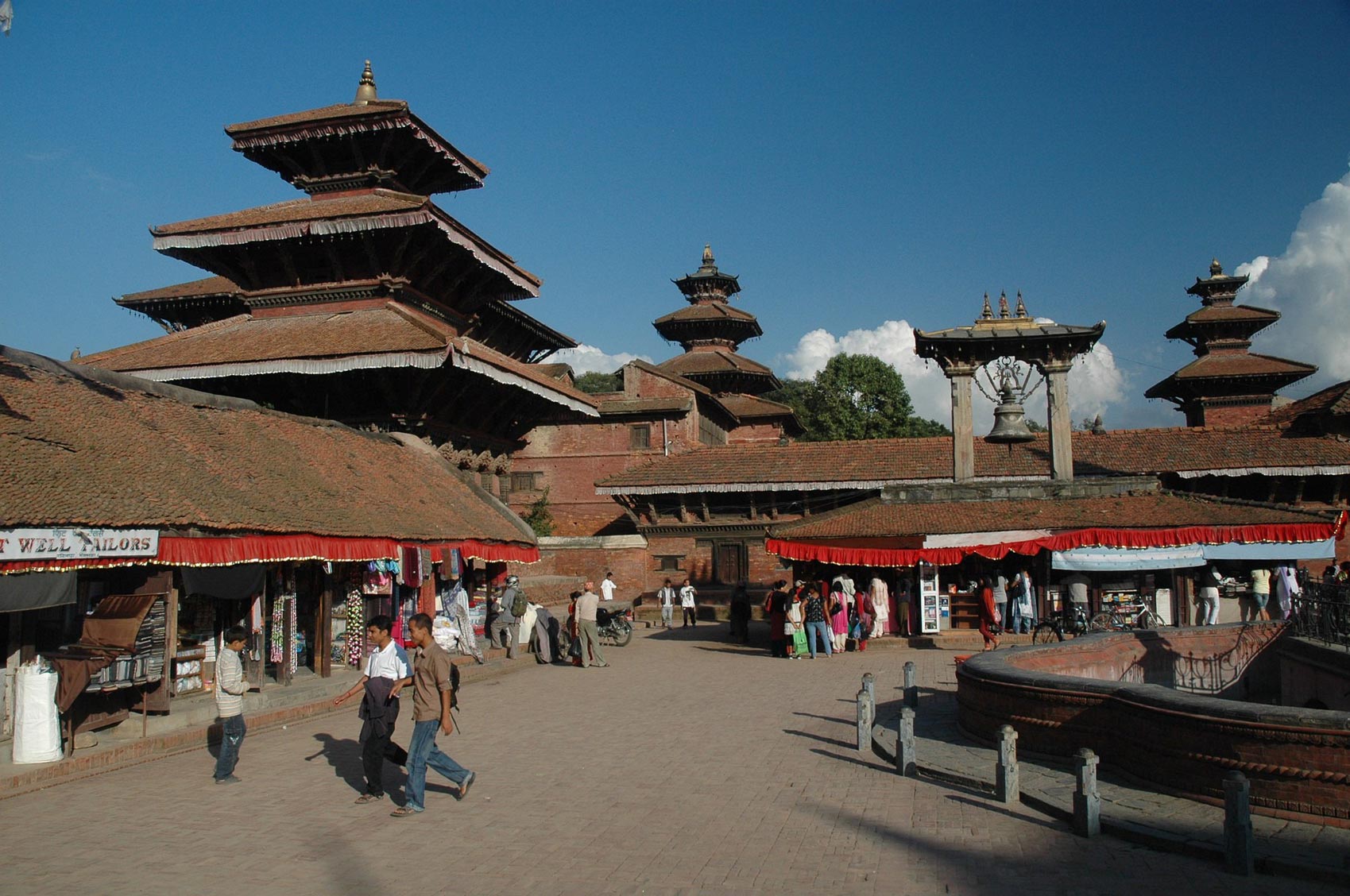
We spent a few days in Kathmandu picking up supplies and doing some sightseeing before trekking to Everest. We suggest not spending too long here as it can be very polluted in Kathmandu and by the time we were ready to trek, I was already quite congested.
Our recommendation is when you arrive in Kathmandu, only spend two to three days to get yourself organized and instead do your sightseeing at the end of your trek. Read more: Top Places to visit in Kathmandu, Nepal
Day 1: Fly from Lukla Trek to Pakhding
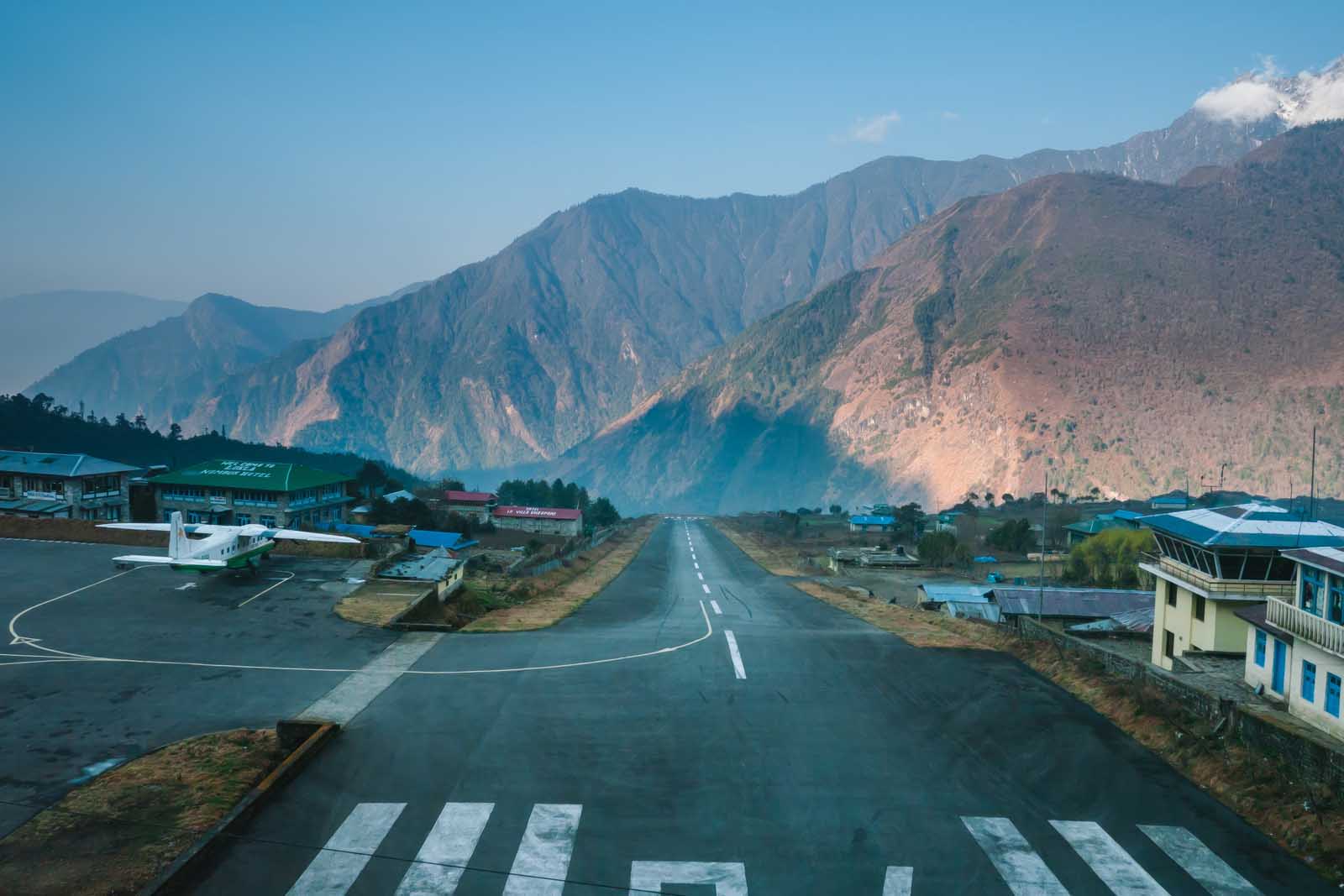
Flights to Lukla no longer leave from Tribhuvan International Airport (Kathmandu Airport) in Kathmandu due to congestion. Flights are now out of Ramechap airport which is a 4 1/2 hour drive from Kathmandu. You can book private helicopters from Tribhuvan International Airport.
The flight from Ramechap airport is much shorter than the flight from Tribhuvan International Airport. Flights to Lukla are only 12 minutes so more flights can get through when the weather is clear making flights less likely to be canceled or delayed for too long.
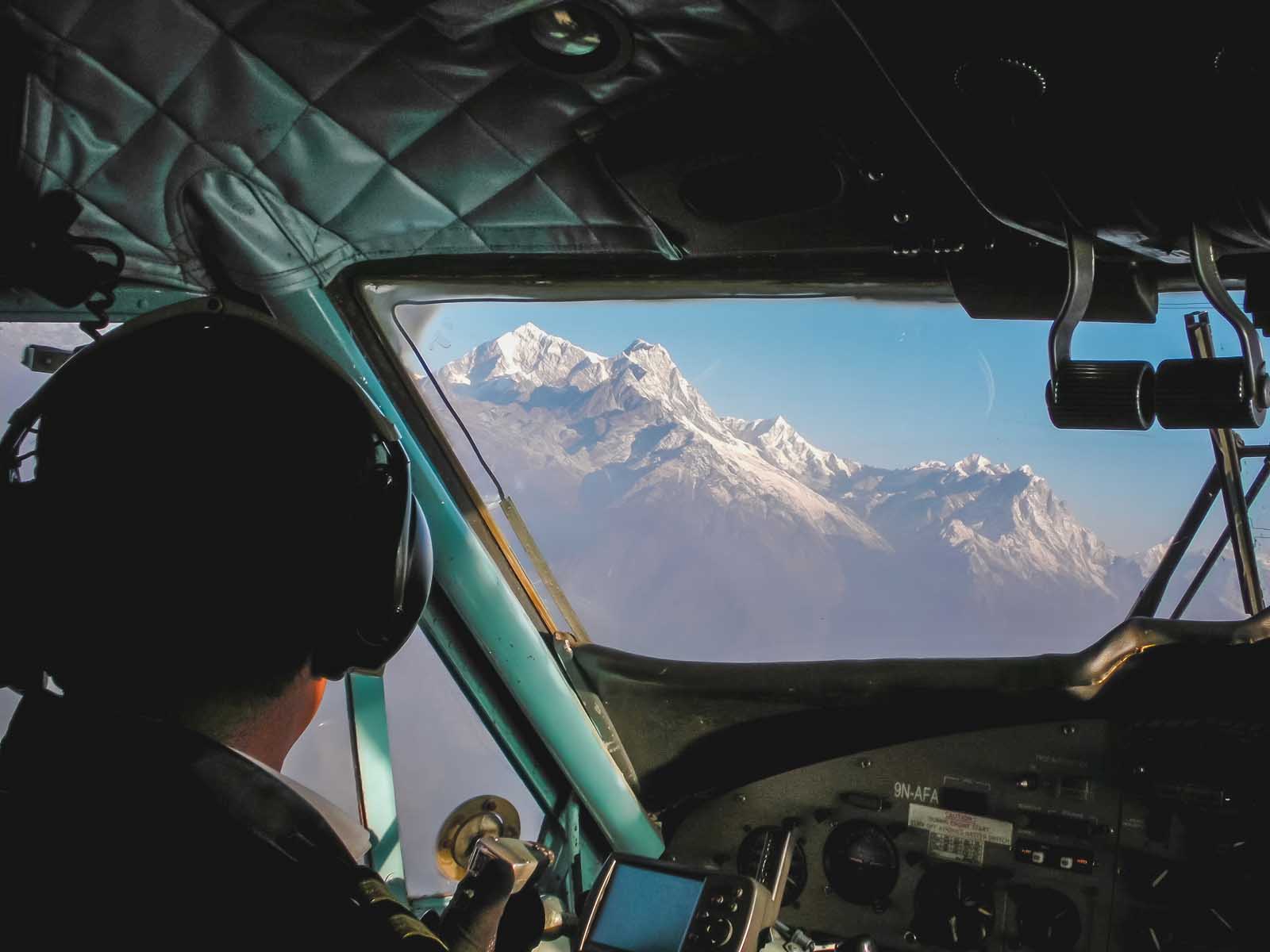
The flight to Lukla is a scary flight and is considered one of the most dangerous in the world. We flew from Kathmandu but flights now are much shorter from Ramechap. I think I would like it better as we sat at the front of the plane and saw the pilot’s instruments constantly flash “ obstacle ahead. ” It looked as if we were about to crash into a mountain at any time. Read all about our flight to Lukla and watch the video here
Watch Us Fly to Lukla Airport
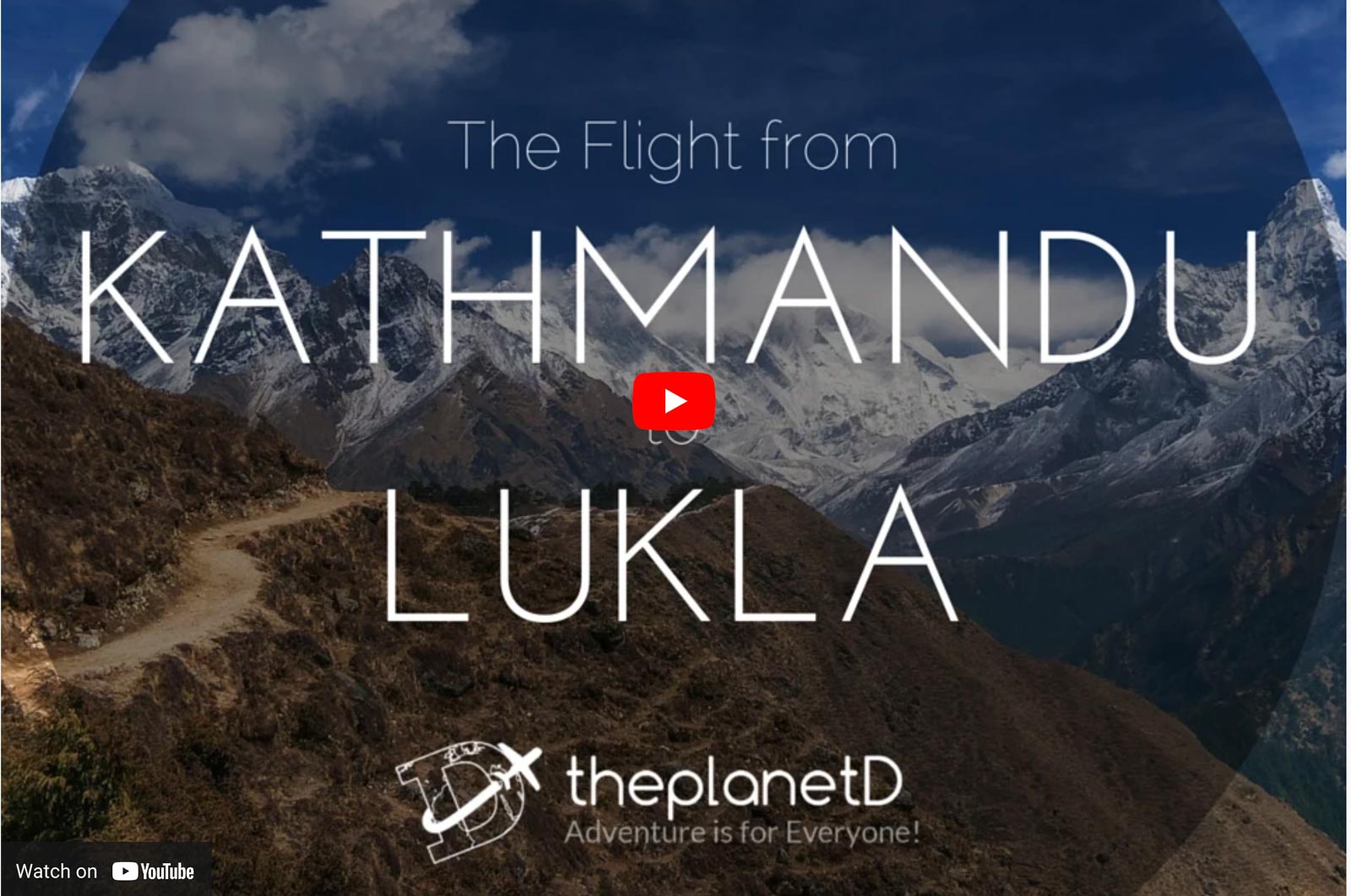
The Lukla airstrip at Lukla Airpot is a short landing strip at only 525 meters (1,729 feet long.) Built on the side of a mountain it is also a very steep grade that is needed to slow the planes down quickly. Needless to say, we held our breath during the landing.
We survived that flight, but it was the flight back to Kathmandu I was nervous about. Taking off on that short of a runway was a hair-raising experience. One false move and we’d drop thousands of feet into the valley below. Lukla Airport is actually called Tenzing Hillary Airport named after the first two men to summit Mount Everest.
Hiking from Lukla to Pakding
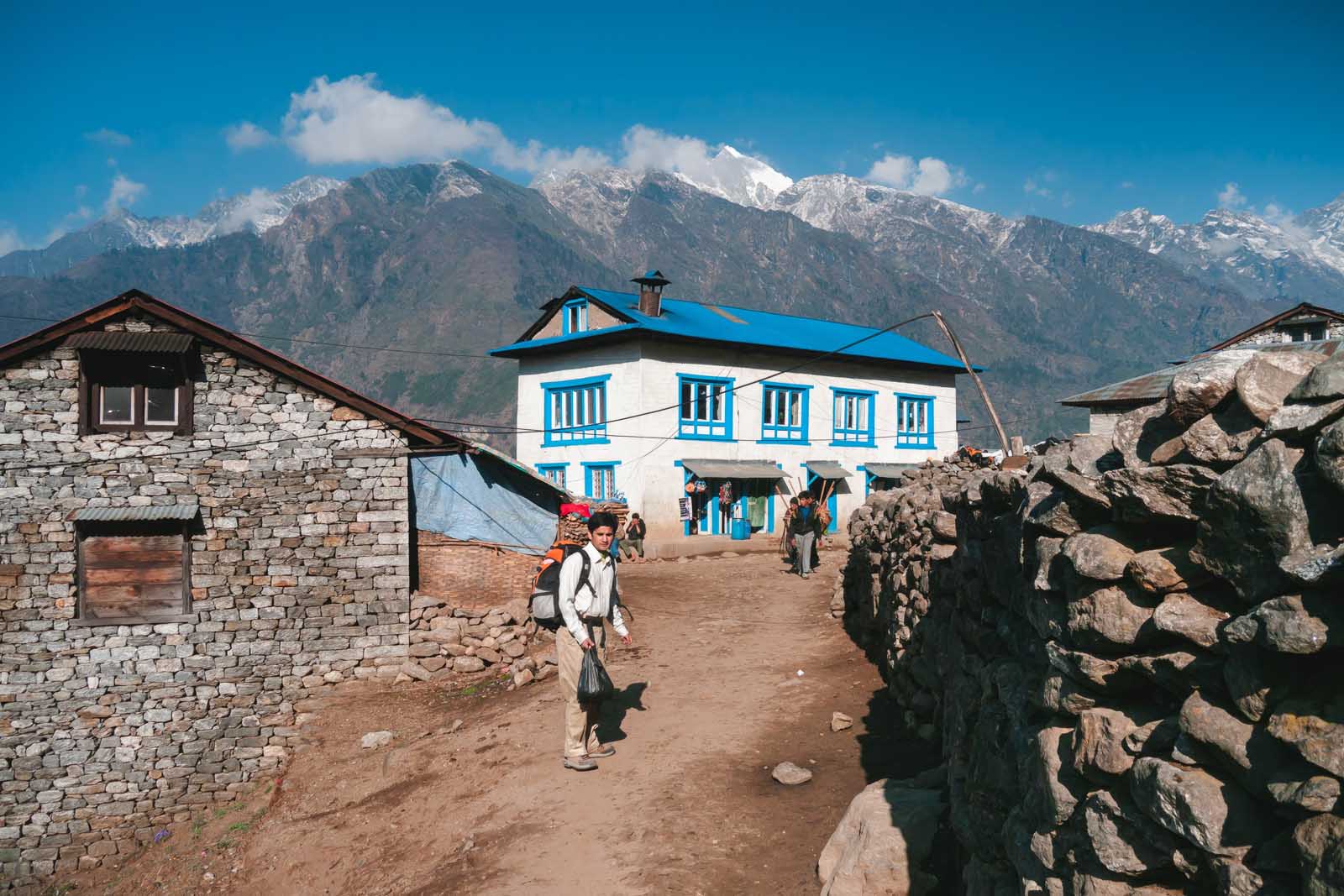
The trek begins officially in Lukla. Lukla is a busy town with plenty of accommodation, shops, and eateries. If you forgot anything for your EBC trek, you can pick up supplies in a pinch. But we suggest purchasing all your gear in Kathmandu. It is much cheaper.
From Lukla, we immediately started our Everest Base Camp hike. After a quick snack and a cup of tea in Lukla, we set off on an easy three-hour trek along trekking trails that were easy to follow weaving through villages, crossing rivers, and stumbling over stony paths.
Entering Sagarmatha National Park
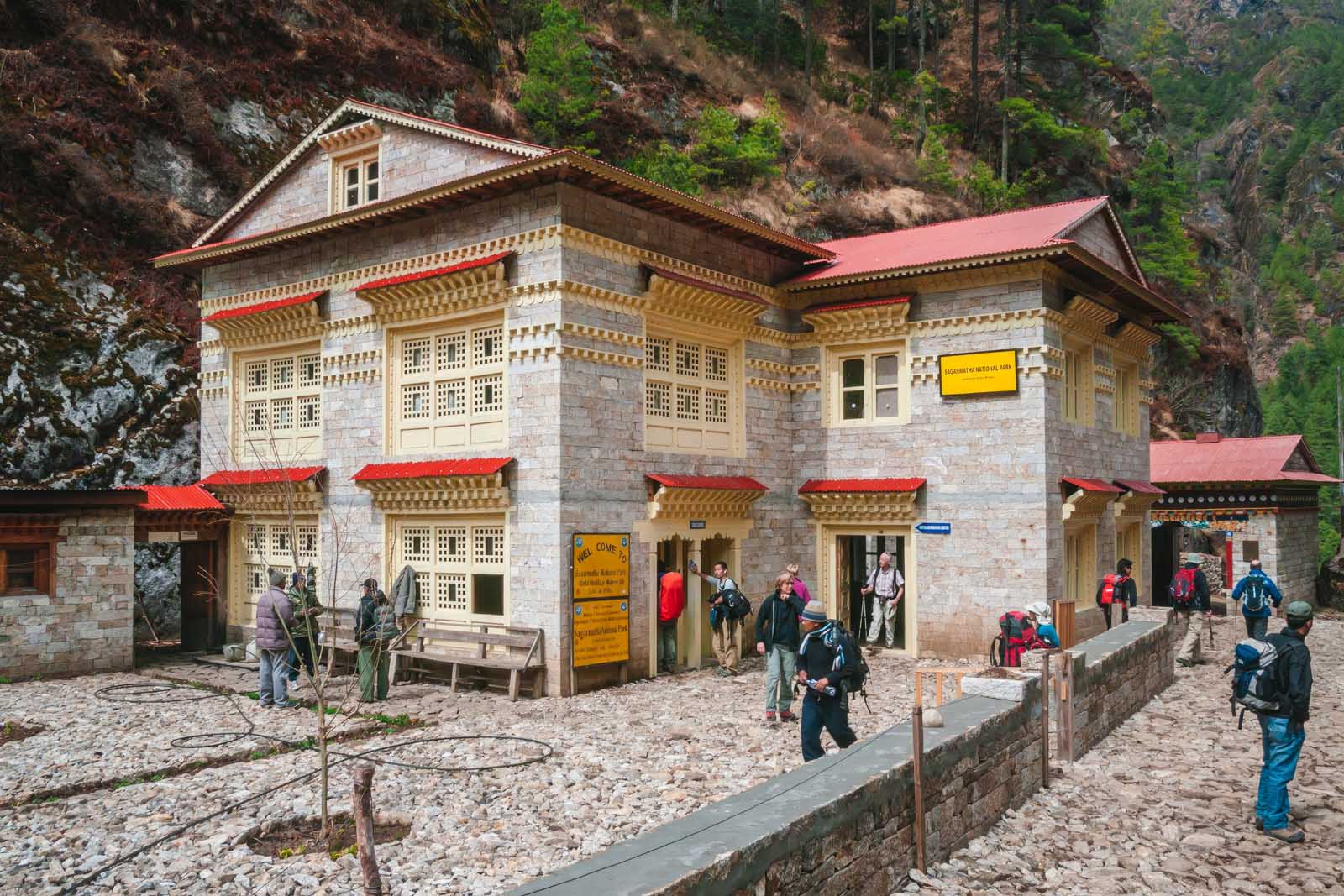
A permit is needed to hike to Everest Base Camp as it is located in Sagarmatha National Park. We checked in with the national park headquarters and Dipendra took care of everything. He had all our paperwork in order so all we had to do was start walking through the beautiful Khumbu Valley to make our way to Everest base camp.
Sagarmatha National Park has been a UNESCO World Heritage Site since 1976. At 1148 square km (443 square miles) in area, it is one of the most beautiful places we have ever visited.
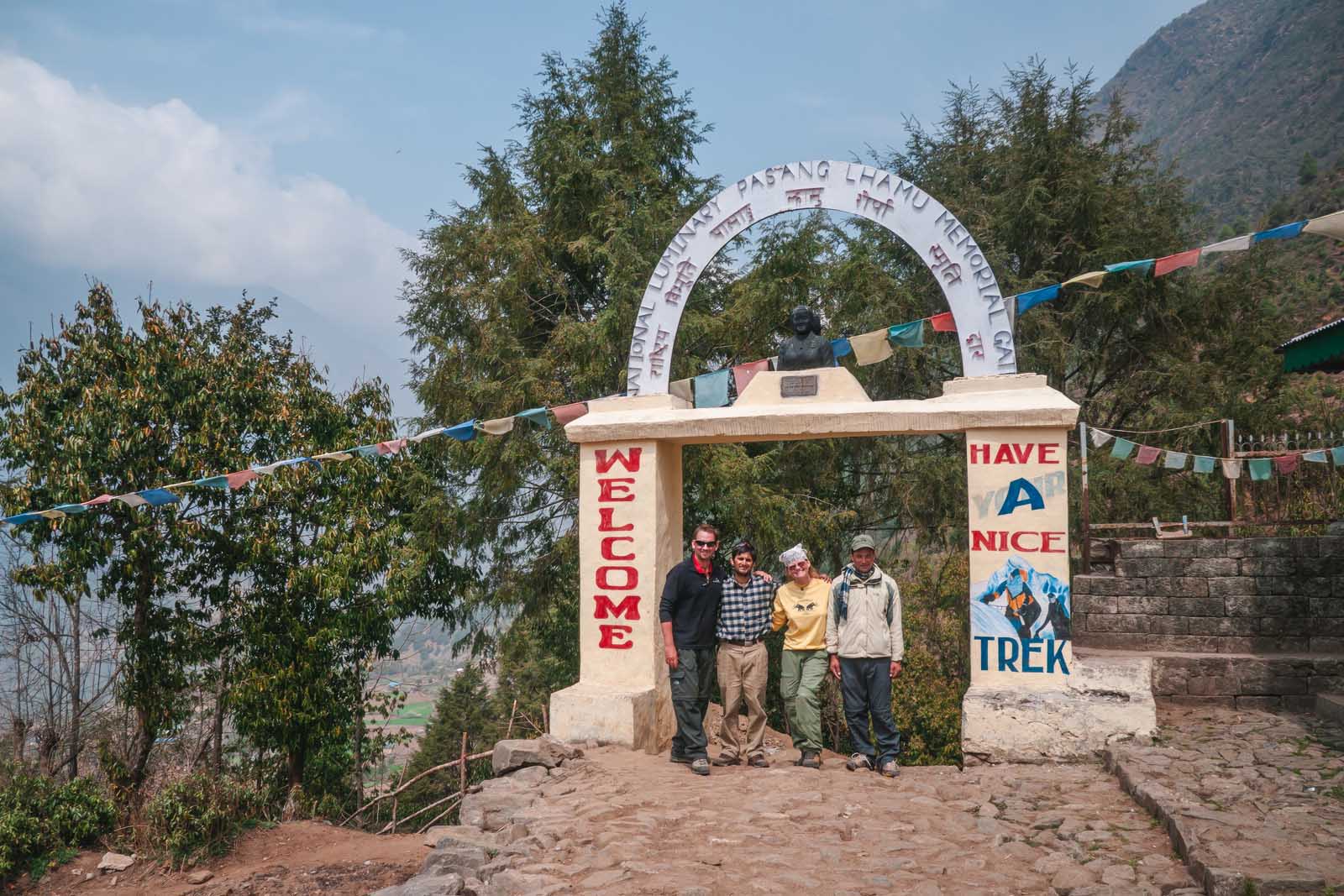
We felt giddy stepping through the welcome gates located just outside of Lukla. This was it, we were following in the footsteps of the great adventurers of our time. It was awe-inspiring to hike through the Khumbu region surrounded by the Himalayas.
As we hiked out of Lukla, Dipendra pointed out the surrounding jagged white peaks named Kwangde, Mumbu, and Kishumkongara. At 6000+ meters, (19,000+ feet) these are the “little guys” of the world’s highest mountain range. It wouldn’t be long until we were among the famous 8000-meter (26,000 feet) peaks.
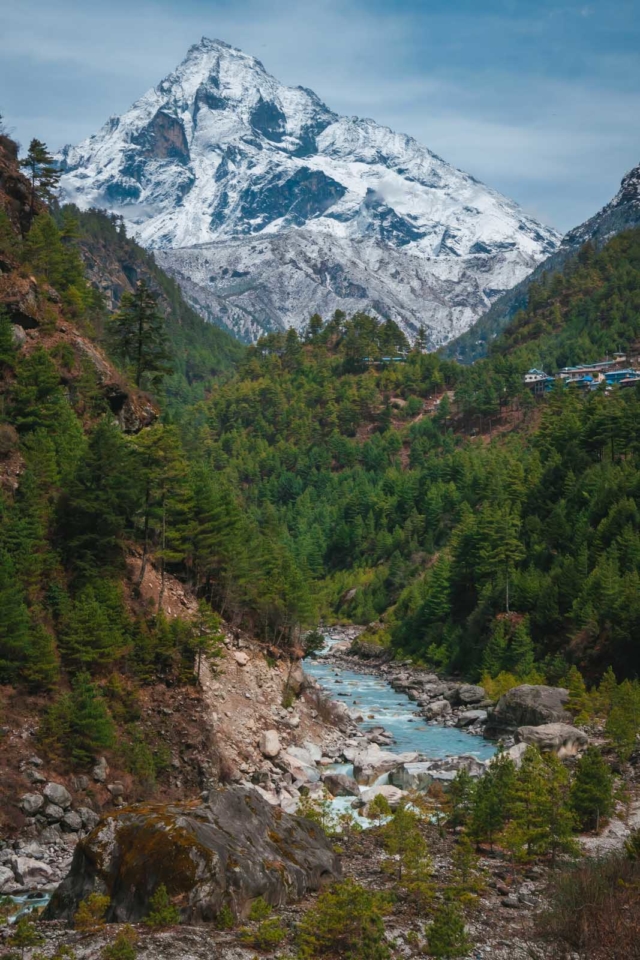
Our first day was filled with a relaxing walk while learning about the Khumbu region. It was quite early in the day, so we had plenty of time to take our time to learn about the customs of climbing and learn the names of the mountains found in this beautiful region of Nepal.
For the rest of the day, we followed the Dudh Koshi River Valley at a steady but leisurely pace to the village of Pakding. Temperatures were warm and the first day of trekking was comfortable. Lukla to Pakding actually has an elevation loss, so it is a good introduction to hiking through the region as we had a lot of downhill trekking.
After about 5 hours, we came to our first night on the trek where we spent the night in a comfortable teahouse in the village of Phakding.
Our First Night on the EBC Trek
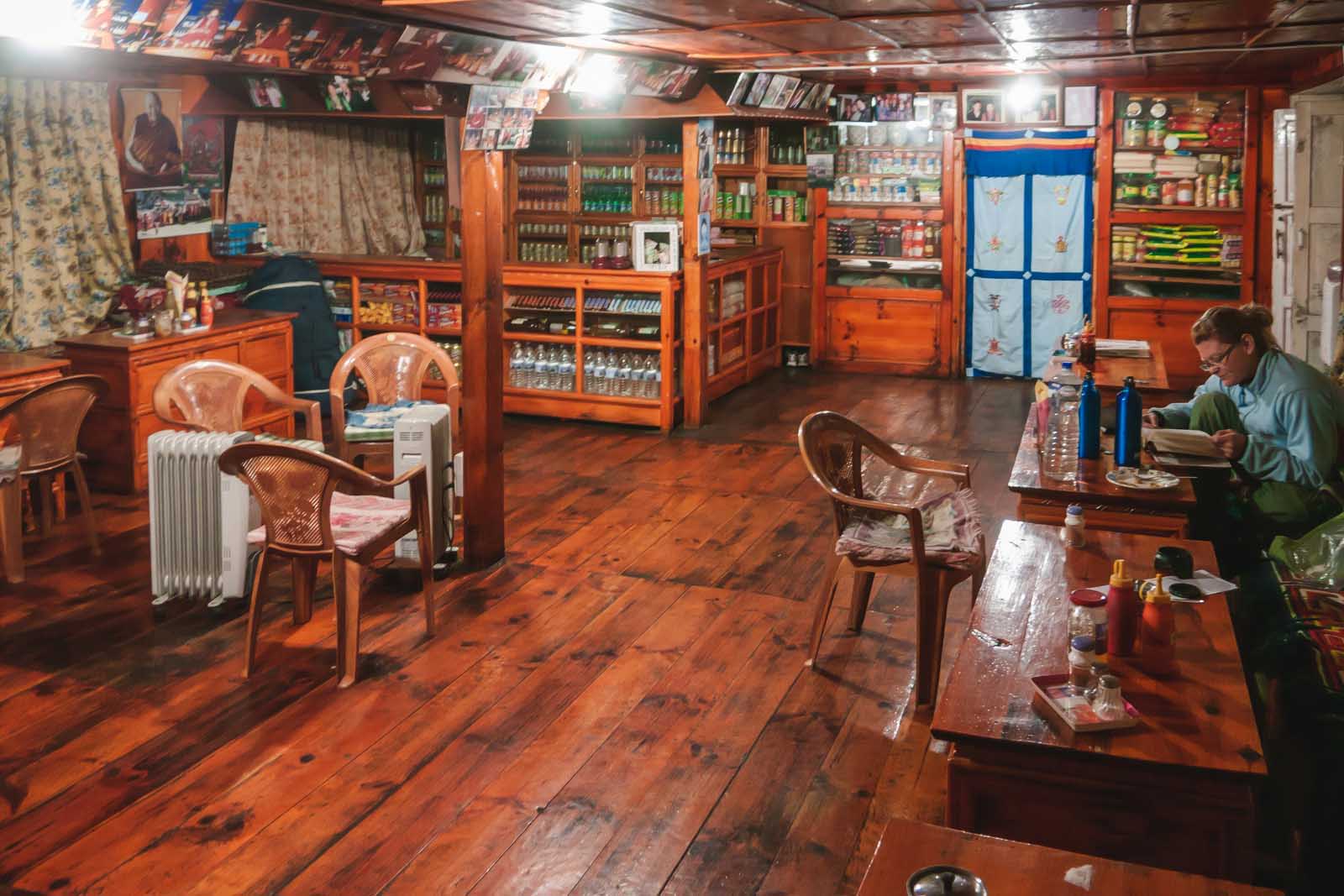
The accommodation in Pakding was a quaint little hotel/teahouse that looked like a cottage. The wood-burning stove smelled delicious as it warmed the restaurant while they prepared our meals.
Our porter “Sher” carried all our supplies including the sleeping bags that we borrowed from our trekking company. We each rented a sleeping bag that was included in the price of our EBC trek. The beds were comfortable and Dave and I had private rooms. Some tours use dorm rooms but we had private rooms. Toilets were shared, but everything was clean and comfortable. The rooms were clean and we slept like rocks snuggled up in our thick down sleeping bags.
Heated Lodges – Teahouses on the EBC Trek
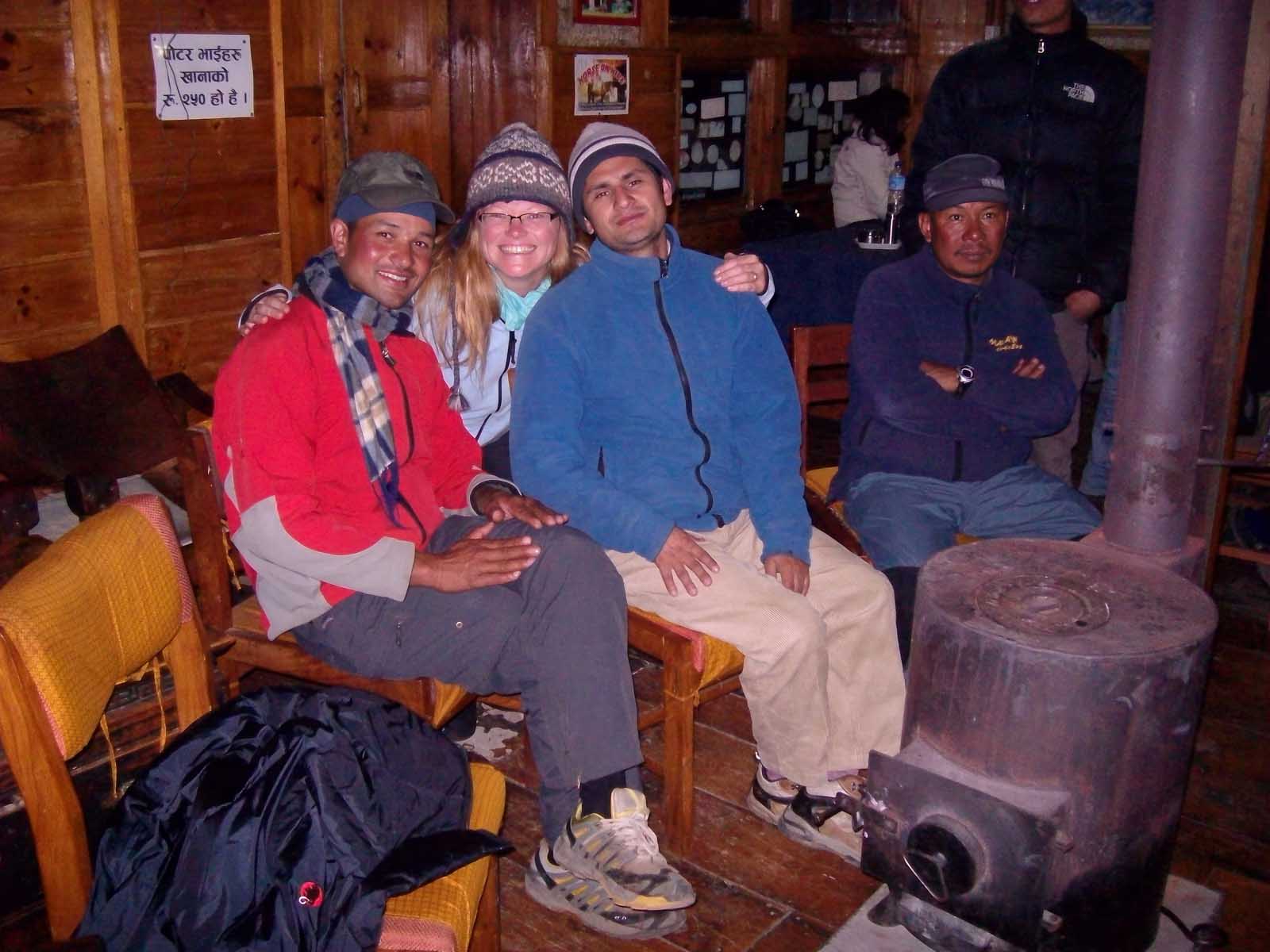
During the EBC Trek, you don’t stay in tents. You stay in charming teahouses with cozy beds, wood-burning stoves, and fully stocked restaurants that serve dinner.
The teahouses are a welcoming sight after a long day of trekking helping to make the trek to Everest one of the most memorable experiences of our lives. If you are planning to trek to Everest Base Camp in Nepal, read on for all the information you’ll need to help you prepare.
The main lodges of each teahouse we stayed in during the first half of our EBC trek were cozy and warm. At the lower elevations, woodstoves burned wood in the dining room and common areas and our rooms were a comfortable temperature with heating as we were wrapped up in our sleeping bags. We ate hearty meals of pasta and meat and enjoyed a relaxing night soaking in the amazing day we just had on the mountain.
- From Lukla – Elevation 2869 meters (9,350 feet)
- To Pakding – Elevation 2610 meters ( 8563 Feet)
- Length – 7.7 km (4.78 miles)
- Elevation loss – 79 meters (259 feet)
- Duration – 3 Hours
Day 2 – Pakding to Namche Bazaar
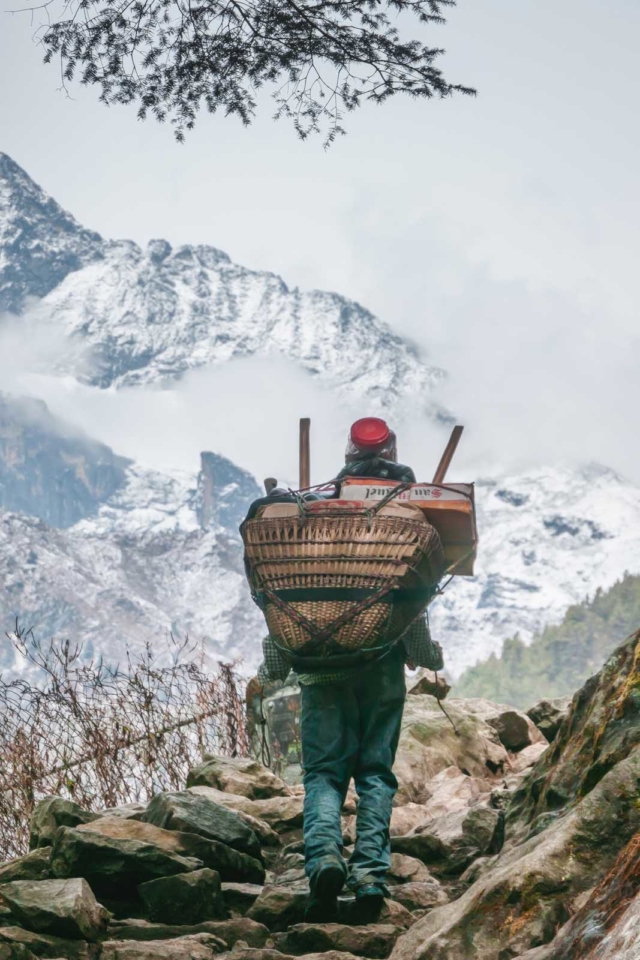
On day two, we checked in at another gate of the Mt. Everest park headquarters to show our documentation. We had to show our passports and give them extra passport photos to go into the log. (So make sure you have extra passport photos with you) Once we signed in, we were officially in the Khumbu region and officially on our way trekking to Everest Base Camp.
We covered a lot of terrain on day two making it the longest day of the Everest Base Camp trek. The trail up the mountains was steep and challenging but it was a memorable day.
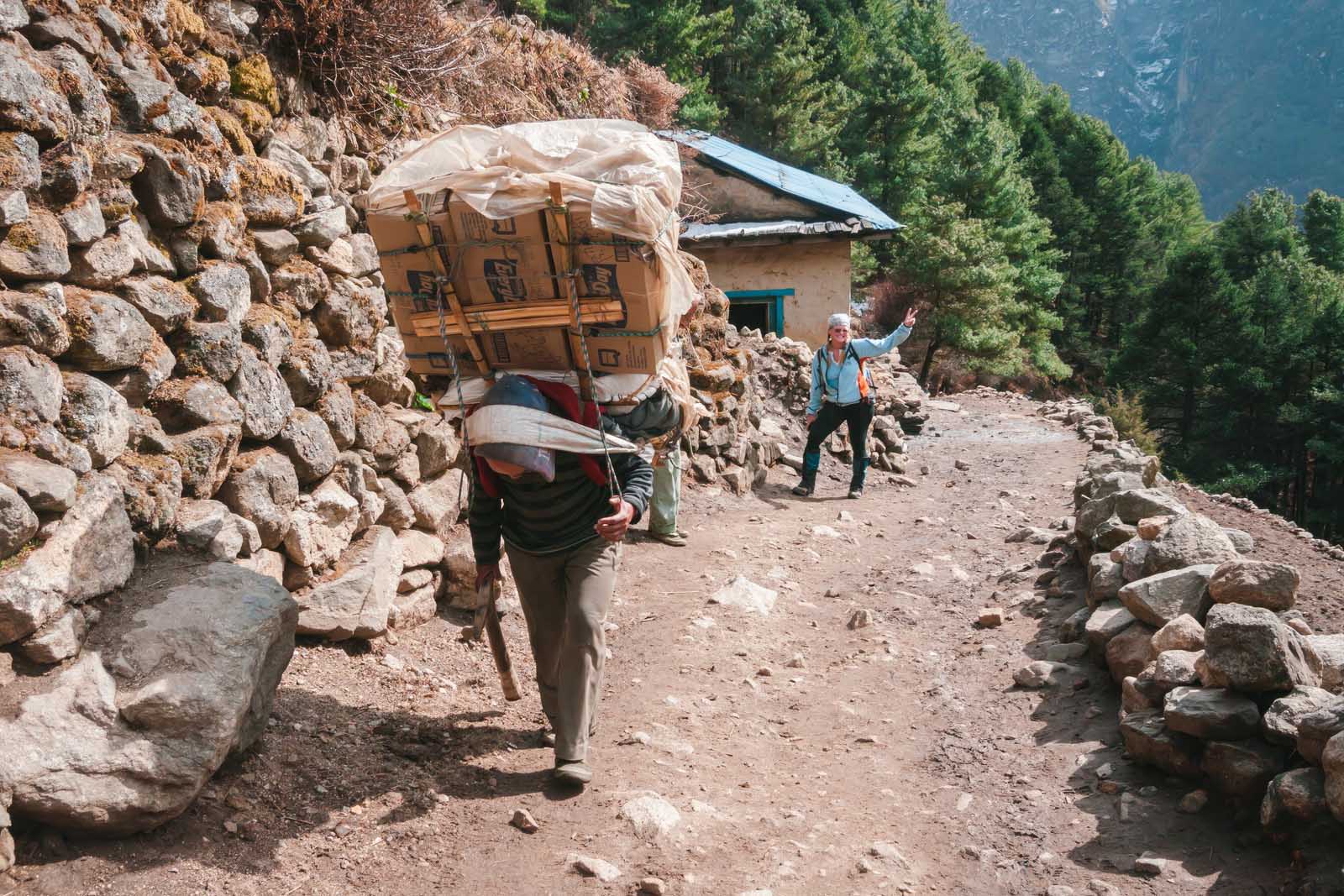
Day two of the EBC trek was a hike of almost 10km (6.2 miles) with an elevation gain of 800 meters (2624 feet). But throughout the hike, there was a lot of elevation loss mixed in so it felt like a lot more.
We would lose elevation as we descended into the valley only to have to climb back up again to a higher elevation. Today was a lot of fun though because we crossed several suspension bridges over Dudh Kosi River Valley.
Suspension Bridges on the way to Everest
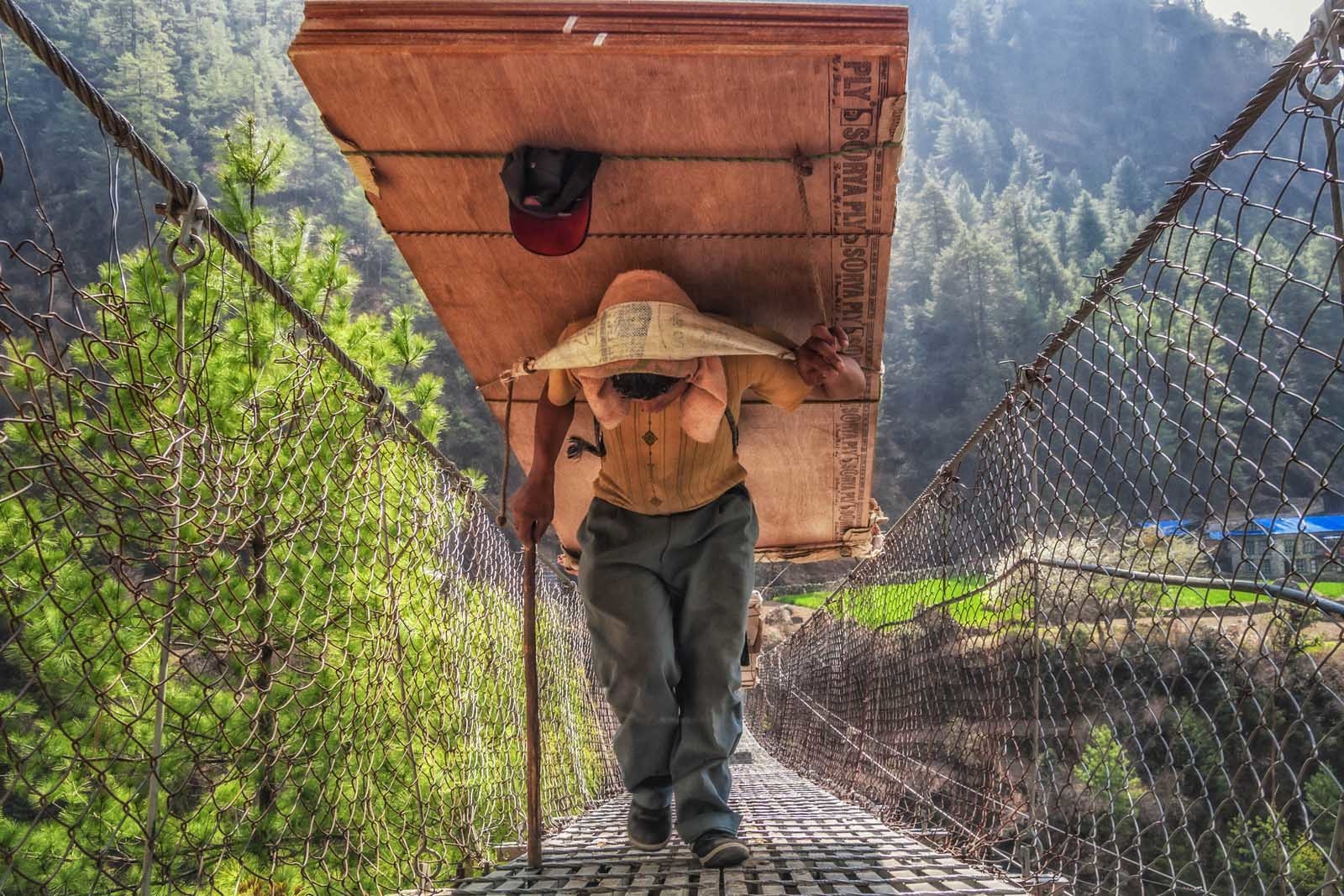
If you have a fear of heights, crossing suspension bridges may not be your favorite moment, but the suspension bridges while trekking to Everest Base Camp are well constructed, made of steel, and in excellent condition.
I was nervous about the suspension bridges. The Lonely Planet Guide said, “ Grit your teeth and climb onto a drooping suspension bridge floating at a dizzying height .” That sentence freaked me out.
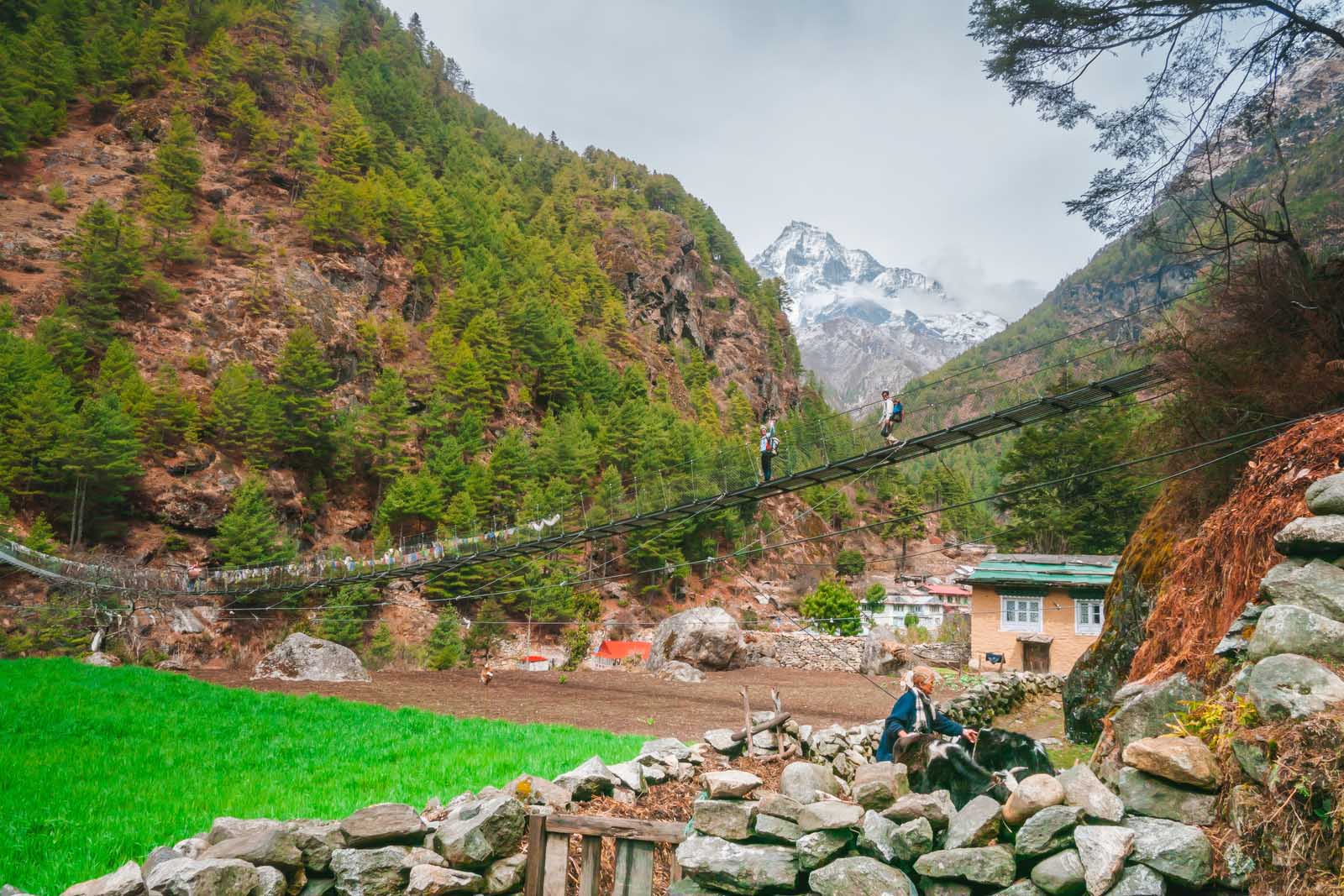
I had built the suspension bridges of the EBC trek in my head as something monstrous. But by the time we reached the first bridge, I wondered what all the fuss was about. Once I crossed my first bridge, my confidence was up and I was ready for anything the Everest trek was ready to throw at me.
Donkey Trains
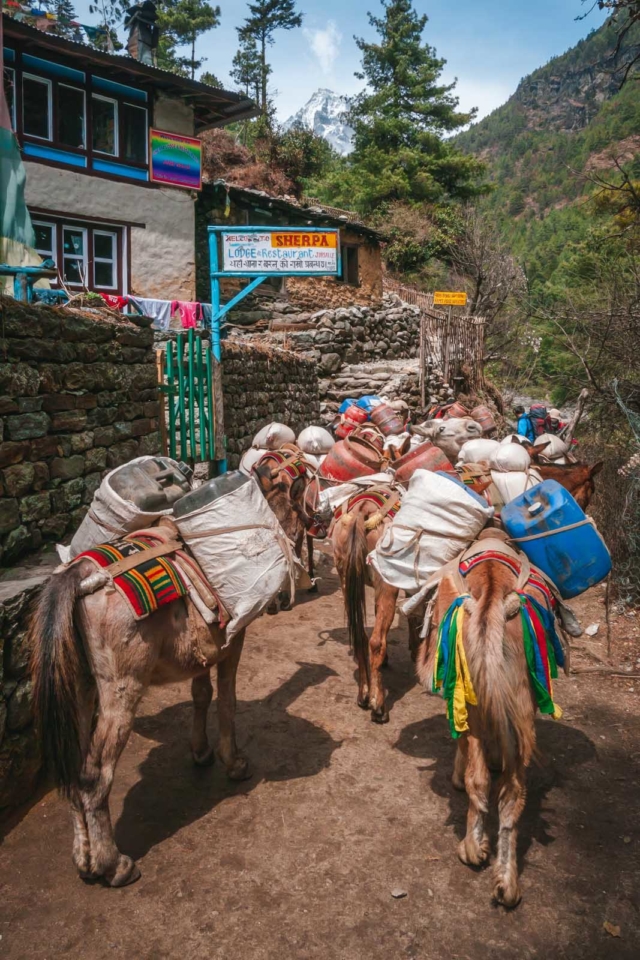
Today we also started to see a lot of donkeys, cows, and goats taking supplies to the villages. Traffic can get very heavy on the Everest Base Camp hike. When animal trains go by, make sure to get out of their way and stay to the side.
They are loaded down with heavy gear and they have a mission to keep on walking until they are done. They can easily nudge you right off the side of a cliff as no matter what is in their way, they just keep walking.
The trail is a highway, but instead of transport trucks or trains carrying cargo, people and farm animals carry everything from lumber and building supplies to food and kitchen appliances.
Safety Tips on the Everest Base Camp Trek for yaks and donkeys
- Important Tip: When a yak, donkey, or cow train passes you during the EBC trek, be sure to stand on the mountainside of the trail so they can’t push you over the edge !
- It is better to be squished into a mountainside than to go tumbling over the edge!
Final Stretch to Namche Bazaar
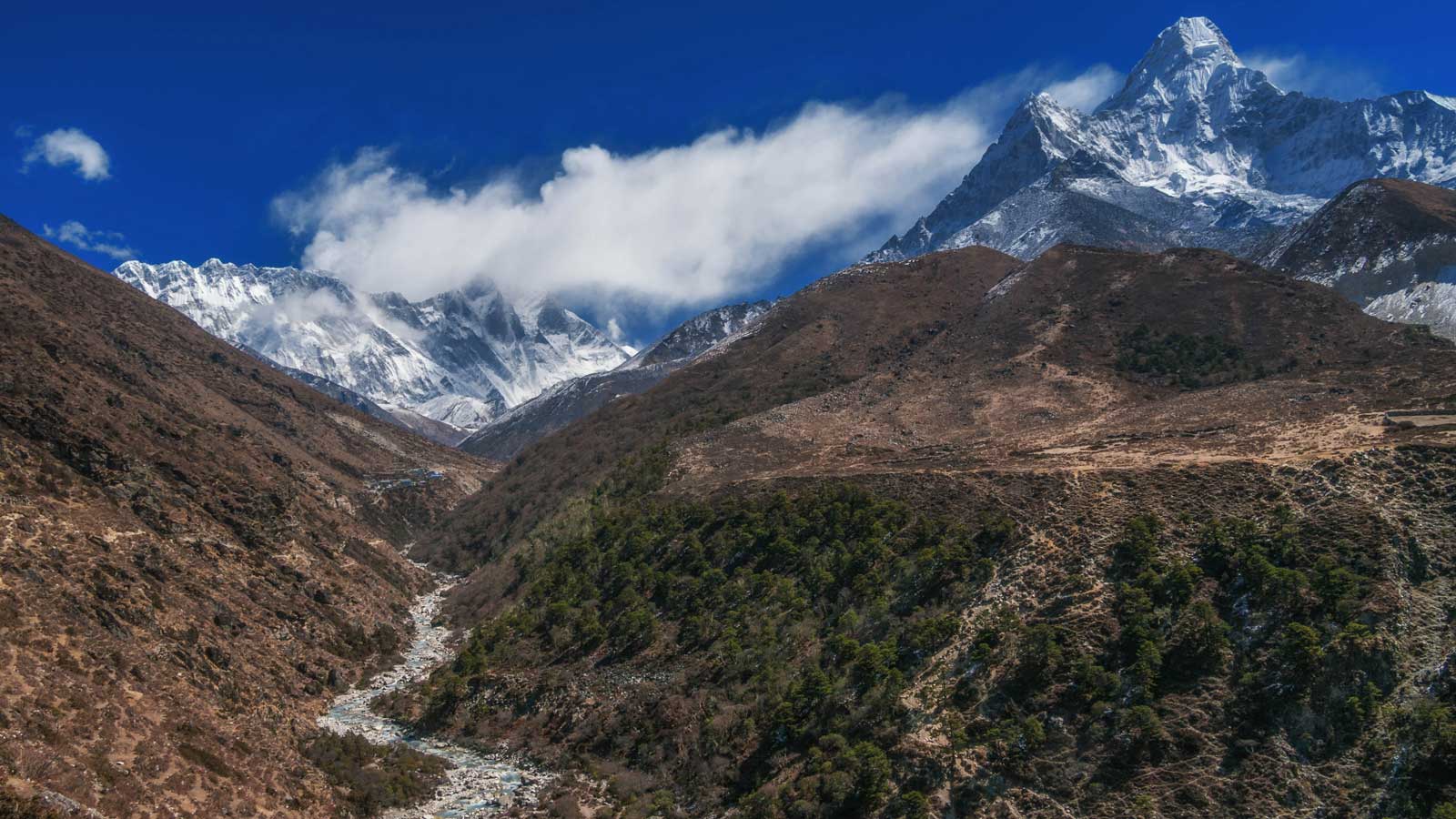
Right after crossing the last bridge, the hardest part of day two of trekking to Everest base camp started The last push of the day consisted of 2-hours straight uphill to Namche Bazar.
We were drenched with sweat but the air was cool. Whenever we stopped for a break, we would get a chill so we just kept on chugging away.
Large tour groups passed us quickly, only to be caught a few minutes later as they rested. We realize that we were the tortoise and they were the hare! Slow and steady is the way to climb at high altitudes and in the end, we made it to Namche Bazaar with plenty of time to spare in the day.
Arrival to Namche Bazaar
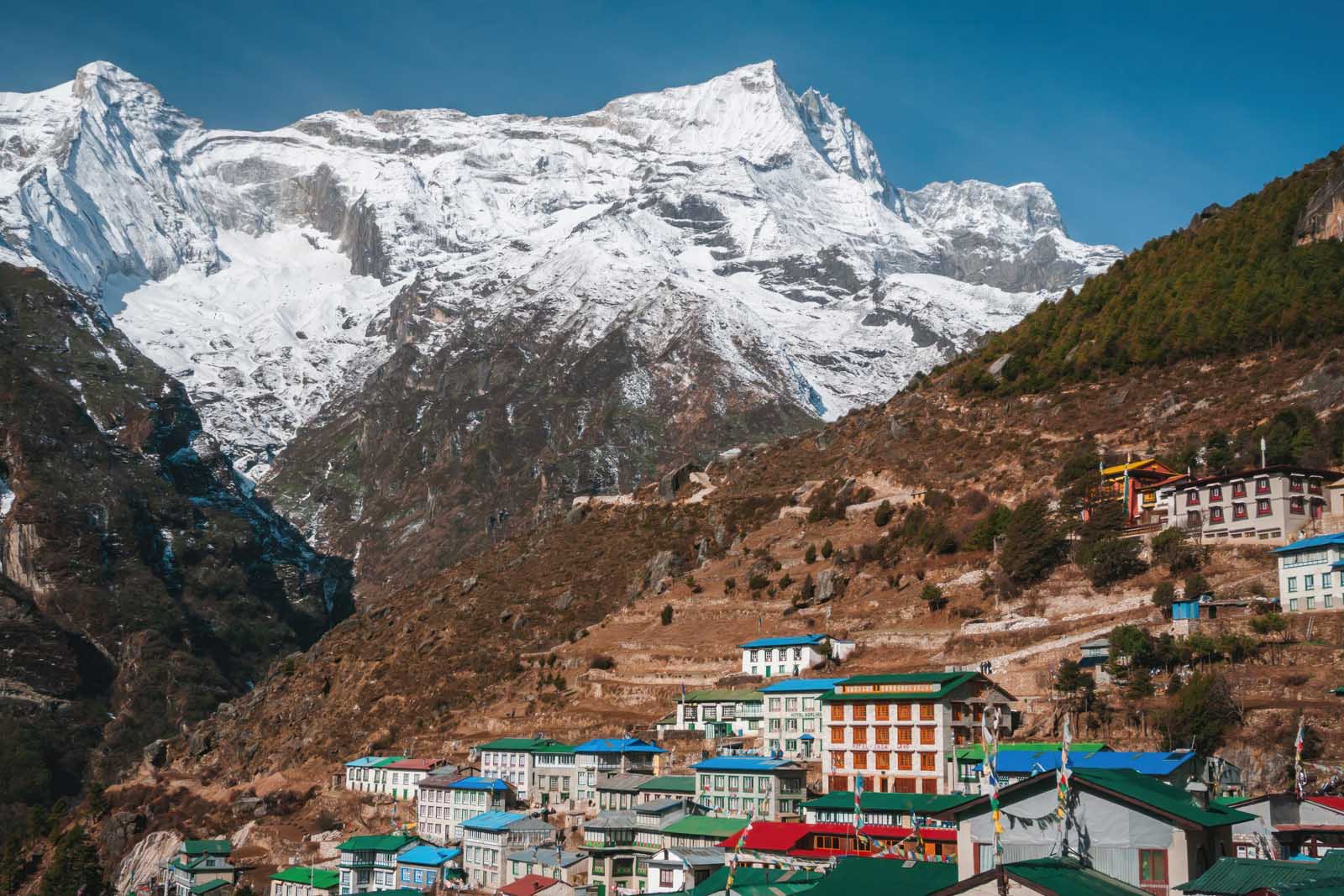
We checked into the security post and cringed when we found out that our lodge was an uphill walk for another 20 minutes. Rest had to wait a bit longer.
When we arrived at our accommodation, we were thrilled to see our porter Sher’s smiling face. He had already checked us in and put our bag in our room. We immediately went for a nap and then did a little walking around town in the evening to do some shopping and grab a bite to eat before turning in for an early night.
There are plenty of shops and restaurants at Namche Bazaar, this town is bustling and we spent two nights of our EBC Trek here which was awesome.
Pakding – Elevation 2610 meters ( 8563 Feet) Namche Bazaar – 3440 meters (11,286 feet) Elevation Gain – 830 meters (2723 feet) Distance – 10km (6.2 Miles) Duration – 6 hours
Day 3 – Acclimatization Day at Namche Bazaar
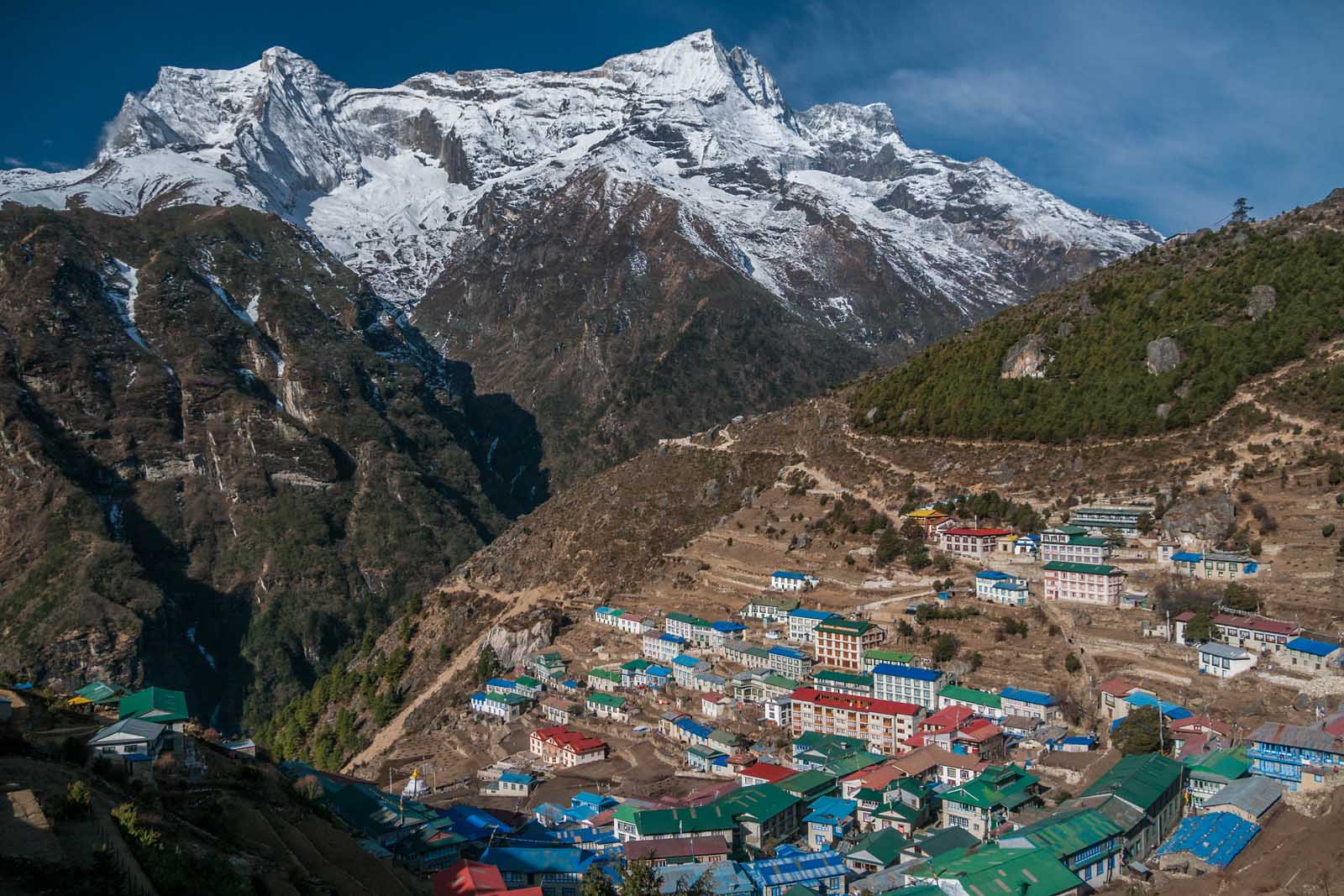
We had two glorious days at Namche Bazaar. Dipendra chose great accommodation for us throughout our EBC trek and we had a good rest in this splendid teahouse where we enjoyed delicious pasta, meats, and of course dhal baht. We spent the morning enjoying coffee and doing a bit of shopping.
What to do in Namche Bazaar
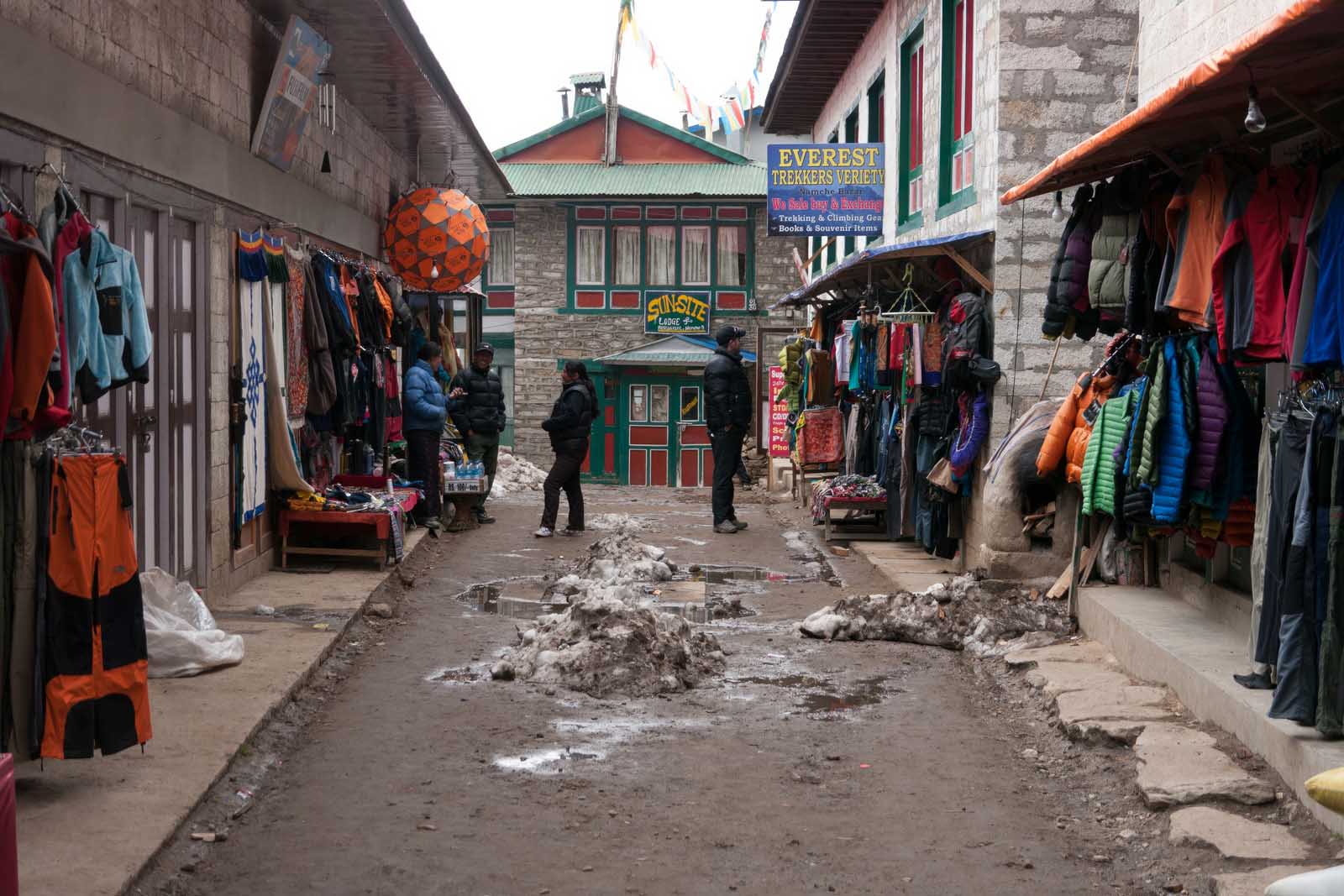
We explored Namche Bazaar and checked out its many shops. The streets are packed with shopping stalls and markets. We searched for gear that we missed getting in Kathmandu and got some great deals. We were surprised the prices weren’t inflated at Namche Bazaar.
We bought some down booties to keep our feet warm at night, a couple of sherpa hats, and a warmer set of gloves. The Everest Bakery was a highlight with delicious apple pie, fresh coffee, and WiFi. We had two pieces each!
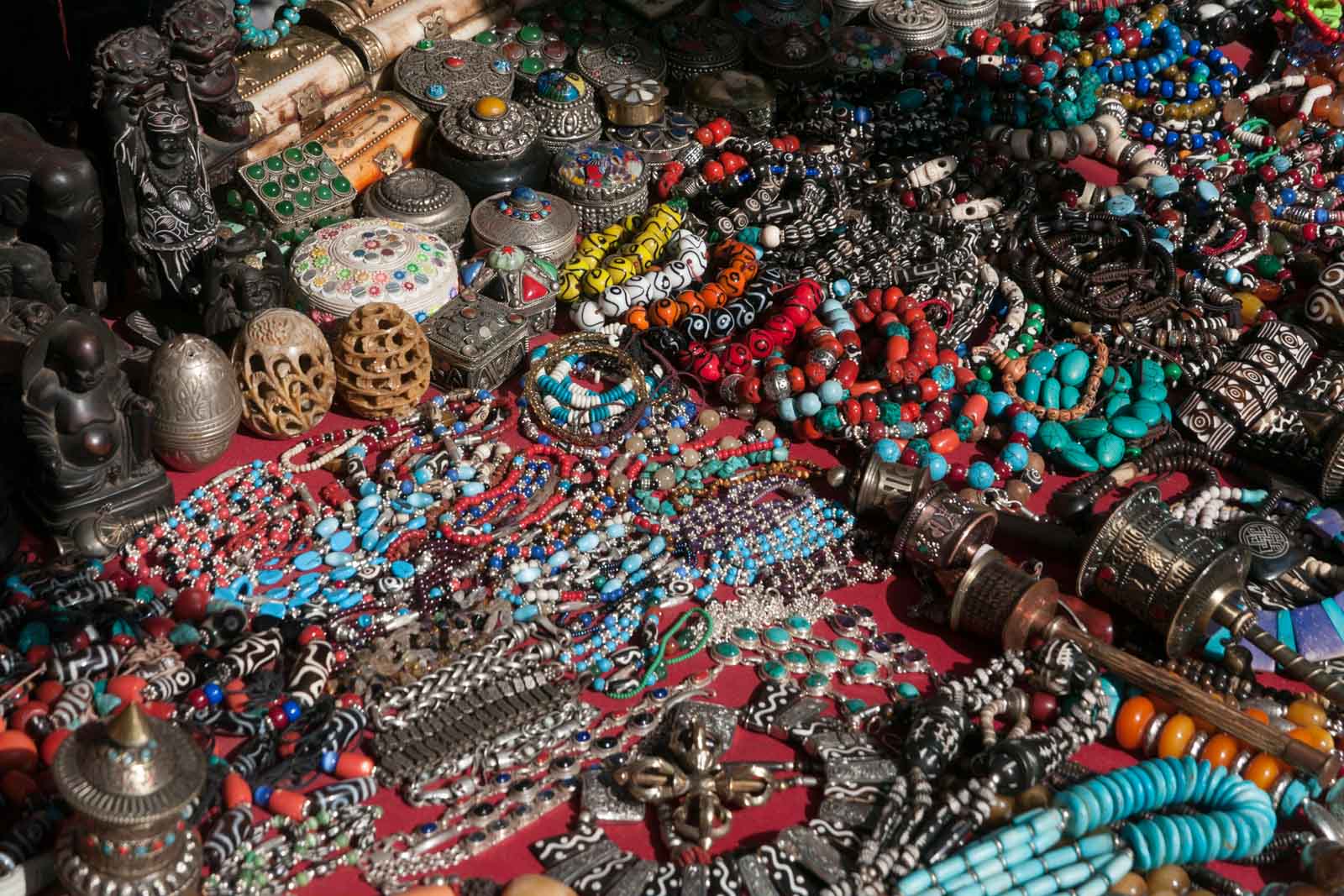
But we took it very easy, making sure to stay hydrated and to eat enough food to stave off altitude sickness. Namche Bazaar is located at a high altitude of 3440 meters (11,286 feet). We already saw a woman suffering from altitude sickness. She was having her blood pressure taken and heart rate monitored and when she got up, she was staggering as she leaned on her guide.
Her Everest base camp trek had already come to an abrupt end. It reminded us to relax because the days ahead were going to be tough. So we went back to our teahouse to relax and prepare for the rest of our journey
The Acclimatization Hike for EBC Trek
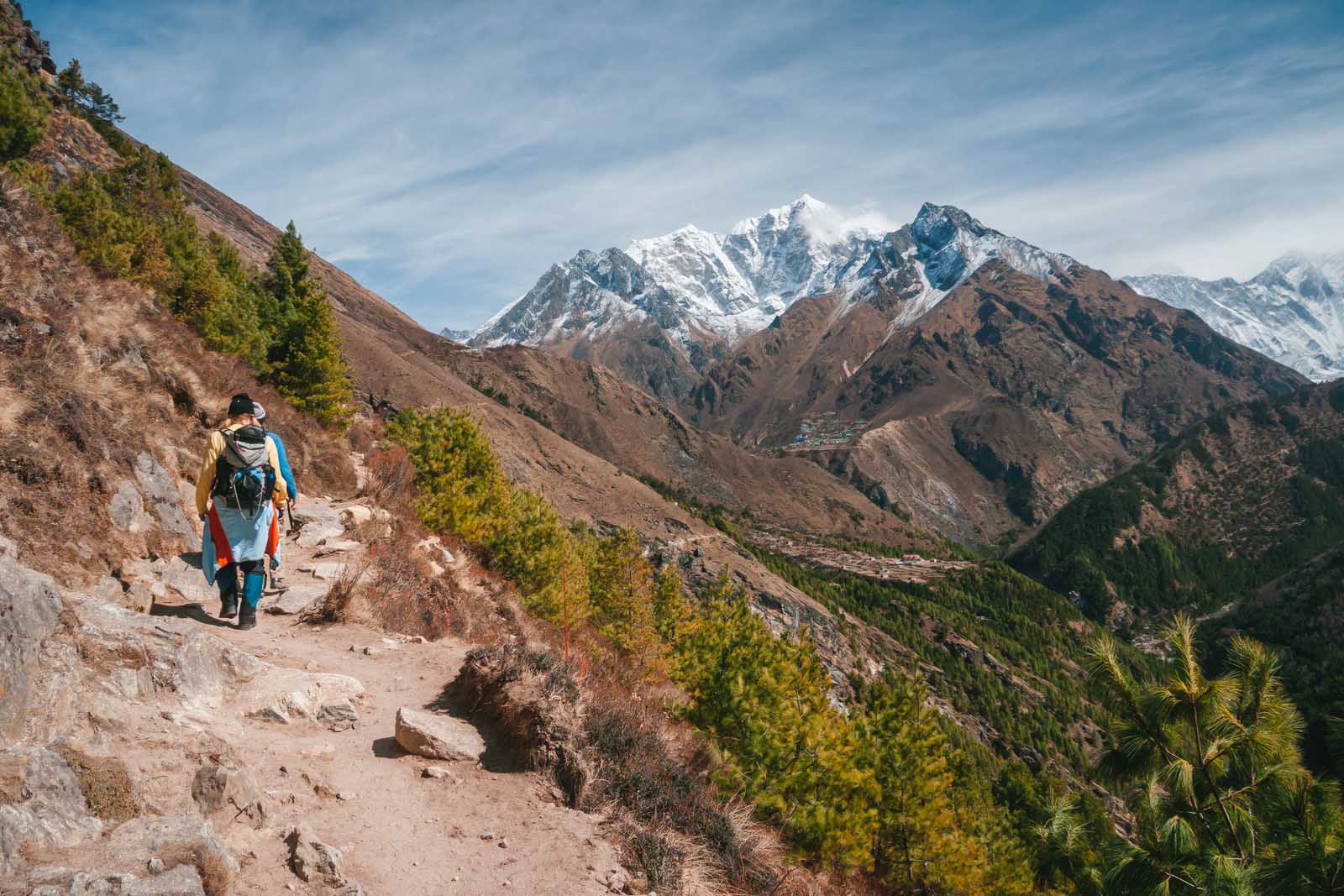
Most high-altitude treks have at least one acclimation day . The Everest Base Camp trek is no exception. An acclimatization day consists of hiking to a higher altitude and then coming back down to sleep at a lower elevation. It gives your body a chance to adjust to the altitude but you don’t stay for long.
As you will be constantly gaining altitude on the Everest Trek, it is good to have at least one day to climb higher and sleep lower to help prevent altitude sickness.
Our acclimation hike took us to the Everest View Hotel. With an elevation gain of only 400 meters, it wasn’t too much higher than our hotel in Namche Bazaar, but it is enough to help acclimate to the high altitudes. Everest View Hotel offers amazing views of Mount Everest (hence the name). Plus it holds the Guinness book of world records as the highest hotel in the world.
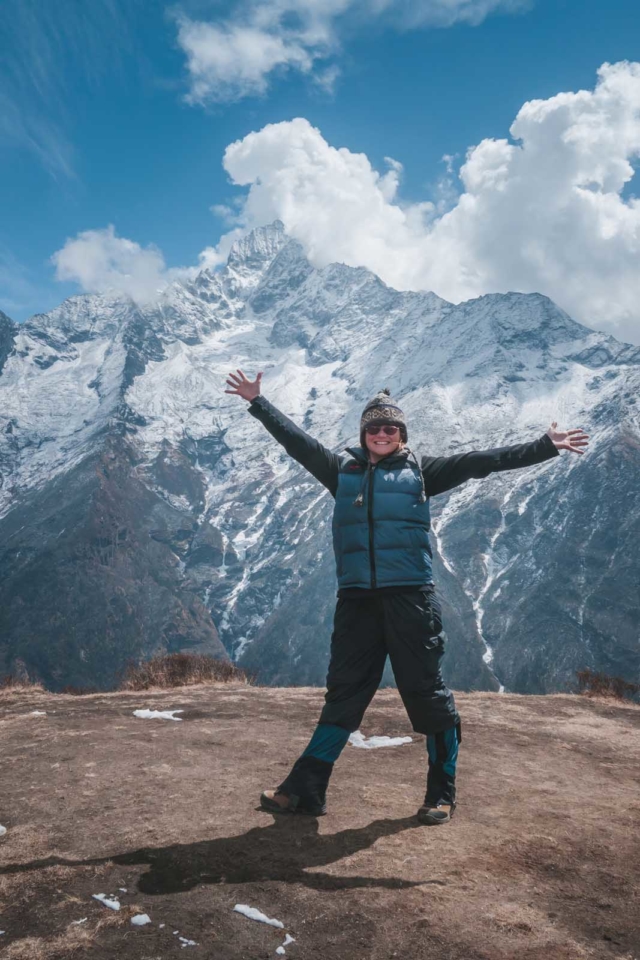
It is not an easy day off though. Just walking through town takes your breath away. As we made our way up the steps, I wondered if I should have just stayed in bed and skipped the viewpoint to relax. When we started the climb I was breathing heavily just walking up a few flights of steps. We hadn’t even left Namche Bazaar and I was pooped!
Once we got on the trail, things became easier. The steep grade gave way to a sloping trail and I started to feel better. After one and a half hours of climbing, we reached what has to be the world’s highest airstrip at 3700 meters (12,139 feet). We arrive just in time to see a small plane take off.
First Views of Mt. Everest
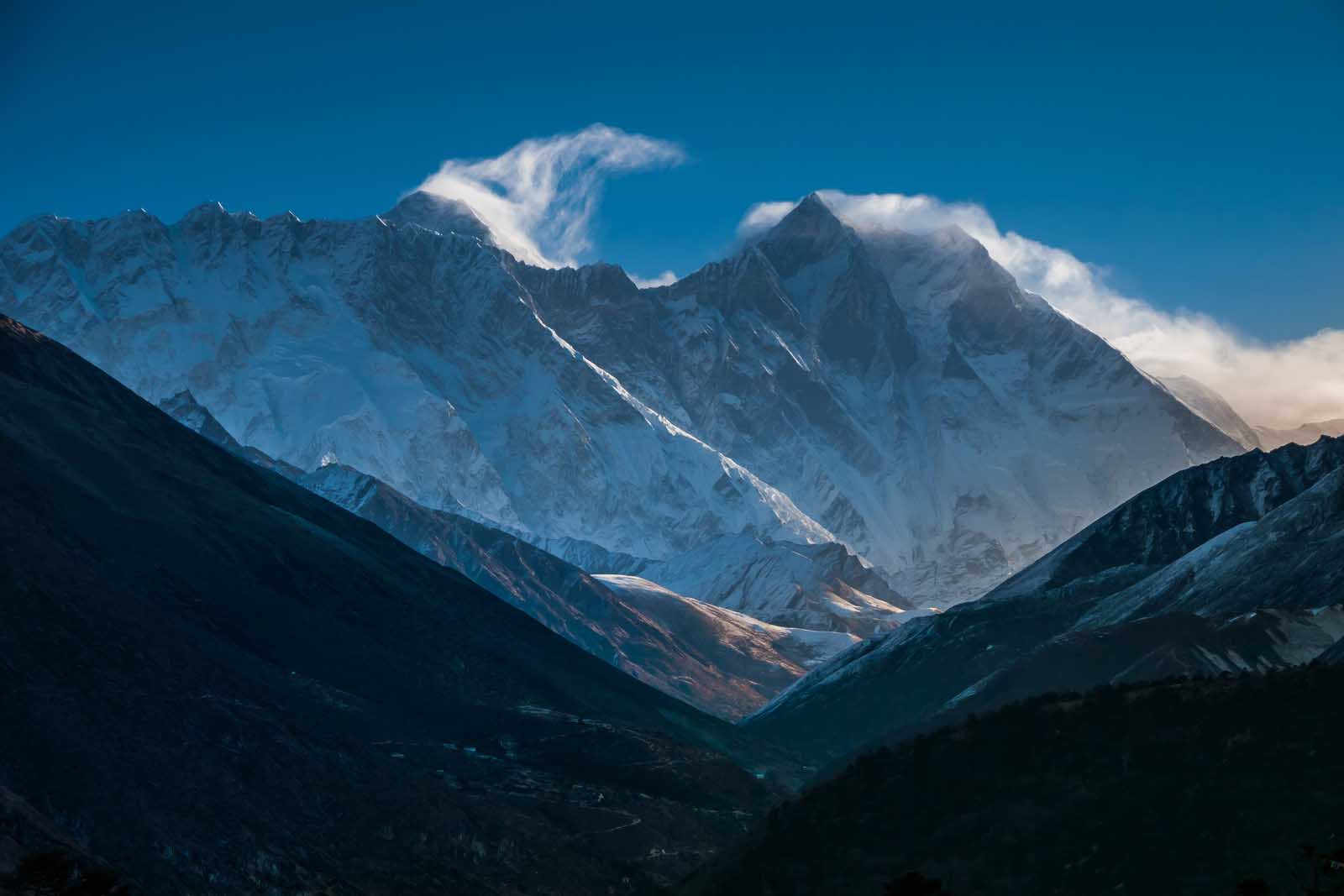
It was here that we got to see our first breathtaking views of Mt. Everest and the surrounding mountains. We hiked a bit farther and there it was, standing quietly behind the other highest peaks of the earth.
Lhotse, Changri, Ama Dablam, and Nuptse surround the mighty Mount Everest, the world’s highest peak. At 8414m (27,604 feet), 6027m (19,773 feet), and 7861m (25,790 feet) they are the little sisters of this sacred mountain. Mount Everest stands at 8848 meters (27,716 feet).
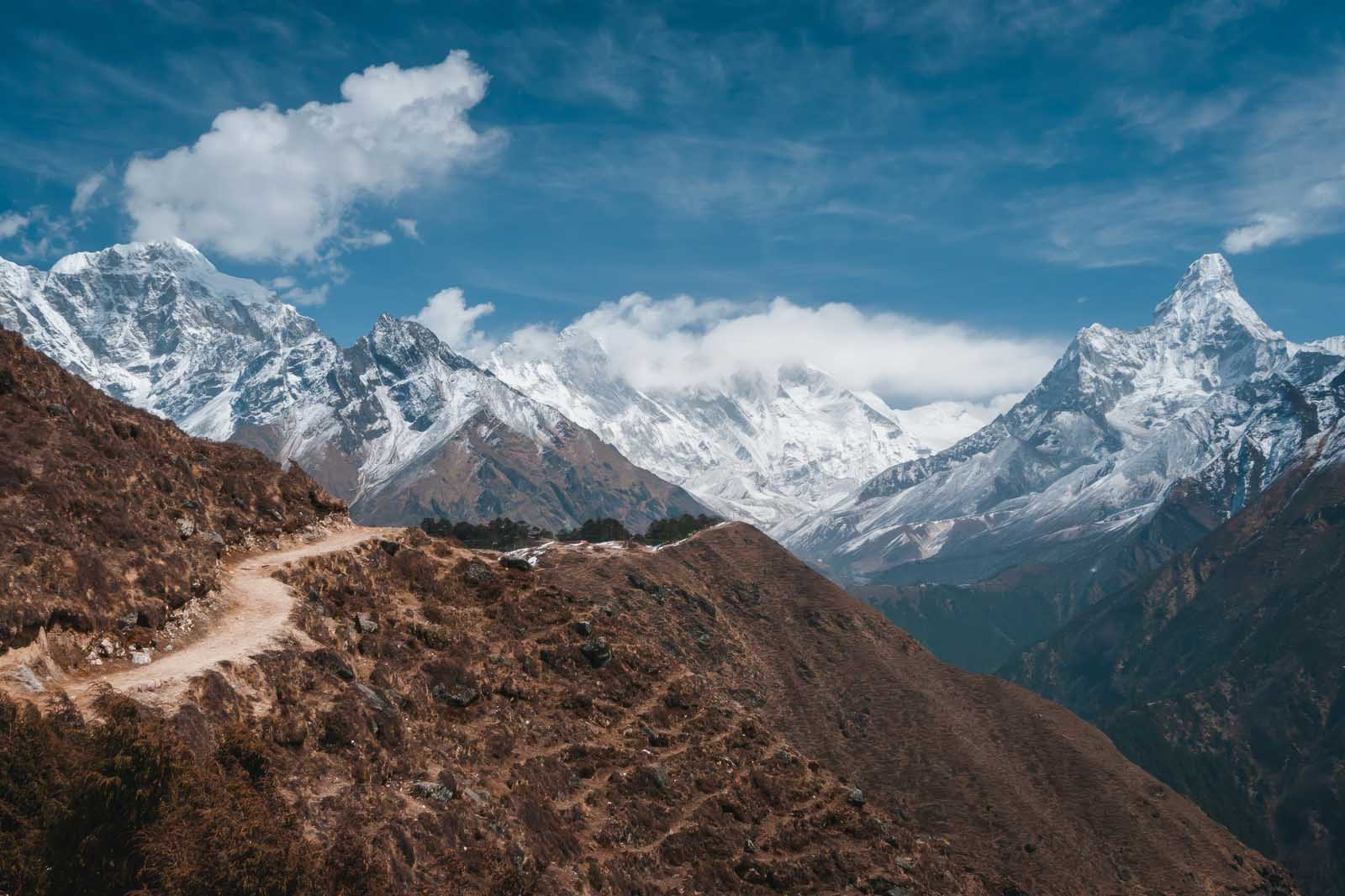
The deep Khumbu valley views were magnificent. The river wove far below, carving through the panorama of the white mountain tops. We walked a narrow trail snaking along the side of a steep mountain and suddenly realize “this trek has become real.” We were high in the Himalayas and one false move could mean catastrophe falling into the abyss below.
The sky was a deep blue and the white summits reached toward the billowing clouds. The view was so awe-inspiring it brought me to tears. Everything was so crisp and clear. During the EBC trek, you feel as if you could reach out and touch heaven.
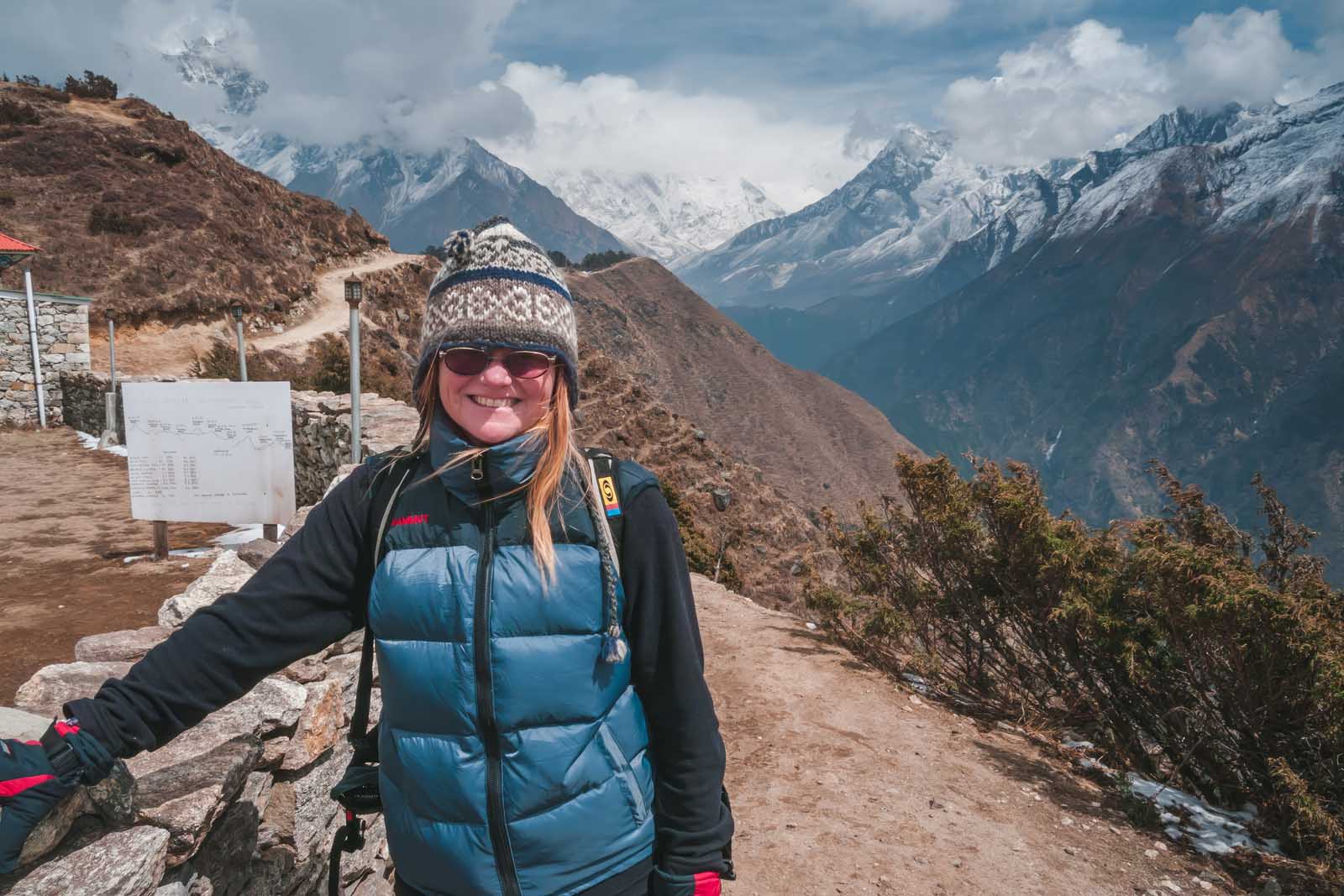
The clouds rolled in quickly so it was time to go. The weather conditions change quickly on the Everest base camp hike, so it is good to have the experience of a guide leading us through all terrain and conditions. We went back to Namche Bazaar to relax and gain strength for the rest of the trek.
Namche Bazaar – Elevation – 3440 meters. (11246 feet) Everest View Hotel – 3880 meters (12,730 ft.) Elevation – Bounce of 440 meters (1443 feet) Duration – 3 hours return Elevation Gain – 0 km
Day 4 – Namche Bazaar to Tengboche
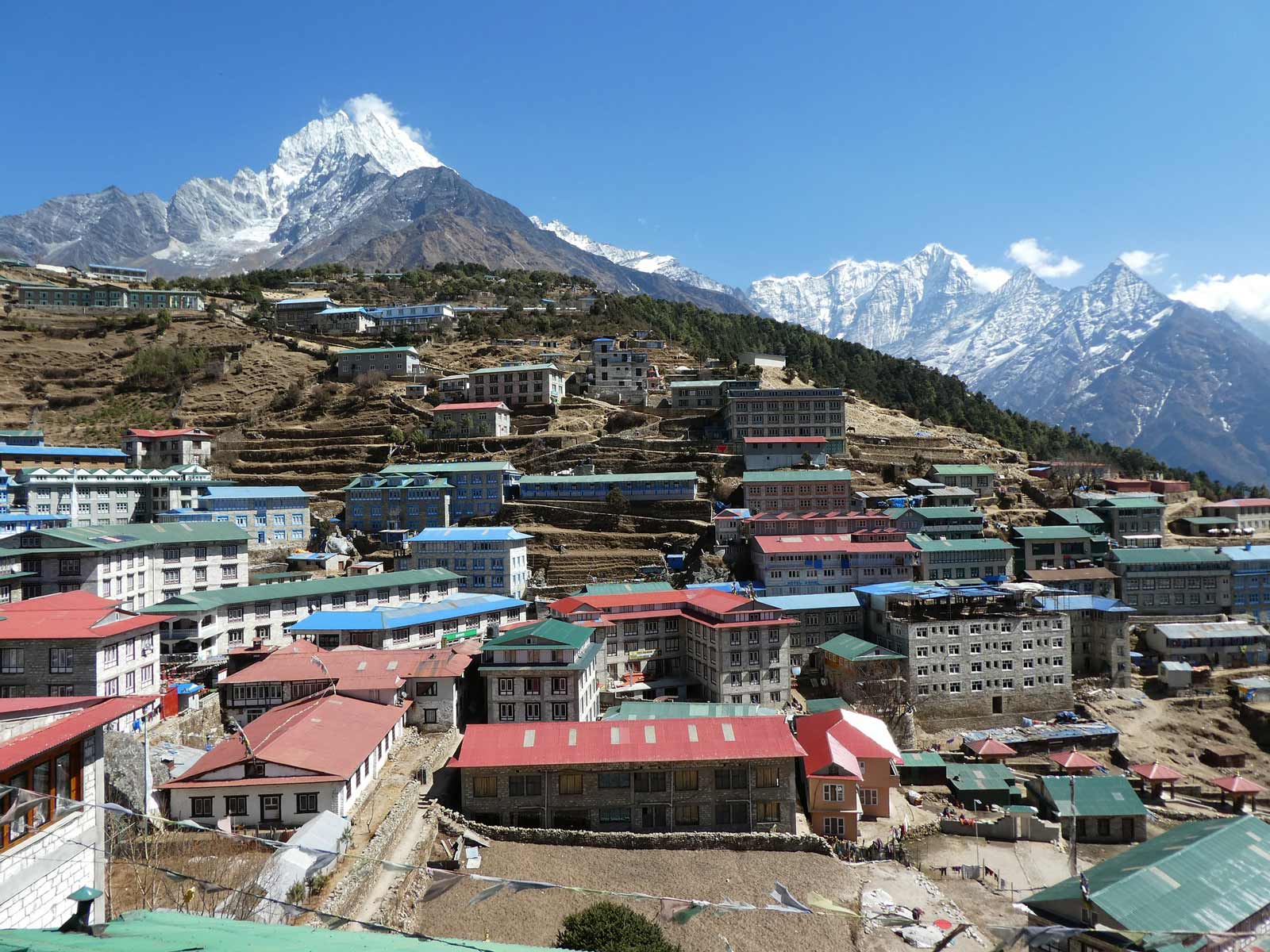
We awoke earlier than usual on Day 4. Two large group treks (Intrepid Travel and G Adventures) had checked into our lodge and we didn’t want to have to compete for service or breakfast. We also didn’t want to have to wait in line for the bathroom.
Lodges become more and more sparse as you go higher on the Everest Base Camp Trek and fewer toilets are shared between more people. Up until now, we hadn’t encountered crowds of people. It had been pretty quiet on the mountain and we liked it that way.
Luckily, we were a day ahead of the other tours. They had to stay in Namche Bazaar for another day to acclimate to the high altitudes, So we moved on to enjoy our EBC Trek free from crowds of people – for now.
Tenzing Norgay Memorial Stupa
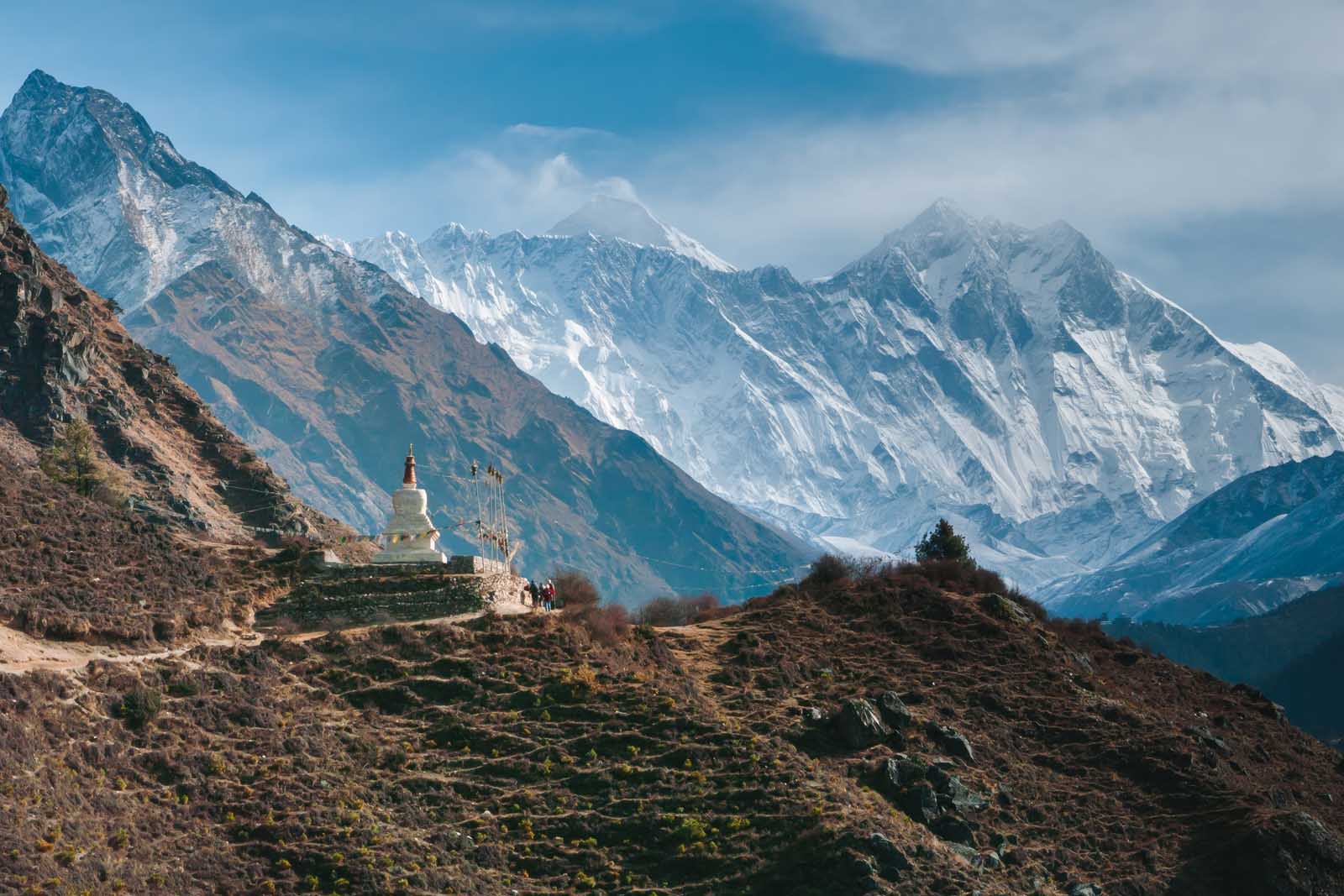
During day 4 of the EBC trek, we hiked along trails clinging to the side of the mountain. The narrow trekking trails along this route were a little scary. They wound along the edge of the cliff with nothing but a sheer drop to the abyss into the Khumbu Valley. But we kept our wits about us putting one foot ahead of the other until we reached the Sherpa Monument.
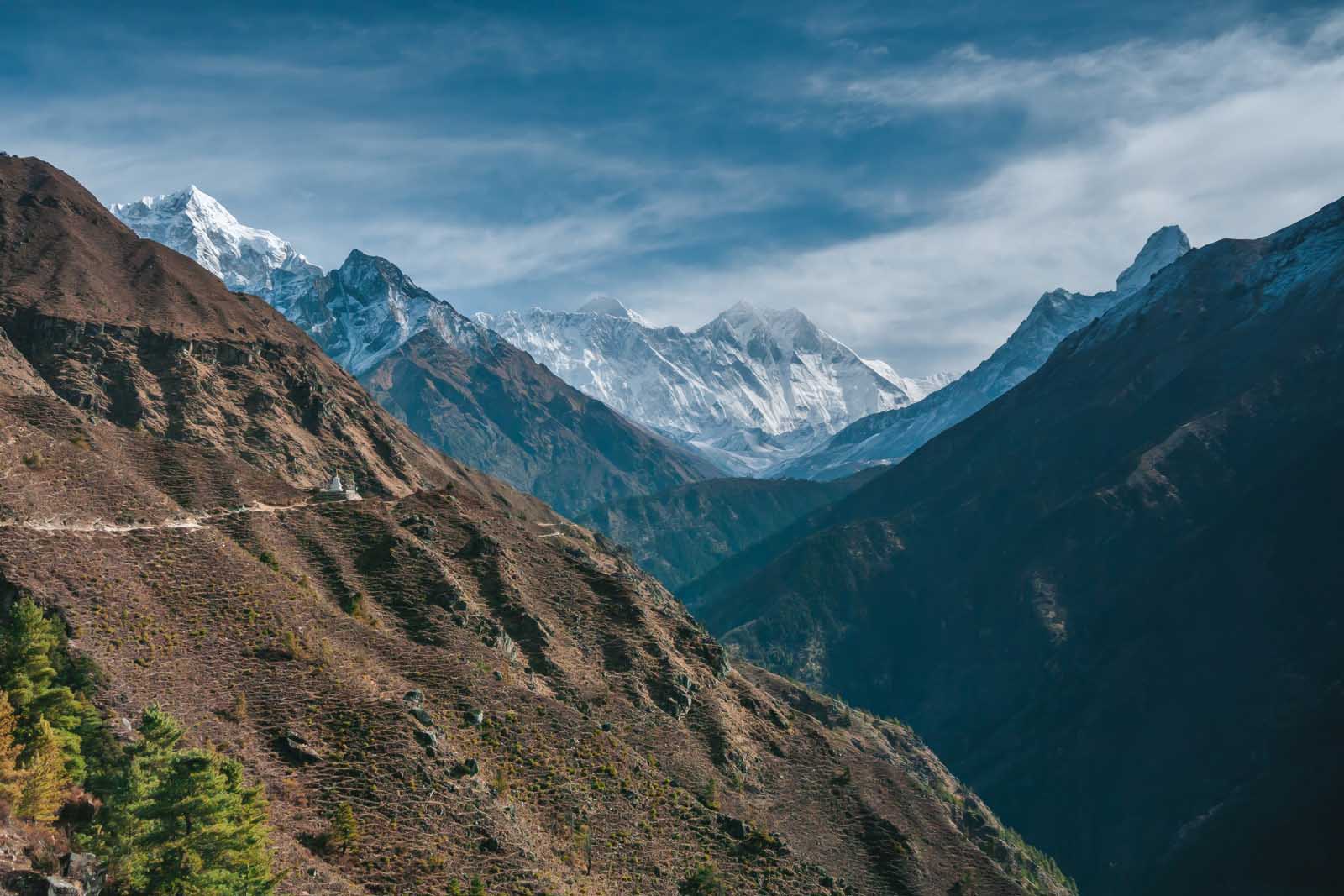
Tenzing Norgay Sherpa monument was erected by the Norgay family. It is a stupa honoring Tenzing Norgay Sherpa and all the Sherpas that risked their lives to help climbers reach the summit of Mt. Everest.
All treks pass this monument and it is an important stop on the journey to pay respect to the famous Sherpa of the Everest region. In case you don’t know, Tenzing Norgay Sherpa was the first man to summit Everest along with Sir Edmund Hillary.
What is a Sherpa?
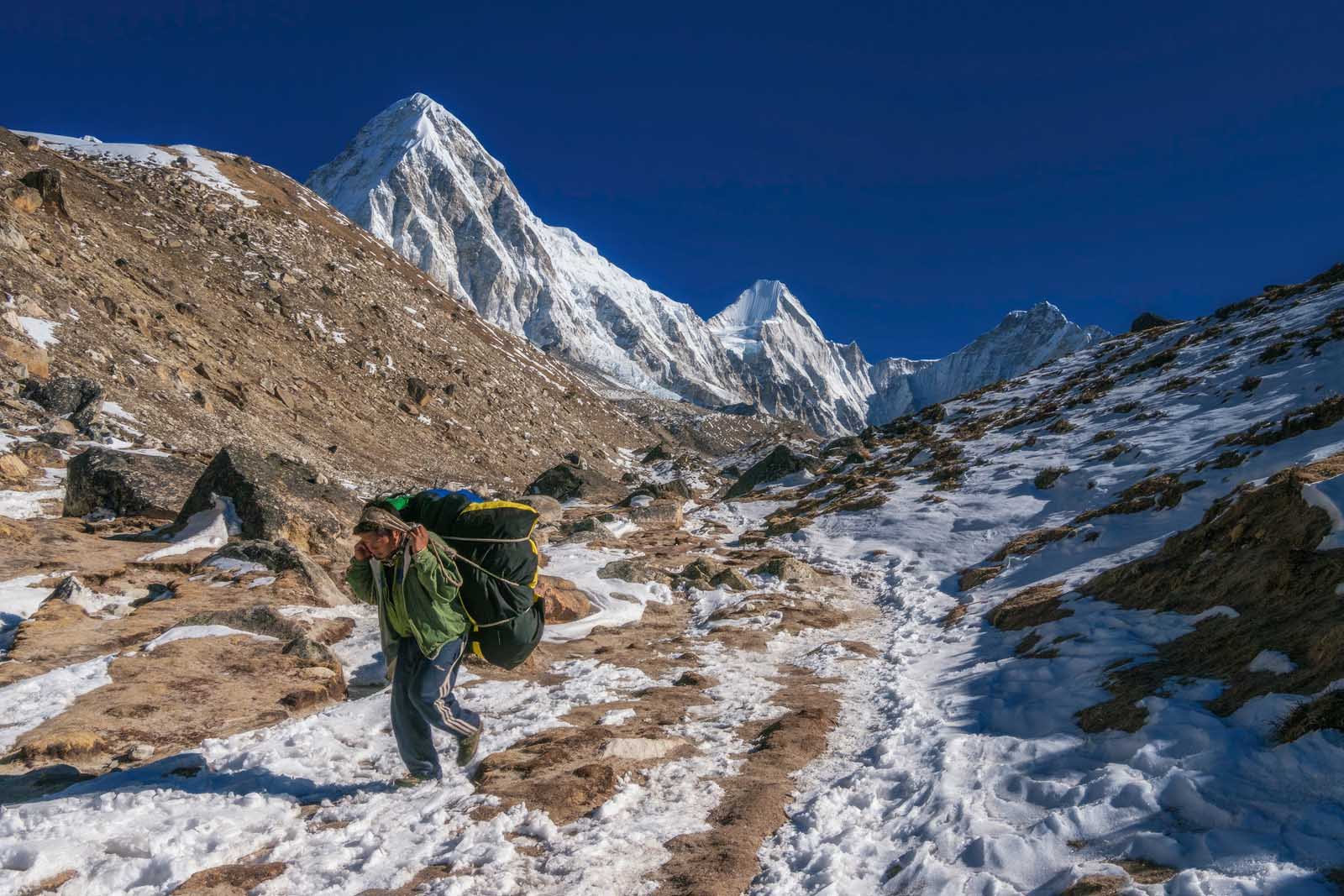
Sherpas are the unsung heroes of Mt. Everest. They do all of the hard work and technical work on the mountain. They carry the heavy loads, set the ladders and ropes to cross the Hillary Step and Khumbu Icefield for mountain climbers, and they take care of setting up camp while climbers and trekkers catch their breath and try to survive life on the world’s highest peak.
Difference Between a Sherpa and a Porter
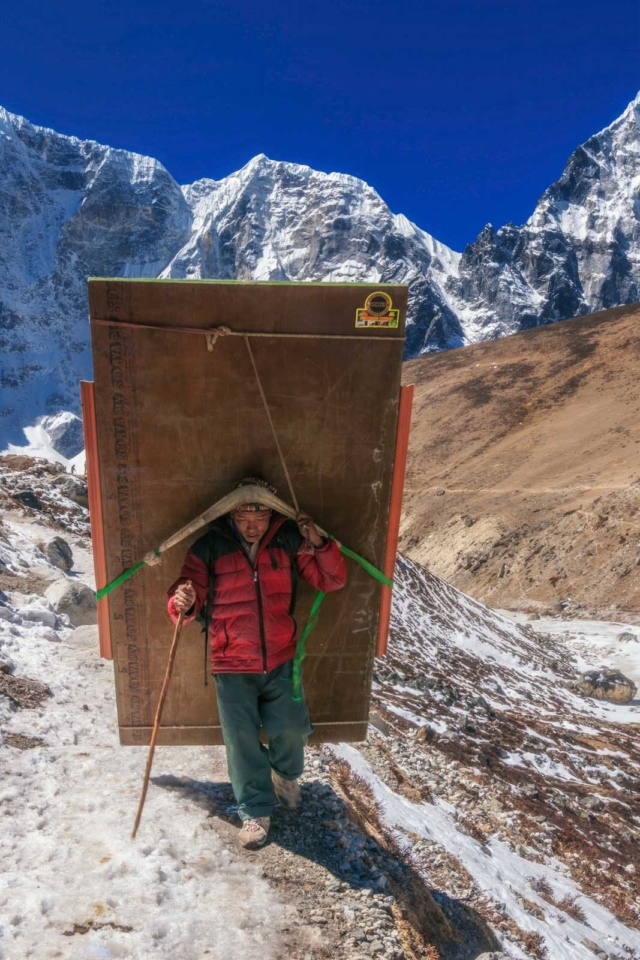
Sherpas and porters are very different from one another. We learned that a Sherpa is actually the name of an ethnic group from Tibet. The original mountaineers hired Sherpas as their guides in the Himalayas and the world has now adopted the name for porters in the Everest region. If you aren’t born into the Sherpa ethnic group, you cannot be called a Sherpa. Porters are porters and Sherpas are Sherpas.
We were told that some porters, especially commercial porters carry up to 60kg (150 pounds) of supplies and gear to businesses located along the EBC trek. That is a lot of weight and we were very surprised. When climbing Mount Kilimanjaro , porters had a mandatory weight limit of 35kg. (77 pounds).
Dipendra told us that they get paid per kilo so some people push it too far. The Nepalese are a strong bunch but this is a lot to carry at such a high altitude no matter what shape you are in.
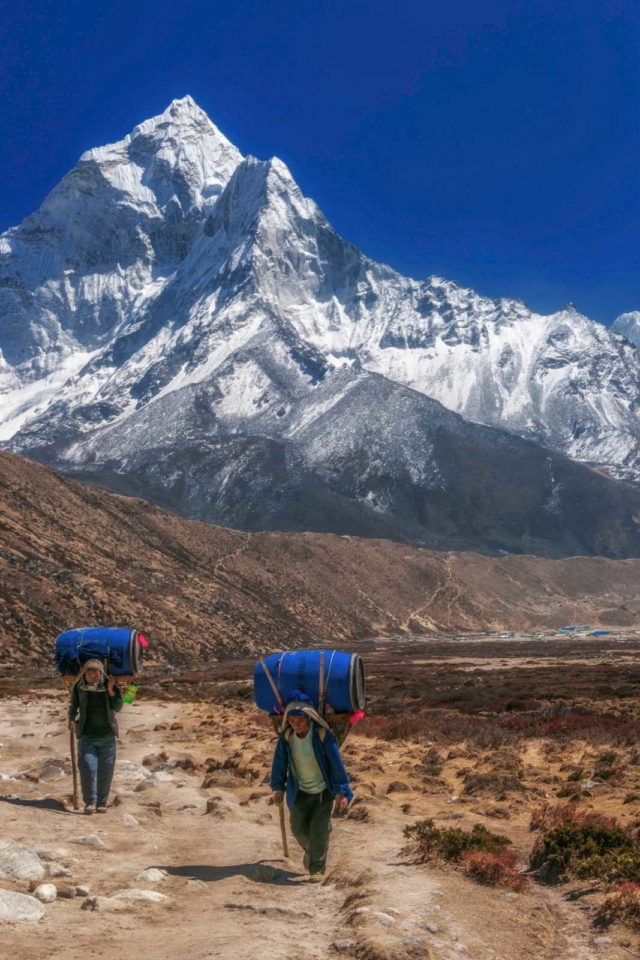
We kept our pack as light as possible at around 22kg (48 pounds) for Sher and we even felt bad about that! We have heard there is a 30kg (66lb) limit for Everest, but judging by what we saw other porters carrying on the Everest Base Camp hike, people were pushing it well beyond that.
We saw men carrying stacks of plywood with heavy white sacks loaded on top. We saw men carrying propane tanks, doors, and huge packs. What could people possibly need on the EBC Trek that they packed their packs so full? Read more: Packing List for Everest Base Camp Trek
Approaching Tengboche
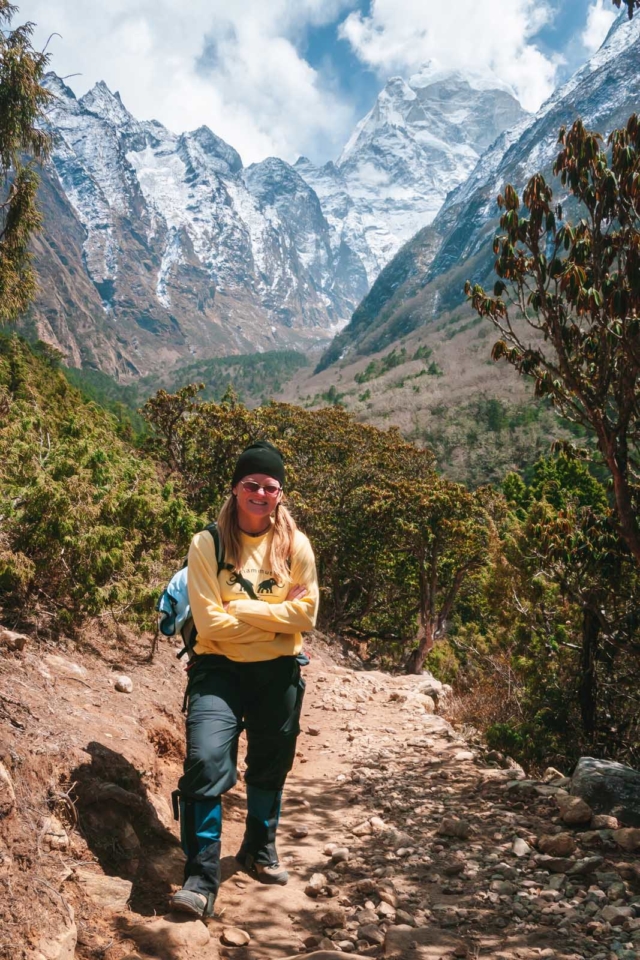
The final push of our EBC Trek day 4 was to Tengboche Monastery. It was a tough yet steady 2-hour steep climb. We are now gaining altitude climbing above the tree line. We put our heads down and huffed and puffed our way up. We didn’t stop for any photos or videos and were surprised to cut the climb down to just one and a half hours.
We reached the prayer wheels of Tengboche Monastery just in time for light snow to start falling. We made it into our camp at Tengboche by 1:30 pm and had the entire afternoon to ourselves at 3900 meters (12795 feet). This is an excellent place on the Everest Base Camp hike to have some extra time to relax as there are a few special things to see and do.
Tengboche Monastery
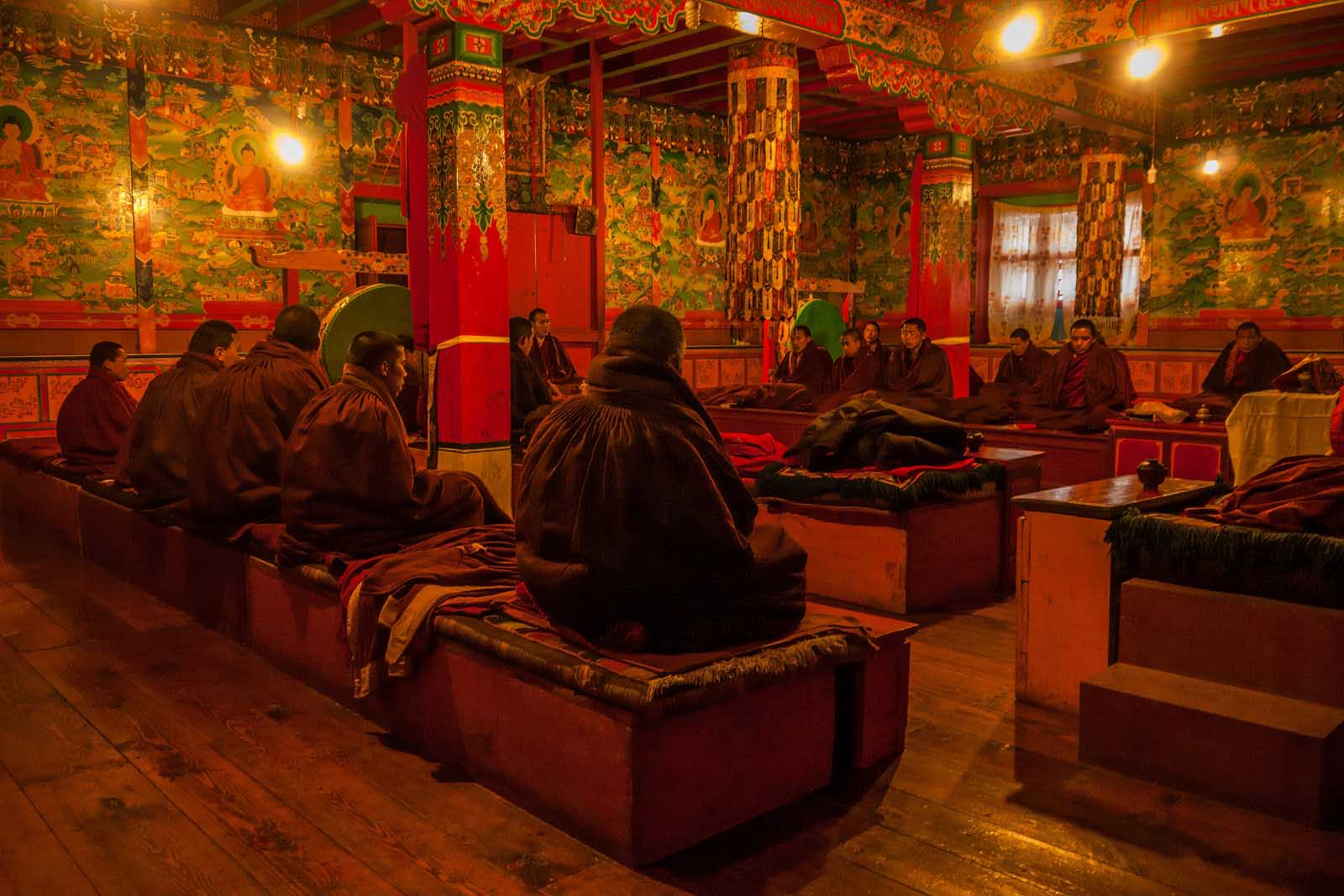
We warmed our feet with our new down booties that we bought at Namche Bazaar and changed into some dryer clothes before heading off to see the monks chant at Tengboche Monastery. Our guide Dipendra told us that this is the most important monastery in the region. All climbers summiting the mountains stop at this monastery to be blessed by the monks.
We were allowed to watch the ceremony and to take in the warmth and blessings from the monks. It is a sacred place and all climbers and trekkers stop here before continuing up the mountains.
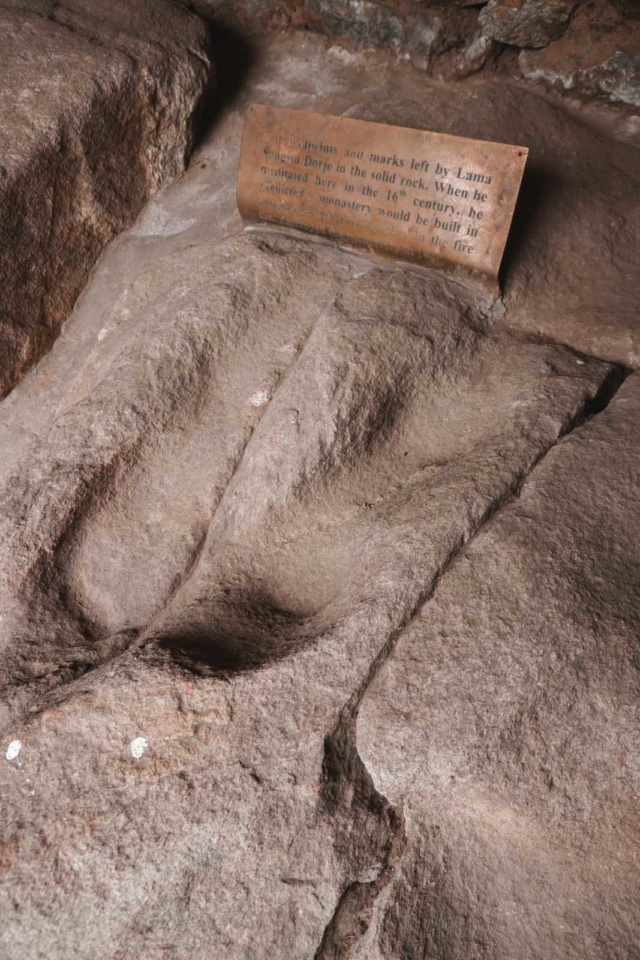
The footprints of Lama Pagna Dorje from the 16th century are embedded in solid stone in front of the monastery. A place where he mediated and raced through the Himalayas riding the wind with his mind.
Apparently, he sat on this stone for so long, his feet left their mark. He spent years traveling the world through the power of his mind and we believe the story. Especially after our yoga experience in Goa India. He predicted that a monastery would be built here and surprise surprise…here it is.
The View from Tengboche Monastery
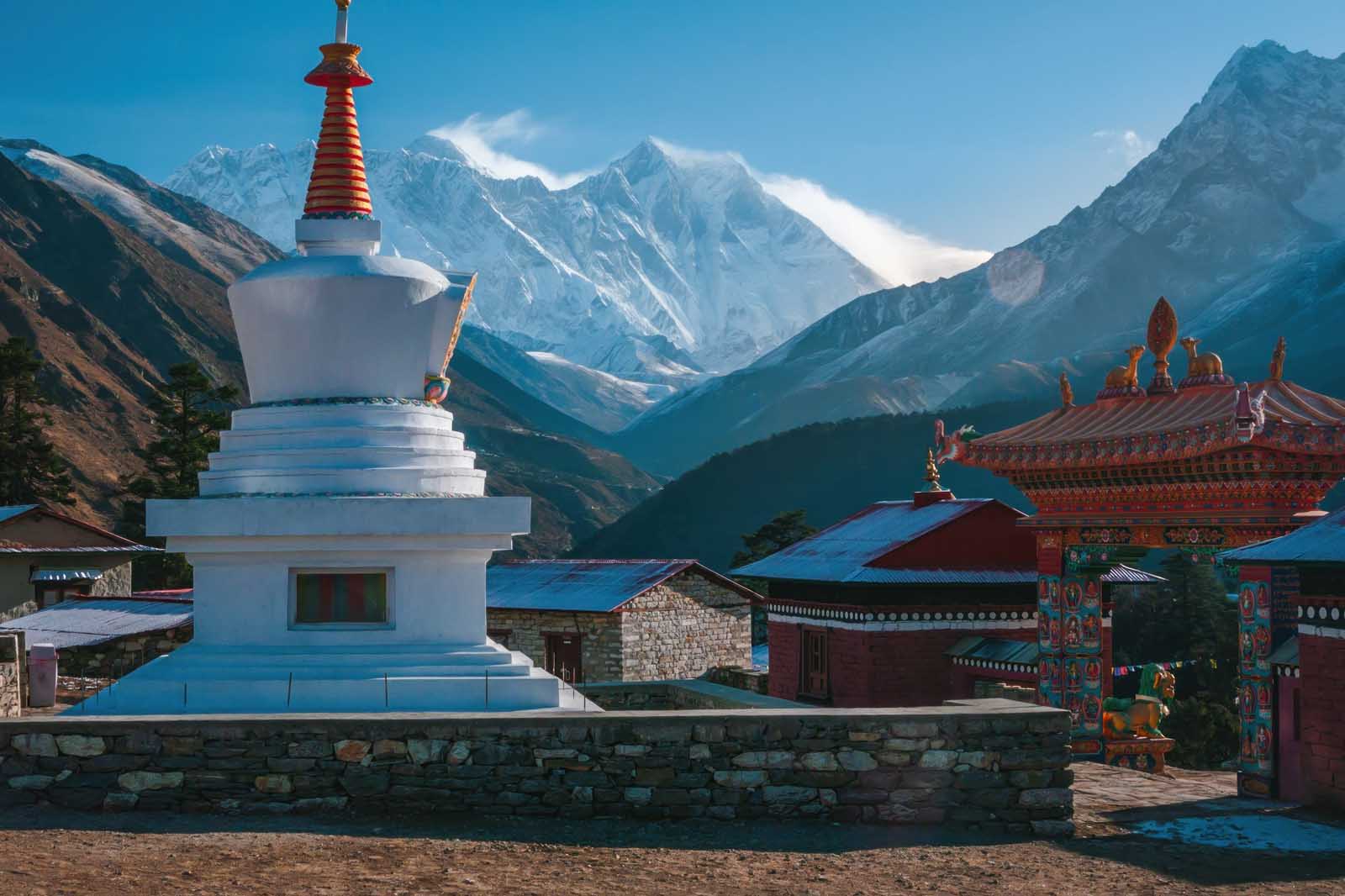
The view is magnificent from Tengboche Monastery. The valley is wide and opens up to massive rolling hills giving way to the highest peaks on earth. Plus it has a clear view of Mt. Everest and the surrounding mountains.
We were told that Sir Edmund Hillary came back to survey the peak of Mount Everest from this spot because the view is so clear of the mountain and we can understand why.
Accommodation – Basic Tea Houses at Higher Altitude
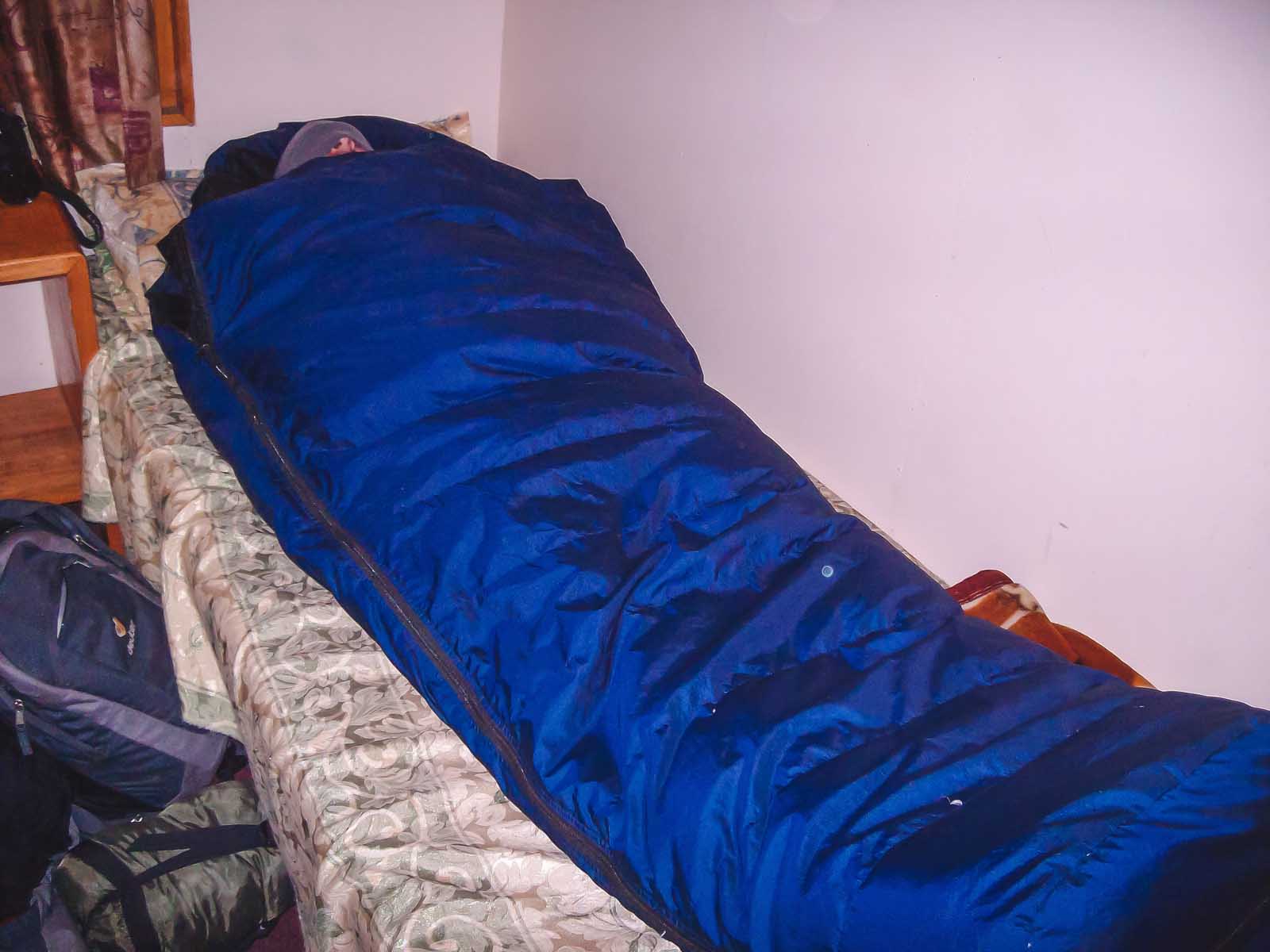
At this high elevation of the EBC trek, accommodation became very basic and rustic. We felt like true adventurers as we sat by the fire warming our feet and bonding with our fellow trekkers over our shared experience by candlelight.
There were 10 of us staying in this teahouse. All are sharing electricity to charge our camera batteries. Meals were now vegetarian and wood stoves were heated by yak dung. At this high altitude, meat cannot be transported fast enough to stay fresh and regular wood is scarce, so yak dung it is.
When we went to bed, our room was freezing. Rooms are not heated at higher elevations. We had our own room, but I sometimes wonder if sleeping in a dorm would have helped with more body heat. The temperature easily dipped down to -10 Celcius (14 degrees Fahrenheit) and our plywood walls didn’t offer a lot of comforts.
We tossed and turned all night long trying to keep our noses warm in our sleeping bags wearing our down jackets, thick socks, and thermal mid-layers.
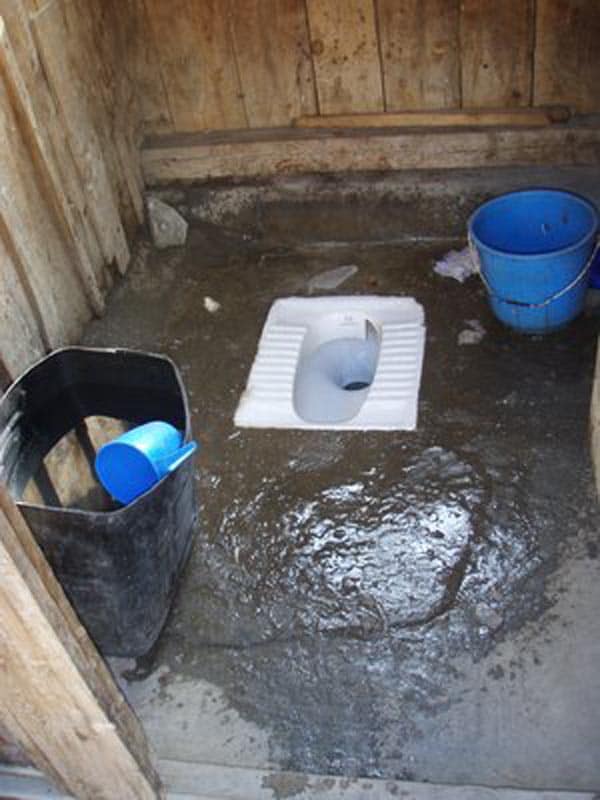
It was so cold the scoop bucket for the shared squat toilet froze over forming a patch of ice to form on the floor. It was a slippery trip to the outhouse. Sadly, we always have to pee a lot during the night when sleeping at high altitudes so we visited that toilet a lot.
Hot Tip: Pay for hots showers at lower elevations You won’t regret it! We realized that we should have paid the 250 Rupees for the hot showers offered at the accommodation in Namche Bazaar. Now that the weather was so cold there was no way we could face a bucket bath in a freezing shed. Dave and I set a new record in these mountains of Nepal, 9 days without a shower!
Namche Bazaar – Elevation – 3440 meters. (11246 feet) above sea level Tengboche – 3860 meters (12664 feet) Elevation Gain – 420 meters (1378 feet) Distance – 9.3 km (5.77 miles) Duration – 3 hours (without stopping) 5 hours for photos, lunch and rest.
Day 5 – Tengboche to Dingboche
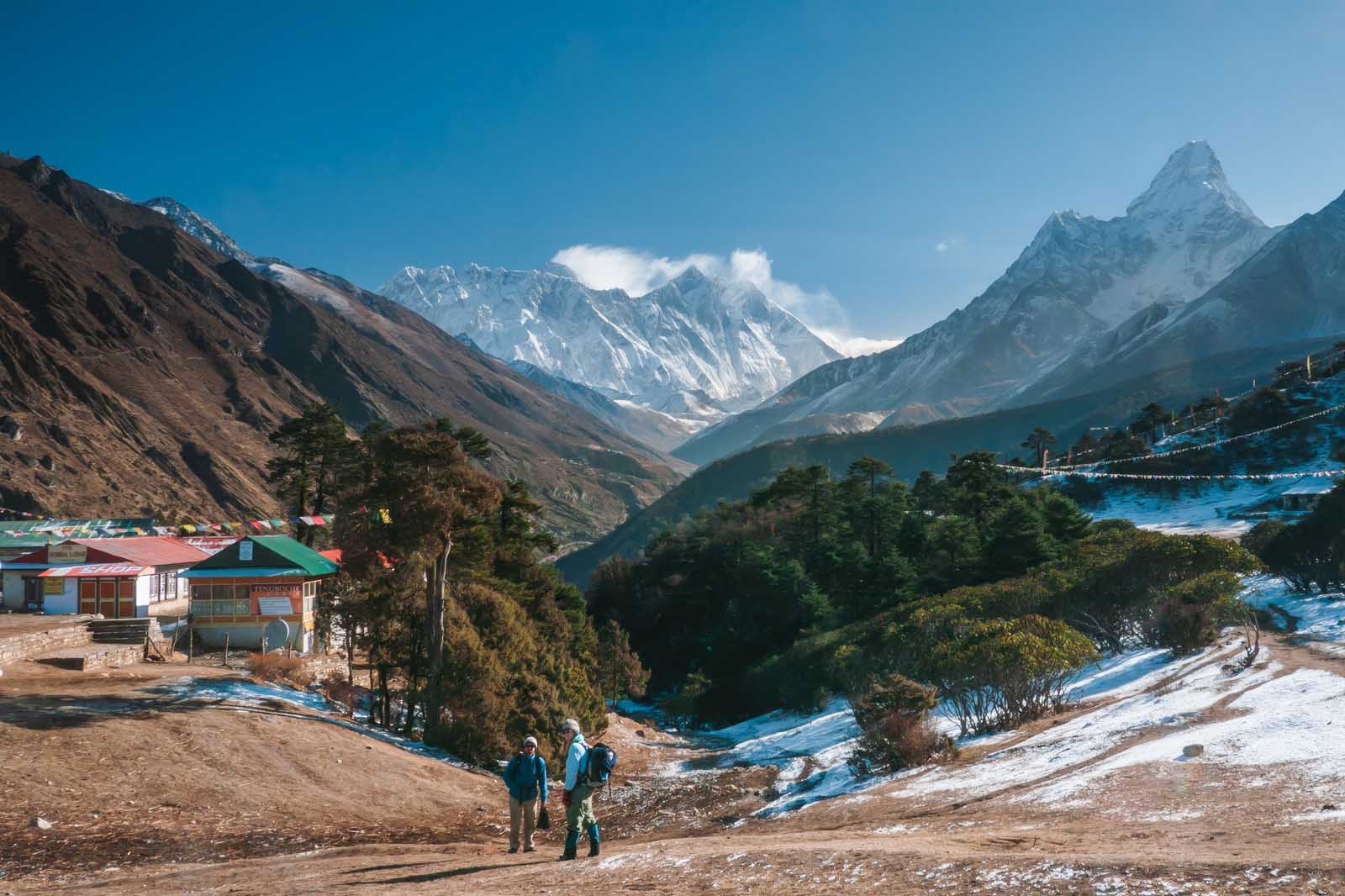
Day 5 of the EBC Trek was freezing! We had an early wake-up call and morning came too quickly on the Tengboche leg of the EBC Trek. But, we awoke to a winter wonderland of fresh snow at the Tengboche Monastery and clear views of Lhotse peak.
The snow from the night before made for more incredible views on the hiking trails. As we started out from the lodge, the sky was crisp and clear, showing Mount Everest in all its glory. It was stunning, and in between gasping for air, we admired the view.
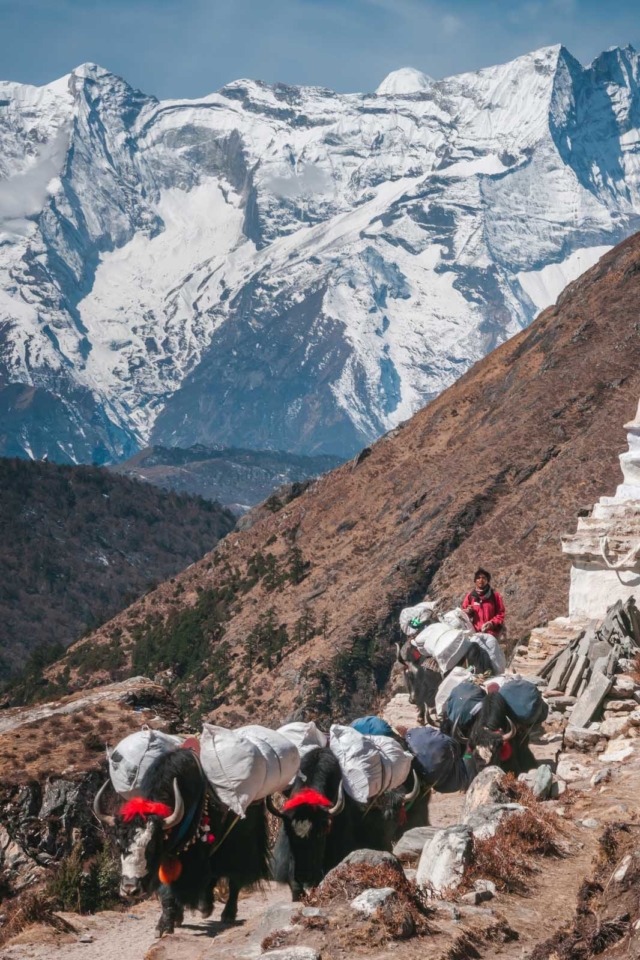
Today we walked to higher altitudes and saw our first trains of wooly yaks. Yaks cannot survive at low altitudes because it is too warm for them, so you don’t see yaks on the Everest Base Camp hike until at least 3000 meters. (9800 feet) They are beautiful.
Yaks on the Trek to Everest Base Camp
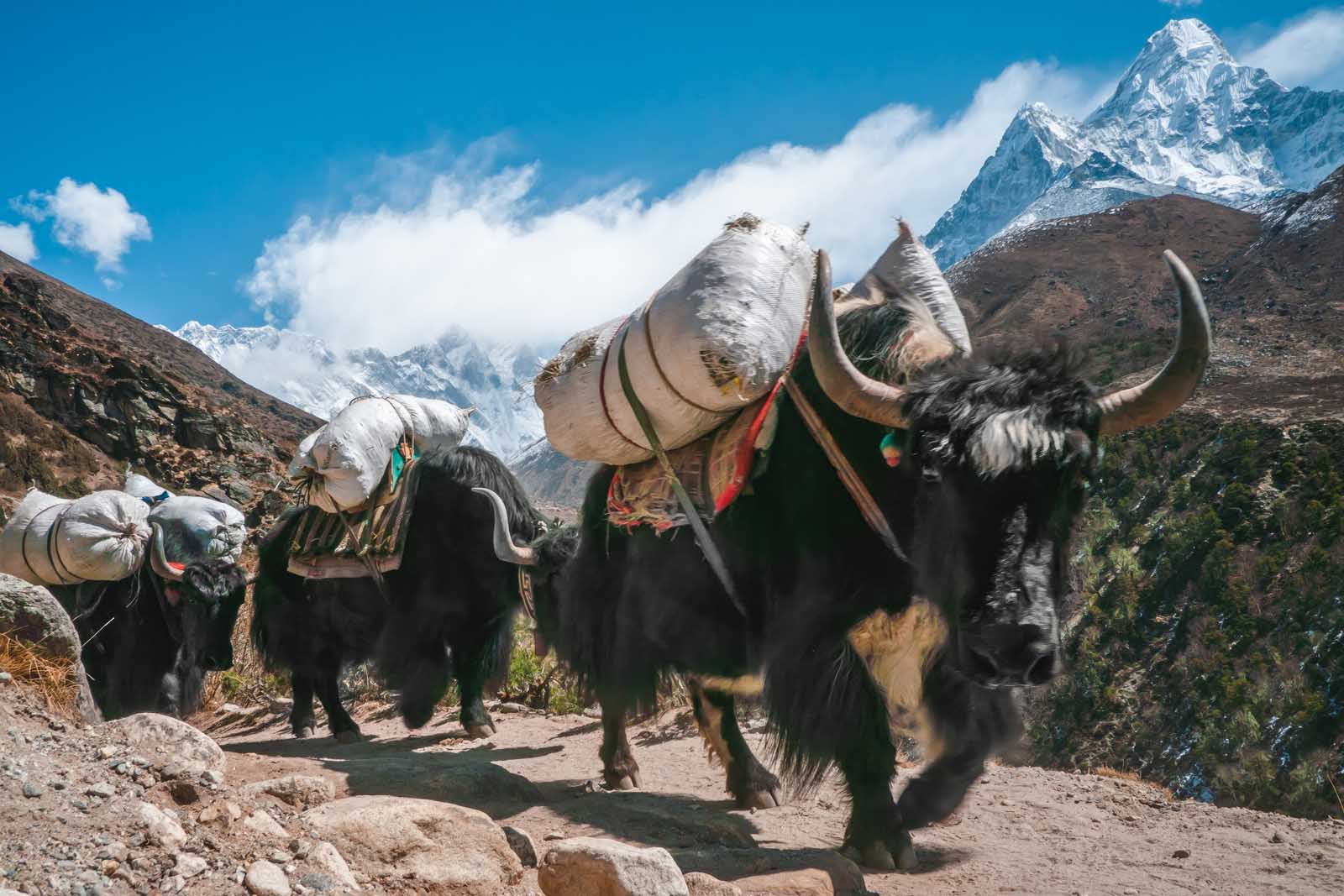
Woolly yak trains were more frequent and by day five of the EBC Trek, we had our system perfected to give them the right of way without letting them nudge us off the mountain.
As we said earlier, it is important to give yaks space. They will run you right off the mountain if you are in their way. Be sure to stand on the mountainside as they pass so you don’t get knocked over the edge. The yaks of the Everest Base Camp trek, have only one thing on their mind. To get to their destination.
On this day, signs of expeditions going up to summit Everest started to go by as large groups of yaks carried giant loads of climbing gear. It is exciting to think that we were walking the same route as so many great mountain climbers, like Sir Edmund Hillary and Tenzing Norgay Sherpa.
The Trek from Tengboche is breathtaking
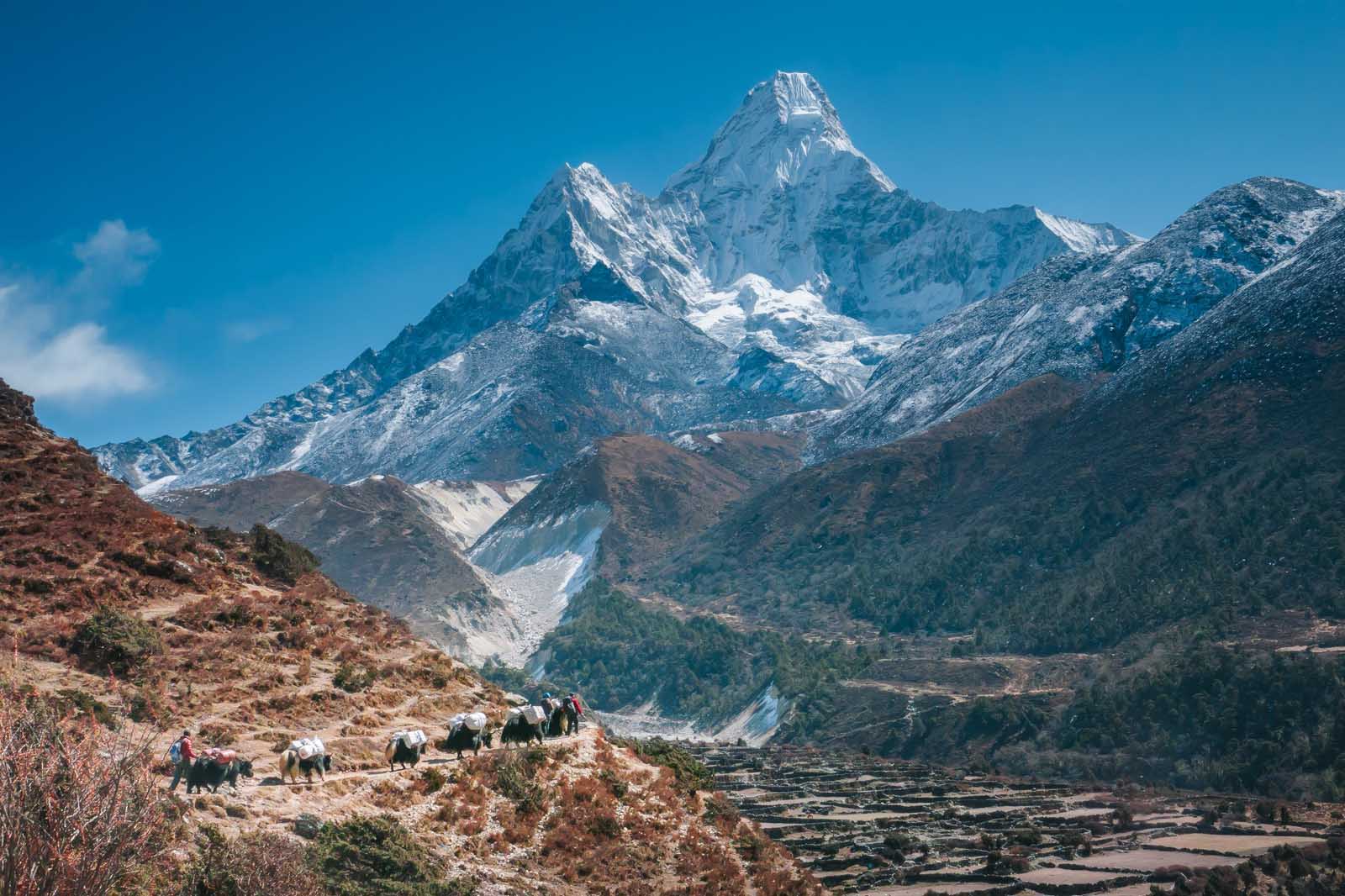
I conquered what little fear of heights I had left this day. Some of the narrow paths on the route dropped sharply into the deep valley below. Soon we found ourselves walking along the ledge not thinking at all about the dangers below. We hiked for a couple of hours before stopping for tea at a restaurant in Pangboche.
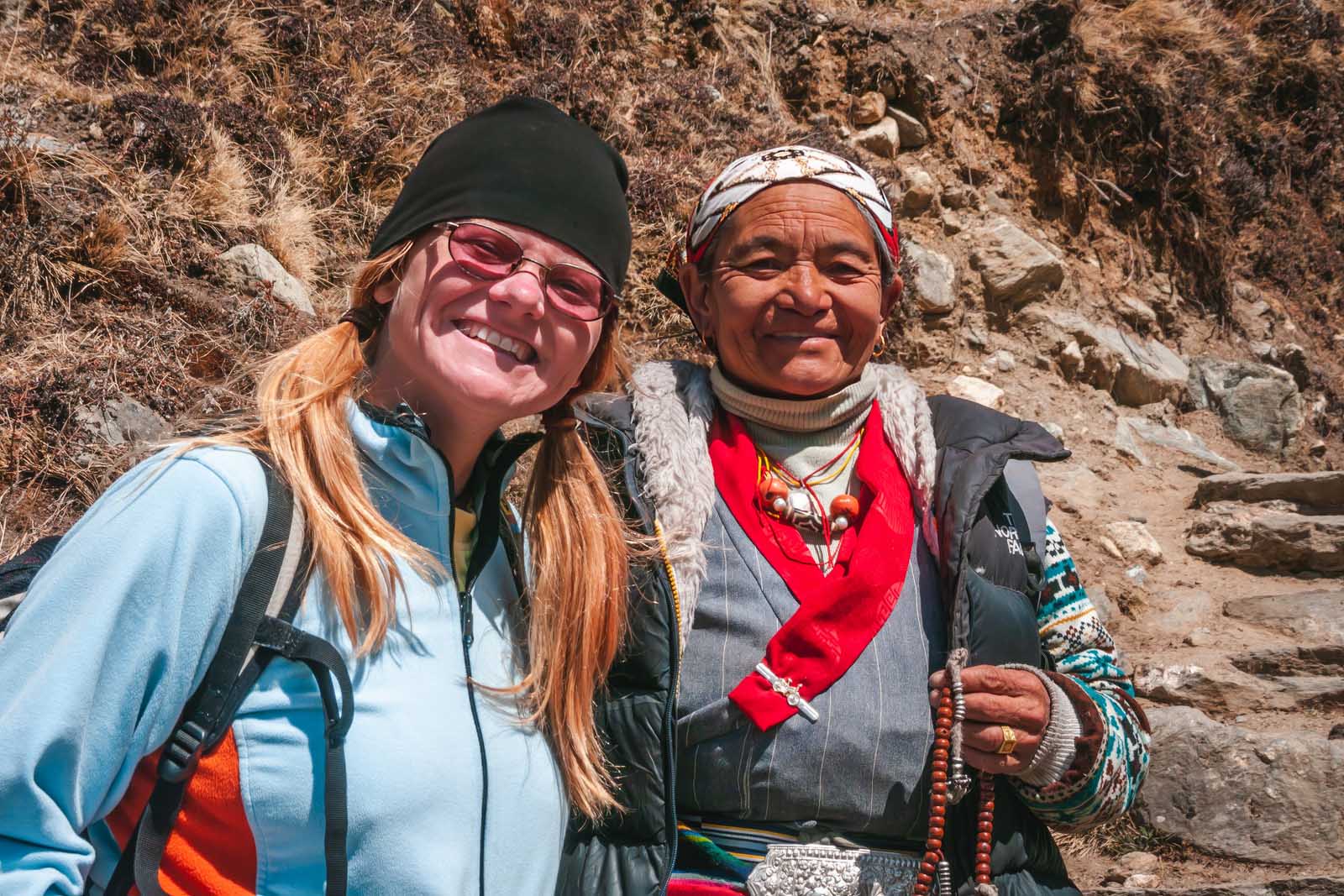
There are shops, teahouses, and restaurants along the route so we could buy lunch along the way and one of the more popular stops is in the village of Pangboche. After a tea stop in Pangboche, we met a sweet lady that walked with us all the way to the village of Dingboche. Her name was Yangshou and she waited for us as we struggled up hills and crossed the suspension bridge over the Imja Khola River.
Her cute laugh and quiet prayers helped to pass the time. She stopped to talk to everyone on the trail while we plugged along. She’d fall far behind when she chatted with friends, only to quickly catch us and then scoot by us with ease. She must have enjoyed our company because we really slowed her down. “ Yangzhou, we will always remember your smiling face!
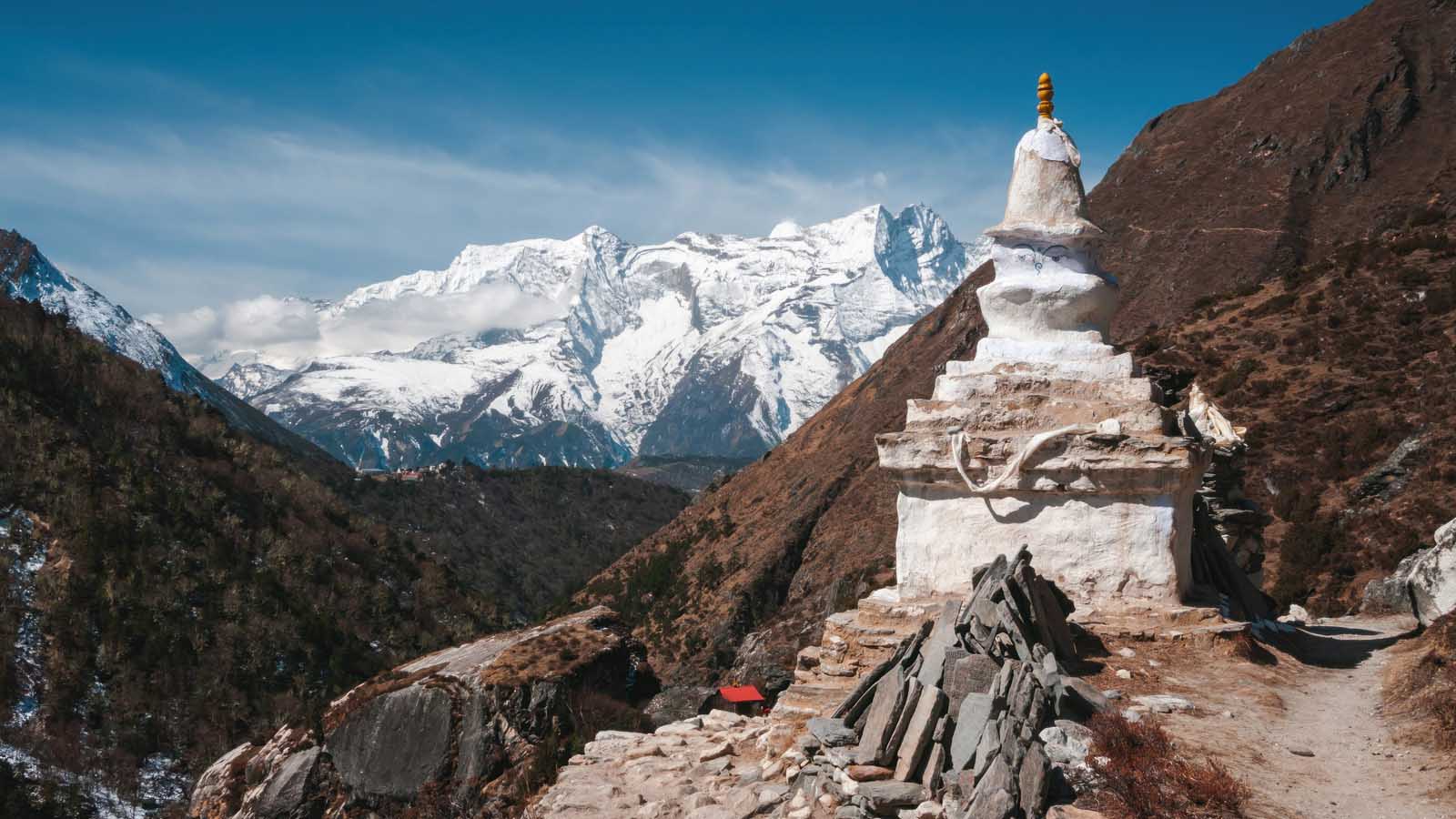
We spent the night in the village of Dingboche and wished that we had another night here. It is from here that you will see beautiful views of Island Peak and Lhotse, but it is also a good spot for another acclimatization day.
Tengboche – 3860 meters (12664 feet) above sea level Dingboche – Elevation – 4410 meters. (14468 feet) Elevation Gain – 550 meters (1804 feet) Distance – 10.8 km (6.71 miles) Duration – 3 hours (without stopping) 5 hours for photos, lunch, and rest.
Day 6 – Second Acclimatization Day at Dingboche
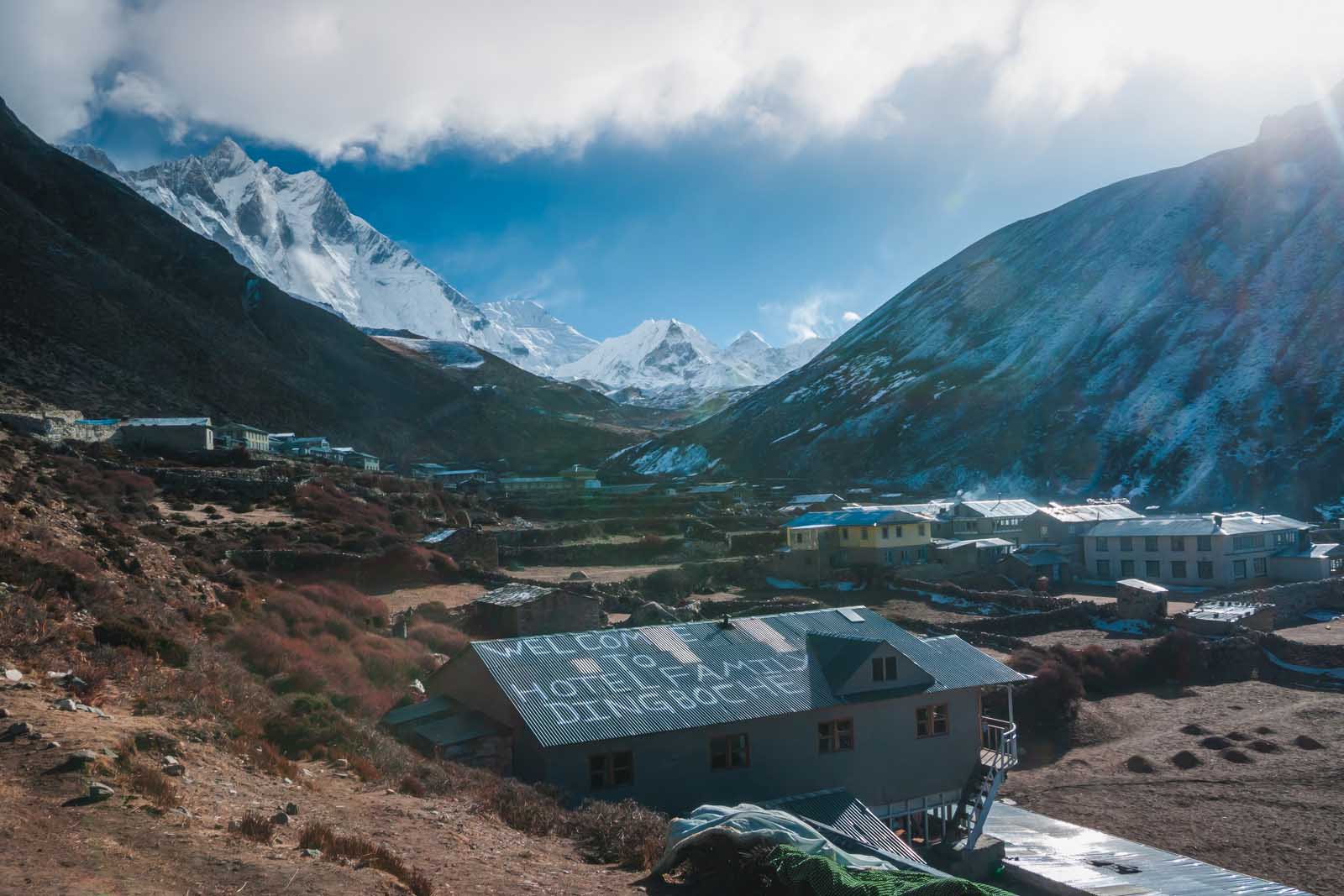
This is a day that most people spend acclimating to the high altitude. We did not do this day, but you should! So we are including it in the guide because it is a very important day when trekking to Everest Base Camp. If we were smarter, we would have spent 2 nights in the village of Dingboche where we would spend a day hiking up to Nagurjun Hill.
This is the best place for climbers looking to summit Everest, Ama Dablam (6812m), Lobuche peak (6,119 m), or Island Peak to do their acclimatization day. Dingboche is a small village in the Khumbu region with only a few guest houses, so it is a good time to relax, replenish and rejuvenate for the next push.
If we had brought our Lonely Planet Trekking in the Nepal Himalayas (which we forgot in Kathmandu and kicked ourselves about it every day) we would have realized that we should have taken an extra day to acclimate in Dingboche.
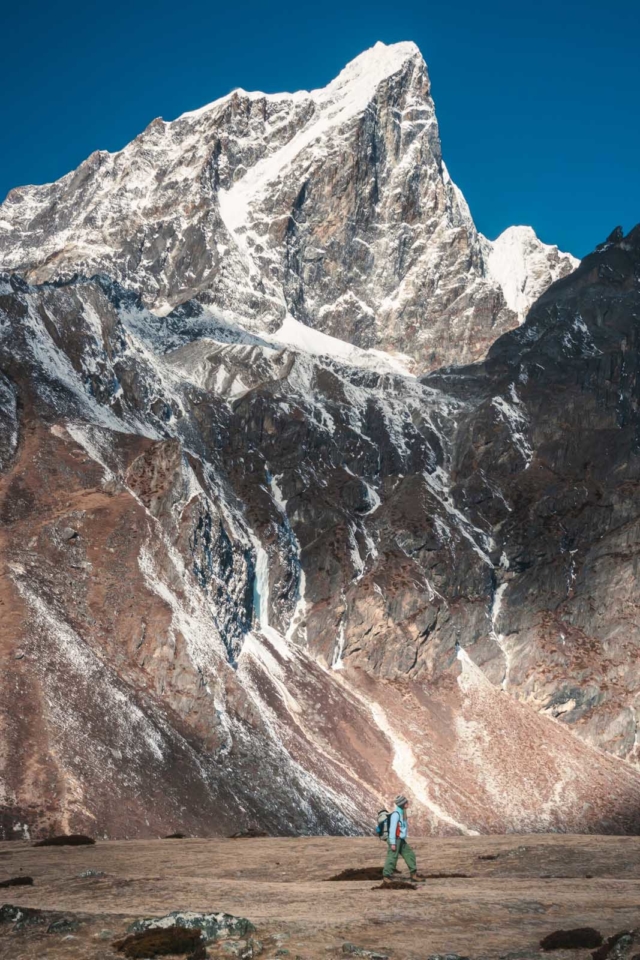
Dipendra was flexible so he would have easily added another day onto our trek, we just didn’t know any better to ask about it. Lucky for us, we felt strong, but other groups were complaining of headaches and dizziness.
In the end, we wish we spent the extra day here. Some people even spend two days here climbing to the surrounding peaks. We did suffer after reaching base camp and I believe that is because we didn’t spend time acclimatizing here.
Had we stayed, we would have done some light hikes to gain altitude and then come back down to rest at a lower elevation. Many people who are set to climb Island Peak or Kala Patthar stay here for a few days to get some practice climbs in.
Dingboche – Elevation – 4410 meters. (14468 feet) above sea level Nangkartshang Peak – Altitude – 5050 meters (16568 feet) Climb – 640 meters (2099 feet) Distance – 10.8 km (6.71 miles) Duration – 4 hours Elevation Gain – 0
Day 7 – Dingboche to Lobuche
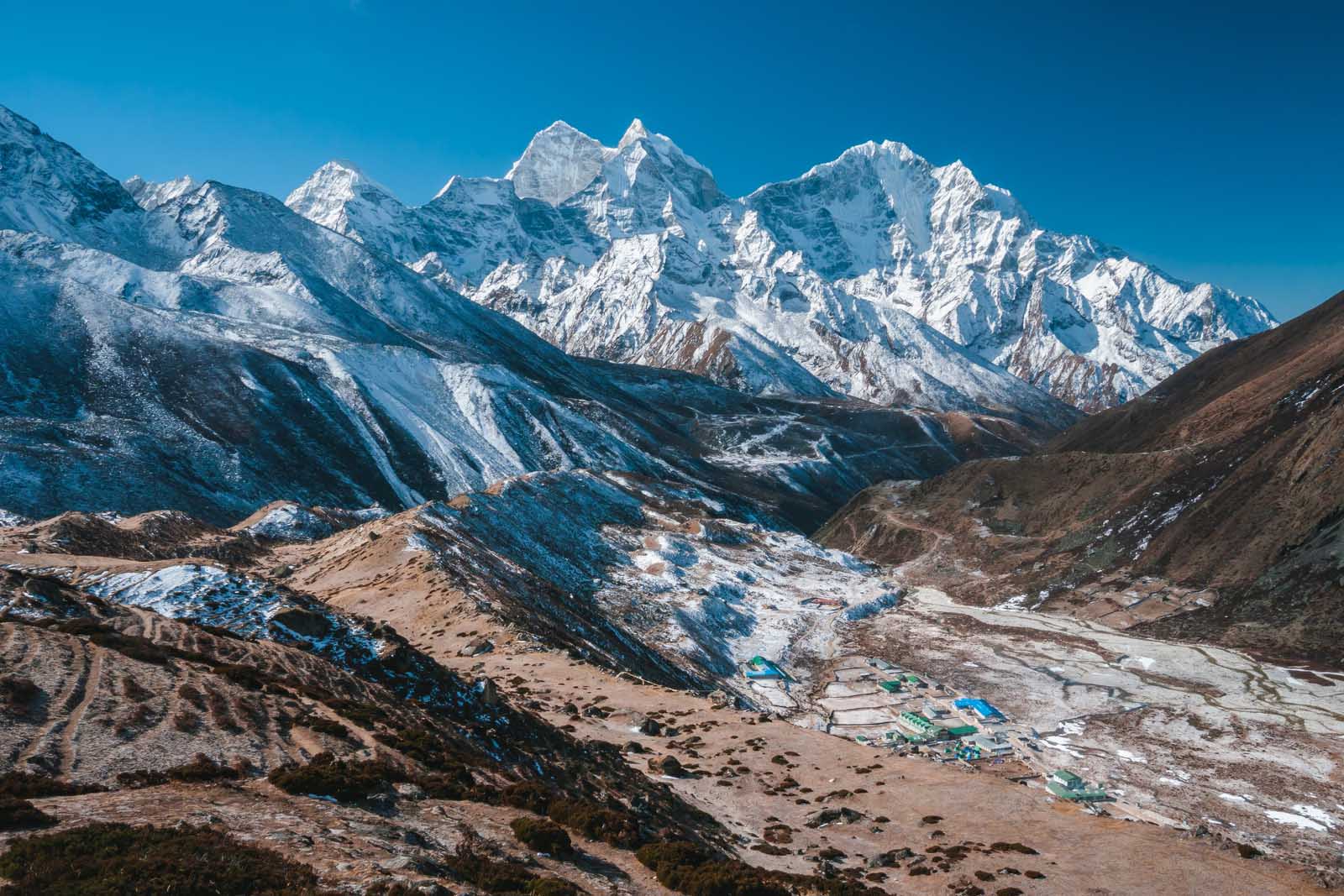
We walked with fellow trekkers we met at our guesthouse Martin and Richard from Slovakia during the morning hours. They carried their own packs and after watching them struggle, we were happy we hired a porter. (note: As of April 2023, you can no longer trek independently in Nepal) They were really starting to feel the altitude and we eventually left them behind.
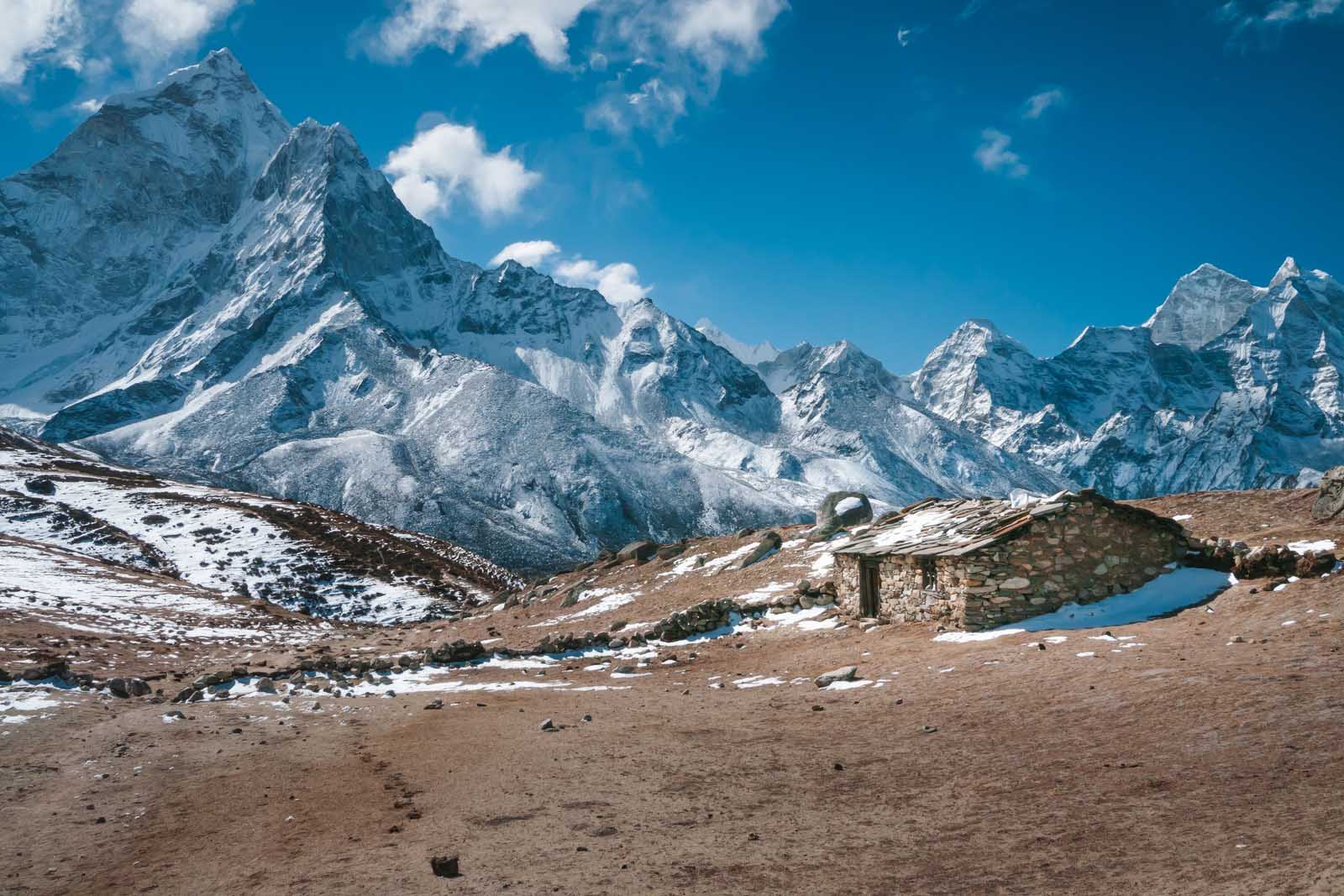
We enjoyed our day taking photos of the stunning clear views of the Everest region. It may be a little colder trekking in Nepal at this time of year (Early March), but the skies are clear and blue. When we came across a small cluster of houses, we felt like we had entered the Kingdom of Middle Earth. Little Hobbit houses lined a valley with giant peaks looming overhead.
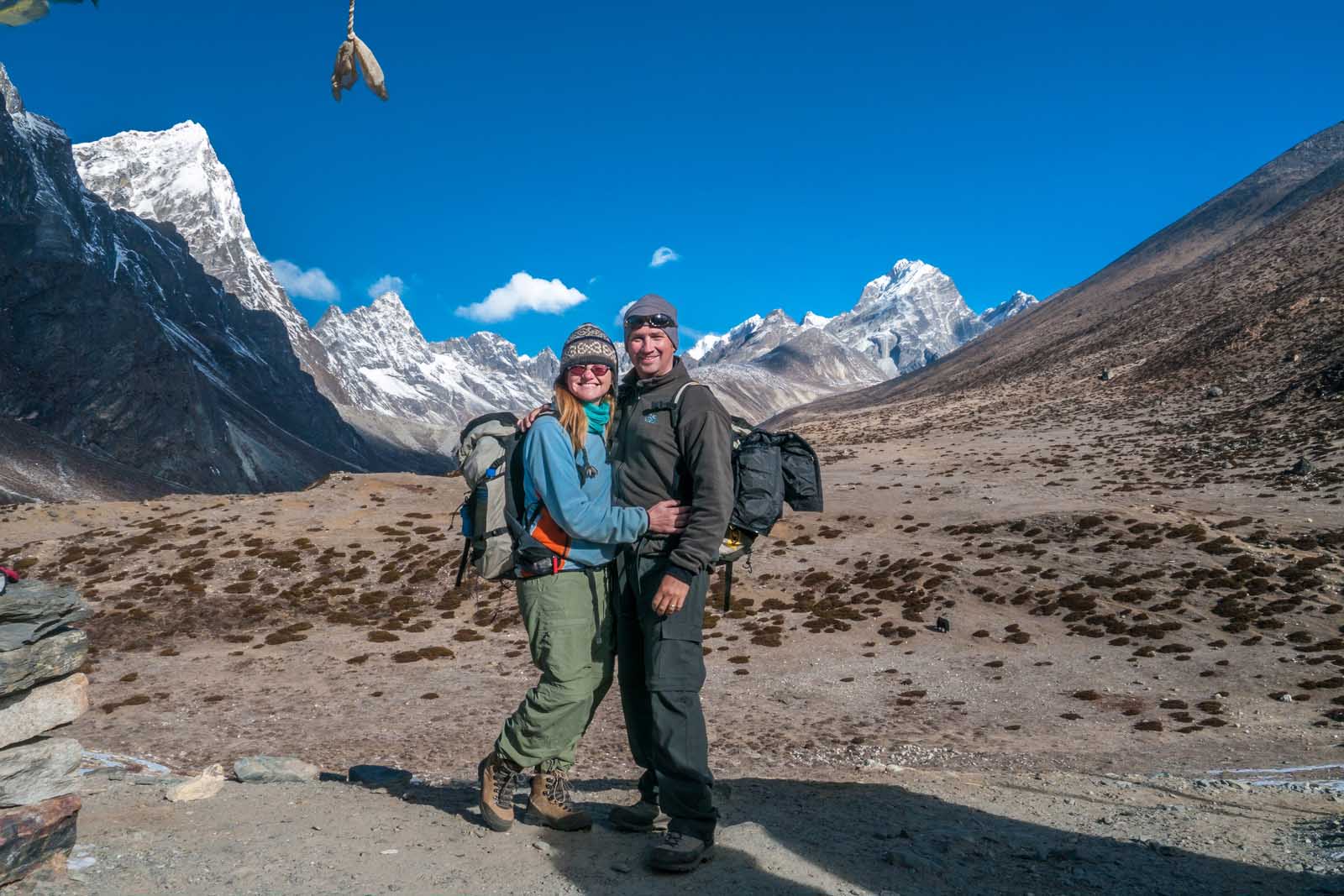
We had a front-row seat to some of the most breathtaking views on earth. An entire panorama of the mountains standing proudly overhead, reaching up to the deepest blue sky that I have ever witnessed. The scene took our breath away. The mountains looked more imposing with each corner we turned and we could not believe that we were fulfilling our dream of hiking to Everest.
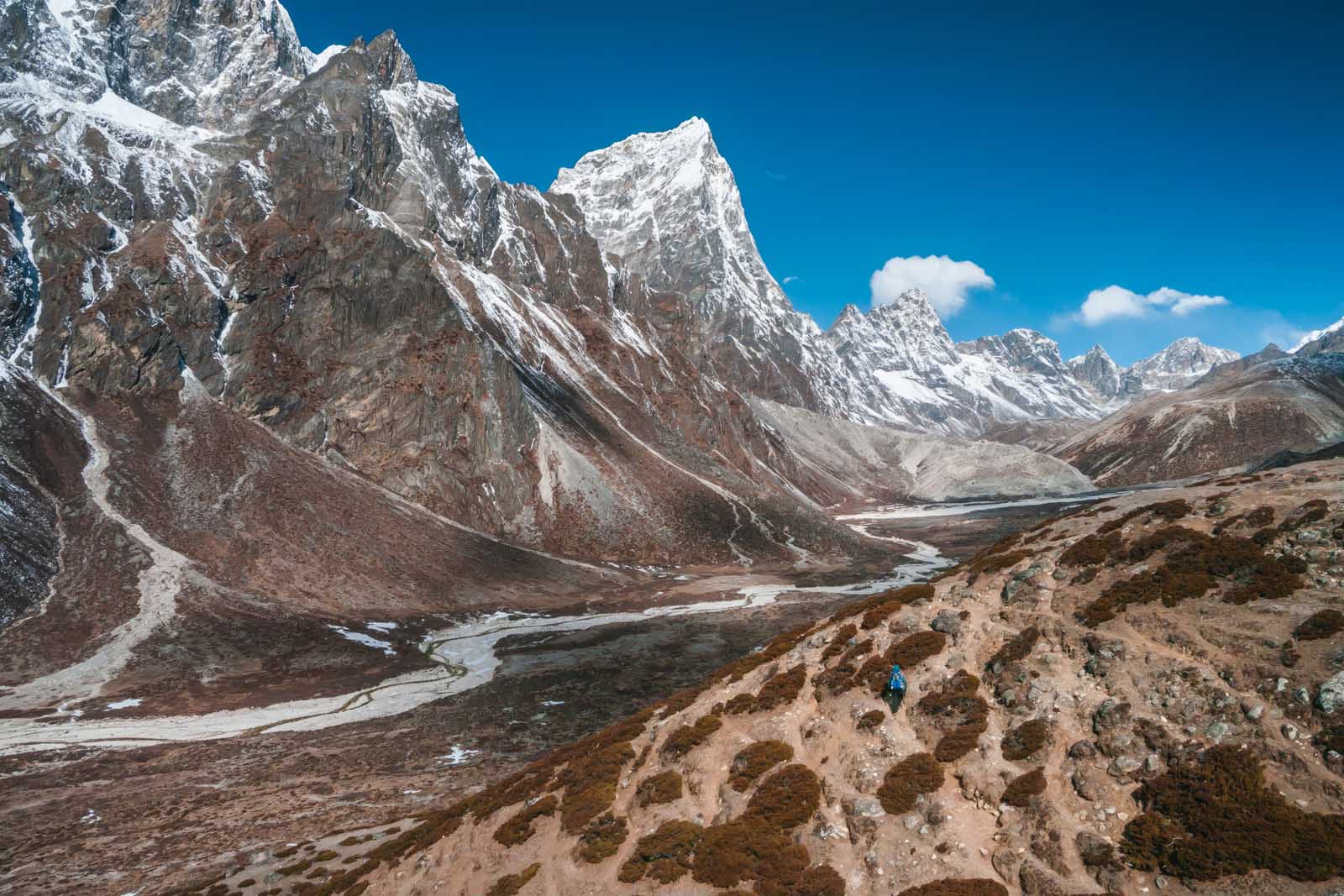
We had to knock on the door to see if Bilbo Baggins happened to be in. Sadly, he wasn’t home. I ended up singing Leonard Nimoy’s Ballad of Bilbo Baggin s for the rest of the day. A bad idea since I only know a few words.
Weather Conditions
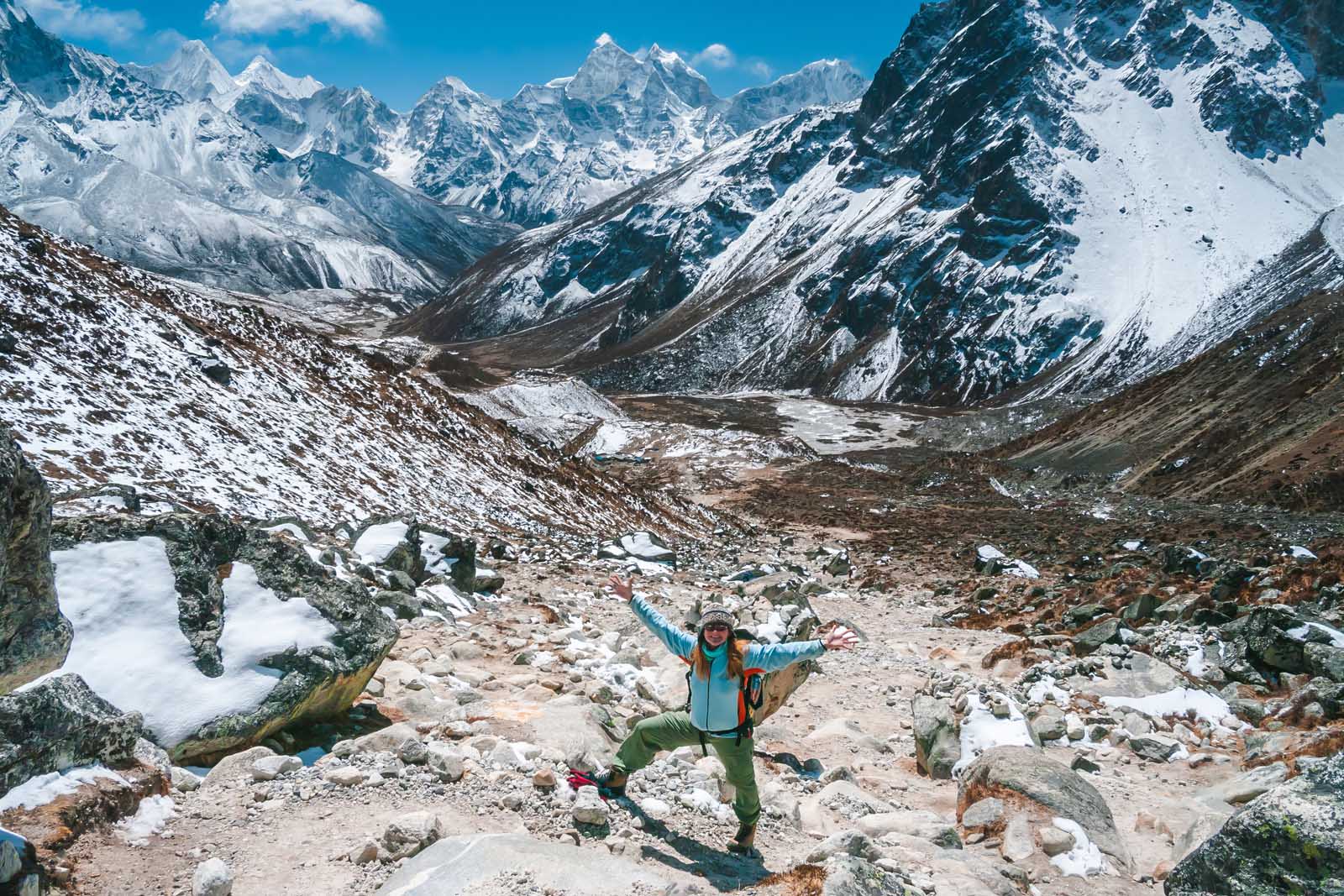
The wind picked up and we put on our outer layers for the first time. We were thankful to have them as we staggered through the high gusts. Weather varies greatly in the Everest Region and before you know it you can have inclement weather so be prepared with your layers. The sun can be shining one minute and then wind and clouds roll in the next.
After lunch, we faced quite the scramble up a steep hill littered with boulders. It looked like a tough climb, but we moved with ease and quickly made it to the top. Where we found our strength, I do not know.
Sherpa Monuments
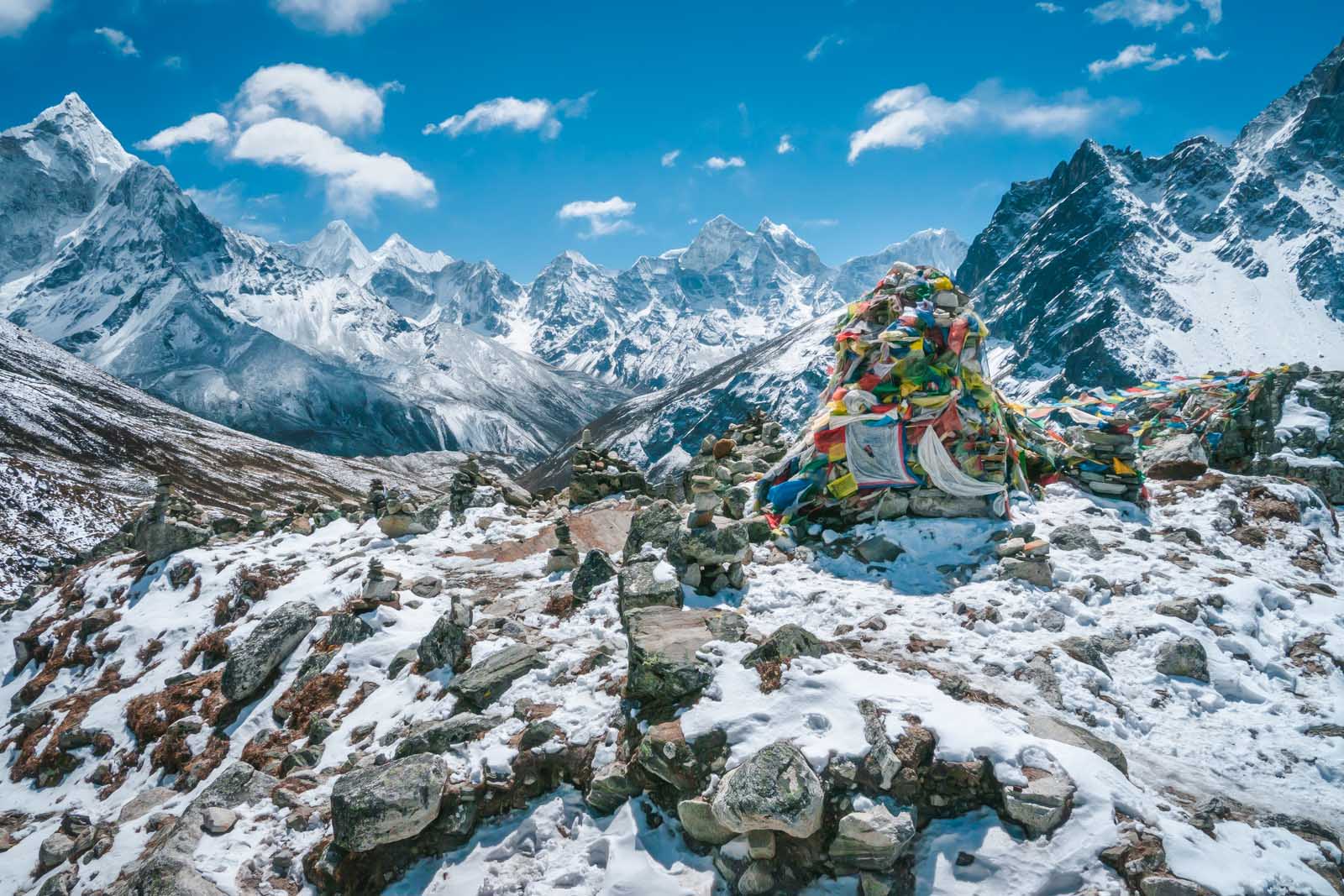
At the top of the hill is a very moving sight. Several monuments and stupas are erected, honoring Sherpas and climbers that have lost their lives on Everest. The most notable of these is Babu Chiri Sherpa .
Babu Chiri Sherpa was the former world record holder of the fastest ascent of Everest, the most number of ascents up the mountain, and the quickest back-to-back summits of 2 in less than 2 weeks. He tragically lost his life on his 11th attempt when he fell into a crevasse.
It was a moving experience and a strong reminder to not take things lightly on Everest, even if you are only trekking to Everest Base Camp. It is still a serious trek.
Dingboche – Elevation – 4410 meters. (14468 feet) above sea level Lobuche – Altitude – 4940 meters (16207 feet) Elevation Gain – 530 meters (1738 feet) Distance – 17.6 km (10.9 miles) Duration – 4 to 5 hours
Day 8 – Morning – Lobuche to Gorak Shep
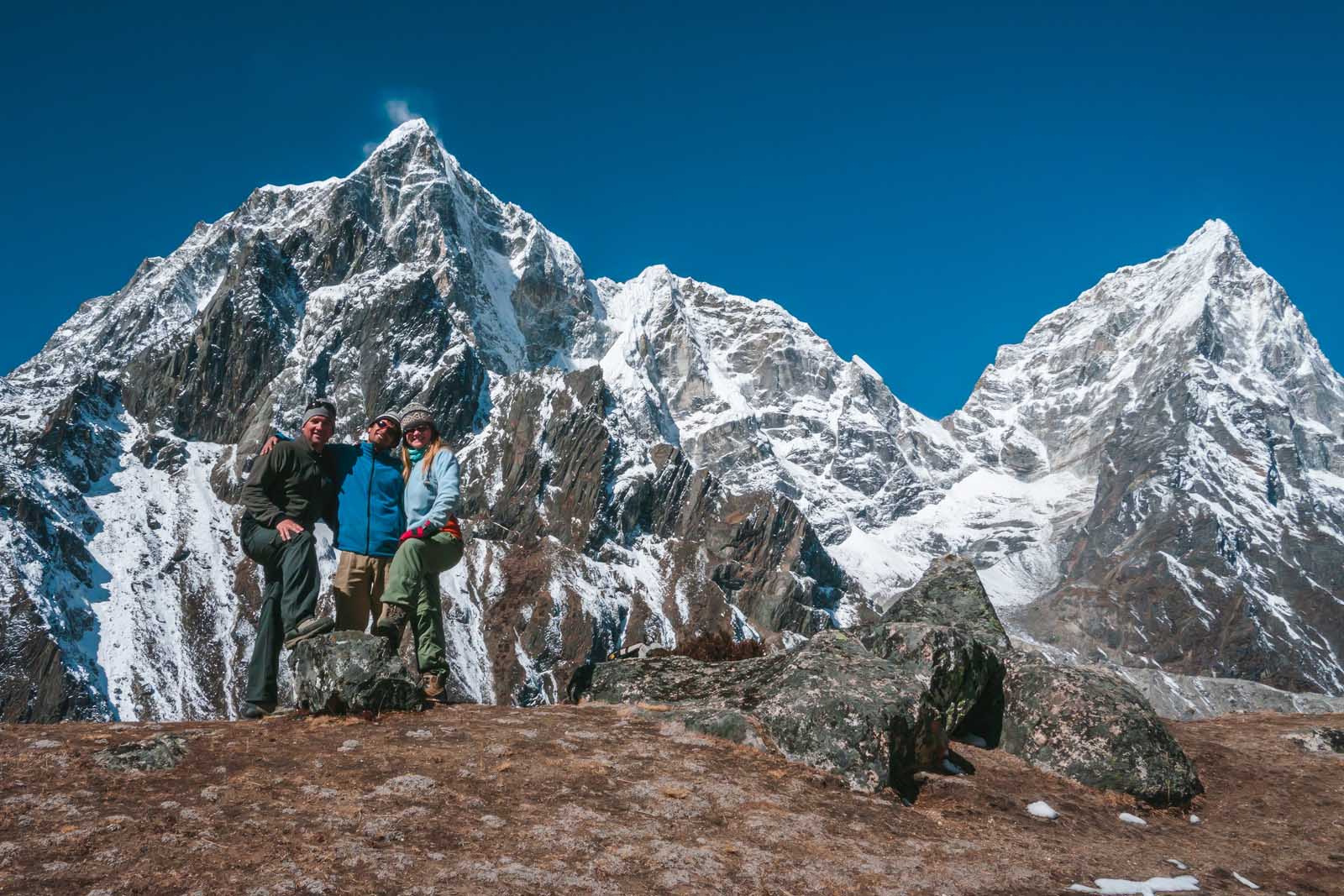
Day 8 on the Everest Base Camp Trek takes you to 5000 meters (16404 feet). How did we feel at 5000 meters? Terrible. Before entering Nepal, I had been suffering for a few weeks in India. The pollution of Kathmandu didn’t help and my congestion was worse when I started the climb. I thought it would clear up in the fresh air, but it intensified with each increase in altitude.
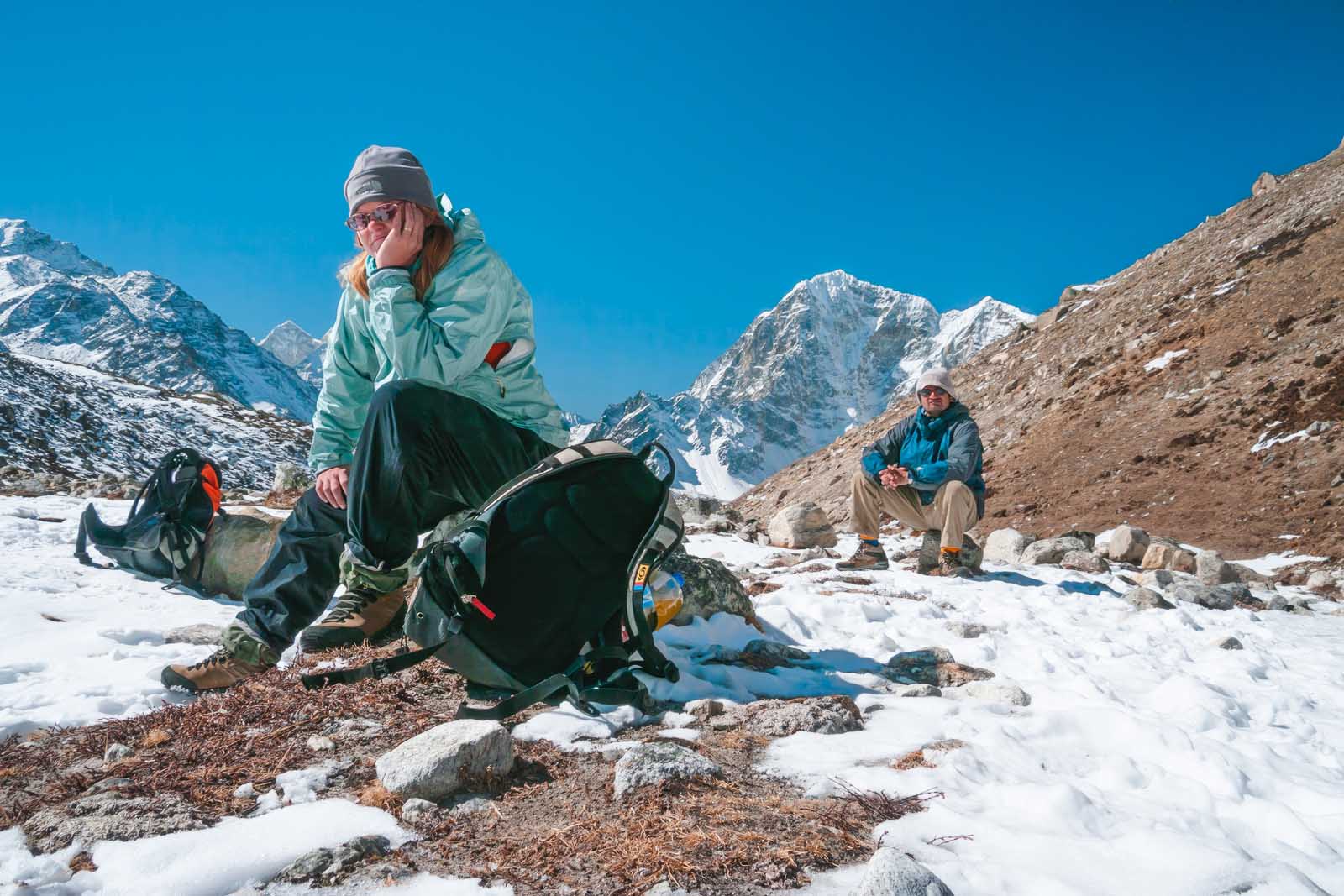
Every morning my cough got worse and my nose was stuffed up to the point of being unbearable. Today, I felt the effects of the congestion and couldn’t catch my breath. It didn’t help that we had gone into such a high altitude. The air is thin and cold.
Dave suffered his first symptoms of altitude sickness when reaching 5000 meters as well. He had a slight case of diarrhea and wasn’t happy about having to wait for the toilet in the teahouses. I think many people were suffering from the same symptoms.
Our was a slow climb to Gorak Shep. We stopped regularly to catch our breath and today we took more breaks than usual. Luckily it was only a couple of hundred meters in elevation gain so we made it to our guest house in Gorek Shep by 12:30.
Lobuche – Altitude – 4940 meters (16207 feet) above sea level Gorak Shep – 5164 meters (16942 feet) above sea level Elevation Gain – 224 meters (734 feet) Distance – 4.3 (2.6 miles) Duration – 4 Hours
Day 8 – Afternoon: Gorak Shep to Everest Base Camp
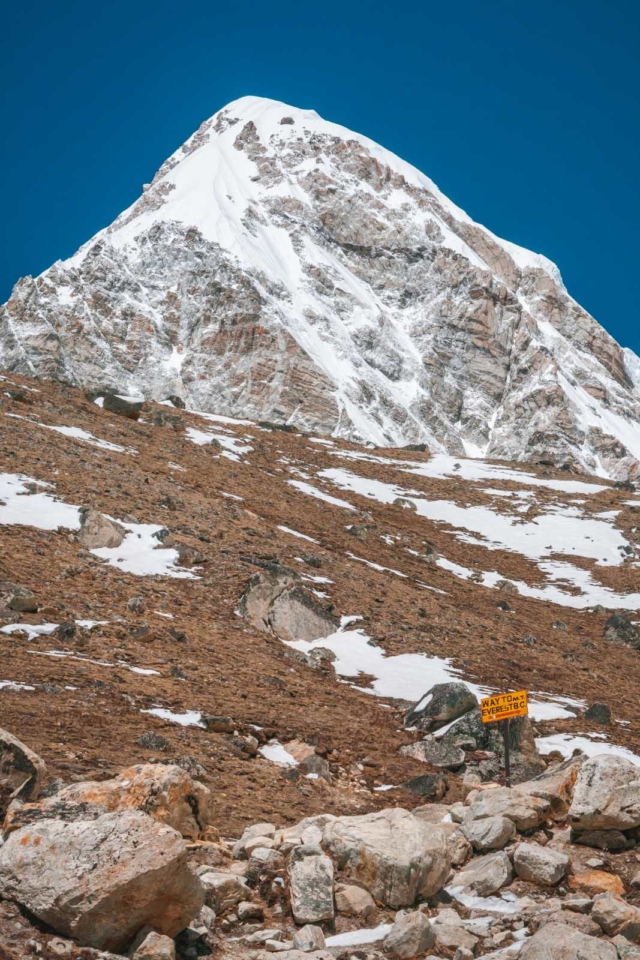
We took a break at Gorek Shep before making out way to Everest Base Camp. We sat in the sun marveling at the fact that we made it this far. After eating a hearty lunch of vegetarian Sherpa stew (Dal Bhat) on the terrace, (yes, we ate outside in the warm sun above 5100 meters) we set out for Everest Base Camp. The sun was shining brightly and it was quite pleasant outside so we were very excited.
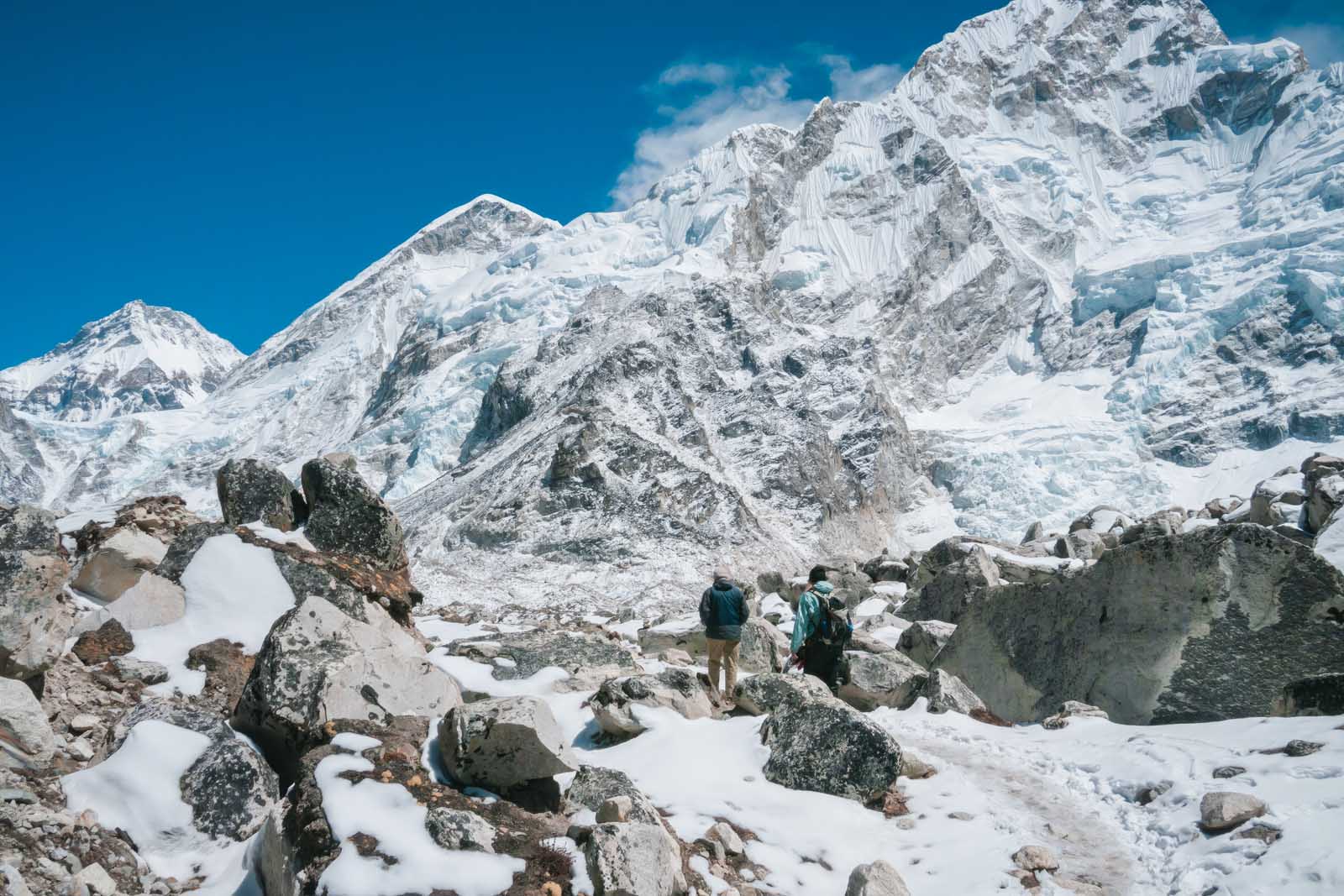
We were lucky and had clear skies. Up until today, the clouds had rolled in by early afternoon every day. Today the sun shone and the skies were blue until sunset. So, it was our perfect morning to make the push.
The trek to Base Camp from Gorak Shep is an easy one. It’s two hours of walking with only a small elevation gain, and we made it with ease. That break for lunch really helped our spirits.
Reaching Everest Base Camp
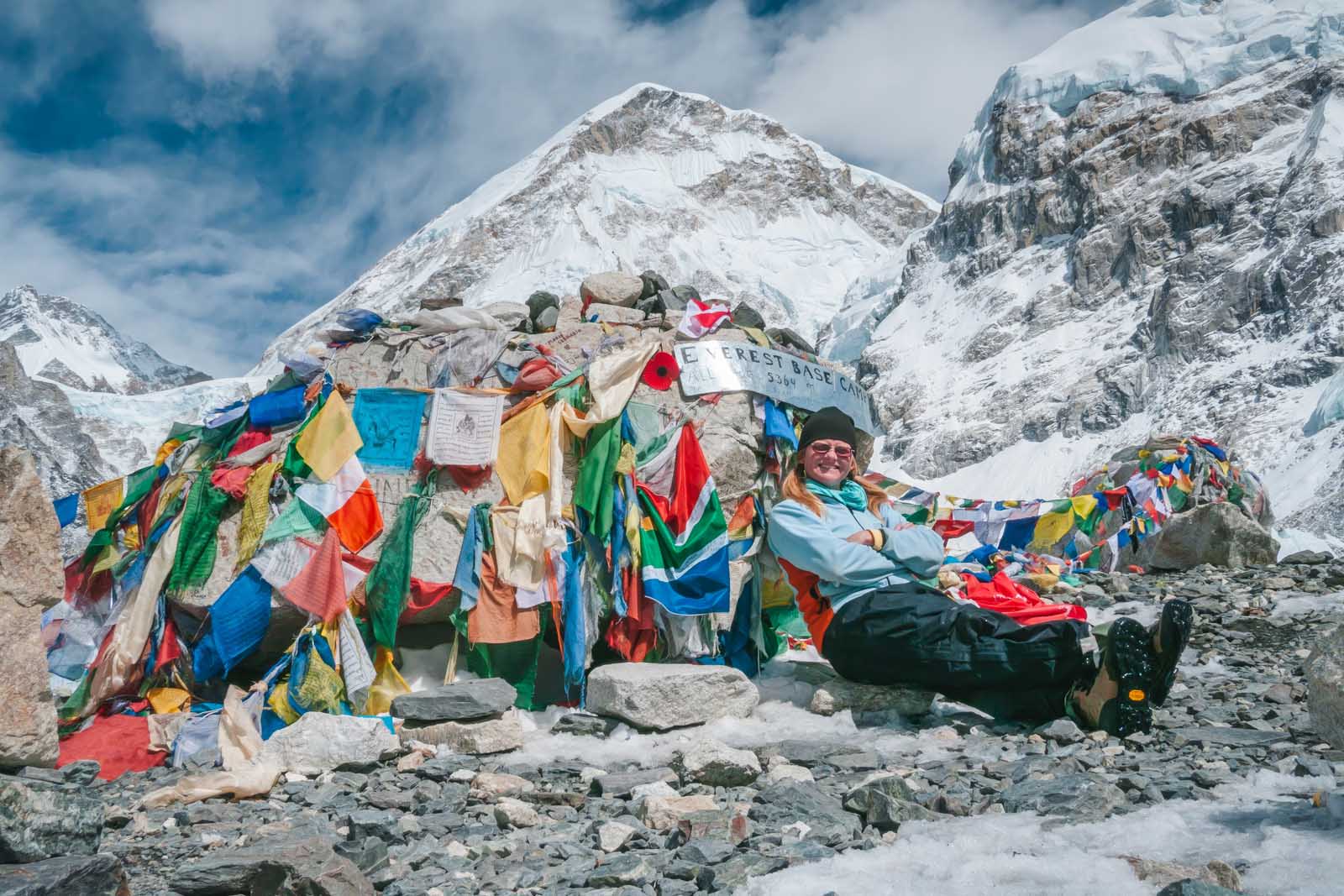
People can summit Mount Everest from Tibet, but the main Everest Base Camp expedition route is in Nepal, and it is busy when the season is in full swing. Even those climbing to the peak of Mt Everest hike the route we took along the Everest Base Camp trek.
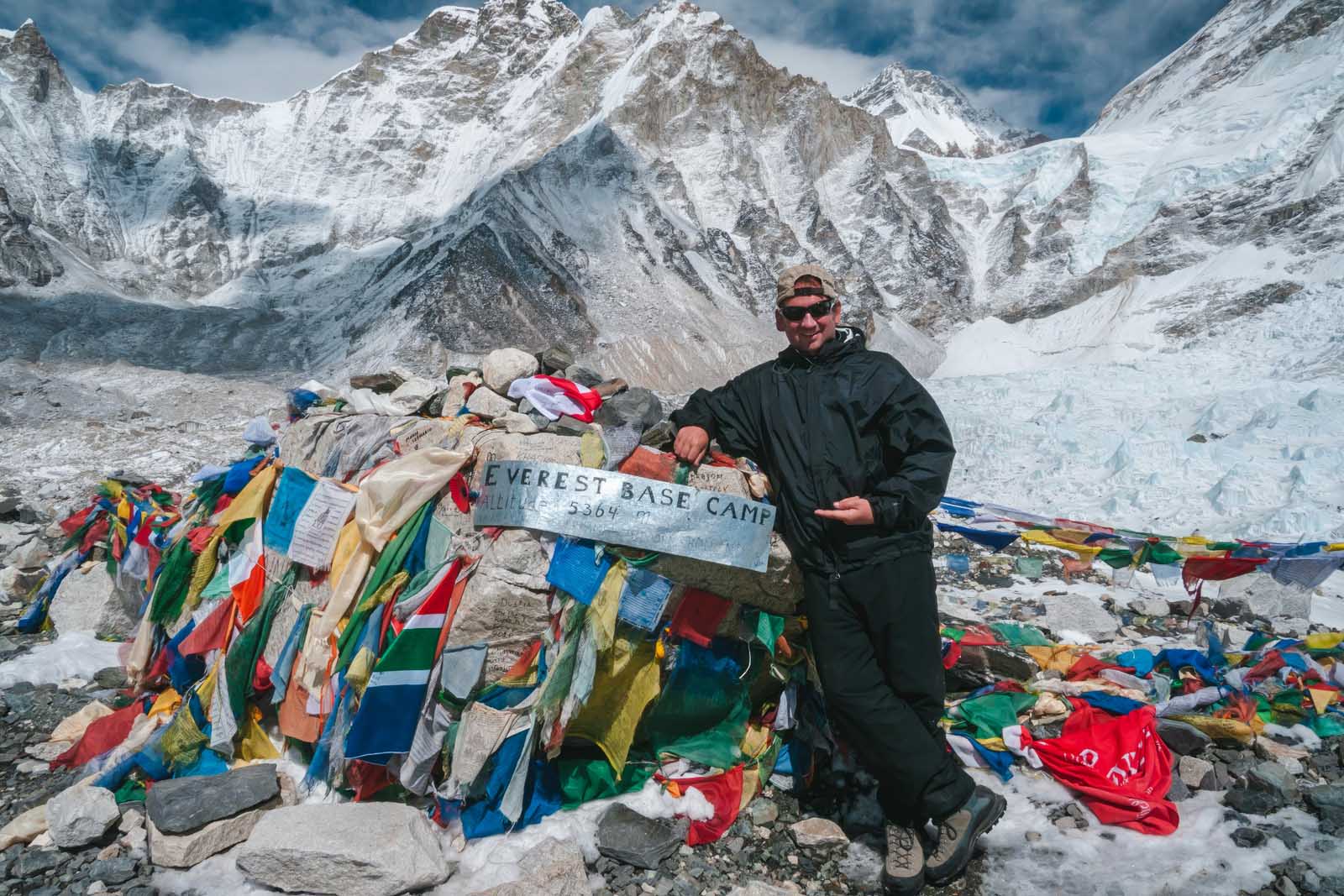
We arrived just a week or two before the season, so it was still quiet on the mountain. In fact, we were the only people at Base Camp that afternoon. We saw another group coming down on our way up, but once there we had it all to ourselves. It was thrilling.
To reach Everest base camp, you will hike out from nearby Gorak Shep and then hike back the same day to spend the night in the village. You do not spend the night at base camp.
Khumbu Glacier
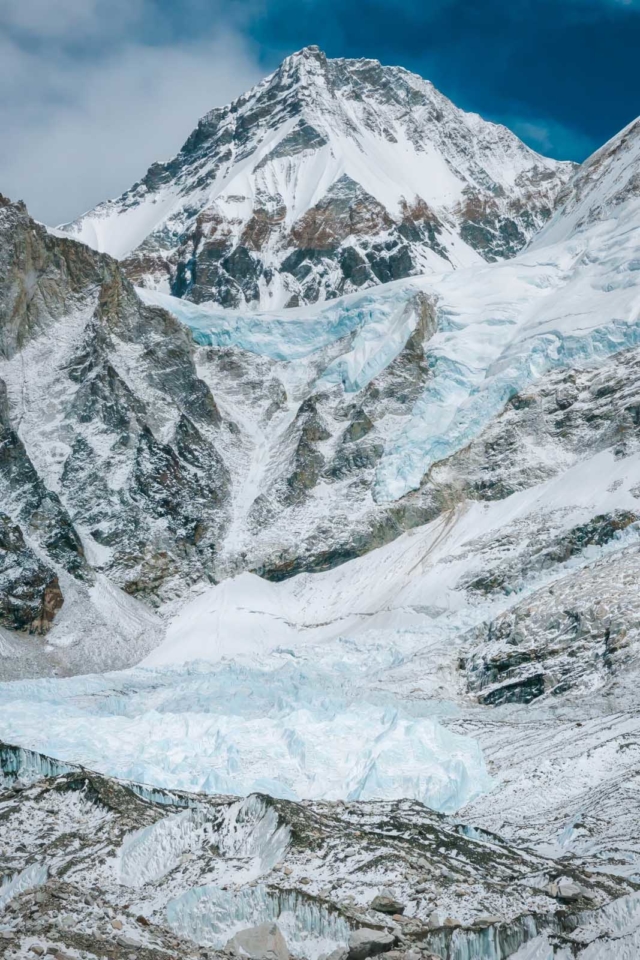
The Khumbu Glacier is the first thing to come into view, and it is unbelievable to think that we are actually standing there. The Khumbu Glacier is the largest glacier in all of Nepal and is famous for the Khumbu Icefall. This treacherous sheet of ice is the most dangerous obstacle that climbers face when summiting Everest.
We witnessed an avalanche that reminded us just how precarious the climb to Mount Everest is. It is an intimidating sight and I cannot imagine having the courage to cross that field of ice. Climbers walk across ladders that shift and move as the ice is alive and constantly settling. It has taken many lives, and we were happy to look at it from afar.
With an elevation of 7600 meters at its source, the Khumbu Glacier is the highest glacier in the world and the Khumbu Icefall is one of the most dangerous portions of the climb to the summit of the world’s highest peak. We were happy to look at it from afar.
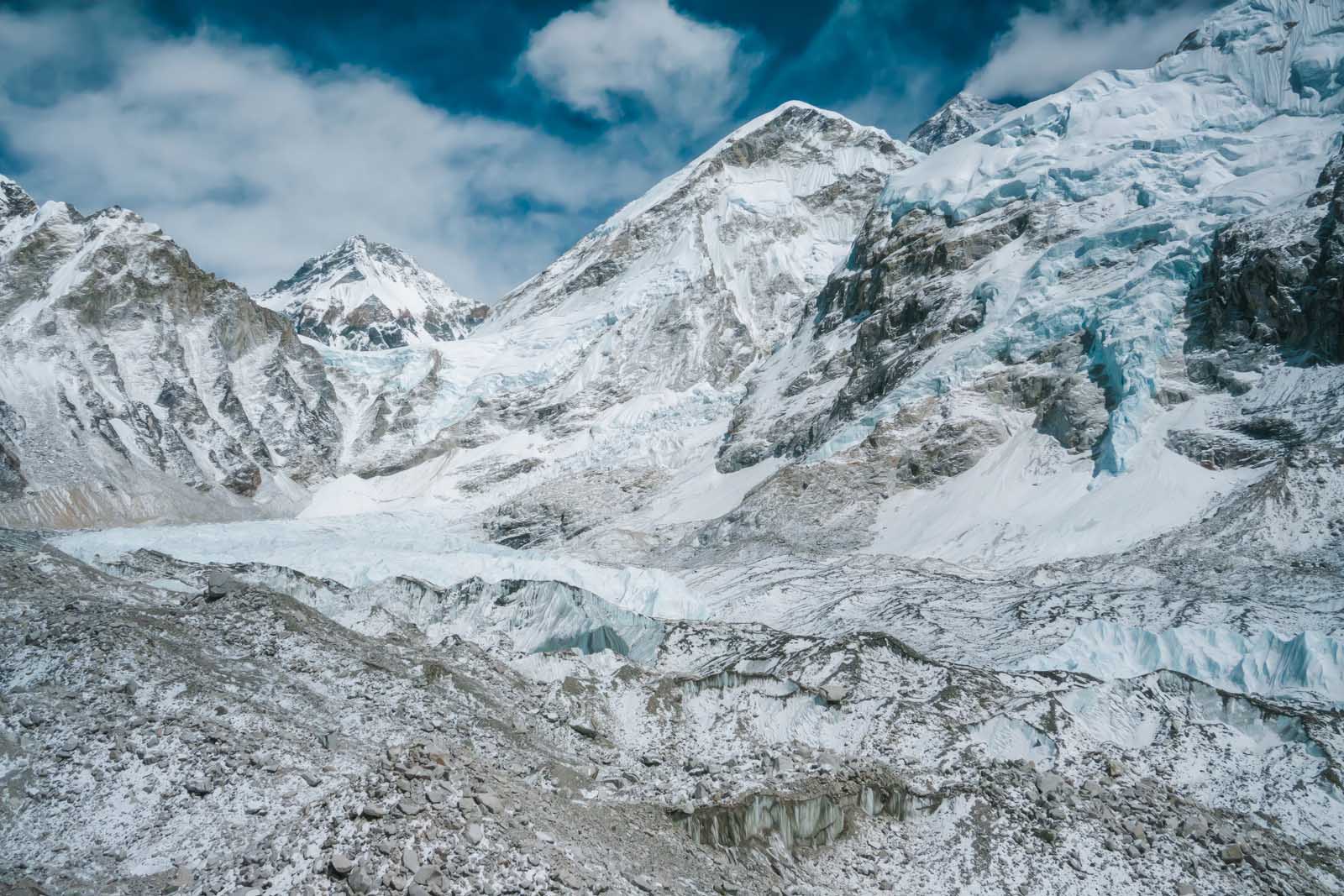
Everest Base Camp’s elevation is 5,364m (17,598 feet) so you will feel the high altitude. But, if you have taken your time you should feel pretty good. We had been at this elevation now for a while and stayed hydrated, so we could enjoy the experience.
We stood at a rock covered with prayer flags announcing that yes, we had made it to Mount Everest Base Camp at 5364 meters. We stayed for almost an hour taking videos, celebrating, and snapping photos. If you can bear it, don’t rush the experience, take it in and enjoy every minute. This will be the only time you’ll see it.
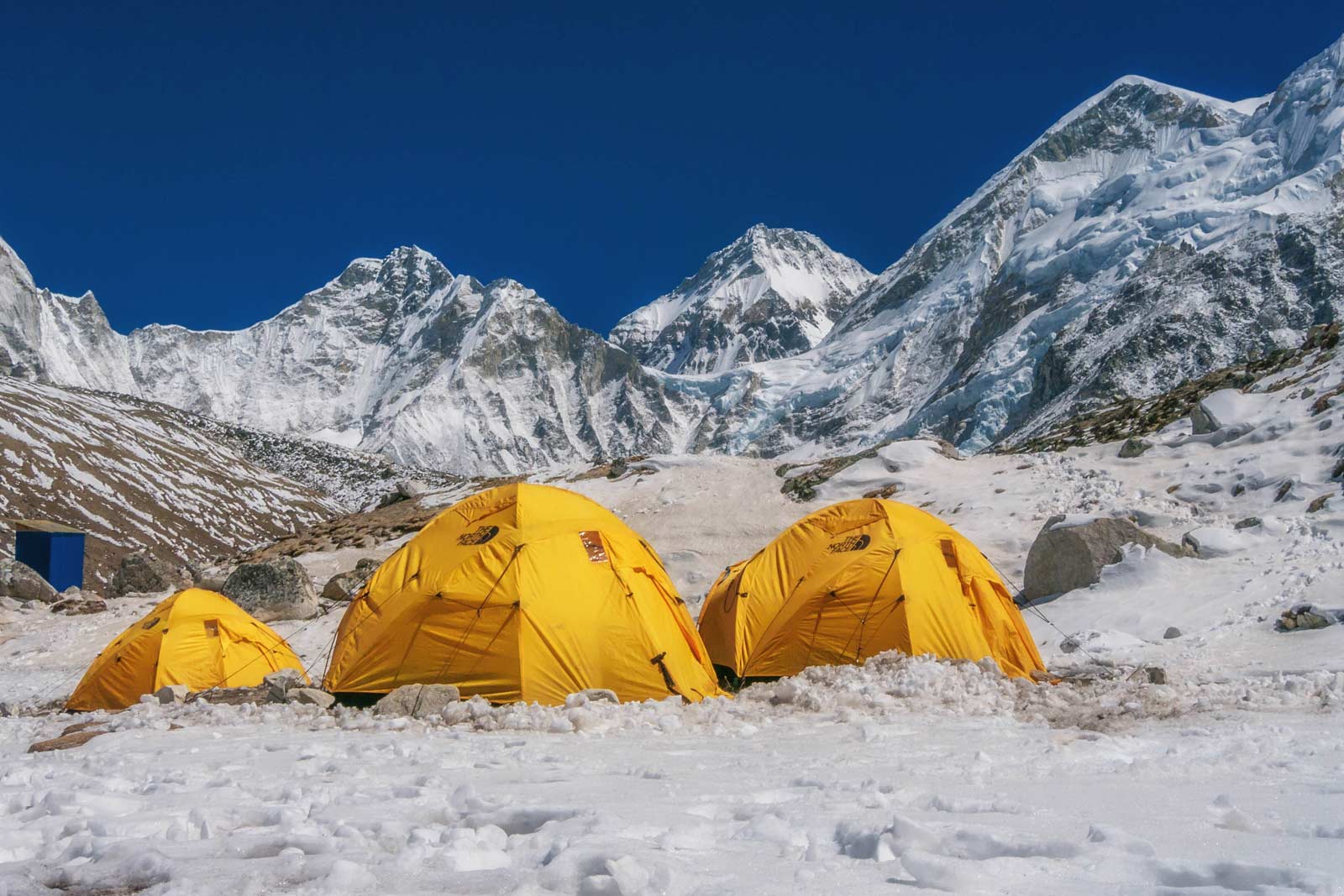
Trekking to Everest may be more exciting later in the season when Everest expeditions are there, but we really liked having base camp to ourselves. There wasn’t a soul on the mountain except for the three of us. We stayed for almost an hour taking videos, celebrating, snapping photos, and marveling at the massive Khumbu Glacier. Can it really be true that we are here? It felt like a dream.
We finished our climb about two weeks before the high season began and we wouldn’t have it any other way. We stood at a rock covered with prayer flags announcing that yes, we had made it to Everest Base Camp.
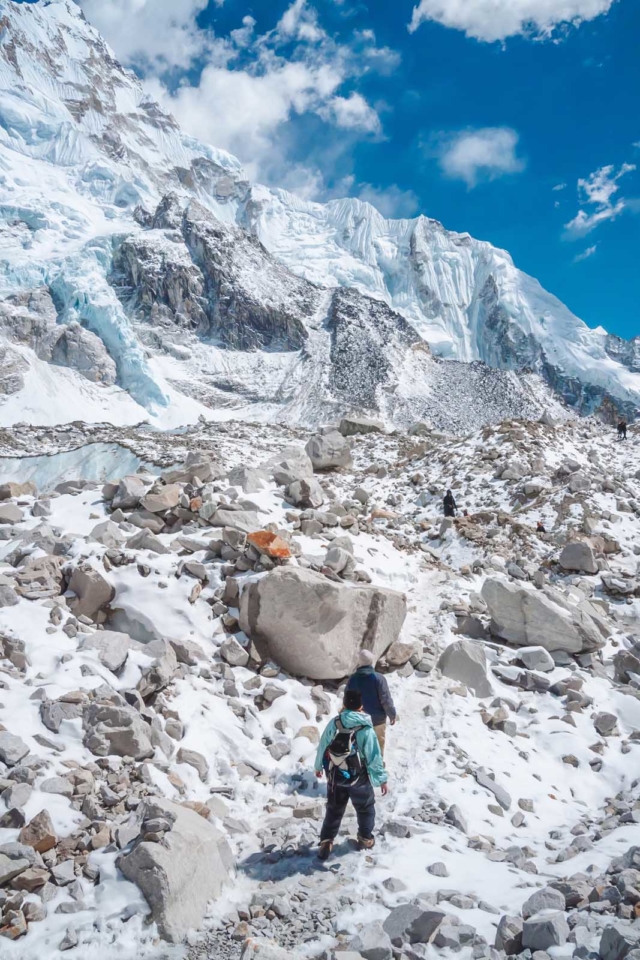
When it’s high season, base camp is filled with expeditions and tents spanning the valley. We only saw one expedition so far. They may have been here to climb Island Peak as base camp is also a place to acclimate for that peak.
We started to make our way back to Gorak Shep from Everest Base Camp at about 3:30 pm. Even though it was an easy trek back, there are narrow paths atop high ledges and it just so happens that while we were walking back, an ice bridge broke off after I stepped on it leaving Dave with a sticky situation of having to take one giant leap over a gorge. We made it back to Gorak Shep safely but it was a reminder just how dangerous the Himalayas can be.
Back to Gorak Shep
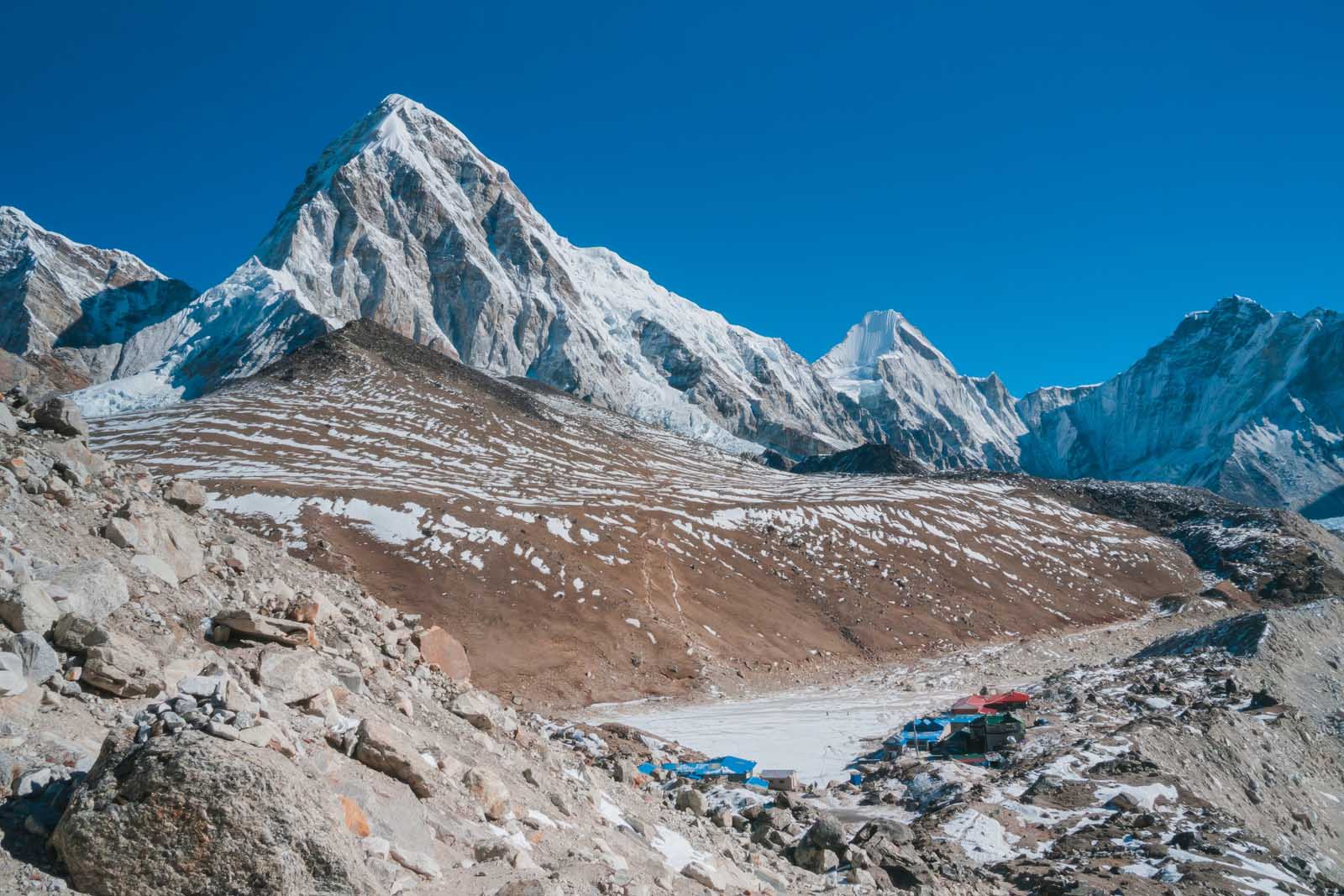
By the time we made it back to Gorak Shep, the excitement of reaching Everest base camp had worn off. We had reached our final destination Base Camp, but there was still a lot more trekking to go.
We were happy to have seen it, but we were exhausted. We felt the same when we climbed Mount Kilimanjaro. The thrill of reaching your destination is over and there is nothing more to look forward to, but there are still so many days to go.
That night I had serious sinus congestion and felt like I was suffocating in my freezing bed. It was quite scary to already be short of breath because of the altitude and then be completely congested. I really was terrified. Our guide Dipendra brought me hot tea all night and I slathered myself in Vicks Vaporub but nothing helped me to breathe easier.
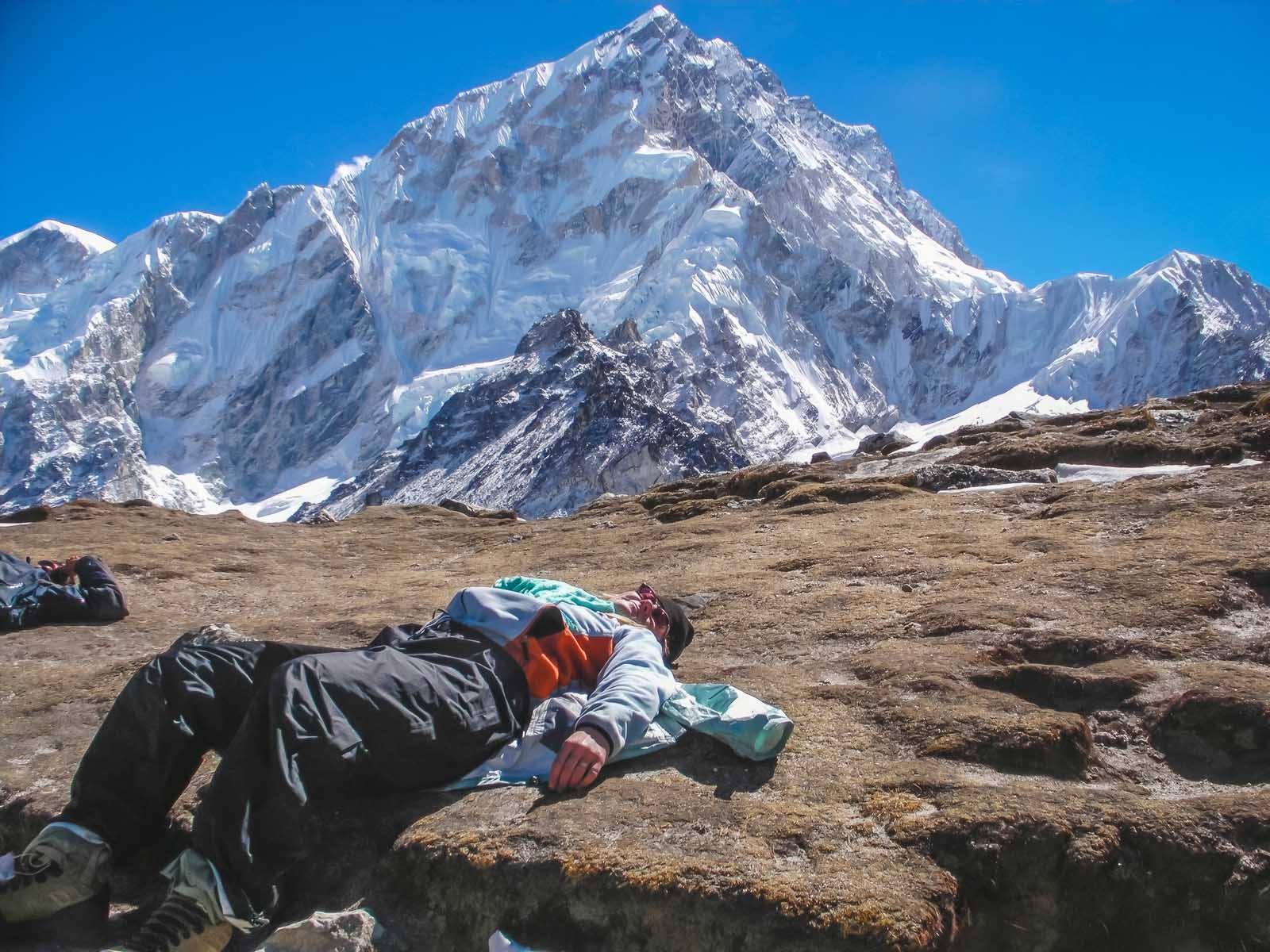
I was afraid as we had the Gokyo Lake trek ahead through the Cho La Pass. We were also planning to trek up to Kala Pattar for the best views of Everest in the morning. I hope I could make it but I was also dreading the day ahead. I barely slept a wink but I finally drifted into a not-so-peaceful slumber.
Gorak Shep – 5164 meters (16942 feet) above sea level Everest Base Camp Elevation – 5,364m (17,598 feet) above sea level Elevation Gain – 200 meters (656 feet) Distance – 3.5 km one way (2.1 miles) Duration – Three Hours Round Trip
Alternative Gokyo Lake Via Cho La Pass
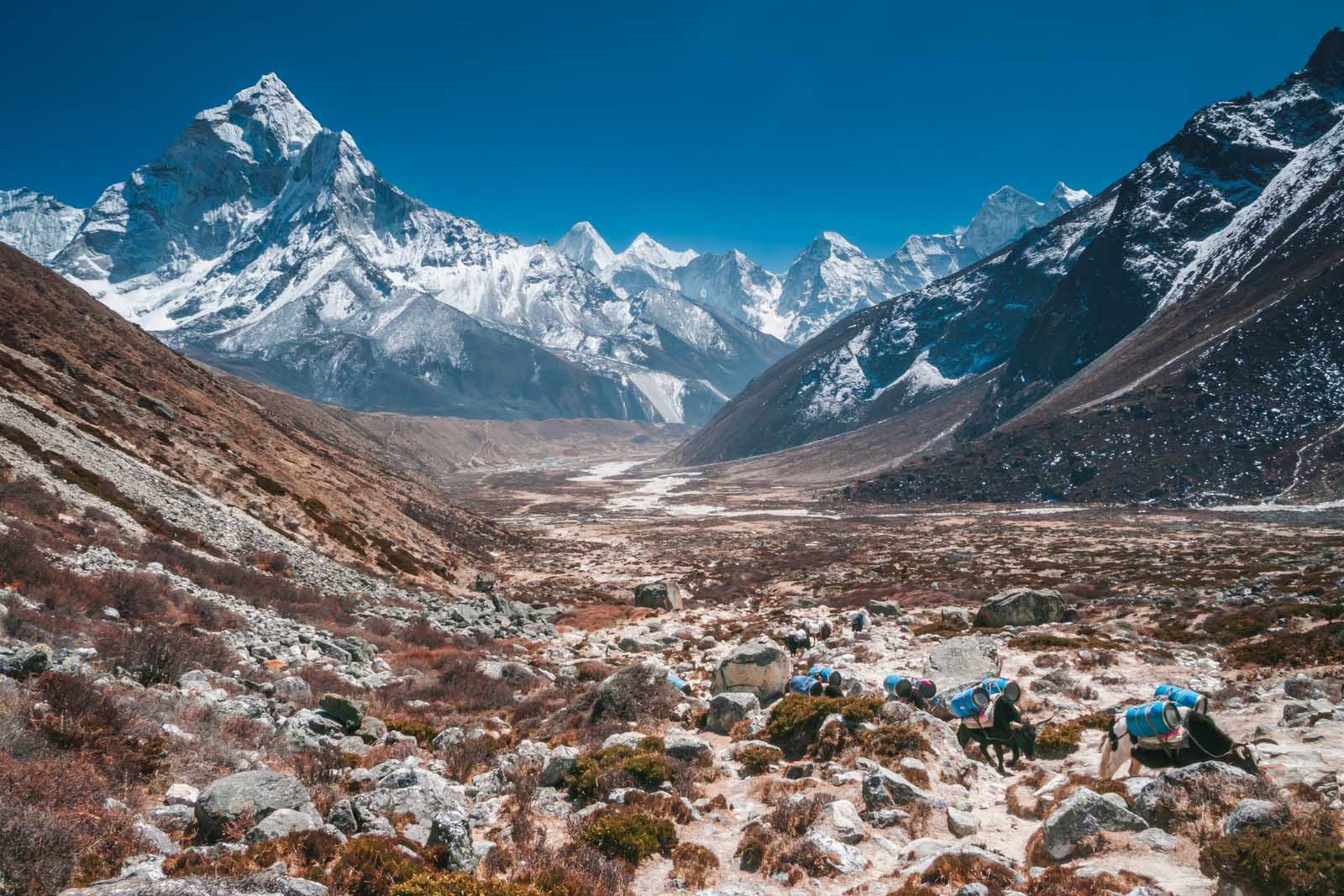
The next morning after a terrible night, we gave up our plans of climbing Kala Patthar and then on to the Gokyo Lakes and Cho La Pass trek. Even though I wasn’t feeling dizzy, nauseous, or lightheaded anymore, the sinus congestion was really getting to me. At altitude a cold can turn serious quickly, you just can’t take a chance when altitude is involved.
But, if we were going to trek on, this would be the next stop. It is supposed to be beautiful and if you are feeling up to it, we highly recommend it. This makes the trek much more interesting as you get to take a different way back to Lukla.
Cho La Pass: Altitude 5420 meters (17,782 feet) Gokyo Ri: 5357 Meters (17,575 feet) Gokyo Lakes: 4,700–5,000 m (15,400–16,400 ft)
Day 9 – The Descent and Kala Patthar
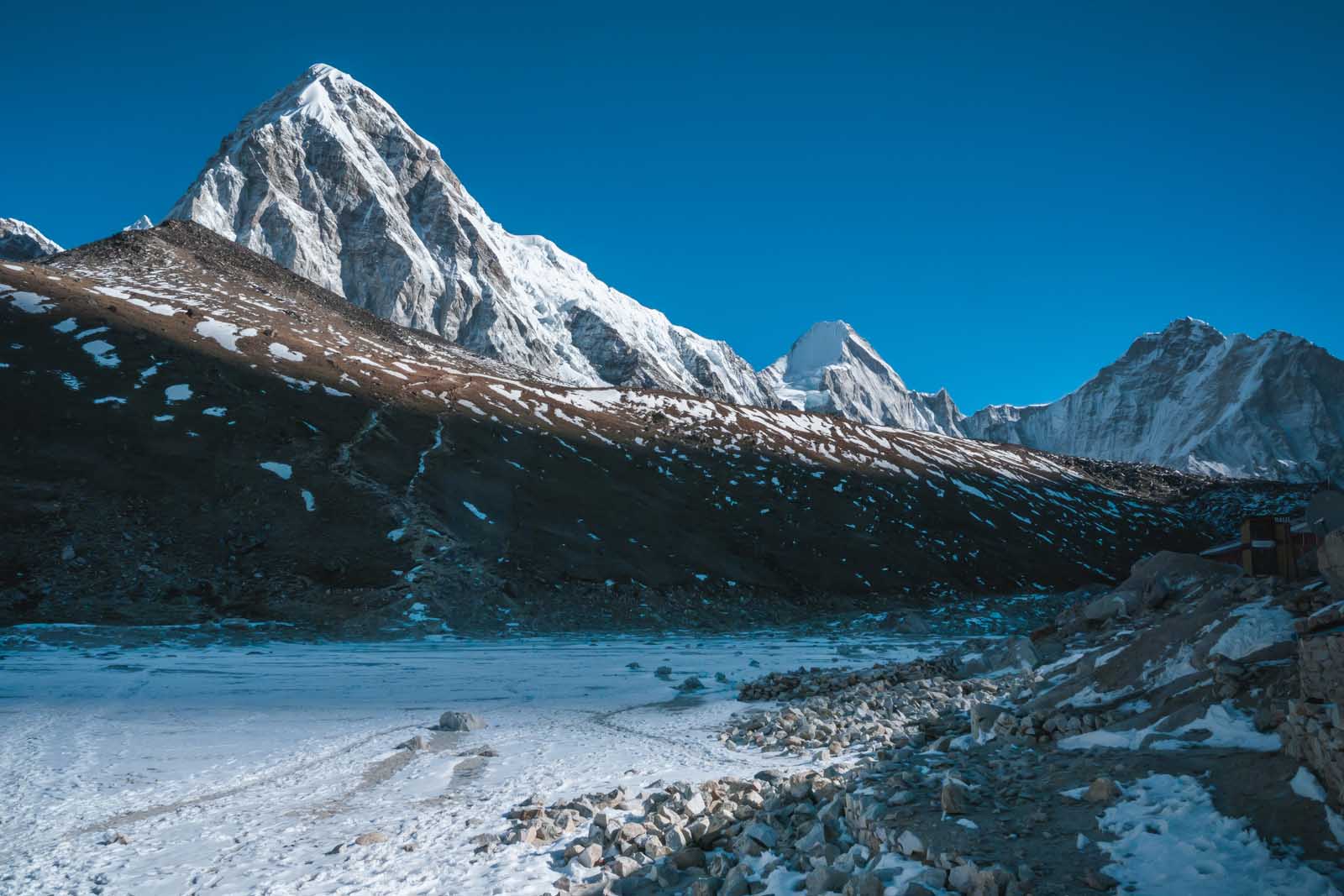
Kala Patthar is a hill above Gorak Shep that offers the best views of Everest and is a must-stop on anyone’s Everest Base Camp trekking route. We had planned to climb to the summit of Kala Patthar, but my congestion was so bad, that we decided it was safer to get to a lower elevation quickly.
Kala Patthar is a quick two-hour trek to add to your descent back to Lukla. It is a good option if you are feeling up for it as it gives a great view of Mt. Everest. Make sure to start early morning before dawn as there is still a long day of trekking after summiting Kala Pattar. Plan on another five or six hours to your next overnight stop at Pheriche.
Kala Patthar to Pheriche – Afternoon
By the time you reach your accommodation at Periche, you should be feeling a lot better. Dave and I find that we are fine in the 4000-meter ranges of altitude and experience very few symptoms of altitude sickness. It is at 5000 meters and above that, we start to feel our symptoms. Periche is a much more manageable 4371 meters.
Kala Pattar: 5643 metres Pheriche: 4371 Meters Altitude Loss : 1272
Days 10 to 11 – The Descent from Everest Base Camp
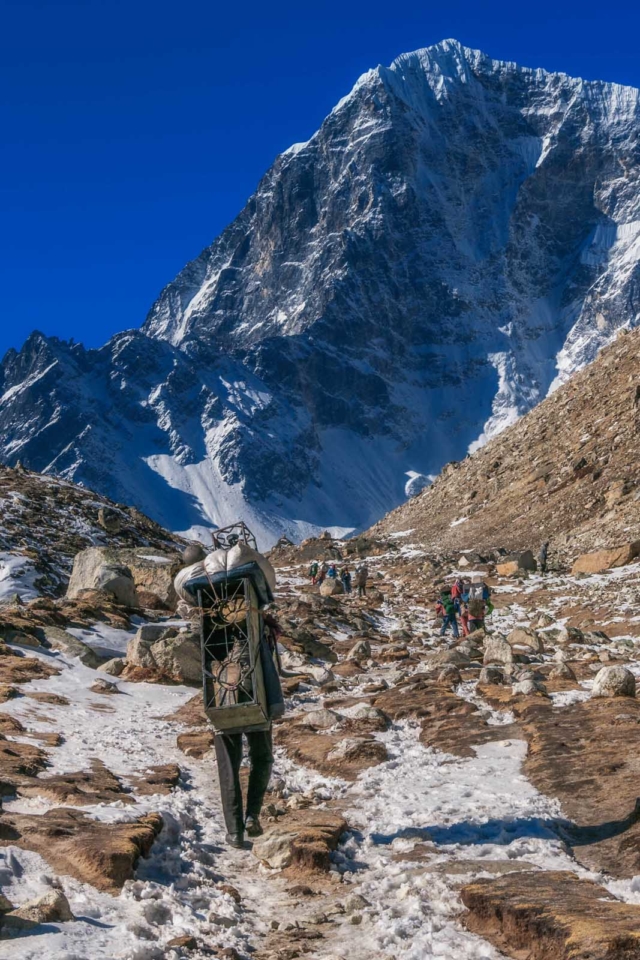
It took us two days more to trek back from Everest Base Camp to our final destination on the EBC Trek. I started feeling better on the second day as the dryness of the Everest base camp disappeared. My sinuses cleared and soon I was breathing easily. I started to feel guilty about turning around, but in hindsight, I know it was the right choice. You never want to take a chance with altitude sickness.
Even though we were heading down, there is still a lot of altitude gain as the EBC trek doesn’t continuously go downhill. I was feeling really fatigued and we still had a tough couple of days ahead of us. But knowing there was light at the end of the tunnel made everything easier.
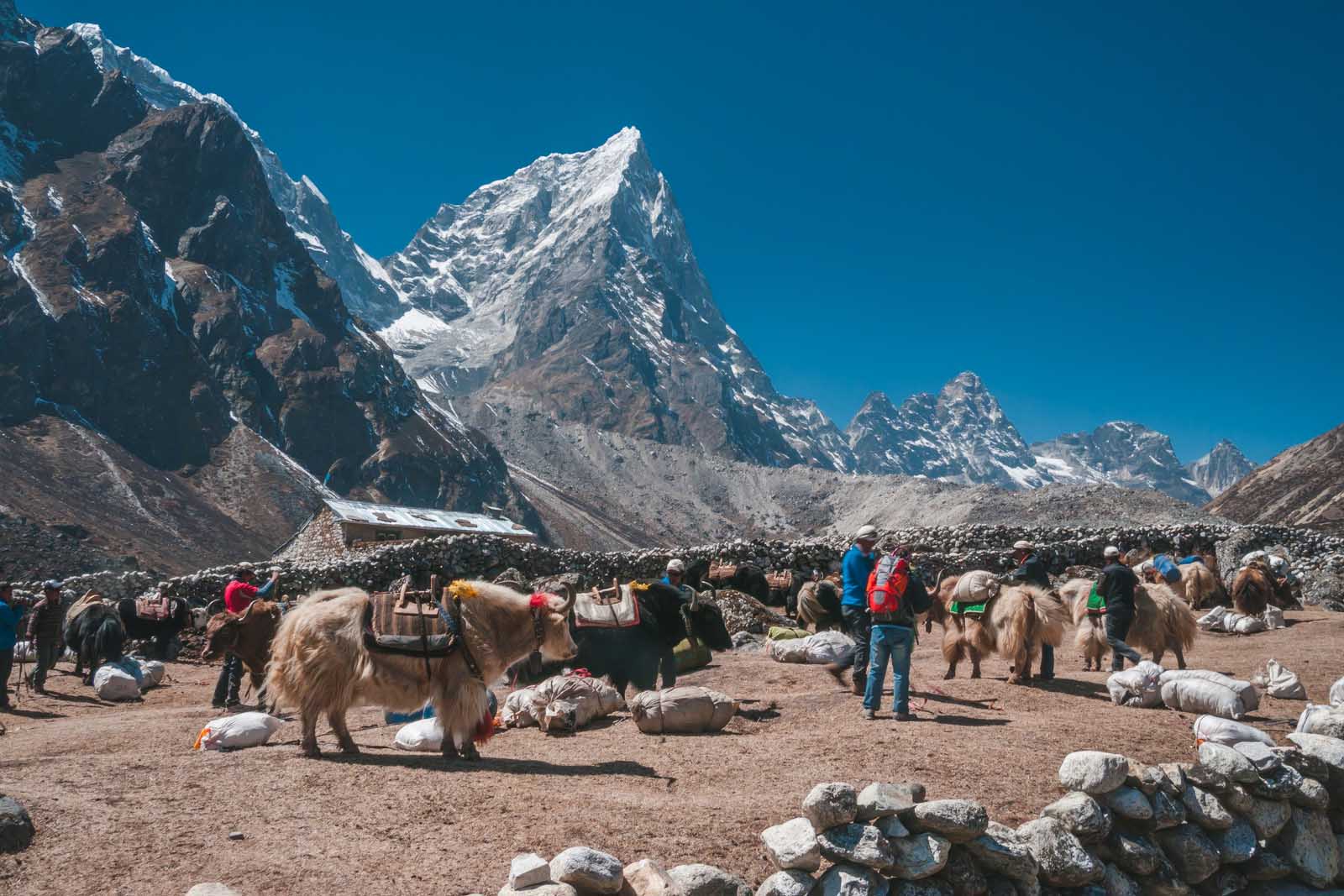
It takes a lot of mental stamina to climb back down as the euphoria of reaching the Everest base camp has worn off, but we made the most of it, by chatting with other trekkers and getting to know our guides better.
During our decent we could actually take our time to smell the roses or should I say enjoy the trekking trail that ran through the stunning rhododendron forest.
Rhododendrons are beautiful flowering plants that bloom in different shades of pink, red, white, and purple. The rhododendron forest is particularly prominent in the areas of Phakding, Namche Bazaar, Tengboche, and Dingboche which we really didn’t notice until we made our way down the mountains.
We followed the route we came up with, but it was much faster and we stayed in different villages. The beauty of booking organized trips with a local guide is that our guide Dipendra knew the routes like the back of his hand, so he could change accommodations easily to suit our speed.
Day 12 – Lukla
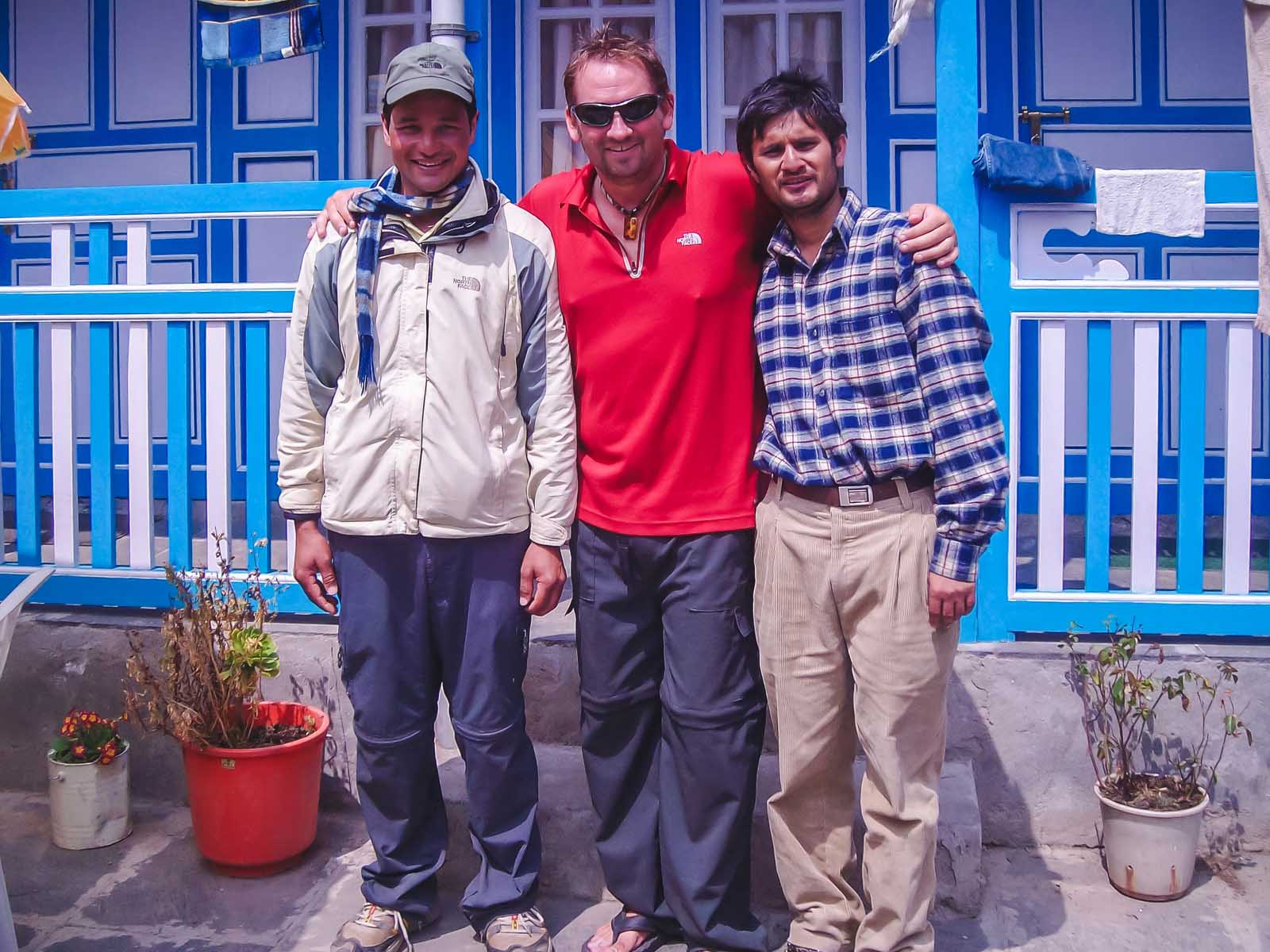
We were back in Lukla early on day 12 of our EBC Trek and had an evening booked in a guest house here to catch the first flight from Lukla back to Kathmandu in the morning. As much as we loved our trip to Everest, we were excited to be moving on to explore more of Nepal.
The accommodation was pleasant with a lovely restaurant, hot shower, and warm and cozy beds. It was a great way to end the trip.
Day 13 – Return To Kathmandu Flight from Lukla Airport
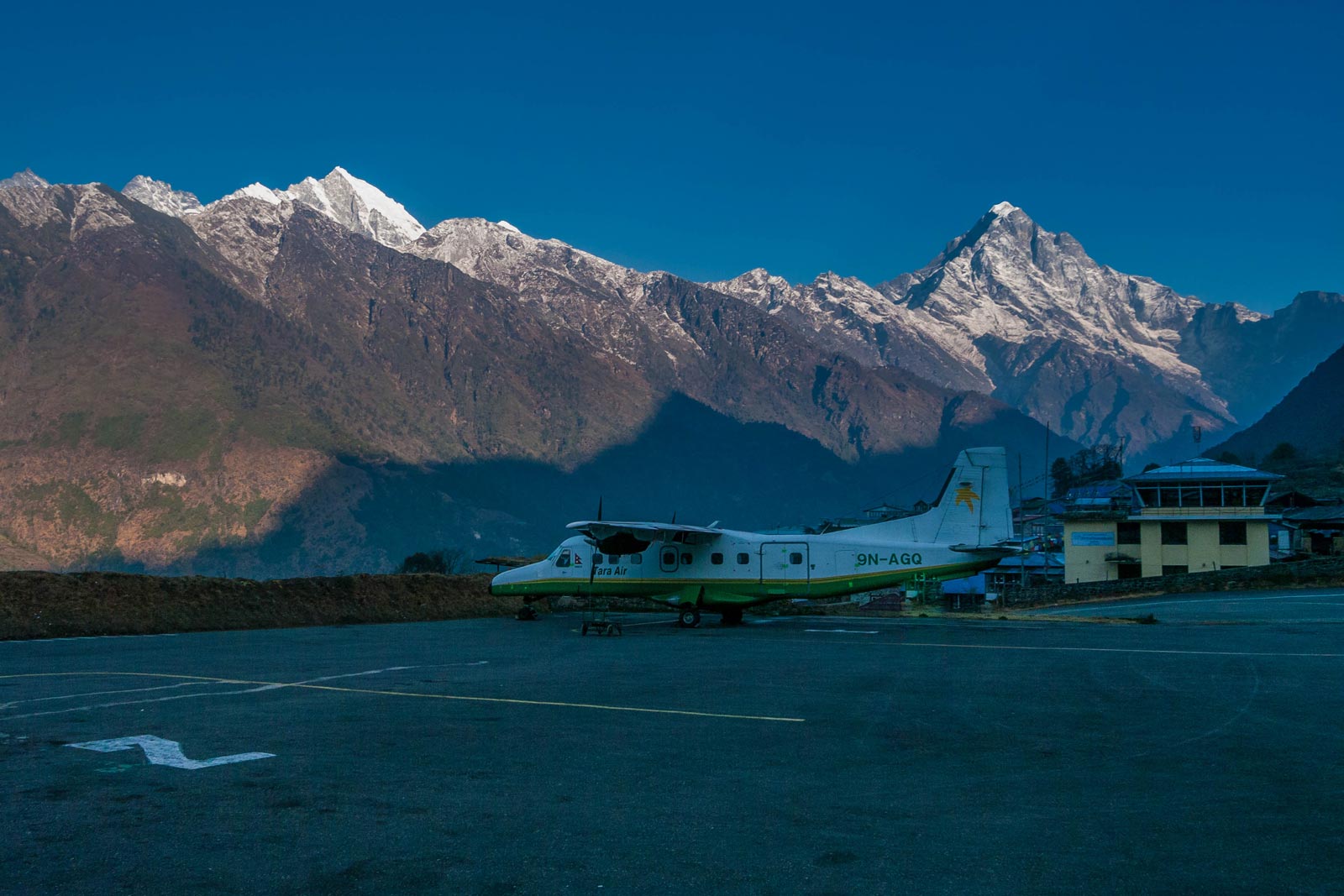
It is very important to give yourself an extra cushion when booking your return flight not only home from Kathmandu but from Lukla. We stayed overnight in Lukla on the final night of our trek and booked a flight to Kathmandu for first thing the next morning.
It is not uncommon for flights to be canceled or delayed flying out of Lukla Airport. Weather conditions change quickly. So give a bit of a cushion when booking your flight home from Nepal after you’ve finished your trek to Everest Base Camp. Many a traveler has missed their connecting flights home from Kathmandu because of delays in Lukla. It is safer to plan to spend a night or two in Kathmandu after your trek.
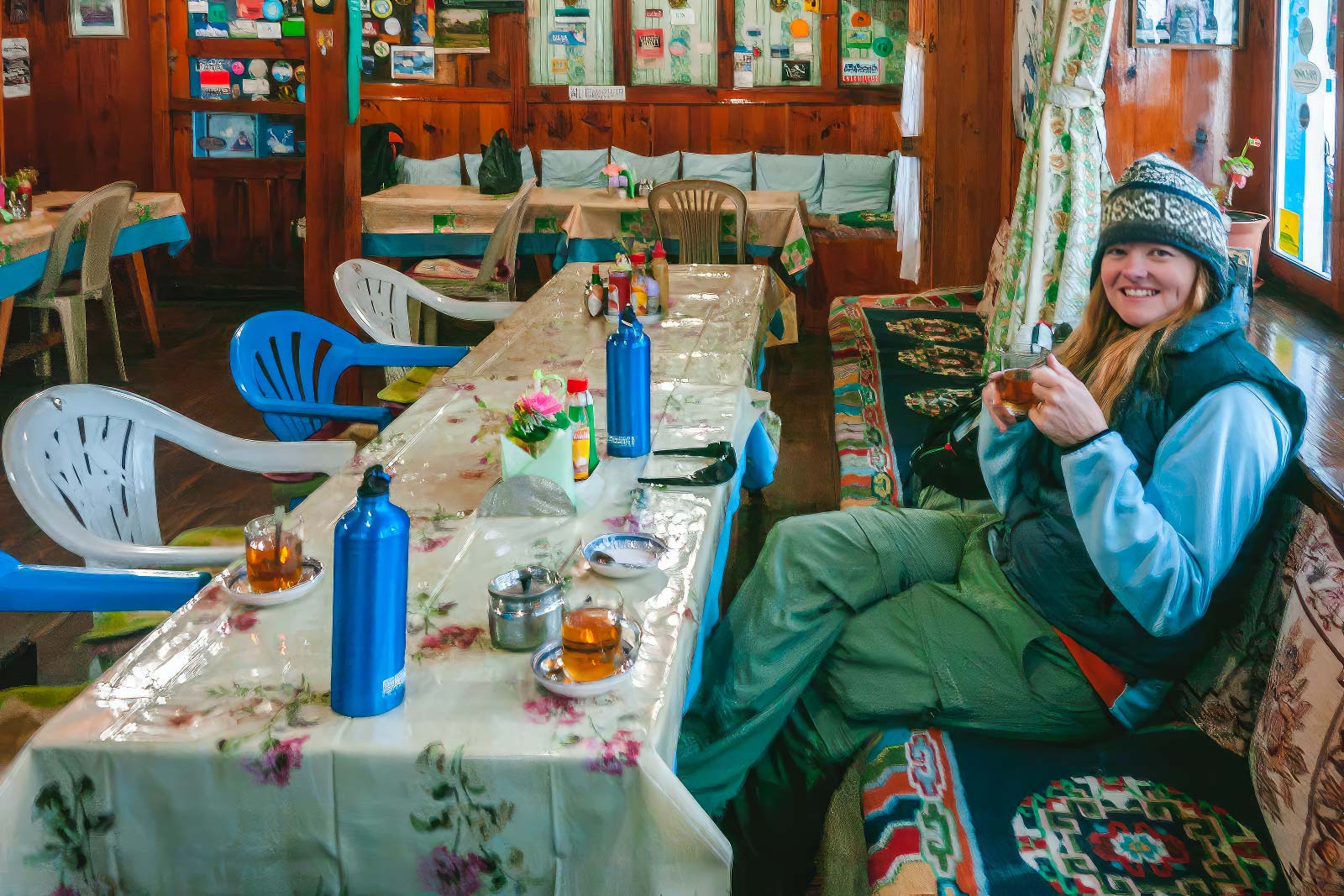
We were delayed an entire day. Even though we were booked on the first flight from Lukla, the weather made us wait until near sunset. We were the first (and only) flight out that day, so everyone else who was waiting for their flights all day was stuck another night.
It was a bumpy flight back to Kathmandu and we almost wished that we didn’t make it on the flight. The turbulence was so bad, I was sure we were going to drop out of the sky.
Everyone on the flight was silent as we were tossed about dropping huge amounts of elevation at a time. But we landed and we have never been so happy to arrive in Kathmandu. We kissed the ground, thankful to have trekked to Everest Base Camp, but vowed to never do it again.
Accommodation – Tea Houses on Everest Base Camp
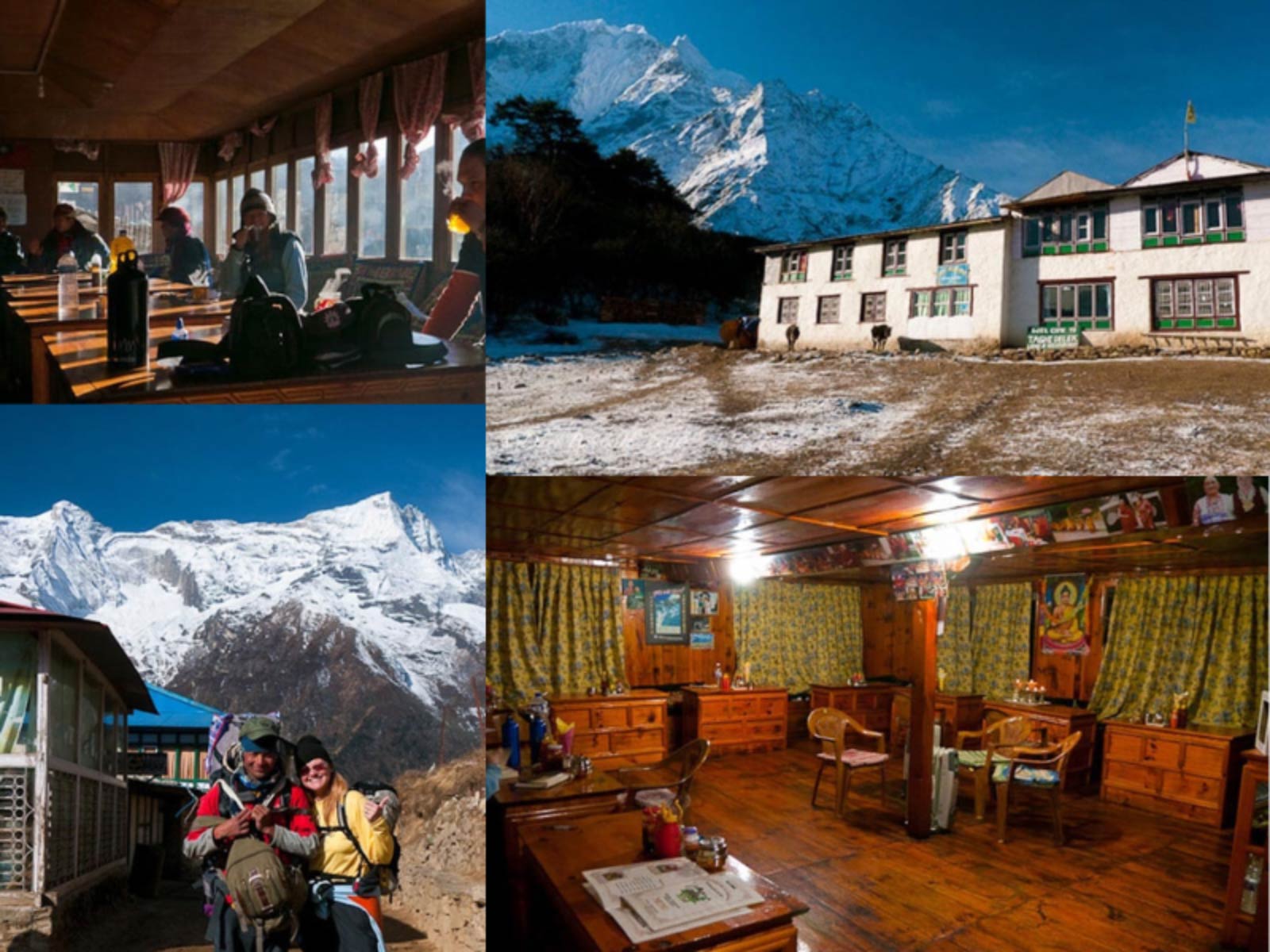
The main lodges of each teahouse we stayed in during the first half of our trip were cozy and warm. At the lower elevations, woodstoves burned wood in the dining room and common areas and our rooms were a comfortable temperature as we were wrapped up in our sleeping bags.
But as we ventured higher, the stoves were less abundant and instead of wood, they burned yak dung. You heard me, Yak Dung. Wood can’t burn in thin air, so they use yak dung to heat the teahouses at high elevations. Rooms are not heated so when we went to our rooms, we had to wear hats, thick socks, puffy coats, and long johns.
There were charging stations at the accommodation for electronics and we paid by the hour for electricity.
- We highly recommend taking a portable USB charger to charge your own electronics.
- We also used a solar USB charger that recharged during the day as we hiked.
Meals on Everest Base Camp
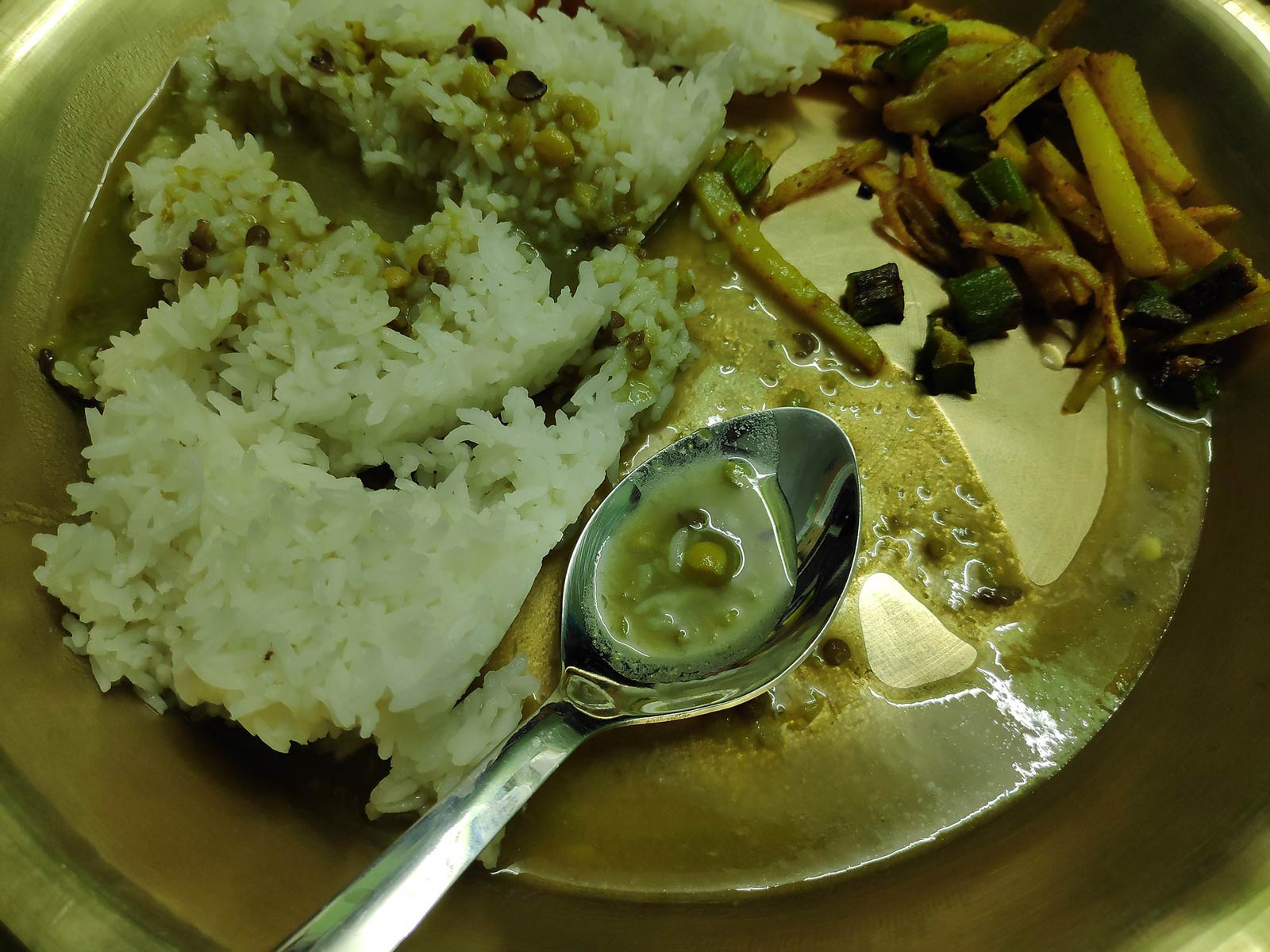
Because we booked an all-inclusive Everest Base Camp trek with Simrik Real Nepal tour company, all meals and snacks were included with our accommodation. Each evening, hearty meals were served that included pasta, rice, or Dal Bhat. Dal Bhat is the staple food of Nepal consisting of lentils, vegetables, steamed rice, and curry.
For the first few days, meat was served at meals, but as you climb higher, meals turned to vegetarian as it is more difficult to get the meat up the mountains.
Prayer Flags and Prayer Wheels – EBC Trek Etiquette
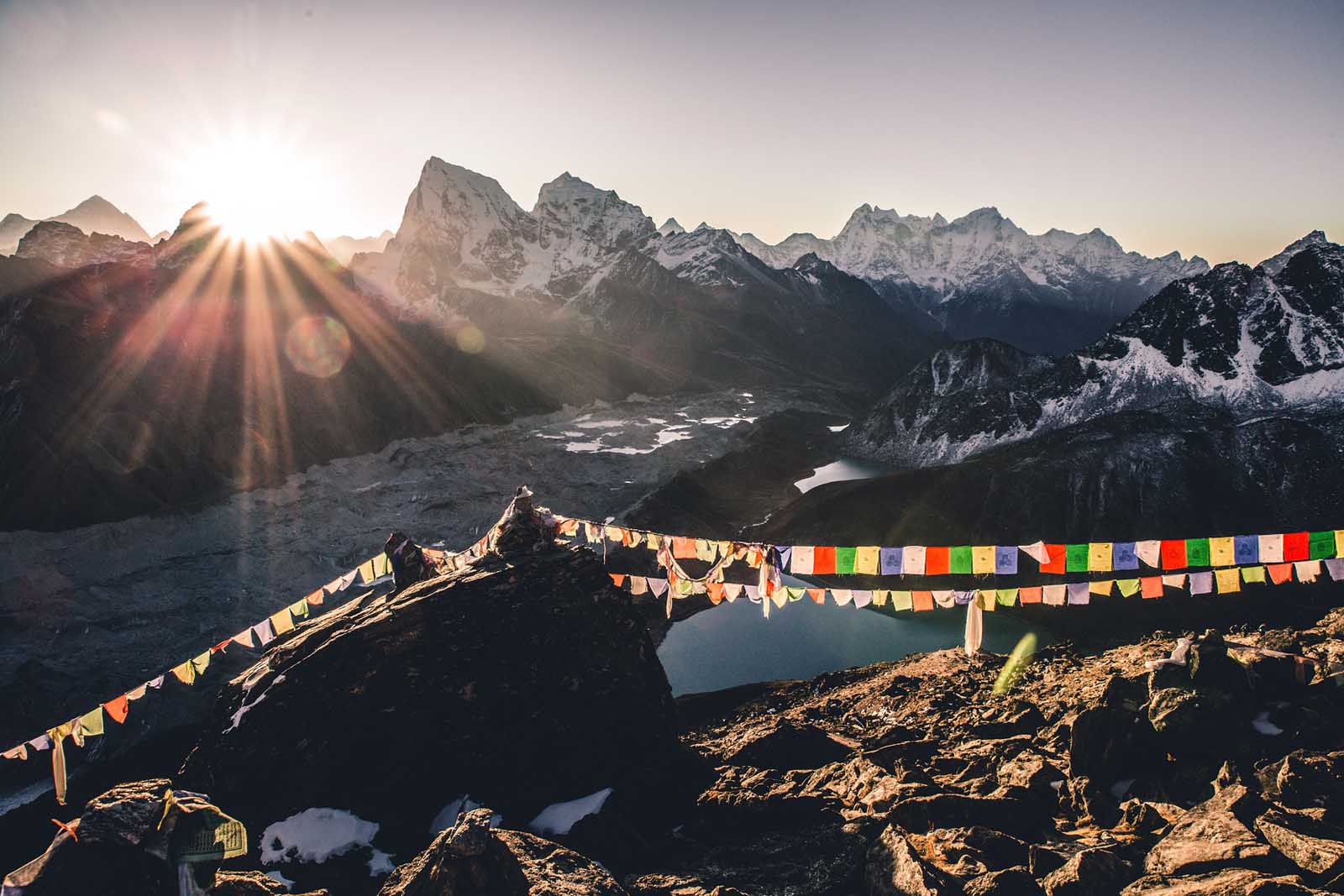
We saw many prayer wheels, prayer flags, and prayer rocks (mani stones) all along the trail to Everest. Everest is a sacred mountain and these monuments help give luck to the climbers on the mountain. There are customs to be followed when approaching prayer rocks or prayer wheels.
How to properly trek around prayer Wheels and Prayer Rocks
- When approaching a prayer rock, it is important to walk to the left of the prayer rocks (mani stones) in a clockwise direction. The stone on the right means you are on the “right hand of God.”
- When using prayer wheels, you walk along and spin them to ask for blessings for the climb ahead.
- Sherpas and locals spin prayer wheels saying the mantra “ Om Mani Padme Hum” giving blessings to the climb ahead.
- The prayer flags have prayers and mantras written on them which are believed to carry messages of positivity and to spread goodwill and compassion they are carried by the wind.
Altitude Sickness
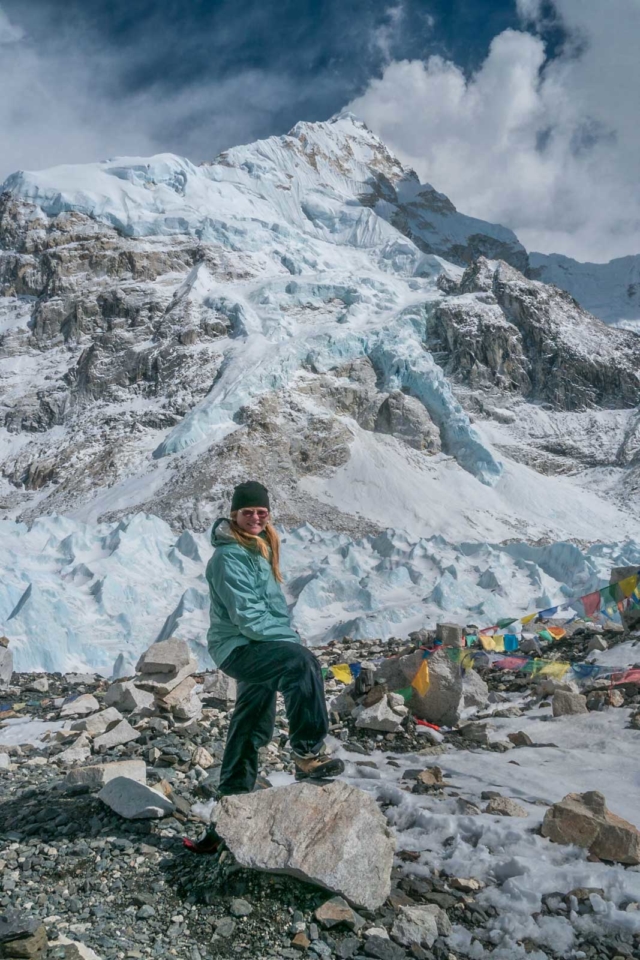
Altitude Sickness is a very real possibility on the EBC Trek. On average 3-5 people die each year doing the trek to Everest base camp. Make sure to keep an eye out for signs of Acute Mountain Sickness. Acute Mountain Sickness is life-threatening and early symptoms include nausea, headache, and vomiting. It can lead to death. The Best way to alleviate symptoms is to go down to a lower elevation.
If you start to feel dizzy, have a pounding headache, or if you start to vomit go down to a lower altitude as quickly as possible. Take your time climbing, stay hydrated, and listen to your body.
Drink plenty of fluids, try to eat, and rest regularly. It is better to walk slowly and steadily rather than rushing at high altitudes. And when you get to your accommodations each day, relax as much as possible.
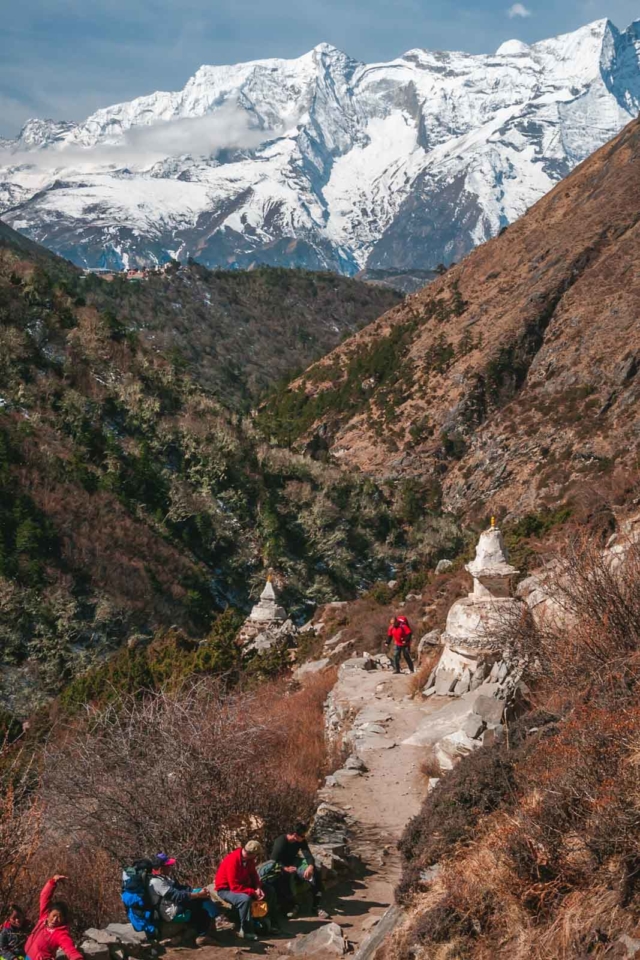
It can be dangerous trekking to Everest Base Camp from falling off the mountain to succumbing to altitude sickness. Some people have simply disappeared. Hiring a guide is a good option (and now the only option) for safety and it is very important to look for signals of altitude-related sickness.
But the Everest basecamp trek isn’t nearly as dangerous as climbing to the summit of Mt Everest. In 2019, 11 people died while trying to summit Mount Everest.
The village of Lukla is located at a high elevation so you will feel the effects of the thin air as soon as you land. The elevation of Lukla, Nepal is 2869 meters (9,350 feet). We were short of breath and already feeling fatigued upon landing. So instead of immediately starting our trek, we had a hot breakfast at one of the many restaurants in Lukla.
Travel Insurance for Everest Trek
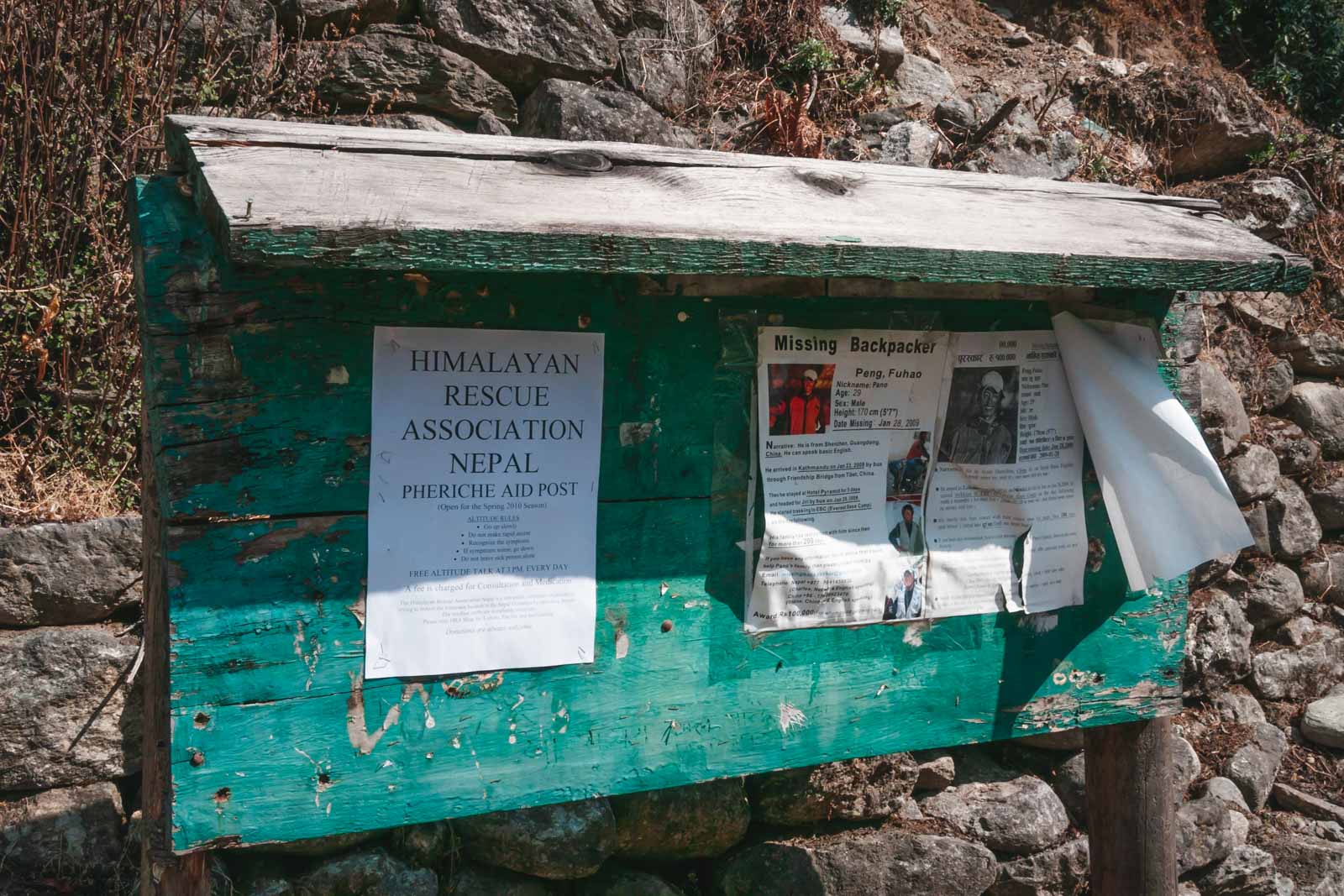
We always travel with travel insurance on our travels, but hiking to Everest Base Camp will not be covered by regular insurance providers. It is highly recommended to get supplemental comprehensive travel insurance that offers trip cancellation insurance, and medical evacuation insurance.
Medjet is a good option for medical evacuation insurance and is a good addition to your regular travel insurance. There is a very real possibility of altitude sickness and we knew of two people that needed helicopter rescues during our trek.
World Nomads offers specific Everest Base Camp Insurance. You can check them out to get a quote. I would suggest a combination of World Nomads travel insurance and Medjet medical evacuation insurance. Regardless of what travel insurance you choose, be sure to call them directly to ask for specific advice about trekking to Everest Base Camp.
For a trip like Everest Base Camp, you will want to make sure to have trip interruption and trip cancellation insurance as well as lost luggage. This is a trip of a lifetime, so make sure you have a backup plan.
Can you Trek Independently to Everest Base Camp?
As of April 1, 2023, Nepal has banned solo trekking. Foreigners must hire a guide for treks in high-altitude trekking regions of national parks. According to the Kathmandu Post in March, “ solo or independent trekkers have to mandatorily hire a guide or a porter before setting off to Nepal’s mountains.” However, after an updated article in the Kathmandu Post, it seems that the Everest Region is an exception. Before booking, we would check with local companies and authorities as rules are constantly changing.
Regardless, we loved hiring a local guide to make oure experience richer, to support the local economy and to feel safer hi
- Our all-inclusive Everest Base Camp Trek through the Simrik Real Nepal included return flights from Lukla, food, lodging, guiding, and all permits and paperwork.
- We didn’t have to search for accommodation at the end of each day of trekking
- We had English-speaking guides and a porter.
- We had our own room, but you can also share rooms on the EBC Trek
- We never worried about the cost of meals. They were all prepaid.
- And our guide (Dipendra) and porter were part of the package for the trip.
Costs for Everest Base Camp Trek
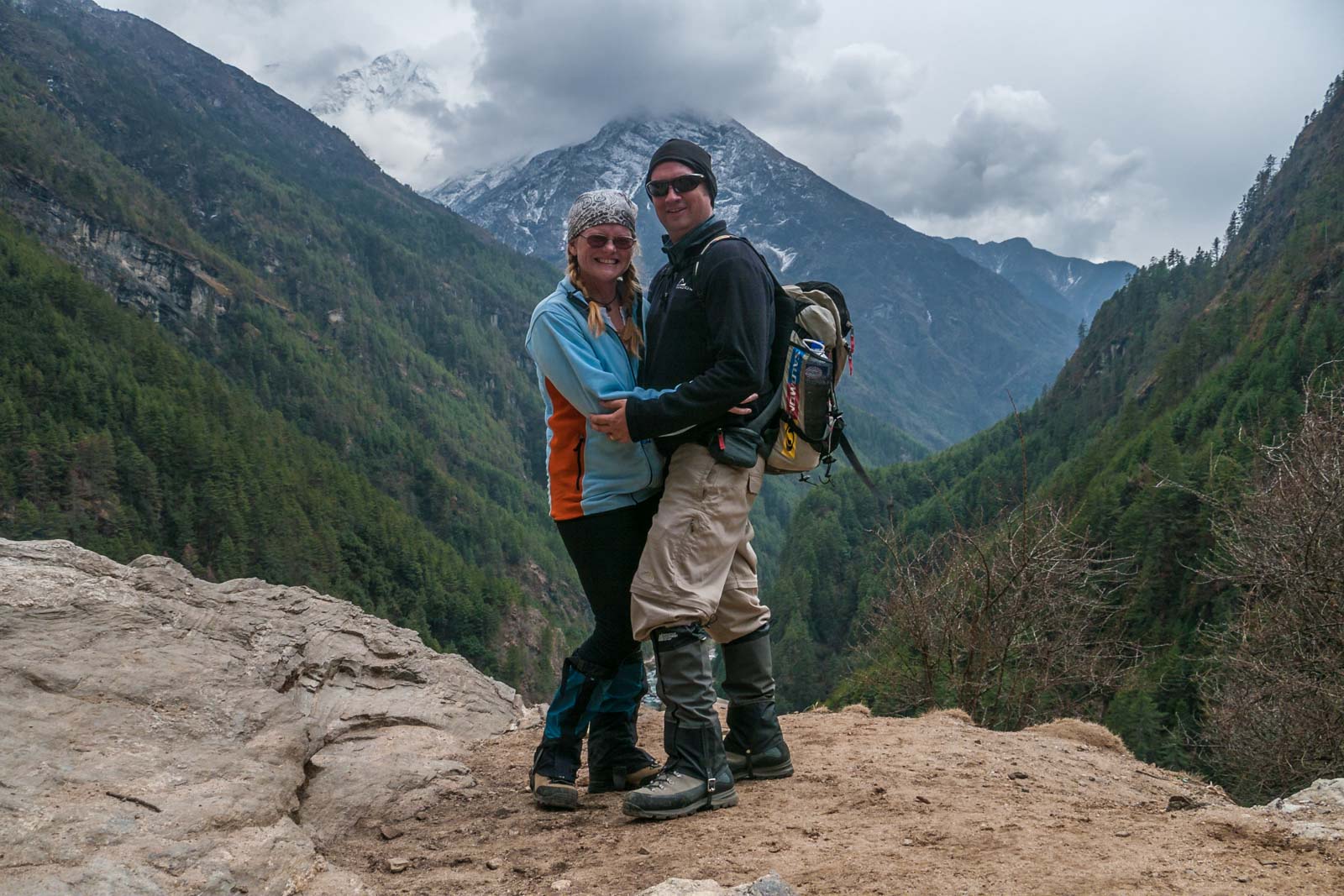
Prices can vary greatly for trekking to Everest Base Camp. You can contact Simrik Real Nepal for up to date prices.
- Booking with an international agency can cost from $1800 – $5000 USD
- Booking with a local agency and be anywhere from $1400 – $2500
W hen is the Best time to Trek to Base Camp?
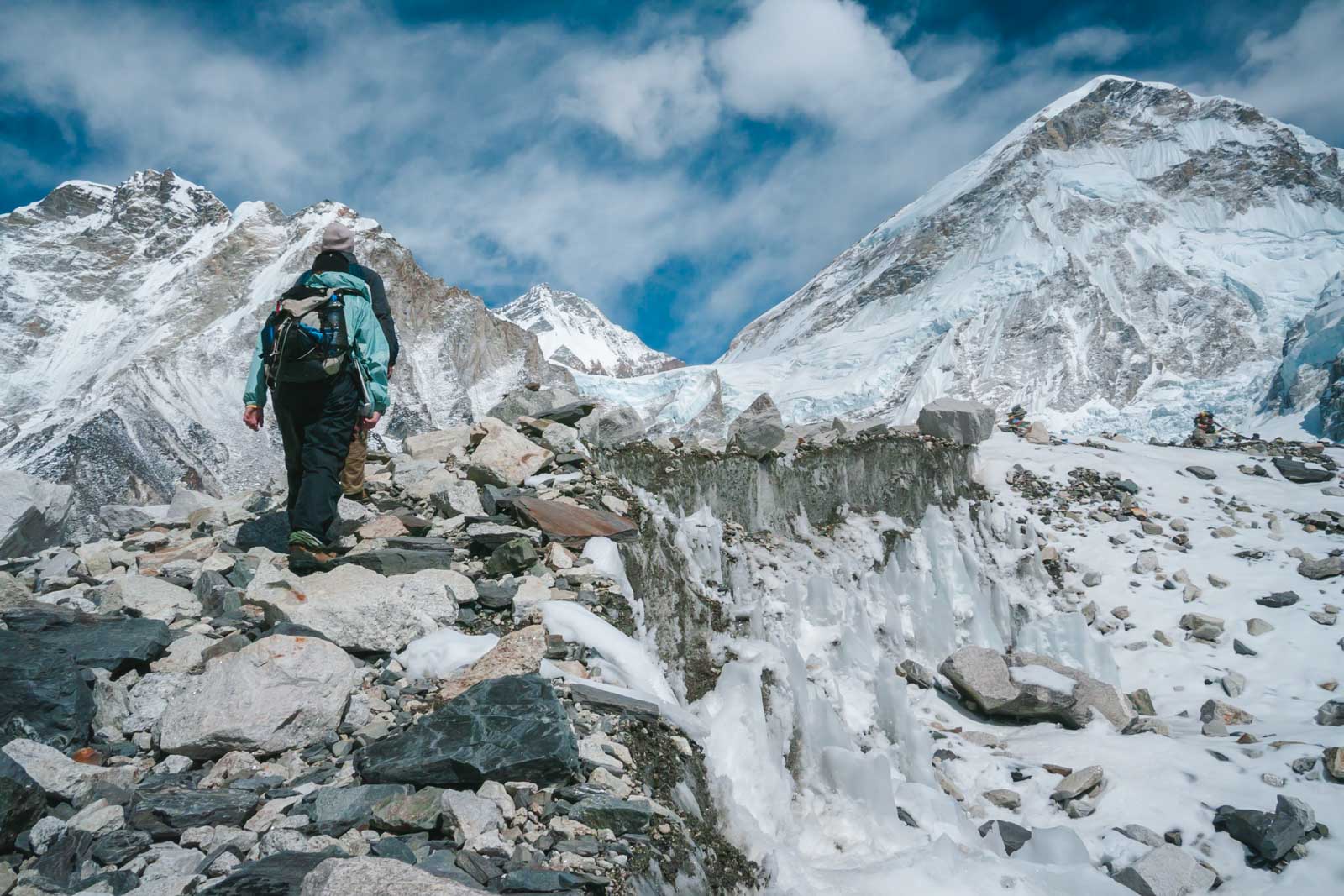
The high season for treks is April to May and October to November. We climbed in early March and felt that it was the perfect time of the year. The weather was beautiful, the skies were clear and the official climbing season hadn’t picked up yet. So we had a lot of the mountain to ourselves. We had heard stories of how busy the trail is, but at this time of year, it was quite deserted.
But a week and a half after our trek started as we made our way back to Lukla, it was already busier. We saw a lot of parties climbing up and the trail was getting congested. I can only imagine how packed the trails are during the high season.
What to Pack For Your Everest Base Camp Trek
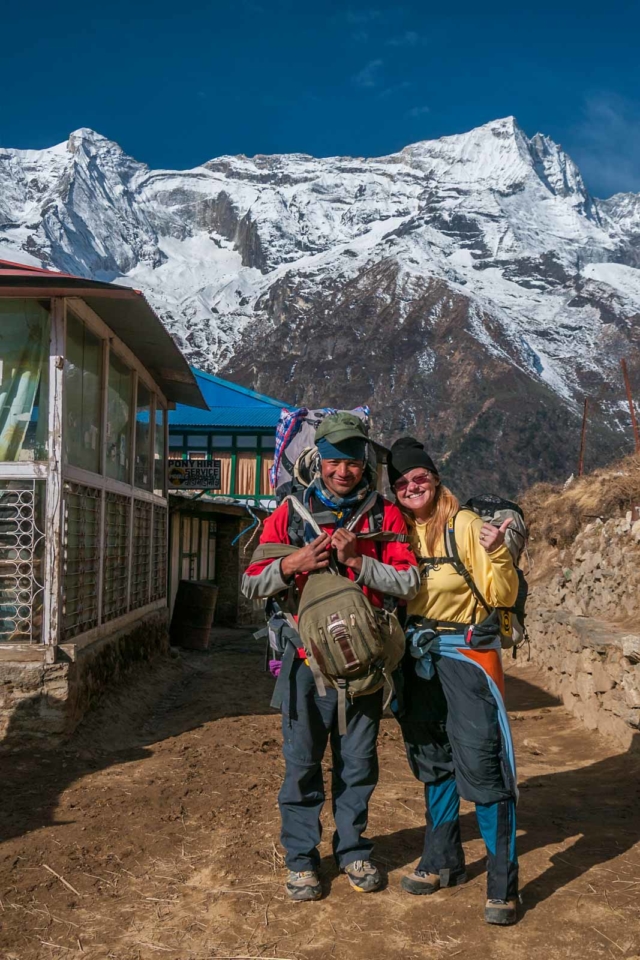
Layering is extremely important when trekking to Everest Base Camp. This is a quick guide for clothing but we wrote a complete packing guide for base camp here .
Make sure to have a day pack to carry the important items and layers that you will need for your day of trekking for the entire trek. Your porter will carry everything else.
- 2 quick drying long sleeved base layer shirts
- 2 trekking shirts short sleeve
- 2 Thermal Base Layer – 2 leggings/2shirts
- 2 liner socks
- 3 pairs of woolen blend trekking socks
- 2 pairs of trekking pants with zip-off bottoms
- 2 fleece sweaters – one lightweight, one heavier
- Outer windproof jacket and pants
- 2 water bottles to fill regularly
- Steripen or Lifestraw – this is great for purifying water
- Portable USB Charger
- Basic First Aid Kit – A first aid kit is important to have but your guide, they will have one as well.
- Warm sleeping bag. If you don’t have a sleeping bag rated to below zero, we recommend renting one from your guding company.
Treats and Medication
- Tang – I was glad we packed Tang for our water. It made it taste better, keeping us well-hydrated. We didn’t really want to drink just water, but the Tang (which we bought in Kathmandu) was actually delicious. Gatorade or another electrolyte-replenishing drink is a great idea.
- Diamox – (You can buy this in Kathmandu without a prescription) I highly recommend using Diamox tablets for altitude sickness as well. We met so many people suffering from headaches, dizziness, and fatigue and they weren’t taking anything. We’ve always used Diamox when climbing to altitude and it has worked beautifully for us.
- Chocolate – When we were feeling ill, we were happy to have chocolate to eat. It was the only thing that we could eat at times.
How to Get Fresh Water on An Everest Trek
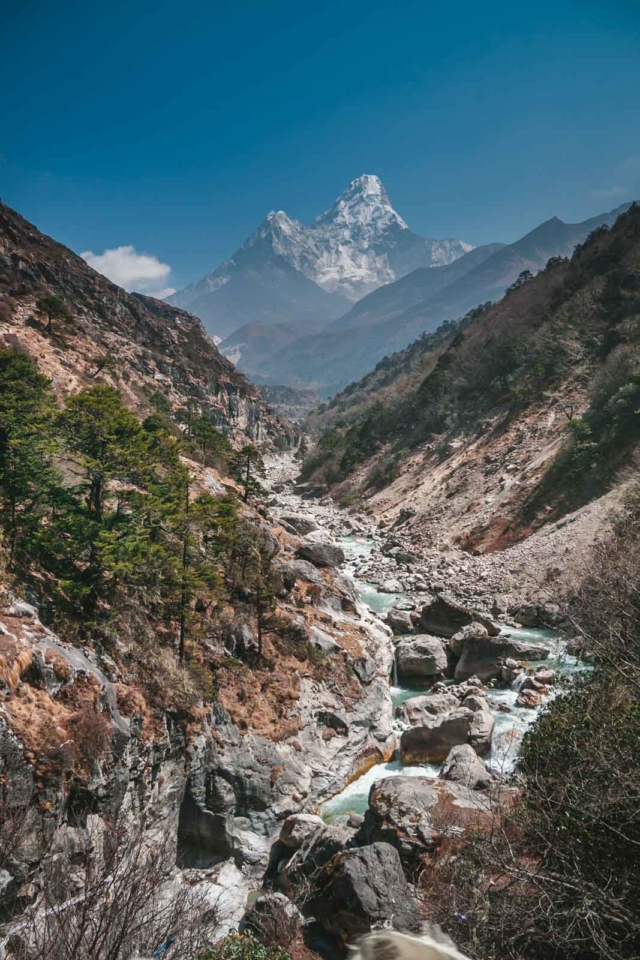
We recommend two refillable water bottles per person that can be refilled along the way. You can fill up anywhere for free along the Everest Base Camp route, but make sure you have a SteriPen or some other form of water purification with you. We love the SteriPen for purifying water, see our review here.
You can also use the LifeStraw or water purification tablets , but once we discovered the SteriPen , we never went back. See our complete Packing a Travel First Aid Kit here
Do You Need Climbing Experience for Everest Base Camp Trek?
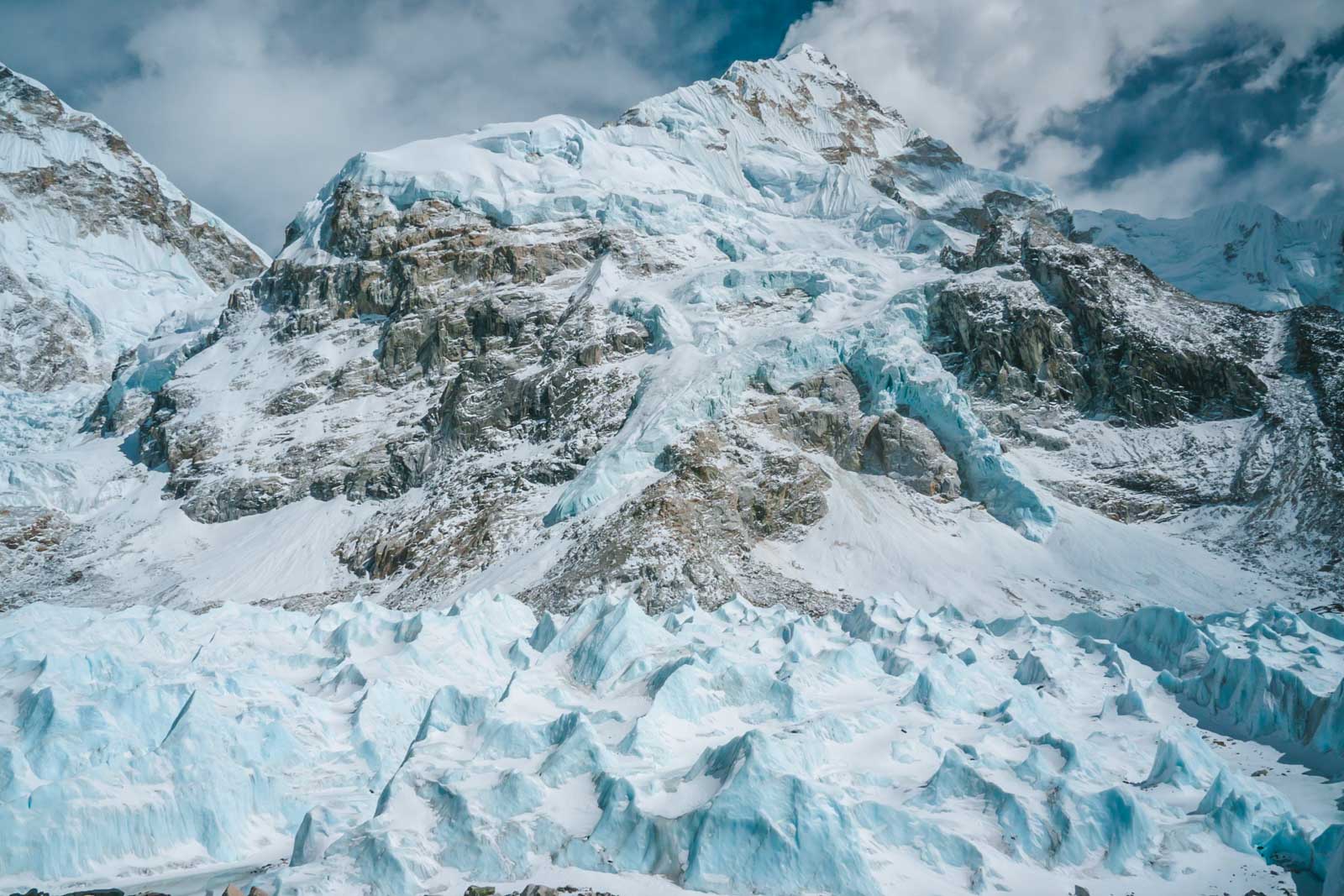
There is no need for any technical climbing experience to make it to Everest Base Camp. If you are relatively fit, it is very doable. But it is a full two weeks at a sustained altitude of over 4000 meters.
We didn’t train for our Everest Base Camp Trek but we had been to altitude before and had spent a lot of time backpacking leading up to the months prior. It’s good to know how your body reacts to altitude. We suggested doing a couple of treks above 3000 meters (9000 feet) to see how your body reacts.
Hot Tips for Trekking to EBC
- Keep your camera batteries close to your body when not in use. The cold and altitude really eat up battery life, so you will want to keep them warm for as long as you can.
- Bring USD, ATM Fees are high and you are limited to the amounts you can take out of the ATM, so have ISD to exchange instead.
- Pack handi wipes and Gold Bond Powder – it’s a lifesaver when you can’t get hot showers.
- See our Full list of Everest Base Camp Tips here.
How to Get to Everest Base Camp
There are daily flights to Kathmandu International Airport from international hubs around the world.
Where to Book Your Everest Base Camp Trek
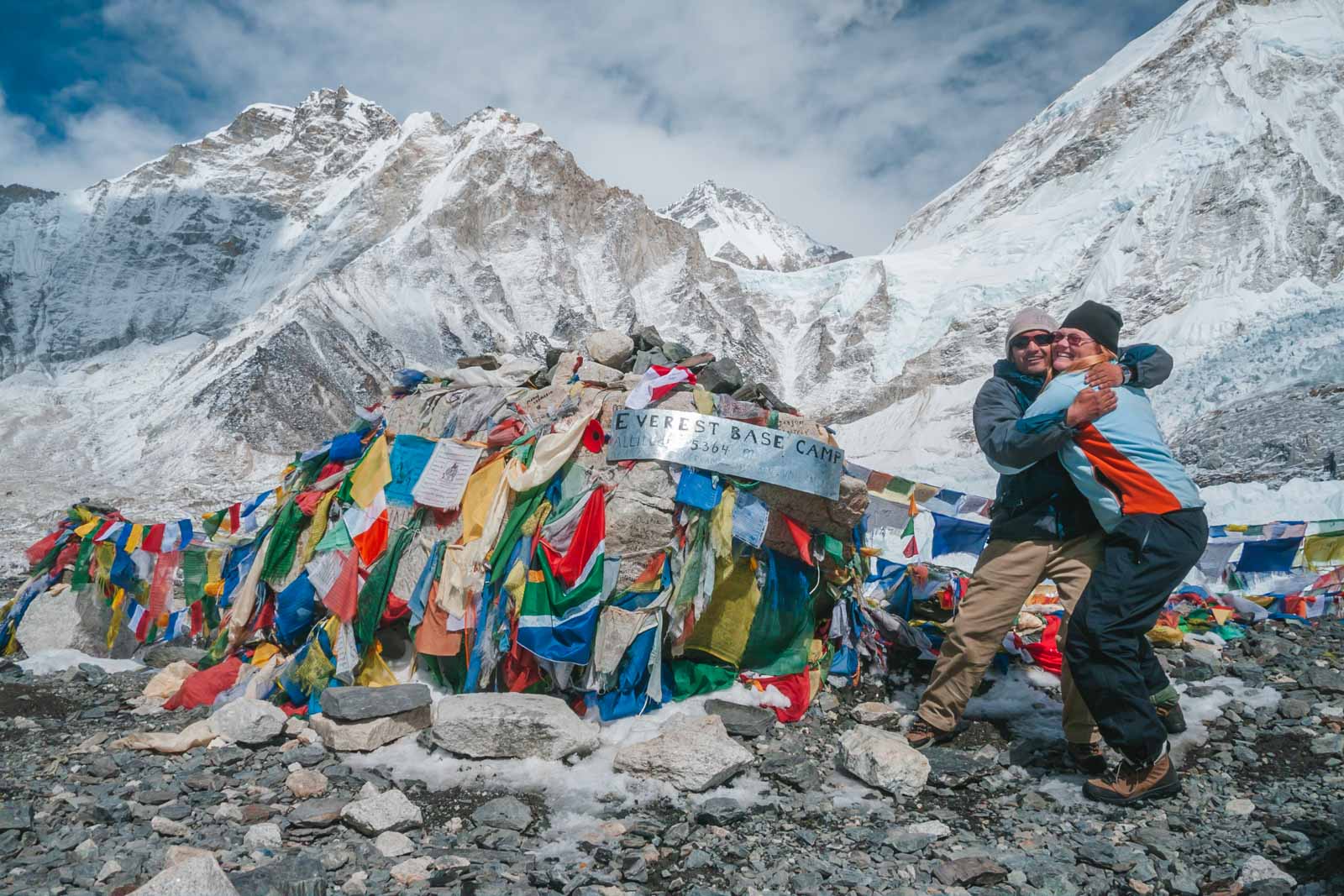
We booked our trek in Kathmandu with Local Guide Dipendra of Simrik Real Nepal. If you are looking for a local guide he is an excellent choice with nearly 20 years of experience in the mighty Himalayas.
Prices for the Everest base camp trek cost can vary depending on where you book. Group tours booked in North America will charge more. Ranging from $1500 – $5000 USD
You can save a lot of money by booking a local guide as you will cut out the middleman prices. Having a local guide let us know our money was going directly to the Nepal economy. Check with Simrik Real Nepal for current prices.
How Much to Tip Guides and Porters for an EBC Trek
Guides and porters in Nepal do not make a lot of money and rely on tipping. When we take tours of any kind, we (ourselves) tip 15% – 20% but that is a part of our culture in North America, we are quite large tippers and realize that others are not comfortable with that. We’ve done a lot of research and gone by what our tour companies have suggested on other tips, what we feel is a fair tip and what the average is across the internet.
For tipping in Nepal we have broken down the cost for a guide and porter.
Guide – Tipping – 10% – 15% of the total cost of the trip. We find this the easiest to figure out. If you paid $2000 for your trek, the lead guide should receive $200 – $300
Guide per day – Some suggest $10 – $15 per day per person for guides – For a 14 day trek that means you would tip your guide $140 – $210.
Porters per day – $5 – $10 per day per person for porters. – $70 – $140 for your porter.
We like to start at 15% of the total cost of our trips to give to the guides and then pay the porters a daily fee of $10.
If you can afford to trek to Everest Base Camp, you should be able to tip your guides and porters who have worked so hard accordingly.
Daily Life in the Everest Region of Nepal
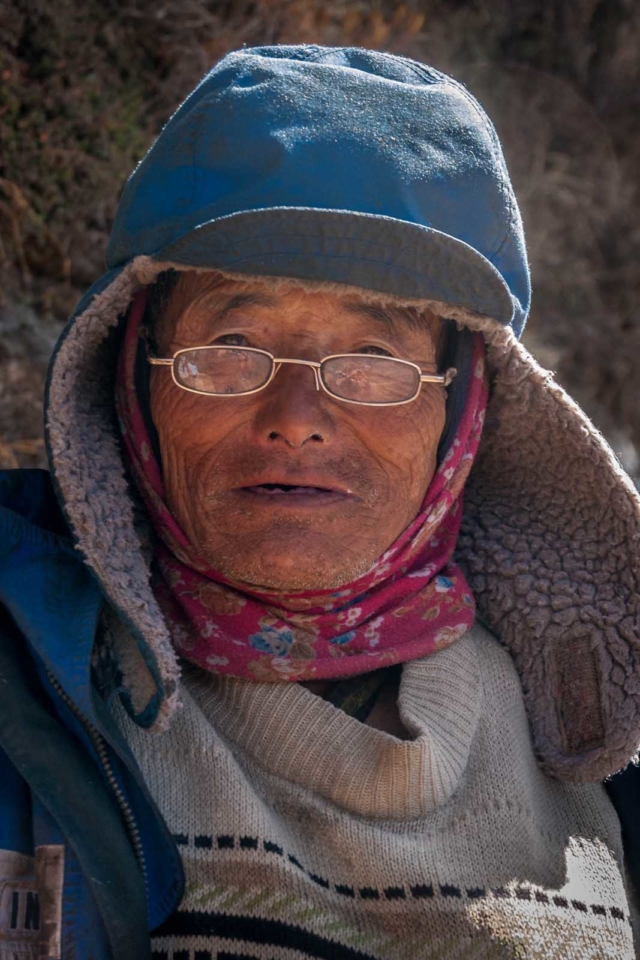
While trekking to Everest we passed through many picturesque villages. The people are friendly and life goes on as it would in any community in Nepal. People do well in the Khumbu Region and they respect the tours passing through because the tourists are what keep them going.
There is electricity from the water that they harness from the Imja Khola River and Dudh Kosi River; two rivers that run through the trek. They also have solar power for electricity as well. There are schools, fresh running water, televisions, a health clinic, and bars.
That is not to say that life is all roses. It is a remote region of Nepal and it is difficult to get any supplies in. Food and equipment need to be carried into villages on foot. Porters carry heavy loads on their backs and women and children also do the heavy lifting. Everything needs to be carted in by hand or by animals. Check out our tips for climbing to Base Camp
How Long Does it Take to Trek to Everest Base Camp?
The Everest base camp trek takes 12 – 14 days to climb including two acclimatization days. Treks can be done in 11 days and it is not uncommon for trips to take 15 days to allow for more acclimatization.
How Difficult is it to trek to Everest Base Camp?
Trekking to Everest Base Camp requires good fitness. You spend several days at a sustained altitude of more than 4000 meters (16,404 feet). Altitude sickness is a genuine possibility, it is important to take your time, stay hydrated, and listen to your body.
Can you trek to Everest Base Camp on your own?
As of April 1, 2023 the government states that all high altititude treks require a guide, but then after some backlash, they made an exception for the Everest region. However, we highly recommend hiring guides and porters . You can trek the region yourself carrying your own packs and gear, but you have a much better chance of making to base camp (and enjoying the experience) if you hire guides.
How Long is the Everest Base Camp Trek?
The trek is 63km (39 miles) each way . 126 km (78 miles) round trip from Lukla. Expect to hike anywhere between 7 to 17 km per day.
And that is a day-by-day breakdown of our experience on the Mount Everest Base Camp Trek. If you plan ahead and understand what to expect on the EBC Trek, you will be sure to have an amazing journey.
It’s an experience we’ll never forget and highly recommend it to everyone. The Himalayan Mountains are the most beautiful and spiritual place on earth and this trip will change your life.
Read More about travel to Nepal and things to do in Kathmandu before your trek
- Flight to Lukla
- Packing list for Everest Base Camp
- Remarkable Everest Base Camp Trek in Photos
- 30 Tips for Trekking to Everest Base Camp
- Nepal Travel Guide
- Top 6 Places to visit in Kathmandu, Nepal
- Where to Eat in Kathmandu – Eight Great Spots to Indulge After Your Trek
- The Ultimate Travel Songs Playlist to Inspire Wanderlust
Dal Bhat photograph courtesy of Wikimedia – I don’t know why we never took a photo of our Dal Bhat. We ate it nearly every day while trekking to Everest Base Camp. You’ll either learn to love it or despise it.
- Inca Trail – Machu Picchu Hiking Tips – How To Hike the Inca Trail
- Complete Guide to Climbing Mount Kilimanjaro – How Hard is It?
- Top 13 Best Treks in Nepal to Help you Choose The Right Trek for you
- Trolltunga Hike – Trekking to Norway’s Most Famous Landmark
- The Complete Guide to Climbing Mount Fuji
Travel Planning Resources
Looking to book your next trip? Why not use these resources that are tried and tested by yours truly.
Flights: Start planning your trip by finding the best flight deals on Skyscanner
Book your Hotel: Find the best prices on hotels with these two providers. If you are located in Europe use Booking.com and if you are anywhere else use TripAdvisor
Find Apartment Rentals: You will find the cheapest prices on apartment rentals with VRBO .
Travel Insurance: Don't leave home without it. Here is what we recommend:
- Allianz - Occasional Travelers.
- Medjet - Global air medical transport and travel security.
Need more help planning your trip? Make sure to check out our Resources Page where we highlight all the great companies that we trust when we are traveling.
You May Also Like
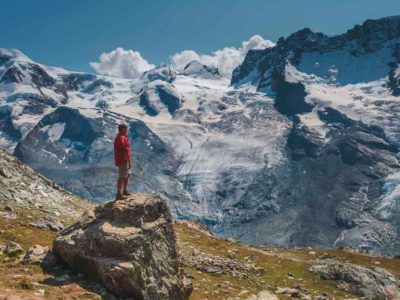
30 Beautiful and Best Hikes in the World
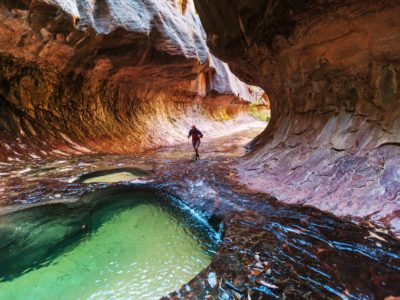
24 Best Hikes in the USA to Add to Your Bucket list
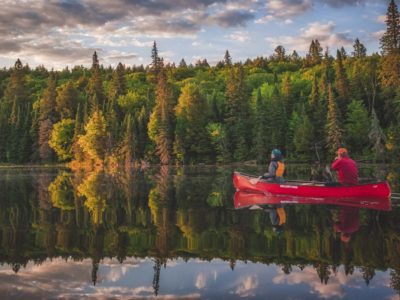
Weekend Warriors – 14 Awesome Hobbies to Turn You Into an Adventurer
About The Planet D
Dave Bouskill and Debra Corbeil are the owners and founders of The Planet D. After traveling to 115 countries, on all 7 continents over the past 13 years they have become one of the foremost experts in travel. Being recognized as top travel bloggers and influencers by the likes of Forbes Magazine , the Society of American Travel Writers and USA Today has allowed them to become leaders in their field.
Join thousands of others who get our monthly updates!
Leave a comment cancel reply.
Save my name, email, and website in this browser for the next time I comment.
53 thoughts on “Everest Base Camp Trek – Ultimate Guide For 2024”
Beautiful article! You have shared a thrilling journey with us till the end. It will definitely be useful for us trekkers. Thanks for the great pictures, videos, and useful tips!
This is a fantastic and unique post! After reading it, I learned a lot about Basecamp that I didn’t know before. Excellent article! That is true adventure, and conquering Mount Everest is without a doubt the goal of all hikers around the world. Keep up the excellent work. Thank you for providing this information.
Wow, the content has got all the details about the trek. Thank you so much for sharing your Journey experience of Everest Base Camp Nepal.
Hi There, Great Article! That’s the real adventure and especially climbing Mount Everest is the dream for all hikers across the globe without any doubt. Keep up the good work. Thanks for sharing.
Wow, the content has got all the details about the trek. Thank You so much for writing such an efficient article on Everest Base Camp Trek.
That’s the real adventure and especially climbing Mount Everest is the dream for all hikers across the globe without any doubt.
Thank you for taking the time and effort to produce such an awesome post with amazing pictures. Loved reading all your posts, really good insights here into Everest Base Camp ! Looking forward to read more.
Nice article on trekking best of luck for your new journeys
Dear Dave and Deb Namaste It is really beautiful article regards of Everest base camp trek in Nepal. Your article provides a lot details of the EBC trek. I’m sure your blog helping lot to organize other trekkers.
Excellent article. Everest Base camp is in my bucket list but I haven’t attempted because I’m prone to sickness quickly. Reading this article has triggered the interest even more. Thank you so much for explaining in detail about EBC trek. I hope One day I too can share my experience 🙂
Hey, I love trekking, I went last month with my friends in Nepal after reading your blog the memory are refreshed Thank you for sharing
Namaste, Dave and Dave, Thank you so much for sharing your Journey experience of Everest Base Camp Nepal. And also glad to read that why not support the local economy by hiring a guide and porter… I salute to your positive view. Visit Nepal anytime.
It is very interesting to read this Everest base camp trekking. I love trekking and i am excited very to do this base camp trekking once. Thanks for sharing.
This popped up in my inbox I love the way you break down your travel itinerary this way. I’m one of those people that love to know every detail of a place before travelling there myself. Another place to add to the list, thanks to you guys! Beautiful photographs.
Thank you for taking the time and effort to produce a terrific blog of your trek to EBC. I really appreciate being able to experience what it is going to be like before I actually arrive.
Everest is the highest mountain. It is at the Zenith. Most of the people just a dream of it.Very useful information. Thanks for sharing with us.
Excellent article !! Thanks for sharing such a great informative post it really helpful and amazing so keep it up and all the best………….
this was just amazing… keep sharing
The post was very informative. If you love adventure and treks you should definitely visit Nepal, it’s gonna be a life time experience. This post will really help people who are planning their next trek to Everest base camp. If you are planning your next trek to Nepal, North Nepal Trek can help you to make your trek much easier and will give you unique experience.
All of your photos are just awesome. Information is perfect.
Such an awesome post with amazing pictures. Thanks for sharing your experience with us.
This is really a very good blog post and thanks for sharing it with the community
It’s an informative post and I was thinking how you backpack for the weather? There are many things that somewhere can’t be cope at altitude like a sickness. I remember I scare when I attempt sky diving in Dubai. It’s was a wonderful experience but I have a fear of altitude places.
I have read about it but never tried. I am glad that at least i am reading such an informative article that clearly shows experience of treking over there. It might so much exciting and filled with happiness because seeing something like that would always be more of fun and achieving some of our own. Would love to try it once for sure!
Hi guys. Nice blog. Very informative. I just wonder, how did you prepare for the weather? How did you acclimatise so that you can cope with thr danger of altitude sickness? It is the ine thing that scares me to try to trek on high altitude places. To climb Kilimanjaro and to reach the EBC are in my bucket list. I’m hesitant because of my fear that I might die from cold temperature and altitude sickness.
Dress in layers, and drink plenty of water. You will want to bring DIamox with you and take it. You can get it in Kathmandu, or go to a travel clinic before leaving home. You won’t die from cold temperatures at Base Camp if you have a proper guide, and dress properly. The real dangers are if you are summitting Everest, that’s when you can get into problems, but Base Camp is very doable for anyone that is physically fit. If you don’t have the gear, you can buy winter coats, boots etc in Kathmandu. But we do recommend breaking in your boots beforehand, so you should buy those before you leave home and wear them a lot. Get warm, waterproof breathable boots with wool socks and bring several pairs. We have a guide to winter base layers to avoid the deep freeze here: https://theplanetd.com/layering-tips-for-cold-weather-travel/
Loved reading all your posts, some really good insights here into EBC! You mention putting your hair in braids, why is that? Is it because of the sweat? Is it windy so it gets knotted up? Just curious as I am doing this trek in a week and am open to all tips ?
Yes, hair can get really matted due to wind, dryness and lack of showering. The Braids kept it from matting up like dread locks. Have a great time!
Long hair can get very matted almost like dread locks. It’s becuase there aren’t a lot of chances to shower after Namche Baazar, the wind, sweat and dryness from altitude really takes its toll on both hair and skin and the braids, keep the hair from matting and breaking off.
Great read! Just curious. what time of year did you go to avoid the masses of tourists?
Thanks for sharing articles and videos it will be helpful to all people those wants to go Mount Everest.
This is just amazing and knowing each and every experience that we will have while travelling is another aspect that made me read this article fully. I am in Dubai now on a trip and would surely try to visit this place i could. I should consider the right time and other things roo. I must thank you for this wonderful piece.
Such a great journey you have shared from start to finish and your presentation is also impressive. I would love to follow these things when I will go for a camp tour.
Regards, Ronit
Your Video is superb, I feel your treking experience in this article. worth to read it.
Wow what an wonderful place is this. Want to trek this place in my life.
Great article, thanks, surprised at the early time of year you did the trek, but sounded ideal – any other good write-ups or links discussing the pros and cons of going in the spring vs fall? …weather, landscape, crowded w/ other trekkers, festivals, etc Thanks!
I am looking forward for this kind of base camp.
What an excellent post!! Thank you so much for an informative article and personal feel. This is very helpful and inspiring for my upcoming trek to Everest Base Camp.
There is so great view in pictures.it’s useful and helpful for the trekkers .i like these types of views .and tourist are also love these types of views.
Anyways amazing photos and love the videos! really gives you a feeling how it is there and must be just thrilling. Looking forward to read more about your travels.
Nice Articles and sharing a good details of Everest base camp and amazing photos. I will try to go this year Nepal and go to Everest Base Camp.
Great post. I am doing the Everest Base Camp trek in October. I completed the Annapurna Circuit in 2012 and loved it. Nepal is a such a lovely place and the people are amazing. Thanks for sharing!
Wow congratulations on your trip and everything looks really cool. I would love to do the same! Did you train a lot before you went there? Did you prepare physically? I don’t know how fit I have to be to be able to take on such a travel. Anyways amazing photos and love the videos! really gives you a feeling how it is there and must be just thrilling. Looking forward to read more about your travels.
Hi Marus, we didnt’ train a lot before. We were traveling a lot though. Before heading to Nepal we spent 4 months traveling Sri Lanka and India. We did a yoga retreat and a lot of hiking and walking, but we didn’t do any proper training. We were in relatively good shape. It’s mostly just a long uphill hike. The difficulty is being at altitude for a sustained amount of time. It affects everyone differently. Some people can be in tip top shape, but not do well at altitude and vice versa. So, it’s best to take it slow and steady, drink plenty of fluids and pay attention to how you are feeling.
All your photos are simple awesome and your posts are speaking a lot of useful information. Thank you for sharing this article.
Thanks for your beautiful video. I fell a little up lifted seeing this. I believe one of the prayer flags is for a lady I knew. Inspiring. I wish I would have done adventurous things like this when I was young. Young people don’t put off adventure.
I’m glad I read this. This is something I have always wanted to do but have been a little nervous to think about doing it when the climbing season is in full swing. The time of year you went and the company you chose make a lot of sense! Thanks for sharing.
The views are amazing!! I love adventure, but I would definitely need to build up my stamina to do the Everest Base Camp trek. It looks like it was an awesome experience for you!
Wow, what a beautiful experience. Your photos are amazing!
-Siggi The Voyaging Viking
Amazing! Can’t wait to check this off my list!
Thanks for writing this.
Thank you for sharing these helpful tips. Your post has given me some great ideas. Thanks again for the valuable information!
- Everest Base Camp Trek: A Complete Guide For EBC Trek
Everest Base Camp Trek
- 09/03/2023 17/03/2024
Are you planning to go on an adventure of a lifetime and conquer the Everest Base Camp? Before embarking on this memorable journey, it pays to learn all the basics, such as cost, itinerary, and logistics. This ultimate guide to Everest Base Camp Trek can help you plan this thrilling expedition by giving you all the necessary details!
Nepal is renowned as “the Land of the Himalayas.” Moreover, it’s relatively small; the country has a wide range of geography, culture, and wildlife diversities. Among the fourteen tallest mountains globally, Nepal has 8 of them, including Mount Everest- the tallest mountain on the planet.
The Everest Base Camp is one of the country’s most famous destinations for trekking. This guide to Everest Base Camp Trek gives you all the required information about EBC Trek. But then, things need to be considered before embarking on Everest Base Camp .
Table of contents
Highlights of ebc trek, getting to everest base camp, entry permits & requirements for ebc trek, everest base camp trek itinerary, best time for everest base camp trek, packing list for everest base camp trek, everest base camp trek map, accommodations, i.e., tea-houses, meals on ebc trek, altitude sickness & acclimatization, some frequently asked questions.
The journey to the Everest Base Camp Trek is an excellent opportunity to experience the Everest region (also called the Khumbu). There are many unique features and aspects, like rich culture, beautiful mountainous landscapes brimming with river valleys, moraines, glaciers, and magnificent views, consisting of some of the tallest mountains on the planet.
The region is a vibrant and dense concentration of traditions and practices not found elsewhere in the country.
The legendary people are also famous for their mountain-climbing ability and agility in the Himalayas. The indigenous mountain people mostly follow a unique form of Buddhism.
The Khumbu region is ornamented with many Tsortens, monasteries, prayer flags, and Mani wall carvings. The hiking trail of the Everest Base Camp Trek goes through numerous villages of Khumbu and follows significant mountain rivers that drain the region.
About Author
Leave a reply.
You must be logged in to post a comment.
.webp)
Everest Base Camp Trek
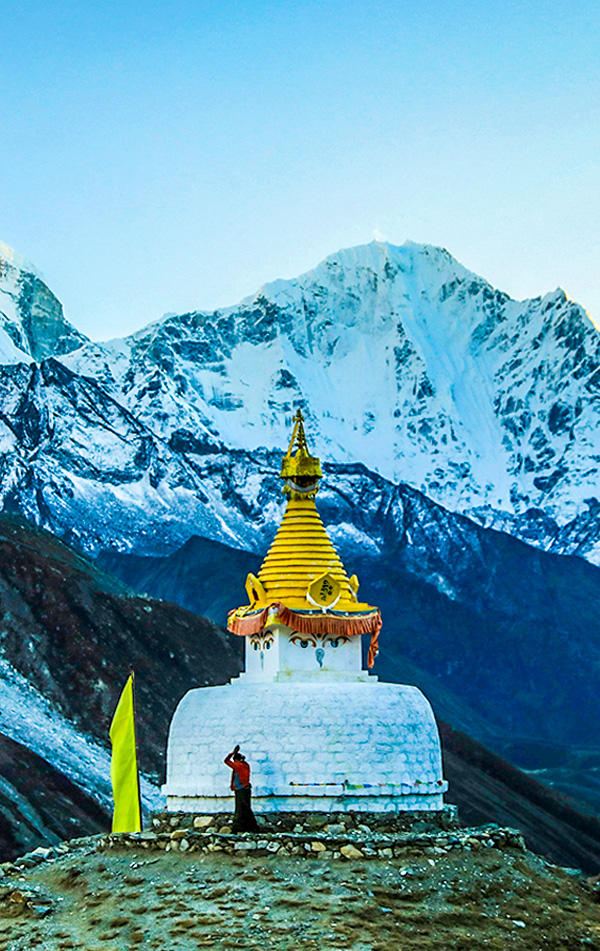
Kathmandu |
Kathmandu | Nepal
Max Altitude
Trekking Km
Help & Support
67000 /person $ /person.
- October-2024
- November-2024
- USD 1500 +5% GST for Non-Indians
- +5% GST (Goods and Services Tax)
- Services Kathmandu to Kathmandu
- Lukla flight, Food & Stay in Kathmandu included
Offload 5300
Backpack offload is optional
Choose add-ons during booking. If missed, log in and add them later.
Book off-load at least 10 days before the trek.
For offline bookings at the base camp, a convenience fee of Rs. 6500 applies.
Cancellations made before the trip date will receive a full refund.
For more information. Please complete this form.
Help & Support
Trek Name: Everest Base Camp Trek
Adventure Type: Trekking
Base Camp: Kathmandu
Season: Summer | Autumn |
Month: March | April | May | September | October | November |
Country: Nepal
Altitude: 18200 Ft.
Grade: Difficult
Rail Head: Kathmandu is not connected to any Railways
Stay: Hotel and teahouse
Food: Meals while on trek & at Hotel/Guesthouse (Veg & Eggs)
Location: Kathmandu
Distance: 108 Km.
Trail Type: One way trail | Camping in various locations, starting and ending at the different point.
AirPort: Kathmandu (Tribhuvan International Airport)
Why Everest Base Camp Is A Must-Do Trek
When it comes to trekking in the Himalayas, Mt. Everest is the most celebrated peak and not just in our country but all across the globe. For avid trekkers and mountaineers, getting up close to the highest mountain peak in the world is a once-in-a-lifetime experience. This classic trek takes place in the Bagmati Zone of Nepal and allows you to experience the immense beauty of the surroundings. Along your trek, you will get to witness 4 of the 6 highest mountain peaks in the world — Cho Oyu (8,201 m), Mt. Makalu (8,470 m), Mt. Lhotse (8,516 m), and Mt. Everest (8,848 m).
Everest Base Camp is a teahouse trek, which means you will stay at some of the highest villages in the world and get a close look at their cultures and traditions, and life in the remote corners of the Himalayas. Staying at the Sherpa villages you will get to learn a lot about the mountain lifestyle and how inextricably the people are connected to the mountains. There are many notable junctures throughout the trek and Kala Patthar is one such point. Standing at an altitude of 5,500 m it offers an astonishing view of Mt. Everest . EBC trek presents a wonderful opportunity to experience the grandeur of the Himalayas, the imposing challenge and thrill of the climb, and the charming culture of Nepal.
Trekking in Nepal is all about trekking amidst the biggest mountain ranges and on this trek, you will see mountains surrounding you. All along the way, you can feel the sense of legacy left behind by the greatest mountaineers. Crossing the route beyond Namche Bazaar, you will come across, Tenzing Norgay Stupa, a tribute to the great mountaineer, who was the first to scale Mt. Everest along with fellow mountaineer Edmund Hillary. Also, just near Dughla on Everest highway, there are memorials for distinguished mountaineers who dedicated their lives on the slopes.
Reaching Everest Base Camp means trekking through the traditional Sherpa villages, with warm and friendly villagers, hidden Gompas, picturesque mountain views, and exceptional natural beauty. Those who take part in such a trek will never forget the amazing experience.
About The Trek
Your journey will start at Kathmandu from where you will take a short flight to Lukla. The iconic trek starts at Lukla in the southern part and the trail weaves towards Namche Bazaar in the north. We will stay a day here, acclimatizing to the higher altitudes. It then diverges in the northeast direction towards Pheriche and Dingboche. Once we reach Dingboche, we will spend a day at Dingboche as a rest day. From Dingboche, the route continues to Lobuche. Everest Base Camp is a little further east from here and the Kala Patthar viewpoint can be seen towards the west.
There are other variations to the trek route as well, where the trek bifurcates towards Gyoko Ri early on at Namche Bazaar. The route then follows the left side to arrive at the Base Camp. Sometimes people also prefer trekking from Jiri village instead of Lukla, Jiri is a short bus ride away from Kathmandu. However, trekking from Jiri adds a couple of days to the trek as Jiri is considerably further away from Lukla. The EBC trek follows a gradual ascent up to the base camp, following which there is a steep descent. The entire journey lasts for 13 days and in between, we also have acclimatization days as well.
What Can You Expect At The Trek
It is a difficult grade trek. Trekking to the Everest Base Camp requires exceptionally high physical fitness and while the trek is not dangerous, you need to prepare well for it. A variety of factors add to the difficulty of the trek like the terrain, the duration of the trek, the distance covered every day, and the number of days spent at high altitude and a difficult exit in case of emergencies. While all trek is not especially tricky but it is surely an endurance test.
It is a high altitude trek and as such chances of AMS are quite high but with adequate hydration, proper rest, and a well-planned itinerary taking into consideration the acclimatization criteria will help counter such issues. Our trek leaders are mountaineering-certified individuals with a keen understanding of AMS and other high-altitude issues. They can detect the signs of AMS early on and adopt necessary measures for the prevention of the same. Our Trek Leaders are also all Wilderness First Aid Responders, who are diligent in handling emergencies.
The trek from Lukla to Everest Base Camp is 50 km and it takes 13 days to complete the trek starting from Kathmandu. To mitigate the risks of being at a higher altitude for such a long time, we have incorporated acclimatization and rest days in the itinerary. Mt. Everest can be spotted multiple times on the trek even in the initial part of the trial.
In cold conditions, batteries drain pretty quickly be it phones, cameras, or Kindles. Make sure to bring spare batteries with you. Some teahouses allow you to charge your phone and other electronics but they will charge you for it.
Be prepared for extreme weather conditions as the weather at high altitudes is unpredictable. Layer properly to regulate your body temperature and stay comfortable while trekking. When its sunny, the weather can get quite warm and you may even have to discard a couple of layers in the first few days of trekking, however, the temperature at night drops pretty quickly. Make sure to drink a lot of water to stay hydrated and avoid altitude sickness. Also, remember that sunburn happens much quicker at higher altitudes so always wear sunscreen and keep your sunglasses ready.
Accommodations at Everest Base Camp will be in teahouses in Sherpa villages or mountain lodges. Also, keep enough cash with you as there are no ATMs in Lukla. Also, if you want to do some last-minute shopping for trekking gear and equipment, Kathmandu is a good place to do so.
- Who can Participate
- Important Links
- How to Reach
- Trek Essential
Who Can Participate
Age; 15 years.
Experience of any high altitude trek, at least 1 treks of 4,000m/13,100ft.
The climber must be fit and have sufficient stamina to cover 5 km of distance in 30 minutes without stress.
The climber should be able to carry a 12-16 kg backpack.
Arrive At Kathmandu
- Altitude: 1,400 m/ 4.600 ft.
- Spend the day exploring Kathmandu.
- A short briefing session in the evening.
- Stay: in hotel (included in cost).
Welcome to trekkers’ paradise, Nepal. Nepal is characterized by beautiful Himalayan summits, rich natural biodiversity, and beautiful culture and history. Once you arrive at Kathmandu airport, you can take a taxi to the booked hotel in Kathmandu. There are loads of taxis available at the airport and you can easily find one to drop you off at the hotel. Once you check-in to the hotel, you can freshen up, and in the evening, you will receive a briefing session where you will learn about the trek and your schedule for the upcoming days. If you have any questions about the trek, then you can clear them at the time of the briefing session. Post the briefing session, you can explore Kathmandu and do some last-minute gear and equipment shopping if you want.
Note that, from April 2019 most flights have been diverted to Ramechhap airport due to construction and crowding at Kathmandu Airport. Ramechhap is a small Airport Ramecchap in Manthali and 4 hrs drive away from Kathmandu. In this case, your flight will be booked for the next day. So take an early night flight to Kathmandu and get ready to leave Kathmandu City by 1 o’clock so that you can take an early morning flight from Ramechhap airport.
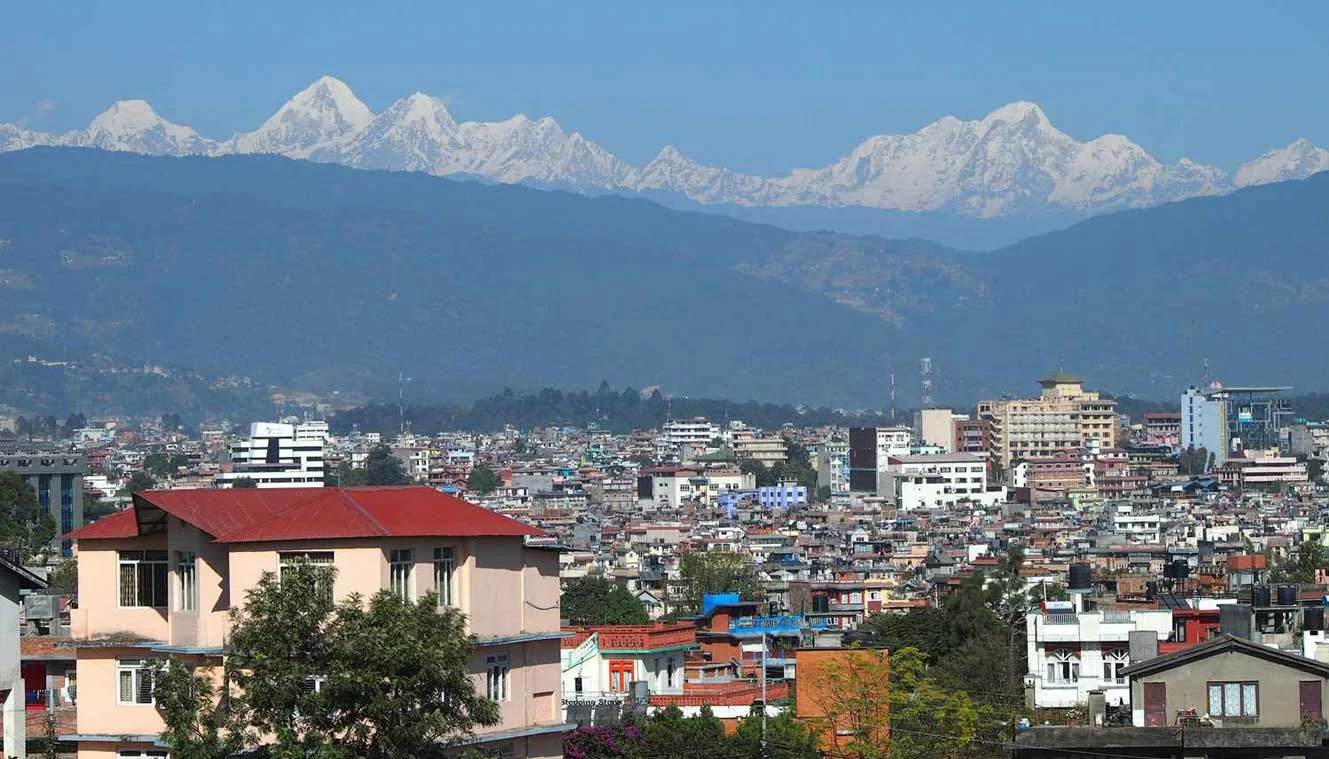
Fly to Lukla, Trek To Phakding | Enjoy A Scenic Flight Journey
- Altitude: Lukla - 2,850 m/ 9,350 ft; Phakding - 2,600 m/ 8,500 ft.
- Altitude Gain: 1200 m/ 3,900 ft.
- Early morning flight to Lukla (30 minutes).
- Trek to Phakding: 9 km | Duration: 4 to 5 hrs.
- Easy and gradual descent.
- Cheplung village lies en route from where you can see Mt. Khumbila.
- You can buy or refill your water bottles from teahouses on the way.
Get ready for a beautiful flight from kathmandu or ramechap to Lukla. Its a short flight of about 35 minutes that will take you over a panoramic landscape. On these flights, the planes are quite small but the journey is quite scenic. Our representatives will meet you at Lukla airport and this is where your trek towards Everest Base Camp starts.
After arriving at Lukla, we will start our trek towards Phakding after some refreshments. The trail is 9 km long and passes through Nepali mountain villages, green mountains, suspension bridges, and forests to Phakding. It takes about 4 to 5 hrs to complete the trek. From Lukla, the trek begins with a gradual ascent, with a few ups and downs along the way. Along the route, you will witness amazing views of Kusum-Kanguru as you cross a suspension bridge on your way. After a short climb, you will arrive at Ghat Village and after another one and a half hours of gradual walking, you will arrive at Phkading. En route, you will also spot boulders that are carved with Buddhist Prayers. We will stay overnight in Phakding.
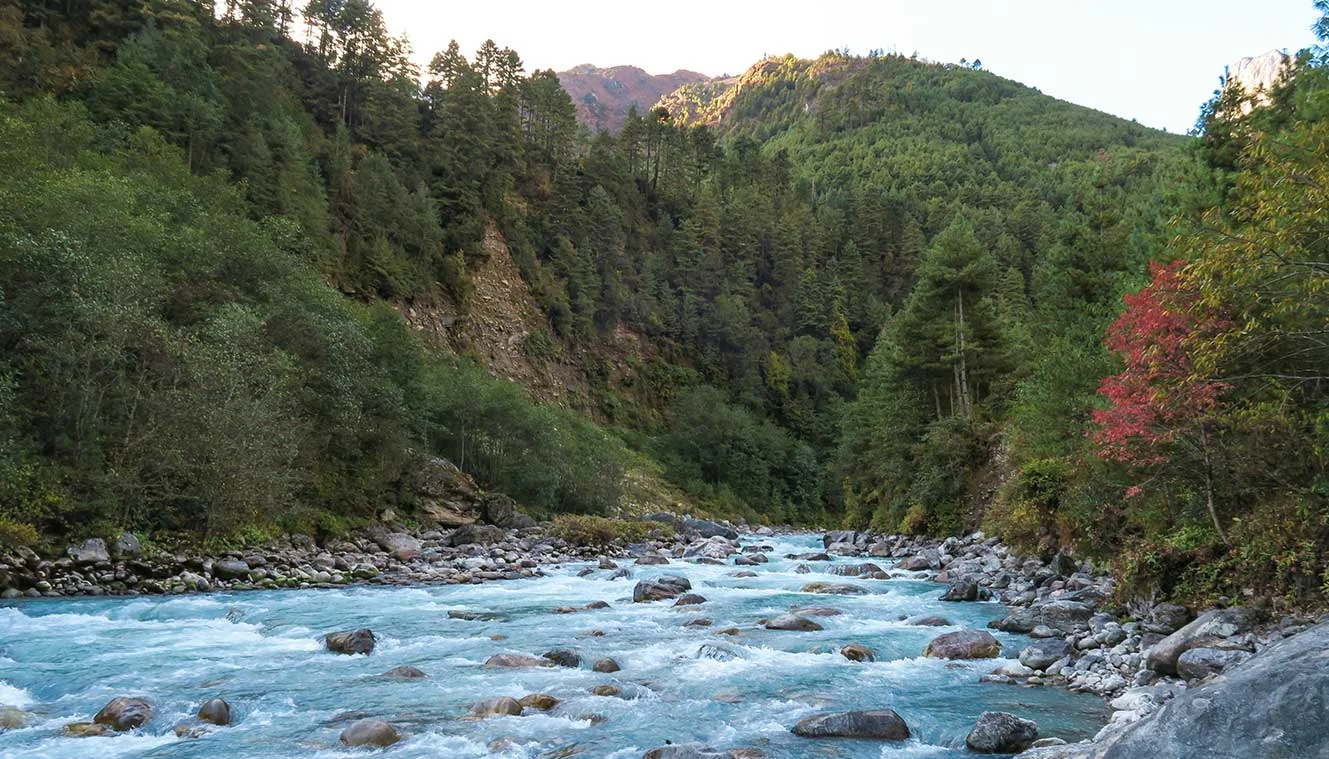
Phakding To Namche Bazaar | A Major Trading Hub In Khumbu
- Altitude: 3,450 m/ 11,300 ft
- Trek: 10 km | Duration: 7 hrs.
- Altitude Gain: 850 m/ 2,800 ft.
- Moderate level of climb and steep climb before Namche Bazaar.
- Namche Bazaar is the capital of the Khumbu region.
- You will get the first views of Mt. Everest today.
- You will spot Kongderei and Thamserku peak.
- Monjo village is the mid-point of the trek.
- A swiss suspension bridge on Dudhkosi River. It is one of the major attractions.
- Dudhkosi River is considered as the lifeline of the Khumbu Region.
- Today you will enter into the Sagarmatha National Park (a UNESCO World Heritage Site).
Post breakfast, we will start our trek towards Namche Bazaar. The route today is surrounded by green mountains and will take you through suspension bridges over the Dudh Koshi and Bhote Koshi rivers. Before entering the Sagarmatha National Park, you will have to obtain permits and then the trail follows a steep ascent before arriving at Namche Bazaar. Namche Bazaar is an important trading hub of the Khumbu region.
We will start our trek early in the morning from Phakding and soon you will cross a suspension bridge over the Dudh Koshi River, the walk from here is easy and pleasant with short uphill and downhill climbs. You will cross another suspension bridge over the Bhote-Koshi River. It is a busy area and you may notice a multitude of trekkers and porters here. After a 20 minute climb from this area, you will arrive at Monjo. Monjo is a pit stop for many trekkers and many people also camp here. At Monjo, you will see interesting watermills that are used to grind barley, a staple diet of the Sherpas. Monjo is situated right below the majestic Thermasarkhu peak (6,608 m) and quite close to this village is the entrance to the Sagarmatha National Park.
Treading along the Dudh Koshi River, you will arrive at the Sagarmatha National Park. At this point, your trekking permit will be checked and the officials will keep a record of all the trekkers going ahead. Sagarmatha is a UNESCO World Heritage Site that showcases stunning mountain views and rich biodiversity. Here, you may spot rare Himalayan species like snow leopard and the lesser panda. The presence of Sherpa settlements with their unique culture makes the trek even more interesting. A gradual walk from Sagarmatha National Park will lead you to Namche Bazaar. From Namche Bazaar, you will catch the first glimpses of Mt. Everest. Namche Bazaar is a historic trading center of the Khumbu area and you can stock up on essentials from this point. At night we will stay here at a guesthouse.
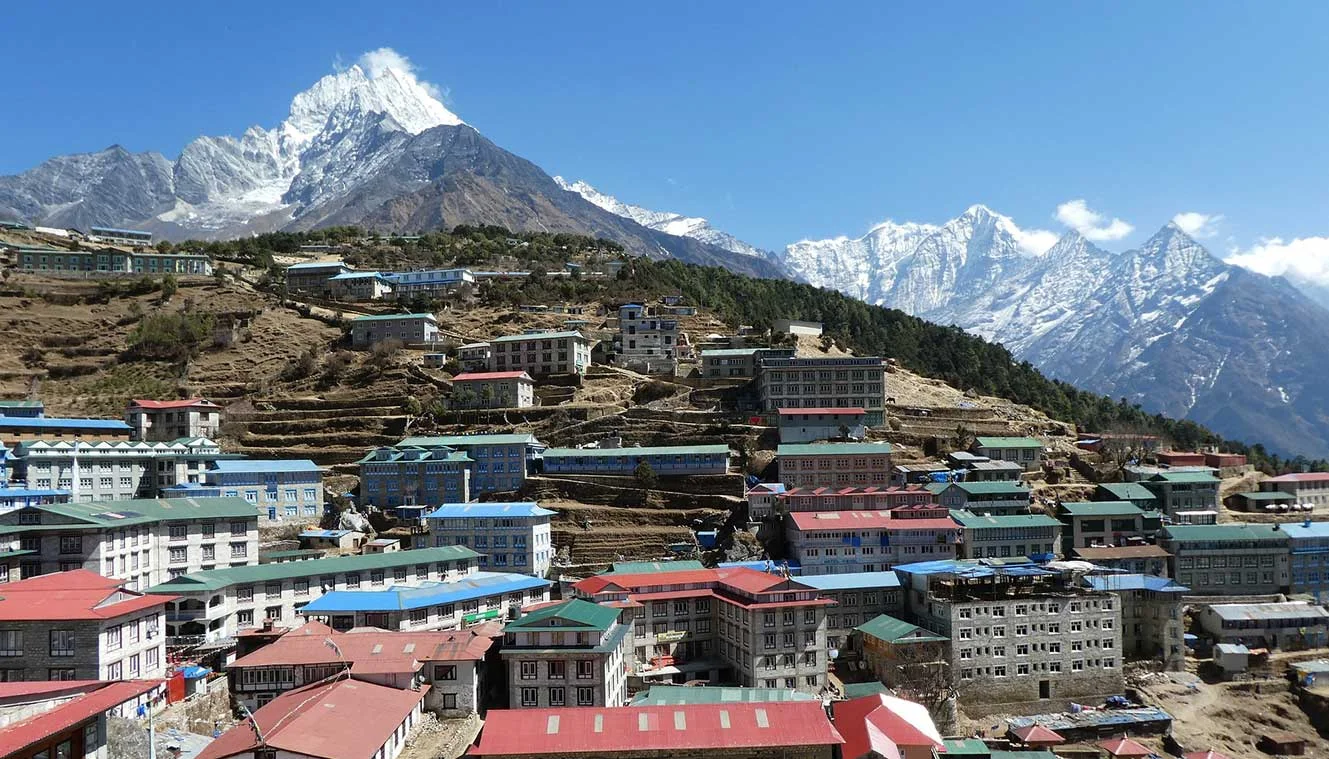
Acclimatization Day | Explore Namche Bazaar
Wake up to the beautiful views of the highest Himalayan peaks and enjoy a delicious breakfast. Today we will stay in Namche Bazaar allowing our bodies to acclimatize to high altitudes. You can spend the day exploring the surroundings and enjoy the culture and hospitality of Nepal. Namche Bazaar is a commercial hub so you can do any last-minute trek shopping from here. The market has a vibrant atmosphere and there are a couple of restaurants and coffee shops as well.
You can do a short hike to Sagarmatha National Park headquarters. From here, you can get a good view of Ama Dablam, Mt. Everest, and other Khumbu peaks. Sherpa Cultural Museum is close by and lies just above Namche Bazaar. The museum gives you a fair amount of details about the history of the Himalayas, the geographic and cultural aspects, mountaineering history, and information about the various flora and fauna in the region. You will see many pictures of Tenzing Norgay and Edmund Hillary from their climb and maps detailing their trails as well. In the evening, take acclimatization walks around the market, preparing your body for higher altitudes. Soak in the Nepalese Buddhist culture, food, and traditions. Namche Bazaar gained popularity during the time when Tibetan salt was traded for grains from Nepal\\s lowlands. Nowadays, you can see a roaring trade of rugs, clothing, dried meat, and salt in the village center. There are many shops that also offer locally made handicraft items, you can buy them as souvenirs or gifts for your friends and families. You will stay the night at a guesthouse in Namche Bazaar.
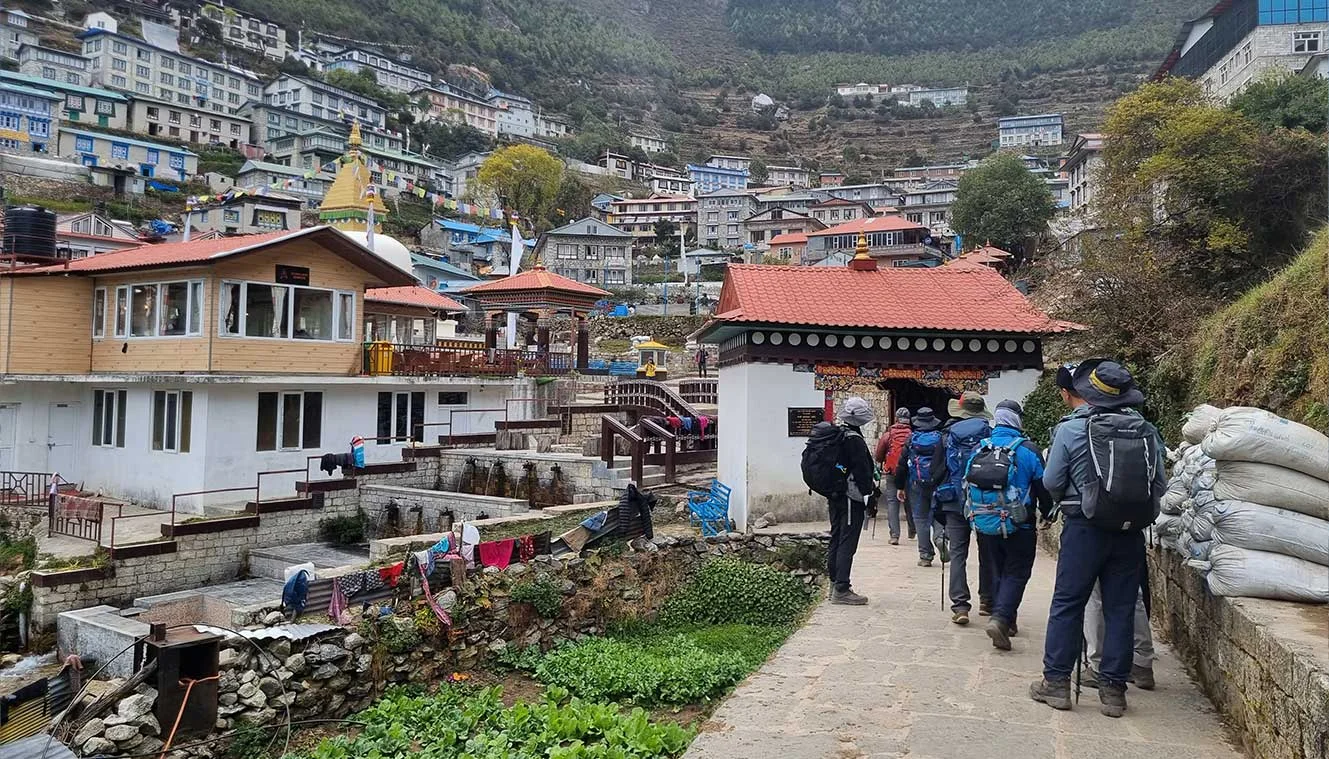
Namche Bazaar To Tengboche | Visit The Largest Buddhist Monastery Of Khumbu
- Altitude: 3,850 m/ 12,650 ft.
- Altitude Gain: 400 m/ 1,350 ft.
- Trek Distance: 8 km | Duration: 5 to 6 hrs.
- Mixed ascent till Phunki Tenga.
- Steep ascent after Phunki Tenga to Tengboche.
- Tengboche has the biggest monastery in the area.
- You can attend a prayer ceremony held by the monks to invoke protection on your expedition.
- Cross another high bridge at the village of Phunki Tenga.
Start your day with a delicious breakfast and get ready for your trek to Tengboche from Namche Bazaar. It’s an 8 km long trail and is a fairly easy trek accompanied by the views of the majestic Himalayas. You will also spot Himalayan Wildlife on the way as well.
Tengboche is a small alpine valley that is situated at an altitude of 3860 m and the trek starts with an easy walk. The trek from Namche Bazaar to Tengboche is extremely beautiful and along your trek, you will get a bird’s eye view of Dudh Koshi River down below and the epic mountain views as Thamserku (6,608 m), Kantega (6,782 m), Ama Dablam (6,812 m), Lhotse (8,516 m) and Everest (8,849 m) comes into view.
A 20-minute walk from Namche Bazaar will take you to the top of Namche Bazaar. From here the trek descends to Khumjung, a Sherpa village and then climbs up the sides of the mountains through some stairs and then diverges from the Everest Highway at Sanasa. You will be able to catch glimpses of Lhotse, Nuptse, and Mt. Everest from here. This is probably the best view of Mt. Everest you will get until you reach Gorakshep when climbing to Kala Patthar. Two hours of pleasant walking will bring you to Sanasa. Up to Sanasa, it is a walk-through forest covers of Oak and Rhododendrons. It is a great location for bird watching and you may spot the Danphe Pheasant, the national bird of Nepal. Musk-deer and Himalayan Tahr, a Himalayan goat that looks like an antelope are commonly spotted in these areas. You will also spot the Tengboche monastery from here which you will reach in the later part of your trek.
Next, following a gradual descent, you will reach the Imajtse River at Phungitenga at an altitude of 3,250 meters. Phunki Tenga is a small Himalayan settlement with teahouses and army posts. The climb down can be a little tougher as the terrain is rocky and uneven. You will reach a suspension bridge over the river and after you make the crossing, you will need to get permits at a checkpoint to proceed further in your trek. From here it is a strenuous climb of about an hour that will take you to a Buddhist monastery just before Tengboche and finally to Tengboche village. This is the last part of today’s trek and you can expect the trail to be rocky with a couple of switchbacks. Don’t push yourself too hard, take it slow and steady as you make your trek uphill.
Tengboche Monastery, locally known as Dawa Choling Gompa is the largest monastery in the Khumbu region. It overlooks the beautiful region and the mountain landscapes around. There are daily prayers that occur around 7:00 am and once around 3:30 pm. You can take part in the prayers if you truly want a cultural experience. It is one of the important cultural aspects of the EBC Trek. Enjoy the serenity at this revered place of worship and at night your stay will be in the guesthouses at Tengboche.
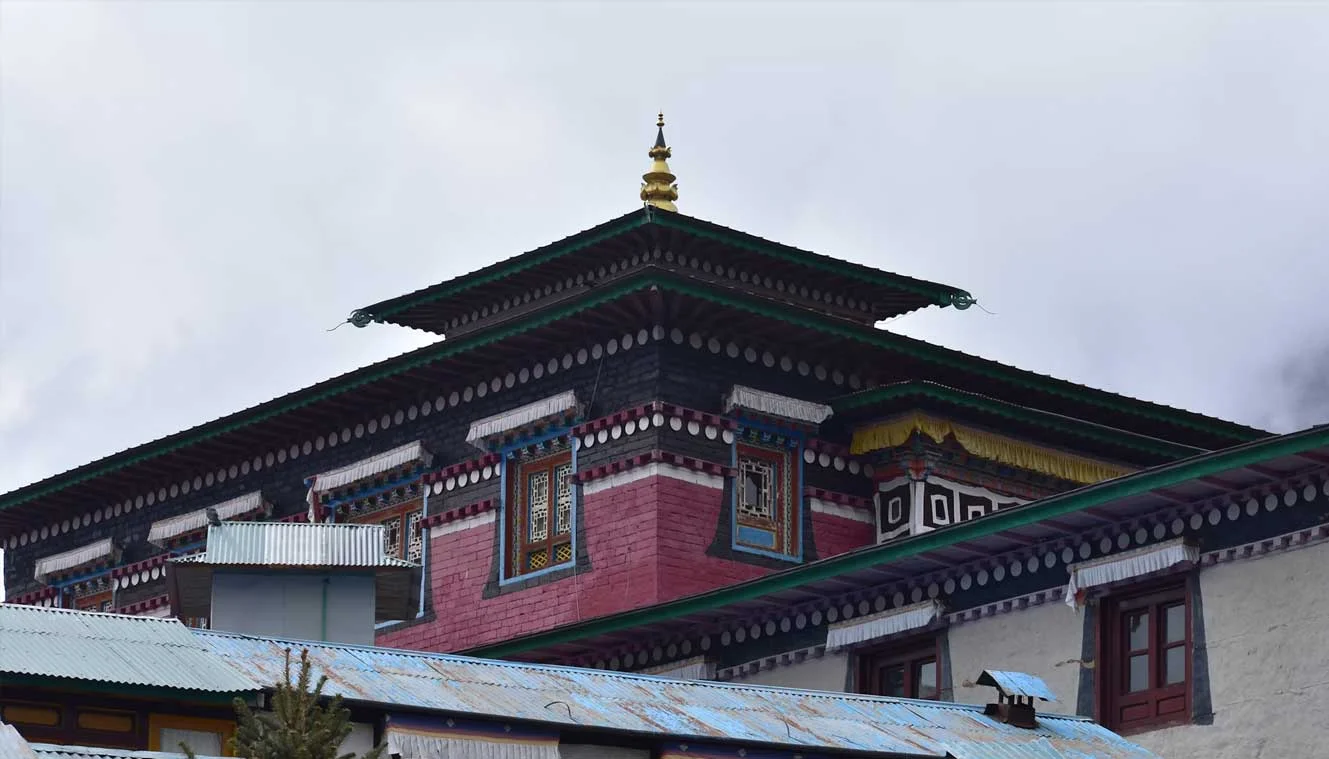
Tengboche To Dingboche | Stunning Views Of Ama Dablam
- Altitude: 4,350 m/ 14,250 ft.
- Altitude Gain: 500 m/ 1,600 ft.
- Trek Distance: 9 km | Duration: 6-7 hrs.
- Gradual descend and little bit of ascent after Lobuche River to Dingboche.
- The trail passes through lush forests of birch, conifer, and Rhododendron trees.
- The route offers amazing views of Ama Dablam standing over you.
- The trail crosses the Imja River to reach Pangboche.
- Continue along the Imja Valley and Lobuche River before ascending to Dingboche.
Today, we will begin our trek towards Dingboche. From Tengboche, cross bridges and rivers accompanied by beautiful mountain views all the way to Dingboche. Stone steps will lead you through forests of Rhododendrons, conifers, and birches, and at the bottom of the forest lies the Deboche village. From here, the trail rises up and enters into the alpine meadows and Dingboche. Dingboche is the only place in the entire Khumbu region where barley is grown. The views of the Himalayas are amazing from Dingboche. Start your trek from Tengboche and walk towards Pangboche Village, you will get to see some beautiful views of Mt. Ama Dablam and from Pangboche we will trek towards Pheriche and to Imja Valley. The beautiful Lobuche River passes through Imja Valley and from here a steep hike will take you to Dingboche. The trek takes about 6 to 7 hrs and for the most part, the difficulty is moderate.
At the beginning of the trail, you will first descend into a forest trail passing the small settlement of Deboche. As you trek from Tengboche to Dingboche, the scenery changes as you gain altitude, greenery slowly giving way to barren landscapes, and the trails gradually becoming more rugged and it will also start getting cold and windy. In the initial part of the trek, you will pass by a wall with stone inscriptions and a small stream will keep you company along the trail. You will have to cross the stream to the left-hand side of the valley. The majestic Ama Dablam dominates the skyline ahead of you. About two hours into the trek, you will arrive at Pangboche, a mountain village, where you get beautiful views of Mt. Everest. From Pangboche, you will hike upwards towards the valley and throughout the trek, you will slowly gain elevation. Although the trek is mostly uphill, the slope is relatively easy without extremely steep inclines. Ama Dablam continues to stay in view, however, you will only get to see a tiny silver of the top of Mt. Everest. Lhotse and Nuptse become quite prominent now.
Soon you will arrive at the village of Shomare, your last village before Dingboche. Ama Dablam still remains in view but now you will get to see a different angle of the mountain from what you have seen before. The trail continues winding to the valley side and you will cross another river before entering Dingboche village. Dingboche is a lovely Himalayan hamlet and you will see agricultural fields protected by stone walls. Once at the village, we will check into a guesthouse and we will stay the night in the guesthouse.
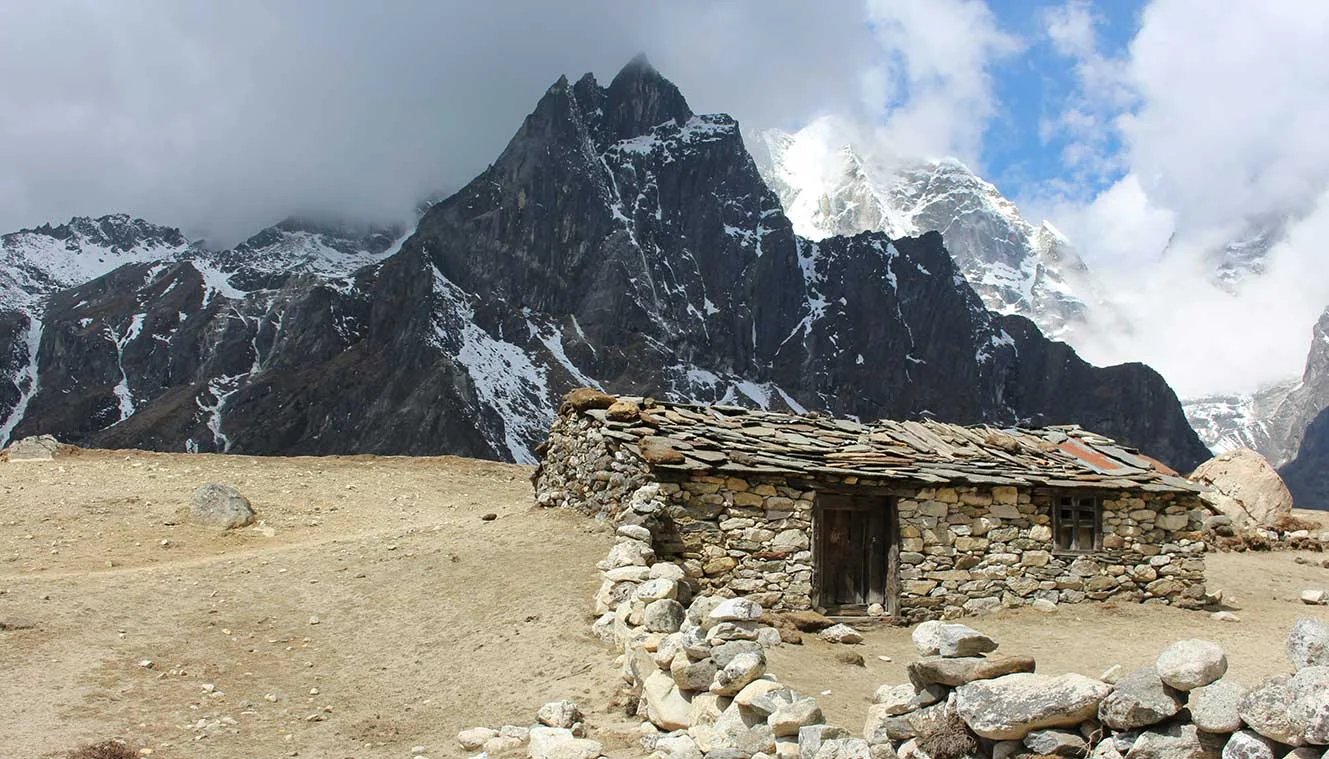
Dingboche (Rest Day) | Acclimatize To Higher Altitudes
Today is a rest day at Dingboche, which will help us acclimatize to the high altitude. As we exert a good deal of energy on the trek, our body needs to get accustomed to less oxygen at higher elevations. So instead of taking a rest day, if continue to gain elevation it can result in altitude sicknesses like dizziness, nausea, and headache or potentially even more dangerous conditions like cerebral or pulmonary edema. To prevent these issues, we start our acclimatization process at the 11,500 ft mark. Since Namche Bazaar is quite near that elevation, we start our acclimatization process from Namche Bazaar itself.
For acclimatization, you can walk around the village. Dingboche village has many farms and crop fields sparse across the village, native crops include barley, potatoes, and buckwheat. You can also do a short hike around the village to Chukung. Its a 3 - 5 hrs trek that takes you to an altitude of 4,730 m. Chukung lies in the Imjatse Valley towards the east. Although the trek is gradual you can feel the effects of thinning air. Chukung has a couple of teahouses as well and you get a superb view of the surrounding areas from here. Some of the views are exceptionally beautiful as you continue to climb higher and higher. Explore the valley and the surrounding areas, return back to the guesthouse. This hike will prepare your body for the next few days at higher altitudes.
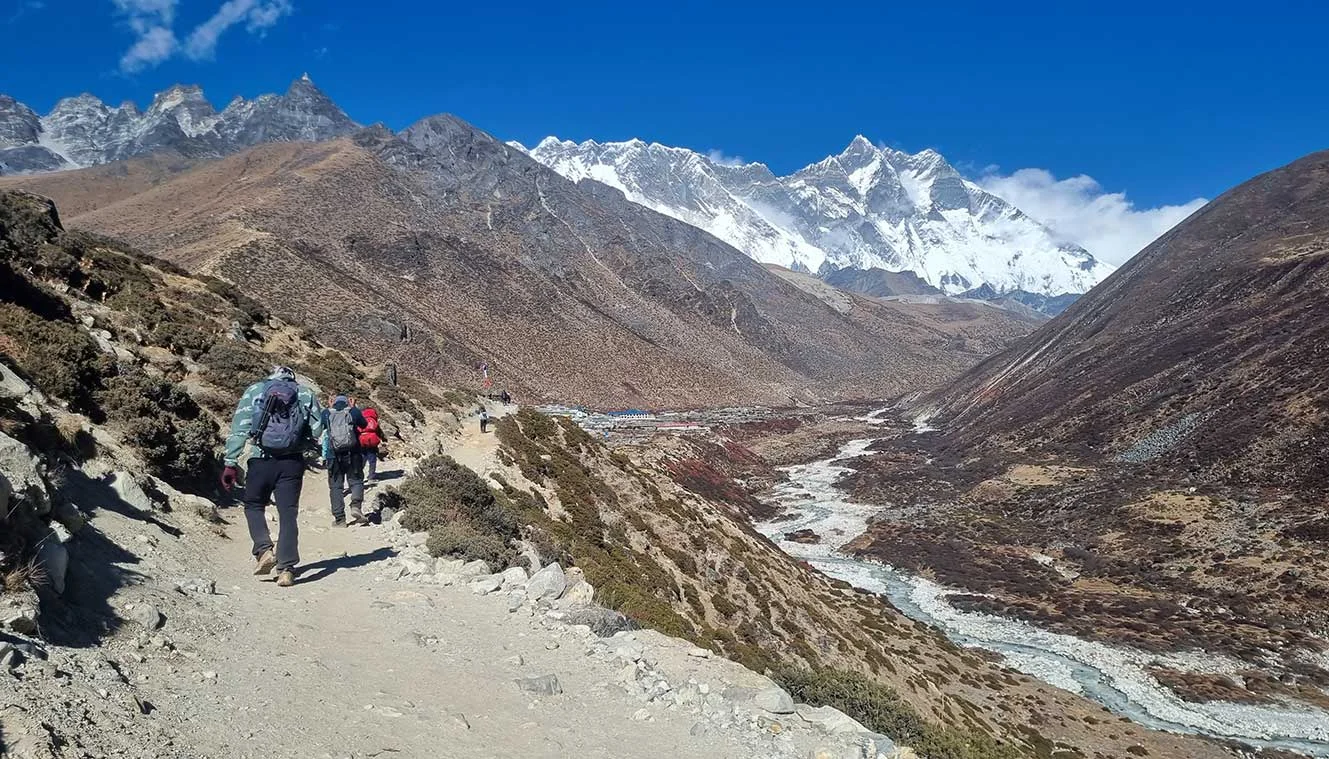
Dingboche To Lobuche | Pay Your Respects In Everest Memorial
- Altitude: 4,950 m/ 16,200 ft.
- Trek Distance: 7 km | Duration: 6 hrs.
- Altitude Gain: 600 m/ 1,950 ft.
- Tricky climb on moraine and rocky terrain.
- You can visit the memorial shrine.
- The top of the ridge is filled with prayer flags and stones which are memorial shrines for climbers who lost their lives on Mt. Everest.
- As you cross Khumbu Glacier, you will see Mt. Nuptse (7,861 m).
Today’s walk will take you from Dingboche to Lobuche through alpine pastures and in the summertime, you can see Yaks grazing in these pastures. You will trek towards the end of the moraine of the Khumbu Glacier offering spectacular views of Mt. Nuptse. At the moraine, you will see stone monuments, these are dedicated to six Sherpas who died in an avalanche along with monuments dedicated to other mountaineers. From here, it’s a steep climb towards Lobuche where you will get a magnificent view of Mt. Nuptse and the sunset over this mountain peak is even more spectacular. From Dingboche, you will have to ascend a small ridge behind the village, towards the north you can see Lobuche Peak (6119 m) and the snowfields of Cho La. Later you will cross Khumbu Khola, the huge glacier moraines of the Khumbu Glacier flowing from Everest. Crossing the memorial cairns, and following the valley stream, you will arrive at Lobuche in the early afternoon. The 6 hrs trek covers 7 km and brings us much closer to the Everest Base Camp.
Start the hike from Dingboche along the inclined path running alongside the mountain’s wall and go further into the valley. As you make your turn along the path and inside the valley, you arrive at the village of Pheriche, we will be staying here on our way back from the base camp. For the next 2 to 2.5 hrs, you will follow into the valley, while the incline is not very difficult but you are at a high altitude, so take it slow and steady and avoid using too much energy too quickly. A river lies in front of you and crossing the river, you will arrive at the village of Thukla. This is a great spot to rest for a couple of minutes, refuel yourself and continue on the trek.
The next part is going to be the toughest part of the trek today as you climb to Lobuche. The climb takes you along a zig-zag path all the way to the Thukla Pass and it becomes steeper and steeper as you climb until you reach the edge of the Khumbu Glacier and the Everest Memorial. The oxygen gets less and less from here and the temperature also starts to get lower. The remaining part of the trek follows the left side of the glacier as you reach the village of Lobuche and you will also gain a little elevation from the glacier as you arrive at Lobuche. In front of you, you get to see a beautiful view of Nuptse in front of you. Lobuche is a small Himalayan village with only a handful of teahouses. We will stay the night here before we head out to the last village on the trek tomorrow.
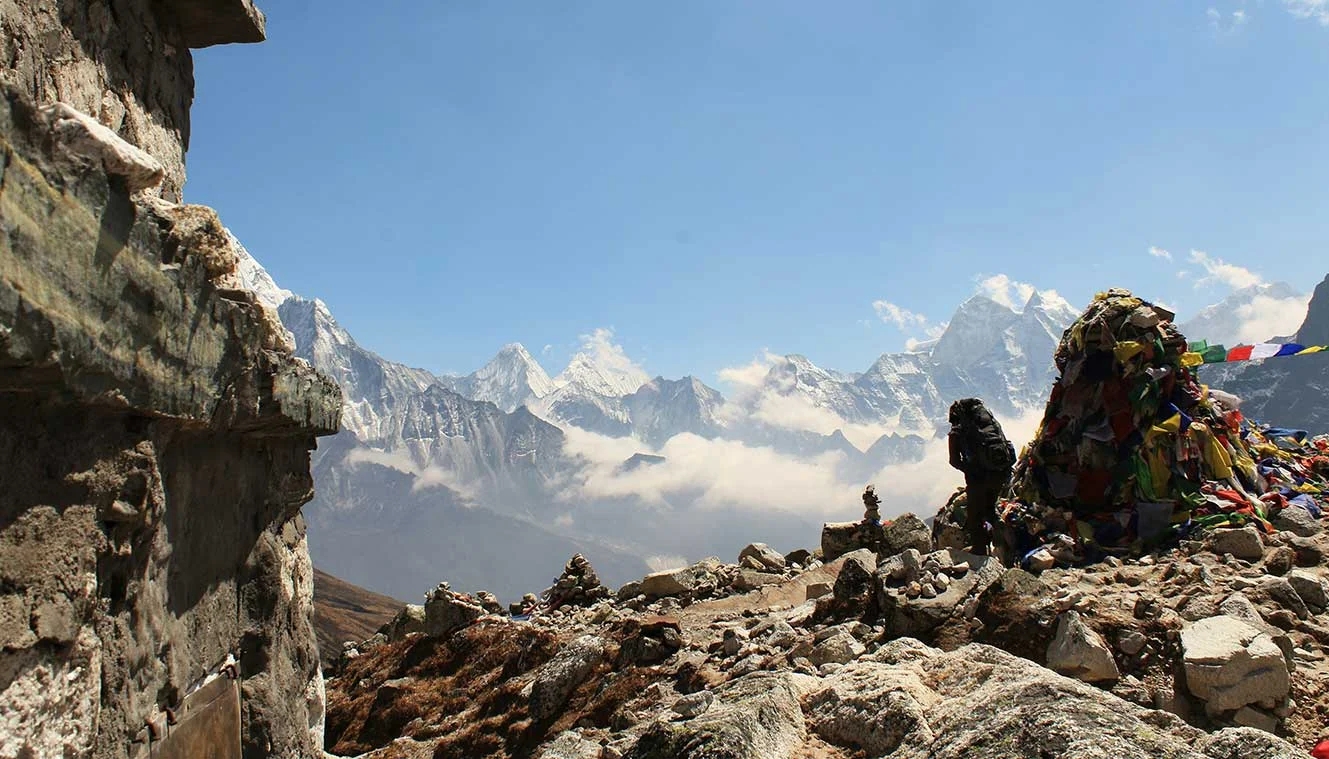
Lobuche To Gorkhashep | Excursion To Everest Base Camp
- Altitude: Gorakshep - 5,150 m/ 16,900 ft & highest point - 5,350 m/ 17,750 ft.
- Altitude Gain: 200 m/ 700 ft.
- Lobuche To Gorakshep: 6 km | Duration: 4 hrs.
- Gorakshep To EBC: 3 km away each.
- It’s Everest Base Camp Day Today.
- Good steep climb to Gorakshep.
- It takes about 3 to 4 hrs to reach Gorakshep.
- Lunch is at Gorak Shep.
- A steeper climb to Everest Base Camp.
- The trek to Everest Base Camp is not very difficult.
- Trekker\\\\\\\\s stop point is just below the actual base camp.
- Most tour groups are not allowed to enter or stay in EBC.
- Make sure you carry your day pack since you will need water.
- You can enjoy amazing views of Nuptse, Khumbutse, and Pumori mountains from the base camp.
- Overnight stay in Gorakshep.
Note: Drinking water in Gorakshep is chargeable. We don’t include drinking water on the trek which you can buy from a number of places between $1 to $3 a bottle (it gets more expensive towards the base camp). The better alternative is to buy water tablets in Kathmandu/Pokhra for around $2 and treat the water.
Today is the most exciting day of the trek as you make an excursion to the Everest Base Camp. An adventurous journey and a great trekking experience await you. Waking up early, have your breakfast, and gear yourself up. We will follow the trail from Lobuche through narrow gaps in the mountains and glacial moraines along the Khumbu glacier to Gorak Shep, the last village on the trek. Post lunch in Gorak Shep, we begin our trek to the Everest Base Camp, the ultimate adventure of this entire journey. We follow the lead of Sherpas as the trail changes every season as the glaciers move. It takes about 7 hrs of walking to reach Everest Base Camp. Spend some time at the base camp, celebrate your victory, capture some stills and descend back to Gorakshep. Overnight stay will be at Gorakshep.
The trek today can be broken down into two parts, the first part is the trek from Lobuche to Gorak Shep and the second part is an excursion to EBC and back to Gorak Shep. After breakfast at Lobuche campsite, we begin our trek towards Gorak Shep. It is a 6 km hike that takes about 4 hrs. Walking along the sandy and rocky parts, you will gradually gain elevation as you walk alongside the Khumbu Glacier. Mt. Nuptse looms on the horizon in front of you. Some sections of the trail are a little steeper than others. On the way, you will pass Sherpa flag monuments indicating that you are getting closer to the Everest Base Camp.
The last section of the trail directs into a glacier before you reach Gorak Shep. the terrain is rocky and uneven with inclines and declines. Be cautious and watch your step in this part and always pay heed to the trek leader\\\\\\\\s advice to complete the patch safely. You can see a sliver of the top of Mt. Everest from here, right behind Nuptse. Soon the village of Gorak Shep comes into view guarded by Kala Patthar and Pumori in the back. Make your way into the guest house have some lunch, reenergize yourself and get ready for the next part of the trek.
From Gorak Shep, you will walk right along the Khumbu Glacier, the Everest Range lies right behind it. It is a vast glacier and as you continue walking along the side of the glacier, you will constantly gain elevation until you reach the base camp. The incline is not very steep and is slightly moderate. A technical terrain lays ahead of you with a mixture of sand and rocks and it can get pretty slippery at some points as well. As long as you watch your steps, you will be good. Continue on and you will reach a point where the Khumbu icefall comes into better view as it winds down from the mountain to the valley. More Sherpa prayer flags mark the way to the base camp. In the final stretch of the trail, you will see numerous prayer flags flowing in the wind and the popular Everest Base Camp Rock. You have made it to the Base Camp, congratulations! While this is not the actual base camp, it is a trekker’s base camp. Most tour groups are not allowed to enter or stay in EBC. Once you have had enough time to enjoy the area around EBC, it is time to head back to Gorakshep. Follow the rocky trail back to Gorak Shep. We will stay the night in Gorak Shep.
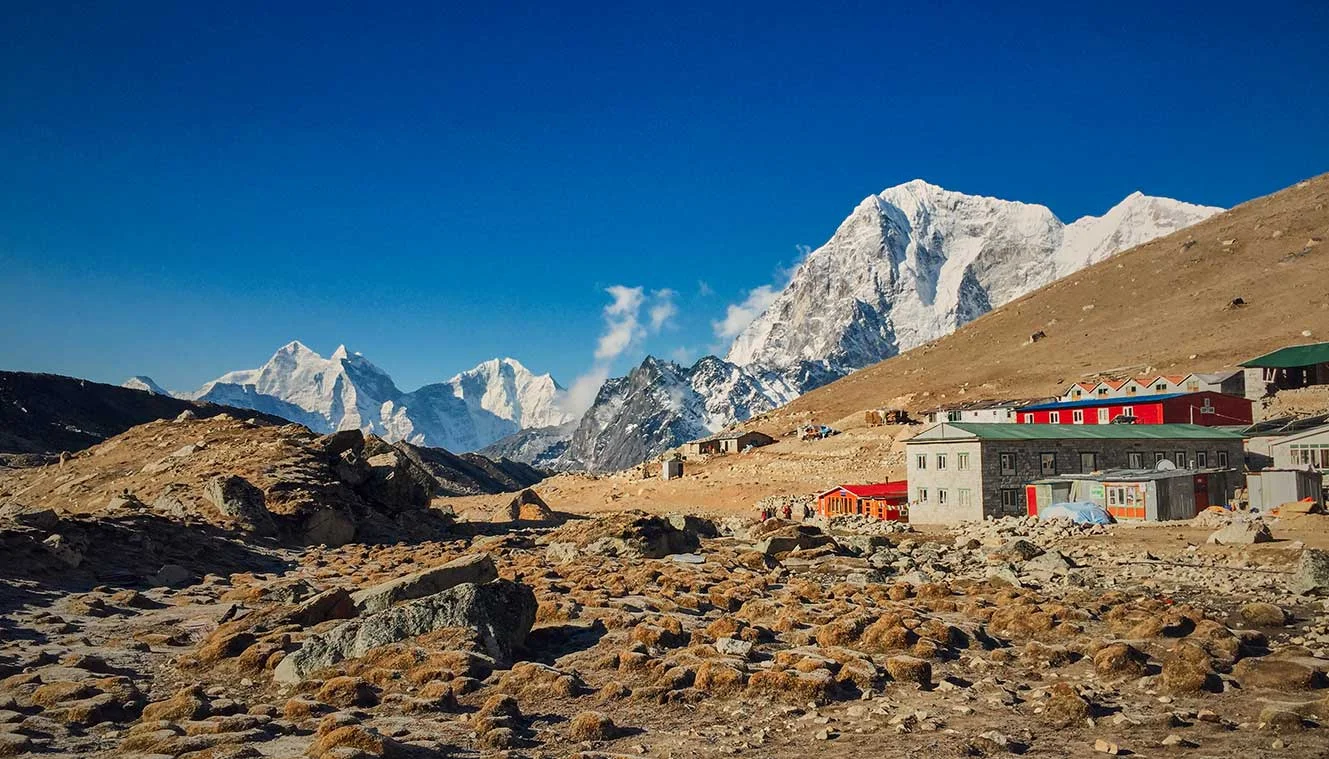
Hike To Kalapatthar And Retreat Trek To Pangboche | Enjoy Arresting Views Of Mt. Everest
- Altitude: Kalapatthar - 5,550 m/ 18,200 ft Pangboche - 4,300 m/ 14,100 ft.
- Gorakshep To Kalapatthar: 2 km each way | Duration: 3 to 4 hrs.
- Gorakshep To Pangboche: 25 km | Duration: 6 hrs.
- Altitude Loss: 850 m/ 2,800 ft
- Steep climb to Kalapatthar (difficult).
- Gradual descent to Pangboche.
- Start early in the morning to avoid early morning clouds.
- Kala Patthar is the rocky hilltop below Pumori.
- Views from the summit: Everest, South Col, Lhotse, Makalu, Khumbu Glacier & icefall, Pumori & Everest Base Camp.
- Breakfast at Gorakshep after Kalapatthar hike.
After your trek to EBC and back to Gorakshep, you are now ready to climb Kala Patthar. Gorakshep is also a good place to roam around, it has a couple of teahouses and it also used to be the base camp for climbing Mt. Everest in the 1950s. The trek starts with an easy walk from Gorakshep and you will be walking on sandy fields. After this, there is a steep climb of 45 minutes. After the strenuous climb, you will come to level fields and the walk is easy and gradual. You will have the comfort of walking for the next one hour, post which there is another steep climb to Kalapatthar for about half an hour. Mt. Everest from this point looks closer than you can imagine. From here, you will trek down to Pangboche.
Start your day early and leave your stuff at Gorakshep, only carry a daypack with the essentials as you will return to Gorakshep. As you cross the sandy trail and begin ascending, you will notice the Gorakshep village and Khumbu Glacier behind you including Ama Dablam. The top of Mt. Everest begins to peek out above the surrounding mountain ranges. The more you gain altitude the more Mt. Everest will come into view. The best part of today’s trek is that all along the trek you can enjoy the landscape of the surroundings and not just on the summit. The higher you get, the rockier and trickier the trail gets. Be mindful and watch your steps. The last patch is especially rocky.
The summit is a little difficult to navigate as well. You will know you are near the summit when the Sherpa prayer flags and weather reading device come into view. Take your time and dont rush to the summit to avoid any accidents. Once you reach the summit, you will get to see the breathtaking views of the entire Sagarmatha National Park but the main attraction is of course Mt. Everest itself. You will get the best view of Mt. Everest from here. Below Everest lies the Khumbu icefall that feeds into the Khumbu Glacier and to the right is the face of Mt. Nuptse. On the opposite side of the lake, you will see even more glaciers, lakes, and mountains, as far as your eyes can see. After spending some time at the top, descend the same path that you came in. When you are back in Gorakshep have a nice meal and refuel yourself as we will descend to Pangboche.
On the trek down, the first village will be Lobuche and throughout the trek, you will again be alongside the Khumbu Glacier. You have already completed this section while ascending up so you now have an idea of what to expect. The trek is a little tricky till Sagarmatha National Park sprawls out in front of you and the rest of the part is manageable. You can have some snacks at Lobuche before heading down to Pangboche.
As you descend, you will come to the intersection where one path diverges towards Dzonghla village, Cho la pass, and Gyoko Ri, and the one on the left heads towards Pangboche. Stay on the left side of the trail and you will come across another difficult patch of the trek. You will head down from the moraine wall of the Khumbu Glacier and descend to the Thukla Pass. Crossing the Everest Memorial, begin a tricky hike down to the river below and soon you will arrive at Pangboche.
Pheriche lies just below Dingboche so after crossing Thukla, you can take the lower path towards Pheriche instead of taking the higher path towards Dingboche. Once we arrive at Pangboche, you will check into a teahouse, have your dinner, and rest for the night before heading down to Namche Bazaar the next day.
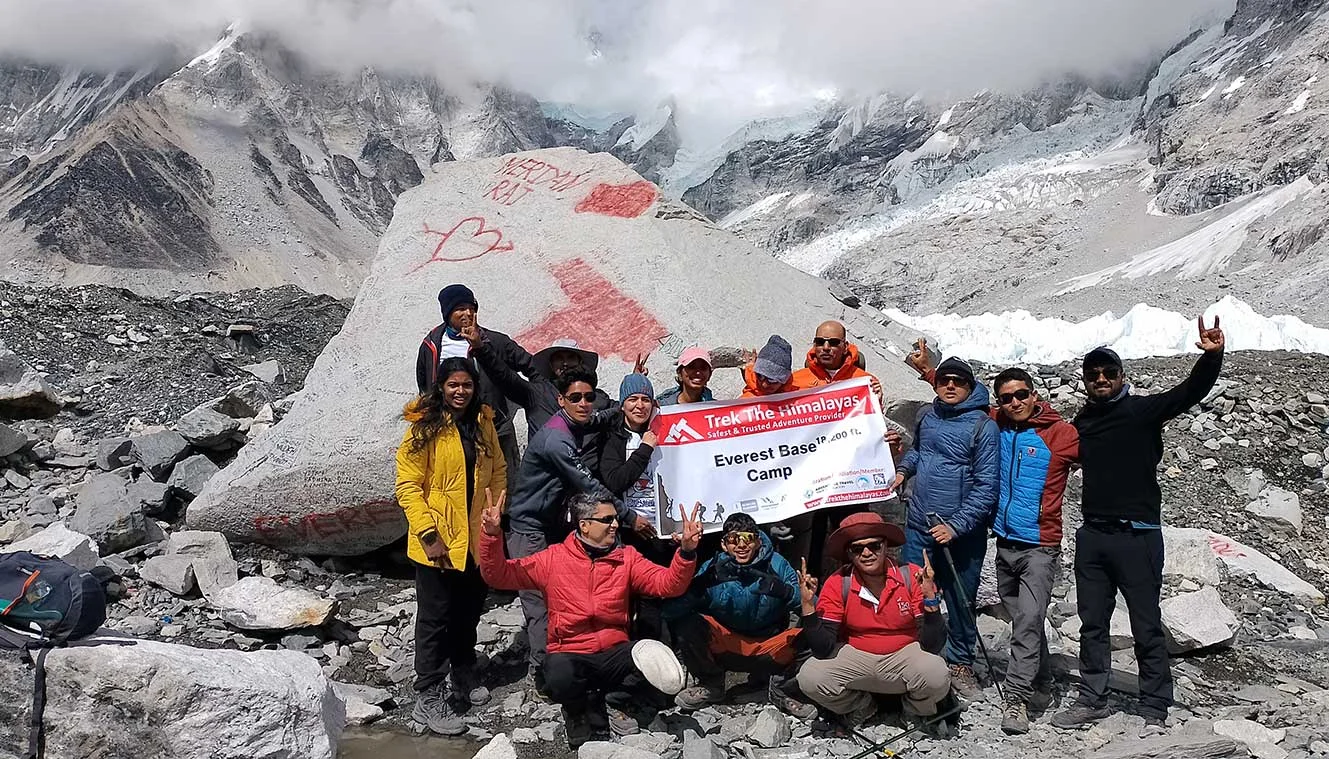
Pangboche To Namche Bazaar | Buy Some Souvenirs
- Altitude: 3,450 m/ 11,300 ft.
- Trek Distance: 15 km | Duration: 6 to 7 hrs.
- Altitude Loss: 850 m/ 2,800 ft.
- Moderately, continuous descent and short ascent just before Namche Bazaar.
After your descent to Namche Bazaar, the cumbersome part of the trekking is almost over. From here on the descent will be easy after having the Everest Base Camp trek. But we recommend starting early as it is a long walk. Start the journey by heading down to the village, across the river, and again climbing back up the valley wall. You can rest here for some time, catch your breath before resuming your decline down the valley.
Once you have declined the path, you will cross a suspension bridge followed by a 2 km incline along the valley wall. As you zig-zag up towards the trail, it becomes forested and once you have completed the uphill ascent, it is a fairly smooth walk for the remaining 5 km to Namche Bazaar. The path to Namche Bazaar is etched on a valley wall and there’s the river below. Soon the path bends inwards and you are welcomed with views of Namche Bazaar. Descend down to the village below and check into a teahouse. Rest well. Tomorrow will be the last day of your trek.
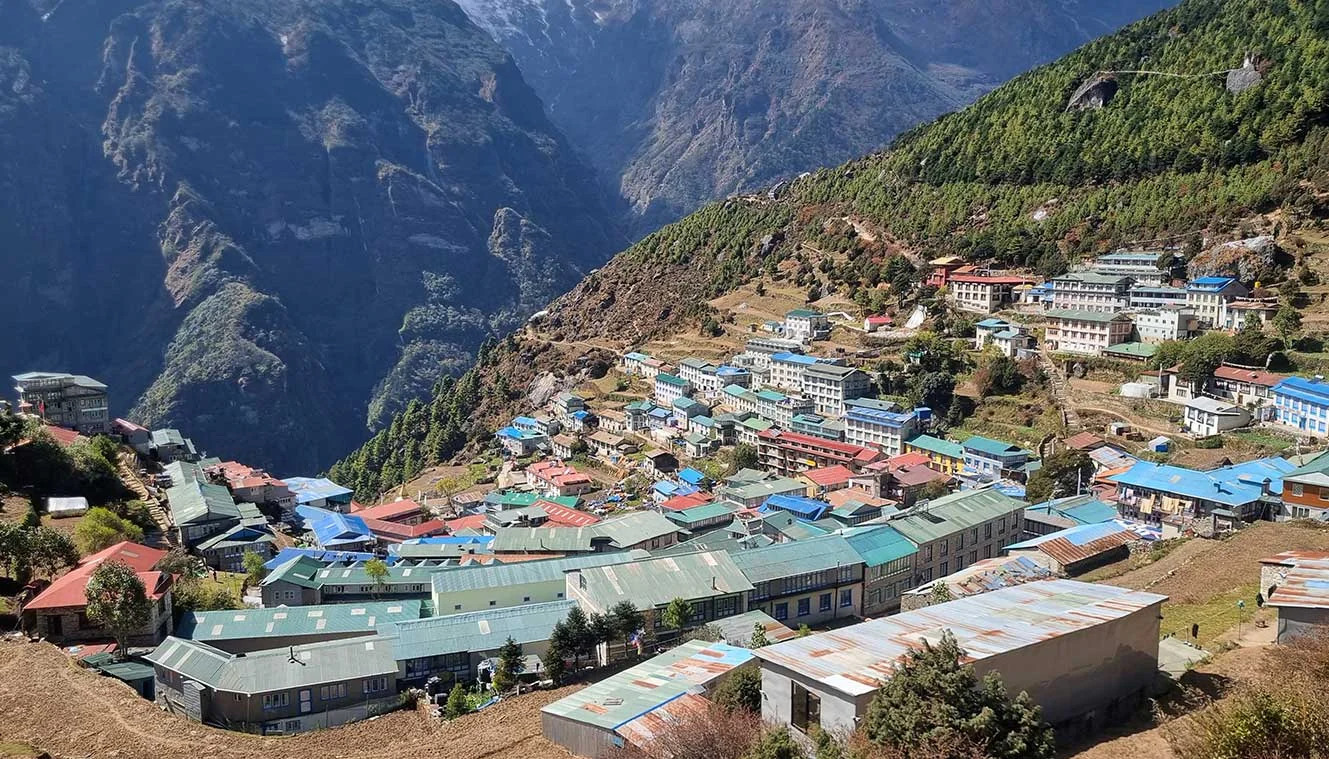
Namche Bazaar To Phakding To Lukla | Last Day Of Trekking
- Altitude: Phakding - 2,600 m/ 8,500 ft, Lukla - 2,850 m/ 9,350 ft.
- Altitude Loss: 600 m/ 1,950 ft.
- Trek Distance: 19 km | Duration: 7 to 8 hrs.
- Moderate, continuous descent till Phkading and gradual ascent to Lukla.
- Start your trek early in the morning as it is a long day trek.
- Stop at Phakding for lunch.
- Stay in Lukla.
Waking up to the lovely weather at Namche Bazaar, you can visit the place and roam around a little bit. You can explore the market and buy souvenirs from your trip to the Everest Base Camp and buy gifts for your friends and family. There are several local handicraft stores in Namche Bazaar as it is the biggest trade hub in the Khumbu region. You can also take a small walk-in around the Sagarmatha National Park and enjoy the local cuisine as well. Post which treks down to Phakding, it is an easy trek down to the village. The beauty of the distant mountains with several waterfalls adds to the beauty of your journey. This is the beauty of Nepal trekking, there will be a few uphill climbs but you will manage it very easily. The lush green beauty and forests will take your pain away. After this easy walk, you will reach Lukla. This will be your last day with the Sherpas and other crew members, so you would like to enjoy the day with a delicious dinner and a few drinks.
Right at the beginning of the trek, you will begin to lose elevation, after about 45 minutes of walking, you will arrive at a rest stop, the same that you came in on when ascending towards the basecamp. This is where you will get the last glimpses of Mt. Everest. After this point, there are no mountain views anymore only little peeks from behind the forest covers. You will cross a few suspension bridges and continue alongside the river as the initial steep decline eases into a more moderate decline. While most of the trek is downhill, there are a few uphill climbs as well. Pass by Sherpa stones into the village of Phakding. You are more than halfway to Lukla by now. We will stop at Phakding for lunch before descending further down the valley with river views, mountain ridges, and suspension bridges. You will also have several stair sections and an incline path all the way through. Passing by a few more villages, you will arrive at Lukla, your final stop for the day.
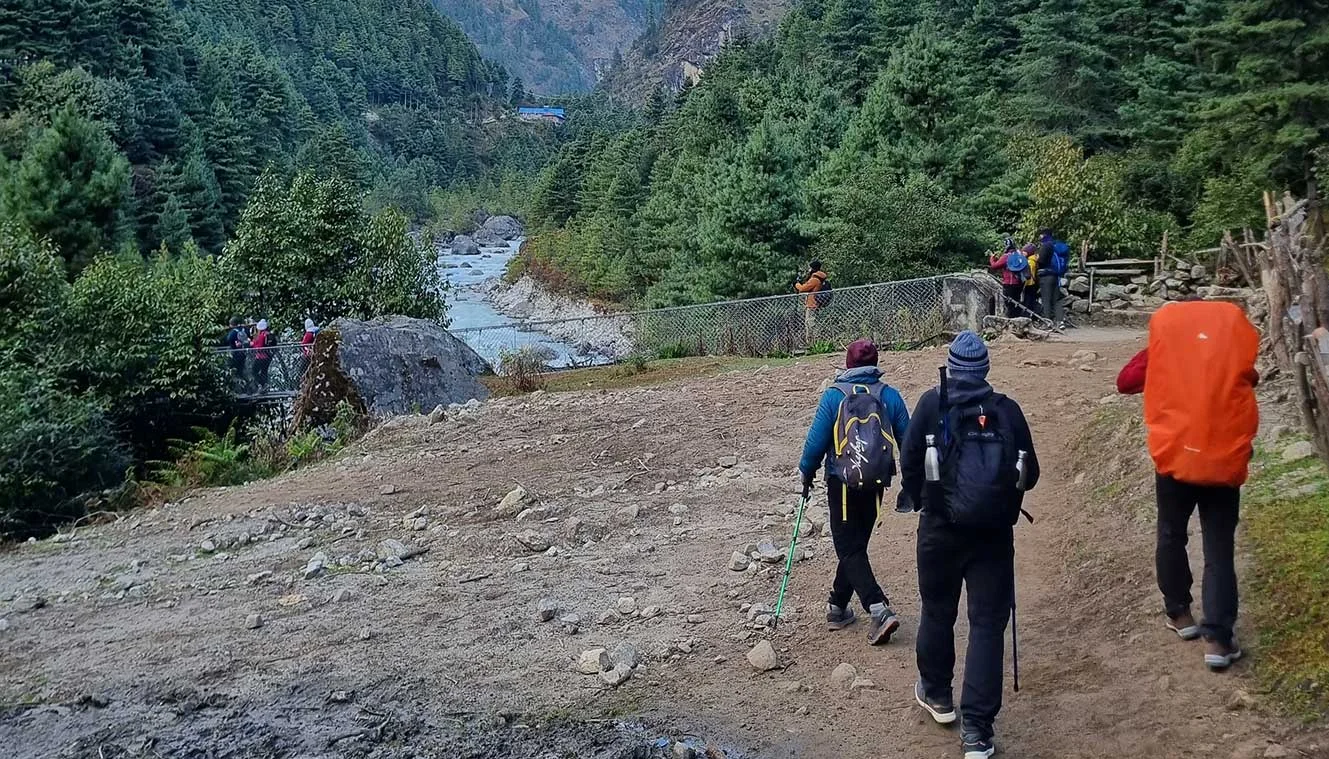
Fly Back To Kathmandu | Bid Adieu To The Mountains
Today you will have to wake up early as flights to Kathmandu are generally scheduled in the morning. This is because during the daytime, the weather is generally windy and there might be a delay in the flight timings. However, you can expect a slight delay in your early morning flight as well if the weather is not suitable. As you make your way through the security checks and your flight takes off from Lukla airport, you will have a magnanimous view of the surroundings. Drive back to Kathmandu from Ramechhap Airport and overnight stay in a hotel. You can book your further journey from here. We wish you a great journey towards your home with lots of memories.
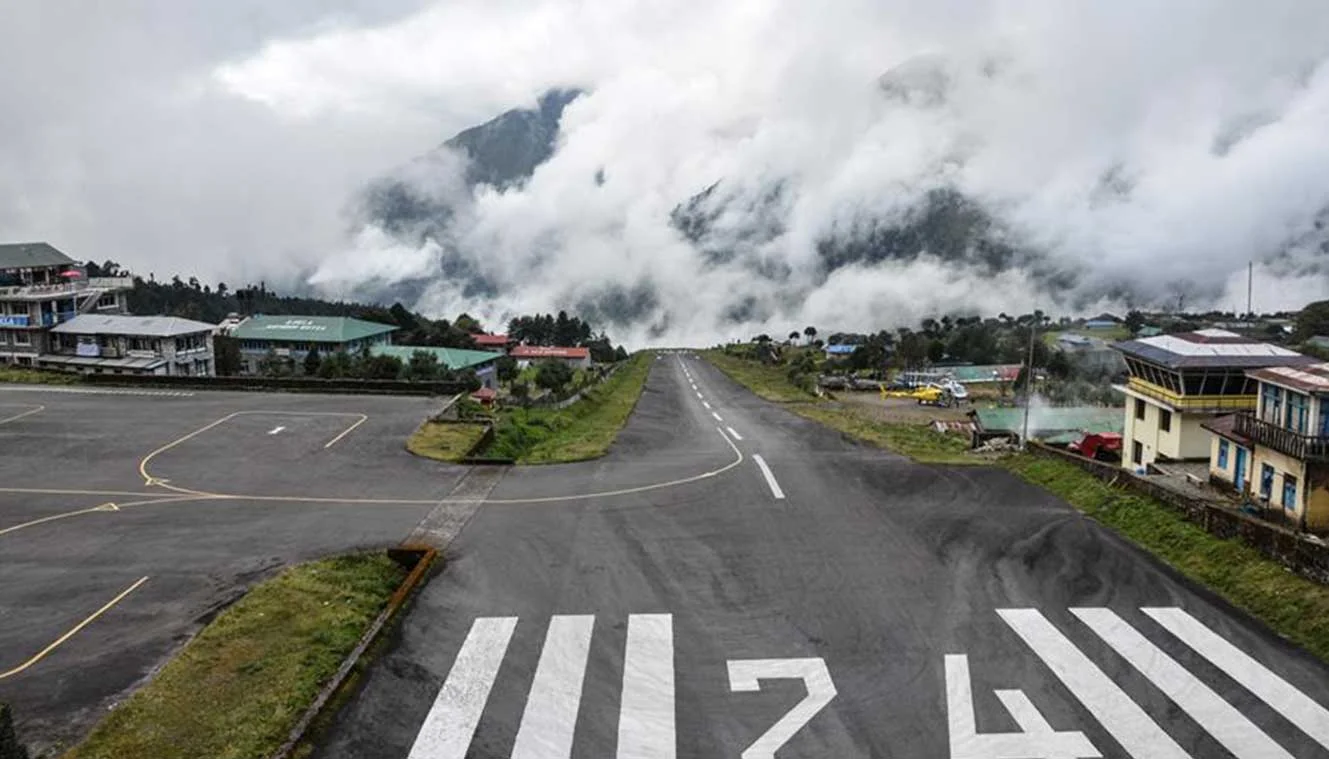
Day-1: Arrive At Kathmandu
Day-2: fly to lukla, trek to phakding | enjoy a scenic flight journey.
Note: Flights to Lukla are prone to delay due to weather, keep one or two buffer days in your plan.
Day-3: Phakding To Namche Bazaar | A Major Trading Hub In Khumbu
Day-4: acclimatization day | explore namche bazaar.
- Today is acclimatization day.
- You can hike up to Sherpa Cultural Museum to get a view of Everest and Ama Dablam.
- It’s worth exploring the town, a good place to buy trekking gear.
- ATMs, internet cafes, shops, and restaurants are available at extra cost.
- Stay in the guesthouse.
Day-5: Namche Bazaar To Tengboche | Visit The Largest Buddhist Monastery Of Khumbu
Day-6: tengboche to dingboche | stunning views of ama dablam, day-7: dingboche (rest day) | acclimatize to higher altitudes.
- Rest Day helps you acclimatize well to high altitudes.
- A small hike today will show you the world’s six tallest peaks including Lhotse (8,516 m), Makalu (8,463 m), and Cho Oyu (8,188 m).
- From another location, you can see the Imja Khola Valley and Dingboche Valley.
Day-8: Dingboche To Lobuche | Pay Your Respects In Everest Memorial
Day-9: lobuche to gorkhashep | excursion to everest base camp, day-10: hike to kalapatthar and retreat trek to pangboche | enjoy arresting views of mt. everest, day-11: pangboche to namche bazaar | buy some souvenirs, day-12: namche bazaar to phakding to lukla | last day of trekking, day-13: fly back to kathmandu | bid adieu to the mountains.
- Morning flight to Kathmandu.
- Your trek to Everest Base Camp is over.
- Spend the day in Kathmandu or fly back to your onwards destination.
- Hotel accommodation in Kathmandu is included in the cost.
Note: Weather conditions may cause flight cancellations. Delays are possible any time of the year but are more typical on summer departures. Keep one or two buffer days.
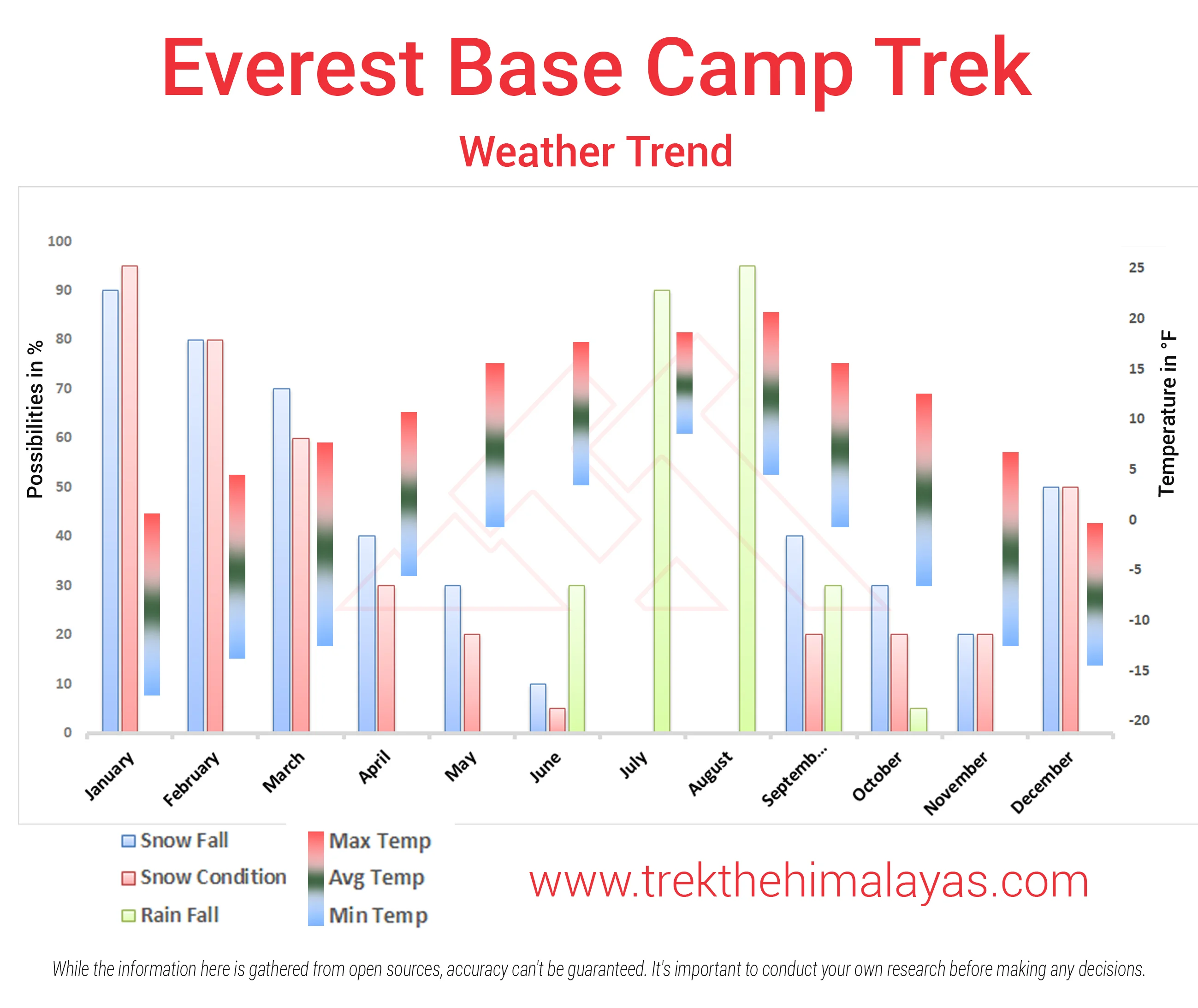
Pulse rate at rest must be in between (60 to 90 beats per minute)
Blood Pressure Reading must be in between (DIASTOLIC 70 – 90, SYSTOLIC 100 - 140 mm Hg)
Respiratory rate at rest must be in between (12 to 20 breaths per minute)
Should not have Liver and kidney issues
Should not have Diabetes Mellitus, Bronchial Asthma, Heart problems, Hypertension etc
No pacemaker implant
People with the Sinus issues, Epilepsy please contact to trek coordinator before booking the trek
If your BMI is not normal, Please contact our Trek coordinator before Trek booking.
Medical & Disclaimer Form (Mandatory Documents) Click here to download Medical & Disclaimer Form
- Government Employees can avail the benefit of Special Casual Leave (SCL) when you join us for a trekking expedition. As per the rules of the Pay Commission, Special Casual Leave can be availed for up to 30 days in a calendar year for trekking/mountaineering expeditions through a registered organization. Trek The Himalayas is a registered adventure tour operator by Indian Mountaineering Foundation (IMF) and Ministry Of Tourism (MOT)
- Trekkers have to apply for leave at least 20 days before trek departure date,
- This service is exclusive to Indian government employees and is applicable only for treks within India.
- Do mail at info@trekthehimalayas to apply and mention your booked trek date and trek name.
Junior trekkers (below 15 years) should have a company of parents/guardians.
Trekkers between 15 to 18 years can come solo with the disclaimer form signed by parent/guardian.
- Medical & Disclaimer Form (Mandatory Documents) Click here to download Medical & Disclaimer Form
Exercise For Difficult
Fitness Regime For:
Calculate Your Bmi
Your BMI value is
Congratulations, your body is in good conditions!
Medical & Disclaimer Form (Mandatory Documents) Click Here.
How To Reach
It is essential for everyone to arrive at Kathmandu (1:00 pm).
Upon booking the trek, you are required to come to our hotel. Your trek coordinator will provide you with details such as the name of the Kathmandu hotel, its location, and the contact person's number.
Options to reach Kathmandu.
The best way is to fly to Kathmandu Tribhuvan International Airport, which receives airlines mostly from South-east Asia and Europe. A number of direct flights fly from Delhi, Mumbai, Kolkata, Bangalore and Varanasi to Kathmandu. Popular airlines that operate regularly are Jet Airways, Air India, IndiGo and Nepal Airlines.
Delhi to Kathmandu by train + bus :-
Day 1: Take a train from Delhi to Gorakhpur. The Vaishali Express leaves Delhi at around 19:45 and arrives at Gorakhpur Junction at 09:10 next morning, or there's another train from New Delhi at 17:20 arriving Gorakhpur at 06:35 next morning. The fare is around Rs. 2440 (£35 or $54) in AC1, Rs. 1240 (£18 or $27) in AC2, Rs. 785 (£12 or $18) in AC3 or Rs. 315 in Sleeper Class - check current times and fares at www.indianrail.gov.in or www.irctc.co.in.
Day 2: Take a bus or jeep from Gorakhpur to the Nepalese frontier at Sunauli (Indian side) and Bhairawa (Nepalese side, often also called Sunauli). Journey time about 3 hours, Rs. 55 (£1 or $2).
Walk across the frontier, it's then a few minutes’ walk to the Bhairawa bus station. Take a bus or jeep on to Kathmandu. Buses take 9 to 12 hours, cost about 120 Nepalese Rupees or 230 Indian Rupees (£1 or $2). There are many buses daily, either daytime buses leaving regularly until about 11:00 or overnight buses leaving regularly from about 16:00 until 19:00. Indian rupees may be accepted here in Bhairawa, but not further into Nepal.
It's also possible to travel via Varanasi An overnight train links Delhi & Varanasi. Buses link Varanasi with the Nepalese border.
For your return journey from Kathmandu, you have the flexibility to choose between road or air transport options. Please note that our services extend only to the hotel, and the standard hotel check-out time is 11:00 am.
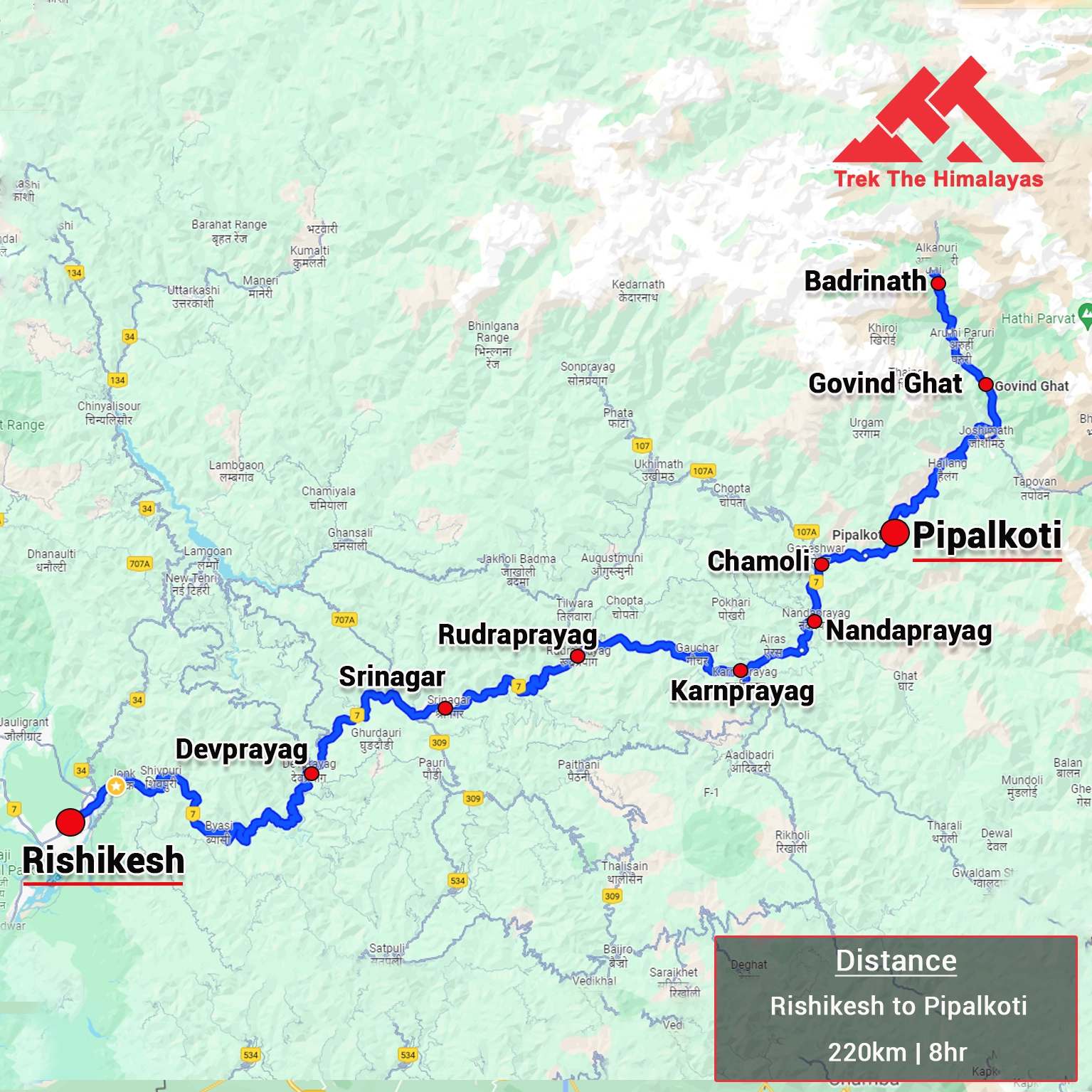
1. Accommodation (as per the itinerary):
- Day 1 and Day 13 Hotel Accommodation in 3 Star Hotel in Kathmandu with Bed & Breakfast.
- Day 2 to Day 12 Accommodation in Teahouse.
2. Meals (Veg + Egg):
- All meals Lukla to Lukla from Day 2 Lunch to Day 13 Breakfast
- Fresh fruit after dinner every day.
3. Support:
- 1 Versatile base camp manager: handles communication and deploys extra manpower in emergencies.
- 1 Mountaineering & First aid qualified professional trek Leader.
- Local experienced guides (Number of guides depending on the group size).
- Enough support staff.
4. Trek equipment:
- Sleeping bag.
- Gaiters & Crampon (if required).
5. First aid:
- Medical kit, Stretcher, Oxygen cylinder, Blood pressure monitor, Oximeter, Stethoscope.
6. Transportation (as per the itinerary):
- Arrival Departure Airport Transfer as per itinerary.
- Domestic airport transfers for Lukla.
- Kathmandu to Ramecchap /Lukla, and back.
7. Mules/porters to carry the central luggage.
8. Clock room facility available at the base camp for additional luggage.
9. All necessary permits and entry fees, Upto the amount charged for Indian.
10. Services from Kathmandu to Kathmandu .
11. TIMS card.
12. EBC Map.
13. Farewell Dinner in Kathmandu.
14. Trek Completion Certificate
15. Complementary Trekking Kit Bag (Duffle bag if opted for Porter facility).
1. Insurance (Mandatory).
2. Food during the transit.
3. Any kind of personal expenses.
4. Mule or porter to carry personal luggage.
5. Emergency evacuation, hospitalization charge or etc.
6. Anything not specifically mentioned under the head Inclusion.
8. Extra Expenses.
- Porters for the personal bag*.
- Wifi, charging batteries and hot showers.
- Customary gratuities for guides & porters.
9. Nepal entry visa (approximately $40 USD, Bring Two Passport Size photos) only for foreigners (Not for Indians).
10. Unforeseen costs due to flight cancellation, weather conditions etc.
11. Extra night accommodation Kathmandu.
Things can be provided on demand and availability (participant has to pay extra for these things).
1- Satellite phone/set phone - is a type of mobile phone that connects via radio links via satellites orbiting the Earth instead of terrestrial cell sites like cellphones. Therefore, they can operate in most geographic locations on the Earth's surface.
2- Gamow/PAC HAPO Bag (Portable Hyperbaric Bag) - is a unique, portable hyperbaric chamber for the treatment of acute mountain sickness (AMS), also known as altitude sickness.
3- AEDs (Automated External Defibrillators) - are portable life-saving devices designed to treat people experiencing sudden cardiac arrest, a medical condition in which the heart stops beating suddenly and unexpectedly.
Special Offer
Make a single payment and trek the number of times you want.
If you book a trek with Trek The Himalayas and cannot complete it, or if you've successfully completed the trek and wish to do it again, you can repeat it multiple times at no additional cost.
Terms and conditions
- This offer is non-transferable.
- This offer is valid for Trek The Himalayas limited fixed departures.
- This offer is valid for 5 years from the date of booking.
- This offer is not valid if the participant has received a cash refund or voucher at the time of cancellation.
- Participants don’t have to pay for the trek cost but have to pay for transportation and trek permit costs.
To reserve a spot for a trek or adventure program, you can either utilize our online booking form or call us at the provided number. For your confirmation, a deposit must be wired, including the initial payment.
Cancellation terms:
Cancellations prior to 25 days from the start of the Trip
Refund options
- 5% deduction of trek fee
- 100% cash voucher for any trip till one year
- Transfer your trek (any trek, any date) to your friend
Cancellation between 24 days and 15 days to the start of the Trip
- 30% deduction of trek fee
- 100% cash voucher for same trip till one year
- 85% cash voucher for any trip till one year
- Transfer your trek (same trek, any date) to your friend
Cancellation between 14 days and 10 days to the start of the Trip
- 50% deduction of trek fee
- 80% cash voucher for same trip till one year
- 70% cash voucher for any trip till one year
- Book the same trek, in the same season, with any other batch
Cancellation less than 9 days to the start of the trek
- No cash refund
- 20% cash voucher for the same trip till one year
- 10% cash voucher for any trip till one year
- Transfer your trek (same trek, same date) to your friend
Note- If a booking is made using a voucher or discount code, the policies related to vouchers and discounts cannot be modified.
In the unlikely event that TTH cancels a trek prior to the scheduled departure date:
While it is extremely rare for TTH to cancel a trek, we understand that unforeseen circumstances or natural disasters may occasionally require us to do so before the scheduled departure. These circumstances could include continuous rain or snow, thunderstorms, snowstorms, landslides, floods, earthquakes, or any other natural calamity that poses a risk to the safety of our trekkers. Additionally, unforeseeable events such as local riots, curfews, pandemics, lockdowns, government orders, or any similar situations that compromise the safety of the trekking experience may also necessitate a cancellation.
In the event of such a cancellation, TTH will provide you with a voucher equivalent to the amount you paid for the trek. This voucher can be redeemed for any of our treks within the next year, allowing you to still enjoy an adventure with us at a later date.
The issuance of a voucher is not applicable in situations where you are required to descend from the trek for any reason. The trek leader may make the decision to send you down from the trek due to factors such as insufficient fitness level, symptoms of Acute Mountain Sickness (AMS), high blood pressure, exceeding the designated turn-around-time, health concerns, or if you are found smoking, drinking, or violating the rules set for the trek. In such cases, the provision of a voucher does not apply.
In the rare event that TTH shifts a trek:
We would like to emphasize that weather conditions in high-altitude areas are highly unpredictable and can undergo sudden changes at any time, irrespective of the day. Additionally, circumstances beyond our control, such as natural disasters, political unrest, pandemics, and lockdowns, may impact the feasibility of conducting a trek. In cases where we are unable to proceed with an event due to such circumstances that are beyond our direct control, we will make every effort to provide you with an alternative trek that is safer and more suitable.
In such situations, we will issue a voucher to offset the cost difference between the originally scheduled trek and the alternative trek. This voucher can be redeemed at any time within one year from the date of issue. Please note that a refund fee or reimbursement of the cost difference is not applicable in these cases.
- Change of trek batch is dependent on the availability of seats in the batch
- In case of transferring a trek to a friend, he/she should satisfy all the mandatory requirements put forward by TTH
- TTH holds the right to change/cancel the policies, without prior notice
- Cash refund is applicable only in case of bookings made without using any promotional offer code or vouchers
Cash Voucher Terms:
- This is a non-transferable voucher
- The voucher cannot be merged with any other offer of Trek The Himalayas
- The voucher is valid for Trek booked directly with Trek The Himalayas in India
- To avail the voucher please use your register phone number or e-mail id
- All the other Terms of booking a trek with Trek The Himalayas are applicable to the voucher
- Trek The Himalayas holds rights to add/remove any of the Terms and Conditions without prior notice
Itineraries are based on information available at the time of planning and are subject to change. "Trek The Himalayas" reserves the right to change expedition dates, people or itineraries as conditions warrant. If a trip must be delayed or the itinerary changed due to bad weather, road conditions, transportation delays, government intervention, airline schedules, sickness, or other contingency for which TTH or its agents cannot make provision, the cost of delays and/or other changes are the responsibility of the participant. TTH reserves the right to decline, or accept, any individual as a trip member for any reason whatsoever.
Trek Essentials
PDF Of Trek Essential Download
Frequently Asked Questions(FAQ)
How to register/create an account with tth.
To register with TTH, visit our website - www.trekthehimalayas.com and create your account. To create your account you will need to use your email address and fill in all the details, set your unique password and your account is ready to use.
How to book a trek?
- To book a trek with TTH, you first need to register with us and create an account.
- Choose the trek that you want to do and click on available dates.
- You will land at the login page, fill in the required details.
- Add Participants, choose add-on services click on the Pay now button, choose your preferred payment method, and make the payment. TTH accepts multiple payment options, including credit/debit cards, net banking, and UPI.
- You will receive a confirmation email from TTH with all the necessary details about the trek, including the meeting point, transportation, accommodation, and other important instructions.
Made a payment but did not receive any confirmation.
please send an email to us at [email protected] or reach out to the numbers provided in the Help and Support section of your Trek Page. We will ensure that your issue is promptly resolved.
How to book off-load luggage and transportation?
To book services such as off-load luggage and transportation, you can find them listed as add-ons. These additional services can be booked at the time of your initial booking. If you miss booking add-ons during the initial reservation, you can log in anytime and easily book 4 days before the departure date add-ons through the platform.
If I have booked the wrong trek or date, how can I make changes?
In such a situation, please log in to your account and transfer your trek or date to the desired one within 12 hours or drop us an email at [email protected] 10 days before the departure date of the trek. After the initial 12-hour period, any changes will be processed according to the cancellation policy.
I am a beginner and confused which trek to book.
We recommend visiting our "Suggest Me a Trek" page. By filling out the form, our experts will contact you with the best possible trek options based on your preferences and experience level. Alternatively, you can reach out to us via email at [email protected] or give us a call using the numbers provided on our website for personalized assistance and recommendations.
How is family trek different from regular trek?
Family treks differ from regular treks by focusing on ease of difficulty, offering shorter durations for younger participants, Kid-friendly and easily digestible foods, child-friendly activities, maintaining a higher guide ratio for diverse age groups, and implementing additional safety measures for families.
Ideal treks for children.
Family Trek with Kids recommendation Only Dayara Bugyal and Chopta Chandrashila Trek.
Minimum age for children to trek with TTH.
Minimum age for TTH treks is typically 7 years, though this may vary depending on the specific trek.
Can we take children to high altitudes with their guardian?
Yes, you can take a kids to a high-altitude trek with a parent. Discuss with a trek expert before booking a trek.
Can we send kids without Parents/guardian?
Medical & Disclaimer Form (Mandatory Documents) Click here to download medical and disclaimer form
How to prepare a child for a high altitude trek?
Physical Fitness: Ensure your child is physically fit. Engage them in regular exercise, outdoor activities, and hikes to build stamina and endurance. Hydration: Emphasize the importance of staying hydrated at high altitudes. Encourage your child to drink water regularly, even if they don't feel thirsty. Proper Nutrition: Provide a well-balanced diet with sufficient carbohydrates for energy and foods rich in iron to prevent altitude sickness. Adequate Sleep: Ensure your child gets enough sleep in the days leading up to the trek. Quality rest is crucial for altitude adaptation. Educate on Altitude Sickness: Teach your child about the symptoms of altitude sickness, such as headache, nausea, and dizziness. Encourage them to communicate any discomfort immediately. Appropriate Clothing and Gear: Dress your child in layers to adjust to changing temperatures. Ensure they have appropriate trekking gear, including sturdy footwear. Positive Mindset: Foster a positive mindset. Encourage your child, and let them know it's okay to take breaks when needed. Medical Check-Up: Schedule a medical check-up before the trek to ensure your child is fit for high-altitude activities. Consult with a healthcare professional about any potential health concerns.
Kind of food will be served during the trek for children.
TTH takes special care to provide wholesome and nutritious food for children on treks. Here are some of the foods that are typically served for children: Breakfast: For breakfast, TTH serves a variety of options like porridge, cornflakes, bread, butter, jam, honey, boiled eggs, omelettes, and pancakes. Children can choose from these options to fuel themselves for the day's trek. Lunch: For lunch, TTH serves lunch which includes rotis, vegetables, rice, dal, and salad. The rotis are usually made fresh on the trek and are a good source of carbohydrates. The dal and vegetables provide protein and other essential nutrients. Snacks: TTH provides healthy snacks like fresh fruits, dry fruits, energy bars, cookies, and biscuits to keep the children energized throughout the day. Dinner: For dinner, TTH serves a hot and wholesome meal which includes soup, rice, dal, vegetables, and a non-vegetarian dish (if requested in advance). Children can also choose from a variety of desserts like custard, jelly, and fruit salad. Dietary requirements: If a child has any special dietary requirements, TTH can cater to those needs as well. For example, if a child is lactose intolerant or allergic to nuts, the kitchen staff can make arrangements to accommodate those requirements.
How to choose the right trek?
Choosing the right trek for a beginner can be a bit overwhelming as there are many factors to consider such as distance, elevation gain, terrain difficulty, weather, and time of year. Here are some tips that can help you choose the right trek for a beginner:
1. Determine fitness level: Assess the fitness level of the beginner to understand their physical capabilities. This will help you select a trek that is challenging but not too difficult.
2. Choose a well-traveled trail: A well-traveled trail will have more amenities such as signposts, water stations, and shelter. It is also safer as there will be other hikers on the trail.
3. Consider the length of the trek: For beginners, it is recommended to start with a shorter trek that can be completed in a day or two. This will help them get acclimatized to trekking and build their confidence.
4. Look for gradual elevation gain: Choose a trek with a gradual elevation gain rather than steep ascents. This will make the trek easier and more enjoyable.
5. Check the weather: Check the weather forecast before selecting a trek. Avoid treks during the monsoon season or winter when the trails can be slippery or dangerous.
6. Research the trail: Read about the trail to get an idea of the terrain, altitude, and difficulty level. This will help you select a trek that is suitable for the beginner.
7. Consult with an expert: If you are unsure about which trek to choose, consult our trek expert Mr. Nitin (+91 70600 59773) between 10 AM to 6 PM (Tuesday - Friday). Mr. Nitin will provide you valuable advice and guidance.
Overall, it is important to choose a trek that is enjoyable, challenging but not too difficult, and suitable for the beginner's fitness level and experience.
Can a beginner choose a tough trek?
It is not recommended for a beginner to choose a difficult Himalayan trek. Trekking in the Himalayas can be physically and mentally challenging, especially if you are not used to the high altitude, steep slopes, and rugged terrain. Choosing a difficult trek without the proper experience, fitness level, and preparation can be dangerous and put you at risk of altitude sickness, injury, and other hazards.
If you are a beginner, it is recommended to start with an easier trek and gradually build up your skills and experience. This will help you understand the challenges of trekking in the Himalayas, and also prepare you physically and mentally for a more difficult trek in the future. It is also important to choose a trek that matches your fitness level, experience, and interest.
What is the age limit for a beginner trekker?
There is no specific age limit for a beginner trekker. However, it is important to consider your physical fitness, health condition, and personal interests before embarking on a trek. Trekking in the Himalayas can be physically and mentally demanding, and requires a certain level of physical fitness and endurance.
If you have any pre-existing medical conditions or are above a certain age, it is recommended to consult with a doctor before embarking on a trek. It is also important to listen to your body and take breaks as needed during the trek to prevent exhaustion or injury.
If I am solo, can I join the trek in a group?
Yes, you can join the trek. We have fixed departure groups where you can simply book your trek and we will take care of curating a group.
How does my family get updated about my Trek?
Before you start the trek, it is recommended that you make all the necessary phone calls as during the trek you may or may not receive network coverage, once you come back to the Base Camp, you can reconnect with your family via phone once again. You can share your trek coordinator contact detail with your family members to get the latest updates about your trek batch.
What food can I expect?
At TTH, we provide wholesome and nutritious meals during the trek. The food is vegetarian and includes a variety of dishes such as rice, dal, vegetables, chapati, paratha, pasta, noodles, and soup. We also offer snacks such as biscuits, and salty, and dry fruits during the trek. Special dietary requirements such as vegan, gluten-free, or Jain food can also be arranged if informed in advance.
I am allergic to some foods.
If you are allergic to some foods, you need to let us know in advance so that we can make arrangements accordingly.
How safe is trekking with TTH?
TTH is a trekking company that prioritizes the safety of all its participants, including women trekkers. They have a comprehensive safety system in place, which includes a dedicated team of experienced and trained trek leaders and support staff who are equipped to handle emergency situations and provide first aid.
TTH also takes specific measures to ensure the safety and comfort of women trekkers. They have a separate tent accommodation for women trekkers, female trek leaders, and support staff. They also provide separate toilet facilities for women and encourage a safe and respectful environment for all trekkers.
Moreover, TTH has a strict policy against any kind of harassment and has a zero-tolerance policy towards such incidents. They have a designated Internal Complaints Committee (ICC) to investigate and address any complaints related to harassment or misconduct. Overall, TTH has a good reputation for safety and responsible trekking practices, and women can feel comfortable and safe while trekking with them.
How TTH will manage if I am the only woman in the group?
In case you are the only women in the group, we provide a single sleeping arrangement. Also, during the trek, the trek leader will always remain by your side to provide optimum safety and reassurance.
How can I know that other women are in the batch?
You can reach out to the trek coordinator to inquire about the number of female trekkers and their respective states who have booked the trek. Please note that the trek coordinator cannot disclose personal details of any trekker. Once you've confirmed your booking, a WhatsApp Group will be created for all the trekkers in your batch. This allows you to connect with fellow trekkers before the trek begins.
Can I know in advance, which trek is led by a women Trek Leader?
While many of our treks are led by female trek leaders, however, it is not possible to know which trek leader is assigned to which group. But nonetheless, whether the trek leader is male or female you can be completely assured of your safety and security with us.
Can I trek with periods? If yes, then where can I dispose of the sanitary pad?
Yes, it is possible to trek with periods. However, it is important to take some extra precautions and preparations to ensure a comfortable and safe trekking experience.
Here are some tips that can help you trek during your period:
1. Use menstrual hygiene products that you are comfortable with, such as tampons, pads, or menstrual cups. It is recommended to carry enough supplies for the entire duration of the trek.
2. Pack wet wipes, hand sanitizer, and plastic bags to dispose of used hygiene products.
3. Wear comfortable and breathable clothing that allows for easy movement and reduces friction. Avoid wearing tight or restrictive clothing that can cause discomfort.
4. Carry pain relief medication, such as ibuprofen or acetaminophen, in case of menstrual cramps.
5. Stay hydrated and maintain a balanced diet to support your energy levels and overall health.
6. Take breaks as needed and listen to your body. If you feel uncomfortable or experience any unusual symptoms, seek medical attention immediately.
It is also recommended to consult with a doctor before going on a trek during your period, especially if you have a pre-existing medical condition or are taking medication. By taking necessary precautions and being prepared, you can have a safe and comfortable trekking experience even during your period.
We provide proper disposal facilities for sanitary pad disposal during the trek.
How will the accommodation be during the trek?
We offer three person tents with twin-sharing for optimum comfort. A woman trekker will share a tent with another woman trekker and if you are the only woman in the group, you will be given a single accommodation for your comfort and privacy.
Are trek poles, Jackets and other equipment available for rent from Trek The Himalayas?
Yes, we do provide gears on rent. You can book it using you TTH account directly.
Who will be with us on the trek from Trek The Himalayas?
Mountaineering qualified Experienced and first aid certified Trek Leader, First Aid Certify local guide, Cook, helpers and supporting staff.
Who can not join the trek?
People suffering from Bronchitis, Asthma, High blood pressure, Epilepsy (got faints), TB , Heart problem or on higher BMI side are strictly not allowed to go on any Himalayan trek. Apart from this if you had any medical history, please let us know.
When it gets really cold can I consume alcohol?
No. Alcohol and smocking isn’t allowed while on trek. It is totally misconception that it will keep you warm. Your body need to acclimatize properly and for that eat properly and drink enough water; these things will keep you warm.
What type of toilet facility is TTH providing at the trek?
Toilet tents provide a convenient solution for answering nature's call in the great outdoors. Dry toilets, in particular, offer a highly sanitary approach. By digging a pit and utilizing mud and a shovel, you can easily cover up your waste. This method ensures cleanliness and hygiene while camping or exploring in the forest.
Remember to pack essential toiletries to complete your outdoor bathroom kit and maintain proper personal hygiene during your adventures. With these practices in place, you can enjoy nature while also respecting it.
How do I manage the negative temperatures on the trek at higher camps? Do I need special jackets?
Layer Up From Head To Toe Eat Full Meals, never sleep empty stomach You can keep warmee (if you’re more susceptible to cold). Use sleeping bag in right way and don’t leave free space in sleeping bag.
For upper body – Thermal layer – T-shirt (full-sleeves) – Fleece T-shirt (for extreme colds) – Fleece layer – Thick Jacket/Down Jacket – Waterproof or Windproof layer (outermost layer, when it is snowing or raining) - For Lower Body – Thermal layer – Hiking pants (normal) or Winter hiking pants
Based on how warm you feel you can skip any of the above layers. Your outer later should be windproof since it is windy at high altitude. The idea behind layering is that the more insulation you have the less cold you feel, and instead of wearing a very thick jacket if you wear multiple layers, your body will be better insulated against the cold.
Do you provide crampon/micro spikes and gaiters?
Yes, we provide micro spikes and gaiters, if required.
What documents need to carry on trek?
Mandatory documents: 2 xerox of ID having address (addhar card/driving license), 2 Passport size photographs, hard copy Medical form signed & sealed by doctor, disclaimer form sign by trekker and high altitude insurance.
If we come prior the trek date, Do you provide accommodation?
No. We don’t but we can suggest you good hotel/Stay nearby pick up location.
Do we get enough water for drinking?
Yes, trekker must carry 2 water bottles 1 litre each so they can refill it at campsite for drinking and keep themselves hydrate.
What kind of shoes we should buy for the trek?
You should buy shoes which has these three features –Good grip, Ankle Support and additional water resistant layers. Generally, we advise Quechua Trek 100, MH 500 and MH 100.
How do we get back after the trek?
Your return transport is also included in trek fee if you're opting for service Dehradun to Dehradun ; we use Tempo Traveller/ Tata Sumo/Max/Boloero kind of vehicle.
What happens if some members of the team need to turn back before the summit?
No one is forced to go on. There is always enough staff to split the party according to need and regroup later at the camp. Most people have no trouble reaching the highest campsite. If some members decide not to climb the final distance they can wait for the climbers to come back down the same way or take a lateral path to the descent route.
What kind of help is available in case of emergency?
We always have a first aid kit close at hand. Serious injuries are rare. Porters will assist injured climbers to the base of the mountain and onward to a clinic or hospital. Kilimanjaro International Airport is very near Marangu Gate if evacuation to the US or Europe is advisable.
Where is Everest Base Camp located?
Everest Base Camp is located in the Khumbu region of Nepal, at an altitude of approximately 18,200 ft above sea level.
What is the altitude of Everest Base Camp?
The altitude of Everest Base Camp is approximately 18,200 ft above sea level.
How do I get to Everest Base Camp?
To get to Everest Base Camp , you need to first fly to Lukla from Kathmandu and then trek for around 8-12 days through the Khumbu region of Nepal.
Do I need a permit to trek to Everest Base Camp?
Yes, you need to obtain a Sagarmatha National Park Permit and a TIMS (Trekkers' Information Management System) card to trek to Everest Base Camp.
How long does it take to trek to Everest Base Camp?
It takes 13 days to complete Everest Base Camp, depending on your fitness level and the route you take.
What is the best time to trek to Everest Base Camp?
The best time to trek to Everest Base Camp is during the spring (March-May) and autumn (September-November) seasons when the weather is dry and stable.
What is the weather like at Everest Base Camp?
The weather at Everest Base Camp can be unpredictable and harsh, with temperatures ranging from -20°C to 15°C (-4°F to 59°F) and strong winds.
What type of accommodations are available at Everest Base Camp?
There are teahouses and lodges available at Everest Base Camp that offer basic accommodations and food.
What kind of food is available at Everest Base Camp?
The food at Everest Base Camp mostly consists of Nepali and Tibetan cuisine, including dal bhat (rice and lentils), momos (dumplings), and noodle soup.
Is it safe to trek to Everest Base Camp?
Trekking to Everest Base Camp can be challenging and there are risks associated with high-altitude trekking, but with proper preparation and guidance from experienced guides, it can be a safe and rewarding experience.
What are the risks associated with trekking to Everest Base Camp?
The risks associated with trekking to Everest Base Camp include altitude sickness, hypothermia, falls, and avalanches.
Do I need any special gear to trek to Everest Base Camp?
Yes, you need to bring proper trekking gear, including warm clothing, trekking boots, a sleeping bag, and a backpack.
What physical fitness level is required for trekking to Everest Base Camp?
Trekking to Everest Base Camp requires a moderate to high level of physical fitness, as you will be trekking 8 for several days at a high altitude.
What are some other popular trekking destinations near Everest Base Camp?
Other popular trekking destinations near Everest Base Camp include Gokyo Lakes, Cho La Pass, and Island Peak.
- Date and Price
Rent A Gear
Trek Articles
Quick Links
Trekking & Hiking
Mountaineering
Multi Sports
Himalayan Pilgrimage
Website Privacy
Terms & Condition
Contact Info
Get in touch with us. E-mail us Monday-Saturday (10 AM to 6 PM)
Address: Trek The Himalayas, Kaintura Plaza, Badrinath Road Tapovan, Rishikesh - 249201 Uttarakhand
Phone: 8191004846
Email: [email protected]
2010 Trek The Himalayas. All rights reserved
Pristine Nepal Treks
Explore, Trek, and Experience Nepal's Best

Everest Base Camp Trek
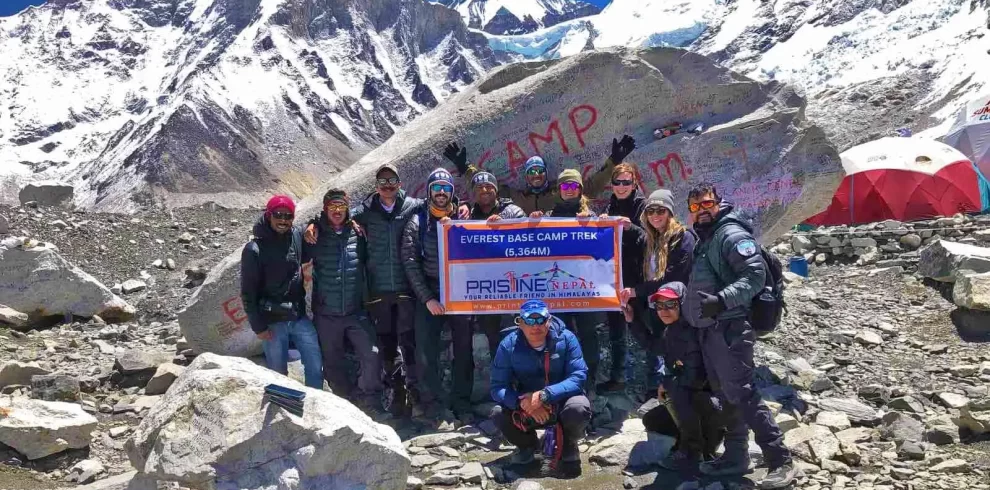
Enjoy the 14 Days Everest Base Camp Trek across the Khumbu Region surrounded by stunning Himalayas and cultures. This EBC itinerary is designed for all levels of trekkers to meet their expectations in the journey.
The EBC classic trek retraces the footsteps of legends — Sir Edmund Hillary , Tenzing Norgay , and the intrepid pioneers who first dared to conquer Mount Everest. Every step you take echoes with the spirit of those who forged the path before you.
As you traverse this iconic trail, you’ll witness the breathtaking panorama of Mount Pumori, Mount Lhotse, Mount Nuptse, and Mount Lobuche , a visual symphony that defies description.
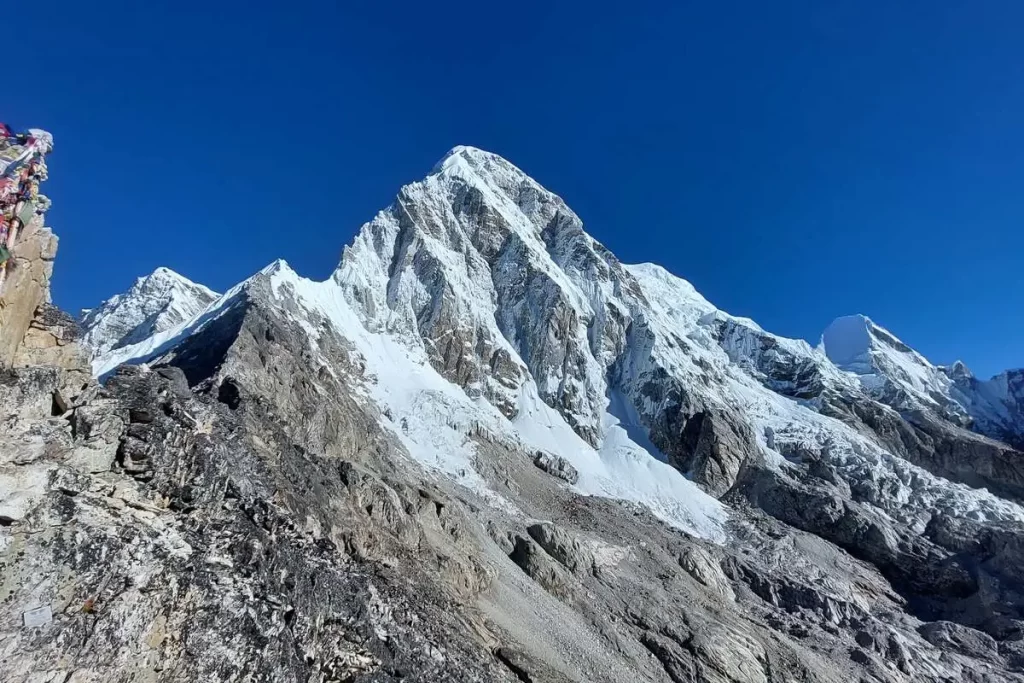
- Difficulty Slightly Challenging
- Best Time Spring (March to May) & Autumn (Sep-Nov)
- Max Altitude EBC (5,364m) & Kalapatthar (5,545m)
- Duration 14 Days Total (12 Days Trek)
- Transportation Turboprop Plane (Lukla Flight) - 2 Way
- Meals Full Board Meals (BLD)
Here, you will discover the Everest Base Camp package accommodations, planning, important preparations, services, and all other information you may need to know. So, let’s get started.
Trip Overview
Cost details, packing list, about ebc trek, everest base camp trek highlights:.
- Flight to one of the most beautiful airports in the world, Tenzing Hillary Airport – Lukla.
- Visit the oldest and biggest trading hub of the Khumbu Region, Namche Bazar
- Cross lots of popular suspension bridges including the Hillary Bridge.
- Trek through the Sagarmatha National Park one of the UNESCO World Heritage Sites.
- Get a dramatic view from one of the popular Everest viewpoint hotels.
- Follow the footsteps of Tenzing Norgay & Sir Edmund Hillary to Everest Base Camp
- Hike to Kalapathar for a panoramic view of the highest mountains; Mount Everest (8,849m), Lhotse (8,516m), Pumori (7,169m), Ama Dablam (6,812m), Nuptse (7861m), and Cholatse (6,440m)
- Experience the warm welcoming Sherpa culture and watch their daily lifestyles.
- Visit the oldest Tengboche Monastery in Khumbu Region
- Package of beautiful flora & fauna with stunning Khumbu Glacier & Icefalls.
14 Days Everest Base Camp Trek Outline Itinerary
Here is what your 14 Days of Everest Base Camp trek will look like:
- Day 01: Arrival at Kathmandu Tribhuvan International Airport and transfer to Hotel via private vehicle
- Day 02: Flight to Lukla from Kathmandu or Ramechhap and trek to Phakding – 3hrs ( During peak season, the Lukla flight will be processed from Ramechhap – Manthali Airport )
- Day 03: 6 hrs Trek to Namche Bazar from Phakding ( Walk inside Sagarmatha National Park and cross the first suspension bridge )
- Day 04: Acclimatization Day at Namche & Hiking Activity to Syangboche (Hike to Char Camp & visit Syangboche)
- Day 05: Trek to Deboche via Tyangboche (Visit the oldest Monastery in Tyangboche)
- Day 06: Trek Dingboche from Tyangboche (Best Ama Dablam View from Dingboche Stupa)
- Day 07: Acclimatization Day at Dingboche (Hike to Nangkartshang peak 5,121m)
- Day 08: Dingboche to Lobuche trek
- Day 09: Trek to Everest Base Camp via Gorakshep and back to Gorakshep again
- Day 10: Hike to Kalapathar for sunrise view & Back to Gorakshep for lunch & again trek down to Pheriche
- Day 11: Trek Back to Namche Bazar
- Day 12: Head back to Lukla from Namche
- Day 13: Fly Back to Ramechhap or Kathamndu & Back to Hotel
- Day 14: Departure from Kathmandu
A detailed itinerary is described at the end of the package. Similarly, people also join EBC with Cho La Pass & Gokyo Lake trek for more adventure.
So, these are the minimum requirement days for trekkers that we always recommend when trekking at Everest Base Camp. prior to this, if you want an extra day, then it can be arranged for additional acclimatization.
Why Choose Pristine Nepal Treks for your Everest Base Camp Trek?
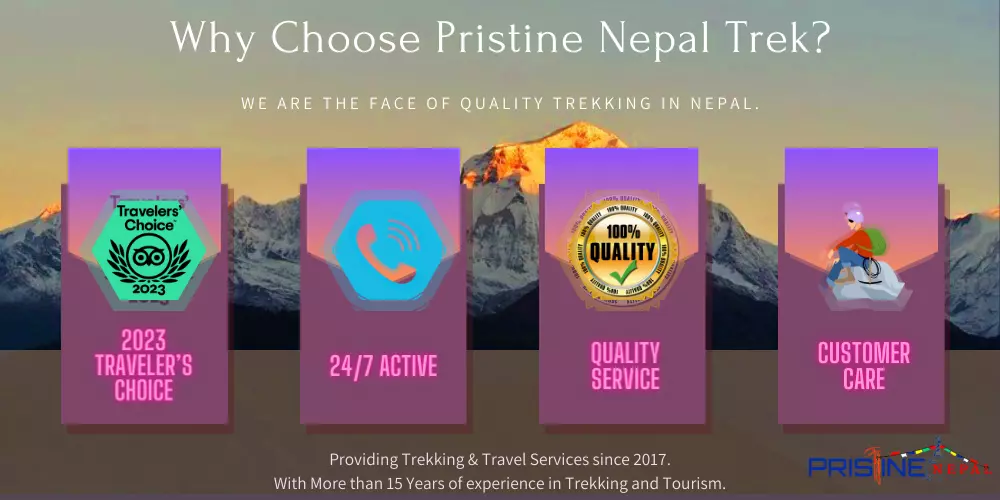
- At Pristine Nepal Trek, w e are committed to delivering top-notch services that exceed expectations. Our meticulous attention to detail ensures that every aspect of your trek, from accommodation to transportation, is of the highest quality.
- Our 24/7 active support ensures that you are never alone in your journey. Whether it’s a query, concern, or simply sharing a breathtaking moment, we are here for you every step of the way.
- Your journey is unique, and we understand that. Pristine Nepal Trek goes beyond the ordinary by customizing every aspect of your trek based on your preferences. We manage each and everything upon request , ensuring a personalized adventure that aligns perfectly with your dreams.
- Recognized by fellow travelers on TripAdvisor, our commitment to excellence is endorsed by the prestigious 2023 Travelers’ Choice award.
- More than just a trekking company, Pristine Nepal Trek is a family. Rooted in familial values, our company provides a warm and welcoming environment, where every traveler is treated not just as a client but as a cherished member of our extended family.
Fixed Departure Dates
Year: Select 2024 2025
Months: Select January February March April May June July August September October November December
Lukla Flight Dates: Choose a month first
Your Message:
Service Included
- Airport Pick-Up and Drops (4 Airport Transfers: 2 for Domestic & 2 for International Airport)
- 2-Night Stay in Kathmandu (Thamel city area) Hotel with Breakfast service on the basis of Twin Sharing
- From March, April, May & October, November; Ramechhap-Lukla-Ramechhap 2-way Flight Ticket & Airport Transportation
- From June to September & December to February; Kathmandu-Lukla-Kathmandu 2-way Flight Ticket & Airport Transportation
- Upto 10 kg Luggage & 5 kg hand carry per person free during Domestic flight
- Licensed and experienced Trekking Guides including their Salary, Lukla Flight cost, food, equipment & insurance
- Porter for the Trek including their Salary, food, & insurance with weight restriction up to 20kg only (One porter for two trekkers)
- Tea House & Lodge Accommodation During Trekking | 5 nights in the attached bathroom with Hot Shower facility (Phakding-1N, Namche-3N, Lukla-1N) and 6 nights in the basic room on the basis of twin sharing.
- Full Board Meals During Trekking (BLD)
- 3 Cups of Tea or Coffee per day during the trek
- Seasonal Fruits after Dinner per day during the trek
- Water Purifier and hydration tablets
- Permits for Trekking: Sagarmatha National Park Permit, Khumbu Rural Municipality Entrance Fee, & Trek Card
- Light Medical Treatments including a Medical Kit Box carried by a Trained Trekking Guide
- Pristine Nepal Trek Duffle-Bag to keep your belongings for trekking
- Pristine Nepal Trek Breathable T-Shirt as a souvenir best for trekking
- All tax, paperwork, or document charges required for trekking
- Free Coordination in Emergency Cases such as Helicopter Evacuation as per your Travel Insurance
- Nepal Visa Fee or Renewal Charges
- Ramechhap Accommodation and Meals
- Travel Insurance or Trekking Insurance with Helicopter Evacuation
- Personal Tips for Guide and Poter or any other staff
- Personal Expenses such as laundry charges, drinks & beverages, desserts or snacks, or hot shower that is not included in the above inclusion
- Extra Night stay in case of early return from trekking in Kathmandu
- Additional Days during the trek, accommodation, or any services
Everest Base Camp Detail Itinerary
We will meet you at Tribhuvan International Airport . Unless you have obtained a visa prior to your arrival in Nepal, you will need to g et a visa-on-arrival in the immigration department of the airport. Sometimes, this process may take 30 minutes to even 1 & half hours. Outside, we will be waiting for you with your name on the Pristine Nepal Treks name board.
We will then drive the 7 km to Thamel (30 minutes) to your hotel where you will meet your trekking guide. We will brief you regarding your Everest Base Camp trek and if you need any trekking gear, we will help to arrange it. If you need a sleeping bag and a down jacket then you can rent one and we can recommend you a good shop for it.
As you already know, we confirm a trip once you have paid a deposit of 20-30% through our online system. The remaining balance is recommended to be paid in cash. The reason to accept cash payment as full payment is that our bank takes 3.5% interest in online payments.
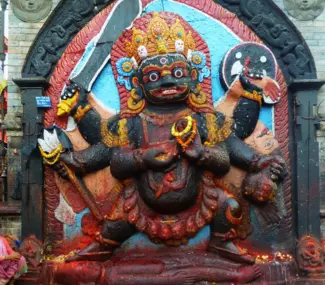
There are sufficient flights to Lukla with domestic airlines for the Everest base camp trek, but most airlines operate their flights from Ramechhap during the busy season. The reason behind this is that Kathmandu has only one airport with a single runway where both international and domestic airlines operate flights. This makes it harder to operate both domestic and international flights at the same time.
Kathmandu to Ramechhap Distance: 142 km (88.2 miles) Operating Time: March, April, May, September, October & November Manthali Airport Altitude: 474 m (1,555.1 ft)
It is a 4 to 5-hour drive to Ramechhap from Kathmandu and the domestic airlines fly to Lukla early in the morning, because Lukla weather is comparatively better in the morning. You need to be in Ramechhap before 7 am so we will need to depart from Kathmandu around 2 am.
About Kathmandu to Lukla Flight
From Lukla, it is a 30-minute flight from Kathmandu so it should take 90 minutes for the round trip. Sometimes during the bad weather, it may take more than two and a half hours. This is why all the domestic flights operate from Ramechhap to Lukla during the busy season.
Operating Time: January, February, June, July, August, & December Operate From: Tribhuvan Internation Airport (Domestic Flight Area)
Lukla to Phakding Trek
Lukla to Phakding Distance: 7.8km/4.8miles Duration: 2-3 hours Difficulty Level: Easy Phakding Altitude: 2,660m (8,727 ft)
Once you reach Lukla you will meet our porter, have breakfast, and prepare for the day in Phakding. There is a Pasang Lhamu municipality check post at Lukla where we need to buy a local permit for the EBC trek. You will see the Pasang Lhamu statue on top of the exit before you leave Lukla. Pasang Lhamu Sherpa was the first woman from Nepal who summit Mount Everest on 22 April 1993.
The trekking trail leads you slowly down to Chaurikharka, Chheplung, one of the popular Sherpa villages. After this, you will follow the old trekking trail to Thadokoshi village , Ghat, Chhuthawa, and Phakding, and you will experience the Nepal suspension bridge. There will be short downhill and short uphill stretches, but most of the time trail continues at a similar altitude. Villages are not very big in this area and most of the local people are involved in tourism. You will see hydro project pipelines on the way that provide locals with electricity.
You will follow this EBC trail along the Dudhkoshi riverside. After walking for approximately four hours you will reach Phakding, a tourist-oriented village, at 2,660m/8727.03 ft . There are about 20 lodges, guest houses, hotels, and restaurants, and almost all the trekkers stop at Phakding for the first night.
Trek Highlight:
- First View of Kusum Khangkaru mountain from Thado Koshigaon
- Enchanting Painted Mani Stones
- Beautiful Prayer Wheels
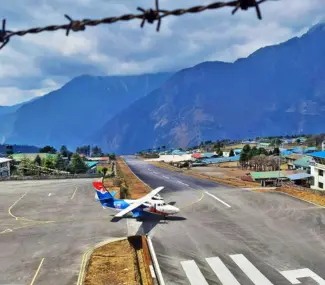
Phakding to Namche Distance : 10.7 km (6.64 miles) Trek Difficulty: Challenging Duration: 5-6 Hours
After having a wonderful night at Phakding, the second day of the Everest base camp trek will start after a delicious breakfast. Today you trek to the famous Namche Bazar 3,440m/11,286.09 ft . Namche Bazar is called the gateway of Mount Everest. All trekkers and climbers have to come through Namche Bazar to go to Mount Everest.
You should cross the suspension bridge in Phakding which brings you to the other side of the Dudhkoshi River, and you have to follow this beautiful Dudhkoshi River all the time in this Everest trek. You will cross at least five suspension bridges before Namche Bazar . Passing through Tok Tok village, Bangker, Monjo, and Jorsalle will be a fantastic walk in the afternoon. We have to buy a national park entrance permit at the Sagarmatha National Park check post at Monjo. After Monjo, as soon as you cross the river you will stop at Jorsalle for lunch.
After lunch, you will again cross the river and then you will have a steep uphill climb. Approximately one-hour walking will bring you to Larja Dovan where you will see the famous Hillary Bridge with colorful Buddhist prayer flags. Then you need to trek uphill for two hours to Namche Bazar.
- First glimpse of Mount Everest after crossing Larja Bridge
- Enter Sagarmatha National Park
- First View of Kongde Ri
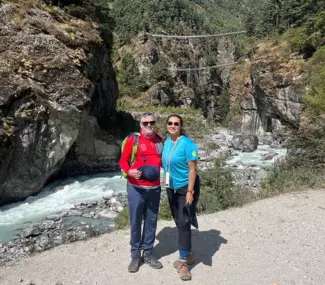
Namche to Everest View Hotel: 2.5km (1.5 miles) Duration: 2 Hours round trip Hiking Difficulty: Easy
It is very important to have an acclimatization day here. Namche Bazar is located at an elevation of 3,440m/11,286.09 ft above sea level and you are trekking to EBC which is 5,364m. You need to stop at many places over 4,000m before EBC. There is always the possibility of altitude sickness after 3,000m. It is advisable to walk slowly and stay at a place for two nights to avoid altitude sickness.
We suggest you hike even though this is the rest day in the Everest base camp trek.
Normally, our guide will take you to Char camp which is on top of the Namche Bazar where you can see beautiful mountain views including Mount Everest. You will witness the statue of late Sherpa mountaineer Tenzing Norgay and a view of Mount Everest 8,848m, Lhotse 8,516m, Ama Dablam 6,838m, Thamserku 6,608m, Kusum Kangaru Himal 6,367m, Kongde Himal 6,187m, Khumbila, Tawache 6,495m, Nuptse 7,861m and many other high peaks from Char camp.
Go further up to Syangboche 3,800m . It is a steep uphill climb but not too long. Syangboche is famous for two things: its airport which is the highest airport in Nepal, built at an elevation of 3,780m above sea level; and the Everest View Hotel, which is said to be the highest hotel in the world. Enjoy the view of Mount Everest with a hot drink , then go back to Namche Bazar.
Namche Bazar is popular for its market on the weekend , and on Saturdays, people from different villages come to Namche Bazar to shop and farmers bring their products to sell. As well as the market, this place offers many trekking and climbing gear shops , banks, restaurants, hotels and lodges, a health post, a security post, a military base, a Sagarmatha pollution control committee, a small departmental store, a sauna bath center, massage center, etc.
- Visit Tenzing Norgay Sherpa Musueum
- Everest View Hotel & view of Mount Everest, Ama Dablam & other peaks
- Visit Sagarmatha Nest for handmade recycled products, arts, and others
- You can do Yoga
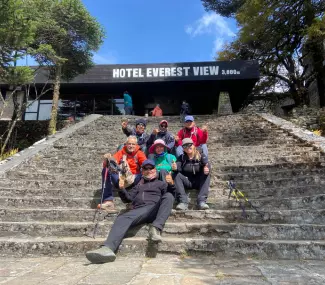
Namche To Deboche Distance: Approximately 11 km (6.8 miles) Duration: 5-6 hours Trek Difficulty: Very Hard Tengboche Altitude: 3,860m (12,664 ft) Namche to Phungi Thanga for Lunch: 4km (2.4 miles) & takes 2-3 hours
After stopping at Namche Bazar for two nights, your EBC trek starts again from here to Tyangboche . The first part of the trail is so smooth and nice with a beautiful Everest view. The path is wide and clean through a constant elevation. You will have a panoramic Lukla Valley view in the south and a gorgeous view to the northeast . Two hours of pleasant walking will bring you to Lausasa where two trekking routes diverge. The north uphill trail goes to Gokyo Lake Valley and the east downhill trail takes you to Tyangboche.
You need to hike approximately one hour downhill to Phungi Thanga where we stop for lunch. You will cross another suspension bridge, then you will climb uphill to Tyangboche for approximately two hours . Tyangboche is an important place in the Khumbu region. It has the oldest monastery and it is the center of the religious faith of the Buddhist Sherpa people.
You need to hike approximately one hour downhill to Phungi Thanga where we stop for lunch . You will cross another suspension bridge, then you will climb uphill to Tyangboche for approximately two hours. Tyangboche is an important place in the Khumbu region. It has the oldest monastery and it is the center of the religious faith of the Buddhist Sherpa people.
Monks live in this monastery and they perform puja every day, in the morning and afternoon. You can go here and get a blessing from a monk. Tyangboche has just five lodges and is very busy in the high season. If you walk half an hour further down, Deboche offers some nice accommodation and we will stop here overnight
- Visit Tengboche Monastery & get the blessing of Monk
- First astounding view of Everest, Lhotse, Ama Dablam & other peaks
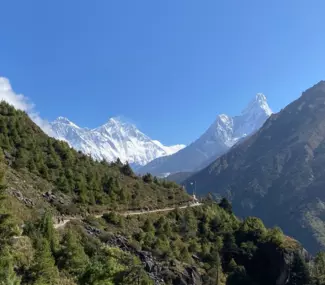
Deboche to Dingboche Distance: Approximately 10 km (6.2 miles) Trek Difficulty: Moderate
Today you will trek to Dingboche which is over 4,400m/14,435.7 ft. After a delicious breakfast at Deboche, you will commence your hike along a beautiful horizontal path through the rhododendron forest to the Dudhkoshi River. Then you trek uphill to the famous Sherpa village, Pangboche at 4,000m/13,123.36 . This village has produced many Sherpa mountain climbers. The tree line is only present in north-facing areas. Pangboche and Somare face south and do not have a tree line at this 4,000m altitude.
After this village, you will travel along the horizontal path for half an hour and then uphill to Somare where you will have an hour-long lunch break. The path is horizontal to Dingboche but the elevation gradually starts to increase. It takes about two and a half hours to reach Dingboche at 4,450m. This comparatively large village is the last in this area and you will spend two nights here.
- Beautiful Pangboche Village also known as one of the biggest settlements in the Khumbu Region
- Walk beside Imja River
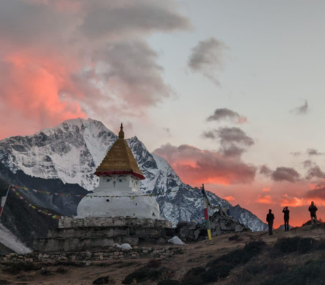
Dingboche to Nangkartshang Peak Distance: Approximately 2 km (1.2 miles) uphill Nangkartshang Peak Altitude: 5,121m (16,801.18 ft) Hiking Difficulty: Hard Duration : 4-5 hour round trip
Trekking to EBC is always challenging due to its high altitude. Many trekkers suffer from altitude sickness in this region . It is not only due to the high elevation: weather conditions also play a major role in altitude sickness . Going slowly and taking acclimatization days at these places will be very helpful in adapting to the environment. Your body will adapt and you will be more likely to make it to Everest base camp.
Hiking to Nangkartshang Peak 5,121m/16,801.18 ft will be very helpful on this day. It is a steep uphill climb from Dingboche and takes 2 hours and 30 minutes. This peak offers beautiful Mount Makalu 8,463m views including Ama Dablam, Lhotse, Island Peak, Kangtega, Thamserku, Tawache, Cholatse, Nuptse, and many other high mountains.
You should then return to Dingboche before lunch and rest for the day. Going up and stopping at a lower elevation is perfect for acclimatization. Even if you are very careful you can experience altitude problems at this elevation. You must tell your guide if you have a problem. Usually, it will be fine after spending two nights here.
- Hike to Nangkartshang Peak for an amazing 360° view of the Himalayas
- Explore the village area and taste bakery items in Dingboche
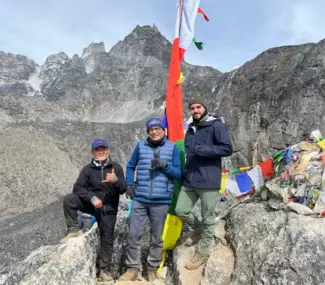
Dingboche to Lobuche Distance: Approx 6 km (3.7 miles) Trek Difficulty: Very Hard Duration: 5-6 Hours
After having two nights at Dingboche you will continue to Lobuche today. The first part of the trail is a gradual uphill trek for 20 minutes . Then you follow a smooth gradual horizontal path heading to Thukla for 2-3 hours. You should cross Small River before Thukla 4,600m. This river comes from the Khumbu glacier and due to the fast melting of the glacier, it always changes its path. Sometimes in summer, it is also very wide. There is no fixed bridge. Local people fix the bridge but it is not stable.
You will stop at Thukla (also called Dukla) at 4,600m (15091.86 ft) for lunch. There are only two lodges and one tea shop therefore it becomes very busy in the high season as most trekkers stop here for lunch.
You need to hike uphill after lunch at Thukla. This part is one of the famous uphills of the EBC trek. It is not that long but trekking here in the afternoon will be difficult and challenging, but also interesting. Approximately one hour of climbing brings you to the top of the mountain where you can witness a popular mountaineer’s memorial, where it is always windy and chilly. Then you need to trek another one and a half hours to reach Lobuche.
Normally, the trail is fine here except for during winter. It is a horizontal path but a lot of snow makes it challenging in winter . Lobuche is a tourist-stopping center before Gorakshep and Everest base camp . There are only 6-7 lodges, all of similar categories. Due to its high altitude, many trekkers complain about sleeping here and many trekkers suffer from headaches. A mild headache is acceptable but you have to be very careful if the headache worsens, and you should be fine after having a rest.
Meals here are not that tasty and both Lobuche and Gorakshep both places do not have a variety of food because bringing food here is a huge challenge. Most trekkers have little sleep at this altitude.
Our team always carries an oximeter during trekking. You can measure the proportion of oxygenated hemoglobin in the blood of your body. It will help to monitor how your body reacts to this altitude.
- First view of Mount Pumori
- Visit Everest Memorial & pay tribute to the brave souls
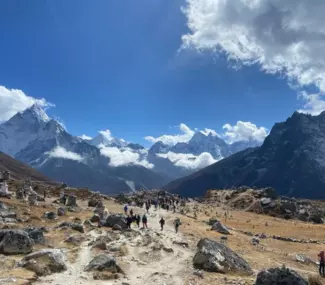
Lobuche to Gorakshep Distance (Lunch Stop): 4.5 km (2.7 miles) Lobuche to Gorakshep Duration: 3 Hours Gorakshep to Everest Base Camp Distance: 4.1 km (2.5 miles) Gorakshep to EBC: 2-3 hours
Today is your Everest base camp day. You need to get up early, have a warm breakfast, and start your day around 5 am . The first hour of walking will be easy even though this is high-altitude. You will have a gradual horizontal path in the first section. After walking for approximately an hour you should have a steep 20-minute uphill climb to Lobuche Pass 5,110m.
Then the path is formed by melting glaciers so it is unstable in every season. It is about a two-hour walk to Gorakshep but the views are incredible here. Once you reach Gorakshep 5,180m you can take a break for some food.
After stopping for a while you will continue to Everest base camp. It is only one and a half hours to base camp from Gorakshep. If you feel very tired, go slowly and take your time. The trail to base camp from Gorakshep is moderate but is also formed by melting glaciers. Everest base camp is also very unstable due to ice melting. Unfortunately, global warming is causing the glacier to melt very quickly. The base camp, where all expedition teams pitch their tents, is located just before the Khumbu icefall area.
Once you reach Everest base camp, we congratulate you. Everest base camp is not only a mountain base camp it is the highest mountain base camp . It is a dream destination for all adventure lovers, all nature lovers, and all mountain lovers. Everest base camp is located over 5,364m above sea level. This is the highest base camp of the highest peak. It is called that you are not a real adventurer if you have not been to Everest base camp.
So take pictures, celebrate your achievement, and enjoy the moment of Everest base camp. After an unforgettable time at Everest base camp, you will go back to Gorakshep for an overnight sleep.
- Visit the Everest Base Camp and capture the moment
- The last settlement of the Khumbu Region
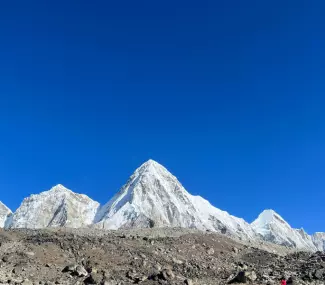
Gorakshep to Kalapattthar Distance: Approximately 1.5 km (0.9 miles) Duration to Reach Kalapatthar: 2 hours Gorakshep to Pheriche: Approximately 12 km (7.4 miles) Trek Difficulty: Hard
This day is also an important day on this Everest base camp trek. You cannot see Mt Everest from base camp so you need to hike up to Kalapathar 5,545m (18192.26 ft) to see the view of Everest. Sunset from Kalapathar is the best for the Everest view. Most people cannot hike to Kalapathar in the evening after a long day of trekking to base camp. You need to hike around 90 minutes to Kalapathar from Gorakshep so it is advisable to start from Gorakshep before sunrise.
After seeing the view from Kalapathar, go back to the hotel for breakfast then walk down to Pheriche.
You will follow the same trail you trekked Lobuche and Thukla. After Thukla 4,600m, (you need to cross the River) you take the left trail instead of going right to Dingboche. Pheriche is another Sherpa village situated at an elevation of 4,200m above sea level . There is a hospital here that is very popular among the high-altitude trekkers.
All Nepalese guides and porters receive free treatment in this hospital, but tourists need to pay a high fee. This hospital opens only in the busy season. You will see yaks here most of the time in the year. You will have a pleasant sleep here after the nights over 5,000m.
- Hike to Kalapatthar 5,545m, the highest elevation in the package
- 360° view of astounding mountains from Kalapatthar
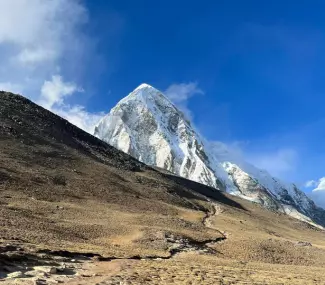
Pheriche to Namche Distance: 19.8 km (12.3 miles) Duration: 6-7 hours Trek Difficulty: Challenging
After stopping overnight at Pheriche, today you will have a long day at Namche Bazar. You need to cross Pheriche pass 4,470m in the first section for less than half an hour. Then trek down to Orsho 4,190, Somare 4,010m, and Pangboche village. It will be a constant gradual downhill trek. You will continue to walk down and cross Imja Khola (River) then reach Milingo 3,750m, passing through Deboche and reaching Tyangboche 3,860 is uphill a little. Then it will straight downhill to Phungi Thanga 3,250m from Tyangboche for an hour’s walk.
Normally, Phungi Thanga will be a lunch stop and then you will trek uphill to Lausasa for an hour. The trail will now be a gradual horizontal path to Namche Bazar for a two-hour walk. You will have a lovely room with a private bathroom at Namche Bazar and you will enjoy having a hot shower.
Namche to Lukla Distance: 18.5 km (11.4 miles) Duration: 6-7 Hours Trek Difficulty: Very Hard
Today is the last day of walking on the Everest base camp trek . After a delicious breakfast, you will follow the same trail you hiked up. The first section of the day will be downhill, past the popular Hillary Bridge with colorful Buddhist prayer flags at Larja Dovan and Jorsalle. You will check out from the Sagarmatha National Park at Monjo, then follow the Dudhkoshoi River through Bangker, TokTok, and Zam Fute, and stop for lunch at Phakding.
It will be a long day walking through Chhuthawa, Nurning, Ghat, Thado Koshigaun, Chheplung, Chaurikharka, and Lukla . The night in Lukla will be the last night on the mountain of Everest base camp trek. Your porter will finish their hard-working job here at Lukla, so don’t forget to celebrate and don’t forget to tip them.
After having an incredible time on the Everest base camp trek, today you will fly back to Kathmandu.
Lukla flights are operated only from Ramechhap in the high season due to the high air traffic of Kathmandu airport, so we will most probably fly to Ramechhap from Lukla. It is only a 15-minute flight to Ramechhap. Then we will have 5 hours drive to Kathmandu.
We will take you to your hotel and the afternoon will be free. We are pleased to offer a farewell dinner at a reputable traditional Nepali restaurant in the evening.
Finally, we will drop you at the airport according to your flight schedule. We hope you will always retain fond memories of Nepal and your Everest Base Camp trek and will recommend Nepal and Everest base camp to your friends.
Have a wonderful journey ahead.
Thank you so much.
Essential Gears & Equipment for EBC Trek
Important preparation needed for everest base camp trek:.
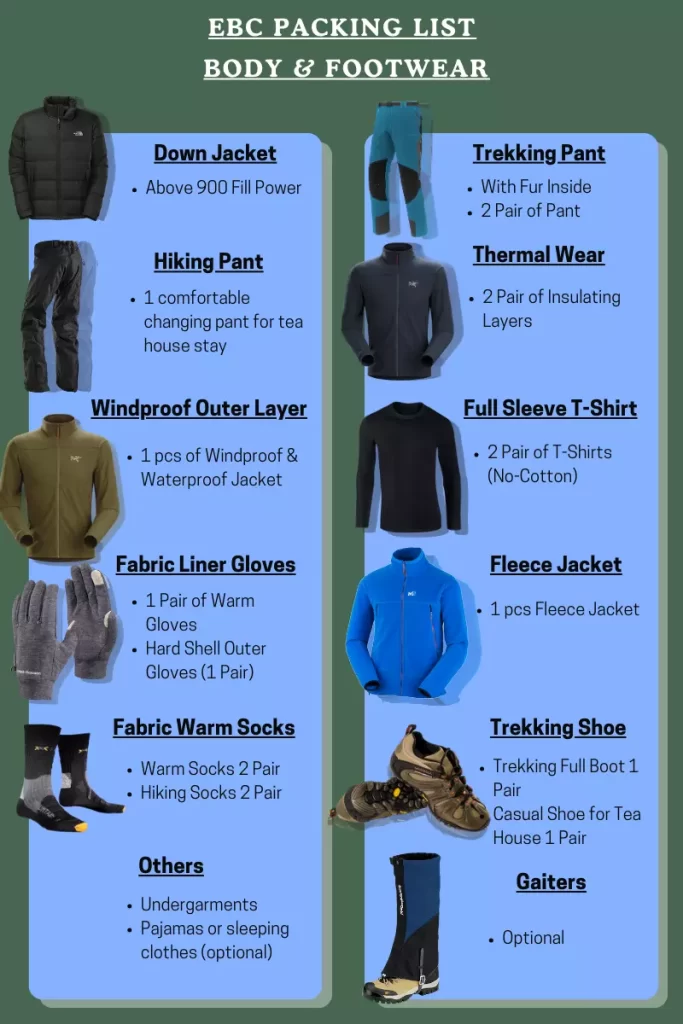
Gears & Equipment: Packing list for EBC
- Down jackets
- Trekking boots
- Long sleeve t-shirts
- Gortex-waterproof
- windproof jackets
- Hiking socks
- UV rays protected sunglasses
- Nylon windproof pants Nylon
- windproof pants
- Water bottles
- Neck gaiter
- Duffle bag (It is provided by us without extra charges if you trek with us)
- Minimum 40L daypack for carrying essential items during the trek
- Water bottles or Camelbak (Hydration bladder)
- Sleeping bags
- Trekking poles
- Quick dry trekking towels
- Toilet paper
- Shampoo Diaper
- Toothbrush & Toothpaste
- Hand sanitizer
- Snacks (which include chocolate bars and Protein & carb-containing foods)
- Thermos (For storing hot water for a longer time)
- Re-hydration powder (To stay hydrated)
- Passport (It is needed for entry gate registration)
- Travel Insurance
- Portable solar charger/power bank
- Playing cards or any other games
- DSLR cameras
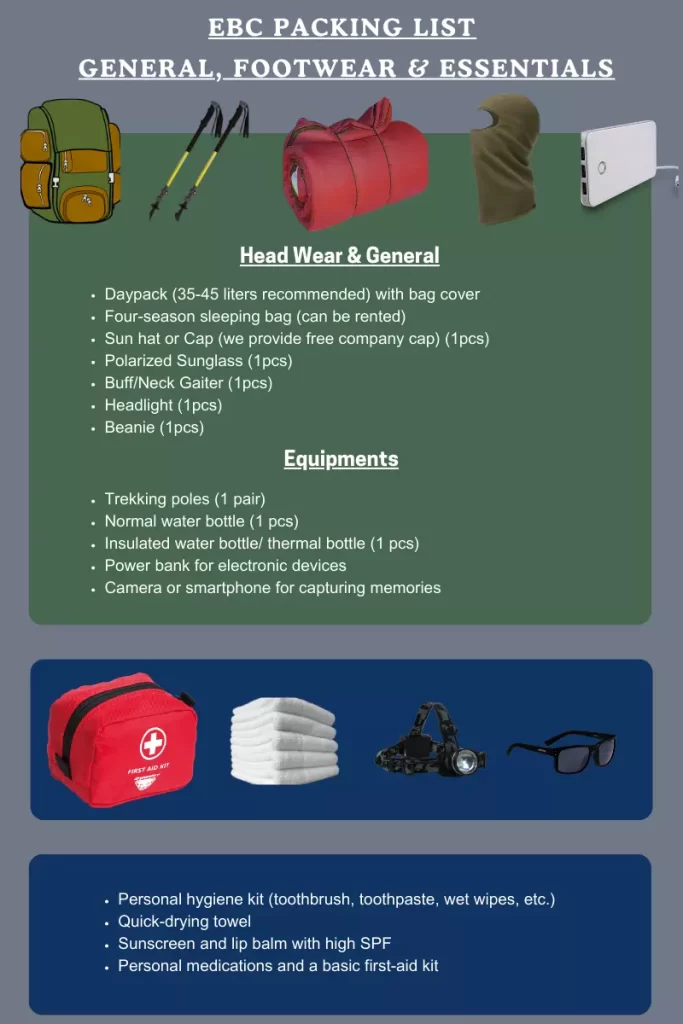
Can I buy or rent gear and equipment in Thamel?
Things to know about ebc, trekking permits required for everest base camp trek:.
You will need a Sagarmatha National Park Permit & Local Rural Municipality Entrance Permit to be able to trek in Everest Base Camp Trek.
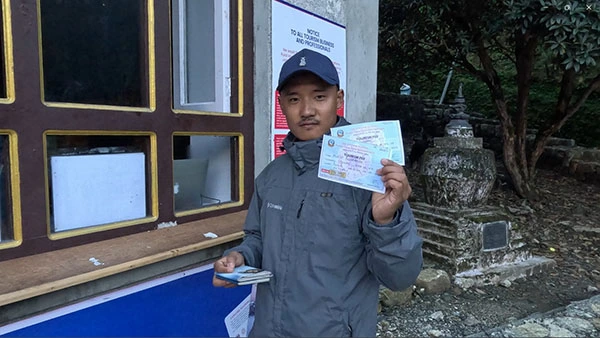
- Sagarmatha National Park Permit Fee = $30 ( NRS 3000 per person ), Monjo
- Local Rural Municipality Entrance Permit Fee = $20 ( NRS 2000 per person ), Lukla
Where to obtain permits for the Everest Base Camp Trek?
Accommodation Services in Everest Base Camp Route
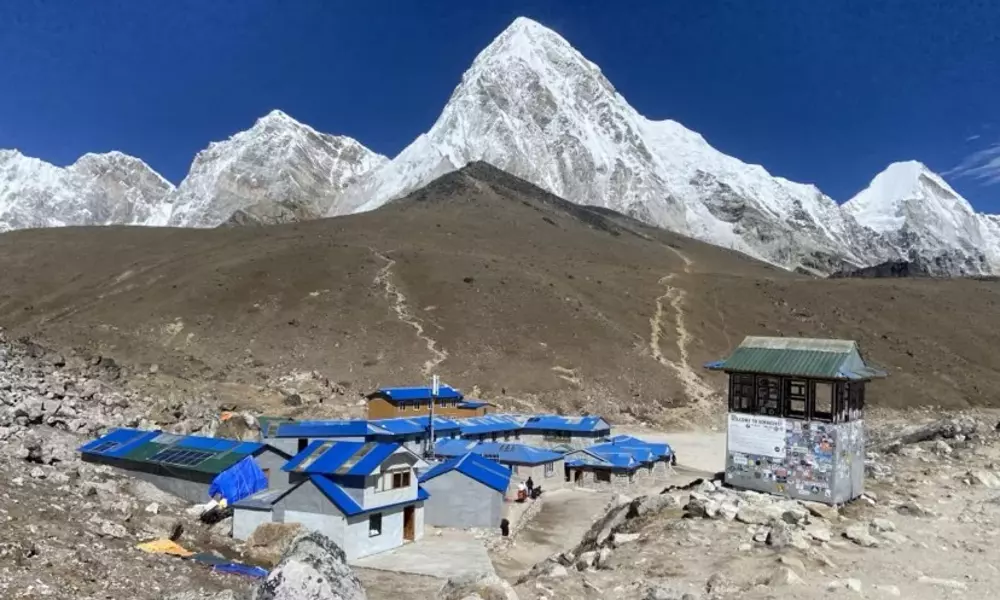
Foods and drinks in Tea Houses during the Everest Base Camp trek

Best Time for Everest Base Camp
Everest base camp trek in the autumn season.
- Dry days, clear skies, comfortable temperature, and fresh air.
- Panoramic mountain views
- Better prices in the trip package
- Less chance of snowfall
- Chances of seeing Nepal’s greatest festival Dashain and Tihar
- Since it is trekking season the trail gets quite crowded
Everest Base Camp trekking during the Spring season
- Longer days to Explore trails more
- Clear skies provide good mountain views
- Beautiful trails with rhododendrons and other flowers in bloom
- Good visibility in the early morning
- Comfortable temperature
- Less chance of rain and snowfall
- Nights might be quite cold
- The trial may be a little bit crowded since it is a trekking season
Everest Base Camp trek during Monsoon Season
- Less crowd, you could have a quality time
- The best temperature for trekking
- Green hills views
- Observing flora and fauna
- Rain may cause some difficulty
- The temperature rises remarkably
Everest Base Camp trek during the Winter season
- Less crowd and more space to enjoy in the Himalayas
- Prices in the trek and flights tend to drop a bit low
- Spectacular view
- No bugs and insects
- Might encounter rare wildlife
- The nights can be quite cold
- Fast-blowing wind during days
- Days are shorter
Transportation for Everest base camp trek
What is the luggage weight limit, porters for everest base camp trek, preparing for everest base camp trek difficulty: tips from pro, why does physical fitness play a big role in the everest base camp trek.
- Short hiking
- Cardio Exercise
- Always walk slowly & Be hydrated
- Bring Extra Nepalese currency with you in trekking
- Pack your backpack light & important gear only
- Avoid any hard drinks during the trekking
- Choose the best time to trek Everest Base Camp
- Always start your trek early
EBC Trekking Route Map
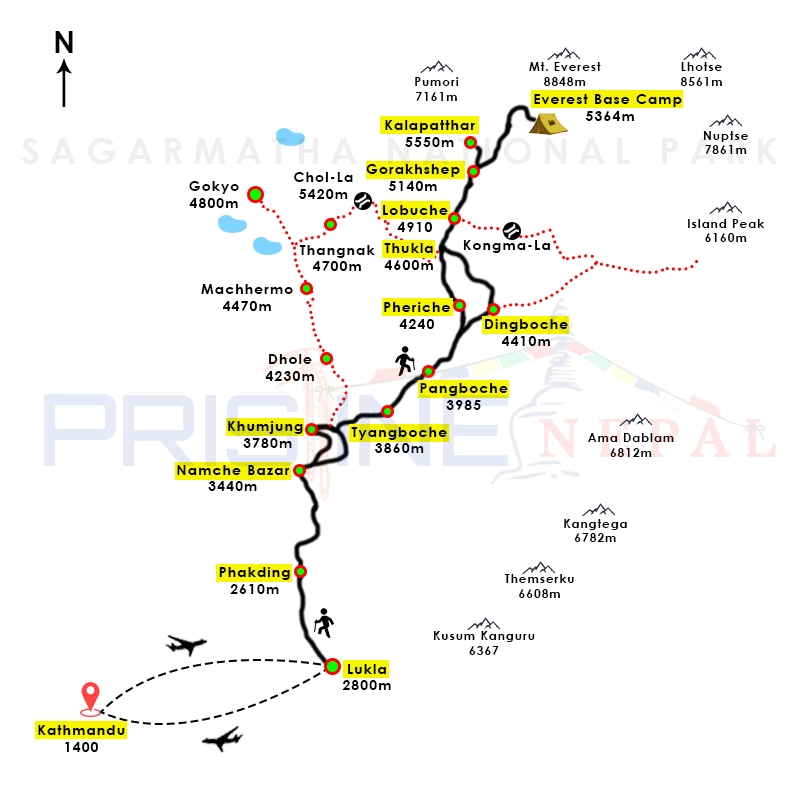
General Questions
The Everest Base Camp Trek is considered moderately difficult. It involves challenging terrain, high altitudes, and long trekking days. Adequate physical fitness and acclimatization are crucial for a successful trek.
Of course. With proper fitness, the right mindset, and guidance anybody can do this EBC trek. However, you have to walk slowly and steadily to cope with the higher altitude. Be sure to take in plenty of fluids and listen to your guide’s instructions.
The distance covered per day during the Everest Base Camp Trek varies based on the itinerary and individual trekking pace. On average, you can expect to trek around 10 to 15 kilometers per day.
The success rate of the Everest Base Camp Trek is high, with a majority of trekkers reaching their destination. However, success depends on various factors such as physical fitness, acclimatization, weather conditions, and individual circumstances.
There is no strict age limit for the Everest Base Camp Trek. However, participants should be in good health, physically fit, and able to endure the demands of high-altitude trekking. It is advisable to consult with a healthcare professional before undertaking the trek, especially for older individuals.
No, Everest Base Camp is not a permanent residence for anyone. It serves as a temporary campsite for climbers during the climbing season. After the season ends, the camp is dismantled, and climbers descend.
During Everest Base Camp Trek, the cost for extra services like WIFI can range up to NPR 500-700 for 24Hr Unlimited, Extra Luggage Costs can range up to NPR 100-150 per kg, Hot Shower can cost NPR 500, Boiled Water can cost NPR 100-NPR 500 according to altitude level for small pot water.
In trekking, there is no fixed price applied to all tea houses due to altitude & terrain. However, here are the rough prices for charging your devices in tea houses: Mobile=NPR 300 per hour (NPR 500 for full charge) Camera=NPR 300 per hour (NPR 500 for a full charge) Power Bank=NPR 400 per hour (NPR 1200 for a full charge) Laptop=NPR 500 per hour (NPR 1500 for a full charge) Drone Battery=NPR 600 per hour (NPR 1800 for a full charge)
Note: At higher altitude areas, solar power is the main source of electricity which is why it takes longer than hydropower to charge devices.
On average, it takes 6 to 7 hours to walk from one destination to another while ascending in Everest Base Camp Trek. However, we should not skip the factors such as fitness level, acclimatization needs, weather conditions, & proper guide that will actually determine the duration.
Similarly, when descending back to Lukla, it will take less time and fewer days. Here is a rough itinerary of the EBC trek with estimated walking times:
Lukla to Phakding: 3-4 hours Phakding to Namche Bazaar: 6-7 hours Acclimatization Day in Namche Bazaar Diboche via Tengboche: 5-6 hours Tengboche to Dingboche: 5-6 hours Acclimatization day in Dingboche Dingboche to Lobuche: 5-6 hours Lobuche to Gorak Shep, then Everest Base Camp, and back to Gorak Shep: 7-8 hours Hike to Kala Patthar and return to Pheriche: 7-8 hours Pheriche to Namche Bazaar: 6-7 hours Namche Bazaar to Lukla: 6-7 hours
Yes, there is indeed a hot shower facility during the Everest Base Camp trek. Up to Namche Bazar, you will be provided rooms with attached bathrooms & hot shower facilities which will be included in the cost inclusion.
This means you can shower at Lukla, Phakding & Namche Bazar. Similarly, after Namche Bazar, a hot shower is optional and only recommended if you really want to shower. It cost Nepali currency NPR 200 to 400 per hot bucket shower.
Yes, you can easily make a reservation or online booking through our website depending on the time you have at your disposal. Just fill out the form in our contact or inquiry section, which is accessible on the package, and submit it to us. We will respond to your mail within 24 hours.
To book a trek, you will need to pay 25% of the total price (this is to confirm and book the Lukla flight ticket) and the rest can be paid in Kathmandu. Also, you need to send us your passport scan copy and passport-size photos. You will receive an invoice, itinerary & other proof of bookings after 25% of payment.
We have a quick, easy, and secure online payment gateway system on our website. Find the online payment portal which is located at the top/header of our website or it is available inside the package too.
Our guide will check your oxygen level and heart rate (using an oximeter) each day to ensure your safety from altitude sickness.
If you feel any changes to your body like having a headache, vomiting, extreme tiredness & other symptoms then do tell your guide immediately. We also encourage you to drink plenty of fluids to prevent any possible altitude symptoms.
Also, walk slowly and maintain your breathing. And, do not hesitate to let your guide know if you are having any difficulties.
On rest day in Namche, after breakfast, you will first go to Tenzing Norgey Sherpa memorial park. Further, hike to the Everest viewpoint to catch a glimpse of Everest, Lhotse, Nuptse, Amadablam, and many others.
In the meantime, you will also be going to the highest situated Hotel Everest View (3,962m/13000ft) for a tea break. Return back and you can explore the Namche Bazar thoroughly.
At Dingboche, you will be hiking to Nangkartshang peak (5,121m) which is a 2-3 hour hike. The top offers you a stunning view of Island Peak, Lhotse, and Amadablam among many others.
Basically, two days are allotted for acclimatization in the standard Everest Base Camp trek plan.
However, in case you need extra days then we can prepare the trip plan according to your request. Additionally, if you encounter any problems or difficulties while on the trek, we can extend the trip duration for an additional cost.
During the trek, you will be achieving an altitude of 5545m. Which is a remarkable altitude. If you commit to this high altitude without proper preparation then, the mountains will not be very friendly.
There is a difference between dehydration headache and altitude sickness. Both will cause you headaches but there is a big difference between the two of them. You can continue after a dehydration headache and also after some care and medicine but if you catch altitude sickness then we suggest you descend as soon as possible and concern to the hospital.
Here are some useful tips to prevent altitude sickness during the Everest Base Camp trek in Nepal:
-Avoid ascending more than 500m a day -Slow and steady wins the race -Have a rest day after gaining an altitude of 600 to 900m -Avoid flying directly to high-altitude areas -Drink plenty of water and don’t let yourself feel thirsty. If you feel thirsty then understand that you are slowly getting dehydrated. -Strictly avoid alcoholic products and smoking -Consume a high-calorie diet -Avoid exposure to extreme sunlight
The Everest region is one of the high-altitude treks, thus the rooms there will be cold most of the time, especially in the morning and evening. However, the lodges or teahouses provide you with an additional sheet of blankets on request. You need to carry a sleeping bag at -20 degrees for this trek. Either you can bring it with you or you can rent it in Thamel.
Normally you will not have a laundry facility during the trek. So, we suggest you bring at least 4 T-shirts and a down jacket for the trek. Up to Namche Bazar, you can get your t-shirt washed on the acclimatization day but the drying part depends upon the weather. So, it might not be very reliable.
WiFi and internet facilities are available in the Everest region. Neither wi-fi nor mobile data are reliable in the Everest region. You can pay and get wi-fi in every hotel but it is not really useful. Everest link and air link are widely used sources for Wi-fi in the Everest region.
The water in the Everest region comes from the Himalayas. Even though the water looks very clean, it is not a very good idea to drink water from the tap during the trek. The first thing is the water is very cold and it might contain bacteria. It can cause stomach pain and diarrhea during the trek.
So as an alternative, you can use a water purifying tablet to filter the water and consume it after 30 minutes. Hot water is also available at every hotel. We suggest you drink warm water.
Even the water coming from rivers and waterfall are also not safe to drink. You can buy mineral water on the way. Since we discourage plastic use, we suggest you buy a portable water bottle and reuse it.
We apologize if you don’t finish your trekking. We cannot refund you because we pay for all permits, guides, porters, and Lukla tickets in advance.
You need to pay for your personal expenses such as hot showers, snacks, desserts, bar bills, WI: FI internet, food except for during trekking, tipping to guide and porters, emergency cases such as altitude sickness, natural disaster, flight cancelation, etc. So, keep NPR 30,000-50,000 with you in cash during the EBC trek.
It is absolutely fine if you are coming early for the Everest base camp trek. We will pick you up from the airport and bring your hotel. Pay yourself for your extra night in Kathmandu.
And it is fine too if you have a late departure. We will drop you at the airport three hours before your flight whenever you go. Pay yourself for extra nights in Kathmandu.
All of our guides speak English. They all have seven years plus of experience in this Everest base camp trek. Some of our guides have more than 15 and 18 years of experience here. They are a highly dedicated and experienced, friendly and hard-working person.
During departure, a private vehicle will be arranged for you in time. You can have your own choice if you want assistance or not. Usually, Mr. Chin will go himself or he will send your guide with you.
You can obtain a tourist visa on arrival at the Tribhuvan international airport under the Department of Immigration .
However, Indian nationals don’t require a visa and some countries – Nigeria, Ghana, Syria, Iraq, Zimbabwe, Swaziland, Somalia, Cameroon, and Afghanistan cannot get an On-Arrival visa. They have to acquire a visa prior to their arrival from their nearby embassy. For SAARC and Chinese nationals, a visa is issued free of cost. On-Arrival Visa Fee: 15 Days – 30 USD 30 Days – 50 USD 90 Days – 125 USD
To issue the visa you need to fill out the form online or may use a kiosk machine which is available inside the arrival hall. You need two passport-size photos for this.
There are several scenarios if a flight to or from Lukla is delayed.
If the bad weather caused the delay, the flight will be rescheduled for the following day when the weather is clear again. Trekkers may need to stay an extra day or two until the flight can take off.
If the flight delay is due to technical issues with the plane, the airline may try to fix the problem and reschedule the flight for the same day. Alternatively, the trekkers may be asked to wait until the next day or until a replacement plane arrives.
If the delay is due to other unforeseen circumstances, the airline may provide compensation or refunds to the trekkers. However, this is not always the case and it is best to check with the airline’s policies and terms and conditions.
In any case, trekkers should be prepared for flight delays and make sure they have enough supplies and backup plans in case of unexpected delays.
You can send your enquiry via the form below.
Recent posts.
- What is the highest point on the Everest Base Camp Trek?
- Tengboche Monastery-The Hidden Gem In Everest Region
- Required Vaccines for Everest Base Camp Trek
- Hillary Bridge
- Best Trekking Poles
Rate Us On Trip Advisor
Related trips you might interested in.
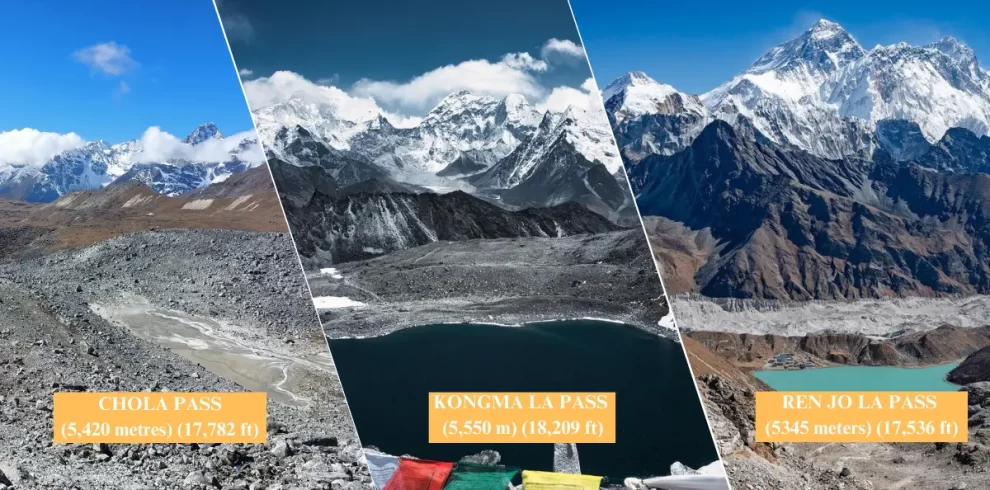
Everest Three High Passes Trek
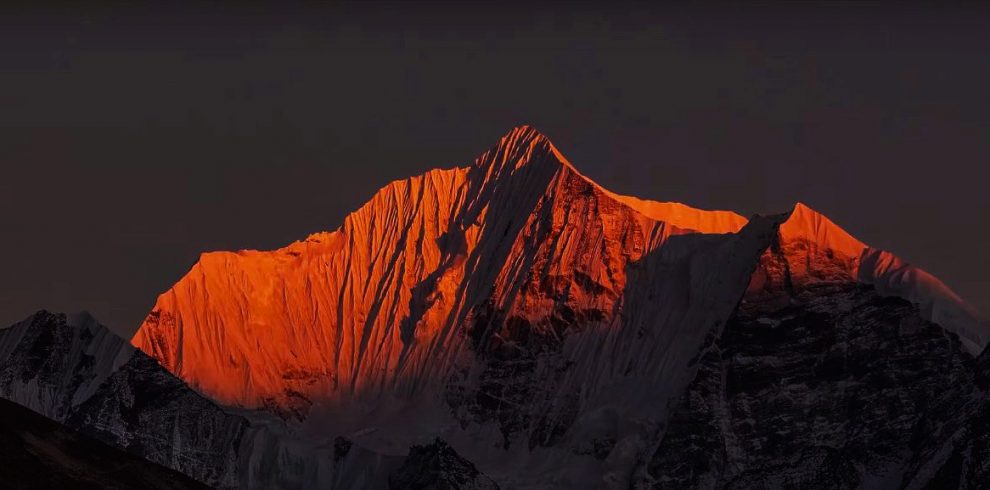
Langtang Valley Trek
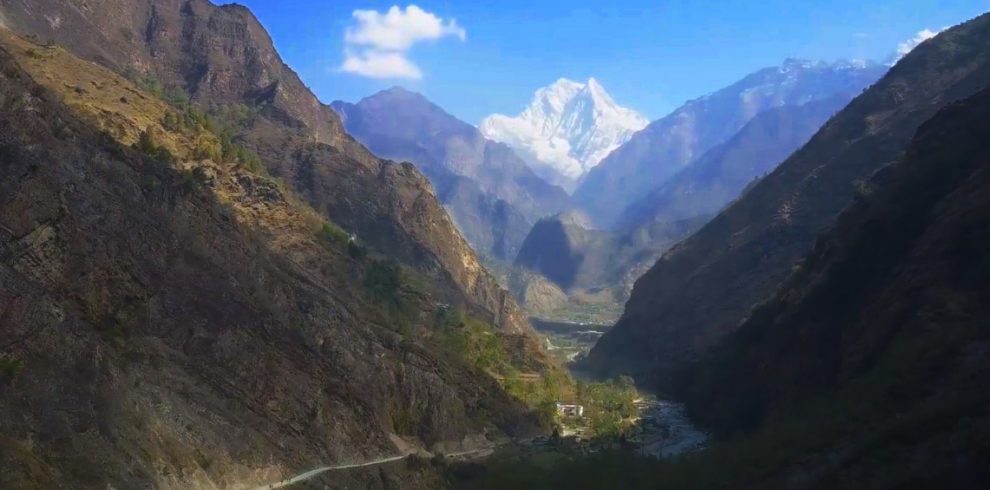
The Deepest Gorge Trek
Attractions
- UNESCO World Heritage Sites
- Protected Areas
- Eight Thousanders
- Pilgrimage Sites
- Bungee Jumping
- Motor Biking
- Rafting & Kayaking
- Mountain Biking
- Paragliding
- Cave Exploration
- Bird Watching
- Mountain Viewing
- Jungle Discovery
- Butterfly Watching
- Nagarkot Sunrise and Sunset
- Traditional Crafts
- Meet the People
- Village Tours
- Food & Culinary
- Cultural Tours
- Heritage Walk
- Museum Tours
- Faith Healing
- Panchakarma Treatment
- Sound Meditation
- Natural Hot Water Springs in Nepal
- Pilgrimage Tours
- Destination Wedding
- Indra Jatra
- Chhat Parva
- Event Calendar
- Festival Highlights
- Travel with children
- Ganesh Himal Trek
- Chandragiri - Chitlang - Kulekhani
- Pilgrimage to Doleshwar mahadev Temple
About Nepal
Travel details.
- Tourist Visa
- Local Transportation
- Trekking Permit
- Park Entry Fees
- Heritage Site Entry Fees
- Tourist Police
- Safety in the Mountains
Book Your Trip
- Book Experience
- Travel Updates
Everest Base Camp
High in the priority list of trekkers, the Everest Base Camp is one of the most visited regions in the Himalaya. The two-week trek starts and finishes at Lukla, an airstrip to the south of the region also known as the ‘Gateway to Everest’. Most trekkers fly to Lukla to begin the trek.
After landing in the airstrip, a gentle two-day trek up the Dudh Koshi valley leads to the famous Namche Bazaar . The route has an abundance of tea houses. Phakding and Monjo are the popular stopovers on the first day and just beyond Monjo is the entrance to the Sagarmatha National Park at Jorsale check point where permits are checked. The trail that followed the Dudh Koshi River starts going uphill from the suspension bridge just a few minutes from Jorsale and Namche Bazaar is reached after a 3-hour hike.
It is good to halt here for a few days to acclimatize by walking in the surroundings of Namche as it can’t be done in a hurry. A visit to Syangboche or some Sherpa villages such as Thame, Khumjung and Khunde are just a few hours walk from Namche and are good options for a hike to while away your time.
Leaving Namche Bazaar, the trail follows the valley of Imja Khola with spectacular views of Thamserku, Kangtega and Ama Dablam mountains, while dominating the skyline ahead are the giants, Lhotse and Everest. The most common night halt after Namche is at the top of a steep climb from the Imja Khola at Tengboche. The Tengboche Monastery is one of the most famous monasteries, probably because of its unrivalled backdrop, Mt. Ama Dablam.
Following the Imja Khola from Tengboche , the trail ascends through Pangboche until Pheriche or Dingboche is reached, where the day’s trek ends. Another day of acclimatization follows with a fascinating side trip to Chhukung which is about a 3 hour walk from Dingboche.
From Dingboche or Pheriche a 6-hour walk leads to Lobuche which sits on the lateral moraine of the Khumbu glacier. What follows is a roughly 3-hour hike from Lobuche to the last settlement on the trail known as Gorak Shep. The few tea houses at this place provide shelter for the night before one undertakes the final leg of the trek over the glacier to Everest Base Camp.
Above Gorak Shep is seen the popular view point known as Kala Patthar, from where many a trekker has captured the image of the world’s highest mountain and gazed up in awe. The trek along the glacier to base camp can take up to five hours. This is treacherous ground and one must walk through this area cautiously, as finding a route can be tricky and there’s always the risk of falling on the slippery ice. Being at Everest Base Camp is an out of this world experience.

Nepal Tourism Board is a national tourism organization of Nepal established in 1998 by an Act of Parliament in the form of partnership between the Government of Nepal and private sector tourism industry to develop and market Nepal as an attractive tourist destination. The Board provides platform for vision-drawn leadership for Nepal’s tourism sector by integrating Government commitment with the dynamism of private sector.
Nepal Tourism Board
Other sites.
- Tenders & Trade
- Photo Nepal
Feedback Form
Nepal climbers return to Base Camps
April 29, 2024
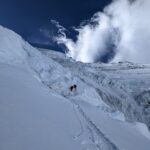
The IMG climbers and sherpas on Everest and Ama Dablam are back at Base Camp now, after their respective rotations. The Everest crew tagged Camp 3 yesterday and descended to Camp 2, then descended the Icefall today in the early morning, arriving to Everest Base Camp in time for a late breakfast. Over on Ama Dablam, the team overnighted at Camp 1, then tagged Camp 2, and are now back down to Mingbo Base Camp. Next up for everyone are several well-deserved days of rest.
It has been windy up high on Everest the last couple days, but nonetheless the EOA fixing team has managed to get the route fixed to the South Col, which is great news. Now the various teams will begin stocking Camp 4 for the summit bids.
2-FOR-1 GA TICKETS WITH OUTSIDE+
Don’t miss Thundercat, Fleet Foxes, and more at the Outside Festival.
GET TICKETS
BEST WEEK EVER
Try out unlimited access with 7 days of Outside+ for free.
Start Your Free Trial

Everest Season Kicks Off with New Rules, Big Crowds, and Poop Bags
The number of climbing permits issued by Nepal is down from 2023 as some expeditions have headed to China. But there’s bound to be drama on the world’s highest peak as climbers adjust to new regulations governing pollution and safety.
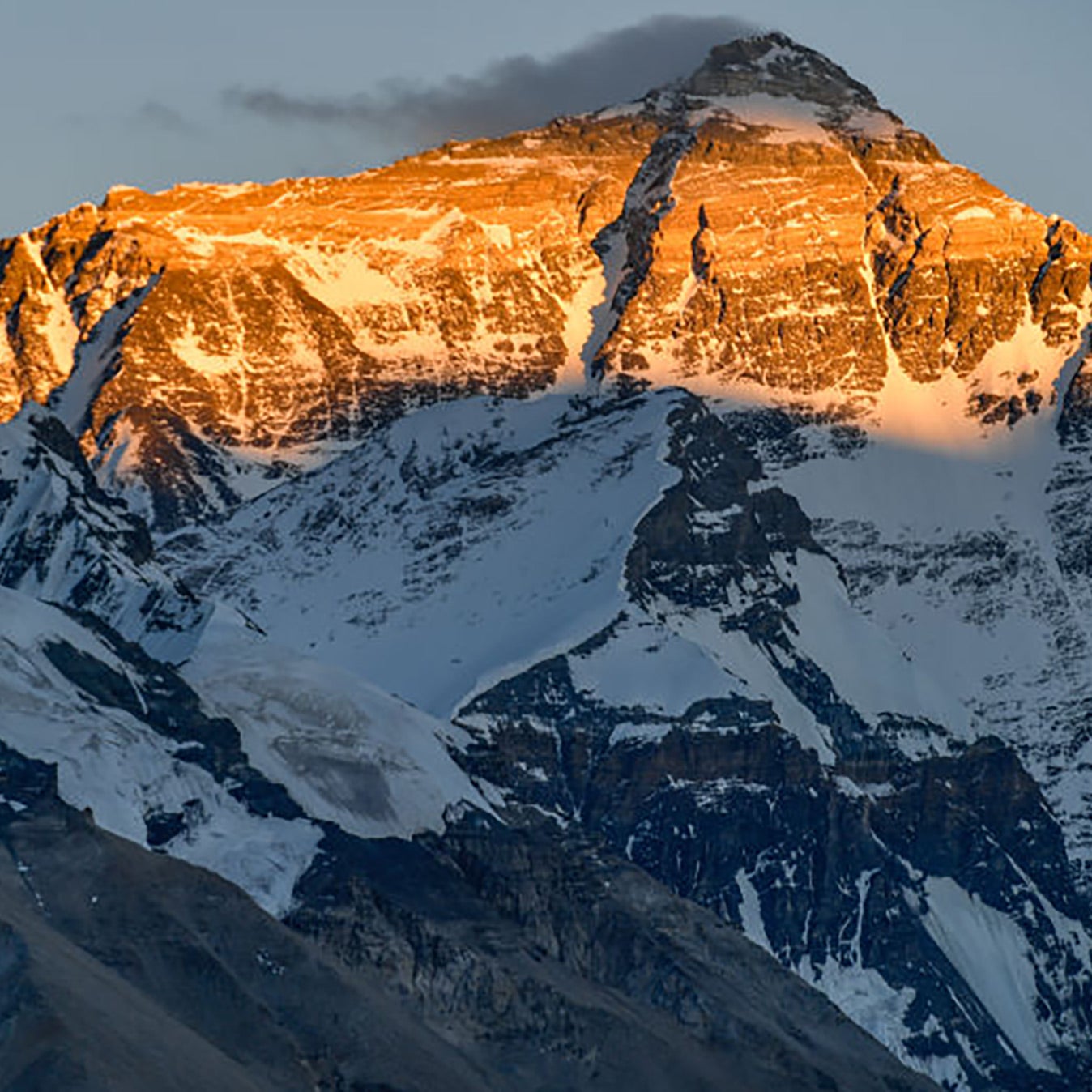
Heading out the door? Read this article on the Outside app available now on iOS devices for members! >","name":"in-content-cta","type":"link"}}'>Download the app .
The 2024 climbing season on Mount Everest is in full swing this week as some expedition teams are arriving at Base Camp and others have begun acclimatization rotations on the peak. As Outside recently reported, the official start on the mountain’s Nepali side is delayed this year due to dangerous conditions in the Khumbu Icefall . The circuitous route through the glacier that precedes the easier climbing up to Camp I and Camp II is longer than the one used in previous years, due to an unusually dry winter and a lack of snowfall.
The scheduling delay and new route aren’t the only dynamics impacting expeditions on the world’s highest peak this year. Competition from China has drawn some climbing teams away from the southern Base Camp in Nepal. And new rules and regulations imposed by the Nepali government will shift how some teams handle safety, decorum in Base Camp, and even poop .
Climbers may encounter slightly fewer of their peers along the route to the top, as recent statements from officials in Nepal hint at a smaller crowd than in recent years. According to Rakesh Gurung, Director of Nepal’s department of tourism, the country expects to issue approximately 400 climbing permits for the season—down from the record-breaking 478 last year. As of April 22, 365 permits had been granted to 34 different expedition teams. Permits for three additional teams are still being processed, Gurung said.
“Climbing permits are down across all the peaks,” Gurung said. “One reason is the global economic situation, and another is that China is open for Everest permits this year.”
China Attracts Summit Seekers
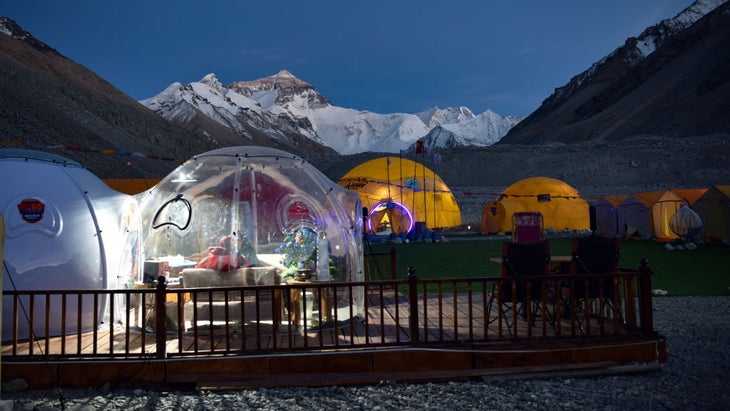
Indeed, China has once again opened its borders to Everest climbers in 2024 following a four-year closure due to Covid. Unlike the Nepali Base Camp, the Chinese Base Camp can be accessed by car, making the transport there much easier. Some expedition operators prefer to climb from the Chinese side, claiming that Everest’s Northeast ridge is less vulnerable to avalanches and rockfall than the southern flank. The smaller crowds on the Chinese side present another advantage.
But there’s a drawback in climbing from China—currently, the government has yet to issue the final permits to Everest expeditions, or even allow climbers into the country. Just this week officials told expedition operators that they would be allowed to enter the country on May 7—significantly later than originally planned.
“Thankfully the north side doesn’t have the same end-of-season issues that the south side does,” Adrian Ballinger , CEO of Alpenglow Expeditions, told Outside . “Tibet is in the rain shadow of Everest and the monsoon is generally much later. It’s not our ideal, but everyone is doing their best and that’s our plan.”
The Everest delay is just one curveball facing climbers in China. The country recently canceled all climbing on 26,335-foot Shishapangma and 26,864-foot Cho Oyu.
The uncertainty prompted Seven Summits Treks, Nepal’s largest Everest operator, to cancel its Chinese Everest expedition altogether, moving all eight of its clients to climb in Nepal. “We have had clients waiting here [in Kathmandu] for 15 days, and our Shishapangma clients have been waiting since April 5th,” said Thaneswhar Guragai, the company’s general manager.
The cancellation of permits on Cho Oyu and Shishapangma presents a significant setback for climbers hoping to complete all 14 peaks above 8,000 meters this year, and two well-publicized expeditions hoping to retrieve the bodies of four victims of an avalanche last October . The deceased are American climbers Anna Gutu and Gina Marie Rzucidlo, along with their guides Mingmar Sherpa and Tenjen ‘Lama’ Sherpa. Two months before the avalanche, ‘Lama’ earned the speed record for climbing all 14 8,000-meter peaks in 92 days, along with Norwegian climber Kristin Harila.
New Rules in Nepal
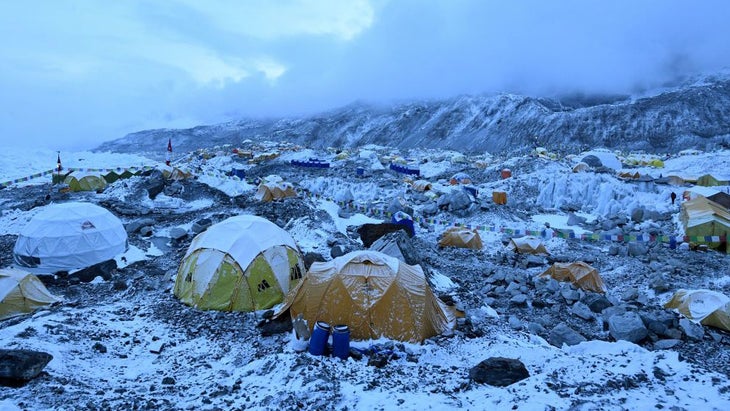
A record number of Everest fatalities in 2023, combined with the mounting pollution on the peak, prompted Nepali officials to enact new regulations governing expeditions . The regulations oversee a wide swath of operations, from climber safety to the size of tents allowed in Base Camp. The most cumbersome rule may be the new mandate that all climbers must carry their human waste down off the mountain in biodegradable bags and deposit it at a collection center at Base Camp.
The local government body that oversees the Everest region, the Khumbu Pasang Lhamu Rural Municipality, is responsible for this program. According to Jagat Prasad Bhusal, the organization’s chief administrative officer, officials are still debating what, exactly, to do with all of that poop.
“We are currently exploring options for handling the feces. If feasible, we will either convert it into manure or dispose of it safely near Tengboche or Pangboche in Upper Khumbu,” he said.
Expedition operators who spoke to Outside expressed positive sentiment toward the poop rule, despite the logistical challenges it presents. “This will be beneficial in the future because the whole world is looking towards sustainability. A small contribution to help the mountain is never a bad idea.” Guragai said.
Another new rule requires climbers to wear RECCO-style tracking reflectors during their climbs. In theory, this technology allows rescuers to find lost climbers by using a specialized transponder that tracks the reflectors. But there are doubts this will work in Everest’s extreme altitude and vast terrain. “We don’t know how well it will work,” Gurung told Outside “But let’s try.”
Gurung said Nepali officials are planning to make GPS tracking mandatory in future seasons. The devices will improve safety, he said. “This will also reduce false summits,” Gurung added.
To enforce these new rules, Nepal’s department of tourism has opened a field office at Base Camp. Officials stationed there will make sure expeditions follow the regulations, and they will also teach climbers lessons on mountain safety and “expedition ethics,” Gurung said.
“The rules and regulations are one thing. But people have to be aware of their own abilities, too,” Gurung said. “If something happens at 8,000 meters, a rescue is basically impossible. If expedition ethics are followed in these situations, the number of casualties will be reduced greatly.”
Despite the new regulations and the slight downturn in climbing permits, officials still expect the route to become crowded. Advanced weather forecasting means most expedition operators head onto the peak at the same time to take advantage of clear skies. And many expedition operators send as many, or more, guides onto the peak as paying clients.
An estimated 1,500 porters, guides, and Sherpas will be working above Base Camp to build camps and ferry gear, and the total number of climbers heading for the summit from both sides is likely to surpass 700, officials said.
Gurung told Outside that officials will examine the 2024 season to see if the government should make additional changes for the future. “There are many issues—do we only want to make Everest cheaper? Should it be accessible to everyone or not? Gurung said. “We’ve discussed these things many times. Let’s see what the future brings.”
Record Chasers and Adrenaline Junkies Return
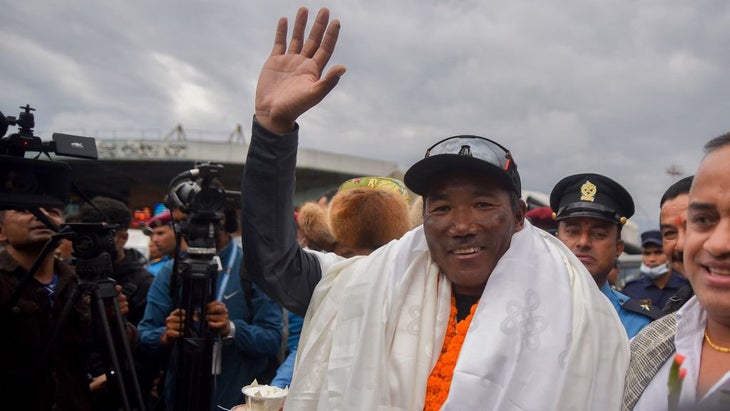
As is often the case, a handful of record-chasing climbers will attempt to make history on the world’s highest peak in 2024. One climber, 59 year-old Russian alpinist and mountain guide Valeriy Babanov, is attempting to become the oldest person to reach the top of the world without supplemental oxygen. Babanov is a two-time winner of the coveted Piolet d’Or award for first ascents in India and Nepal including a solo ascent of the Shark Fin on India’s famed Meru Central peak (6,310 m). “I’ve been preparing for this all my life,” he wrote on Instagram.
Two Nepali women are seeking their own records: Purnima Shrestha is hoping to become the first woman to summit three times in a single season, and Phunjo Lama is attempting to reclaim her record for the fastest ascent by a woman. Both women face major challenges with their respective efforts due to the 2024 route through the Khumbu Icefall, which adds approximately two hours to the total ascent compared to 2023.
Everest legend Kami Rita Sherpa , 54, will attempt to complete his 29th Everest summit, breaking his own world record, set after two back-to-back ascents last year. If successful, this would also mark his 43rd trip to the summit of an 8,000-meter peak.
A top international BASE jumper named Tim Howell is also targeting a record: the highest wingsuit jump in history. Howell plans to ascend from Base Camp to the southern face of 27,940-foot Lhotse, which is located next to Everest. He plans to then jump from just below the summit—the sheer face makes it perhaps the highest spot on the globe where a wingsuit jump can be accomplished. “I like the idea that this can’t be beaten.” Howell told Outside .
“It’s the highest wingsuit jump in the world.” Howell expects to reach speeds of 160 mph on his descent, dropping over 16,000 feet in under five minutes.
Could such a jump ever be done from the summit of Everest? It’s not impossible, Howell told Outside . “Maybe with the advancement in suits, somebody who is willing to risk it all maybe could do it one day,” he said.
Tulsi Rauniyar contributed to this report.
- Mount Everest
Popular on Outside Online

Enjoy coverage of racing, history, food, culture, travel, and tech with access to unlimited digital content from Outside Network's iconic brands.
Healthy Living
- Clean Eating
- Vegetarian Times
- Yoga Journal
- Fly Fishing Film Tour
- National Park Trips
- Warren Miller
- Fastest Known Time
- Trail Runner
- Women's Running
- Bicycle Retailer & Industry News
- FinisherPix
- Outside Events Cycling Series
- Outside Shop
© 2024 Outside Interactive, Inc
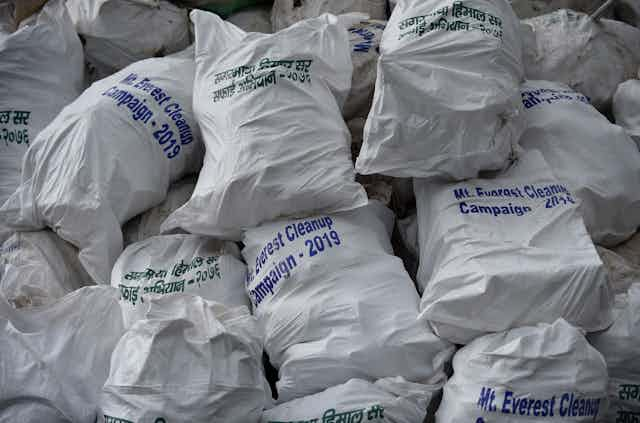
Climbers have turned Mount Everest into a high-altitude garbage dump, but sustainable solutions are within reach
Harold T. Stearns Professor of Earth Science, Wesleyan University
Senior Research Associate, Institute of Arctic and Alpine Research, University of Colorado Boulder
Disclosure statement
Alton Byers has lived and worked in Nepal, and has collaborated with communities around Everest to protect and restore ecosystems that have been damaged by trekkers, climbers and the tourism industry. He was lead author of a sustainable solid waste management plan for Sagarmatha National Park and Buffer Zone produced in 2020 by University of Colorado Boulder researchers with support from the National Geographic Society.
Suzanne OConnell does not work for, consult, own shares in or receive funding from any company or organisation that would benefit from this article, and has disclosed no relevant affiliations beyond their academic appointment.
Wesleyan University and University of Colorado provide funding as members of The Conversation US.
View all partners
Spring is go time for climbers who hope to summit Mount Everest, Earth’s highest peak above sea level. Hundreds of mountaineers from around the world travel to Asia in April and May, headed for base camps in Nepal and Tibet.
But jagged peaks won’t be the only thing they see. Especially on Everest’s more heavily traversed Nepal side, they’ll find fields of garbage – including cans, bottles, plastic and human and animal excrement.
Each year, more than 60,000 trekkers and climbers visit the Sagarmatha National Park and Buffer Zone , a high-altitude swath of the Khumbu region in northeast Nepal that includes Everest and seven other peaks. Some 400 to 500 climbers attempt to summit Everest every year.
The trash problem first became evident in the 1980s and 1990s, when climbing on the mountain and trekking in Khumbu began to increase. Climber and trekker numbers have further skyrocketed in the past 20 years .
Most coverage of this issue focuses on negative and sensational aspects, such as the frozen bodies of climbers who remain where they died on the mountain because removal operations are risky and expensive.
We are scholars who study geoscience and mountain geography , and one of us (Alton Byers) has lived in Nepal and worked with communities around Everest. We are encouraged to see increased efforts to address Everest’s massive trash problem. In our view, modern technology and international cooperation are key to ending the pileup of waste in this iconic setting.
Pollution from waste
For most visitors to this area of the Himalayas, Everest base camp on the upper reaches of the rapidly receding Khumbu Glacier is the ultimate destination, at an altitude of 17,589 feet (5,364 meters). Formerly a two- to three-week trek from Kathmandu, today the journey is most likely to begin at the Lukla Airport , which sits about 35 miles (60 kilometers) from base camp.
Climbers who aim to summit Everest typically spend up to two months on the mountain , including weeks making short, incremental ascents above base camp and back down again. This enables them to acclimate to the altitude before climbing to higher camps and then to the summit.
Much of the food and equipment headed to Everest also begins its journey at Lukla. Some is shipped to base camp by helicopter, but much of the gear is carried there by yaks, yak/cattle crossbreeds called dzopkio, mules and horses .
Lots of equipment, food and packaging, plus animals and porters, means a lot of garbage. A 2010 study estimated that park tourism generated 4.6 tons of solid waste per day during peak tourist periods in April-May and October-November.
Eventually most of this refuse is dumped into unsightly landfills a short distance from local villages. There it is burned, adding particulates and toxic chemicals to the air. The remaining ash is buried, where it can contaminate groundwater.
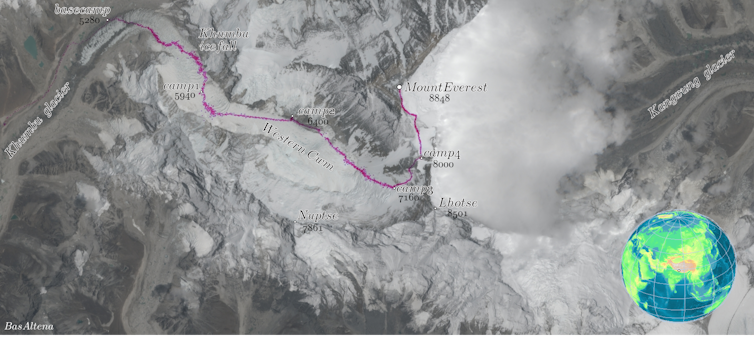
At the base camp, microplastics – likely from discarded mountaineering clothing, tents, ropes and boots – have been found in water and snow samples . High levels of perfluoroalkyl and polyfluoroalkyl substances, or PFAS , widely known as “forever chemicals,” have been found on the Khumbu glacier , probably from materials used to waterproof climbing boots, tents and clothing.
These substances could pose health risks for transient climbers, but are a more serious threat for people who live in the nearby settlements of Gorak Shep, Lobuche, Dugla and Pheriche for most of the year. Some of these villagers work at Everest base camp and are exposed there too.
And then there’s sewage. Most septic tanks at the hundreds of lodges located throughout the national park and buffer zone leak, further polluting groundwater . Camp Four, the last site that climbers occupy before they attempt to summit Everest, is covered with garbage and frozen, wind-swept feces.
National parks in developed countries have infrastructure to handle waste management, trash pickup, recycling and wastewater treatment. At Everest base camp, there are just collection barrels under toilets. Each year, some 50,000 pounds (22,000 kilograms) of human waste are brought to landfills several kilometers away .
Solutions for sustainable tourism
Recognizing the scale of this problem, initiatives are in progress to develop solutions.
The Sagarmatha Pollution Control Committee , created by local Sherpa people in 1991, is an Indigenous nonprofit organization that is responsible for monitoring garbage in the permit-required mountains and peaks. The group focuses on litter control and periodic base camp cleanups.
In 2014, the government of Nepal began requiring every mountaineer who climbs above the Everest base camp to bring back 18 pounds (8 kilograms) of solid waste from the mountain or forfeit a US$4,000 deposit. Of course, if you’ve paid $75,000 or more for the trip, losing the deposit may not be much of an incentive. Many people elect to forfeit it.
A nonprofit called Sagarmatha Next , established in 2019, is working to promote sustainable tourism in the Khumbu region, partnering with companies and organizations from around the world. The group has raised awareness by producing art works and souvenirs from trash. It also launched a “Carry Me Back” program that encourages tourists to take two-pound (one-kilogram) bags of solid waste, such as shredded plastic bottles, to the airstrip at Lukla for processing and disposal in Kathmandu.
At the local government’s request, the University of Colorado Boulder developed a sustainable solid waste management plan in 2019 for the national park and buffer zone. The COVID-19 pandemic delayed implementation of the plan, which proposes creating a five-step process: waste segregation, collection, sorting and shredding, transfer to shipment stations and transportation to recycling facilities in Kathmandu.
Another nonprofit initiative, the NeverRest Project , was created during the pandemic to provide environmental solutions for Mount Everest and other fragile ecosystems around the world. NeverRest is working with the Nepal Tourism Board to revolutionize high-altitude waste management using modern technology.
In 2023, the organization presented a concept plan for a sustainable Everest base camp that would install technologies such as portable solar tents to reduce use of fossil fuel; unisex portable urinals with multi-use filters that convert urine into water; incinerator toilets that transform human waste into ash; and modular geodesic dome tents designed for effective heat retention to reduce energy use.
In the 71 years since Sir Edmund Hillary and Sherpa Tenzing Norgay made the first known successful ascent of Mount Everest , this peak has been a setting for daring expeditions, triumphs and tragedies. We hope that the region’s garbage problem soon will fade into history as new approaches and technologies provide solutions for Everest and other remote high-mountain locations around the world.
- Mountaineering
- Microplastics
- Mount Everest
- Solid waste management

Assistant Editor - 1 year cadetship

Program Development Officer - Business Processes

Executive Dean, Faculty of Health

Lecturer/Senior Lecturer, Earth System Science (School of Science)

Sydney Horizon Educators (Identified)
The Straits Times
- International
- Print Edition
- news with benefits
- SPH Rewards
- STClassifieds
- Berita Harian
- Hardwarezone
- Shin Min Daily News
- Tamil Murasu
- The Business Times
- The New Paper
- Lianhe Zaobao
- Advertise with us
5-year-old sets record as youngest Singaporean to reach Everest Base Camp

SINGAPORE – Battling strong winds and minus 14 deg C temperatures, pre-schooler Abyan Imtiaz Irkiz became the youngest Singaporean to reach the base camp of Mount Everest.
Abyan, who is five years and five months old, was accompanied by his father, Mr Zikri Ali, 41. Father and son arrived at Everest Base Camp, situated at an altitude of 5,364m, in Nepal on April 29.
Already a subscriber? Log in
Read the full story and more at $9.90/month
Get exclusive reports and insights with more than 500 subscriber-only articles every month
ST One Digital
$9.90 $9.90/month.
No contract
ST app access on 1 mobile device
Subscribe now
Unlock these benefits
All subscriber-only content on ST app and straitstimes.com
Easy access any time via ST app on 1 mobile device
E-paper with 2-week archive so you won't miss out on content that matters to you
Join ST's WhatsApp Channel and get the latest news and must-reads.
- Mount Everest
- Children and youth
- Travel and leisure
Read 3 articles and stand to win rewards
Spin the wheel now

Six-year-old Dubai pupil sets sights high after Everest trek
A six-year-old Dubai schoolboy is embracing the high life – after trekking to the base camp of Mount Everest in Nepal on his first attempt.
Ivan Krasiukov, a Russian pupil at Bloom World Academy, scaled an altitude of 5,364m in only seven days to make for an Eid family getaway that will be tough to top.
The daring youngster was accompanied by his parents, Dmitrii and Alla Krasiukov, and a sherpa for the remarkable feat, which saw him complete energy-sapping walks and climbs in freezing temperatures.
Ivan reached base camp on April 10 and spent another three days journeying back.
“I felt a little bit sad and a little bit happy when I reached the base camp,” said Ivan.
“I was happy to reach the destination but sad the journey had come to an end and we would have to take a flight back to Dubai.
“I liked seeing the Khumbu glacier. It was very beautiful.”
Scaling new heights
Ivan had been one only one other trek before taking on Mount Everest and said the cold winds posed a challenge.
“My hand was freezing because of the wind,” said Ivan.
The pupil said he enjoyed seeing animals such as yaks, oxen, donkeys and horses during his epic journey.
He also enjoyed eating pasta, which was available at the lodges along the way.
His father, Dmitrii Krasiukov, decided to go for the trek to the Everest base camp, but Ivan relished the opportunity to take part.
Sense of adventure
The only way is up for the young mountaineer, who vowed that he hasn't reached the peak of his ambitions just yet.
He is ready to go to the Everest Base Camp again and in the future hopes to climb Mount Kilimanjaro in Tanzania and Mount Elbrus in Russia.
Ivan already maintains an active lifestyle, having a keen interest in athletics, acrobatics, parkour, swimming, and dancing and has about 12 training sessions per week, said his family.
In athletics, Ivan runs various distances, which helped him to build the necessary endurance for the journey.
During the trek, Ivan used special trekking poles, but he did not use them during the last three days of the trip.
Proud parents
Mr Krasiukov said the family faced plenty of adversity on the gruelling climb.
“The most difficult day was the first day, and then Ivan got used to it. After that, it was easier.
“Of course, the day when we climbed to the base camp was challenging.
“On the way, there was a sandstorm and huge rocks that had to be climbed.
“Another difficult day was when we climbed from 4,000 to 4,900 metres for an acclimatisation day in Dingboche, and Ivan's hands froze because a strong and cold wind rose after lunch.”
At that moment, his father gave Ivan his gloves.
“It was a useful experience because after that, we bought warm mittens made of yak wool to avoid a similar situation when climbing to the Everest Base Camp,” said Mr Krasiukov.
“He's quite strong and he has endurance, which is very important in the mountains.”
Mr Krasiukov said he had prepared himself for the trek by running 5km every day, while his wife prepared by doing horse-riding.
“When Ivan was on the trek, he travelled alongside people from different countries such as China, Singapore, Taiwan, India, the UK, Spain, the US, Russia, Kazakhstan, and others,” he said.
“They all knew that Ivan was on the trek and that he was six years old, walking there without any assistance or support. This is not easy even for most adults.
“In Dingboche at an altitude of 4000 meters, he felt slightly nauseous, but it quickly passed.”
Bloom World Academy head teacher John Bell said: “At Bloom World Academy, we couldn't be prouder of Ivan's remarkable achievement at such a young age.
“His dedication to training, coupled with his adventurous spirit, is truly inspiring. Ivan's rigorous regimen, including athletics, acrobatics, parkour, swimming and dancing, prepared him well for the journey.
“Throughout the trek, he utilised special trekking poles, a testament to his determination and resilience. We commend Ivan for his exceptional accomplishment and look forward to supporting his future adventures.”
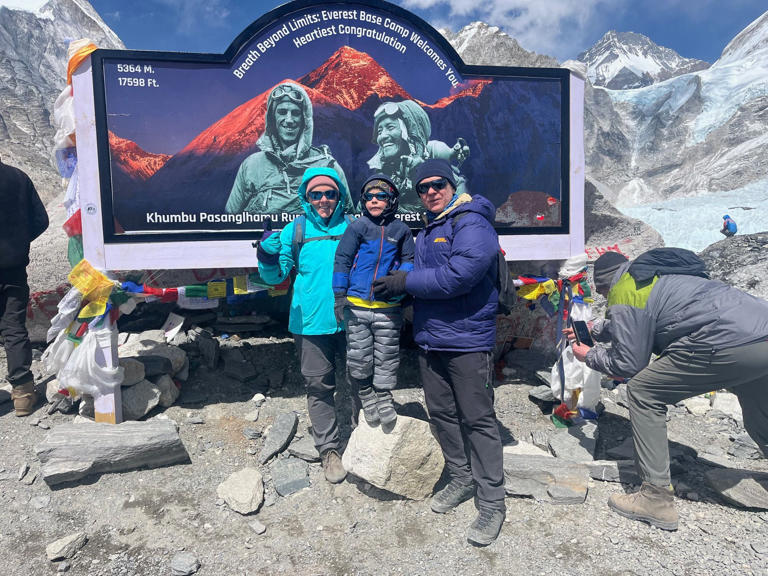

IMAGES
VIDEO
COMMENTS
The Everest Base Camp (EBC) trek is a spectacular high-altitude trek in the mountains of Nepal. Prepare for jaw-dropping scenery and a unique cultural experience exploring the challenging trekking routes around the highest mountain in the world.
Day 06: Trek to Lobuche (4910 m/16,108 feet) Day 07: Trek to Gorak Shep (5,164 m /16,942 feet) trek to Everest base camp. Day 08: Morning excursion to Kala Patthar (5545 m/18,192 feet) and trek to Pheriche or Pangboche (3930 m/12,893 feet) Day 09: Trek Back to Namche - Back to lower altitude.
Day 8: Dingboche to Thukla. Day 9: Thukla to Gorak Shep. Day 10: Everest Base Camp. Day 11: Kala Patthar to Gorak Shep to Pheriche. Day 12: Pheriche to Namche. Day 13: Namche to Lukla. If you ever need motivation to keep going on the Everest Base Camp hike, just look at how much the porters are carrying!
The journey to Everest Base Camp Trek in Nepal tops the dream list for countless trekkers worldwide, and for good reason! It is a trail that showcases the greatness of the Khumbu Valley, offering breathtaking views of some of the world's highest peaks. The journey begins with an exciting flight to Lukla, at an elevation of about 2850 meters.
The Everest Base Camp Trek is one of Nepal's most exciting and sought-after routes in the Himalayan region. This trek is a 16-day adventurous journey to the foot of the Mount Everest. It is also the highest peak in the world, towering above 8800 meters above sea level.
The Everest Base Camp Trek is one of the most popular and best treks in Nepal.. Home to four of the six highest mountains in the world - Mt. Everest (8,848 meters), Mt. Lhotse (8,516 meters), Mt. Makalu (8,470 meters) and Cho Oyu (8,201 meters) - the Everest (or Khumbu) region affords trekkers the opportunity to hike in one of the grandest and most awe-inspiring trekking areas in the world.
Everest Base Camp trek is the most popular trekking adventure experience in the Everest region of Nepal. During our Everest Base Camp (EBC) trek, we will certainly get amazing views of the world's highest peak Everest. Along with the eye-dazzling vistas of Lhotse, Makalu, and Cho Oyu enhancing our journey up to Everest Base Camp. EBC trek is ...
The most challenging part of the Everest Base Camp trek is the Everest Base Camp elevation. The start point of the trek at Lukla is at an altitude of 2600 m. Because of this elevation, trekkers need to allocate a lot of time for acclimatization. Typical elevation gains will be in the range of 400-800 m each day.
Khumjung 56000, Nepal. Phone +1 682-558-3926. Web Visit website. Trekking to Everest Base Camp in Nepal's Sagarmatha National Park is the adventure of a lifetime. Although actually climbing Mount Everest is out of reach for many of us, anyone with enough grit and good enough fitness can reach EBC and the Khumbu Icefall, the starting point for ...
The thing that makes the EBC trek tough is the altitude. Base Camp is at 5600m (18,373ft) and you will need to spend one or two nights above 5000m (16,404ft). Above 4000m (13,123ft) you are going to feel increasingly lethargic and out of breath as the amount of oxygen in the air decreases. Combine this with the cold, the discomfort of being at ...
Everest Base Camp Trek: a mix of adventure and local culture experience hiking through the famous trail and Sherpa villages with stunning mountain views. ... Imagine Nepal Trek and Expedition Pvt Ltd Sarswoti Nagar, Boudha - 6 Kathmandu, Nepal +977-9851087896 (Mingma G), 9801333616 (Dawa Sherpa) +977-1-4823475.
The altitude you gain while you trek in the Everest Base Camp is quite significant. To start your trek, you will take a flight from Kathmandu to Lukla and finally get to Everest Base Camp.The altitude of Kathmandu is 1400 meters while that of Everest Base Camp is 5380 meters. Thus, in total you will gain an altitude of 4000 meters.
Our 16-day Everest Base Camp Trek itinerary is designed for beginner trekkers who are in good health and have average physical fitness. It covers ample distance between daily itineraries, includes a steady gain in altitude, and incorporates separate rest days to ensure proper acclimatization. By walking at a steady pace with proper ...
In April 1, 2023, Nepal has banned solo trekking. Foreigners must hire a guide for treks in high-altitude trekking regions of national parks. According to the Kathmandu Post in March "solo or independent trekkers have to mandatorily hire a guide or a porter before setting off to Nepal's mountains."However, after an updated article in the Kathmandu Post, it seems that the Everest Region ...
The itineraries are variants for the Everest Base Camp Trek. It takes 7 - 9 days to reach EBC and 4 - 5 days to descend to Lukla. Therefore, a 12-day Everest Base Camp Trek is an average to complete on a 130-kilometer round-trip. If you still have a tight holiday, you may choose the short Everest Base Camp Trek, which can be done in 10 days.
This classic trek takes place in the Bagmati Zone of Nepal and allows you to experience the immense beauty of the surroundings. Along your trek, you will get to witness 4 of the 6 highest mountain peaks in the world — Cho Oyu (8,201 m), Mt. Makalu (8,470 m), Mt. Lhotse (8,516 m), and Mt. Everest (8,848 m). Everest Base Camp is a teahouse trek ...
Here is what your 14 Days of Everest Base Camp trek will look like: Day 01: Arrival at Kathmandu Tribhuvan International Airport and transfer to Hotel via private vehicle Day 02: Flight to Lukla ...
It will take 8 hours to get to Gorakshep, Everest Base camp area, at a distance of 14 to 15km. From Gorakshep, you'll go on the trek for Kalapatthat, the trek's highest point. Kalapatthar is your final destination for the Everest base camp trek. The trek overall takes 7 hours of duration and about distance; it is 13 to 14km to reach ...
The Everest Base Camp trek leads to the world's most dramatic, majestic, and picturesque in the Himalayas. It is one of the most renowned treks of Nepal that takes to the base of the world's highest peak, Mt. Everest. Trek through the alpine region on remote ridges, experience true wilderness, explore Everest Base Camp, climb Kala Patthar ...
The two-week trek starts and finishes at Lukla, an airstrip to the south of the region also known as the 'Gateway to Everest'. Most trekkers fly to Lukla to begin the trek. After landing in the airstrip, a gentle two-day trek up the Dudh Koshi valley leads to the famous Namche Bazaar. The route has an abundance of tea houses.
The trek from Lukla to Everest Base Camp is 38.5 miles each way, totaling 77 miles for hikers. Therefore, to finish this trek in 11-14 days, hikers must spend 8-9 hours daily on the move.
South Base Camp in Nepal. The Everest Base Camp trek on the south side, at an elevation of 5,364 m (17,598 ft), is one of the most popular trekking routes in the Himalayas and about 40,000 people per year make the trek there from Lukla Airport (2,846 m or 9,337 ft). Trekkers usually fly from Kathmandu to Lukla to save time and energy before beginning the trek to the base camp.
The Everest crew tagged Camp 3 yesterday and descended to Camp 2, then descended the Icefall today in the early morning, arriving to Everest Base Camp in time for a late breakfast. Over on Ama Dablam, the team overnighted at Camp 1, then tagged Camp 2, and are now back down to Mingbo Base Camp.
A view of the Nepali Base Camp. (Photo: PRAKASH MATHEMA / AFP) A record number of Everest fatalities in 2023, combined with the mounting pollution on the peak, prompted Nepali officials to enact ...
In 2014, the government of Nepal began requiring every mountaineer who climbs above the Everest base camp to bring back 18 pounds (8 kilograms) of solid waste from the mountain or forfeit a US ...
In 2014, the government of Nepal began requiring every mountaineer who climbs above the Everest base camp to bring back 18 pounds (8 kilograms) of solid waste from the mountain or forfeit a US ...
The pre-schooler was accompanied by his father and took eight days to complete the trek. Read more at straitstimes.com. ... Father and son arrived at Everest Base Camp, situated at an altitude of ...
Staff and Workers from the recycle company Blue Waste 2 Value showing the waste garbage's towards media collected from Mount Everest and Base Camp in Kathmandu, Nepal on Wednesday, June 05, 2019.
A six-year-old Dubai schoolboy is embracing the high life - after trekking to the base camp of Mount Everest in Nepal on his first attempt. Ivan Krasiukov, a Russian pupil at Bloom World Academy ...
Staff and Workers from the recycle company Blue Waste 2 Value showing the waste garbage's towards media collected from Mount Everest and Base Camp in Kathmandu, Nepal on Wednesday, June 05, 2019.